- BOOK YOUR NEXT TRIP
- 206.378.1927
- GEAR ACCOUNT


Everest Base Camp Trek
18,187ft/5,545m, nepal, everest base camp private trek, our expertise at your convenience.

Alpine Ascents offers Private Treks to Everest Base Camp and throughout the Himalayan region. This is an excellent opportunity for those who are interested in smaller private treks or want to trek outside the time frame of our scheduled treks or simply prefer to trek off season.
These treks are supported by Alpine Ascents but run and operated by our local outfitter using handpicked local guides such as Lalit Magar and Ngima Sherpa who the Alpine Ascents staff works with regularly.
Please contact us to develop a trek and itinerary to meet your needs!
Please contact Director of Programs, Gordon Janow to get started ( [email protected] )
Each season Alpine Ascents operates a number of private climbs for various reasons
- Any individual or group with a desired start date.
- Custom itinerary or specific trip additions.
- Needing special attention or a longer itinerary to allow more time to acclimatize.
- Media Groups and Filmmakers
- Non-profit fundraising climbs.
ALPINE ASCENTS BLOG
First summer cascades conditions report of 2024 – 4/26/24.
Here we go! Our first Rainier Muir climbing team entered the field today marking the start of our season! Mt Rainier currently sits at around 80% of its snowpack with approximately 9′ of snow at Paradise. April has been a mix of sunny weather and high pressure along with some stormy periods. The updated weather […]

Diabetes in the Wild
Submission By Morgan McGonagle I was diagnosed with type 1 diabetes when I was 12 years old. As a very active and independent 12-year-old, this was not a convenient diagnosis. I wanted to be outside as much as possible at the time and was planning to attend a summer camp where I would be away […]

Training for Mountaineering Webinar with Steve House
Alpine Ascents International hosted Steve House, founder of Uphill Athlete and author of the training bible for mountaineers and trail runners, Training for the Uphill Athlete, for a free webinar on February 20th. Steve covered the training approach that he used in his own career as a professional climber which he now uses to help […]
WHY BOOK WITH ALPINE ASCENTS
Knowledge & expertise.
Alpine Ascents International leads expeditions that have become benchmarks of quality in the climbing community. We operate what we believe is the finest mountaineering school in the country. This expertise is based upon years of accumulated experience-not just from individual mountain guides, but through experience on particular mountains where details are fine-tuned over time.
Our guides are an integral part of Alpine Ascents because they understand and share our climbing principles. These individuals are dedicated to sharing their excellence with others. Many of our guides have been with Alpine Ascents for over five years, with a handful of veterans working with us for most of their careers. The quality of our Guide Staff is the primary difference between us and our competitors.
Environmental Reponsibility
Leave No Trace principles are fundamental to our program, and we encourage all who climb and trek with us to understand proper wilderness practices. We help facilitate this effort by passing on Leave No Trace training and literature to every Alpine Ascents climber.
Partners & Accreditations


EVEREST BASE CAMP TREK

EVEREST BASE CAMP

Pin Tweet Share WhatsApp
THE ESSENTIAL GUIDE
In this guide we cover everything you need to know about the Everest Base Camp Trek in Nepal. This includes suggested itineraries and practical information about accommodation, costs, what to pack, independent vs. guided treks, transport, and more. We also offer a route map with GPX download for use on the trek. And along with this written guide, we also share ‘silent hiking’ films that work well as a visual guide to the trail.
A chance for an adventurous and exciting journey, the Everest Base Camp Trek serves up spectacular scenery and gets you close to the world’s highest mountains, and as one of Nepal’s best known treks, it attracts people of all ages and experience levels. The trek ascends to high altitude (5000 m +) and is challenging, but it is achievable with a sensible itinerary that includes proper acclimatisation. Read on to discover more and start planning your own EBC trek.
Use the drop down menu below to jump to each section of this guide
TABLE OF CONTENTS
EVEREST BASE CAMP TREK OVERVIEW
EBC TREK FILMS
EVEREST BASE CAMP MAP & GPX DOWNLOAD
ELEVATION PROFILE & 3D ROUTE MAP
EVEREST BASE CAMP ITINERARIES
- THE CLASSIC EBC TREK
- EBC TREK VIA KHUMJUNG & PHORTSE
- EBC VIA KONGMA LA (5514 m)
- EBC AND GOKYO LAKES TREK
- BUFFER DAYS
EVEREST BASE CAMP TREK SUMMARY
- LULKA TO NAMCHE BAZAAR
- NAMCHE ACCLIMATISATION DAY
NAMCHE BAZAAR TO DINGBOCHE
- ALT. ROUTE VIA KHUMJUNG & PHORTSE
DINGBOCHE ACCLIMATISATION DAY
Dingboche to everest base camp.
- ALT. ROUTE VIA KONGMA LA
EVEREST BASE CAMP TO LUKLA
- ALT. ROUTE VIA CHO LA & GOKYO LAKES
BEST TREKKING SEASONS
HOW TO GET TO LUKLA
HOW TO GET TO LUKLA WITHOUT FLYING
EVEREST BASE CAMP TREK PERMITS & FEES
TREKKING INDEPENDENTLY
TREKKING WITH A GUIDE (& PORTER)
RECOMMENDED TREKKING AGENCY
ACCOMMODATION ON THE EBC TREK
FOOD ON THE EVEREST BASE CAMP TREK
SAFE DRINKING WATER
WIFI, PHONE SIGNAL & CHARGING
EVEREST BASE CAMP TREK COST & BUDGET
MONEY & ATMs ON THE EBC TREK
WHAT TO PACK FOR THE EBC TREK
ALTITUDE AWARENESS & AMS
TRAVEL INSURANCE
GETTING TO NEPAL
NEPAL TOURIST VISAS
Nepal visa on arrival process.
WHERE TO STAY IN KATHMANDU
BUDGET KATHMANDU ACCOMMODATION
Mid-range kathmandu accommodation, high-end kathmandu accommodation.
MAPS, GUIDEBOOKS & APPS
*Some of the links in this post are affiliate links – if you purchase a product or service via these links, we may earn a small commission at no extra cost to you . This helps offset the cost of running this blog and keeps us travelling so that we can continue to produce great content for you. As an Amazon Associate, we earn from qualifying purchases. We greatly appreciate your support!*
- DISTANCE | 120 -143 km depending on route taken (incl. acclimatisation/day hikes)
- DURATION | 12 – 15 days depending on route (incl. flying to/from Lukla)
- START/END | Lukla
- PERMITS REQUIRED | Khumbu Trek Card 2000 NPR; Sagarmatha National Park Fee 3000 NPR (SAARC nationals 1500 NPR / Nepali nationals 100 NPR)
- TREKKING SEASON | Best Seasons: April to Mid-May , October to Mid-November ; Shoulder Seasons: March, Late May, September, Mid-November to December ; Avoid: June to August, January to February
- TREK DIFFICULTY | Moderate (challenging if including Kongma La or Gokyo Lakes)
- ELEVATION GAIN/LOSS | +/- approx 7600 metres (Classic EBC Trek incl. acclimatisation/day hikes)
- MAX ALTITUDE | 5611 m (Kala Patthar)
- GUIDE MANDATORY? | Khumbu Pasanglhamu Rural Municipality has stated that it is NOT mandatory to trek with a guide in the Khumbu region
- ACCOMMODATION | Teahouses/Guesthouses in villages along the trail
- TREK COST | $35 – $144 USD per person, per day (budget independent trekker to fully inclusive package)
- RECOMMENDED TREKKING AGENCY | Himalayan Masters , Quote HOGG5 for 5% discount
DISTANCE 120 -143 km depending on route taken (incl. acclimatisation/day hikes)
DURATION 12 – 15 days depending on route taken (incl. flying to/from Lukla)
START/END Lukla
PERMITS REQUIRED Khumbu Trek Card 2000 NPR Sagarmatha National Park Fee 3000 NPR (SAARC nationals 1500 NPR, Nepali nationals 100 NPR)
TREKKING SEASON Best Season April to Mid-May October to Mid-November Shoulder Seasons March, Late May, September Mid-November to December Months To Avoid June, July, August January and February
TREK DIFFICULTY Moderate (challenging if including Kongma La or Gokyo Lakes)
ELEVATION GAIN/LOSS +/- approx 7600 metres (Classic EBC Trek incl. acclimatisation/day hikes)
MAX ALTITUDE 5611 m (Kala Patthar)
GUIDE MANDATORY? Khumbu Pasanglhamu Rural Municipality has stated that it is NOT mandatory to trek with a guide in the Khumbu region
ACCOMMODATION Teahouses/Guesthouses in villages along the trail
TREK COST $35 – $145 USD per person, per day (budget independent trekker to fully inclusive package)
OUR RECOMMENDED TREKKING AGENCY Himalayan Masters , Quote HOGG5 for 5% discount
EVEREST BASE CAMP TREKKING FILMS
Get a sense of the Everest Base Camp trekking route in our ‘silent hiking’ style ambient films.
EVEREST BASE CAMP TREK MAP & GPX DOWNLOAD
MAP & GPX DOWNLOAD
We have created a detailed Everest Base Camp trekking map to accompany this guide. It shows the Classic Everest Base Camp trekking route along with the alternative routes outlined in this guide, going via Khumjung and Phorste, Kongma La, and Cho La and Gokyo Lakes. The main side/acclimatisation hike options are included too, and the overland route between Salleri and Lukla is also marked.
Detailed stats and an elevation profile are included for each route section. Guesthouse settlements and tea shops are also marked, as well as key sights and practical info such as checkpoints, hospitals, and transport hubs. Guesthouses as per our own trek itinerary are marked, including info about prices and services, phone numbers (where possible), and a copy of the menu. Photos are included with almost every pin.
You can use the digital map online, or download it for offline use with a mapping app such as Organic Maps, Maps.me or Gaia GPS. This is very helpful for navigation assistance on the trail. It allows you to quickly pinpoint key places and services along the way and calculate distances and elevation differences between destinations.
Note that while we’ve tried to be as accurate as possible when recording and mapping the route, changes on the ground are inevitable (especially on routes crossing glaciers) and this map should not be solely relied upon for navigation.
EVEREST BASE CAMP TREK ELEVATION PROFILE
ELEVATION PROFILE
The image below shows the elevation profile of the Classic Everest Base Camp trek, starting and ending in Lukla. The route shown here includes the various acclimatisation and side hikes as outlined in the suggested itinerary below. Elevation is displayed in metres and distance in kilometres.

3D ROUTE MAP
Watch our 3D relief map video to visualise the landscape and get a sense of the Everest Base Camp trek.
EVEREST BASE CAMP TREK ITINERARY
ITINERARY OPTIONS
There is more than one trekking route to Everest Base Camp . In this section we outline the Classic EBC trek itinerary, but also include three alternative itineraries which enable you to vary your route on the way to and from Base Camp and see much more of the Khumbu region.
We have created an overview table for each of the Everest Base Camp trek itinerary options. These include trekking distances and approximate trekking times for each day (excluding lunch stops, breaks, etc), as well as stats on elevation gain/loss and sleeping altitude. For each itinerary the assumption is that you will fly into Lukla on the morning of Day 1 and start trekking. You will need to add 3 – 5 days if you plan to travel overland from Kathmandu to Lukla or vice versa.
It is also possible to combine the following itineraries to create your own alternative EBC trek. For example, you could trek via Khumjung, Phortse and Kongma La on the way to EBC, or you could include both Kongma La and Gokyo Lakes. A few minor possible alternatives along the way are noted below each itinerary, such as alternate overnight stops.
If viewing the itinerary tables on a mobile device or tablet, scroll to the right to see the full table or flip your screen to landscape mode
CLASSIC EVEREST BASE CAMP TREK ITINERARY
A classic Everest Base Camp trek itinerary is 11 nights/12 days, following the exact same route on the way to and from EBC. If you have limited time, this is the shortest itinerary you can follow while sticking to safe altitude ascent rates.
DAY 1 ALT. INFO*
*Alternatively, continue to Monjo (2830 m) where fewer people stay overnight (a further 5.1 km, approx 2 hours trekking time) . Doing this means the trail will be less busy for both your Phakding to Monjo section, and the Monjo to Namche section the following morning.
DAY 4 ALT. INFO**
**Alternatively, continue to Pangboche (3950 m) where fewer people stay overnight (a further 4.2 km, approx 1.5 hours trekking time). Pangboche is a lovely village with fantastic views of Ama Dablam, and there are many guesthouses. Tengboche, on the other hand, only has two guesthouses and it can be difficult to get a room here in peak season. Continuing to Pangboche also means the trail will be less busy for both your Tengboche to Pangboche section, and the Pangboche to Dingboche section the following morning.
DAYS 8 & 9 ALT. INFO***
***On days 8 and 9 the classic itinerary that most people follow is to visit EBC after lunch at Gorak Shep, then hike up Kala Patthar in the dark for sunrise the next morning (when it is bitterly cold). If you swap these two around as per the above suggested itinerary, you are guaranteed to have a less busy experience at both EBC and on the trail up Kala Patthar. As the skies are usually clearer in the morning you are also likely to have better views at EBC, however it is possible that the views from Kala Patthar will be obscured by afternoon clouds. If you’re lucky and have clear afternoon skies, then you will be treated to a fiery sunset glow on Everest and the surrounding mountains. If you hike up Kala Patthar in the morning, your mountain views will be brief as the sun rises directly behind Everest and you’ll soon be looking directly into the sun.
ALTERNATIVE EVEREST BASE CAMP TREK ITINERARY VIA KHUMJUNG AND PHORTSE
Our first alternative Everest Base Camp trek itinerary is 12 nights/13 days. This itinerary follows a different route between Namche Bazaar and Pangboche on the way to EBC, by trekking via Khumjung and Phortse. The overall difficulty of this route remains moderate, and the additional day allows you to explore more of the region and gives more time for acclimatisation. It’s also a great option for avoiding crowds during the peak trekking seasons, as far fewer people trek this alternative route.
DAYS 9 & 10 ALT. INFO**
**On days 8 and 9 the classic itinerary that most people follow is to visit EBC after lunch at Gorak Shep, then hike up Kala Patthar in the dark for sunrise the next morning (when it is bitterly cold). If you swap these two around as per the above suggested itinerary, you are guaranteed to have a less busy experience at both EBC and on the trail up Kala Patthar. As the skies are usually clearer in the morning you are also likely to have better views at EBC, however it is possible that the views from Kala Patthar will be obscured by afternoon clouds. If you’re lucky and have clear afternoon skies, then you will be treated to a fiery sunset glow on Everest and the surrounding mountains. If you hike up Kala Patthar in the morning, your mountain views will be brief as the sun rises directly behind Everest and you’ll soon be looking directly into the sun.
EVEREST BASE CAMP VIA KONGMA LA TREK ITINERARY
Our second alternative Everest Base Camp trek itinerary is 13 nights/14 days. This changes the route taken between Dingboche and Lobuche on the way to EBC by crossing a high pass called Kongma La (5514 m). This section is more challenging than the rest of the route, but it offers incredible scenery and the chance to explore much quieter sections of trail than you’ll experience on the classic EBC route.
DAY 8 ALT. INFO**
***There are two viewpoints on the Chukhung Ri acclimatisation hike, the lower one (5380 m) which most people visit and the higher one (5516 m) which involves a tough and steep climb towards the end.
DAYS 10 & 11 ALT. INFO****
****On days 8 and 9 the classic itinerary that most people follow is to visit EBC after lunch at Gorak Shep, then hike up Kala Patthar in the dark for sunrise the next morning (when it is bitterly cold). If you swap these two around as per the above suggested itinerary, you are guaranteed to have a less busy experience at both EBC and on the trail up Kala Patthar. As the skies are usually clearer in the morning you are also likely to have better views at EBC, however it is possible that the views from Kala Patthar will be obscured by afternoon clouds. If you’re lucky and have clear afternoon skies, then you will be treated to a fiery sunset glow on Everest and the surrounding mountains. If you hike up Kala Patthar in the morning, your mountain views will be brief as the sun rises directly behind Everest and you’ll soon be looking directly into the sun.
EVEREST BASE CAMP AND GOKYO LAKES TREK ITINERARY
Our third alternative Everest Base Camp trek itinerary is 14 nights/15 days. This varies the route taken between Lobuche and Namche Bazaar on the way back from EBC, by crossing a high pass called Cho La (5368 m) and descending via the spectacular Gokyo Lakes. Again, this route is more challenging than the classic or first alternative EBC itineraries we suggest, due to the extra distance and overall elevation gain. However, it is a highly rewarding trek which includes some of the most spectacular locations in the Khumbu region. The sections of trail that you must repeat on the way to and from EBC are kept to an absolute minimum on this itinerary.
IMPORTANCE OF BUFFER DAYS
Building in buffer days to your Everest Base Camp itinerary is highly recommended, especially if you plan on flying to/from Lukla. Flights are regularly cancelled due to poor weather conditions, sometimes for a number of days. If everything runs smoothly, it takes half a day or less to get to/from Lukla at the start/end of your trek. However, if flights are not operating, it can take up to 3 days to travel overland from Kathmandu to Lukla, using a mixture of buses and jeeps, and by trekking too. Therefore, it’s wise to have at least 3 or 4 days between the end of your planned trek itinerary and any international flight. This would allow you time to get from Lukla to Kathmandu overland if necessary.
Of course, a delay could also happen at the start of your trek while trying to get to Lukla, and this might leave you struggling to catch up with your original itinerary. Having a couple of buffer days built in will mean you don’t have to drastically alter your itinerary, avoiding the need to walk extra long distances to save a day or skipping places because you don’t have time.
Buffer days also allow you to alter your itinerary on the go more easily. For example, if you get sick and need to spend an extra night somewhere, or the weather is bad and you want to wait it out before continuing your trek, then you have the extra days on hand.
It’s worth knowing that should everything go to plan and you don’t need to use any buffer days during your trek, it’s straightforward for a trekking agency to change the date of your flight, bringing it forward a few days for example. However, this is not so easy if you have booked your flight online, independently.
OUR RECOMMENDED TREKKING AGENCY
We partnered with Himalayan Masters for our Langtang Valley, Gosainkunda, EBC and Everest Three Passes treks, and found them to be professional and committed to a high level of service
To enquire about booking your own trek, get in touch via email at [email protected] and mention the code HOGG5 to get a 5% discount off the cost of your trip
ROUTE SUMMARY
LUKLA TO NAMCHE BAZAAR
The first two days of the Everest Base Camp trek are repeated in reverse on the final day of the trek. With only one route connecting Lukla and Namche Bazaar, unfortunately there’s no avoiding this.
This section of the trek passes through numerous villages and teahouse settlements, the last of which is Jorsale, shortly beyond the entrance to Sagarmatha National Park. There are five suspension bridges to cross, including the 125 metre high Hillary Bridge, and numerous smaller fixed metal bridges. The Khumbu Trek Card Registration desk (where you get your Khumbu Trek Card and pay your Sagarmatha NP entrance fee) is shortly beyond Lukla, and there are further checkpoints at Toc Toc, Monjo, and just before Namche Bazaar.
The route follows a mixture of wide stone paths, riverside paths, and forest trail, with plenty of up and down along the way. There is one notable ascent, a 700 metre climb immediately after crossing the Hillary Suspension Bridge, on the last stretch before Namche. This section is a pleasant couple of days and a good introduction to the trek, with greenery and the chance to see colourful rhododendrons and blossoms in spring, plenty of scenic river views, and a definite buzz thanks to all the people coming and going and the numerous villages dotting the trail.
With only one route up and down to Namche, traffic jams are common along this section, with trekkers, porters, and pack mules, yaks and their handlers all sharing the same trail. Bottlenecks are particularly common at suspension bridges and on the steep climb up to Namche. Be sure to wait on the side of the trail without a drop-off when letting pack animals pass, and don’t start crossing a bridge if you can see them coming in the opposite direction – let them cross first. Finally, stick to the left side when walking by any mani stones, mani walls and prayer wheels, as it’s both common practice and culturally appropriate.
For more detail about this section of the route, see Days 1 and 2 of our Everest Three Passes Route Guide .

The Hillary Suspension Bridge as seen from the valley floor, with the old bridge still in place below

NAMCHE BAZAAR ACCLIMATISATION DAY
It’s important to acclimatise properly throughout your Everest Base Camp trek. This allows your body time to get used to the ever-increasing altitude as you ascend to 5000 metres and above. Building in rest days, staying well hydrated, and going on acclimatisation hikes (where you climb higher during the day but sleep lower at night) are all good ways of helping your body acclimatise.
Unless you are already acclimatised (for example you have been at altitudes of 4000 metres and higher within the previous week), spending a second night at Namche Bazaar is highly recommended and this is standard on virtually all Everest Base Camp trek itineraries. You should do this even if it seems like you feel physically fine.
The most common destination for an acclimatisation hike from Namche Bazaar is the Hotel Everest View (3880 m) , where you can get lunch or a drink and enjoy fantastic views from the terrace. It takes around 3 hours to hike up to the hotel and back down again. A must-visit on the way is Sagarmatha Next , a learning / experience / visitor centre and gallery championing waste management solutions for the Khumbu region.

Morning view over Namche Bazaar from the northeast

Morning view of Namche Bazaar from the northeast
For a longer hike and the chance to see more of the local area, doing a loop via Khumjung is a great option. Khumjung is the largest Sherpa village in the region, with an impressive monastery and a school founded by Edmund Hillary in 1960. The original classroom is now the Sir Edmund Hillary Visitor Centre , another great place to visit and learn about the Khumbu region. The loop hike (including Hotel Everest View) is around 7.5 km, and you should allow up to 5 hours for the hike. It’s also possible to include a visit to Khunde village, home to another monastery. This would extend the loop route to around 9.1 km and you should allow up to 6 hours.
If you plan to overnight at Khumjung on day 4 of your trek, following the ‘Alternative Everest Base Camp Itinerary’ outlined above, you might want to opt for a shorter Namche acclimatisation hike. Hiking 100 metres up to the helipad on the western side of the village is a good choice. There is an excellent view over Namche from here, where you can see it curving around the sloping hillside in amphitheatre-like fashion.
Various Namche acclimatisation hiking routes are marked on our EBC Trek map .
CLASSIC ROUTE VIA TENGBOCHE
This two-day section of the Everest Base Camp trek offers fantastic mountain scenery and a beautiful trekking trail, passing through forest and open hillside. There is one notable big climb between Phunki Thanga and Tengboche but otherwise the trail is mostly straightforward, with just a few short steep sections, and plenty of flat, undulating, or gentle climbs. There are a handful of small villages along the route, two suspension bridges, a checkpoint at Phunki Thanga, and an impressive monastery at Tengboche which is well worth visiting (daily 7am – 8am, 9am – 11am, and 1pm – 5:30pm, monks chanting at 3pm). After Pangboche you are more or less above the treeline, surrounded by imposing mountains and expansive views.
For more detail about this section of the route, see Days 4 and 5 of our Everest Three Passes Route Guide .

Trekkers pass through Shomare on the way to Dingboche, with the twin peaks of Ama Dablam rising behind

Trekkers pass through the village of Shomare on the way to Dingboche, with the twin peaks of Ama Dablam rising behind
ALTERNATIVE ROUTE VIA KHUMJUNG AND PHORTSE
This three-day route section follows an alternative trail between Namche and Pangboche before joining the classic Everest Base Camp trail for the final stretch to Dingboche. Opting for this itinerary allows you to vary your route on the way to and from EBC and take advantage of much quieter trails. Plus, the extra day allows for a slower ascent pace, which is a good option for anyone who knows they are slow to acclimatise or prefers to follow a more cautious itinerary.
This route climbs initially to Khumjung, the largest Sherpa village in the region, then stays above the ‘Classic EBC’ route to Pangboche, offering fantastic views throughout. There is a small guesthouse settlement at Mong La (3970 m) which is the highest point on the way to Phortse, a scenic village with a number of guesthouses, local homes, and the Khumbu Climbing Centre .
There is plenty of up and down on this section of the trek, with some notable climbs to Khumjung, Mong La, and both before and after Phortse. However, this route is not considerably more challenging than the ‘Classic EBC’ route, especially as it is split over three days instead of two.
Spending two nights at Dingboche, a sizeable village situated at 4300 m, is advisable in order to ensure you ascend to very high altitude at a safe rate. Going on an acclimatisation hike is also an important part of acclimatising to such altitudes, and Nangkartshang Peak (5039 m) is a great option. This hill rises to the north of Dingboche and there are fantastic views throughout the climb, especially of Ama Dablam. There is an obvious path all the way to the rocky top, which is festooned with prayer flags and spacious enough for plenty of people. The 766 metre climb should take around 2.5 – 3 hours, with the descent about half that. It’s advisable to start early (around 7:30am) for the best chance of clear views and calm conditions.

After a 760 metre climb, people rest and enjoy the views at the prayer flags on Nangkartshang

For a longer and less busy acclimatisation hike, a great option is the side hike up the valley to the east of Dingboche to Chukhung Village and Chukhung Ri, a viewpoint situated at 5380 m. The views from Chukhung Ri are fantastic, looking back down the valley and across to an impressive ice wall, and you’ll be surrounded by numerous majestic snowy peaks including Lhotse, Nuptse, Island Peak and Ama Dablam. Allow up to 8 hours for this return hike.

Plenty of outstanding views to appreciate while hiking up to Chukhung Ri

Plenty of outstanding views to stop and appreciate while hiking up to Chukhung Ri
Whichever acclimatisation hike you decide to do, ensure you have plenty of water, snacks, and warm layers with you.
For more detail about these hikes, see Day 6 (Nangkartshang) and Day 8 (Chukhung Ri) of our Three Passes Route Guide.
CLASSIC ROUTE
If you’re following the Classic EBC route you’ll trek from Dingboche to Base Camp over 2 – 2.5 days, spending a night at Lobuche and then at Gorak Shep. From Gorak Shep you’ll do a return hike to EBC. Most people also include a side hike to Kala Patthar, the highest point of the trek at 5611 m, where you can get a view of Mt Everest (which isn’t actually visible from Base Camp.)
The route heads up the valley to the northwest of Dingboche, climbs to Thok La pass, then heads northeast, running parallel to the Khumbu Glacier all the way to Base Camp. It’s a gradual ascent for most of the way, but at these altitudes (4300 m – 5300 m) even a gentle climb can take your breath away. The climb to Thok La on the way to Lobuche, the short but steep climb on the way to Gorak Shep, and the undulating rocky glacier section immediately before Gorak Shep are among the most challenging sections.
The views are wonderful throughout and the final sight of Everest Base Camp, encircled by soaring peaks, is a memorable one. This is especially true if you’re trekking during the peak climbing season, when a sea of tents sprawls across the glacier at the foot of the Khumbu Icefall – seen from the trail, these tiny yellow dots emphasise the enormity of the surroundings even more.

First sight of Everest Base Camp from the trail

Posing for the obligatory photo on the ‘EBC Rock’
Seen from the Kala Patthar trail about 30 minutes before sunset , the clouds part to reveal the summit of Mount Everest (8849 m)
Lobuche is a small settlement of guesthouses on the edge of the Khumbu Glacier, a very busy spot where everyone going to and from EBC stops for food and/or spends the night. Gorak Shep is even smaller, busier, and more basic with just four guesthouses and no good water supply.
For more detail about this section of the route, see Days 10 and 11 of our Everest Three Passes Route Guide .
ALTERNATIVE ROUTE VIA KONGMA LA
This alternative route to Everest Base Camp is a three day trek between Dingboche and Lobuche, via Chukhung, Chukhung Ri and Kongma La. At Lobuche you rejoin the classic route for the final section to Gorak Shep, Kala Patthar and EBC. This is part of the Everest Three Passes trek and is a challenging but very rewarding addition to the EBC trek. With far fewer people trekking this route compared to the Classic EBC route, you can expect the trail to be much quieter.
The route follows a gently ascending trail up the scenic valley to the northeast of Dingboche before reaching the small guesthouse settlement of Chukhung. It’s advisable to spend two nights here, using the extra day for an acclimatisation hike to the spectacular viewpoint of Chukhung Ri (5380 m) before crossing Kongma La the following day. The scenery around the village is very dramatic, as are the views seen throughout the hike to Chukhung Ri, with Ama Dablam rising to the south, Island Peak to the east, and Lhotse and Nuptse to the north, along with countless other peaks and the dramatic ice wall of the Chukhung Glacier.
The trek to Kongma La (5514 m) involves a long ascent but other than a couple of short steep sections, it’s mostly a steady climb, and the landscape is striking. From the pass you have incredible 360 degree views and you can see all the way down to Lobuche, a small cluster of buildings on the far side of the rocky Khumbu Glacier. The descent is somewhat steep and slippery at first due to loose dirt, shale, and small rocks, but becomes less steep as you work your way down to the eastern side of the glacier. The final section, crossing the glacier itself, involves plenty of up and down as you work your way across jumbled rocks and around small glacial lakes; on the other side, a final downhill stretch leads to Lobuche.
For more detail about this section of the route, see Days 7 – 9 of our Everest Three Passes Route Guide .

On the final approach to Kongma La

The Classic Everest Base Camp trekking route follows the same trail on the return to Namche Bazaar, covering the distance in three days with overnights at Pheriche, Namche, and Lukla. As you drop in altitude more oxygen flows through your blood and the physical strain on your body reduces. This combined with the fact that you no longer need to think about acclimatisation enables you to cover a much greater daily distance than on previous days. The return section of the trek is not all downhill however, and three 17 – 19 km days in a row can be very tiring!
ALTERNATIVE ROUTE VIA CHO LA AND GOKYO LAKES
An alternative route connects Lobuche and Namche Bazaar via Cho La and Gokyo Lakes. This turns your trek into a loop hike commonly known as the Everest Base Camp and Gokyo Lakes trek. Following this route over six days, you’ll cross Cho La (5368 m), a high pass to the west of Lobuche, descend from the pass and traverse the rocky Ngozumpa Glacier to reach Gokyo and a string of brilliant blue lakes, then follow the Gokyo Valley back to Namche where you’ll join the trail to Lukla. The route takes in some of the best scenery in the Khumbu region and is a fantastic alternative to the Classic EBC trek, although definitely more challenging with the addition of the high pass.
This route diverges from the classic trail a little south of Lobuche, working its way around a hillside to the northwest to reach the small guesthouse settlement of Dzonglha. The ascent to Cho La on the next morning is initially gradual, after which there are a couple of steep sections and the crossing of an icy glacier (microspikes recommended) just before the pass. The descent starts off steeply (aided by a fixed metal rope) before becoming more gradual as it works its way down the valley to the guesthouses at Dragnag (Thangnak). On the following morning* you have to cross the Ngozumpa Glacier, the largest glacier in Nepal, with a rocky, undulating trail passing small glacial lakes to reach Gokyo on the other side. The descent onto and climb off the glacier is quite steep.
*If you are looking to save a day it is possible to continue to Gokyo after crossing Cho La, without spending the night at Dragnag (Thangnak). It will very much depend on your energy levels and the weather conditions on the day.

Trekkers crossing the icy glacier towards Cho La (5368 m), the rocky dip ahead

Gokyo, a medium-sized teahouse village, sits on the western side of the glacier, on the shores of Dudh Pokhari, or Gokyo 3rd Lake. The setting is beautiful. You can visit the 4th Lake on a side hike to the north, and climb the steep trail to Gokyo Ri early the next morning for some of the most impressive views in the region. The return to Namche Bazaar is via the Gokyo valley, following the Dudh Koshi river. A good option is to break your journey at the small village of Dole, then continue beyond Namche to overnight at Monjo before the final stretch back to Lukla.

Early morning at Gokyo

Beyond Dole the trail descends towards Phortse Tenga, then climbs to Mong La, on the same route as outlined in the ‘Alternative Route via Khumjung and Phortse’ section. From Mong La it’s possible to descend all the way to Sanasa and take the same trail back to Namche that you followed on the way to Tengboche, or stay higher and follow a trail to the large Sherpa village of Khumjung before descending to Namche. The route between Namche and Lukla is the same as at the start of the trek.
For more detail about the Everest Base Camp to Gokyo section of the route, see Days 11 – 15 of our Everest Three Passes Route Guide .
SEE MORE FROM NEPAL

Everest Base Camp Trek: The Essential Guide

Everest Three Passes Trekking Route Guide

Everest Three Passes Trek: The Essential Guide

Gosainkunda Helambu Trekking Route Guide

Gosainkunda Trek: The Essential Guide

Langtang Valley Trekking Route Guide

Langtang Valley Trek: The Essential Guide

What To Pack For Trekking In Nepal

Upper Mustang Trek: The Essential Guide

Upper Mustang Trek Itinerary: A Day By Day Account

Annapurna Circuit Trek: The Essential Guide

Annapurna Circuit Trek Itinerary: A Day By Day Account

Manaslu Circuit Trek: The Essential Guide

Manaslu Circuit Trek Itinerary: A Day By Day Account
Everest base camp trekking season.
TREKKING SEASON
Like many treks in Nepal , the peak seasons for trekking the Everest Base Camp route are April to mid-May and October to mid-November . These months typically offer the best chance of both clear skies and warmer temperatures, although weather patterns are becoming increasingly unpredictable in Nepal and across the world, so you should still be prepared for snow and colder temperatures during these periods.
The spring trekking season coincides with the Everest climbing season , so the Khumbu region is very busy with helicopters and yaks transporting supplies to Everest Base Camp. If trekking at this time, you will have the chance to see base camp fully set up with all the tents, and there is a great buzz about the place. Outside of the climbing season, there are no tents or any other infrastructure at EBC.

Trekkers crossing the moraine-covered glacier between Lobuche and Gorak Shep on a clear skies spring morning

Trekkers crossing the moraine-covered glacier before Gorak Shep on a clear spring morning
In autumn, expect less wind and higher temperatures than in spring, while in late March and April, blooming rhododendrons and other spring flowers are a beautiful sight at some lower elevations.
The shoulder seasons are March, May, September and mid-November to December. During these times it can be much quieter on the trail. There is typically cold weather in March and December. In March there is a high chance of lingering or fresh snow. December typically has sunny weather and clear skies throughout the day. In late May and early September there is a higher chance of early or lingering monsoon rains and cloudy skies.
The summer months of June, July, and August coincide with the monsoon season . Trekking during this period means lots of walking in rain, muddy trails, leeches, and poor visibility with clouds obscuring the surrounding mountains. Many guesthouses close during this period, and it is not a good time to trek. Flights to and from Lukla are likely to be cancelled regularly and for days at a time.
The winter months of January and February are considered too cold by most to trek and many guesthouses are closed.
PLAN A TREK IN THE LANGTANG VALLEY

PLAN YOUR LANGTANG VALLEY TREK WITH OUR COMPLETE GUIDE

DETAILED TRAIL NOTES AND OTHER INFO FOR THE LANGTANG TREK
Lukla is the gateway for all treks in the Khumbu region, including Everest Base Camp, Everest Three Passes , and Gokyo Lakes. Nestled in the mountains at 2855 m, the closest dirt-road access is approximately 1 day’s walk away, with a tarmac road 3+ days’ walk away. The majority of people arrive in Lukla by air, landing at the small runway or helicopter pad at Tenzing-Hillary Airport (LUA). If you prefer not to fly, it’s possible to get to Lukla overland in 3+ days, by taking a bus/jeep then trekking on foot.
FLYING TO LUKLA
Flights to Lukla operate year-round from either Kathmandu or Ramechhap/Manthali (approx 4 hours’ drive from Kathmandu), although cancellations and delays are common as flights can only run in favourable weather conditions. The flight time is 30 minutes from Kathmandu, and 15 minutes from Ramechhap/Manthali. The Lukla runway is just 527 metres long and is sloped at an 11.7% gradient, making taking off and landing challenging for pilots and a little daunting for passengers.
Flights are operated by Tara (Yeti) Air , Summit Air , and Sita Air , with each company using small 15 seater twin propeller planes . Flights usually only operate in the morning, when the skies are clearer and there is less wind. There is a weight limit of 10 kg checked baggage + 5 kg hand baggage . The cabin is not pressurised and it’s very noisy. There are no assigned seats. For the best mountain views, try to sit on the left while flying to Lukla and the right on the return flight.
During peak trekking and climbing seasons , Lukla flights operate to and from Ramechhap/Manthali in order to ease congestion at Kathmandu Airport. The dates change annually, but this is roughly April 1st – May 20th and September 20th – November 20th . See below for how to get from Kathmandu to Ramechhap/Manthali.

The runway at the Tenzing-Hillary Airport in Lukla, sloped at an 11.7% gradient and just 527 metres long

The runway at Tenzing-Hillary Airport in Lukla, on an 11.7% gradient and just 527 metres long
Flight tickets cost $180 one way from Kathmandu and $152 one way from Ramechhap/Manthali . You can book online directly with the airline, or via an agency in Kathmandu. If you are booking an inclusive trekking package, for example with our recommended local trekking agency Himalayan Masters , your flight will be organised for you. Booking the earliest possible flight time is best as clouds tend to move in and the wind picks up through the morning, with later flights more likely to be cancelled. Note that agencies sometimes have access to earlier flights than are available to book online.
It is free of charge to change your flight date (in advance by calling the airline or in person at the airport) and it’s a good idea to reconfirm the day before you fly to avoid being bumped onto a later flight. Again, if you have booked through a trekking agency, they can take care of any flight changes and reconfirmations for you. This makes the whole process much more straightforward than if you have booked independently (especially if you’re trying to make changes while trekking with limited phone service or internet connection).
Be aware that it can be a bit chaotic at the airport and being bumped onto a different flight time and/or standing around confused about what’s happening is pretty normal. The situation is certainly easier to manage if you are with a guide, who will be used to the process, speaks the local language, and will take care of everything for you.
FLYING TO PHAPLU/SALLERI
Sometimes when flights can’t depart for Lukla, there is an option to fly to Phaplu (2 km north of Salleri) instead. From Phaplu it’s possible to trek to Lukla in about 3 days, or you can take a jeep as far as Thamdada (subject to road conditions) and trek the remaining distance to Lukla in 1 day.
See stages 2 and 3 in the ‘how to get to Lukla without flying’ section below for more details.
HOW TO GET FROM KATHMANDU TO RAMECHHAP AIRPORT (MANTHALI)
You can get from Kathmandu to Ramechhap Airport (RHP) (also known as Manthali) by public bus, shuttle bus, or private car. The journey takes around 4 hours.
Public buses depart between approx 0600 – 1100 from Ratna Park (also known as Old Bus Park) near Thamel, costing approx 600 NPR ($4.50 USD). The journey takes around 4 – 5 hours. You will need to spend one night at a guesthouse in Manthali before flying to Lukla the following morning. There are guesthouses within walking distance of Ramechhap Airport. You can just show up and buy a bus ticket on the day. Buses arrive at the Manthali Bus Park .
Shuttle buses depart from the Thamel area of Kathmandu at 0130 and 0200, allowing you to fly to Lukla the same morning. They also depart at 1100, if you prefer to travel during the day and spend one night in Manthali before flying to Lukla. The journey takes about 4 hours. You must make a reservation in advance. You can do this via a local agency, ask staff at your accommodation to help, or book online via Viator or Get Your Guide . Tickets cost up to $30 USD.
A private car costs approx 14000 NPR ($100 USD), which can be shared by up to 4 passengers. The road condition does not require a jeep/4×4 vehicle. The journey takes about 4 hours, with door-to-door service. You can book a private car via a local agency or ask staff at your accommodation to help organise it.
For the return journey from Ramechhap/Manthali to Kathmandu you must pre-arrange your shuttle transfer or private car transfer. If travelling back to Kathmandu by public bus, you should be able to get one from the Manthali Bus Park after arriving on the flight from Lukla.
HELICOPTER TO LUKLA
It is also possible to fly from Kathmandu to Lukla by helicopter. Helicopters can often fly in weather conditions that would ground twin propellor planes, they are generally considered safer, and they operate out of Kathmandu Airport year-round (unlike planes which only depart from Ramechhap/Manthali during peak season). Flying by helicopter is considerably more expensive though, costing around $500 USD one way per person (assuming there are enough people to fill five seats). You can book via a local travel or trekking agency, or book online in advance via Viator .

Morning mountain views on the helicopter ride to Lukla

Morning mountain views on the helicopter ride
It’s possible to get to Lukla without flying by using a combination of bus and/or jeep and trekking. This takes 3 – 5 days. Eventually there will be a road built all the way to Lukla, but for now the closest you can possibly get by jeep on a dirt road is Thamdada (1 day walk to Lukla), and by bus or jeep on a sealed road is Salleri/Phaplu (3 – 4 days’ walk to Lukla). Buses and jeeps stop for food and toilet breaks along the way. As the road between Salleri/Phaplu and Thamdada is unsealed, its condition can vary greatly depending on how much rain there has been. Sometimes it’s not possible to drive all the way to Thamdada, and you may only be able to reach Bupsa, Kharikhola, or Adderi.
Although it may be possible to get all the way from Kathmandu to Thamdada in one day, we do not recommend this as it means travelling on a dirt road with challenging hairpin bends and steep sections in the dark. Instead, it’s advisable to spend one night in Salleri where there are lots of guesthouses and travel to Thamdada the following day. At Thamdada, there is a guesthouse (Kare Hotel) at the jeep stop and two more approximately 25 minutes’ walk from the jeep stop. Additionally, there are many more guesthouses at Paiyu, which is around 2 hours’ walk away. It’s also possible to stop shortly before Thamdada to stay at a guesthouse in Kare (approx 1 hours’ walk to Thamdada).
The trekking route from Salleri to Lukla goes via Ringmu, Nunthala, Kharikhola, Bupsa, Kari La (Thamdada), Paiyu and Surke. Common overnight stops are at Nunthala, Bupsa, and Surke, after which you join the classic Lukla (or Cheplung) to Namche Bazaar route. There is a lot of elevation gain and loss on the Salleri to Lukla trekking route, so expect plenty of tiring up and down. The driving route from Salleri to Thamdada goes via Adderi and joins the trekking route shortly before Kharikhola.
KATHMANDU TO LUKLA OVERLAND STAGES
Step 1 // drive kathmandu to salleri/phaplu.
9 – 12 hours travel time (mostly sealed road); Phaplu is about 2 km north of Salleri
B us is approx 1700 NPR ($13 USD); departs from Chabahil Chowk (approx 0430) or from Koteshwor Chowk (approx 0500); no advance booking required
Shared Jeep is approx 2600 NPR ($20 USD) per person; d eparts from Chabahil Chowk and Koteshwor Chowk ( approx 0500); b est to reserve seat in advance (ask local travel agency or accommodation staff)
Private Jeep is approx $280 (can be shared between up to 7 people); d oor-to-door service, depart any time in morning; b ook via a local travel/trekking agency
STEP 2 // DRIVE SALLERI/PHAPLU TO THAMDADA (or Bupsa, Kharikhola, Adderi or elsewhere depending on road condition)
6 – 7 hours travel time (unsealed road)
Shared Jeep is approx 2600 NPR ($20 USD) per person; d eparts approx 0600; b est to reserve seat in advance; (ask your accommodation owner to book when you arrive in Salleri)
Private Jeep is approx $235 (can be shared between up to 7 people); d oor-to-door service, depart any time in the morning; b ook in advance in Kathmandu via a local travel/trekking agency
STEP 3 // TREK THAMDADA TO LUKLA OR CHEPLUNG
You can bypass Lukla itself and join the trail to Namche at Cheplung instead (you can get your Khumbu Trek Card from the checkpoint at Toc Toc as you will not pass the checkpoint at Lukla). There is a lot of up and down on this section. It is possible to cover the distance over two days if you prefer, staying at a guesthouse along the way (for example at Chheubas or Surke). The route and villages/guesthouses along the way are marked on our map .
To Lukla: 13.3 km | approx 7 hours trekking time | +1870 m / – 1744 m
To Cheplung: 13.9 km | approx 7 hours trekking time | +1785 m / – 1825 m
EVEREST BASE CAMP TREK PERMIT AND FEES
PERMIT AND FEES
You need two permits for the Everest Base Camp trek. Both are issued locally in the Khumbu region so you don’t need to organise permits in advance in Kathmandu. You will need your passport and the fee in cash in Nepalese rupees.
Keep your permits in a safe place as you will need to show them at various checkpoints during the trek.
KHUMBU TREK CARD
Issued at checkpoint (Lukla or Toc Toc)
C an register in advance online (not mandatory)
SAGARMATHA NATIONAL PARK FEE
(1500 NPR SAARC nationals/ 100 NPR Nepali nationals)
Pay at checkpoint in Lukla or NP entrance beyond Monjo
TREKKING EVEREST BASE CAMP INDEPENDENTLY
The Nepal Tourism Board announced on March 9th 2023 that as of April 1st 2023, all international trekkers in Nepal are required to hire a licenced trekking guide and obtain the TIMS card through an authorised trekking agency registered with the government of Nepal.
However, the Khumbu Pasanglhamu Rural Municipality has confirmed that it is NOT mandatory to trek with a guide in the Khumbu region. This means that you do not need to have a guide for the Everest Base Camp trek , or indeed for any other trek in the region such as the Gokyo Lakes or Three Passes treks. We have included copies of the official press release from April 2nd 2023 and an info card from September 2023 stating that a guide is not mandatory in the Khumbu region. You can check the Khumbu Pasanglhamu Rural Municipality Facebook page for any further updates.

PROS AND CONS OF INDEPENDENT TREKKING IN NEPAL
While having a guide in the Khumbu region is not mandatory, this does not mean that trekking to EBC independently is the right decision for you, especially if you are an inexperienced high altitude trekker. If you are thinking about doing the Everest Base camp trek without a guide, here are a few thoughts on the pros and cons of independent trekking in Nepal.
This is the cheapest way to trek to Everest Base Camp. You won’t have to pay for anything extra beyond your daily food and accommodation costs, permit fee, and transport to/from the trailhead.
You have complete freedom and flexibility. You can choose how long to trek for each day, what route to take and where to stay. If you like somewhere, you can choose to stay an extra day without having to consult anyone else or consider their needs.
It is easier to enjoy a bit of ‘alone time’ on the trail. If you are trekking with a guide or group it can be harder or more awkward to branch out and enjoy walking alone with your thoughts.
You’ll likely have more interaction with locals. If you are trekking with a guide it is common practice for them to deal with everything at your guesthouse and act as a go-between. It’s normal for your guide to take your order, bring out your food, and settle up the bill on your behalf, which means you may have little interaction with the owner or staff yourself. But, you’ll be doing all that by yourself if you trek independently.
With freedom and flexibility comes more responsibility and the need to do more research, preparation and daily planning. You will need to spend time organising things both on and off the trail. You will need to sort out all the logistics like your permit, transport, and accommodation by yourself, and be confident in your route planning and navigation.
You are more vulnerable in an emergency situation or if you get sick. This is especially true if you are trekking solo. You should prepare as best you can with a comprehensive medical kit, emergency contact numbers at the ready, and ideally an emergency communication device like the Garmin inReach .
In peak trekking season you may find it harder to get a room. Many guesthouses prefer bigger groups with organised companies and will give preference to them over independent solo trekkers or those in small groups. Guides with existing local contacts often call ahead to book rooms, something which isn’t as easy for independent trekkers with no personal contacts. Tengboche, Lobuche, and Gorak Shep all have limited accommodation options and it’s not uncommon for guesthouses here to be full during the peak seasons.
You miss out on all the insights a knowledgeable, English speaking guide can offer. Your understanding of the region, and Nepal in general, is likely to be much broader after spending two weeks in the company of a Nepali guide rather than going it alone.
This is the cheapest way to trek the Everest Base Camp. You won’t have to pay for anything extra beyond your daily food and accommodation costs, permit fee, and transport to/from the trailhead.
You have complete freedom and flexibility. You can choose how long to trek for each day, what route to take and where to stay. If you like somewhere, you can choose to stay an extra day without having to consult anyone else or consider their needs.
It is easier to enjoy a bit of ‘alone time’ on the trail. If you are trekking with a guide or group it can be harder or more awkward to branch out and enjoy walking alone with your thoughts.
In peak trekking season you may find it harder to get a room. Many guesthouses prefer bigger groups with organised companies and will give preference to them over independent solo trekkers or those in small groups. Guides with existing local contacts often call ahead to book rooms, something which isn’t as easy for independent trekkers with no personal contacts. Tengboche, Lobuche, and Gorak Shep all have limited accommodation options and it’s not uncommon for guesthouses here to be full during the peak seasons.
TREKKING EVEREST BASE CAMP WITH A GUIDE (AND PORTER)
TREKKING WITH A GUIDE (AND PORTER)
Although not mandatory, many people choose to do the Everest Base Camp trek with a guide, and often with a porter too. If you are an inexperienced high altitude trekker we would absolutely recommend hiring a guide for this trek, but even if you are experienced, trekking with a guide is a great option. Not only can a guide be invaluable when it comes to your safety, a guide can also enrich your experience on the trail, giving you the opportunity to learn more about the history, culture, and geography of the land. Hiring a porter to carry your bag will put less strain on your body, making your trek much easier and perhaps allowing you to better enjoy the surroundings. Hiring a guide and/or porter also provides jobs and supports the trekking tourism economy.
One guide can accompany a maximum of five trekkers. A porter shouldn’t be asked to carry more than 25 kg, ideally no more than 20 kg. If you pack appropriately, one porter can carry two trekkers’ bags. Ensure that your guide and porter have appropriate clothing and equipment for the trail, including warm clothing for high altitudes (a down jacket, hat, gloves), boots, sunglasses, and waterproofs.
WHAT TO EXPECT WHEN TREKKING WITH A GUIDE
If you are doing the Everest Base Camp trek with a guide you may meet them in either Kathmandu or Lukla. If you meet in Kathmandu, you will travel to the trailhead together and return to Kathmandu together at the end. Professional guides in Nepal are both licenced and insured, and will speak English (sometimes other languages too).
During your trek a guide will walk with you on the trail, suggest the best spots to stop for lunch, and take you to their recommended overnight accommodation. At busy times, they may call ahead and pre-book a room for you. They will act as your go-between at each guesthouse, arranging your room, taking your food orders, and settling the bill. It’s normal for a guide to run through the following day’s itinerary each evening, giving you an overview of the trail, trekking time, and any other relevant information.

A guide can help with many practical things, provide insight into local culture, and be a good companion on the trail

Your guide will always be around at your guesthouse, but they won’t stick by you constantly. You will have plenty of freedom to hang out in your room or the dining room, read your book, chat with other guests, play cards, etc. Guides sleep and eat in the same guesthouse as you, always in a separate room. A guide’s meals and accommodation are usually provided free of charge by guesthouses in exchange for their trekking clients’ custom. If a guesthouse is busy, your guide may share a room with other guides or be obliged to sleep in the dining room.
WHAT TO EXPECT WHEN TREKKING WITH A PORTER
If you’re doing the Everest Base Camp trek with a porter, you will usually meet them locally at the start of your trek. It is not common for porters to travel with you from Kathmandu due to the expense of getting to/from the Khumbu region. Trekking agencies usually have a pool of porters that they work with regularly and can arrange a porter as part of any trekking package. As porters usually do not speak English, your guide will communicate and organise the day-to-day logistics with your porter during the trek.
Porters often go at their own pace so you won’t always trek with them. It’s common to pack your bag and have it ready for them before breakfast, and for your bag to already be in your room when you arrive at your guesthouse for the evening.

A porter putting in the hard work on the Everest Base Camp Trek

CONDITIONS FOR PORTERS IN THE KHUMBU REGION
Conditions for trekking porters across Nepal are far from ideal, however they are particularly poor in the Khumbu region. Unlike in other trekking regions, guesthouse owners in the Khumbu do not permit porters to sleep or eat in their guesthouses alongside trekkers and guides (with the exception of a rare few based on our own experience). Instead, porters sleep and eat at designated Nepali hotels or porter shelters in each village or teahouse settlement in the Khumbu region. Also, unlike in other regions, porters in the Khumbu must pay for their meals, with a large proportion of their daily wage being spent on food.
The conditions in which porters sleep, often in one dormitory-style room with up to 100 or more porters, are much more basic than those experienced by trekkers and guides in guesthouses. Sometimes porter accommodation is full, and porters must walk to a different village to find available accommodation, returning to meet their trekking clients in the morning. This is especially common at Lobuche and Gorak Shep, where limited accommodation means that porters often have to walk for hours, back to Thukla or Pheriche to spend the night before returning early the next morning.
You can read more in the informative paper ‘ Uphill Struggle: Impediments and Facilitators to Porter Health in the Khumbu Region ’ by Nate Barott (2018).

Porters stop for a break at Lawi Schyasa, between Namche Bazaar and Tengboche on the Everest Base Camp trail

HOW TO ORGANISE AN EVEREST BASE CAMP TREKKING GUIDE (AND PORTER)
The easiest way to arrange a trekking guide is via a trekking agency . You can book an inclusive Everest Base Camp trekking package which covers your transport, entrance fees, guide (and porter), accommodation costs, and three meals a day. Alternatively, you can pay for a guide (and porter) only, and then pay-as-you-go for your accommodation, food, transport, and entrance fees (although this involves more day-to-day hassle than opting for an inclusive package).
Choosing a trekking agency is often the trickiest part as there are thousands of registered agencies in Nepal and the quality of service can vary greatly between them. Many trekkers will choose a guide or agency based on a trusted recommendation from a friend or fellow trekker, and this is a good approach. An alternative option is to visit a number of trekking agencies in person when you arrive in Thamel (Kathmandu) to get a feel for a company that you like, or to contact agencies online in advance.
Having trekked with three different agencies and three different guides on three visits to Nepal, our best experience has been with Himalayan Masters . We partnered with them for our Langtang , Gosainkunda Helambu , and Everest Base Camp and Three Passes treks, and found them to be very professional, committed to a high level of service, and competitively priced.
We really appreciate the fact that Sandip, the agency owner, is super flexible when it comes to itinerary amendments that don’t just follow the norm. He’s also a problem solver and what we’d call a real ‘go-getter’, a trait that’s highly valuable to his clients, whether he’s retrieving a swallowed bank card from a Thamel ATM in record time, or fixing logistical issues when things go wrong last minute at 2am (both real life examples experienced by us or fellow Himalayan Masters clients we met on the trail!).
We’d also highly recommend our Himalayan Masters guide, Govinda Rai, who we spent over a month trekking with in Nepal. He is very professional, taking care of everything you would expect from a guide, but also tailoring his suggestions and advice specifically to his clients, resulting in a more enjoyable trekking experience overall. We quickly came to trust his choices for lunch stops and accommodation as we felt they were always among the best options available. His knowledge of the trail was excellent, and his advice on trekking times for each day (based on our own pace) was spot-on, making it easier for us to plan our itinerary and make on-the-go changes as we saw fit. And on a personal level, we found Govinda to be easy-going, friendly, and an all-round great person to spend time with.

Govinda, o ur Himalayan Masters guide

Govinda, our Himalayan Masters guide
We also met a number of other Himalayan Masters guides while out on the trail, including Dipak who we chatted with lots, as our Langtang Valley trek itinerary coincided for three nights at the same guesthouses. From our interactions with Dipak, and positive feedback shared over dining room chats with his two trekking clients, we’re confident that Himalayan Masters are working with great guides across the board.
In addition to our guide, Govinda, we’d also highly recommend our porter, Prakas Tamang, organised last minute for us by Himalayan Masters. He knows the trail inside out, portering on the Everest Base Camp route, along with various others in the Khumbu region, multiple times a season. We felt he went above and beyond his role as a trekking porter, especially when breaking trail for us in snowy conditions while crossing Ngozumpa Glacier and Renjo La.
To discuss planning your Everest Base Camp trek you can get in touch with Himalayan Masters at [email protected] and you’ll get a 5% discount off your trip cost by using our code HOGG5 .
HOW ABOUT TACKLING THE MANASLU CIRCUIT?

DAY BY DAY ACCOUNT
ACCOMMODATION ON THE EVEREST BASE CAMP TREK
Accommodation.
Accommodation on the Everest Base Camp trek is in the form of guesthouses, also known as teahouses or lodges. These can be found regularly along the trail in local villages (such as Namche Bazaar and Dingboche) or in guesthouse-only settlements (such as Lobuche and Gorak Shep). In general, the standard of accommodation is decent on the EBC trek, but it becomes more basic at higher altitude, with accommodation at Gorak Shep (5160 m) the most basic (and the toilets the most unpleasant) of the whole trek.

The accommodation at Gorak Shep (5160 m) is the most basic on the Everest Base Camp Trek, but the mountain views are spectacular

Guesthouses provide both accommodation and meals, and you are expected to eat dinner and breakfast at the guesthouse you sleep at. Lunch is usually at a different guesthouse along the trail, unless you arrive early at your destination for the day.
Rooms are basic, but comfortable. They usually have two single beds, although some places will have rooms sleeping three, or just one. Beds always have a sheet-covered mattress, a pillow with a pillowcase, and a blanket. We have seen plenty of bedding hanging out to dry which would suggest sheets, pillowcases, and blankets do get washed, however there is no guarantee that they will be freshly laundered for each guest. Personally, we always trek with our own sleeping bag and silk liner, using the blanket over our sleeping bag for extra warmth at higher altitudes.
There is always a light in the room, powered by mains electricity or solar. Often there is a small table, some hooks on the wall, and a bin, and there is almost always a window with curtains. Some guesthouses will have charging sockets in the room, but this is not always the case. There is no heating in guesthouse rooms, only ever in the main dining room.
DINING ROOM
Every guesthouse has a dining room where you can eat your meals, drink tea, and hang out. There are usually tables and benches around the perimeter of the room, with plenty of plastic chairs for huddling around the central stove. Expect to see a display cabinet of snacks and sundries for sale (eg. chocolate bars, biscuits, Pringles, toilet paper, soft drinks), and often a Buddhist prayer altar, too. The dining room is the only room with a stove. This is usually lit in the late afternoon or early evening as the sun goes down and it starts to get cold, making it nice and cosy.

The dining room of Mountain Paradise Lodge in Dragnag/Thangnak on the Everest Base Camp and Gokyo Lakes Trek

The dining room of Mountain Paradise Lodge in Dragnag/Thangnak, a small teahouse settlement on the Everest Base Camp and Gokyo Lakes Trek
TOILETS AND SHOWERS
There are usually rooms with attached bathrooms (ensuite) available as far as Dingboche. After Dingboche, rooms with shared (common) bathrooms are generally all that is available. If you have an attached bathroom this will usually have a toilet, sink (not always), and shower. Shared bathroom facilities normally consist of separate toilets and shower rooms, with a sink outside, although sometimes there is no dedicated sink and you’ll need to wash your hands/brush your teeth at an outdoor tap.
Toilets may be sit-down or squat style. Toilet paper is never provided , so you’ll need to pack your own and buy more as you go. Do not flush toilet paper down the toilet, always put it in the bin next to the toilet (this may be an old tin can, a cardboard box, a plastic container, or such like.) Sit-down toilets will likely have an automatic flush, although at higher altitudes in cold weather, the pipes can freeze and you may need to flush the toilet using a bucket of water. Squat toilets never have an automatic flush; you always need to flush using the scoop and bucket of water provided.
A gas shower is usually available although sometimes the water is solar heated. If neither are available, guesthouses can provide a bucket of hot water which you can use to wash. You can expect to pay up to 800 NPR for any kind of hot water shower at guesthouses between Namche Bazaar and Lobuche. There are no shower facilities at Gorak Shep.
COME JOIN US ON INSTAGRAM

FOOD AND DRINK
Every guesthouse serves meals and you are expected to eat dinner and breakfast at the guesthouse you are sleeping at, otherwise the cost of the room will be much higher. There are also a few bakeries, coffee shops, and tea shops along the route where you can pop in for treats.
Every guesthouse has a menu, and the options for breakfast, lunch, and dinner are similar at each. Prices increase the higher you go as food and fuel needs to be transported further via porters or pack animals, resulting in additional costs. Meat is on the menu at most guesthouses (usually buffalo, yak, or chicken), but it’s advisable to stick to vegetarian food; meat is not usually fresh or kept refrigerated and the chance of getting an upset stomach is much greater if you eat it.
EVEREST BASE CAMP TREK MENU
Click into the slider to see a typical example of a menu on the Everest Base Camp trek. This menu is from Dingboche, where prices are more expensive than at lower altitudes but fairly representative of prices above 4000 m.
We have included photos of the menu from every guesthouse that we stayed at on the Everest Base Camp trek in our accompanying map .

Breakfast dishes include porridge, muesli, eggs, Tibetan bread (a kind of fried dough), chapati (flat, unleavened bread), and pancakes . Honey, jam, peanut butter, apples, chocolate sauce, and yak cheese are common accompaniments on offer.
Breakfast options are generally priced between 300 – 1200 NPR (approx $2 – $9 USD), depending on location and item.
LUNCH AND DINNER
Dal Bhat is a ubiquitous Nepali meal , eaten twice a day by many locals. It consists of plain rice, a lentil soup, veggie curry, papad (poppadom), and some sort of pickle. Depending on the veggies available, you may also get saag (spinach) or something similar. Everything is served on a big plate, and you can get free refills of each item (apart from the papad!).

There are always free refills of rice, dal and curry with Dal Bhat , giving rise to the familiar catchphrase ‘Dal Bhat power 24 hour’

With Dal Bhat , t here are always free refills of at least the rice, dal and curry, giving rise to the familiar catchphrase, ‘Dal Bhat power 24 hour’
Other options include various soups (some fresh, some from a packet), basic pasta dishes (usually fried), fried rice, fried noodles, boiled or fried potatoes, and momos (steamed or fried dumplings). Ingredients more or less revolve around eggs, cheese, potatoes, carrots, cabbage, onion, garlic, and tinned tuna.
Lunch and dinner options are generally priced between 350 – 1200 NPR (approx $2.5 – $9 USD), depending on location and item.
Various hot drinks include black/green/milk/masala/mint/ginger lemon honey tea, instant coffee, and hot chocolate . You can order a single cup or a small/medium/large thermos (called ‘pots’). Cups or pots of hot water are also available.
Soft drinks like Coke, Fanta, and Sprite are available to buy at each guesthouse shop, along with bottled water (although we recommend purifying tap water to drink instead of buying bottled water). You can also buy beer (bottles/cans) and small bottles of Khukuri rum , however it’s best to avoid alcohol at higher altitudes as this dehydrates you and makes acclimatisation more difficult.
Hot drinks are on average about 80 – 350 NPR per cup ($0.60 – $2.60 USD), or up to 800 – 3000 NPR per large pot ($6 – $22 USD). Soft drinks are about 300 – 600 NPR ($2.30 – $4.50 USD), bottled water is about 100 – 500 NPR ($0.75 – $3.80 USD), and beer is about 800 – 1200 NPR ($6 – $9 USD).
SNACKS AND DESSERTS
You can buy chocolate bars, biscuits, and Pringles at most guesthouse shops. Other snacks like popcorn, papad, prawn crackers, yak cheese, or french fries are often available on the menu, and you can usually get desserts like apple, Snickers, or Mars spring rolls/fritters/pies/momos.

A typical example of what’s on sale in guesthouses

A fairly typical example of what’s on sale
Prices for Snickers/Mars start from 300 NPR ($2.30 USD), packets of biscuits start from 100 NPR ($.75 USD), and Pringles start from 600 NPR ($4.5 USD). Desserts range from 350 – 900 NPR ($2.70 – $6.80 USD).
BAKERIES AND COFFEE SHOPS
You’ll find bakeries and coffee shops (some with even proper coffee machines!) in various villages along the Everest Base Camp trekking route. These include Namche Bazaar, Tengboche and Dingboche. Common bakery treats include brownies, cinnamon buns, and apple pie. A few bakeries in Dingboche also show mountain-related films every afternoon.
Coffee costs around 300 – 400 NPR ($2.20 – $3 USD); bakery treats are usually around 400 – 600 NPR ($3 – $4.5 USD).
FANCY THE BIGGEST TREKKING CHALLENGE IN THE KHUMBU REGION?

PLAN YOUR TREK WITH OUR GUIDE

TRAIL NOTES AND OTHER INFO
SAFE DRINKING WATER ON THE EVEREST BASE CAMP TREK
Bottled water is available to buy along the trail, however a much better option (environmentally and economically!) is to treat tap water and drink this instead. Come prepared with a refillable water bottle and/or water bladder , and a method of treating the water to make it safe for drinking.
The cheapest option is to use water purification tablets . You drop these into the water, wait about 30 minutes, then your water is safe to drink (although it can have a strange taste due to the active chemical in the tablets, ie. iodine or chlorine). You can buy these easily in supermarkets and outdoor shops in Kathmandu.
Our preferred method of water sterilisation is to use a Steripen Ultra in conjunction with a filter . The filter screws onto the top of our Nalgene water bottle and ensures any weird floaty bits or particulates are filtered out. Then we stick the Steripen into 1 litre of water for 90 seconds and the UV light sterilises the water, making it safe to drink immediately and with no change to the taste. The Steripen Ultra model is rechargeable via USB, so we can charge it using our solar panel, power bank, or an electrical socket. We always carry water purification tablets as an emergency backup, although we’ve never had to use them during 6+ years of using the Steripen.
Other common sterilisation methods include a Lifestraw , Grayl , Water-To Go , or a squeeze filter system .
As pipes can freeze overnight at higher altitudes, be sure to fill water for the following day before going to bed . There is usually a tap where you can fill your water bottle, but if not your guesthouse owner/staff can fill it for you from their water storage container.
The only place on the Everest Base Camp trek where it is not possible/advisable to drink the local water is at Gorak Shep . There is no good water supply here. The local guesthouses have to fill water from a questionable spring and store it in containers for use in the kitchen. Given the scarcity of water and the effort involved to carry it to the guesthouse, staff will not fill your bottle for you. The only option is to buy bottled water (500 NPR) or do as we did and carry enough water with you from Lobuche. Given the poor water supply and likely less than ideal hygiene standards at high altitude Gorak Shep (5160 m), it is not uncommon for people to get sick here. We would advise caution with what you order, perhaps avoiding hot drinks (which may not have been properly boiled).

WIFI, PHONE SIGNAL, AND CHARGING ON THE EVEREST BASE CAMP TREK
WIFI, PHONE SIGNAL, AND CHARGING
Nepal Telecom SIM cards work best on the Everest Base Camp trek. With NTC you’ll have a phone signal and usually a data connection for most of the trek between Lukla and Pangboche . You’re unlikely to get much of a signal beyond here.
WiFi is available at most guesthouses and bakeries along the trail. Between Lukla and Pangboche the usual WiFi cost for unlimited use at a guesthouse is around 300 NPR ($2.30 USD), although sometimes it’s free. Beyond Pangboche you can connect to the internet via Airlink . To do so you buy a card with an individual access code and this costs 600 – 700 NPR for 24 hours. Poor weather conditions can affect WiFi connectivity so there are no guarantees it will be working 24/7.
Most guesthouses run off solar power, and free in-room charging isn’t usually available. Instead you pay per device , charging in the dining room. Prices increase the higher you go, with one phone battery full charge costing between 200 – 800 NPR ($1.50 – $6 USD), and a power bank full charge costing between 1000 – 2000 NPR ($7.60 – $15 USD). Some guesthouses do offer free in-room charging (and a hot shower) if you are paying for a more expensive room with an attached bathroom. Depending on how many devices/batteries you need to charge, paying for the more expensive room can sometimes work out better value overall. Some coffee shops (notably in Dingboche) offer free phone charging with the purchase of food or drink.

One of the cafes in Dingboche offering free phone/battery charging for customers

It’s definitely a good idea to pack a power bank (or two, depending on your usage), enabling you to charge your phone and batteries on-the-go. A portable solar panel allows you to charge your devices for free in sunny conditions, and may be worth buying if you’ll continue to use it on future trips.
EVEREST BASE CAMP TREK COST AND BUDGET
COSTS AND BUDGET
The cost of your Everest Base Camp trek will very much depend on how you choose to trek (independently or with a guide), how many people you share the costs with, how much you eat and drink, and how often you want to have a hot shower, connect to the internet, or charge your devices.
EVEREST BASE CAMP TREK BUDGET SUMMARY
An inclusive Everest Base Camp trekking package with a local agency such as Himalayan Masters (quote HOGG5 for a 5% discount! ) usually works out at around $125 per day . This normally covers your accommodation during the trek in a mixture of rooms with attached and shared bathrooms, three meals and three hot drinks per trekking day, a guide and porter, internal flights, all airport transfers, all permits, and a couple of nights accommodation in Kathmandu. You will need to pay for any extras during your trek such as hot showers, charging devices, WiFi, and snacks – budget about $20 per day to cover all of this. You should also budget for a tip for your guide and porter.
An independent trekker with a mid-range budget (travelling without a guide or porter) could expect to pay around $50 – $55 per day on the EBC trek. This would cover flights to and from Lukla, your permits, accommodation in a mixture of rooms with attached and shared bathrooms, three meals and three hot drinks plus one treat a day (such as a Coke, Snickers, or real coffee), connecting to WiFi, charging a power bank, and having a hot shower every other day, and charging a phone or camera battery every day.
The minimum that we estimate a budget independent trekker could spend on the Everest Base Camp trek is about $35 per day . This would mean trekking without a guide or porter, opting to travel overland by public transport (minimum 16 days required Kathmandu to Kathmandu), sharing a twin room and using shared bathroom facilities every night, eating three simple meals a day with no snacks or treats, and not paying for any WiFi, hot showers, or device charging.
DETAILED EVEREST BASE CAMP TREK BUDGET
Below is a complete breakdown of the average costs for an Everest Base Camp trek. This should allow you to plan your budget according to your own style of trekking. We have calculated these costs based on the actual prices charged at each guesthouse we stayed at, averaged out over an 11 night/12 day itinerary as outlined in our Classic Everest Base Camp Itinerary table above .
TRANSPORT COSTS
Flight: Kathmandu < > Lukla; $180 (one way)
Flight: Ramechhap < > Lukla; $152 (one way)
Helicopter: Kathmandu < > Lukla; $500 (one way)
Kathmandu to Ramechhap
Local Bus: Kathmandu < > Ramechhap; 600 NPR ($4.50) (one way)
Shuttle Bus: Kathmandu < > Ramechhap; $30 (one way)
Private Car: Kathmandu < > Ramechhap; 14000 NPR ($100) (one way) (cost can be shared among 4 people)
Kathmandu to Salleri
Local Bus: Kathmandu < > Salleri; 1700 NPR ($13) (one way)
Shared Jeep: Kathmandu < > Salleri; 2600 NPR ($20) (one way)
Private Jeep: Kathmandu < > Salleri; $250 (one way) (cost can be shared among 7 people)
Salleri to Thamdada
Shared Jeep: Salleri < > Thamdada; 2600 NPR ($20) (one way)
Private Jeep: Salleri < > Thamdada; $235 (one way) (cost can be shared among 7 people)
PERMITS/ENTRANCE FEES
2000 NPR ($15) Khumbu Trek Card
3000 NPR ($23) Sagarmatha National Park Fee (1500 NPR SAARC nationals / 100 NPR Nepali nationals)
Twin Room with attached bathroom: 1000 – 1500 NPR ($7.50 – $11) per night (cost can be shared between 2 people)
Twin Room with shared bathroom: 500 – 1000 NPR ($3.80 – $7.50) per night (cost can be shared between 2 people)
11 nights twin room with shared bathroom average cost 750 NPR ($5.70) per night (cost can be shared between 2 people)
11 nights twin room with attached bathroom where possible average cost 1200 NPR ($9) per night (cost can be shared between 2 people)
3 x meals with hot drinks, average 3150 NPR ($24 USD) per person, per day
Costs based on 1 x chapati with omelette (breakfast) + 2 x dal bhat (lunch and dinner) + 3 x masala tea per day
It will cost extra if you want to have soft drinks, snacks, desserts, etc.
For a detailed look at food prices, check out the menus for each guesthouse we stayed at in our Everest Base Camp map
Average 500 NPR ($3.80) per day (if using wifi every day)
PHONE/CAMERA BATTERY CHARGING COSTS
Average 400 NPR ($3) per day (if charging one phone or camera battery every day)
POWER BANK CHARGING COSTS
Average 550 NPR ($4) per day (if charging one power bank every day)
HOT SHOWER COSTS
Average 550 NPR ($4) per day (if taking a hot shower every day)
TREKKING GUIDE
$20 – $30 USD per day (cost can be shared with up to 5 people)
$18 – $25 USD per day (max weight carried 25 kg, cost can be shared between 2-3 people)
GUIDE AND PORTER TIPS
Guides and porters rely on tips to supplement their daily wage and it is expected that you tip at the end of your trek
Recommended minimum amount is:
500 NPR ($4 USD) per person, per day for guides
400 NPR ($3 USD) per person, per day for porters
For larger groups, tip 10% of total tour cost to be split between all trekking staff
Average 500 NPR ($3.80) per day (if using wifi every day)
PHONE/CAMERA BATTERY CHARGING
Power bank charging, money and atms on the everest base camp trek.
MONEY AND ATMs
You will pay for everything in cash on your Everest Base Camp trek. It is best to bring all the cash you need from Kathmandu , in Nepalese rupees . There are ATMs in Lukla and Namche Bazaar, but we advise you to think of these as emergency ATMs only and not to rely upon them. It’s a good idea to have a mixture of large and small bills, as guesthouses, shops, and bakeries don’t always have change.
ATMs in Nepal have maximum withdrawal limits (usually 35,000 NPR) and your bank card is also likely to have a max daily withdrawal limit . Be sure to plan ahead and start withdrawing cash a few days in advance. If this is not possible, for example you plan to depart for Lukla soon after arriving in Nepal, you will need to have enough foreign currency (USD is best) to exchange for Nepalese rupees.
If you are trekking independently you will need to carry quite a lot of cash. You will need less cash if you choose an inclusive trekking package as your guide will pay for accommodation and food during the trek, but you will still need enough to cover daily expenses such as hot showers, snacks, and device charging. You should also ensure you have enough cash to tip your guide and porter at the end of the trek, as one or both may not be returning with you to Kathmandu.
PLAN YOUR JOURNEY ON THIS CLASSIC NEPAL TREK

WHAT TO PACK FOR THE EVEREST BASE CAMP TREK
WHAT TO PACK
Everything you need for your Everest Base Camp trek is covered in our dedicated packing guide, What To Pack For Trekking in Nepal , so be sure to check this out for a complete rundown. You can also download our Nepal Packing List , a useful online or printable checklist for your trek.
In a nutshell, you will need layers suitable for trekking in warm and cold conditions and dry clothes for the evening, gear which you will use on the trail and at your guesthouse, any relevant electronics , hygiene and first aid items, and a few essentials such as cash , emergency contact details , your travel insurance documents, and your passport . We would highly recommend carrying microspikes (crampons) for crossing the icy glacier at Cho La, and in case you encounter any other snow or ice during the trek.
If you arrive in Nepal without the appropriate gear for trekking, you can buy and/or rent everything you need in Kathmandu (either fake or genuine items). Some trekking agencies provide gear free of charge to clients. Himalayan Masters , for example, provide sleeping bags, down jackets, trekking poles, water bottles, purification tablets, caps, T-Shirts, and a duffel bag if you’re trekking with a porter.
There are also lots of trekking shops in both Lukla and Namche Bazaar , with others dotted along the trail in various smaller villages. You can buy genuine gear from the likes of Icebreaker, Osprey, and Black Diamond at Sherpa Adventure Gear stores in Namche. There is also a branch of The North Face in Namche. Most other shops sell counterfeit/cheap gear.
You can leave any excess luggage at your hotel in Kathmandu and pick it up when you return from your trek.

WHAT TO PACK FOR YOUR TREK

Download our handy Nepal packing list to print or fill in digitally using a PDF reader
ALTITUDE AWARENESS AND AMS
Acute Mountain Sickness (AMS) , also commonly referred to as Altitude Sickness, can affect people at heights of around 2500 m and above . It can affect anyone regardless of age, physical fitness, or other factors. The higher you go the less oxygen there is, and it takes time for your body to adjust. Symptoms of AMS, such as headaches, nausea, vomiting, dizziness, fatigue or loss of appetite, can occur when your body is not properly acclimatised to being at a particular altitude.
The highest sleeping altitude on the Everest Base Camp trek is at Gorak Shep (5160 m). The highest point you are likely to trek to is Kala Patthar (5611 m) . These altitudes are considered ‘ very high altitude ’ in trekking terms.
AMS can develop into the life-threatening conditions of HACE or HAPE, therefore symptoms of AMS should never be ignored. Read up on the causes, symptoms, and treatments for AMS prior to your trek – it could save your life or that of a fellow trekker! We have found the altitude.org website helpful, along with the PDF booklet about Travel at High Altitude (available in a number of languages) produced by Medex . A number of other medical websites, such as the NHS , are also good resources.
In a nutshell, the best way to avoid developing AMS (or the life-threatening conditions of HACE or HAPE) is to follow medically advised best-practices . This includes ascending slowly, sleeping no more than 300 – 500 metres higher than the previous night, taking a rest day for every 1000 metres ascended above 2500 m, staying well hydrated by drinking lots of water, and going on acclimatisation hikes where you can climb high but return to sleep at a lower altitude.

Ascending at the correct rate and doing acclimatisation hikes like this one (Nangkartshang) will help your body adjust to high altitude properly

Ascending slowly and doing acclimatisation day hikes like this one (Nangkartshang) will help your body adjust to high altitude properly
If you develop AMS symptoms, do not ascend any higher. Rest, drink water, eat something, take paracetamol and ibuprofen to help with the pain, and assess whether your condition is worsening or improving. If it is worsening, you should descend to a lower altitude immediately. If it is improving or staying the same, rest at the same altitude for a night and allow your body more time to acclimatise before ascending.
Acetazolamide (Diamox) is a tablet that can be taken as a preventative to AMS, or as a treatment to help reduce the symptoms. It helps to speed up the acclimatisation process by causing you to breathe deeper and faster, resulting in higher oxygen concentrations in the body. It usually comes in tablets of 250 mg and the dosage is 125 mg twice a day. You can speak to a medical professional prior to your trip about taking Acetazolamide (Diamox). It is available to purchase over the counter at pharmacies in Kathmandu and trekking guides will often carry it in their first aid kit. Common side effects of taking Acetazolamide (Diamox) are tingling fingers, lips, and/or feet.
Note that many guides and locals will advise you to eat garlic soup as a remedy to AMS, but there is no medical evidence to support this notion.
TRAVEL INSURANCE FOR TREKKING IN NEPAL
You will have the chance to trek up to 5611 m on the Everest Base Camp trek. Trekking to this altitude is NOT automatically covered by most travel insurance providers , but you should be able to pay extra for an add-on ‘activity pack’ or such like which will cover you for trekking at such heights. When choosing your travel insurance policy, it’s also wise to ensure you have Search and Rescue cover and Medical Evacuation cover included.
Always check the inclusions and exclusions of your policy carefully. Some travel insurance providers have specific exclusions or conditions when it comes to trekking in Nepal. For example, the excess for helicopter evacuation may be considerably higher for Nepal than elsewhere. This is due in part to a scam in recent years whereby trekkers who become ill are pressured or encouraged to fly out of the mountains by helicopter for medical attention, with unscrupulous guides, helicopter companies, doctors, and even some trekkers themselves, profiting from the scam.
You should also make a note of the correct procedure for medical emergencies and the insurance company emergency contact number. Add this information to your phone, and keep a written copy with you while trekking.
Whether you are currently in your home country or are already travelling, two travel insurance policy providers that can cover you for trekking in Nepal are World Nomads (for residents of 140+ countries) and True Traveller (for UK and EEA residents only). We have purchased travel insurance policies from both of these companies on numerous occasions and have found their policies to be comprehensive, and their online claims and extension processes straightforward.
If you still need to organise your travel insurance, we’d suggest getting a quote from each to see which suits you best.
Click the links below to get a quote
Click the links to get a quote.
It’s possible to travel overland from India to Nepal, crossing the border at Sunauli. The route and details are described in this post on Seat 61 .
The easiest way to get to Nepal is by flying and this is how the vast majority of people arrive. A number of different airlines operate flights to Nepal’s only international airport, Tribhuvan International Airport, on the outskirts of Kathmandu. There are very few long distance direct flights to Nepal, so you can expect to transfer somewhere in Asia or the Middle East, depending on your direction of travel.
It’s best to book your flights at the earliest possible opportunity . During busy times, such as the peak trekking seasons in spring and autumn, flights are often fully booked.
CHECK FLIGHT OPTIONS HERE
Arriving at kathmandu airport.
There is a money exchange booth next to the visa payment counter , prior to passing through immigration. There is an ATM next to the visa payment counter too, however it is unreliable. More ATMs are available after passing through immigration, but it’s best to have some cash with you just in case.
You can arrange a SIM from NCell or Nepal Telecom at arrivals , and SIM cards are also available from many small shops in Thamel.
AIRPORT TAXI
A taxi from the airport to Thamel costs approximately 800 – 1000 NPR ($6 – $7.50 USD) and takes between 15 – 30 minutes depending on traffic and the time of day. There are prepaid taxi counters at arrivals, or you can negotiate a fare with a taxi driver outside (there are no metered taxis). You need to pay cash .
PLAN YOUR TREK TO UPPER MUSTANG

Tourist visas are available on arrival at Tribhuvan International Airport and at all land border crossings that are open to foreign travellers .
While tourist visas on arrival are available for many foreign passport holders, citizens of some countries are required to get a visa prior to arrival, while those from SAARC countries can get their visa free of charge.
See the Nepal Immigration website for more details.
NEPAL VISA ON ARRIVAL
There are three Nepal tourist visas available and three things you must have to get one on arrival:
- 15 Days – 30 USD
- 30 Days – 50 USD
- 90 Days – 125 USD
WHAT YOU NEED
- A passport valid for at least six months
- At least one blank page in your passport
- The visa fee in cash (US Dollars is best)
The Nepal tourist visa on arrival process is as follows:
- Go to the machines to the right as you enter the arrivals hall. You’ll need your passport details and hotel address . After filling in the required details on the screen, take a photo of the confirmation page on your phone (the printer doesn’t work).
- Next, you need to pay for your visa at the desk on the left as you enter the arrivals hall. You can show the confirmation on your phone. They want a cash payment for the visa. A sign indicates that a number of currencies are acceptable, including EUR, GBP, CAD, USD, AUD, JPY, KRW, AED, SGD, THB, MYR, CHF, DKK, QAD, SAR, CNY, HKD, KWD, and BHD. Note that they will NOT accept Bank of Scotland GBP notes, only Bank of England notes. You cannot pay in NPR. The sign says they accept card payments, but they will refuse and advise you that you must pay cash. If you insist hard enough, then they’ll send you to the desk on the far left to pay at a card machine with a $1 surcharge. The machine can be temperamental and the payment may fail to go through a few times. Also, it’s treated as a cash advance from your credit card, not a transaction, so you’ll probably be charged a cash withdrawal fee by your credit card company. After paying for your visa you’ll get a receipt .
- Take the receipt of visa payment, your passport , and boarding pass for your flight into Kathmandu to the immigration desk and get stamped through.
RECOMMENDED KATHMANDU ACCOMMODATION
Thamel is the main tourist hub in Kathmandu , with plenty of restaurants, bars, shops, and services aimed at trekkers. Here are some recommendations for accommodation before and after your Everest Base Camp trek, with something to suit all budgets.
Flock Hostel | Dorm and Private rooms, modern design, close to Thamel, rooftop bar and terrace, restaurant
Zostel Kathmandu | Dorm and Private rooms, terrace, bar, restaurant, close to Thamel
Flying Yak | Dorm and Private rooms, modern design, central Thamel, bar, terrace
Yakety Yak | Dorm and Private rooms, sleek modern design, rooftop terrace, bar, restaurant, central Thamel
Bag Packer’s Lodge | Budget private rooms with shared or private bathroom, rooftop terrace, restaurant, central Thamel location
9ine Thamel | Sleek minimalist design, central Thamel, excellent restaurant
Nomad Hotel | Tasteful modern design, short walk from Thamel, restaurant and terrace
Oasis Kathmandu Hotel | Good location in Thamel, restaurant, generically ‘nice’ decor
Kathmandu Aagantuk Hotel | Good location in Thamel, restaurant, generically ‘nice’ decor, some rooms with balconies
Hotel Roadhouse | Stylish Modern design with heritage feel, central Thamel, popular restaurant on ground floor
Dalai-La | Central Thamel, courtyard restaurant, artistic Nepali design
Hotel Thamel House | Classic heritage style with lots of brick and wood, leafy courtyard restaurant, central Thamel
Kathmandu Marriott Hotel | Sleek and minimal design, walking distance to Thamel, Nimsdai store on-site
Aloft Kathmandu | Modern design, Thamel location
Baber Mahal Vilas – The Heritage Hotel | Heritage boutique hotel invoking a range of historic styles
The Dwarika’s Hotel | 5* luxury heritage style hotel, half-way between airport and Thamel
SEE MORE KATHMANDU ACCOMMODATION HERE
Everest base camp trek maps, guidebooks and apps.
MAPS, GUIDEBOOKS AND APPS
You can easily pick up trekking maps of the Khumbu region in Thamel, Kathmandu, with many shops selling them. Check that your map covers the full Everest Base Camp route, plus the section to the south as far as Salleri if you’re planning to travel overland to Lukla (or plans change at the last minute and you need to trek instead of fly!).
Good guidebooks for the Everest Base Camp trek specifically, and the Khumbu region and Nepal in general, include A Trekking Guide to Everest: Everest Base Camp, Gokyo Lakes, Thame Valley, Three High Passes, Classic Everest, Arun Valley by Sian Pritchard-Jones and Bob Gibbons (available in paperback or kindle), Cicerone’s Trekking Everest: Base Camp, Kala Patar and Other Trekking Routes in Nepal and Tibet , Lonely Planet’s Nepal Guide , the Lonely Planet Trekking in the Nepal Himalaya guide, and The Rough Guide to Nepal .
We would also suggest having a mapping app on your phone that can be used offline . Our favourite is Organic Maps ( iOS / Android ) (very similar to Maps.me, but with less ads) which is easy to use and has a straightforward interface. You can download maps for the area beforehand and use it offline with the GPS on your phone. Our Everest Base Camp Trekking E-Map includes a KML file with the various routes and all relevant places pinned, which can be imported to Organic Maps or Maps.Me for easy navigation and planning.
We also use the Gaia GPS app ( iOS / Android ) when we want more detailed topographical info, ensuring that we’ve downloaded the relevant map region online in advance. Again, our Everest Base Camp Trekking E-Map includes a GPX file download of the routes and key places, which can be imported directly into your app.
THANKS FOR READING!
If you’ve found this guide helpful, please consider leaving us a small tip. Your support is greatly appreciated and helps cover the costs of running this blog.
Kim and Del Hogg
If you’ve found this guide helpful, please consider leaving us a small tip.
Your support is greatly appreciated and helps cover the costs of running this blog.
That’s it for our guide to the Everest Base Camp trek. We hope you found it useful. If you’ve any thoughts or experiences to share, or any questions about this trek, drop them in the comments below.
ORGANISE YOUR TRIP
Still not sorted your travel insurance it’s not too late get a quote now, liked this guide pin it for later, 3 leave a reply.
Wow, there is nobody ever who even talks about the Sherpa Porters in the region. Exactly, the porters have difficulty in getting the right accommodation and good food. I really love the way it has been explained in this guide. They should be paid more and they should have as good facilities as the guides. They are superhumans.
Thanks Naresh, we were happy to highlight this issue. Ultimately, porters do a valuable job and we believe that both they and trekking guides should be well treated and provided for.
This guide is truly the most comprehensive and accurate I have come across in over 30 years! Still I would like to make a few comments: – about guides and trek packages: some guides want to have total control and not just act as helpers and fixers. Getting a trek package which does not include food and lodgings helps in this regard, as you as the paying client are responsible to pick the lodge to the stay at and also can eat anything from the menu, or nothing in some cases, without the guide having anything to say about it. … Read more »

WORK WITH US
We use cookies to ensure we give you the best possible user experience on Going the Whole Hogg. By continuing to browse this site, we assume you're happy with this.
Cookie and Privacy Settings
We may request cookies to be set on your device. We use cookies to let us know when you visit our websites, how you interact with us, to enrich your user experience, and to customize your relationship with our website.
Click on the different category headings to find out more. You can also change some of your preferences. Note that blocking some types of cookies may impact your experience on our websites and the services we are able to offer.
These cookies are strictly necessary to provide you with services available through our website and to use some of its features.
Because these cookies are strictly necessary to deliver the website, refusing them will have impact how our site functions. You always can block or delete cookies by changing your browser settings and force blocking all cookies on this website. But this will always prompt you to accept/refuse cookies when revisiting our site.
We fully respect if you want to refuse cookies but to avoid asking you again and again kindly allow us to store a cookie for that. You are free to opt out any time or opt in for other cookies to get a better experience. If you refuse cookies we will remove all set cookies in our domain.
We provide you with a list of stored cookies on your computer in our domain so you can check what we stored. Due to security reasons we are not able to show or modify cookies from other domains. You can check these in your browser security settings.
We also use different external services like Google Webfonts, Google Maps, and external Video providers. Since these providers may collect personal data like your IP address we allow you to block them here. Please be aware that this might heavily reduce the functionality and appearance of our site. Changes will take effect once you reload the page.
Google Webfont Settings:
Google Map Settings:
Google reCaptcha Settings:
Vimeo and Youtube video embeds:
You can read about our cookies and privacy settings in detail on our Privacy Policy Page.

- Classic EBC Trek
- EBC + Gokyo Trek
- Jiri to EBC
- 3 Passes Trek to EBC
- Island Peak and EBC
- Acclimatisation
- Packing List
- Get a Trek Quote
Start planning your Everest base camp trek
We help adventure-seekers plan and book their dream trek to EBC
Welcome to EBC Trek Guide
Reaching Everest Base Camp has become the goal of thousands of avid trekkers the world over. There is a sense of grandeur that comes with trekking through an area considered a Mecca for climbing and mountain enthusiasts.
This website is the most comprehensive online guide to the Everest Base Camp Trek. On it you will find all the information you need to trek safely and successfully in the region.
On this page we provide a general overview to the Everest Base Camp Trek, along with many links to further reading on topics like: Altitude Sickness, Packing Lists, Route Variations and many FAQs!
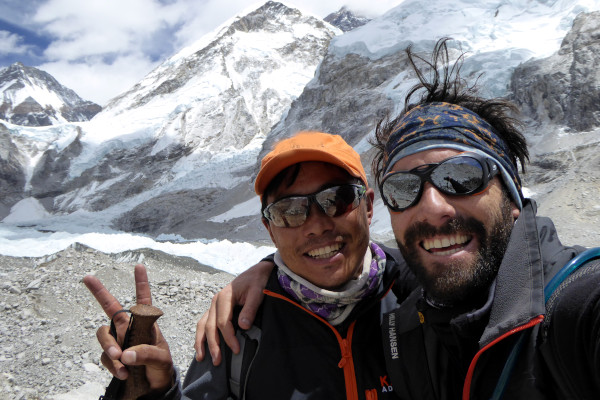
Plan your EBC Trek
Get a quote from our recommended local EBC trek operator
Everest Base Camp Trek FAQ
What makes the everest base camp hike special.
The iconic Everest Base Camp Trek leads you through the Khumbu Valley, allowing you to experience the immense beauty of the surrounding Sagarmatha National Park while simultaneously providing breath-taking vistas of 4 of the 6 highest peaks in the world – My. Everest (8.848m), Mt. Lhotse (8,516 meters), Mt. Makalu (8,470 meters) and Cho Oyu (8,201 meters).
The classic trek retraces the footsteps of Sir Edmund Hillary, Tenzing Norgay and the countless other early pioneers of Mount Everest as you trek from Lukla to the Base Camp.
As a teahouse trek you will stay in some of the highest villages in the world as you explore the local culture and traditions of the native Sherpas by learning about their spiritual connection with the mountains.
On the trek you will have the chance to ascend Kala Patthar , reaching an altitude of 5,500m and witness awe-inspiring views of Mount Everest.
You will also have the chance to explore the various Buddhist monasteries dotted along the trail and learn about a culture steeped in history and tradition, inextricably linked to the very mountains on which you have unforgettable views.
Below we have provided a brief overview of the classic route itinerary, with regional and trekking maps. We have also answered some of the most frequently asked questions on the logistics of the trek, permits, tour guides, weather, insurance, cost, difficulty and what to pack.
Where is the Everest base camp trek located?
All treks in the Everest region are located within the orange rectangle on the map below. The block represents the Everest or Khumbu region of Nepal and shows its location in relation to Kathmandu, where flights to and from Nepal arrive and depart.
The starting point of the Everest Base Camp Trek, Lukla , is also visible on the map. Other variations of the trek which don’t involve flying to Lukla generally start at Jiri – you can read more about this route variation here .

What is the best Everest region map?
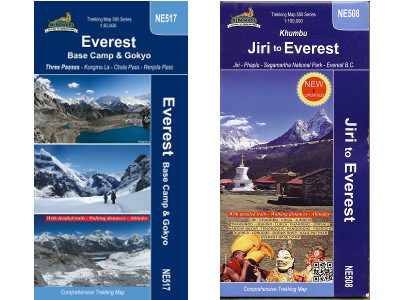
There are many great trekking maps for the Everest Region. Some take in the Gokyo region, whereas others cover Jiri and further Southern and Western aspects of the region.
We recommend Nepa Maps .
What is the best Everest guidebook?
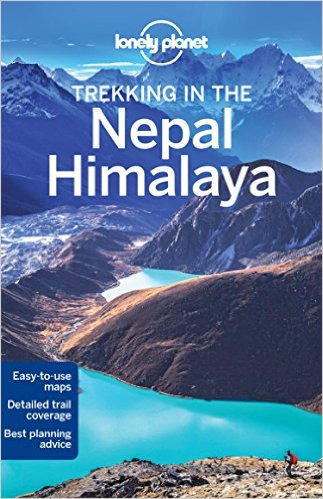
We recommended taking a detailed guidebook with you on the trek.
The Lonely Planet Trekking in Nepal Himalaya guidebook is updated regularly and is a well-known, trusted resource used by many trekkers worldwide.
The guide is very detailed and contains information for many treks, meaning you can use it more than once!
How high is Everest base camp?
Everest base camp is 5,364 metres (17,598 ft) high. The graph below shows the altitude profile for the classic Everest Base Camp trek. The order of the names on the horizontal axis shows the typical progression of the hike with the major stops on the way. The graph makes it easier to see the gradual ascent and more rapid descent of the trek.
The highest point on the EBC hike is Kala Patthar at 5,554 meters.
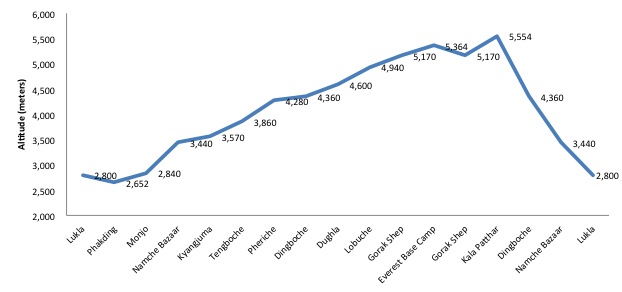
What is the day-to-day itinerary on the Mt Everest base camp hike?
The classic Everest Base Camp Trek starts in Lukla and leads you through the Khumbu Valley to the Everest Base Camp situated on the south-side of Mount Everest.
Most trekker’s adventures, however, begin in Kathmandu where the international airport for Nepal is located. From there it is a short, yet unforgettable flight into Lukla from where you will start the actual trekking (try get a seat on the left hand side of the plane for best first views of the Himalaya).
The entire journey including the trek typically lasts between 14 and 16 days, with 12 days on the trail. Of these 12 days, 2/3 will be spent acclimatising to the high altitude, so 9-10 days of actual trekking can be expected.
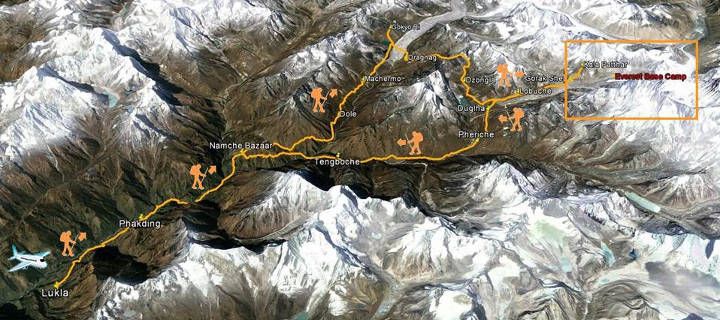
For those who don’t want to start their trek by flying into Lukla Airport, the Jiri to Everest Base Camp Trek variation provides a unique alternative. This trek starts with a bus ride from Kathmandu to Jiri from where the trekking starts. Because Jiri is considerably further away than Lukla, this variation will add around 5 days onto the trek.
Here is a standard itinerary for a 14-day Everest Base Camp Trek experience.
Day 1: Arrive in Kathmandu
If you have organised a trip with a tour operator they will usually provide airport transfers, otherwise there are loads of taxis available at the airport. Top tip: make sure to agree a price before getting in the taxi. Meters are sometimes used, but rare. We recommend staying in Thamel (which is about 15 minute drive from Kathmandu airport). There are many hotels in Thamel, Kathmandu, with varying degrees of hospitality.
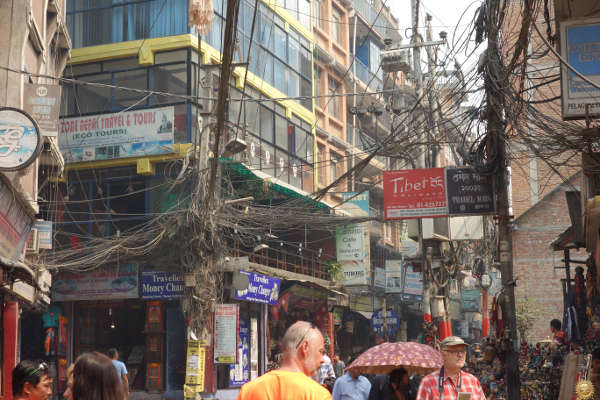
Vibrant streets of Thamel, Kathmandu
Day 2: Fly Kathmandu to Lukla. Trek to Phadking
Weather permitting you will fly from Kathmandu International Airport to Lukla in the morning. Flights to Lukla are prone to delay due to weather. We recommend building as much flexibility into your itinerary to cater for delays (i.e. having a day or two spare after the trek).
If trekking with a tour operator they will have arranged your flight, otherwise you can purchase tickets at the airport for around US$250-$300 return. If you are taking a guide the cost of his flight with be charged at a local rate of about $100 return.
Expect a nerve-racking flight into the famous Lukla Airport that provides great views of the region and of Everest – try to get a seat on the left side of the plane. Once landed, you will start the trek to the village of Phadking – on the way you will pass incredible boulders, carved with Buddhist prayers.
Day 3: Trek from Phadking to Namche Bazaar
This day will be spent trekking from Phadking through Mojo, ending up in Namche Bazaar. Some people cut this day short by stopping in Mojo (if you do the Mount Kailash Teahouse is great, and offers hot showers!).
You will enter the Sagarmatha National Park (a UNESCO World Heritage Site) on this day. You will have plenty of time spent in Namche Bazaar – a small Sherpa market town, with countless sightseeing opportunities including the potential to catch your first glimpse of Everest.
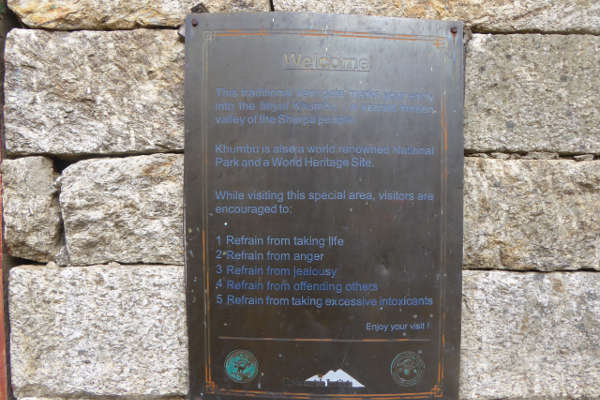
Sign with rules about entering Sagamartha National Park
Day 4: Acclimatization day in Namche Bazaar
At close to 3,500m, Namche Bazaar acts as an important acclimatization stop while doubling up as an opportunity to explore the village and surrounding areas. If it happens to be a Saturday, be sure to check out the market. Most tour guides will take you on a short acclimatization trek to the Everest View Hotel.
If it’s a clear day you should be able to snap some awesome pics of Ama Dablam in the foreground, and Mount Everest in the background. The hotel also provides WiFi at a cost so if you’re looking to call back home or just to connect, bring your device with you. For more information on internet on the trek, check out our detailed article .

Namche Bazaar
Day 5: Trek from Namche Bazaar to Tengboche
The day is spent trekking from Namche Bazaar to Tengboche, the home of the Tengboche Monastery – the largest in the region.
Some variations will take you through the ancient Tibet-Nepal trading route over the Nanpa La pass to Thami.
Day 6: Trek from Tengboche to Periche
The next stop on the trek is Pheriche – the home of the Himalaya Rescue Association . The route takes you through Phangboche, which offers amazing views of Ama Dablam towering above you.
Day 7: Acclimitization Day. Potentially Trek from Pheriche to Dingboche
Pheriche is usually used as a stop for the second acclimatization day. There are various activities to do in the area. Tshola Tsho Lake is a popular destination for trekkers stopping in Pheriche.
Your tour guide might even take you to the nearby village of Dingboche where you will be able to see great views of Lhotse and Island Peak to the east. Dingboche is used as the start to the variation trek to Island Peak .
Day 8: Trek from Pheriche to Lobuche
This day is long and is spent climbing over 600m from Pheriche to Lobuche. On the way, you will pass the well-known Khumbu Glacier as well as various memorials to those Sherpas and climbers who have died on Everest.
You will be able to see Scott Fischer’s memorial here. You will also see Lobuche East (make sure to use the zoom on your camera or if you have binoculars to try see any climbers on the peak)
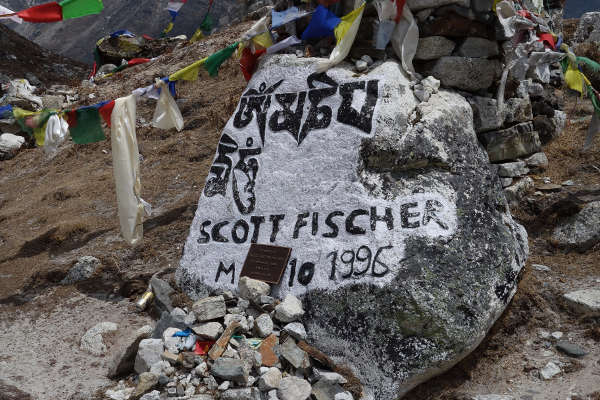
Scott Fischer's memorial
Day 9: Hike from Lobuche to Gorak Shep
Hike from Lobuche to Gorak Shep, the highest permanently inhabited village in the world. Here, you will rest for a while and have something to eat before climbing further to the Everest Base Camp.
The trekker stop point is just before the actual base camp.
Most tour groups are not allowed to enter or stay in Everest Base Camp so take the chance to experience the buzz and excitement of the climbing groups is often limited.
After getting your iconic picture taken at EBC you will descend back to Gorak Shep where you will stay for the night.
Day 10: Gorak Shep to Kala Patthar, then onto Dingboche
Another day of steep trekking allows you to reach Kala Patthar – the highest point on the trek at just over 5,500m. Its location and height result in the best views of Everest, Nuptse and Lhotse in the area. Just hope that the weather is kind to you on this day as it is one of the highlights of the whole trek.
That same day you will descend over 1,000m down to Dingboche where you will spend the night.
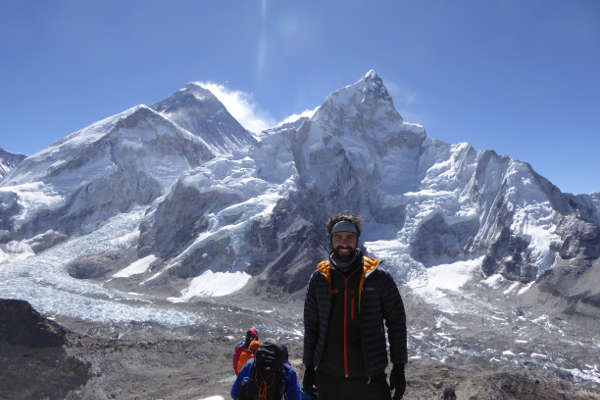
View from Kala Patthar with EBC, the Khumbu Glacier, Nuptse and Mount Everest in the background
Day 11: Hike back to Namche Bazaar from Dingboche
Descend back to Namche Bazaar via Tengboche. Keep your camera on you as you pass through the rhododendron covered slopes – making for a great photo.
Day 12: Hike from Namche Bazaar to Lukla
Return all the way back to Lukla with a long day of hiking. Your last night on the mountain will be spent celebrating in Lukla.
Day 13 and 14: Fly back from Lukla to Kathmandu
Catch the return flight from Lukla to Kathmandu in the morning. Onward travel back home our to your next destination!
More Everest Base Camp hike FAQs
How much does it cost to trek to everest base camp.
You can trek to Mt Everest base camp for as little as $700 if you go solo without a guide. Guided tours that often include return flights to Kathmandu cost around $1000-1300 per person depending on the operator. For a detailed breakdown of costs, see our article on the cost of the Everest Base Camp Trek .
Can you trek to Everest Base Camp independently or without a guide / support?
Yes, but it is only advised for trekkers that have experience of high altitude multi-day trekking, and are comfortable carry 15-20kg a day.
Trekking independently is the cheapest option because you forgo any of the amenities and expertise that is typically offered with a guided trek. You will have to arrange your own domestic flights to and from Lukla airport, and arrange accommodation for each stop in the trek.
If you are comfortable organising the logistics of the trek, then this might be an option for you.
Should I join a guided EBC trek / group?
If this is one of your first high altitude trekking experiences then we recommend using a tour operator and joining a guided group. The typical package will include domestic flights, transport to and from the airport, accommodation for every overnight stop, all permits and passes, porters to carry your luggage and of course the expertise of a guide who will provide you with an insight into the region.
Local tour operators are abundant and often cheaper than western operators, but their level of service will be reflected in their price. Hygiene and ethical standards of some of these operators is also questionable. Prices range from £600 ($750) to £1200 ($1500). To book with one of my vetted local operators, check out our booking platform, Skyhook .
Western tour operators will provide a much more consistent service. Without cutting prices, they offer affordable yet comfortable accommodation and will employ the best guides in the region who will be able to converse in English. Prices range from £1200 ($1500) to £2500 ($3200).
When is the best time to hike to Everest Base Camp?
Contrary to what you might think, the best time to go on the Everest Base Camp trek is not during the height of summer. The spring months of February through May is widely considered the peak season or best time to hike to Everest base camp. This is also the time when the region is at its busiest.
Weather during these months is stable and dry – perfect for trekking and for sightseeing. The lower mountains and foothills are most colourful during this time as well, so you can expect verdant fields and hillsides covered in rhododendrons.
September and October is another popular trekking period on the other side of summer that tends to be a little less busy. Another way to avoid the hustle and bustle of peak season is to try some of the trek variations such as the Gokyo Lakes hike .
Trekking in the winter months (November-January) is still possible, but be prepared for temperatures below freezing. Peak summer is known as monsoon season, characterised by short, sharp downpours. The trails are very wet and trekking during these months is not advised.
Read our detailed article on the best time to trek to Everest Base Camp .

How difficult is the Everest Base Camp Trek?
Contrary to popular belief, Everest Base Camp trek is not very difficult. It requires no prior trekking experience or mountaineering skills of any sort. We have seen people from all walks of life, shapes and sizes completing the trek.
The round-trip length of the trek is 130km, which is spread over just short of two weeks of trekking. Expect to cover around 15km over 5/6 hours of trekking each day – a very achievable number. The hardest part of the trek is the altitude and the effect that it can have on your body.
All good tour operators will factor in acclimatisation days into their itinerary and will aim for a gradual pace of ascent that will ensure your body slowly gets used to the altitude.
We recommend undertaking a gym training programme and practice hikes 6-8 weeks prior to embarking on the trek. Read up more on the difficulty of the EBC trek and how to train for the EBC trek .
Do I need a visa or permit for the EBC Trek?
Yes. If you are a national of a country other than India, you will need to purchase a visa. The 15-day multi entry visa starts at $25 and the 30-day visa goes for $40. The usual guided trek lasts around 15 days, but there is always the possibility of travel delay so we recommending opting for the 30-day visa for a slightly higher price.
You will need a Trekkers Information Management System card (TIMS) as well as a Sagarmatha National Park Entry Permit. Tour operators will include both in their price and will obtain them for you beforehand. If you plan to trek independently, however, you will need $20 for the TIMS card and roughly $40 for the Sagarmatha entry permit.
Make sure you bring at least four passport sized photos in case they are needed for permits.
Will I get altitude sickness on the trek to Mt Everest base camp?
Most people who follow the standard route itinerary, take a gradual ascent with acclimatisation days built in and monitor their symptoms will not suffer from any sort of altitude sickness.
That being said, altitude sickness is not correlated to age or fitness and can affect some people worse than others.
Because it is a potential risk, you must read up about acclimatisation and altitude sickness so that you understand the symptoms and how to prevent them.
What should I pack for the Mt Everest trek?
Condensing a packing list into one short answer is impossible, so we have compiled a very detailed and comprehensive EBC Packing List guide to help you plan and pack for the trek.
It is possible to buy most gear in Kathmandu, but we recommend bringing all the important stuff with you from home. Read our guide for recommendations on what to bring, which brands are trusted as well as items you won’t need during the trek.
What insurance do I need for EBC?
You will need to take out insurance that will cover you for hiking up to altitudes of 6,000m.
Typical travel insurance will not cover this so we have compiled an article that will help you find the right insurance policy that adequately covers delays, accidents and altitude related illness.
World Nomads provide insurance for treks to Everest Base Camp.
Read our detailed guide on travel insurance for the Everest Base Camp Trek .
EBC Trek Route Variations
There are a number of route variations for the trek to Everest Base Camp. Below we briefly discuss the three most popular options.
Gokyo Lakes Trek
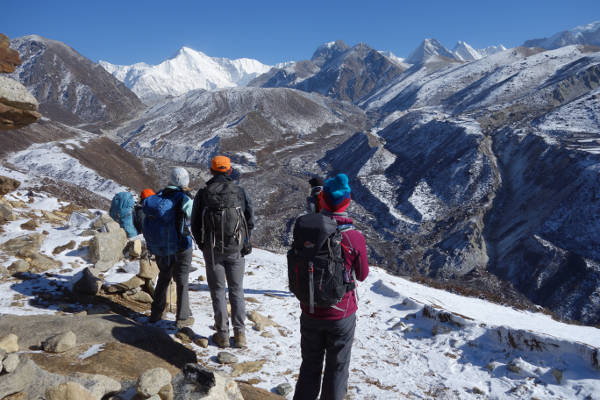
One of the more popular variations of the Everest Base Camp Trek, the Gokyo Lakes Trek , also starts at Lukla and follows the classic base camp trek to Namche Bazaar where it forks north-west.
The trek proceeds through the towns of Dole and Machermo before reaching the stunning Gokyo Lakes. From there you can ascend to the peak of Gokyo Ri in the north, before crossing the Ngozumba glacier and Cho La Pass and re-joining the classic trek at Lobuche.
The detour adds 2/3 days onto the trek but provides the wonderful opportunity to summit a peak while also avoiding some of the busier parts of the trek.
Jiri To Everest Base Camp

This variation of the classic trek offers an alternative to flying into Lukla from Kathmandu to start the trek. The Jiri variation starts with an 8-hour bus ride from Kathmandu to Jiri, where the trek begins.
The variation adds an extra 5/6 days onto the trip as you trek through the Solukhumbu region and make your way past Lukla, where the trek then follows the same route as the classic Everest Base Camp Trek.
It involves a scenic, yet long, bus ride as well as a lot more exposure to the Tibetan and Sherpa cultures. Expect to trek through more forests and streams as you start at the relatively low altitude of 1,800m and work your way up to Lukla and beyond.
Three Passes Trek

The Three Passes Trek is a tougher variation than the classic Everest Base Camp Trek because it involves crossing three very high passes as well as summiting some walking peaks which are not included on the classic trek.
The variation starts by following the classic trek from Lukla to Namche Bazaar before veering west towards Thame and the remote Nangpa Valley. The first of the three passes encountered is the Renjo La, where you will be afforded magnificent views of Everest before descending to the idyllic Gokyo lakes.
The next pass, Cho La, involves walking up a fairly steep and icy trail before reaching a small glacier at the top. From here, you descend and re-join the main base camp trek where you summit Kala Patthar – the iconic viewpoint. You continue onto base camp itself before descending to Lobuche.
You then head east over the third pass of Kongma La and continue onwards to summit the third peak of Chukking Ri. Once again you will have amazing views of the surrounding peaks that you would not get to see on the classic trek. The circuit is completed by returning to Lukla through the main Everest trail.
Island Peak Climb via EBC
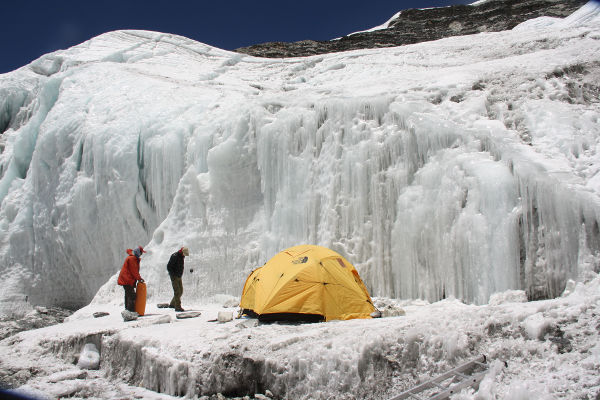
Island Peak is not so much a variation as it is an expedition in it’s own right. Summiting Island Peak is significantly harder than the trekking any of the routes mentioned above, but it does usually involve a visit to Everest Base Camp to acclimatise before the summit attempt. The climb to the peak is not considered technical although it still requires basic knowledge of jumaring, abseiling, using crampons and ice axes. Standing at just under 6,200m, altitude is a real factor.
Most climbers of Island Peak use the traditional base camp trek as a means of acclimatising before heading to the Island Peak Base Camp via Dingboche on the main trail, or by traversing the Chongma La pass. Summiting from the base camp typically takes two days and the whole variation will add around 4 days onto the classic EBC trek.
Recent EBC Blog Posts
Coronavirus pandemic: can i still hike to everest base camp (covid 19 update), mount everest deaths rise due to overcrowding, everest base camp trek packing list – exactly what you need to bring, dj paul oakenfold plays gig at everest base camp, food on the everest base camp trek, teahouses on the everest base camp trek.
References: EBC Trek Guide is maintained by a group of passionate Nepal guides and independent trekkers, many of whom live in Kathmandu and are experts on the trekking trails to Everest and throughout the region. Much of the site is based off personal experiences which are then cross-referenced with secondary sources like trail and travel guides (i.e. Trailblazer, Lonely Planet ), and third party websites. If you find any inaccuracies on the site please contact us.
Tags: Everest Base Camp Trek, Trekking to Everest Base Camp, EBC Trek
Get my recommendations on the Best EBC trek operators

Himalaya View Treks
- Trekking in Nepal
- Everest Region Trekking
Everest Base Camp Private Trek
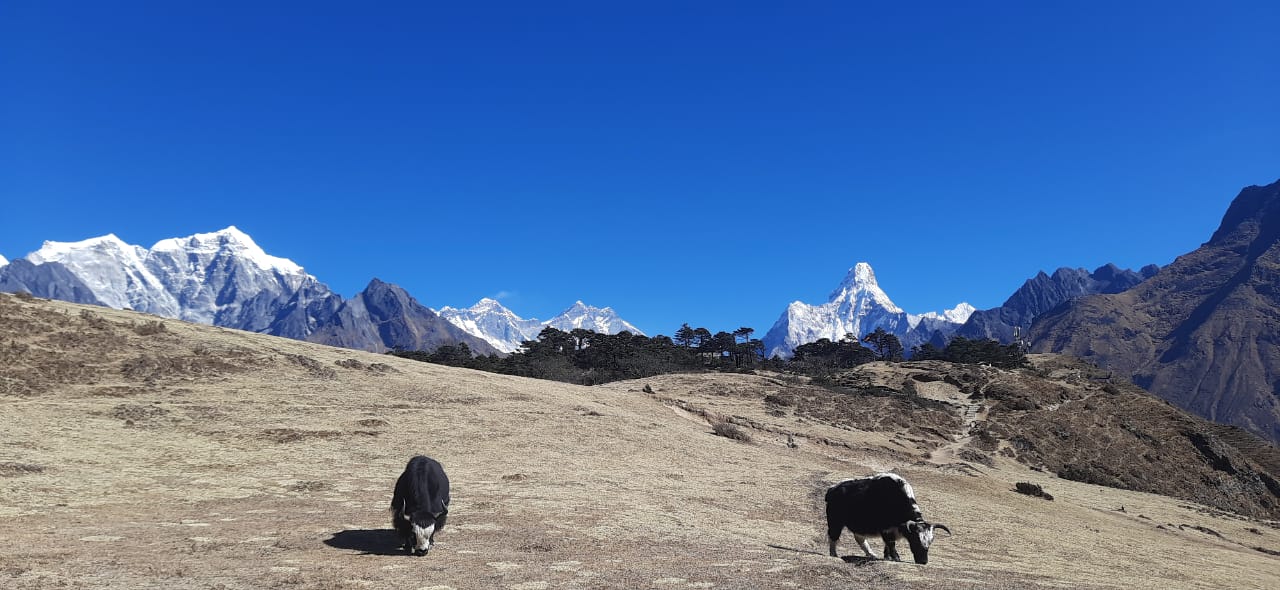
Short Itinerary
- Cost Includes/Excludes
Useful Info
Detailed itinerary.
- Tour Includes/Excludes
Trip overview
Everest base camp private trek with a personal guide.
Everest Base Camp Private Trek in the Khumbu region of Mt. Everest . 5364M. Everest Base Camp is a popular tourist attraction in Nepal. Everest Base Camp is the first camp of the Everest expedition. If you are pondering Everest Base Camp private trek with a personal Guide then remember us, This is one of the most popular tourist attractions in Nepal.
We promise that you have wonderful views of the surrounding mountains, including Mount Everest from Kalapatthar. It would be best to hike from Gorakshep to Kalapattar. The elevation of the Kalapatthar is 5550 Meters, starting from Lukla after a short flight from Kathmandu to Hillary Airport Lukla. Trek through Phagding, Jorsalle, Hillary Bridge to Namche Bazaar and rest one day for acclimatizing. Then again trek continues with Everest Himalayas views via Tengboche Monastery, Dingboche, Lobuche, Gork Shep, and Kala Pattar. And EBC then back to Lukla and fly out, In this way, you will finish your Private Everest Base camp trek.
Views From Kalapatthar
Private Everest Base Camp Trek Including the Kalapathar day hike also possible on the same day. Morning you can visit Everest base camp and in the evening you can hike to Kalapatthar. Because the Evening view from Kala Patthar is better than the morning view. Busy and crowded parts like this EBC trek are better to do privately with a private guide porter. Trekking to Everest guides and porters are well-trained and play a vital role in the success of your trekking and expeditions with your family or friends. Our official guide and porter definitely make success your private trek. And you will learn more things about Khumbu and Nepal during your Private EBC trek. Moreover, it is an exclusive trek.
Everest Base Camp Private Tour – Exclusive way to EBC
Trekking to Everest Provide certificate holder’s leadership trained private leader guide, fully insurance covered staff, healthy foods, best accommodations, and suitable itinerary during the Private EBC Trek. If Everest base camp private trekking is not covered by your timeframe then we do arrange an 8 to 10 days EBC Trekking from Lukla.
Book with us your private trip with your own choice of date. Our official Everest familiar guide will be available all around the year. If you are already in Kathmandu or Pokhara and need a guide/porter or Tour/Trekking packages then remember us. Or contact us via WhatsApp at +9779841146306. Our Office Himalaya View Treks is located in Kaldhara Marg, Kathmandu 44600. Front of the Kathmandu Sports Climbing Center, on a first-floor building. Therefore, either visit the office directly or use the online contacts to book a trip with us.
Everest base camp private Trek Itinerary
Day 01 Fly to Lukla and then trek to Phakding walking distance of 6.2 km (3-4 Hours) 2,860 meters/9184ft
Day 02: Phakding to Namche walking distance is 7.4 km (5-6 Hours) 3,440m/11,283ft
Day 03: Acclimatization, Namche 440m/11,283ft
Day 04: Namche to Tengboche walking distance 5.9 km (6 hours) 3,870m/12,684ft
Day 05: Tengboche to Dingboche walking Distance 9.1km (6 hours) 4,400m/14,435ft
Day 06 Dingboche Acclimatization climbing the (5100 m) hill of Nagarshan (2/3 Hours) 4,400m/14,435ft
Day 07: Dingboche to Lobuche Walking distance 10 km (6-7 hours) 4,900m/16,076ft
Day 08: Lobuche to Gorakshep 4 km (6-8 hours) 5180m/16,994ft (Gorekshep) & 5364m/17598 Everest Base Camp)
Day 09: Kalapatthar to Pheriche walking distance 9.8 km (5-6 hours)5,545m/18,192ft (Kalapathar) & 4,320m/14,173ft (Pheriche)
Day 10: Pheriche to Namche Walking Distance 14.2 km (5-6 hours) 3440m/11285ft
Day 11: Namche to Lukla Walking Distance 13.5 km (5-6 hours) 2,800 m 9,100 ft
Day 12: We will fly from Lukla to Kathmandu (1300 m). 30 minutes.
Detailed Itinerary
Day 01: fly to lukla and trek to phakding.
Early in the morning we will gear up for the flight to the world’s most extreme airport, the Lukla Tenzing Hillary Airport. From this place we will commence our trekking. We will walk towards Phakding which is at the 2610 m from sea level. The trail is easy and gentle with 2 suspension bridge and many Mani walls along the way. Phakding is located on the bank of Dudhkoshi River. Overnight at teahouse, Refresh and dinner- Lukla to Phakding walking distance 6.2 km (3-4 Hours) 2,860 meter/9184ft
Day 02: Trek to Namche Bazaar
Today is the day we enter the Sagarmatha National Park. Moreover, today we will be crossing at least 5 suspension bridges along the way including famous Hillary Twin Bridge at the foothill of Namche Bazaar Hill. We will be able to see the first view of Mt. Everest from Top Danda which is few meters away from Namche Bazaar. Remember that it is dependent upon the weather conditions. Stroll around the marketplace in the evening. The best view of Thamserku and Kwangde Ri is possible to capture from Namche Bazaar. Stay overnight at our teahouse. Refresh and dinner -Phakding to Namche walking distance is 7.4 km (5-6 Hours) 3,440m/11,283ft
Day 03: Namche bazaar: acclimatization day
Today is the day of acclimatization. It is necessary to do the proper acclimatization activities during Everest or any kinds of high altitude trekking. We will trek to the world’s highest situated Himalayan belt hotel the Everest View Hotel as part of our acclimatization exercise. If time permit we will also visit the mountain museum located at the top of Namche Bazaar hill. The mountain vista of Amadablam, Thamserku, Tabuche, Nuptse, Lhotse and Everest make your acclimatization exercise overwhelming. In the evening, we can visit the marketplace of Namche Bazaar. There are numerous eateries, bars, shops, banks and teahouses in the area. The guide will decide whether to include the Sherpa Village of Khumjung or Khunde in your acclimatization exercise. It depends upon your physical status. Please consult and heed the instructions of the guide. Stay overnight at our same teahouse lodge. Refresh and dinner - 3 Hours, 3, 440m/11,283ft
Day 04: Trekking to Tengboche Monastery via phunky tanka
Today’s trekking is interesting. We will be trekking uphill from the teahouse/lodge in Namche Bazaar to the top of the hill and start the trekking to Kyagjuma on the Nepalese Flat terrain. From Kyangjuma we will trek downhill to Phungi Thanga where we will take the lunch break too. From this place, after crossing the suspension bridge we will have to walk through green lush forests towards Tengboche. In the evening we will visit the monastery and learn about the local religious practices as well as the rituals. However, it is dependent, the monastery opens only during favorable times. Refresh and dinner- Tengboche from Namche walking distance 5.9 km (6 hours) 3,870m/12,684ft
Day 05: Trekking to Dingboche via Dibuche, Somare, to Dingboche
Early in the morning we will start our trek after breakfast. First, we will have trek through debuche which is at the foothill of Tengboche on the bank of Imja Tse River. We will explore through the Pangboche Village towards Dingboche. The normal lunch break is at either Pangboche or Somare. The terrain beyond Pangboche has the less vegetation. Therefore, trekkers need to be extra careful during this section of the trip. Tengboche to Dingboche walking Distance 9.1 km (6 hours) 4,400m/14,435ft
Day 06: Trek to Lobuche
After breakfast we will start our trekking towards Lobuche. The vegetation is very scattered on this section of the trekking. Trekkers have to walk on the ridge line overlooking Pumori and Cholatse. The sight of the Pheriche Village on your left and the Nagarshan Hill on the right side enthralls the trekking. We will have the lunch at Dugla. We will have to walk uphill to cross the Dugla Pass to reach Lobuche. We will pay our respect to the memorial of climbers who lost their lives during Everest Expedition at the Dugla Pass. The time spent in Lobuche is mystical as the place is on the bank of river overlooking Mt. Pumori, Lobuche and the Kong Ma la Pass. Refresh and dinner-- Lobuche from Dingboche Walking distance 6.6 km (6-7 hours) 4,900m/16,076ft
Day 07: Early morning Trek to Gorekshep & hike to Kalapatthar
Early morning Trek to Kala-Patthar (5450m) and then Gorekshep (5100m): Kala-Patthar is the most popular tourist destination in the area and able to see more than 40 snow-capped peaks from Kalapather, Best view of Trekking to Phorche village Altitude of Phorche (3700m): We have an early morning wake up today as we have to start the hike to Kalapathar before the break of dawn to reach there for sunrise. Early morning challenge of uphill hike brings us such a rewarding view that makes our day. Breathtaking panoramic view of the Mt. Everest and other mountains in the range and sunrise over those mighty peaks make this place a wonderland where we can enjoy the magical mountain marvels. Later we trek back down to our lodge in Gorakshep to have our breakfast and start trekking to Pheriche (4,371 meters) the destination for the day. After enjoying the Everest base camp and Kalapatthar moments, we are now on our return trip down towards Lukla, overnight at our teahouse lodge. Refresh and dinner -Kalapatthar to Pheriche walking distance 4 km (5-6 hours)5,545m/18,192ft (Kalapathar) & 4,320m/14,173ft (Pheriche)
Day 08: Hike to base camp of Everest and the Trek back to Pheriche
We are going to trek all the way to Everest base camp today. We wake up early in the morning; take our breakfast and quickly get ready for the adventure of the day. With the excitement of reaching the Everest base camp, we set out on the trek of the day. We reach Gorakshep (5,142 meters) and stop for lunch. Gorakshep is also our overnight place for the day so we check into our lodge. Later after lunch, we get ready to trek to the Everest base camp. A gradual ascension through the boulder-strewn path takes us to the epic base camp of the highest mountain in the world. We enjoy our moments there for a while; take pictures and exploit the most out of the time. Later, we trek back to Gorakshep overnight at our teahouse lodge. Refresh and dinner , walking distance 9.8 km (6-8 hours)5180m/16,994ft (Gorekshep) & 5364m/17598 Everest Base Camp)
Day 10: Trek back to Namche Bazar from Pheriche
The return trip during Everest or any high altitude trekking in Nepal is amazing. This is because of the decreasing altitude. Therefore, lots of people consider the return trip as the most joyous time of trekking. Enjoy your return trip. Your body will also support you and the scenery is outstanding as always. Overnight at our teahouse lodge, Refresh and dinner, Pheriche to Namche Walking Distance 14.2 km (5-6 hours) 3440m/11285ft
Day 11: Trek back to Lukla from Namche
We will trek back to Lukla on this day. The trail is the same. However, you will be able to witness lot more new things during the return trip. It is because; you have already completed the base camp journey. By this time you would have already been adjusted to the high altitude. Therefore, talk to the locals and understand the daily lives of the people in the trail. Once you reach Lukla, arrange the celebration. Today is the last day of the trekking. Therefore, celebrate with your guide and porter. Overnight at our teahouse lodge refresh and dinner, Namche to Lukla Walking Distance 13.5 km (5-6 hours) 2,800 m 9,100 ft
Day 12: Flight back to Kathmandu from Lukla
We will fly from Lukla to Kathmandu (1300 m). We wake up early for our flight back to Kathmandu. We say goodbye to the serene and magnificent mountains and board the flight to come back to the city civilization. The rest of the afternoon in Kathmandu will be at leisure. Walking around the streets of Kathmandu; souvenir shopping; finding a massage or relaxing at the hotel can be easy ways to spend time.
- Airport pickup and drop as per client’s arrival and departure date
- Hotel- domestic airport- hotel by car/ van, depend on group sizes
- Domestic flights (Kathmandu - Lukla - Kathmandu) tickets including airport taxes
- All meals (Breakfast, lunch, and dinner) during your Everest Base camp private Trek
- 11 nights Hotel Accommodation during Everest Base camp private Trek
- Government licensed holder, fluent English Speaking, Familiar HVT guide
- One assistant guide if Group sizes is more than 10 trekkers)
- Strong local Porters for Carry trekker’s luggage One porter every 2 trekkers
- Guide and porter wages including their meals, accommodation, and Salary
- Staff insurance including medication coverage
- Guide and Assistance both ways Lukla flight Ticket
- Equipment for the Company staff
- Water purification drop or tablets for safe drinking water
- Sagarmatha National Park entry permit fee
- Khumbu Pashang Lhamu Rural Municipality permits fees
- Seasonal fresh fruits every day during Everest base camp trek
- Oximeter to measure Pulse and oxygen level
- Company T-shirt as a Souvenirs, and duffle bag if needed
- Local government, taxes, including official Service Charge
- Trip completion Certificate
Not Included
- Hotel accommodation and meals In Kathmandu.
- Personal expense (shopping, snacks, boil bottle water, hot (tea, coffee) and cold drinks, hot shower, alcohol, Wi-Fi, telephone call, battery charge fee during the Everest base camp private Trek)
- Personal clothing and trekking gear
- Personal travel insurance including evacuation coverage (compulsory) up to 6000m)
- Additional costs if delays flights and outside the itinerary
- All the costs and expenses which are not mentioned in includes list.
- Tips for guide and porters. in end of the treks
Everest Base Camp Private Trek Key Highlights:
- Trek to the iconic Everest Base Camp with support from our experienced team of guides, crew and porters who simply love what they do.
- Climb Kalapathar (5545m) for grandstand views of Everest, Lhotse, Nuptse and surrounding peaks. The sights here are some of the best in the world.
- Experience the breathtaking mountain flight to Lukla, you’ll love it.
- Immerse yourself in colourful ancient Kathmandu with an optional s/seeing
- Experience the warmth and hospitality of the Sherpa people. Interact with them to learn of their lifestyles & traditions as they survive in harsh conditions for all of their lives.
Is this your ideal trek?
Trekking in the Everest region is all about attitude. By its very nature adventure travel involves that you be prepared for the unexpected. In far-flung and developing countries do not expect the standards you are used to at home. Remote areas are sometimes unpredictable and itineraries may be altered. To enjoy your trip and get the most out of your adventure it is important that you are flexible, positive and eager to take on all the challenges that arise from your Everest base camp odyssey. If you’re a greenhorn in the wilderness world then this trek would be ideal for you.
To truly enjoy this trip, you should be pretty habituated to walking 4-6 hours each day for several days on the go while some days will be relatively longer. We encourage you to walk at a pace that suits you without any rush whatsoever. This is a key aspect of enjoying such trips in the planet’s most popular region. You ought to be physically fit and an active walker to get the best of this classic mountainous journey to the south side of the mighty Everest.
General information important to this trip:
Difficulty levels, trekking at high altitudes (over 3500m).
This trip includes strenuous trekking at altitudes of over 3500m. For us altitude is a very serious issue, a result that has kept our records clean making us one of the best adventure operators in Nepal for over 30 years of operating treks in the region. Our trekking guests must be in excellent health and have high fitness levels to attempt this trip, as well as be committed to training to ensure you are suitably physically prepared for the tough challenges that go above 4500m.
Altitude sickness is a risk for anyone, including on the Annapurna, Langtang and Everest Base Camp treks. Please make sure you familiarise yourself with signs and symptoms before you depart and monitor your own health during your trek, without letting it worry you.
We advise all our guests to undergo a thorough medical with your personal physician before you embark on this trip.
Participating in a group trip
When you travel with a group you will find much camaraderie and all the fun and also there’s bound to be some of the frustrations of travelling in a group. Your group mates will probably come from all corners of the world and you will come across a range of age groups too. We ask you to be understanding of the various needs and preferences of your group - patience with your fellow travellers is sometimes required for the benefit of everyone's travel experience. Remember too that you have responsibilities to the group. If you are requested to be at a place at a certain time, ensure you’re on time without keeping the rest of the group waiting. Experience has taught us often that the very best trips we operate are those where the chemistry within the group works well - this simply requires a ‘give a little take a little’ attitude effort on your part. For privacy reasons, we are unable to provide you with contact details and any personal information about your fellow travellers booked on your trip prior to departure.
TRAVELLERS who prefer going SOLO:
Our group trips are generally planned for shared accommodation and don't involve single supplements. Single travellers share with people of the same gender in accommodation ranging from twin to multi-share. Some of our itineraries have accommodation booked on a mixed-gender share basis [for couples or trekkers known to each other prior to the trip]. On a selection of our trips, you have the option to pay a single supplement to ensure that you have your own accommodation (where available). Please note that this only applies to accommodation during the trek - pre-trip and post-trip accommodation will be booked on a single-room basis at your hotel in Kathmandu. We also have arrangements for guests who wish to trek completely solo out of the group.
Travel Insurance
When booking with Himalaya View Treks , it’s a condition upon joining any of our trips that all clients must be insured for comprehensive expenses that might incur due to medical issues or accidents (this includes air ambulance, helicopter rescue, and treatment costs). Please note that we don't arrange or sell insurance because such a system is not allowed in our country.
Our Cost versus the Experience
At Himalaya View Treks , we always go the mile to ensure our trekking guests get the best experiences of the trip with maximum comfort and safety on a ratio that goes beyond the cost that we charge for the trip. We provide a ‘no frills’ price with breakdowns to make sure our clients are getting the best for a cost that goes beyond all expectations
Tipping [an expectation on such risky arduous trips]
Tipping is very much part of the culture in Nepal and although entirely at your discretion, it is usually expected. Often people would like to tip in recognition of good service but are unsure how much would be appropriate in a foreign country - For this reason, we have listed guideline amounts below (these are intended as a guideline only and you may see fit to give more or less depending on the service that you have received).
For the tipping of your trek staff and your tour leader, we suggest passing an envelope for each staff member around the group so that everyone can put in what they feel comfortable with anonymously.
The following are guideline amounts received by each staff member from the group as a whole...
- Tour Leader: Rs30,000 - 35,000 (usually tipped on the last night in Kathmandu)
- Your trekking crew (tips are usually given on the last evening of the trek in Lukla):
- Head Trekking Guide and Assistant Guides: Rs20,000 - 25,000 for each guide
- Trek Porters/yak men: Rs10, 000 for each porter or yak man
Acute Mountain Sickness [AMS]
When we ascend above 2500 metres our bodies have to acclimatise to the decreasing amount of oxygen available. So, to allow our bodies to adjust we have designed our treks in ways that help you ascend slowly, allowing acclimatisation to occur when you go above the tree lines where the air is thinner. However, during the acclimatisation process, you may experience some of the following symptoms.
- Disturbed sleep patterns
- Loss of appetite/nausea
- Shortness of breath
- Palpitation
- Swelling of the hands and face
But if you feel such symptoms don’t let it worry because it’s normal. Individuals acclimatise at different rates. Some may experience symptoms, some may not. Your best strategy is to take your time and drink plenty of water. These symptoms may not indicate the onset of A.M.S. and if you experience them it does not necessarily mean that you should not continue. All our group leaders have extensive first-aid training and we urge you to communicate with the group leader at all times should you believe you have any symptoms in order that we can effectively monitor your symptoms as you go higher. The only cure for Acute Mountain Sickness is to descend. Please note, that your group leader has ultimate responsibility and may ask you to descend if symptoms persist. As a last resort, if matters grow from bad to worse, we always have a helicopter on standby for immediate evacuation.
A Typical Day on the Everest Base Camp Trek
A typical day on the trail begins with a wake-up call at around 6 AM by your guide. Freshen up and get ready. Pack your belongings and head to the dining area for breakfast by 7 AM. Check your luggage for the final time and fill your water bottle before you hit the trail by 8 AM, along with your guide.
To avoid walking in the heat and enjoy clear mountain views, you make an early start. En route, there will be short breaks to enjoy the views and take photographs. You haul up for lunch at a local teahouse around noon or mid-day. After a quick rest of about an hour or 40 minutes, you get back on the trail and continue till you reach your overnight stop.
Upon reaching the stop for the night, you head to your teahouse, check-in, and have some rest. Tea with some light refreshments (cookies or biscuits) will be served at 5 p.m. As the rooms are not insulated, you can warm yourself with the heater or stove in the communal area.
Exchange stories or play cards with other trekkers and sherpas till dinner is served (around 7 PM). After dinner, your guide will brief you about the next day’s trek – the route you will take, the difficulties, where you will stop for lunch, etc. Afterwards, retire for the night and have a well-deserved rest.
On average, you may have to walk 6 to 7 hours daily. The trek to Phakding is the shortest and the easiest, while the hike to Everest Base Camp from Lobuche on the 9th day could be your toughest. On Day 10, a hike to Kalapathar for the sunrise view is scheduled. So you will have to wake up before 4 AM to reach Kalapathar before sunrise. Your guide will share the details regarding the hike during the after-dinner briefing on Day 9.
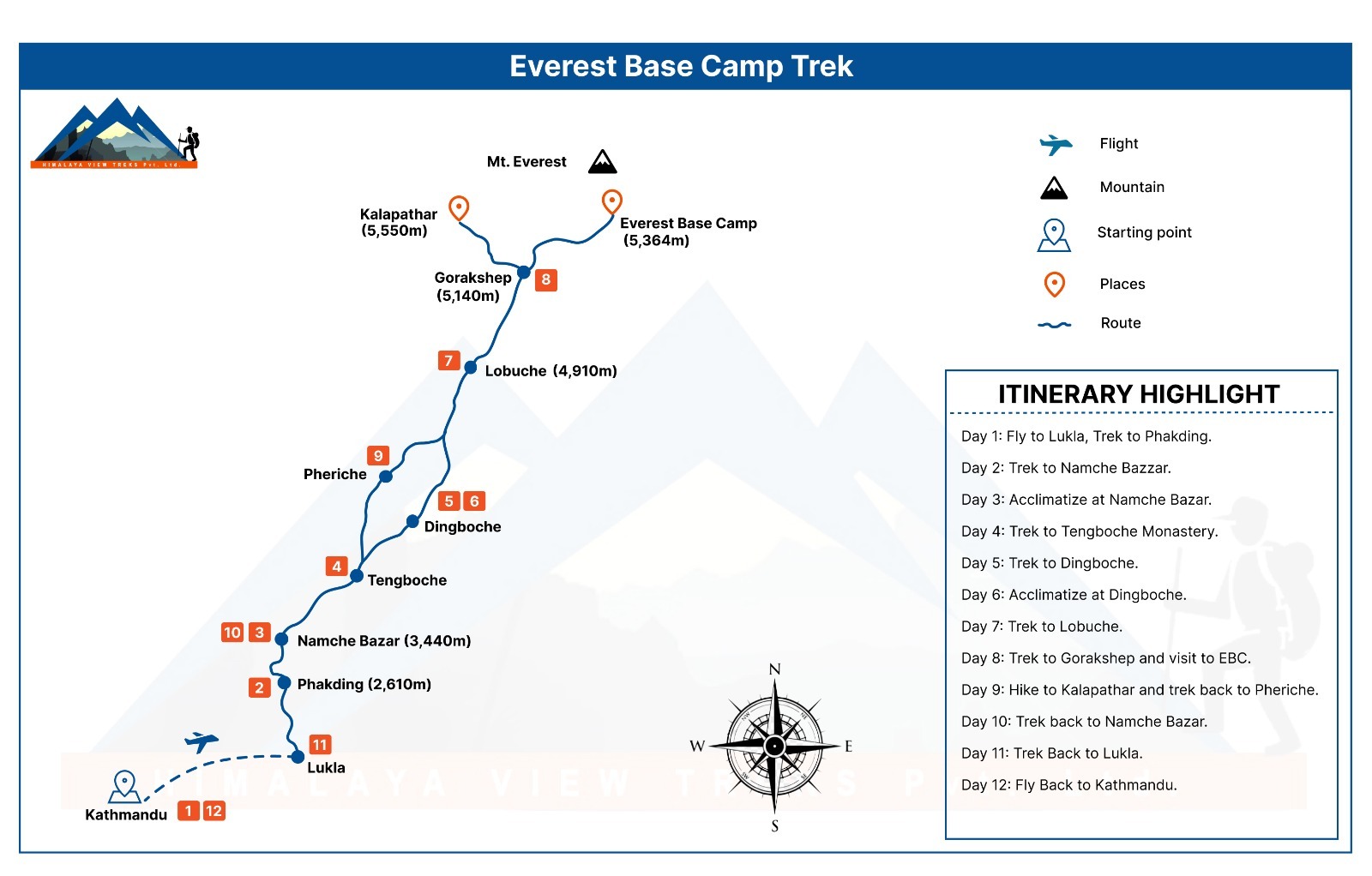
The weather forecast says rain/clouds/snow in Lukla on our Flight Day. Are we in for a rough flight?
When you are up on the mountains in Nepal, we would suggest you be ready for anything. You’re about to trek on some of the most rugged territory on earth, despite its extraordinary beauty. Weather forecasts for Lukla are never correct and different sources will give you different information. If it is a really bad day in terms of weather, the airlines will themselves cancel the flight and you might have to wait till the weather clears. Yes, flying in high altitude is never easy, even on a clear sunny day; the plane might face turbulence because of the wind blowing from the mountains. But overall the flight to Lukla is very exciting and it’s an experience that you will never forget.
What temperatures can you expect at the EBC during spring and autumn?
These are the best months to do this trek, as the weather is mild and the temperatures range from 12 to 15 degrees. The skies generally remain clear and the days are pleasant and warm. You can expect an occasional spring shower and hazy weather during spring. The mountain views are stunning in September, as there is more snow on the mountains. Nights can be freezing as the temperature dips after sun down.
How much do you reckon I will need to spend on the trail per day?
If you have booked a package with us you won’t be spending much as accommodation and 3 meals are already included in your trip price. You may have to personally pay for items like beverages and drinks, extra snacks, hot showers, electronic device charging, wifi etc. USD 20 to 30 (NRS 2000-3000) per day will be more than enough you may need to spend in a day.
What do you recommend for water along the Everest trek?
You can either buy bottled mineral water or fill up a reusable water bottle with boiled or sterilized water. During the trek, the teahouses or lodges serve you bottled and filtered water which is generally safe and has to be paid for. A liter of water would cost anything between 1 to 4 USD. As you go higher the cost of all commodities, including water, increases. But do note there is no dearth or scarcity of drinking water at teahouses. We encourage our guest to use iodine and other purifying agents to treat the water before drinking. You need to drink at least 3-4 liters of water each day to stay hydrated at higher altitudes. Keeping your body hydrated helps you to keep away the symptoms of altitude sickness. Please note, the company doesn’t provide drinking water or any extra drinks or beverages other than the ones that are specified in the trip cost.
How much tips should I give to the guide, porter and driver?
While tipping is not mandatory it is a nice way of showing your appreciation to the people who have helped you enrich your holiday experience. It all depends on how far you are pleased and satisfied with their services. There is no fixed amount, but many of our clients offer 8-10 percent of the total tour price as tips.
Is it hard to climb Everest Base Camp?
You need to be in good shape and have an ability to walk 6–7 hours uphill and downhill per day. This trek is suitable for passionate trekkers. Positive attitude, excellent health, and strong determination are required for be successful on a trip of this kind. Past hiking experience would be an asset but no technical skill is required for this trip. Besides, it is advisable to trek with a highly reputed trek operator who knows what it’s like in this part of the world, with experienced guides who can help you with significant mental preparation to keep you going all the way, as tough as it gets. Regarding the difficulty, the only challenging factor is the altitude. Our Everest Base Camp trek itinerary provides ample time for acclimatization. Neither ropes nor ice picks are needed for this trip and no vertical climbs are involved. Greenhorns in good physical shape, who exercise regularly, has positive attitude and has healthy heart and lungs can easily complete this adventurous trip.
How long do we stay at Everest Base Camp? Can we spend the night at the Base Camp?
As Everest Base Camp is situated at a high altitude of 5,364 metres, you spend only 1 to 2 hours at the camp. Since the base camp lies at the foot of the world’s tallest mountain Mount Everest, the hike to EBC is probably the highlight of your trek. Though one cannot view the summit of Mount Everest from the base camp (as the mountain is too huge) you can get close up views of the massive walls of Everest, Khumbutse, Lingtren and Nuptse. The Khumbu Icefall appears spectacular. Though the icefall lies close to the Base Camp, it is not possible to explore it as you need proper climbing gear to walk on it. But you get to explore the actual base camp of the Everest expedition groups. During climbing season, it is like a mini city of tents and you get to meet mountaineers (sometimes celebrities too!) from different countries attempting to summit Mount Everest. After taking pictures and soaking in the magnificent views you descend down to Gorak Shep again. Please do note the visibility of mountains depends on the weather. If it’s foggy you may not get good views of the mountains. No, we do not spend the night at Everest Base Camp as there are no teahouses or lodges there. Moreover it is advisable and more comfortable to spend the night at a lower elevation. After enjoying the views we trek down to Gorak Shep and stay overnight at a local teahouse.
Can you see the summit of Mount Everest from Everest Base Camp?
No, the summit of Mount Everest is not visible from Everest Base Camp. Rising above 8000 metres, the mountain is just too gigantic to be viewed in its entirety from its base. The summit of Everest can be viewed from Kalapathar and from places en route to EBC. If you want to view Mount Everest without having to trek to Everest region, you can do it by driving to Nagarkot, taking an Everest Mountain Flight and an Everest Base Camp Helicopter Tour. The best views you get of Mount Everest is from Kalapathar. It leaves you breathless, virtually!
What sort of toilet facilities will be available on the Everest Trek?
In all our Everest Treks the teahouses that we use have western toilets. In luxury lodges and teahouses in the lower elevations the rooms come with attached bathrooms and hot showers. At higher elevations the facilities may be a bit basic and you may have to share the bathroom with other travellers. Please do note that in case of extreme cold, the water in the toilet basin may freeze and you may have to use an Asian (also known as ‘squat’) style of toilet that is located outside. Please do carry toilet paper rolls with you at all times. It is important that you carry enough rolls of toilet paper and hand sanitizers while trekking. Can I make payment with my credit card or with my cash while Everest trekking? You need to have local currency to purchase items on the trail. While Lukla and Namche in the Everest Region may have lodges that would accept payment with cards, we strongly advise to carry enough local cash with you to buy essential items en route. You can exchange your currency at any of the money exchange centres in Kathmandu or use your credit or debit card at the local ATMs to get local currency.
Where can I store my extra luggage while trekking?
You can store it at your hotel (most hotels in Kathmandu have storage facilities) or you can leave it at our office.
Is there WIFI available on the Everest Base Camp trail?
Yes, wifi hotspots are available on the Everest Base Camp trail. But please do keep in mind, due to the mountainous terrain the network maybe erratic sometimes. Often times the signal gets lost or the strength is poor.
Trips Reviews

Leave a Review Cancel reply
Your email address will not be published. Required fields are marked *
Save my name, email, and website in this browser for the next time I comment.
Customer's Reviews On

Quick Enquiry

We are associated with

© Copyright 2024 Trekking To Everest - All Right Reserved.
How To Do The Everest Base Camp Trek In Nepal
The Mount Everest Base Camp Trek in Nepal is one of the world’s best bucket list hikes. In less than 2 weeks, you can trek to the foot of Mt Everest and other snowy peaks in the Himalayan mountains.
The good news is that it’s not a super difficult hike, and you don’t need a big budget to do it. The EBC trek is worth it for the fun and accomplishment alone, but you also get views of the Himalayas that are out of this world.
This travel guide will explain how you can do the Mt Everest Base Camp hike independently (with or without a tour guide), along with a recommended packing list and everything else you need to know before you go!
Best Everest Base Camp Tours
First of all, if you’d rather skip the hassle of planning your own EBC Trek, Klook has Everest Base Camp Tours starting as low as $900 USD for a full 12-day trek.
You may be able to find something cheaper than this once you land in Kathmandu, but booking online with a vetted tour company has some big advantages, and the reviews on their website are very positive.
We’ve used Klook for lots of tours and activities around the world, and they’re great! Highly recommended.
Book Now: Everest Base Camp Tours

When To Do The EBC Trek
The Mt Everest region has 4 different trekking seasons:
- March – May: High season. Best weather, with stable temperatures and bright sunny days, but the trails can get crowded. During these months you may share the EBC trail with pro climbers on the way to go summit Everest.
- June – August: Monsoon season. There’s a lot more rain during these months, and the trails are mostly empty.
- September – October: Clear days and busy trails. This is one of the most popular trekking seasons.
- November – February: Coldest season, but the weather is stable and dry. The trails are mostly clear.
I trekked in early February, and even though it was nice having the trail mostly to myself, the cold in the evenings and mornings was straight up misery.
My home state of Missouri can get very cold in the winter, but the cold has just never been my thing. If I could go back and change it, I would definitely do my Everest Base Camp hike later in the season.

Everest Base Camp Weather
Temperatures on the Mt Everest Base Camp Trek can range from 5 °C (40 °F) to 20 °C (70 °F) depending on month, and as low as -30 °C (-22 °F) at night during the winter months.
If you trek during the warmer months (Mar-May and Sep-Oct), the cold is not a big problem and shouldn’t be hard to cope with. Winter is a different story. Your snot will freeze in your nose at Gorak Shep.
Sunshine is key for winter trekking in Nepal, and thankfully you should have lots of sun in most months outside of the monsoon season. On my February hike, I often found myself shedding all my layers while trekking because I was heating up in the sun.
If you do your Everest Base Camp hike during the winter, the biggest issue is staying warm in the evenings and at night. For this, you’ll definitely want a top quality down jacket and sleeping bag.

All About Everest Base Camp Trekking
My everest base camp itinerary.
- Day 1: Kathmandu to Lukla to Benkar .
- Day 2: Benkar to Namche Bazaar .
- Day 3: Namche Acclimatization Day .
- Day 4: Namche to Deboche .
- Day 5: Deboche to Pangboche .
- Day 6: Pangboche to Dingboche .
- Day 7: Dingboche Acclimatization Day .
- Day 8: Dingboche to Thukla .
- Day 9: Thukla to Gorak Shep .
- Day 10: Everest Base Camp .
- Day 11: Kala Patthar to Gorak Shep to Pheriche .
- Day 12: Pheriche to Namche .
- Day 13: Namche to Lukla .

If you ever need motivation to keep going on the Everest Base Camp hike, just look at how much the porters are carrying!

Mount Pumori as seen from the Kala Patthar viewpoint, just a short distance from Mt Everest Base Camp.

Ama Dablam, one of my favorite mountains on the Mt Everest Base Camp Trek.
EBC Trek Packing List / Gear
This isn’t a complete list of everything to bring on a Mt Everest Base Camp Trek, and you may have to change things up a little depending on what month you go, but these are just some of the basics.
You can find most of this gear in Kathmandu, but in my opinion you’ll get higher quality and a wider selection if you order online.
- Beanie: I only wore this at night, but it definitely helped keep my ears warm.
- Down Jacket: Bring the biggest, warmest DJ possible. This is your most important piece of gear. You can use it as an extra cover at night.
- Fleece Sweater: This is the only jacket you’ll need to wear while trekking most days, especially if it’s sunny.
- Shirts: Something comfy with quick dry material.
- Trekking Pants: Something lightweight and breathable.
- Thermal Underwear: May not be needed if you trek in the warmer months.
- Gloves: I only wore these at night, but they definitely helped keep my hands warm.
- Socks: Merino wool is best for staying warm and stopping moisture.
- Headlight: Smart to have at least a small one, just in case.
- Tumbler: 1 liter water bottle to refill daily on the trek.
- Sunblock: It’s easy to sunburn at high altitudes. A small bottle is plenty.
- Sunglasses: Good for snow. May not be necessary unless you plan to hike a mountain pass like Cho La.
- Hat: I wore old faithful throughout the hike.
- Watch: An altimeter watch would be fun to play with here.
- Camera: Duh. You can’t do the Mt Everest Base Camp Trek without taking lots of pictures.
- Power Bank: Bring a big power bank and you might only need to recharge it once on the whole trek.

Everest Base Camp Trek Cost
For a 13 day trek, I paid about $21 USD per day for food, drinks, and room. Porter/guide was an extra $25 per day, although it’s not a requirement. Flights to Lukla were $330 return, but again not a requirement if you hike in.
You can read the sections below for more info on the daily trekking costs and what you get for your money. It’s not a very expensive trek, all things considered!
Keep in mind, these numbers are from 2020. They’ll go up a little over time. Exchange rates may also vary, so check the latest rates .

The flight to Lukla from Kathmandu is $165 USD each way. You can shop for flights to Lukla at Skyscanner.
If your budget is tight or you have extra time, you can skip this flight by hiking from Jiri to Lukla rather than flying. It only adds a couple days to the itinerary.

Guide / Porter / Solo
You can do the EBC trek with a guide, porter, OR independently (solo).
A guide will show you the way to Mt Everest Base Camp and help with lodging, navigation, advice, taking pictures for you, etc. A porter-guide will do these same things and also carry a 20 kg (45 lb) pack for you.
A porter or guide is NOT a requirement to do this hike, especially if you go in the warmer months when you may not need as much gear. In 2023, they were supposedly introducing a guide requirement for EBC, but so far that has not been enforced at all, thankfully.
With that said, there are some good advantages to hiring a guide, and it’s pretty cheap by Western standards. A porter is only $15 or $20 USD per day, and a porter-guide is $25 per day. A popular arrangement is to hire one porter for two hikers, splitting the cost and still making things easier for both of you.
In the end, this all depends on your budget and hiking preferences.

Hiking Fees
If you’re hiking EBC independently, you’ll need to be aware of two fees you have to pay near the start of the trek.
There’s a local government tax that they’ve now started collecting in Lukla. This one is currently 2,000 Rupees ($17 USD).
There’s also an Everest park fee/ticket you have to pay at the Sagarmatha National Park entrance just beyond the small village of Monjo, Nepal. This one is currently 3,500 Rupees ($30 USD).
No TIMS card is needed anymore for independent hikers. That fee has been retired for the Mount Everest Base Camp Trek.

Accommodation & Amenities
Throughout the Everest Base Camp hike, you’ll stay and sleep at small guesthouses along the way, called teahouses.
This is where you get your meals and drinks for the trek, along with the occasional amenities like showers, charging, or WiFi. The teahouses start out decent, but quickly get more shabby as you go further up the trail.
You have to pay for everything you use, of course, and the prices get quite high as you go, because everything has to be hauled up on the backs of the poor porters.

Guesthouses
The teahouses on the EBC trek are cold and dingy, with drop toilets and cracks in the walls. Don’t expect luxury.
Most rooms are free as long as you buy your meals there (the meals are how they make their money). If you stay at a lodge and don’t eat there, you’ll be expected to pay for the room.
In some cases, I was charged 500 Rupees for a room on top of my meal costs. I’m not sure why some teahouses do this and others don’t, but I never paid more than 500 Rupees for a room, and most were free with the meals.

Food & Drink
I’m happy to report that the food and drinks on the Everest Base Camp hike are top notch, especially after you’ve worked up an appetite trekking.
You have western food choices, or the standard local staples like veggie fried rice, steamed momos (dumplings), and mushroom soup. Everything was hot and fresh. Meal prices for these ranged from 250 to 750 Rupees depending on altitude. Not too bad.
For drinks I tried hot chocolate, lemon/apple/mint tea, and occasionally bottled water for my tumbler. These ranged from 100 to 400 Rupees. If you want to avoid plastic bottles, there’s usually boiled water available and this is safe to drink too.
Getting enough water on the trek is never a problem. Just fill up a 1 liter tumbler in the morning, and this will last you until evening, especially since you’re likely to pass more tea houses along the trail as you’re hiking throughout the day.

Showers are only available at a few lodges, depending on the season and how high up you are, and they cost 600 to 1200 Rupees. In the winter, water higher up will be frozen most of the time.
I never had a shower on my February EBC trek, and that seems to be the norm (although I got one or two opportunities in Namche). Yes, it’s gross. I could smell myself by trek’s end, and it wasn’t pretty.
But aside from the fact that I hate to fork out money for something as basic as a shower, I also never really got close to other people for very long on the trek, so I didn’t feel too guilty about it.
Most days were cold enough that the thought of stripping down for a shower was not really appealing, either. Your best bet is baby wipes and deodorant.

WiFi / Cell Service
WiFi costs anywhere from $5 to $10 USD per day if you buy it from the teahouses.
Alternatively, you can buy a 10 GB/30 Day Everest Link WiFi card in Namche Bazaar and use this for the entire EBC trek. During my Mount Everest Base Camp Trek the WiFi was down across the whole region, so unfortunately I wasn’t able to use either of these options.
I bought an Ncell local SIM card in the Kathmandu airport and had 3G service for half the days of the Everest Base Camp hike. Coverage is still improving in the area, so if you need to stay connected I’d definitely bring a local SIM.

Electricity
All of the teahouses on the way to Mt Everest Base Camp sell outlet charging for electronics, and the prices range from $2 to $10 USD for a full charge, depending on how far up the trail you are.
The key is to bring a big power bank and then use this to charge all of your other electronics (phone, camera, etc). I did this and only paid once to recharge my power bank on the whole trek.

How Much Cash To Bring
Everything you buy during the Everest Base Camp hike (meals, WiFi, charging, etc) will have to be paid for with cash. Credit cards won’t work. There are no ATMs outside of Lukla and Namche Bazaar (Days 1-4), and even the ATMs there are not reliable.
What this means is that you’ll have to withdraw enough cash (Nepalese Rupees) at an ATM in Kathmandu to cover your entire trek. The ATM fees will bite you, and I hate to carry large amounts of cash, but it’s not really avoidable here.
All up, I spent about $20 USD (2,400 Rupees) per day on the Mount Everest Base Camp Trek, and never spent more than $25 USD in a single day. With that said, I didn’t splurge on WiFi, showers, charging, or alcohol. The only things I bought were the bare necessities: room, food, and drinks.
If you hire a porter/guide, you don’t need to factor that into your daily cash carry. That’s paid before the trek starts. But do reserve a little cash for a decent tip.

Mount Everest Base Camp Trek Difficulty
I’m not going to lie, this is a difficult trek. And if you do it in the winter like I did, it’s even harder. With that said, if you are in decent shape, determined, and obey the guidelines for altitude sickness prevention (more on that below), then you’ll have no problem reaching base camp.
There is a lot of elevation gain and loss on this hike. At times near Lukla, the constant ups and downs will make you feel like you’re hiking a roller coaster, but the trail is never too steep or dangerous. After Namche, it’s mostly a slow uphill plod.
This trek has been completed by old seasoned hikers in their 70s, and young kids in their pre-teens. It’s also been flunked by healthy 20-30 somethings who try to push through it quickly without enough acclimatization to altitude.
Patience and discipline are key for trekking to Everest Base Camp. Slow and steady wins the race here.

Trekking Distance
The one way trekking distance from Lukla to Mt Everest Base Camp is about 65 kilometers (40 miles).
That means the total roundtrip distance of an EBC Trek is about 130 kilometers, even if you don’t do any of the detours.
Don’t let that scare you off. It’s a lot of hiking, but every step is worth it.

Altitude Sickness
By far your biggest danger on the Mount Everest Base Camp Trek is altitude sickness, also known as Acute Mountain Sickness (AMS).
No one is immune to this, and it doesn’t matter how fit you are. If you gain altitude too fast, you can get sick and in some cases even die. Plenty of people have died from AMS on the EBC Trek.
The problem is that overzealous hikers push the envelope on this hike all the time, and a lot of them end up needing a very expensive helicopter evacuation to lower ground.
The best way to avoid altitude sickness is to go slow . At altitudes above 3,000 meters (10,000 feet), don’t increase your sleeping elevation by more than 300-500 meters (1,000-1,500 feet) per night.
Every 1,000 meters (3,000 feet) you should also spend a second night at the same elevation. If you get a bad headache, dizziness, or nausea, descend to a lower altitude until you feel better. As long as you follow these general guidelines, you shouldn’t have any issues.
You can take Diamox (acetazolamide) on the trek for extra AMS prevention. This medication can be found in Kathmandu or Namche. I bought mine in Namche and it seemed to help my headache and slight foggy feeling. I didn’t have any side effects aside from the usual tingling toes/fingers.

Everest Base Camp Altitude
The Mount Everest Base Camp altitude is 5,364 meters (17,598 feet). At this elevation, there is 50% of the oxygen at sea level.
However, most treks also go to Kala Patthar, a viewpoint even higher than base camp where you can get the best views of Mount Everest.
The elevation at Kala Patthar is 5,644 meters (18,519 feet). From there, you’ll be rewarded with an incredible panorama of Mount Everest and other icy peaks like Pumori, Lhotse, and Nuptse.
Happy travels!

If you’d rather skip the hassle of planning your own EBC Trek, Klook has Everest Base Camp Tours starting as low as $900 USD for a full 12-day trek.
You may be able to find something cheaper than this once you land in Kathmandu, but booking online with a vetted tour company has some big advantages, and the reviews on their website are very positive for this Mt Everest Base Camp tour.
More Nepal Travel Tips
Hopefully you were helped by this guide for the Everest Base Camp Trek. Let me know in the comments below if I can help answer any questions.
Don’t forget to check out my complete Nepal Travel Guide with tips, info, photos & more!
You may also like
Fulidhoo island guide: shark & stingray beach in maldives, how to visit dhigurah island: budget paradise in maldives, 10 best hikes in aruba: family friendly trails, how to visit tanjung puting national park in indonesia, sanur bali travel guide: 23 best things to do, coron vs el nido: which is better all differences explained.
So much useful detailed information.
Thanks for the straight forward information. Beautiful photos

Leave a Comment Cancel Reply
Save my name, email, and website in this browser for the next time I comment.

- Best Hikes In The World
- Appalachian Trail
- European Hikes
- Nepal Hikes
- Patagonia Hikes
- See All Hikes
- Mount Kenya
- Mount Kilimanjaro
- Mount Toubkal
- See All Mountains
- South Africa
- New Zealand
- Switzerland
- United Kingdom
- Packing Lists
Everest Base Camp Trek – Nepal’s Most Famous Trek
Asia , Nepal
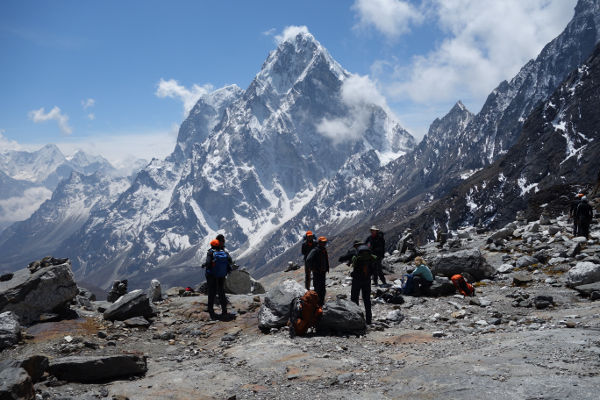
The Everest Base Camp Trek is one of the most popular and best treks in Nepal .
Home to four of the six highest mountains in the world – Mt. Everest (8,848 meters), Mt. Lhotse (8,516 meters), Mt. Makalu (8,470 meters) and Cho Oyu (8,201 meters) – the Everest (or Khumbu) region affords trekkers the opportunity to hike in one of the grandest and most awe-inspiring trekking areas in the world.
Trekkers get to retrace the footsteps taken by Sir Edmund Hillary and Tenzing Norgay on their historic Everest expedition in 1953.
On this page, you will find a comprehensive and impartial guide to the Everest Base Camp Trek.
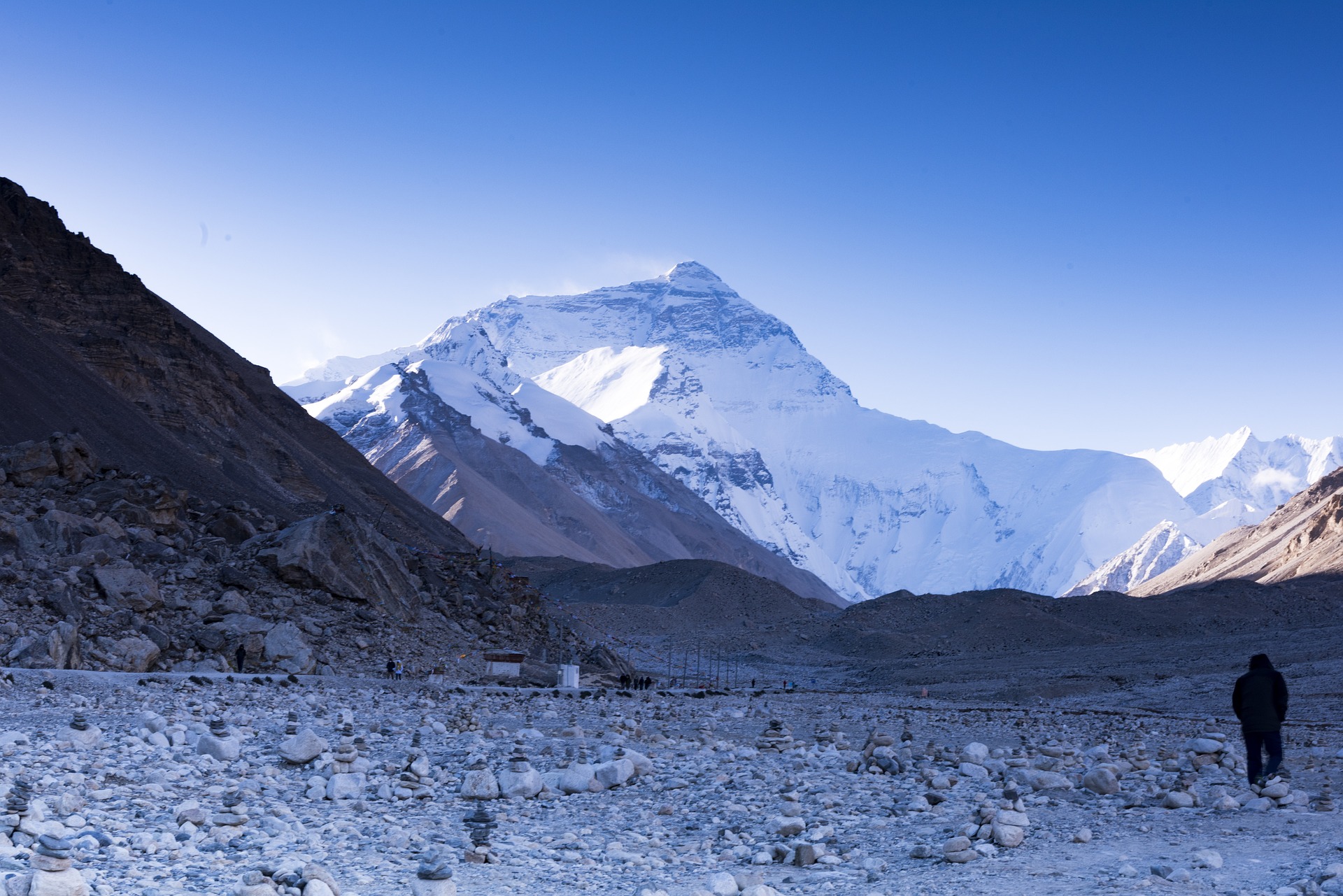
Everest Base Camp Trek
Ebc hike overview.
In this detailed Everest Base Camp trek article, you will find information on the typical route and its variations; a day-by-day itinerary breakdown of the trek; practical information on accommodation, meals, permits, equipment and insurance; as well as guidance on the best time to trek Everest Base Camp.
Key Highlights
Highlights on the trek include: unforgettable mountain views from Kala Patther , including Mt. Everest; the chance to see the famous Everest region Sherpas and Sherpa town – Namche Bazaar; sightseeing in the Sagarmatha National Park – a World Heritage Site; glimpses of the highest Buddhist monasteries in the world; and a sneak preview into the inner workings of the base camp to the world’s highest mountain.
Everest Regional Map
The Everest Base Camp trek is situated in the Everest, or Khumbu region of Nepal (see map below). It is the most popular trek in the region, if not the country.
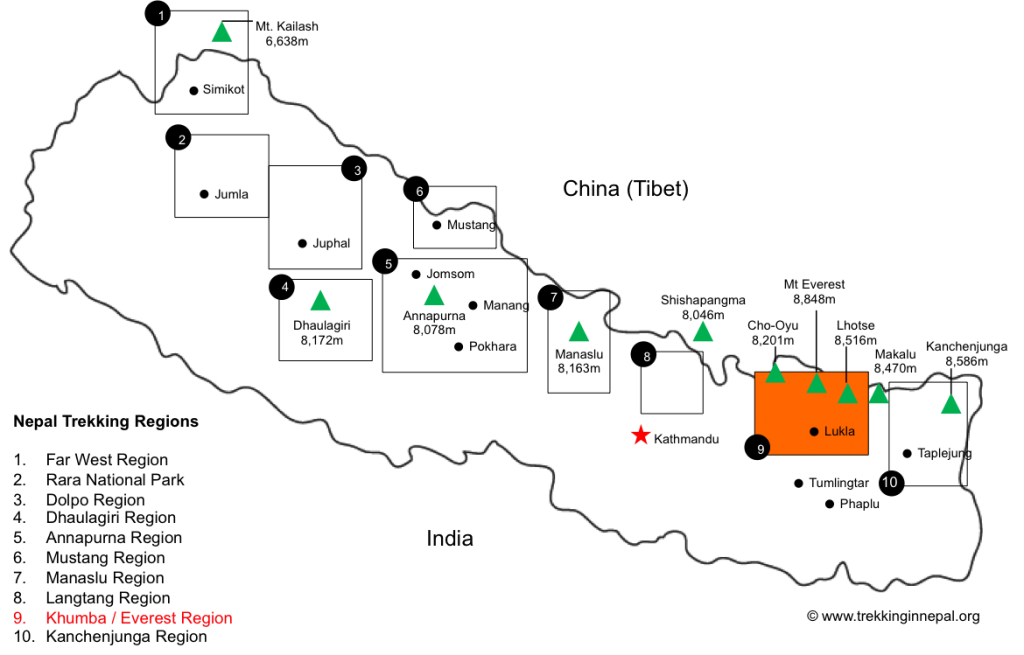
EBC Recommended Map
This map is one of the better representational schematics of the Everest Base Camp trail (we believe it is from GlobeTrekker but can’t be certain as there are many maps scattered across Google Images).
The map above shows the classic Everest Base Camp trek running up from Lukla to Namche Bazaar and then veering North-east up to Periche / Dingboche. From Dingboche / Periche the trail turns North-west to Lobuche before heading north gain to Gorak Shep. From here Everest Base Camp can be seen to the East and Kala Patthar in the North-west.
The map also shows the route to Island Peak in the East, via Dingboche and Chhukung, and the Gokyo Lakes in the West.
Please Note: The above recommended map is not to scale and should not be used as an accurate representation of the Everest Base Camp trek route. We provide links below to excellent maps of the Everest region.
EBC Trek Itinerary
Most trekkers fly from Kathmandu to Lukla Airport to begin their Everest Base Camp trek. The ‘classic’ or typical route follows straight up the Khumba Valley and through the Sagarmatha National Park to Everest Base Camp.
Variations via Gokyo Lakes or Chhukhung Valley are also popular (see the variations section below).
The typical Everest Base Camp trek duration is between 14-16 days (including transfers between Kathmandu and Lukla). The trek itself (excluding sightseeing in Kathmandu and transfers) usually lasts about 12 days with acclimatisation days at Namche Bazaar and Pheriche.
Here is a brief overview of a typical itinerary on an EBC trek, with approximate trekking times and altitudes.
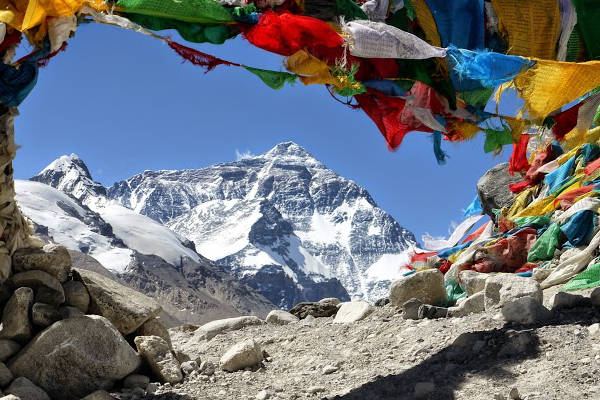
Day 1: Arrive Kathmandu
Arrive in Kathmandu. Rest and tour Kathmandu (often your tour operator will have pre-organised tours around Kathmandu).
See more in our guide on things to do in Kathmandu .
Day 2: Fly Kathmandu to Lukla. Trek to Phakding
Fly from Kathmandu to Lukla (expect a slightly scary landing at Lukla but rest assured the pilots are very experienced!). Weather can sometimes be a problem, so delays are common.
The flights afford great views of the Everest region, so have your camera ready. Try to sit on the right side of the plane to see Mt Everest. Upon arrival you will be transported to the trailhead and take a relatively easy trek from Lukla (2,800 meters) to Phakding (2,652 meters).

Namche Bazaar, Khumbu District
Day 3: Trek from Phakding to Namche Bazaar
Phakding (2,652 meters) to Namche Bazaar (3,440 meters) via Monjo (2,840 meters) and the beginning of Sagarmatha National Park. Weather permitting you might get your first glimpses of Mt Everest from the steep trail to Namche.
Day 4: Acclimatisation in Namche
This is usually a rest acclimatisation day in Namche (3,440 meters). If you are lucky enough to be in Namche on a Saturday, then make sure to visit the weekly market. Most operators will encourage you to take an acclimatisation trek to the Everest View Hotel (3,880 meters) where you can have lunch and capture views of Mt. Everest.
Day 5: Trek from Namche to Tengboche
Trek from Namche (3,440 meters) to Tengboche – also written Thyangboche (3,860 meters), home to the largest gompo (a Buddhist ecclesiastical fortification of learning). The trek is an undulating one which provides great views of beautiful mountains including Everest, Nuptse, Lhotse and Ama Dablam. Some treks go via Thame to visit the Thame Monastery, before continuing to Tengboche.
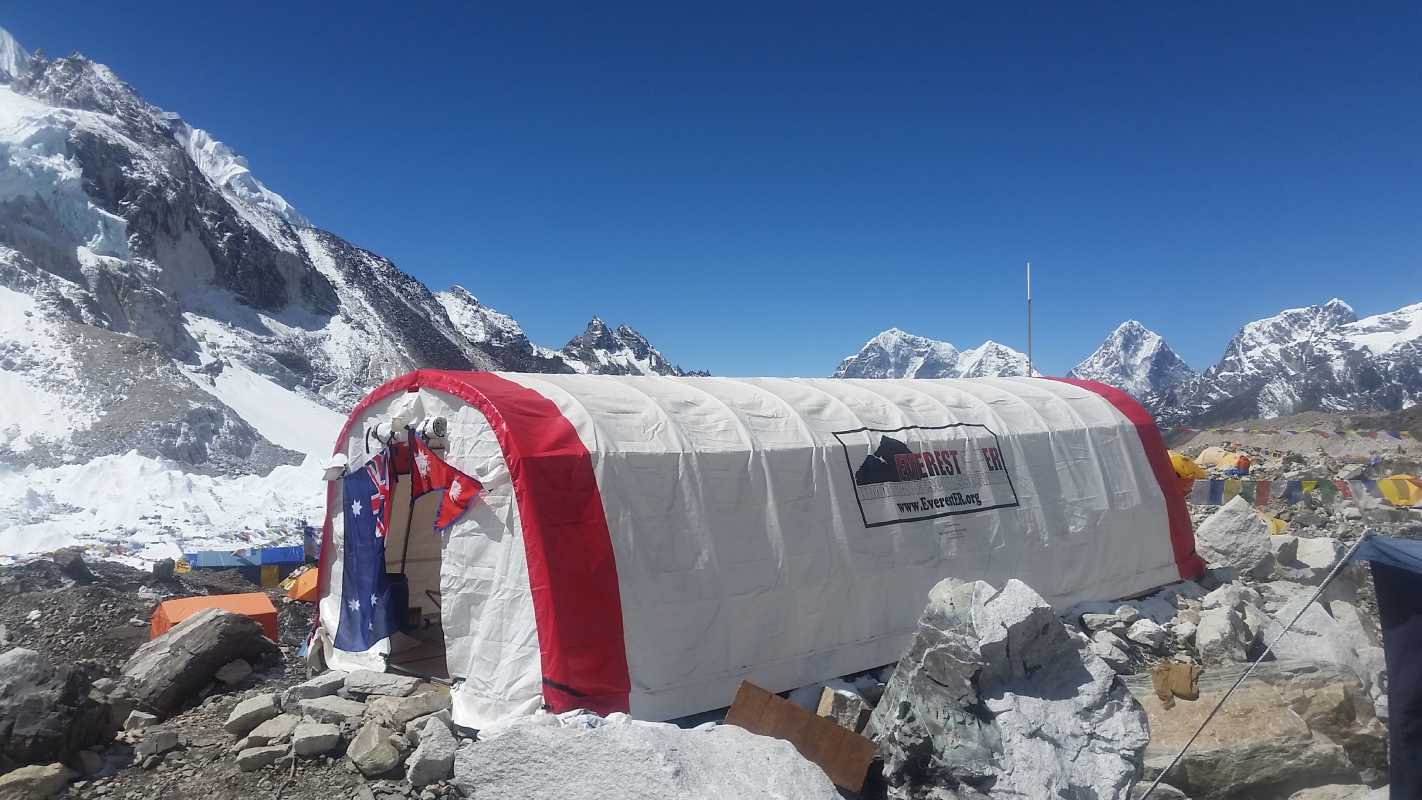
Day 6: Trek from Tengboche to Periche
Trek from Tengboche (3,860 meters) to Periche (4,280 meters) via the town of Pangboche. The Himalaya Rescue Association are based here, and it is well worth visiting them if your operator hasn’t already organised a tour.
Day 7: Acclimatisation day in Periche
Periche (4,280 meters) is usually used as the location for your second rest and acclimatisation day. Depending on your operator you will likely visit the Tshola Tsho Lake and then take a short trek towards Dingboche (4,360 meters) where you will get great views of the south face of Mt. Lhotse and Island Peak.
Day 8: Trek from Periche to Lobuche
A fairly long and steep trek from Periche (4,280 meters) to Lobuche (4,940 meters) via the Khumbu Glacier. You will see Sherpa Memorials built of stone cairns in remembrance to the many Sherpas and climbers that have died climbing Everest.
Day 9: Trek from Lobuche to Gorak Shep
Trek from Lobuche (4,940 meters) to Gorak Shep (5,170 meters) where you will have lunch and then onto Everest Base Camp (5,364 meters).
Most treks are not allowed to stay at Everest Base Camp without specific permission. The rules and regulations have changed around this issue over recent years, so it is worthwhile checking with your tour operator.
Visits to the icefall require mountaineering permits and are usually not part of a standard Everest Base Camp trek. After visiting Everest Base Camp you will return to Gorak Shep for the night.
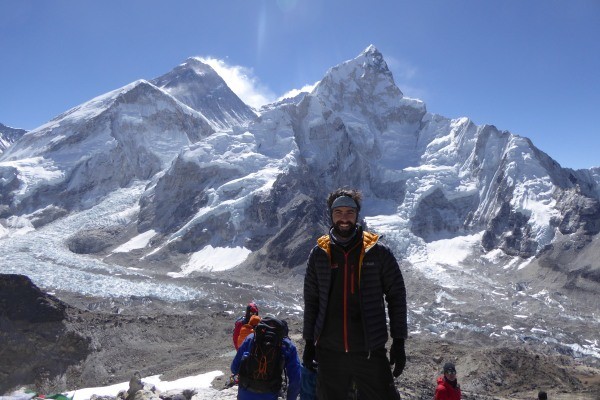
Kala Patthar
Day 10: Trek from Gorak Shep to Kala Patthar and EBC (Return to Dingboche)
A trek from Gorak Shep (5,170 meters) up the steep slopes to Kala Patthar (5,554 meters), a peak west of the Everest Base Camp which affords the best views of Mt. Everest, Nuptse Nup II and Changtse; as well as the northern flank and summit of Lhotse. You will leave Gorak Shep early to reach Kala Patther before the clouds roll in.
On a typical Everest Base Camp trek, Kala Patthar will be the highest altitude you will reach. It is also home to the worlds highest webcam – Mount Everest Webcam. From Kala Patthar, you then descend all the way back to Dingboche (4,360 meters).
Day 11: Trek from Dingboche to Namche
Trek from Dingboche (4,360 meters) to Namche (3,440 meters) via the rhododendron forests around Tengboche.
Day 12: Trek from Namche to Lukla
Trek from Namche (3,440 meters) all the way back to Lukla (2,800 meters) – a long and tiring walk to finish what is an incredible Himalaya trek.
Day 13: Fly from Lukla to Kathmandu
Fly from Lukla to Kathmandu.
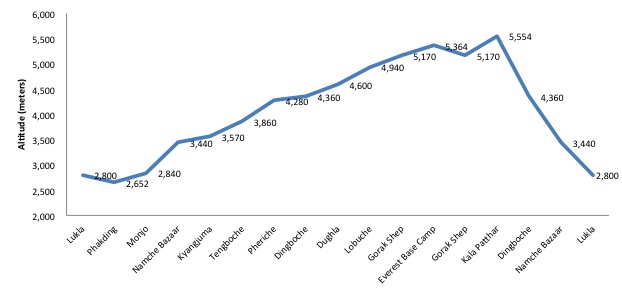
EBC Route Altitude Profile
Above is an altitude profile chart for a typical Everest Base Camp hike. The highest peak is Kala Patthar, at a staggering altitude of 5,554m.
Everest Route Variations
Below are typical route variations for the Everest BC hike.
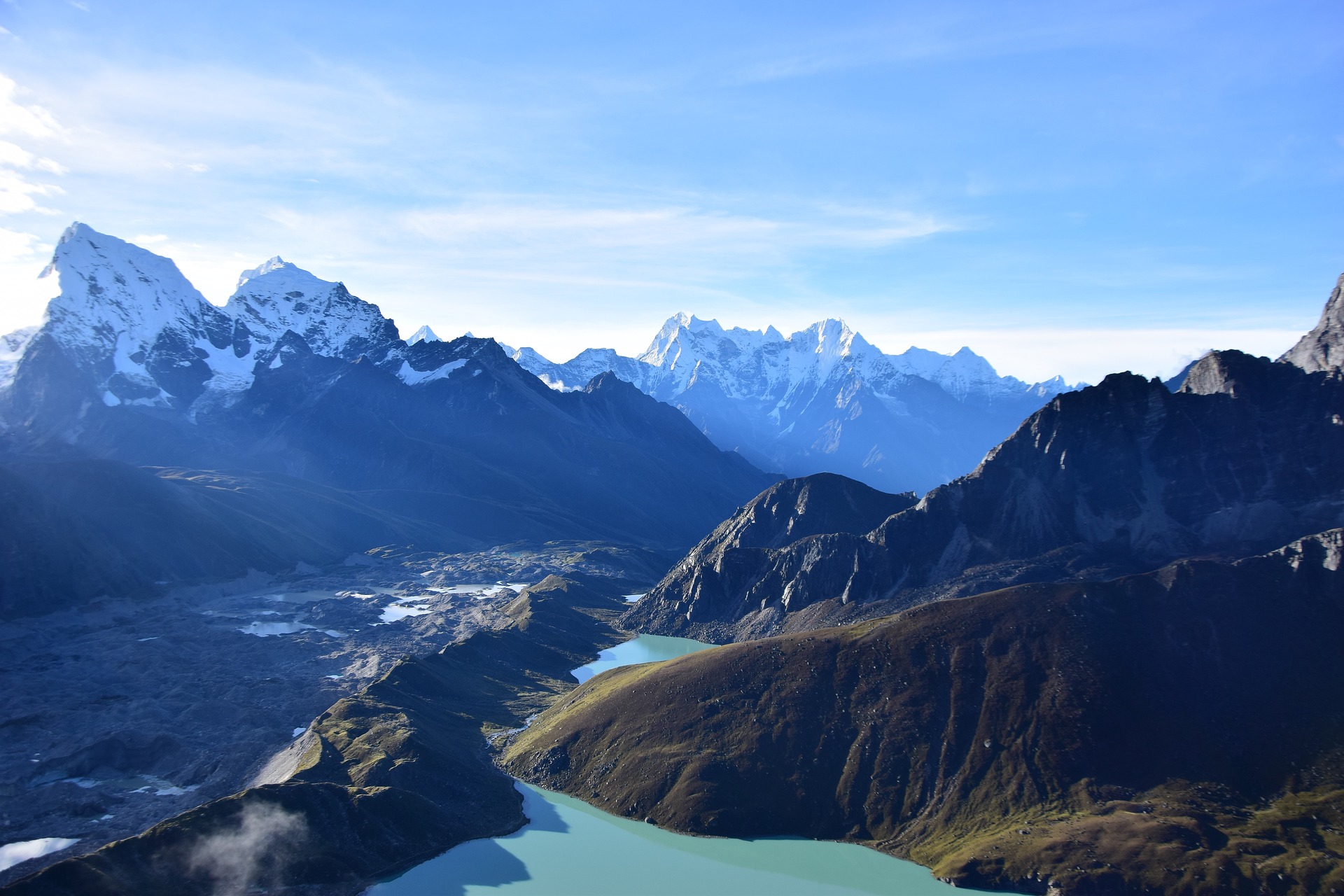
Gokyo-Ri glacier
Gokyo Lakes
The Gokyo Lakes or Gokyo Ri Trek is a fantastic variation on the Everest Base Trek. The route begins in Lukla and follows the traditional EBC trek itinerary for the first three days up to Namche Bazaar. Here it veers off to the North-west via the towns of Dole and Machemo, up to the stunningly beautiful Gokyo Lakes . The trail then ascends Gokyo Ri (5,483 meters) and traverses Cho La Pass (5,420 meters) before joining back up with the classic base camp trek at Lobuche.
The variation adds 2-3 days to an average Everest Base Camp trek but provides an excellent opportunity to avoid the crowds on the busy everest trail, as well as gives one the opportunity to trek up and down on different routes.
Chhukhung Valley
The Chhukhung Valley sits east of Dingboche and provides an alternative and longer passage to Lobuche than the traditional Everest Base Camp trail. Trekkers stay a night in Chhukhung (4,730 meters) before returning to Lobuche via Kongma La Pass (5,535 meters), an epic Himalayan pass .
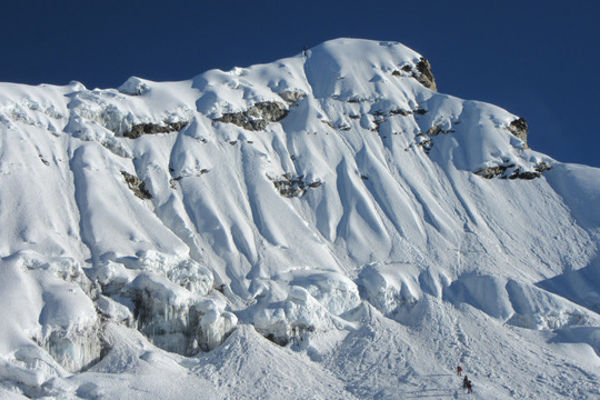
Island Peak headwall
Island Peak
Island Peak is one of Nepal’s 33 trekking peaks. Standing at 6,189 meters, Island Peak is a real challenge in terms of altitude, but only requires beginner level climbing skills (you will need to be comfortable with ice axes and crampons though). Most climbers use the traditional Everest Base Camp trek to acclimatise for Island Peak.
Returning from Everest Base Camp, you can either trek to Cchukhung via Dingboche from Lobuche or veer South-east from Lobuche traversing the Kongma La Pass to Cchukhung (4,730 meters). From here you can trek to Island Peak Base Camp (5,120 meters) in preparation for their trek / climb up to Island Peaks summit. The summit typically takes 2 days and the total trip, including Everest Base Camo, between 18-20 days.
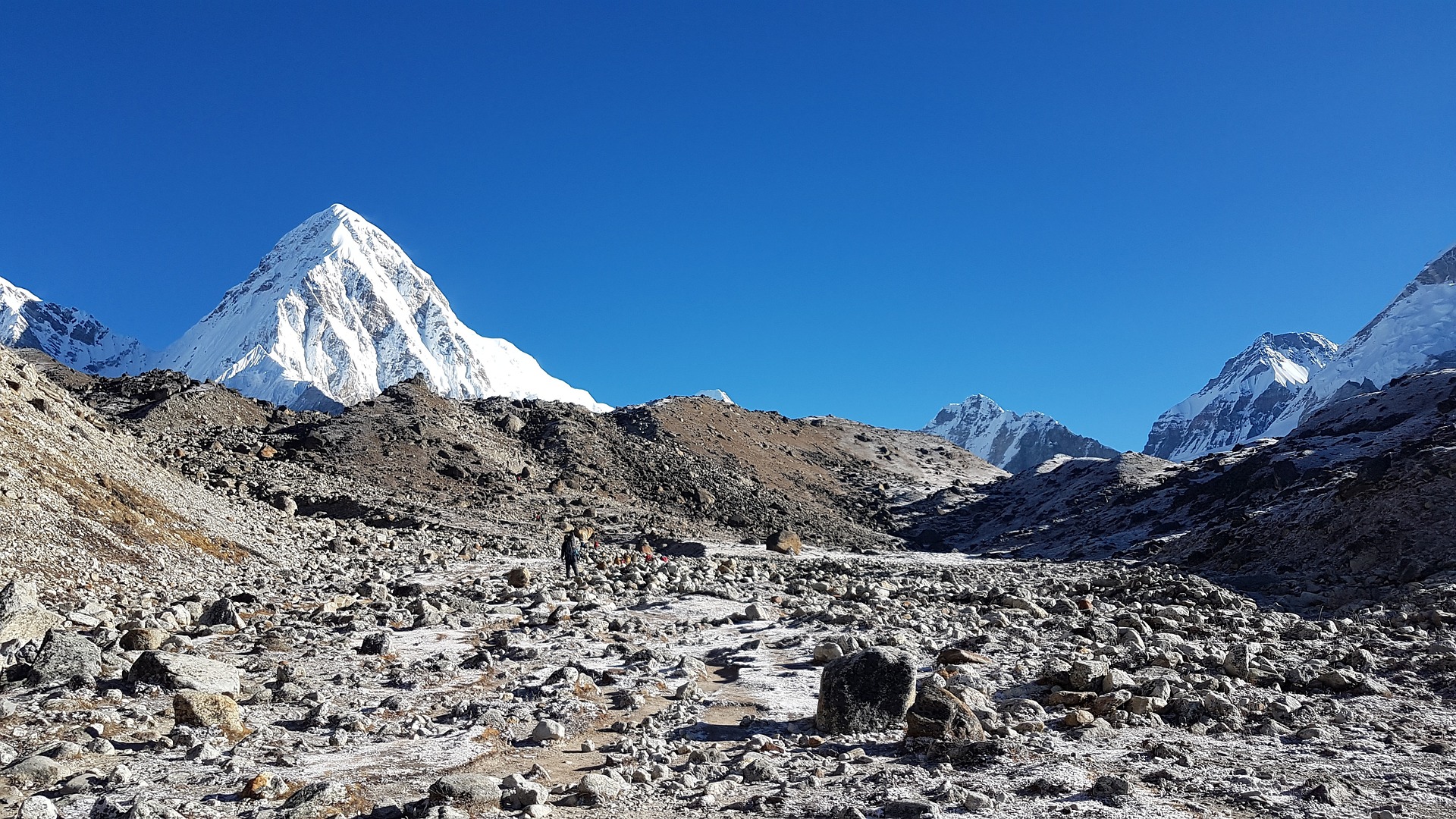
Everest Base Camp Trek FAQ
How much does the ebc trek cost.
Like many treks in Nepal, there are three ways you can plan your Everest Base Camp trek. See more in our guide on a detailed breakdown on the cost of an Everest Base Trek .
Below are four options for Everest Base Camp treks and their estimated costs.
Independent Trekking
Here you organise your trek. You will need to get yourself from Kathmandu to Lukla (a flight is the fastest and easiest; there are buses but these are rather unpleasant). You can employ the services of a porter or guide in Lukla or indeed in Namche, but it is important to note that as an independent trekker, it is illegal to use a guide or porter that is not licensed as a trekking agent through TAAN, or affiliated with a licensed trekking agent. You will need a Green TIMS card (costing NPR 2,000), money to buy food and water, a reliable and accurate map, and negotiations skills to book teahouse accommodation.
The estimated cost for an independent trek excluding flights is between $500-$800.
Local Tour Operator
There are many local tour operators in Kathmandu who organise guided Everest Base Camp treks. Generally local Nepal trekking companies are quite good. You will join a group of trekkers (up to 15 people) and have a team of porters, assistant guides and lead guides (who can speak English) of a similar size to the trekking group.
It is important to check that your local operator is a licensed trekking agent. We recommend shopping around and asking for recommendations from other trekkers. The cheap local operators tend to be the least reliable, often only providing tent accommodation or access to old and poorly run teahouses. Their ethical standards towards staff and the local environment may not be to the highest standard as well.
The estimated cost for an Everest Base Camp trek organised by a local tour operator is between $800-$2,000.
Western Run / Operated Tours
There are many Western run companies that offer Everest Base Camp treks. Most of these Western companies have their own ground teams or strong relationships with the best local tour operators who they outsource their on-the-ground operation to, whilst managing the overall tour experience.
The best Western companies own their on-the-ground operations. Expect a well-run tour with either a Western guide or a very well-trained local guide who understands the subtle service nuances expected of a Western trekker.
The estimated cost for an Everest Base Camp trek organised by a Western run tour operator is between $1,200-3,000.
Everest Climbing Expedition
A fourth option of joining an Everest climbing expedition is also possible. Major climbing operators like Adventure Consultants, Jagged Globe or Alpine Ascents usually offer Everest Base Camp trekking spaces on their Everest climbing expeditions. Securing a trekking space can be a little pricey but offers one an incredible insight into an Everest expedition as well as the chance to spend a night or two at Everest Base Camp.
If you think a base camp trek is expensive, wait till you hear how much it costs to Climb Mount Everest !

Are permits required for the EBC trek?
Yes, there are two permits you require for standard treks from Lukla to EBC. They are:
1. Trekkers Information Management System (TIMS Card)
TIMS cards are issued by the Tourism Agency Association of Nepal (TAAN). There are three different types:
- Organised TIMS Card (Blue in colour, USD 10). If you are trekking with an organised tour these will be arranged for you. You will need to provide your passport number and one passport photograph
- Individual TIMS Card (Green in colour, USD 20). If you are trekking independently (without support) you will need to get one of these TIMS cards from the Nepal Tourism Board in Kathmandu
- SAARC Country TIMS Card (Red in colour, USD 3). These cards are for nationals from the South Asian Association for Regional Cooperation, i.e. India, Bhutan, Pakistan, Sri Lanka, Maldives, Bangladesh and Afghanistan.
2. Sagarmatha National Park Entry Permit (USD 30 + 13% Govt. Tax)
The Sagarmatha National Park or Solukhumbu is the region through which the EBC trek runs. A National Park entry permit is required to enter Sagarmatha. Permits can be acquired at the first checkpoint along the route, north of Lukla called Monjo. The cost is US$30 + 13% tax for trekkers using a trek operator or agency, as well as for independent trekkers. Permits can also be acquired in Kathmandu, but we recommend getting it in Monjo as it is more straightforward.
For treks from Jiri to Everest Base Camp, there is another permit required called the Gaurishankar Conservation Area Project permit. It costs US$20 (no discount for independent trekkers or SAAEC nationals). The checkpoint is at at Shivalaya (just after Jiri). We recommend getting the permit in Kathmandu before departing as the cost is double if they have to issue the permit in Shivalaya.
As a rule of thumb, we recommend bringing at least 4 passport size photographs for all your permit requirements.
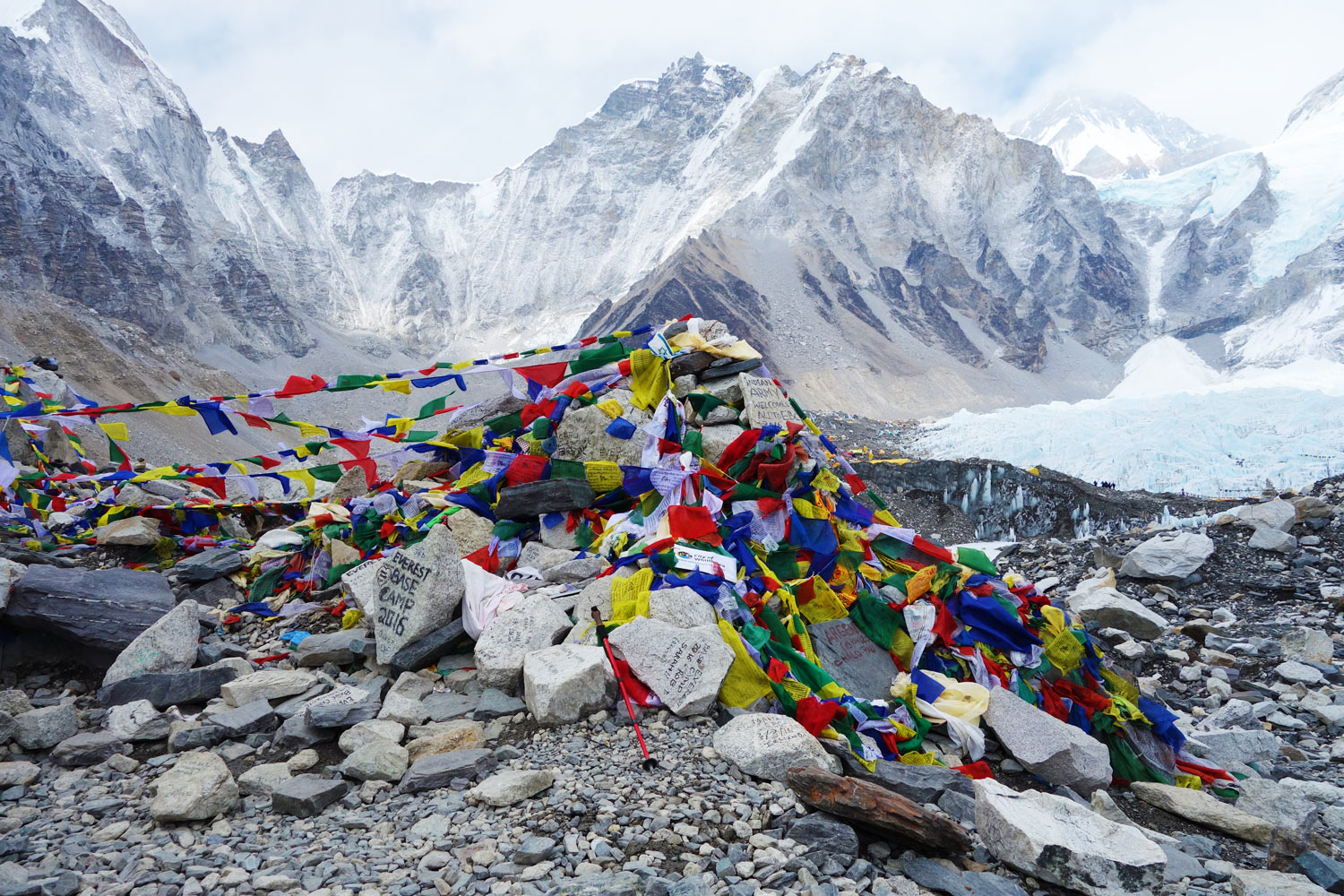
When is the best time to trek to Everest Base Camp?
The best time to trek Everest Base Camp is during the dry and warm months of September through November of March through late May / Early June.
The monsoon rains arrive in mid-late June and get into full swing for the months of July and August (as seen in the average rainfall map below). The route is really too wet for trekking and you would be better placed to explore treks in rain shadow areas like the Upper Manang, Mustang, Annapurna or Dolpo region.
December, January and early February are very cold. Treks run during these periods but be prepared for freezing temperatures and possible snow flurries. The upside is that the route is a lot quieter than in the peak seasons.
The chart shows average temperatures and rainfall in Nepal (data from 1960-1990 compliments of the Climate Change Knowledge Portal at the World Bank ).

Is altitude sickness a risk on the Everest Base Camp hike?
Yes, altitude sickness is a risk on the Everest Base Camp route. The trek takes one from a moderately high altitude, 2,800 meters in Lukla, to high altitude, over 5,300 meters at Everest Base Camp and over 5,500 meters at Kala Patthar. At these higher altitudes, the body needs to have acclimatised to the lower saturation of oxygen in the air in order to avoid the symptoms of altitude sickness (or what is sometimes referred to as Acute Mountain Sickness – AMS).
The good news is that a typical Everest Base Camp hike has a slow ascent profile which maximises the amount of time available to acclimatise. Nonetheless, every year 100s of people suffer altitude sickness symptoms and some need to cut their trek short due to more severe complications.
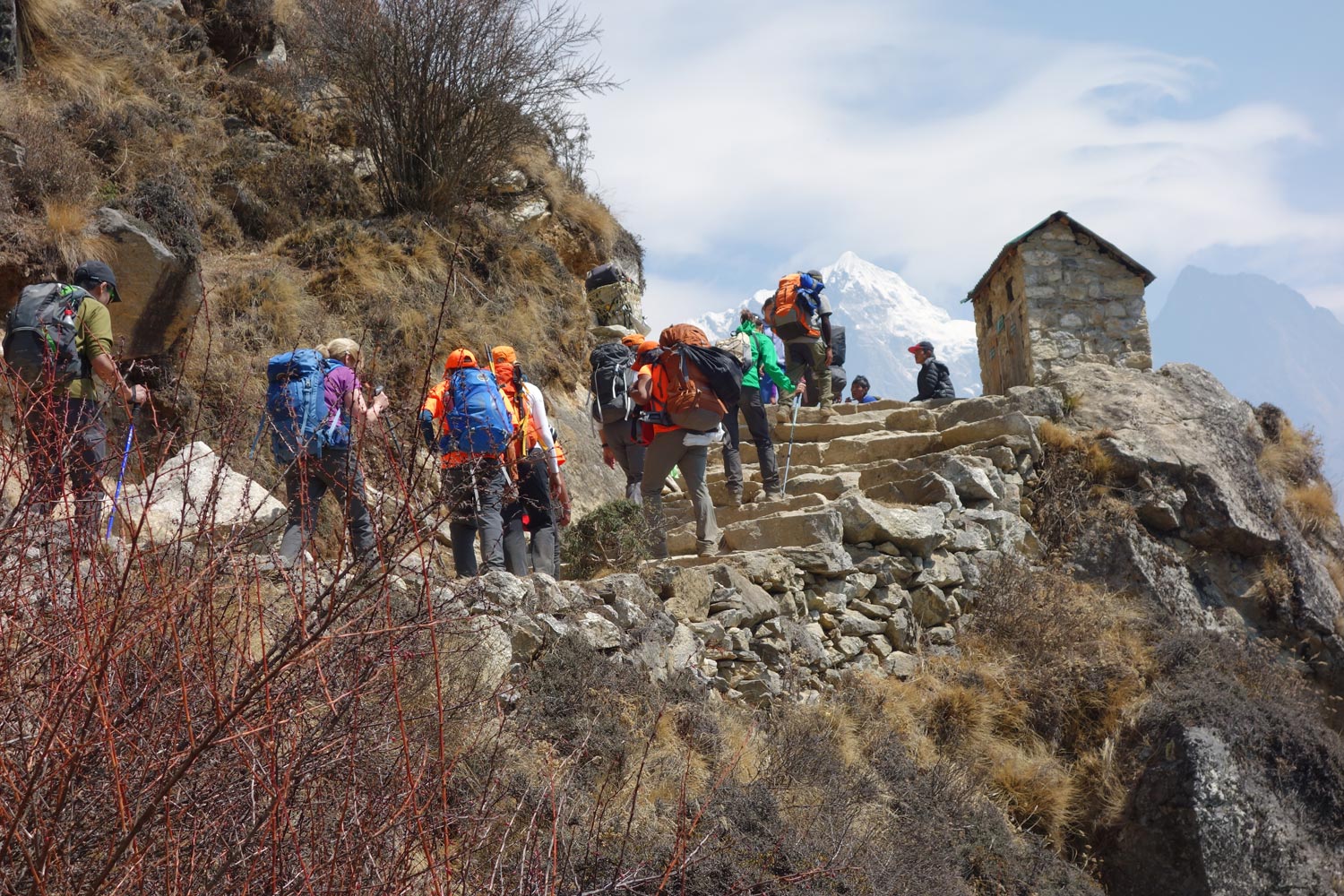
How difficult is the Everest Base Camp Trek?
The difficulty of the Everest Base Camp Trek is relatively low. It should be noted that the Everest Base Camp trek requires no climbing expertise and there are certainly no technical climbing sections. With determination and a basic fitness level, you should be able to trek the route. We have seen old and young, overweight and underweight complete the trek – all with a smile on their face!
With that being said, there are certainly some factors that should be considered prior to your trek, such as altitude, length and training that will enable you to better understand what you are getting yourself into before deciding.
What gear do I need for the EBC Trek?
One of the most frequent questions that we get asked is what gear should be packed for an Everest Base Camp trek.
To make your life a lot easier we have written a very detailed Everest Base Camp packing list article. The list is fairly exhaustive but includes all the absolutely necessary items of clothing and outdoor gear that you should bring with you.
You will have the opportunity to either buy or rent gear in Kathmandu, Lukla or even in Namche Bazaar, but in general we recommend you bring with you the main items (i.e. hiking daypack , hiking boots, warm down jacket, sleeping bag and sleeping mat , trekking poles , appropriate trekking clothes, headgear and headlamp and gloves etc.)
What travel insurance do I need for the EBC hike?
Trekking Everest Base Camp comes with obvious risks. We recommend you get travel and trekking insurance for all treks in Nepal .
On the Everest Base Camp route, you will reach a maximum altitude of 5,416 meters, so it is important you choose an insurance package that covers you up to that altitude.

Are there any recommended guidebooks for the Everest Base Camp Trek?
Absolutely. There are some great guidebooks and trekking maps to choose from when doing the Everest Base Camp Trek.
The classic EBC trail itself is well-worn, but there are many smaller yak trails that can confuse people.
We recommend taking a detailed trekking map. The region is sparse, and it is possible to get lost in the many valleys that lie on either side of the main trail. The most recent Lonely Planet Trekking in the Nepal Himalaya provides the most up to date information and maps of the region.
Sian Pritchard-Jones and Bob Gibbons’s book: A Trekking Guide to Everest is also rather good.
For a more general guide to Nepal, you may want to check out the Nepal Lonely Planet Travel Guide .
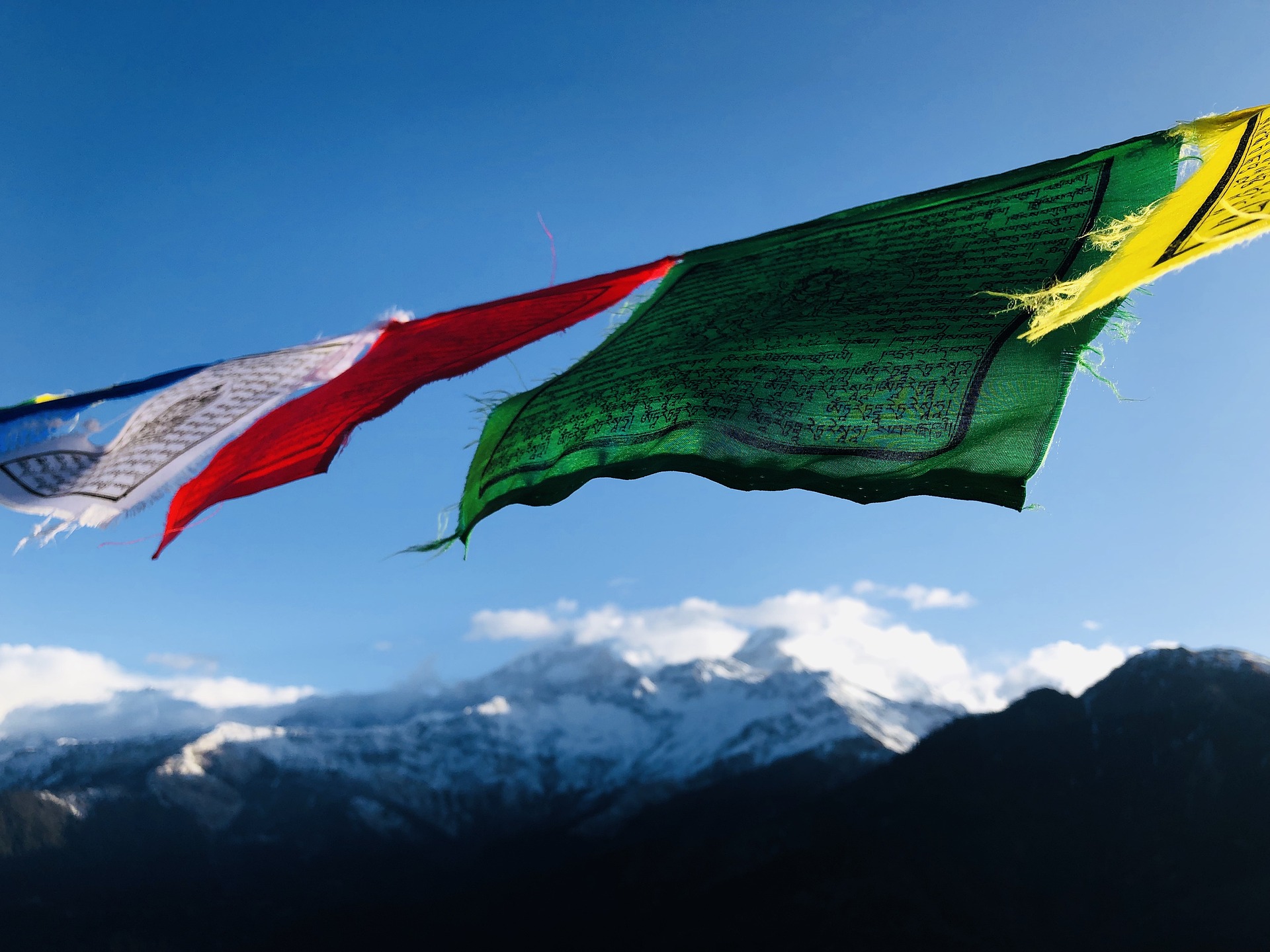
Are there any other hikes in Nepal you would recommend?
Yes, there are many other hikes in Nepal that I love.
Some of the most popular alternative Nepal trekking routes are the Annapurna Circuit Trek , the Langtang Valley Trek and the Manaslu Circuit Trek . If you're looking for some easy Nepal hikes , then check out the Poon hill hike or the Royal hike . For short Nepal hiking routes see the Helambu hike , which is near Kathmandu.
Continue browsing
See more information on Nepal . Or check out these other Everest/Nepal articles:
- Best Climbing Mount Everest Tips
- Food on the Everest hike
- Internet Access on EBC hike
- Everest Base Camp Trek Deaths and Statistics
- Best Places to Visit in Nepal
- What to Expect in Nepal Tea Houses
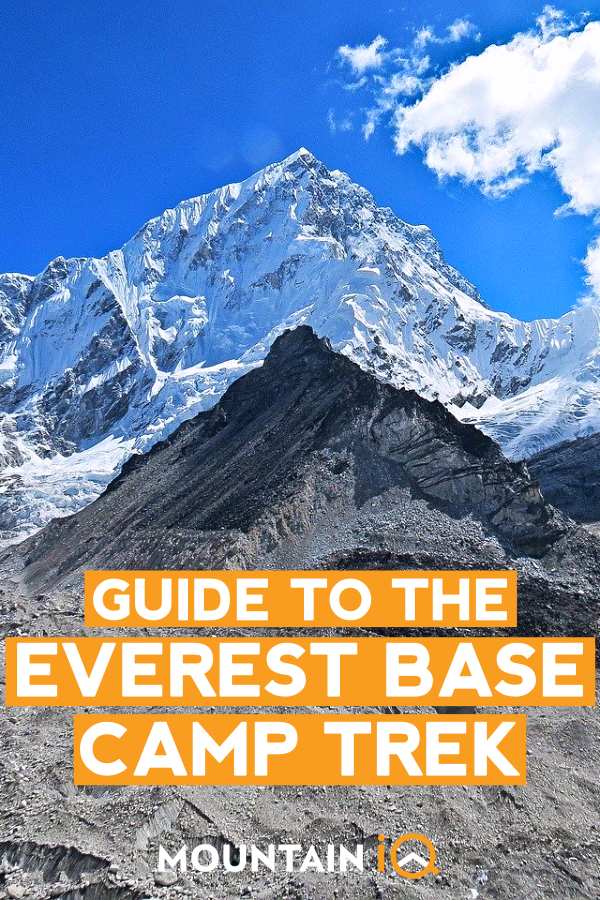
About the author
Mark Whitman
Mark has trekked extensively in Asia, Europe, South America and Africa. He founded Mountain IQ in 2014 with the sole aim to be the best online information portal to some of the most popular mountain destinations around the world. When not writing for Mountain IQ, Mark is out exploring the outdoors with his wife!
Leave a Reply
Your email address will not be published. Required fields are marked
Nice article. Full of true information and very supportive for new trekkers.
We work with local guides to offer great value adventures at unbeatable prices

Everest Base Camp Trek: The Ultimate Guide
Jackson Groves
Posted on Last updated: August 10, 2023
Categories NEPAL , HIKING
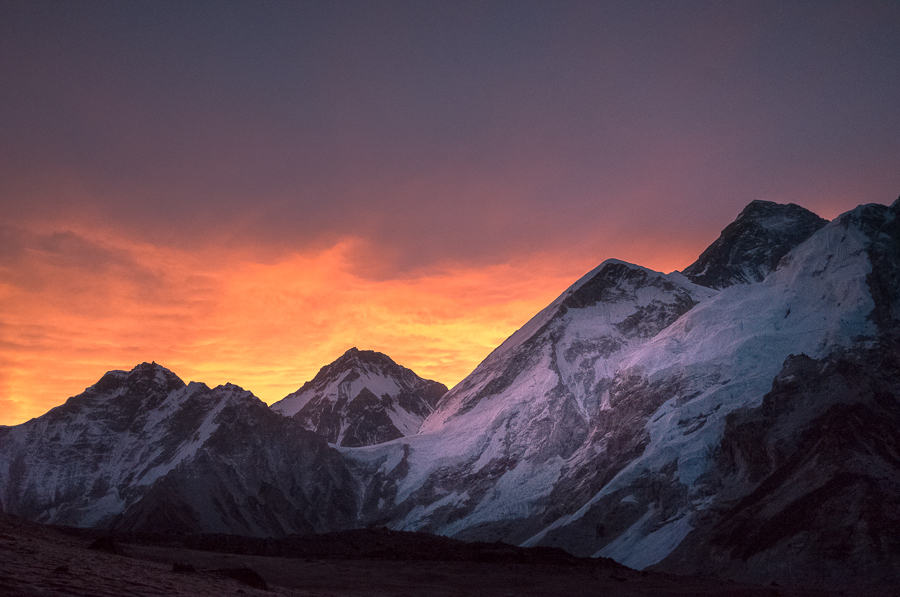
Mt. Everest is the highest mountain in the world and trekking to the base camp is no easy feat either. It’s a journey through some of the most spectacular mountain views but also through a number of beautiful villages along the way. The Everest Base Camp Trek takes anywhere from 9 to 15 days depending on your route and itinerary but also how well you acclimatize.
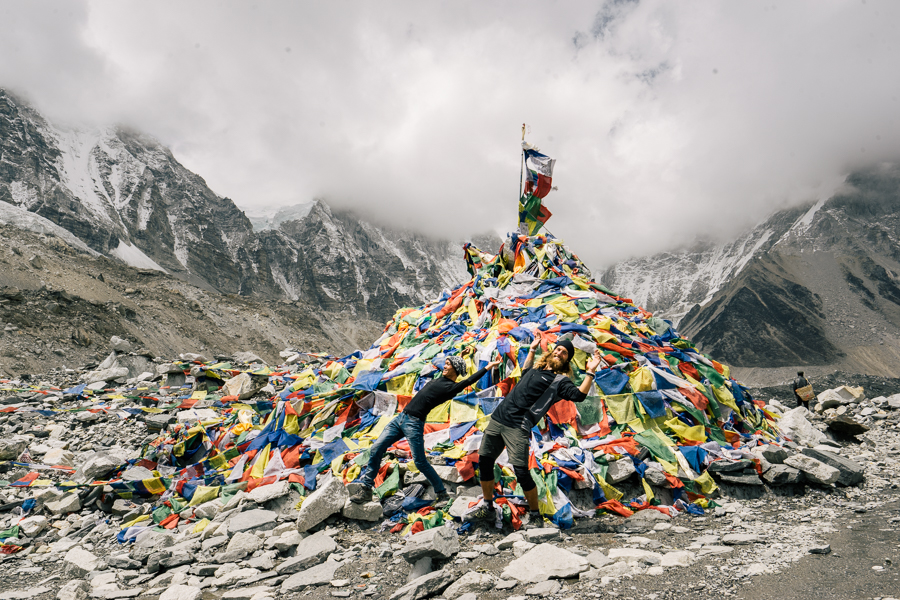
In this article, I will cover everything you need to know about the logistics of the Everest Base Camp (EBC) trek but I will also share with you my experience on each day of the trek. A short journal entry with a vlog from my experiences from each day will give you an idea of what to expect and you can see how the journey went for me. After sharing my experience, I will then include all of the information you need to know in this complete guide about trekking to Everest Base Camp.
BEST TREKKING COMPANY IN NEPAL
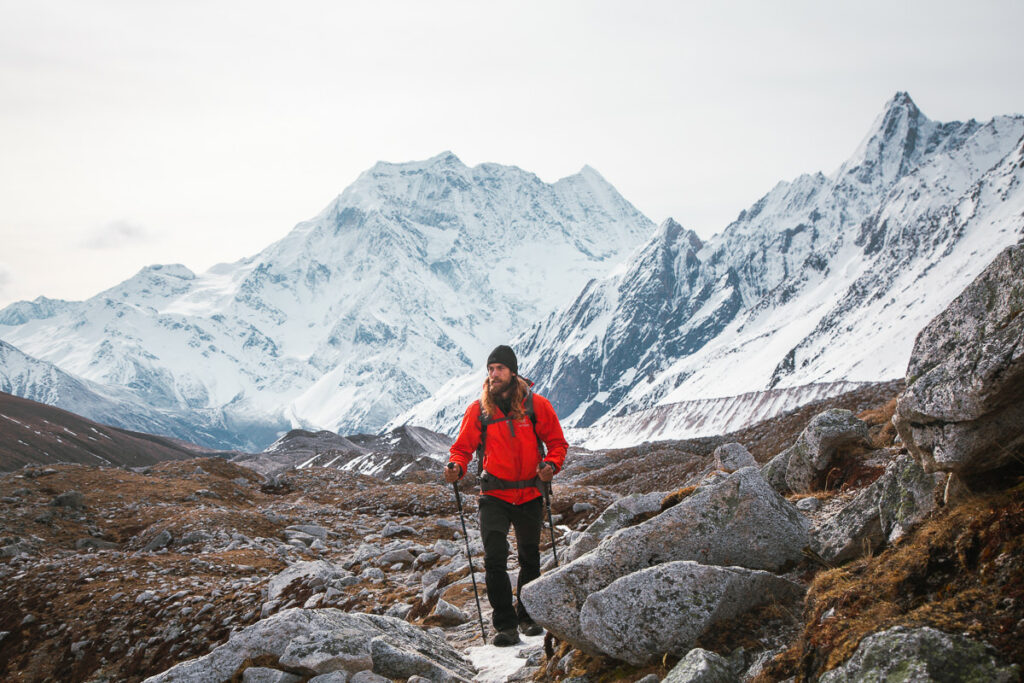
Interested in trekking in Nepal or doing the Everest Base Camp Trek? I recommend booking your trek with Himalayan Masters , which is the company I use for all of my treks in Nepal. Use my code JACKSON5 when you book to receive a 5% DISCOUNT .
Table of Contents
EVEREST BASE CAMP TREK DETAILS
- Distance : 120 km round-trip from Lukla to Base Camp and back to Lukla (You will fly to Lukla from Kathmandu)
- Days required : 12 -14 days
- Total Incline : (Undulation) – 6015 m
- Total Decline :(Undulation) – 5821 m
- The highest point on the trek : 5640 m/18 500 ft, this is actually at Kala Patthar, which you will hike to in the morning after reaching Everest Base Camp. This is where you get the best views of Mount Everest.
- Difficulty : It’s hard for an average hiker but the altitude is definitely more difficult to manage than the distance with several rest days and acclimatization days.
- Permits : Your tour operator will take care of these but in case you do the trek independently it’s good to know that you will pay a Local Government fee and Sagarmatha National Park permit, which totaled together cost about $40-$50
- Cost per day : This will depend on your tour price and whether you do the trek with a group, a porter, a guide, or independently. Somewhere between USD $40 (without flights) $60 per person per day with all meals, transport, and guides included.
- Guide : It isn’t required but highly recommended. You can do the Everest Base Camp Trek in a few different ways such as by yourself with no guide, with an experienced guide or in a group with a guide.
- Accommodation : Guest Houses, also known as Tea Houses along the way where you will sleep in a comfortable bed and have access to showers (extra charge) and restaurant facilities. Very comfortable accommodation and great after a long day of hiking.
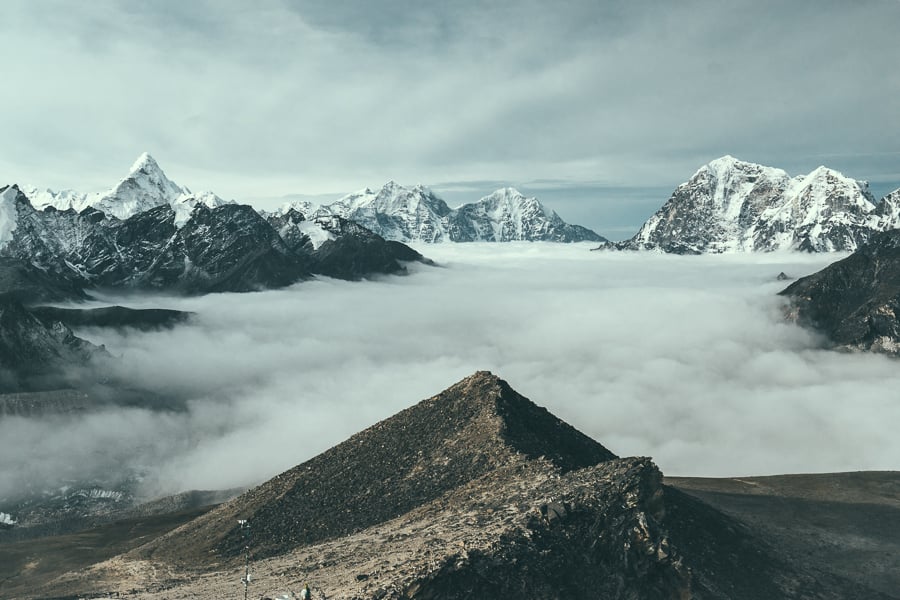
TRY THE 3 BEST TREKS IN NEPAL

Manaslu Circuit : My personal favorite 2-week trek through Tibetan villages and stunning scenery. Less crowded and more authentic.
Annapurna Circuit : The most beautiful & scenic 2-week trek in Nepal although can be crowded at times.
Everest Base Camp Trek : The most iconic 2-week route reaching the famous (EBC) Everest Base Camp at 5,300m.
BOOKING A GUIDE FOR THE EVEREST BASE CAMP TREK
The Everest Base Camp Trek doesn’t require a guide but it’s great to have a guide managing the logistics such as directions, tea-houses, distances, medical issues, and the overall organization. I’d say 90% of trekkers go with a guide. I highly recommend booking with Himalayan Masters which is one of the top trekking companies when it comes to the Everest Base Camp Trek. I’ve trekked many different routes in Nepal with them and I’m a big fan of their attention to detail.
The trek costs around $1500 USD with Himalayan Masters as of 2022 and includes all transfers, accommodation, meals, drinks, permits, and even the hotel stay before and after the trek at a high-quality hotel. I honestly had a great time on this trek and I can wholeheartedly recommend Himalayan Masters.
You can use my discount code ‘ JACKSON5 ‘ for 5% off the total price of your trek with Himalayan Masters which is a pretty handy saving.
Email: [email protected]
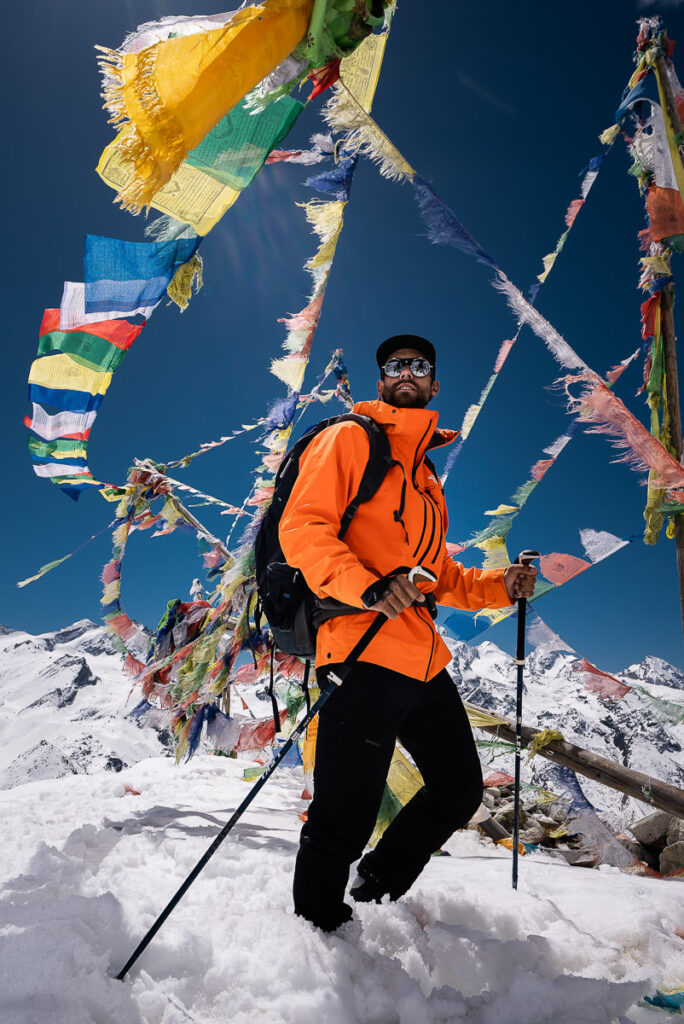
TOP 3 PLACES TO STAY IN KATHMANDU

- Ultimate Luxury: The Dwarika’s Hotel – Luxury, Spa-service, Pool
- Best Value : Aloft Kathmandu Thamel – Swimming Pool, Gym & Great Restuarant
- Budget Choice: Hotel Jampa is easily the top cheap hotel in Kathmandu
MY EXPERIENCE ON THE EVEREST BASE CAMP TREK
I’d like to share with you my experience and photos from my two weeks of trekking to Everest Base Camp. I hope you enjoy recounting the journey as much as I did.
Day One, Two & Three: Kathmandu to Lukla to Phak Ding to Namche
Day one began with an incredible flight from Kathmandu to Lukla. Unfortunately for me, I had come down with food poisoning the night before the trek so it was a rough start for me but I decided to battle on. The flight gives you incredible views of the Himalayas before you touch down at Lukla Airport, one of the most famous and scariest airports in the world. The landing strip is on a downwards slope and gives passengers a heart-in-mouth moment on take-off and landing.
After landing, we had a quick coffee and look around Lukla before making the short and relatively flat trek through the villages and forest to reach Phak Ding. Day one is a short trek but you have made your way up pretty high even just by landing at Lukla Airport so it is not a bad idea to take the first day easy, given that your biggest battle on this trek will be the altitude, not the distance or speed.
Day Two for me was actually a day of recovery in Phak Ding where I spent the entire day sick in the guesthouse. There is usually one day scheduled on your itinerary for sickness or rest day so I had used mine early!
Day three was a tough day as I was still recovering but we made the climb up to Namche, which is a winding climb through the forest and out above the tree line. Namche Bazaar is located at an altitude of 3450m inside the Sagarmatha national park, a UNESCO world heritage site and it is actually known as the last frontier for trekkers and climbers before the trek to Everest Base Camp starts to get serious.
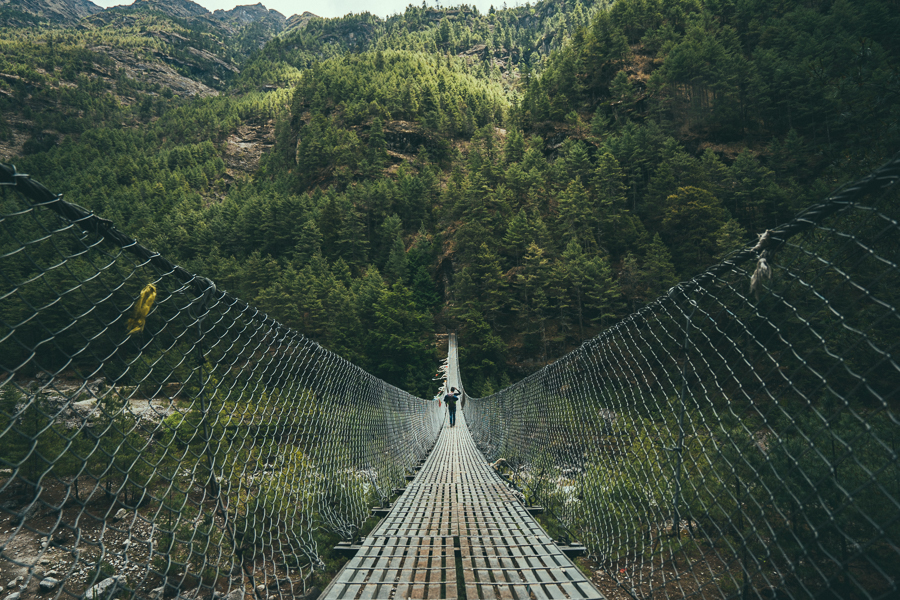
Day Four & Five: Namche to Tengboche to Dingboche
Day four is a big day of climbing. Namche Bazaar is 3,440 meters and Tengboche is 3,860 meters but the constant undulation on the trail means you will climb almost 900 meters of incline throughout the day.
The day begins by following the valley wall as you get some great views of the Everest mountain range out in front. The path then heads down into the valley floor as you lose a lot of elevation. However, you will then cross over the river and gain all the elevation back as you approach Tengboche where you will stay for the night.
Expect to have views of the mighty mountain Ama Dablam as well as Lhotse, Nupste, and even the peak of Mount Everest. Interestingly this will be one of the best views you have of Mount Everest until you reach Kala Patthar in a few days’ time.
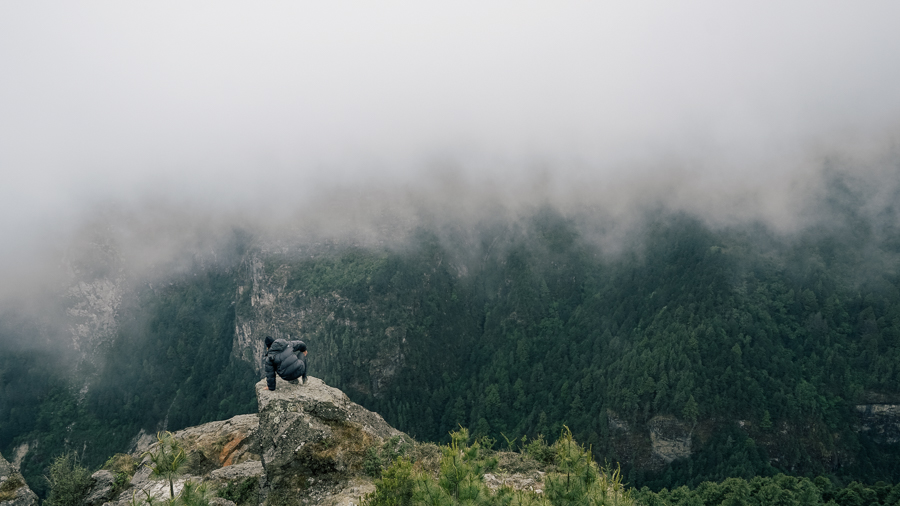
On day five of the Everest Base Camp trek, you say goodbye to the village of Tengboche and head towards Dingboche. It is a stunninng day as you voyage through the valley as the glacier river flows down below while snow-capped peaks loom in the distance. Along the trek, you will stop for tea in the village of Pangboche with lots of views of Ama Dablam mountain .
The elevation gain on day five is 700 meters and the entire journey will take about 5-6 hours at a moderate pace. Dingboche is 4,400 meters above sea level so it’s common to start to have a couple of symptoms of altitude sickness at this stage of the trek.
When you leave Tengboche, you begin a descent into the beautiful forest and can enjoy the shade as you pass through the village of Deboche. After you pass through Deboche, the trail gains some elevation and you will cross a suspension bridge, which guides you to the left side of the valley. Ama Dablam is still in view as you navigate the steep sections of the incline.
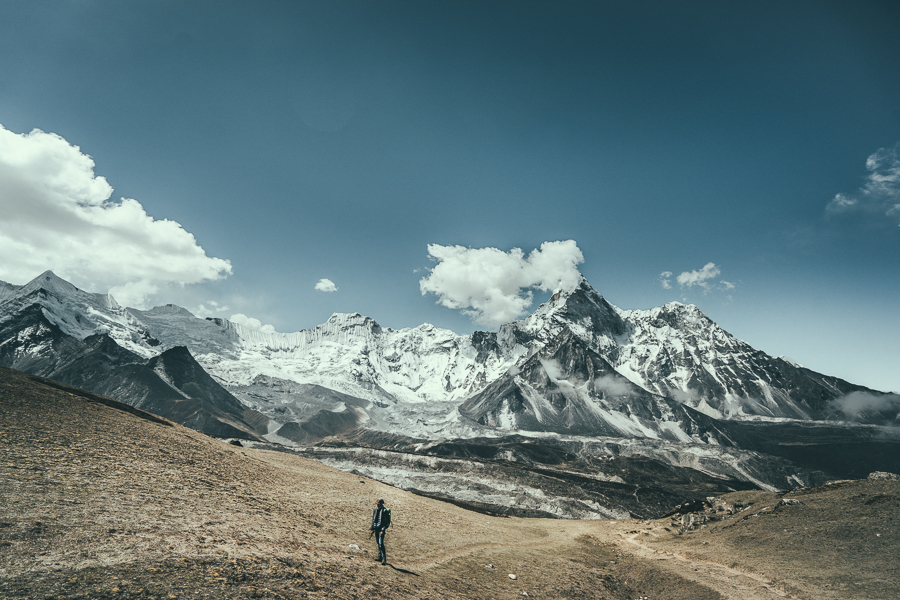
Day Six & Seven: Chuukhung Ri Acclimitization and Dingboche to Lobuche
Day six was an acclimatization day up to Chukhung Ri viewpoint, which was actually one of my favorite days. Because we would stay a second night in Dingboche, we left our bags in the tea house and did the climb up and down Chukhung Ri to help our bodies adjust to the altitude. The idea is to hike high and sleep low, which helps the body adapt.
Chukhung Ri is actually at 5500 meters, which is more than 1000 meters above Dingboche. This is a steep climb and you don’t need to go all the way to the summit. However, with spectacular views, isolation from other hikers, and a good chance to help your body adapt to the altitude, it’s a great day excursion with incredible scenery.
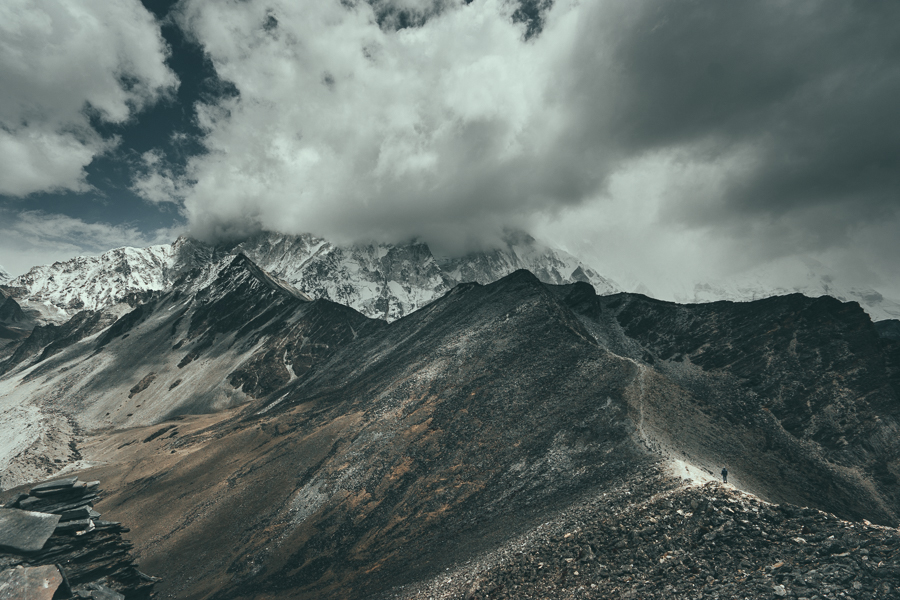
On day seven of the Everest Base Camp trek, we hiked from Dingboche to Lobuche, which is actually the second-highest village on the entire trail. Today is also the first time we will see the Khumba Glacier, which is one of the highlights of the trip.
The total elevation change for day seven is 500 meters in altitude but you will climb 600m in total for the day taking into account a few downhill sections on the trail. It’s a shorter day taking just four hours to reach Lobuche from Dingboche.
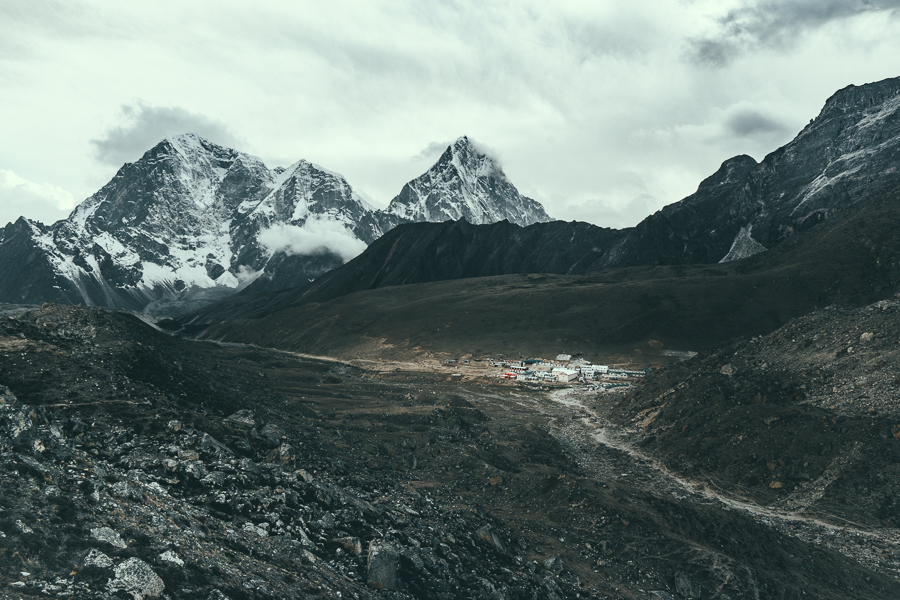
Day Eight: Lobuche to Gorak Shep to Everest Base Camp
On day eight of the Everest Base Camp trek, it is finally time to reach Everest Base Camp. From Lobuche your first trek to Gorak Shep, which is the highest village you sleep at throughout the trek.
Gorak Shep is a small village, and it’s the closest to Everest Base Camp is also the closest village to Everest Base Camp. Basically, you will trek to Gorak Shep, have an early lunch, and drop off your bag before doing the round-trip trek to explore Everest Base Camp. Then you will return to Gorak Shep where you will stay the night before heading to the nearby Kala Patthar in the morning.
The journey from Lobuche to Gorak Shep is along a rocky path, which slowly gains elevation as you walk next to the Khumbu Glacier. From Gorak Shep to Base camp, you will reach an altitude of 5,364m, which won’t be the highest on the trek as you will go higher the next morning at Kala Patthar.
When you leave Gorak Shep you walk next to the Khumbu Glacier with the Everest Mountain Range looming behind. The glacier is covered in dust and rocks due to the sediments, which have been falling from the surrounding peaks over the last years.
The trail continues alongside the glacier until you reach Everest Base Camp. It’s interesting because you actually can’t see Mount Everest from the base camp, which surprised me but the surrounding peaks are still very impressive and dramatic. Depending on if you come during the climbing season or off-season will alter how the base camp looks. I visited in the low season so there were no tents set up and it was pretty barren.
The trail continues past some Sherpa prayer flags as the rocky terrain leads you towards the famous Everest Base Camp rock, which is covered in hundreds of prayer flags. We’ve made it!
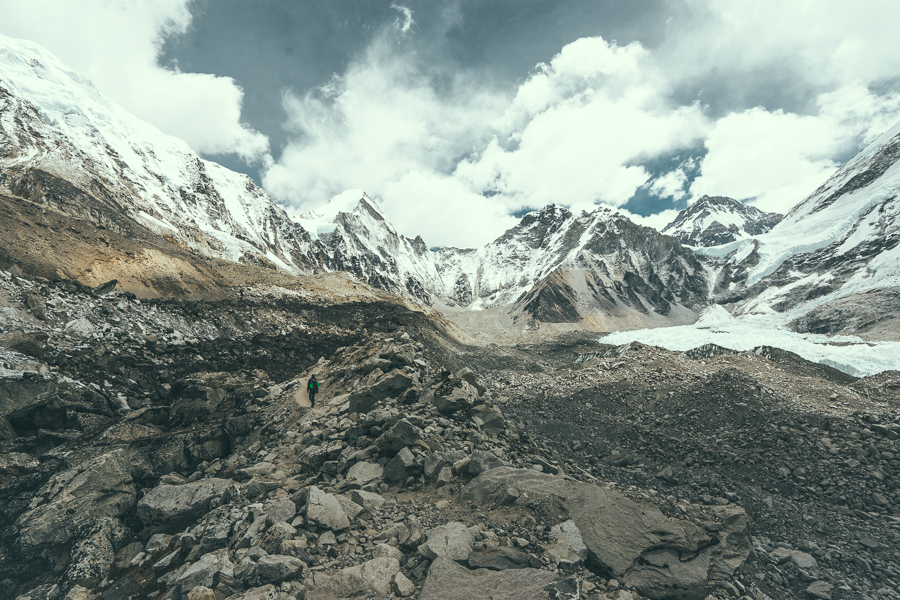
Day Nine: Kala Patthar
The highlight of the Everest Base Camp trek was the climb up to Kalapathar (also spelled out as Kala Patthar). It’s a 5,540-meter peak, which looms over the small village of Gorak Shep where you have just spent the night. It’s worth the freezing wake-up call in the morning as it is one of the best spots in Sagarmatha National Park to take in the views of Mount Everest.
It’s only a 3-kilometer round-trip trek from Gorak Shep with 300 meters of incline but at such high altitude, it can be quite difficult. I suggest starting 1.5-2 hours before sunrise so you are at the summit when the morning glow begins. After enjoying the sunrise with epic views of the cloud-filled valley and Mount Everest, we began the trek back down to Lukla.
It would take us another two days to reach Lukla, which is less than normal but going down is much easier.

Day Ten & Eleven: Heading back down
Heading back down is now at the pace of your choosing. We were keen to get back to Kathmandu so we took just two days to head back down the mountain. With altitude sickness no longer an issue, you can really make some good time.
If you are ahead of schedule you can keep going to the next village as there are no pre-made bookings. Heading down is a great feeling as you have accomplished reaching the base camp and you can now just breathe in the mountain air and enjoy the descent.
EVEREST BASE CAMP TREK: THE ULTIMATE GUIDE
In this section of the blog post, I will share with you the logistics and everything you need to know about trekking to Everest Base Camp.
HOW TO TREK TO EVEREST BASE CAMP
You have a few different options depending on your experience and requirements:
- Book a package through an agency to join a tour group
- Do the trek independently (not with an agency) but still hire a guide and/or porter
- Do the Everest Base Camp Trek entirely independently
If you are alone and don’t want to do the trek independently then it is a great idea to join a group. There are lots of free time and chill moments at the teahouses to play cards and chat with your group.
Doing it entirely independently means you are in charge of all the logistics and it can be quite stressful if you aren’t experienced at managing all flights, maps, costs, negotiations, food, language barriers, first-aid and more.
BOOKING AN EVEREST BASE CAMP TREK IN ADVANCE
These are the most popular routes and are organized by the top tour companies who have a global reputation.
The Everest Base Camp Trek doesn’t require a guide but it’s great to have a guide managing the logistics such as directions, tea-houses, distances, medical issues, and the overall organization. I’d say 90% of trekkers go with a guide.
I highly recommend booking with Himalayan Masters which is one of the top trekking companies when it comes to the Everest Base Camp Trek. I’ve trekked many different routes in Nepal with them and I’m a big fan of their attention to detail.
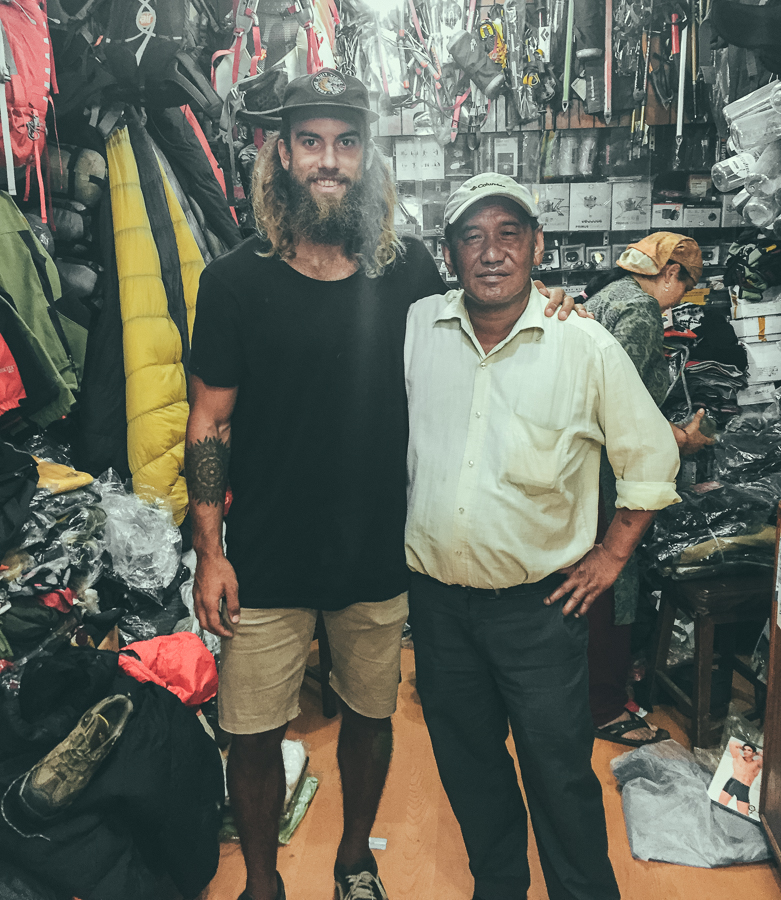
CHOOSING THE RIGHT TOUR AND A GUIDE
Trekking to Everest Base Camp can be done without a guide although I suggest hiring one. Here are 3 reasons why:
- Directions : The route isn’t incredibly hard to follow but there are many twists and turns I would have missed had I not had a guide. The route is available on many maps and map applications but it isn’t a clear trail throughout and some previous experience following a trail in a foreign country would be necessary.
- A guide is relatively cheap to hire : Included in your trekking package will be a qualified guide. However, in your package is also meals, accommodation, flights, etc. The guide him or herself will only cost $10-15 per day.
- When things go wrong : My guide helped me through food poisoning, altitude sickness and was as much a nurse as a guide. I rarely get sick at normal heights but altitude sickness is uncontrollable. I am pretty fit and it still smashed me hard. You can go it alone and be fine but it’s comforting to have a guide there when you come into trouble, especially with altitude sickness. My guide had seen it all before so his calm made me feel better about feeling sick for four days straight.
If you think you will get a guide like the majority of people on the Everest Base Camp, you have a lot of options and things to consider. Pictured below is my guide, Lapsang, who was a legend and someone who became a good friend. When I left Nepal he waited at the bus stop for two hours with me and gave me a Nepali scarf as a gift.
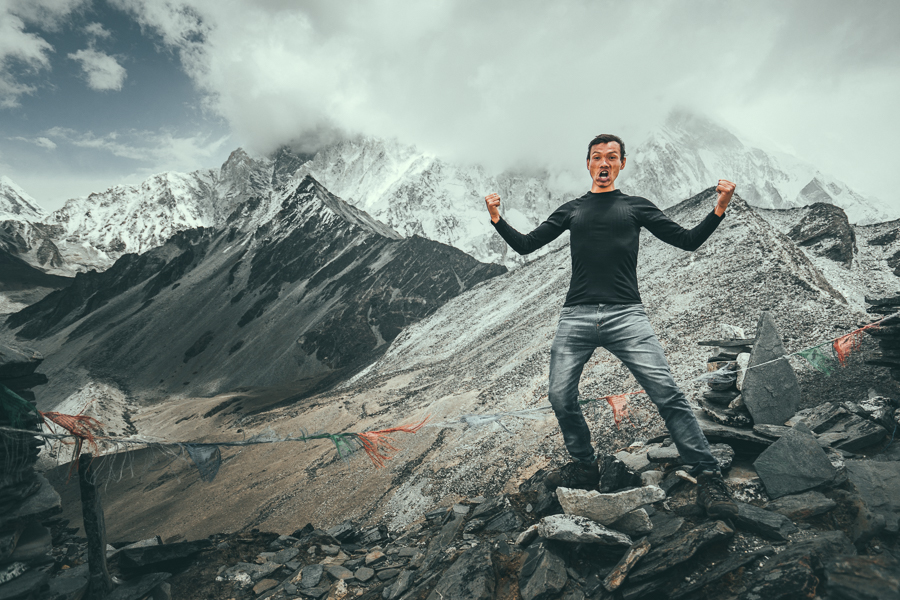
I suggest going with a small group of friends. We saw a few big groups and it looked like a Contiki tour compared to the experience I had with just myself and my guide. Only get a porter if you really need it. You should be able to carry your bag for 4-5 hours of trekking each day.
My guide, Lapsang Tamang, had done the trek multiple times as a porter and now many times a guide. He said he has lost count but somewhere over 20 times, he has been hiking the Everest Base Camp Trek. The best thing to do is to contact my guide and arrange to meet him first in Kathmandu so you can chat and decide if you want to go ahead. You will be together for 12 days after all!
You can directly contact my guide Lapsang by emailing him here: [email protected]
Lapsang is an awesome guy and I had too many chai tea hangouts with him before and after the trip. Lapsang and I became friends during the trip and afterward, we went bungee jumping, cooked Dal Bhat at his apartment, and visited Swayambunath Temple.
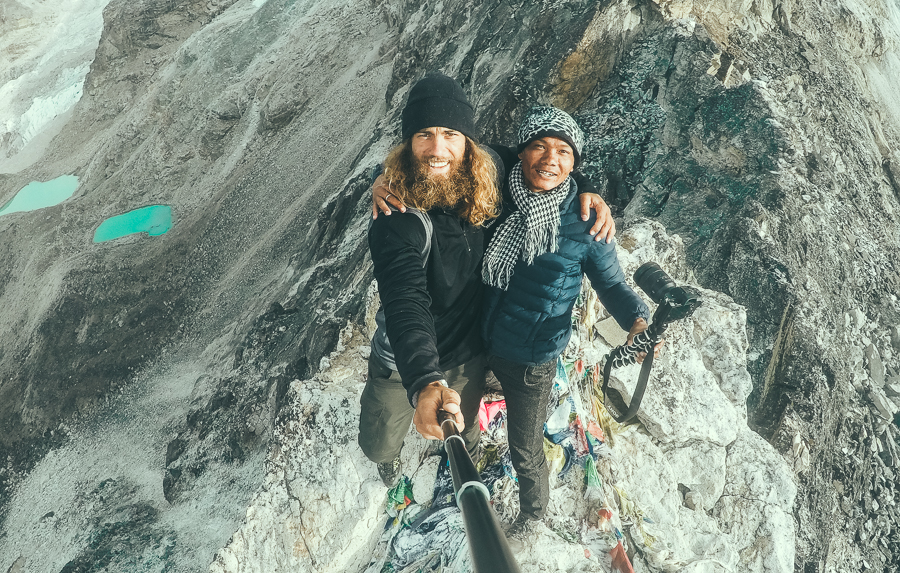
EVEREST BASE CAMP PACKING LIST
I had no winter clothes or even trekking shoes before getting to Kathmandu and bought it all for under $200 brand new (Likely fake North Face). But just as a guide you can get all the gear new for under $200. Bargaining/second hand etc. may help you get it a bit cheaper but this was one time I didn’t want to be so tight with money then freeze my ass off later on top of a mountain.
Keep in mind you won’t be doing any washing. Clothes that dry quickly and are lightweight are key. I showered once… Here is a list of what I took:
- 2 pairs of pants that rip off into shorts ($15 each in Kathmandu) (Super Safari style but actually handy in this situation.)
- 2 long sleeve quick-dry material shirts ($10 each in Kathmandu)
- 5 Pairs of Thermal North Face socks ($2-3 per pair in Kathmandu)
- 1 Fleece pants and sweater. ($25 for top and bottom in Kathmandu)
- 1 Thermal Lycra long sleeve and pants ($20 in Kathmandu)
- 5-6 pairs of quick-dry underwear
- 1 huge waterproof down jacket (Rented for $1 a day in Kathmandu)
- Beanie ($1 in Kathmandu)
- Neck Buff ($2 in Kathmandu)
- Gloves ($5 in Kathmandu)
- Water Purification pills and 1L bottle
- Camera gear and electronics (Not necessary but up to you. Obviously I carried a lot)
All of this should fit into a backpack no bigger than 50L and be less than 15kg. I used my 60L backpacking bag because I didn’t want to buy a new bag for a two-week trek. It worked out fine and weighed about 13kg including all of my lenses, chargers, and power banks.
What are my favorite pieces of trekking gear?
There are six pieces of gear that I simply never forget when I go trekking. These are five items that I using right now and this list gets updated every year! Here are my trekking essentials.
- Arcteryx BETA AR Rain Jacket : This is my go-to rain jacket. It’s super light, folds down into a tiny ball, and protects brilliantly in a storm. This one never leaves my backpack.
- Salomon X Ultra 3 Mid GTX Hiking Boots : For the best ankle support, waterproofing, and durable exterior I’m a fan of tough but light hiking boots like these Salomons for my adventures.
- Black Diamond Head Torch : I can’t tell you how many times, I’ve arrived back from a hike unexpectedly late. I always keep this lightweight but strong headtorch in my bag for the unexpected.
- Darn Tough Socks : These are the most comfortable hiking socks I’ve ever worn and last for years. They also have a lifetime warranty and you just send them in with a hole and they replace it no questions asked.
- Osprey Atmos AG 65L Backpack : I’ve never had a more comfortable 65L pack than this one. I got it in the Navy Blue and have trekked with it through many a mountain.
- Bl ack Diamond Trekking Poles : They might feel weird at first, but on a long trek with incline and decline you’ll begin to love these.
- Grayl GeoPress Water Filter Bottle : I’ve used this for three years. It filters your water with one press and you can drink directly from it. Never buy a plastic water bottle again!
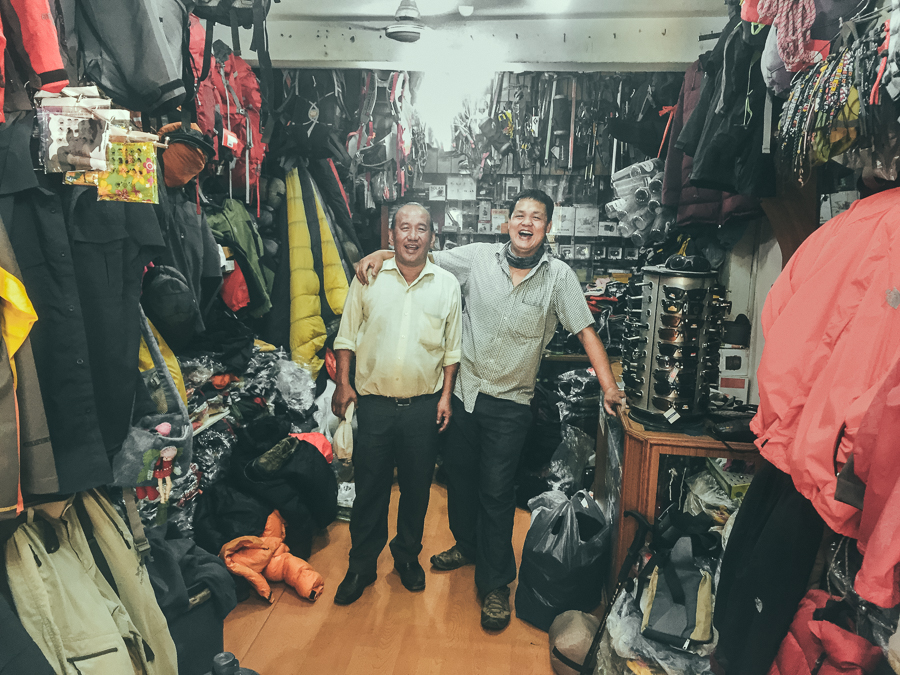
EVEREST BASE CAMP TREK COST
I paid $900 USD for my package all the way back in 2016 but you can expect to pay anywhere from $1400 to $2500 these days.
What’s included in the package for trekking to Everest Base Camp:
- Taxi from Thamel to Kathmandu Airport
- Flights from Kathmandu Airport to Lukla Airport
- Flights from Lukla Airport to Kathmandu Airport (Regular price $320 round trip)
- Breakfast, lunch, and dinner from the guesthouses you are staying at. I could pick anything on the menu, which had western options or Nepali options. You can eat pancakes, pizza, and burgers or you can go for the 24-hr Nepali Power Dal Bhat. I could also choose any hot drink with each meal.
- Your guide throughout the trip.
What’s not included:
- Water. You can buy bottled water like me if you are playing it safe. It is $1 per bottle at a lower elevation and $3 per bottle at the highest elevation. Or lots of people use purification tablets and they seemed to be fine.
- Electricity
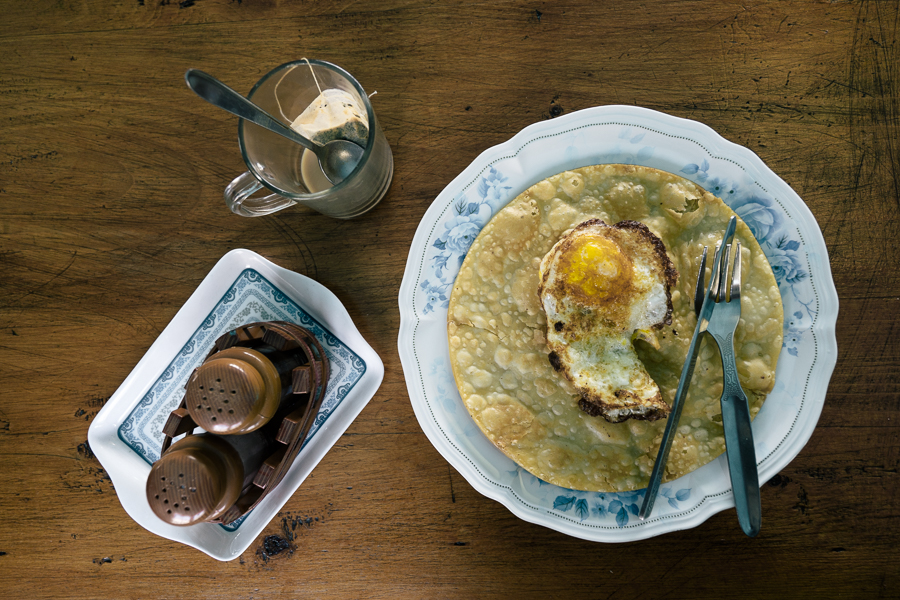
EVEREST BASE CAMP TREK: WIFI/ELECTRICITY AVAILABILITY.
Wifi: Costs anywhere from $3 to $10 to use wifi at the guesthouses. Buy a Ncell Sim before you go. Ncell works at 50% of the guesthouses. Electricity: You will have to pay anywhere from $2 at low elevation to $8 at high elevation to charge your power banks, cameras, and phones. The key is to get a fat power bank. Pay to charge that then charge everything from your power bank. My power bank lets me charge my phone and four camera batteries before it would be done.
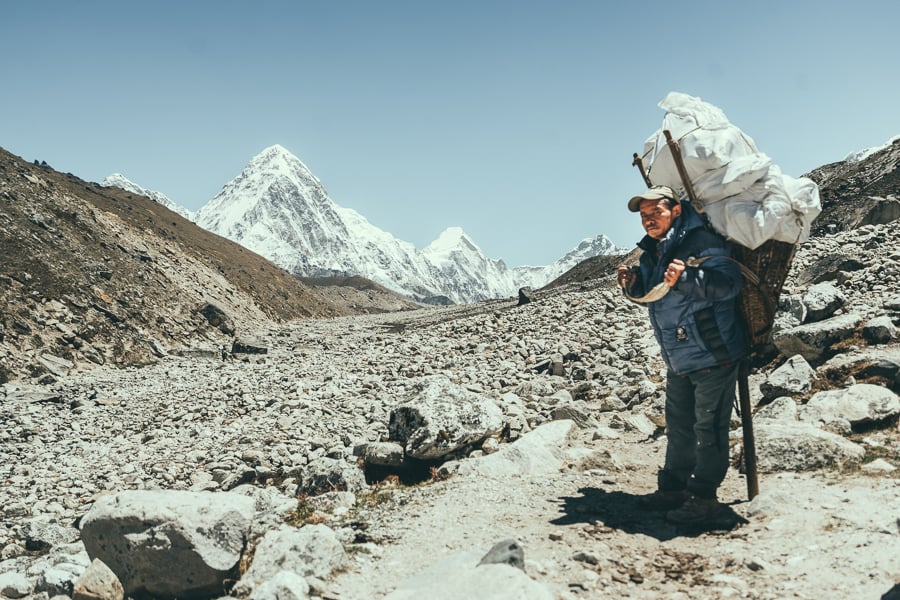
EVEREST BASE CAMP TREK: BEST TIME OF YEAR
This is an interesting question. Do you want snow, reliable weather or to get away from crazy crowds?
February to May – Peak season, clear bright days, very busy trails, lots of people attempting Everest ascent June to August – Monsoon season, no crowds and empty guesthouses September to October – Most stable and clear weather, trails are quite busy November to January – Coldest period, can reach -25, some routes closed
I trekked in the first week of June and was lucky to escape the rain. I didn’t get wet once. Normally it rained in the afternoon or at night if at all but we trekked in the morning and usually only heard the rain as we slept. The trails were open and some days we didn’t even see anyone.
My guide showed me a photo of Namche on a busy morning and I couldn’t believe it. The path looked like the start of a marathon. After seeing that I was so glad to have gone in the off-season.

EVEREST BASE CAMP TREK TEMPERATURE
During June when I trekked it was sunny in the days and I actually wore shorts every day. However as I mentioned above about when the best time to be trekking to Everest Base Camp is, it can get very cold at high elevations during November to January (-20 to-30)
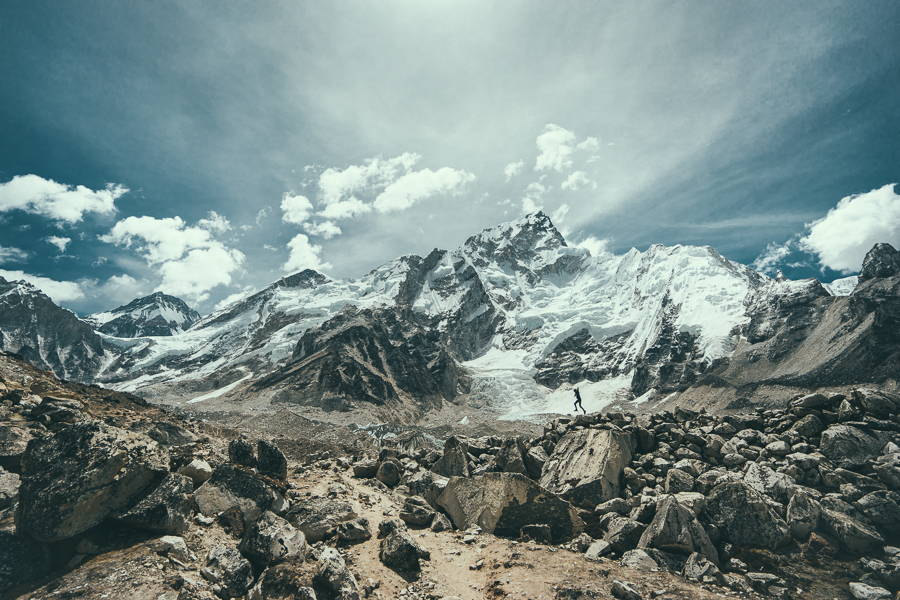
EVEREST BASE CAMP TREK DIFFICULTY
Trekking to Everest Base Camp takes some serious effort. But do you need to be in great shape to complete the journey? The simple answer is NO.
You can go at a slow pace, your own pace, and still make it to Everest Base Camp. In fact, going slow will help you to acclimatize better. I am all about speed but this is not a race. Some days we only trekked for just over three hours but we gained 500m in altitude so we rested for a day and then went again in the morning.
Having said all of that you should be able to walk 10-15 km in a day. Be able to walk up intense inclines for at least an hour. Be able to carry a bag while doing all of this unless you plan to hire a porter.
It’s hard to measure if you are ready. It isn’t like a marathon or anything else you have ever done most probably. I didn’t train at all and was fine. I’m in pretty good shape and played sport my whole life. There were people on the trail who were overweight and going incredibly slow but they were right there with us at base camp to celebrate the achievement.
EVEREST BASE CAMP ALTITUDE
The base camp is 17,600 ft or 5,380m. However, you will probably also trek to Kala Patthar, which looks over the base camp. Kala Patthara is 5,644m high.
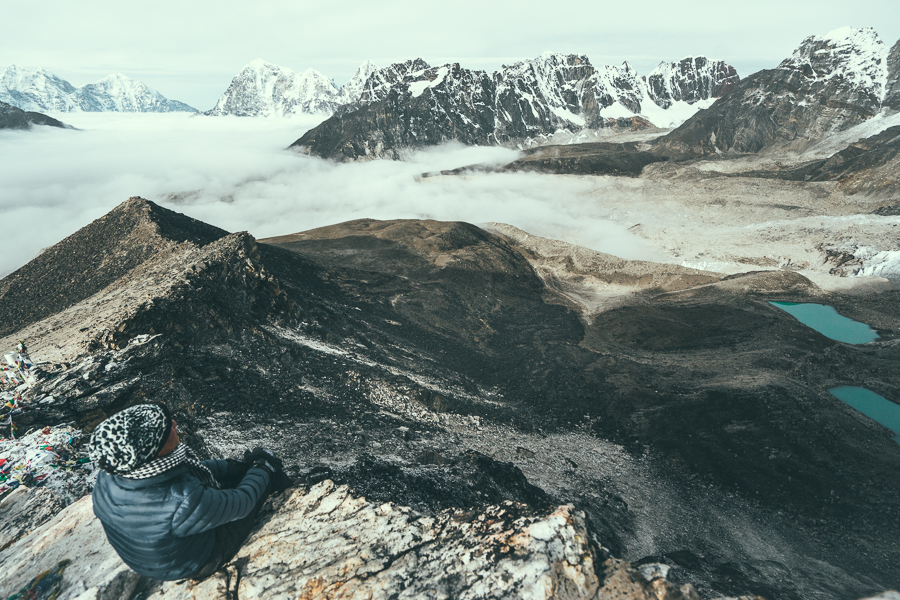

EVEREST BASE CAMP TREK DISTANCE
The distance from Lukla the first town to Everest Base Camp is 38.58 miles or 62 kilometers. Most people take 8-9 days trekking to Everest Base Camp and 3-4 days trekking back to Lukla. It took 8 days to trek to Base camp and two days to trek out.
EVEREST BASE CAMP ITINERARY
Your itinerary will vary depending on your speed and your guide. However, most people follow a somewhat similar trail and timeline. This was my timeline. Note that I spent one extra day in Phak Ding due to sickness. Most people spend that extra day in Namche.
- Day 1. Kathmandu flight to Lukla Lukla to Phak Ding (3-4 hrs)
- Day 2. Phak Ding rest day (sickness)
- Day 3. Phak Ding to Namche (5 hrs)
- Day 4. Namche to Tenboche (4 hrs)
- Day 5. Tenboche to Dinboche (3 hrs)
- Day 6. Dinboche to Chukhung Ri (2.5 hrs) Chukhung Ri back to Dinboche (1.5 hrs) (Acclimatization day)
- Day 7. Dinboche to Lobuche (3 hrs)
- Day 8. Lobuche to Gorak Shep (2 hrs) Gorak Shep to Everest Base Camp (1.5 hrs) Everest Base Camp to Gorak Shep (1.5 hrs)
- Day 9. Gorak Shep to Kala Patthara (2 hrs) Kala Patthara to Gorak Shep (1 hr) Gorak Shep to Tenboche (7hrs)
- Day 10. Tenboche to Lukla (8 hrs)
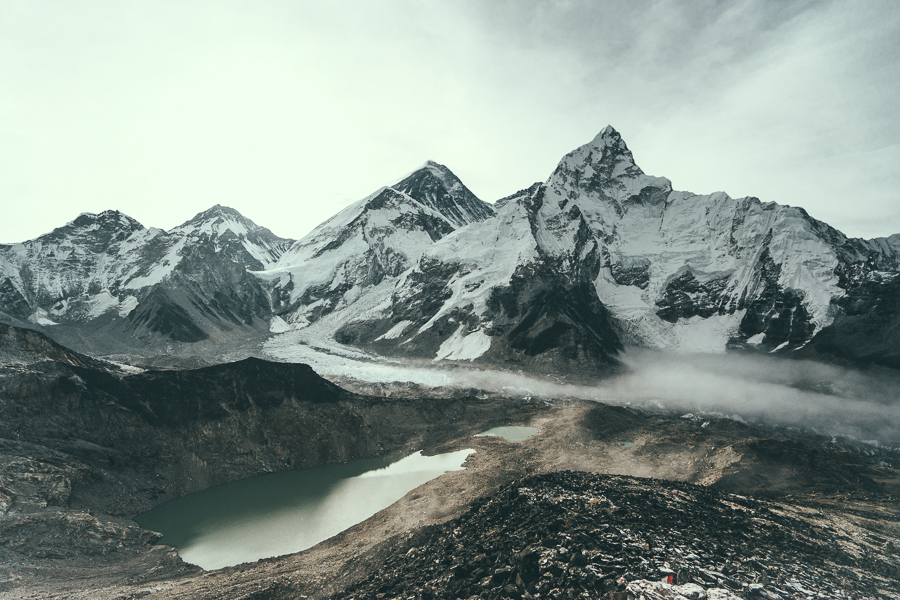
I hope you enjoyed my guide to the Everest Base Camp Trek and you have a great adventure.
HAVE YOU READ MY OTHER NEPAL BLOGS?
I’ve been lucky enough to have many awesome adventures in Nepal, which you can check out below where I’ve listed some of my favorite blog poss from Nepal.
- The Most Iconic route: Everest Base Camp Trek
- The Most Scenic Route: Annapurna Circuit Trek
- My Favorite Trek in Nepal: Manaslu Circuit Trek
- An Easy Nepal Trek: Langtang Valley Trek
- A great beginner peak: Island Peak Climb (6,165m)
- My Favorite Climb in Nepal: Climbing Ama Dablam (6,812m)
- My first 8000er: Climbing Manaslu (8,163m)
- My toughest climb in Nepal: Climbing Makalu (8,463m)
- Where to stay: 16 Best Places to Stay in Kathmandu

Tuesday 31st of October 2023
Sunday 17th of September 2023
So much informative articles which helps people to trek Everest Base Camp Trek
Inge Winkler
Saturday 3rd of June 2023
Hello, thank you for posting all the great infos, this will be very helpful for us. Could you please update me if the requirement of a Professional Guide is in place now or is there a way around it. Thank you so much in advance. Happy Trails, Inge
Sunday 18th of June 2023
I believe you need a guide now to trek anything above 3000m
Monday 21st of November 2022
Thanks for sharing such an adventurous trip experience with us. I read your blog. It feels like I was personally enjoying this trip.
Friday 12th of August 2022
Hi Jackson,
This was a helpful and informative guide. Kudos!
I had a small suggestion: You could have a small sections box right in the beginning and link each sub-section directly to the relevant content below, for ease of navigation!
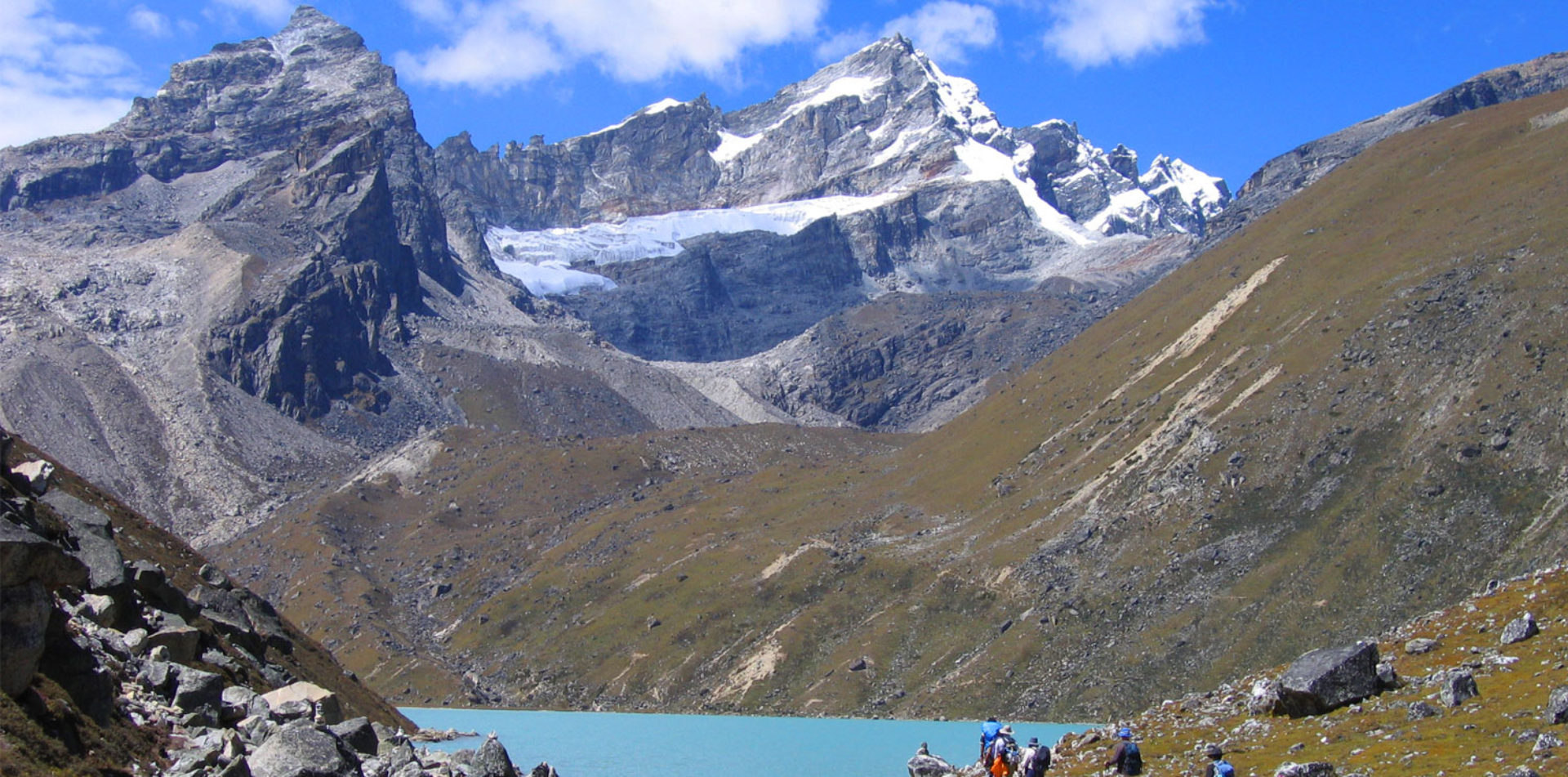
Everest Base Camp Trek – A complete Guide
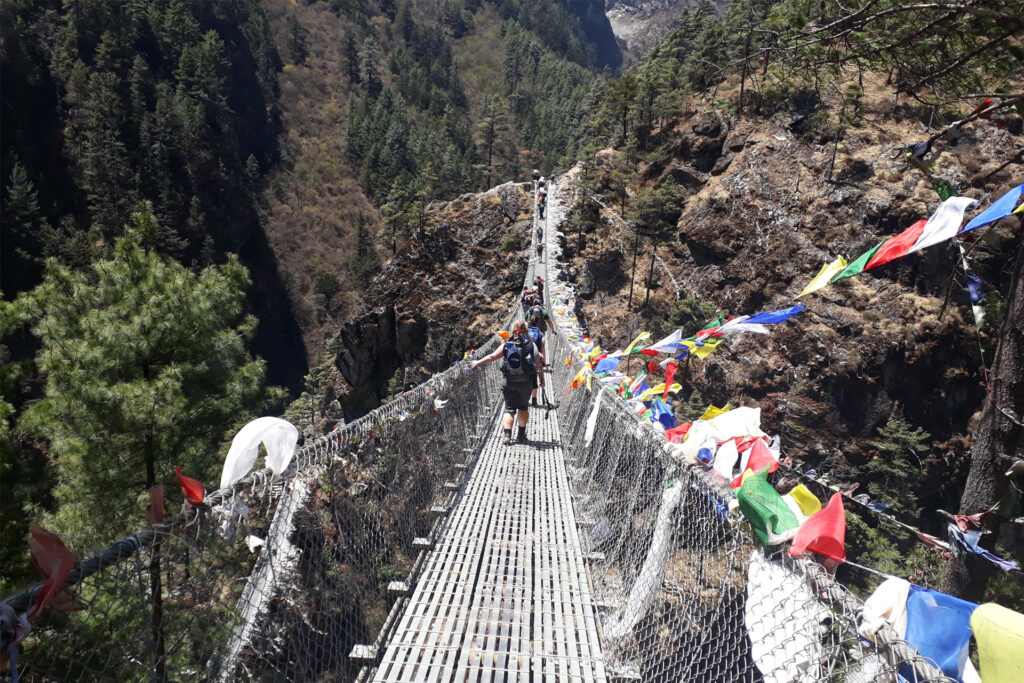
For Everest Base Camp Trek, take a short spooky flight above the mountain hill to Lukla, and follow the footsteps of legendary trekkers and climbers to achieve this uniquely distinctive and iconic adventure journey.
Everest Base Camp Trek Facts
- Required Trip Duration : 12 days
- Trek Difficulty: Moderate
- Highest Altitude : 5545m (Kalapathar viewpoint)
- Distance : 120 km/75 miles
- Accommodation: Teahouse
- Guide and Porter: Both are not mandatory. You can go independently or can hire a guide and porter to support you and make your trip easy and joyful
- Required permits: Local government tax and Sagarmatha National Park Permit
- Best Time to Trek to EBC : March to May(Spring) and September to November(Autumn)
- Start and End Point: Kathmandu to Kathmandu
Highlights of EBC Trek
- Explore lifestyles and culture of Local sherpa communities
- Astounding mountain views of Towering peaks including the highest Mt Everest (8848m), Lhotse (8,516m), Makalu (8,463m), and Cho Oyo (8,201m)
- Explore Sagarmatha National Park, Mani wall, Gompas, Prayers flags, Prayers wheels, and high suspension bridges
- Visit Ancient Tengboche Monastery – the biggest monastery in the region
- Highest glacier on Earth – Khumbu Glacier
- Diversity of flora and fauna along with wildlife – Colorful Pheasants, Musk Deer, Himalayan Thar, and Snow Leopard
Everest Base Camp Trek Overview
Everest Base Camp Trek has been a goal of thousands of novice, independent and anxious trekkers all around the world. Here you can get the genuine and honest facts of this trek before you come to achieve it. So, feel easy to ask if you have any queries regarding this trek.
In this article, you’ll get general ideas of the overview of Everest Base Camp Trek along with itinerary, health requirements, packing list, permits, and frequently asked questions. Indeed, this article is especially for backpackers who want to trek to Everest Base Camp on their own path.
Basically, Mt Everest has two base camps – one is on the Nepal side and another is on Tibet, China side. But Everest Base Camp Trek is a wonderful trip that begins from Lukla to approach Mt. Everest closer to reaching Everest Base Camp (5364 m) and Kala Pathar (5545 m). It literally means the trek lies in Nepal and reaches to South Base Camp of Mt Everest. This iconic journey leads you through a few Sherpa villages in Khumbu, offering the beauty of the Sagarmatha National Park. Meanwhile, you will be delighted with a mesmerizing view of the dignified mountains above 8000 m. Mt Lhotse, Mt Nuptse, Mt Cho Oyu, Mt Makalu, and Mt Ama Dablam are the major peaks that you can observe on this trek. You can also observe the customs and traditions of Local Sherpa people along with their lifestyle.
The trek covers a distance of 130 Kilometers beginning and ending in Lukla. To find out more, you can visit our article Everest Base Camp Trek Distance .
To reach Kalapathar is this trek’s ultimate destination, which is elevated 5545 m above sea level. Therefore, Everest Base Camp Trek is also known as Everest Kalapathar Trek .
The trip begins from Kathmandu, however, the trek starts from Lukla. Alternatively, one can choose Jiri to EBC route to avoid the Lukla flight. But it requires 4-5 more days than Lukla to EBC route.
If you don’t wish to do such a long exhausting journey but want to see Mt Everest from closer, then Everest Base Camp Helicopter Tour can be another best alternative way to see Mt Everest for you.
Check out 5 different trekking itineraries for Everest Base Camp
Everest Base Camp Trek Route Map
Below, you can view an overall map of Everest Base Camp Trek.
There are several maps you can get on premium online. Instead, you can buy it after you arrive in Kathmandu.
Click here to see the pictorial map
Detailed itinerary of EBC Trek
Day 01 arrival in kathmandu (1350m/4429feet).
If you have booked your trip with us or any tour operator either local or international, there will be one of their members to pick you up as per your and the tour operator’s understanding. If not, then you can find a Taxi there. But you have to do an agreement on the price before getting into the Taxi. Meter is rarely used by them.
We can suggest you book a hotel around Thamel as there are many hotels that range from Budget to Standard level. If you arrive in Kathmandu earlier, then you can even visit around Thamel .
Elevation Gain: 1310 m
Day 02 Fly to Lukla (2880m/9448feet), then trek to Phakding (2610m/8563feet)
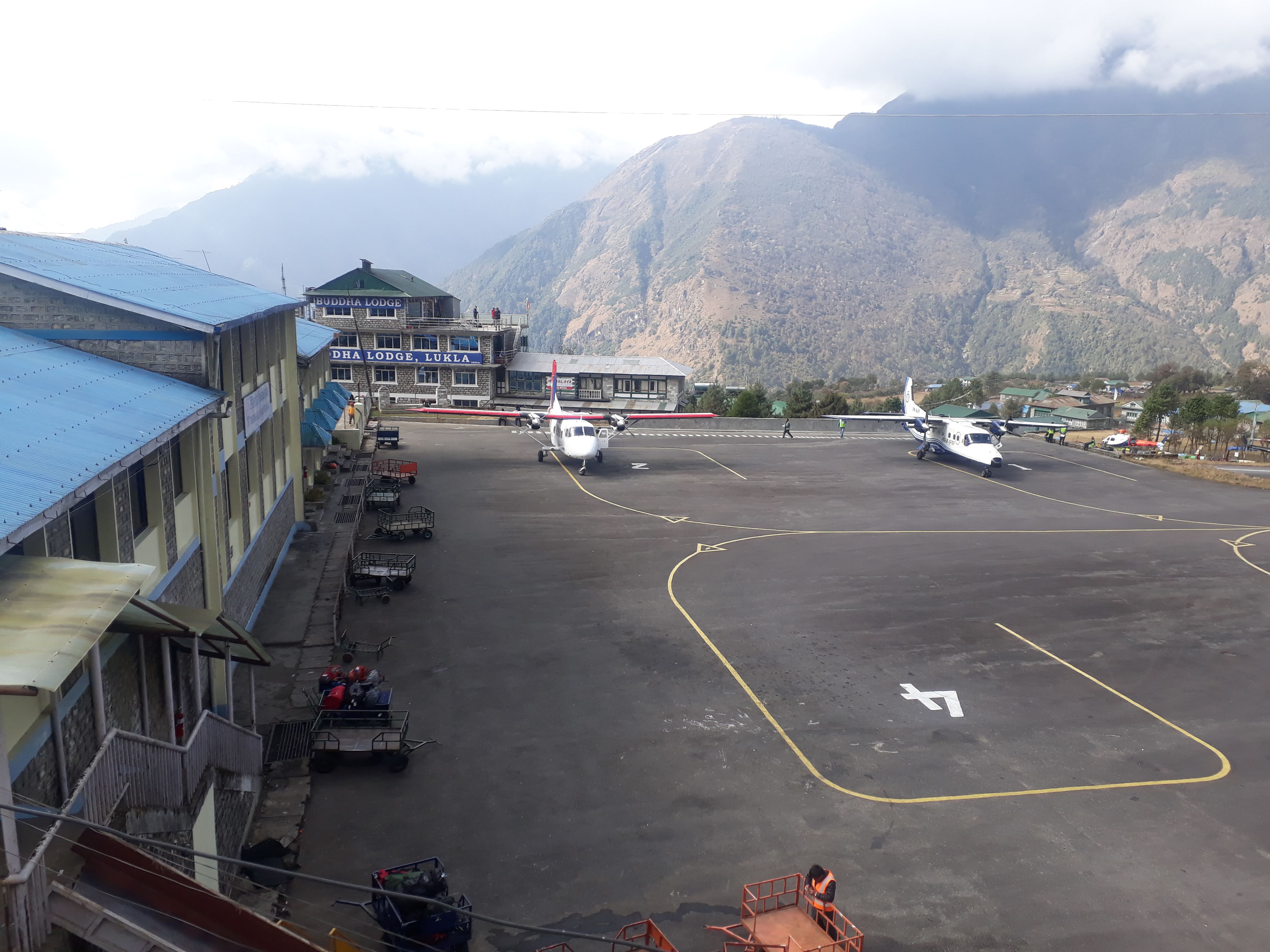
Flying in a short scary domestic flight to Lukla and following the bank of Dhudhkoshi River crossing a few quizzical suspension bridges, you arrive at a small Sherpa Village called Phakding by 2-3 hours walk. Here it will be your first mountain overnight.
Either your tour operator will arrange the flight ticket for you or you should purchase the tickets at the airport. However, the ticket can be unavailable during peak trekking and climbing seasons. So, it would be better to buy tickets earlier either through a travel agency or directly from the airline’s website. Basically, the Lukla flight ticket costs around 280 USD which includes a return ticket as well.
There are chances of cancellation of Lukla’s flight due to bad weather. So, we recommend you make a flexible itinerary as much as it is possible. Having one or two spare days would be better.
Elevation Gain: 2880 m Lukla, and 2610 m Phakding
Day 03 Trek to Namche Bazaar (3440m/11286feet)
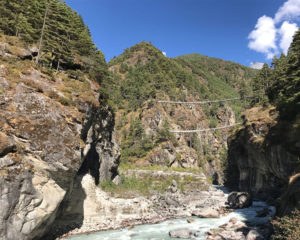
Today, you will be trekking through some local villages like Monjo, Jorsalle, etc till reaching Namche Bazaar – The biggest Sherpa town in the region. You can cut your lunchtime in Monjo as many trekkers do. From here, you will be entering Sagarmatha National Park which is home to many endangered wild animals. It has been also enlisted in UNESCO WORLD Heritage Site.
You will take a steep hike to Namche Bazaar after passing Jorsalle. It will take you 2 hours approx to reach Namche Bazaar. You will have enough time to visit Namche Bazaar and see the small markets.
From Namche Bazaar, the Everest Three High Passes Trekking route separates and moves toward Thame village which follows the path to Renjo La Pass, while the EBC route goes to Tengboche.
Elevation Gain: 3440 m
Day 04 Acclimatization day in Namche Bazaar
Reaching 3440 m altitude above sea level, anyone could suffer from altitude sickness problems. So, Namche is a great stop for acclimatization for Everest Trekkers. It will offer an opportunity to explore the village from near.
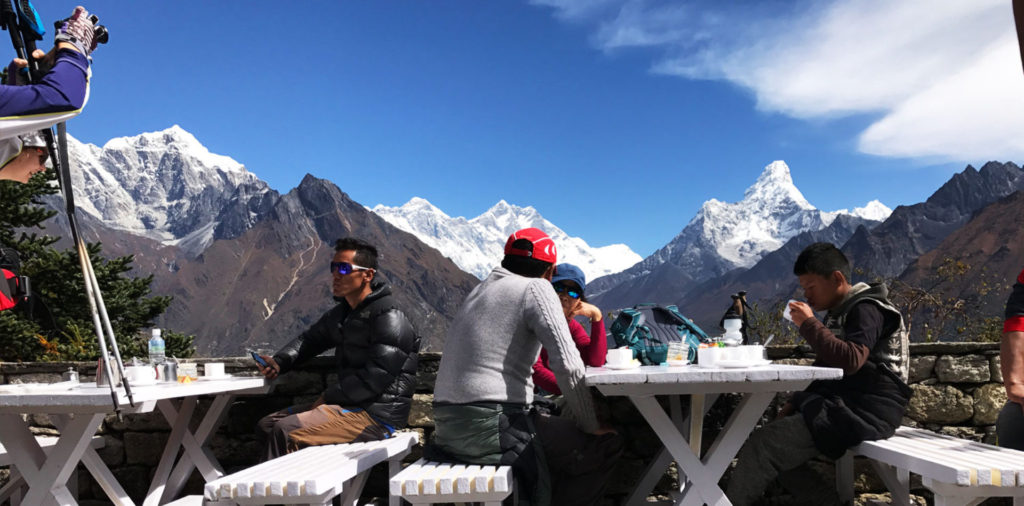
In addition, many love to hike to Everest View Hotel to see a glimpse of Mt Everest and the surrounding mountains. You can chill here by having a cup of tea or coffee ; you also can snap awe-inspiring pictures of Mt Ama Dablam in the foreground while Mt Everest will be in the background if the sky is crystal clear. Besides that, the hotel provides WiFi that enables you to contact your relatives and share how you are feeling.
Day 05 Trek to Tengboche (2860m/12664feet)
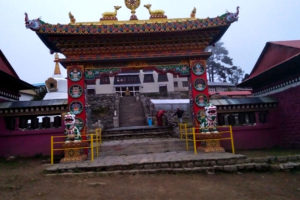
Today, you will be heading toward Tengboche, the home of one of the largest monasteries in Khumbu i.e Thyangboche Monastery. It is a mixture of great architecture and color that has a history of over 500 years.
Elevation Gain: 3860 m
Day 06 Trek to Dingboche (4410m/14468feet)
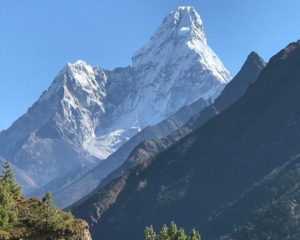
On the 6th day, either you will head to Dingboche or Pheriche. The way follows the same path until it reaches Worshyo Village. It then separates – one way goes to Pheriche and another to Dingboche. I always advise choosing Dingboche when you are going toward EBC. If you are coming down, then staying in Pheruche would be good. From Dingboche, Ama Dablam mountain is very closer. A way goes toward Chhukung from Dingboche that traces a path to Island Peak Climbing . However, the next day, we will not take our path to Chhukung because the EBC trek moves toward Lobuche.
In fact, the EBC route from Dingboche or Pheriche, both meet at the same point i.e Dughla, then approach the Lobuche where you will spend your 7th overnight stay at the mountain.
Elevation Gain: 4410 m
Day 07 Trek to Lobuche (4940m/16207feet)
As I already mentioned that your path from Pheriche or Dingboche meets at Dughla village, and head toward Lobuche having extraordinary scenery of mountains. Within 5-6 hours, you will be at Lobuche village.
Elevation Gain: 4940 m
Day 08 Trek to Everest Base Camp (5364m/17598feet)
From Lobuche, you walk through a rough rocky terrain path passing Gorakshep. You will spend 40 minutes approx in EBC enjoying and collecting the view of Nuptse, Lhotse, Pumori, etc mountains. Thereafter you come back to Gorakshep for an overnight stay.
Elevation Gain: 5364 m
Day 09 Kalapathar Hike (5545m/18192feet) and trek back to Pheruche
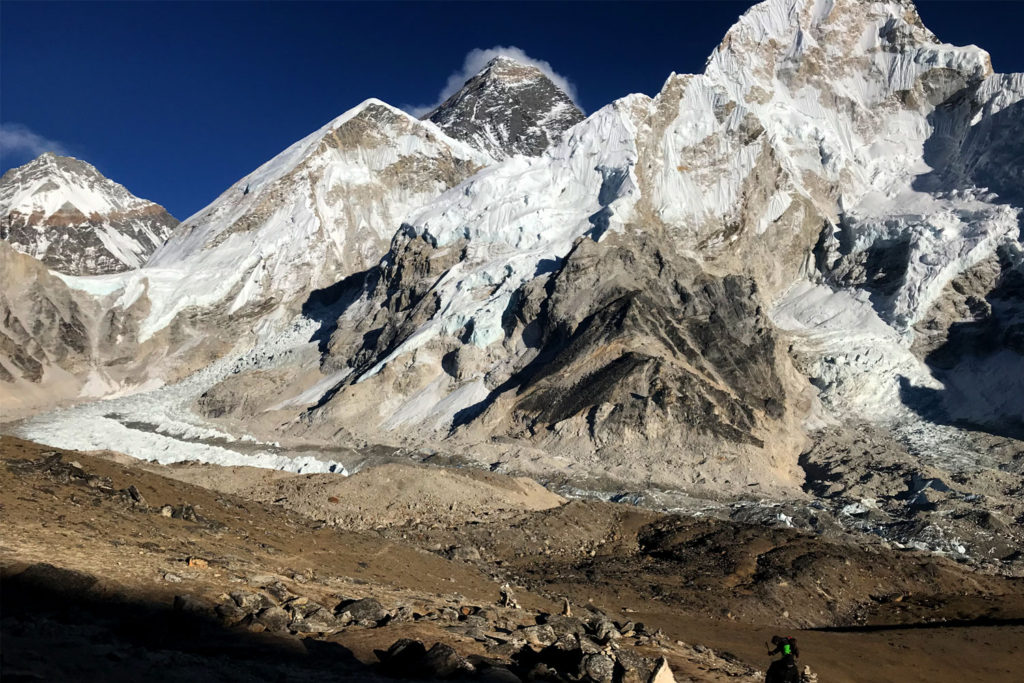
Approximately 2 hours hike to Kalapathar will wonder you today when you reach there. Kalapathar is the optimal viewpoint of Mt Everest and its neighboring mountains. After spending 30 minutes, you then will come down to Gorakshep and may have lunch before moving down to Pheriche.
Elevation Gain: 5545 m
Day 10 Trek back to Namche Bazaar
When you will be coming down to Namche via Tengboche, keep your camera ready to capture beautiful photos of rhododendron forests.
Day 11 Trek back to Lukla
You will walk approximately 6 hours today to come back to Lukla. Then you may celebrate the night with your team as you succeed in the EBC trek.
Day 12 Fly back to Kathmandu
Take a short flight from Lukla to Kathmandu in the morning and the rest of the day will be on your hand. You can spend how you want to. You may visit around Thamel or may go for 1-day heritage sightseeing in Kathmandu valley.
Everest Base Camp Transport
Generally, you will take either taxi or a private vehicle to go to Tribhuvan International Airport as it is the only airport that conducts a Lukla flight. However, the roads of Kathmandu are very congested, so as you can say it is badly regulated and has the poor condition of transportation. In case you choose to trek Everest Base Camp via Jiri Route, then you need a standard vehicle and driver for all your transfers. In the monsoon season, the hilly roads of Nepal are prone to landslides and accidents.
Foods and Accommodation for EBC Trek
Unlike the luxury hotel in a city like Kathmandu, you will not get a wide variety of meal menus during the Everest Base Camp Trek.
You get to have a few options of food while Dal Bhat Tarakari will be the favorite of many people as it is also a common and national meal in Nepal. Dal Bhat is provided by a teahouse that also serves as accommodation for trekkers. Basically, they provide a twin-shared room with separate beds. Likewise, some lodge base teahouses do also provide hot showers, and can also serve laundry service charging a small fee.
What type of hotel can we find in Kathmandu city?
There is a wide variety of hotels ranging from 2 star – to 5-star in Kathmandu valley. Even you can get a very normal hotel around Thamel – a tourist center of Kathmandu.
Is it possible to book a tea house room by yourself?
It is a little bit hard to book a teahouse room in advance by an independent trekker. There are a few reasons behind these conditions:
- Trekkers might not have enough contact information about the teahouses
- If trekkers try booking the room by contacting teahouses, there is no guarantee of room booking. Because it is a remote area where almost all of the teahouses do not have an online booking system. So, they can’t be sure whether it is an original or fake booking.
On the contrary, trekking companies and guides do have more and better relationships with teahouses. Hence, they can arrange teahouses in a better way.
Note: You can’t expect high facilities in the tea house.
EBC Trek difficulty and health requirements
It is considered to be a moderate trek although it accesses Kalapathar which is 5545 m above sea level. Nevertheless, you should not take it so easily as many people have got altitude sickness while trekking in Everest.
To overcome the chances of altitude sickness , you need to do some physical activities at least 10-15 days prior to the trek. It would have been far better if you have already hiked some mountains. It may be applicable for those people who have been living just close to the height of sea level.
Basically, you need to be physically and mentally fit to trekking to Everest Base Camp. It does not require any mountaineering skills as it only passes through terrain land and hikes to the steep hill.
Kathmandu to Lukla Flight Cancellation
Since the classic Everest Trail begins from Lukla, we need to take a short flight to Lukla from Kathmandu. It only takes 40 minutes approx to arrive at Lukla from Kathmandu. Nevertheless, no one can be 100% sure about the weather in the Himalayas. It might be changed anytime. Consequently, the Lukla flight may be canceled or can not be landed on Lukla.
Therefore, I would like to suggest everyone add 1 or 2 spare days in order to ensure your trekking on Everest. Alternatively, there is the possibility of helicopter service in a group joining spending some money. The helicopter service charges may range from $300 to $500 for each of the members. In a helicopter, there will be a maximum of 5 members at a time.
Everest Base Camp Trek Permits
The basic required permits for Everest Base Camp Trek are listed below:
Khumbu Pasang Lhamu Rural Municipality Entrance Fee
Sagarmatha National Park Entry Fee
- TIMS (Trekking Information Management System) fee
The first two permits are now the must-require permits. However, about the third permit – TIMS, there are a lot of controversies still going on. But you are allowed to trek just having Khumbu Pasang Lhamu Rural Municipality Entrance and Sagarmatha National Park Entry permits.
You can’t get this permit in Kathmandu. It is like a replacement of a TIMS permit which is directly collected by Khumbu Pasang Lhamu Rural Municipality. It can be obtained either in Lukla or in Monjo Village.
Cost: Rs 2000 per person
It is another must-required permit that can be obtained in Kathmandu at Nepal Tourism Board or in Monjo village just prior to entering the National Park.
Cost: Rs 3000 per person
Note: If you are planning to trek from Jiri to Everest, then you need an additional permit i.e Gaurishankar Conservation Area Permit. Because you will be passing through Gaurishankar Conservation Area which also costs Rs. 3000 and it also can be obtained in Kathmandu.
What documents are required to issue Everest Base Camp Trek permits?
It is enough to have valid passport details to issue the permits to trek to Everest. But all permits are only for a single entry and once the permits are issued, they can not be refunded.
FAQs of Everest Base Camp Trek
How safe is it to trek to Everest Base Camp?
Safety concern on EBC Trek depends upon a variety of aspects. But In comparison to Everest Climbing, Everest Base Camp Trek is very safe. However, it still poses some risks due to the high altitude as written above.
Apart from the geographical scenarios, the political situation also matters in your safety zone while you are traveling to a particular place.
Before 2008, there used to be a Maoist problem – a form of a political party. But now they are also a part of the Nepali Government. After the comprehensive peace agreement, they are now in parliament. So that this problem no longer exists.
What to pack for trekking in Everest Base Camp?
Normally, you need to bring basic hiking gear, such as walking poles, hiking boots (preferably shoes), lightweight t-shirts, hiking pants, a down jacket, sleeping bags, and so on. For detail about the gears, just click here .
What is the Best time to trek to Everest Base Camp?
Basically, trekking in EBC is open all the time year. However, March to May and September to November are the best time to trek in Everest Base Camp because, in these months, the weather and climate in EBC become as good as a trip requires.
Why hire a local guide for Everest Base Camp Trek?
An interpretive local guide will enhance your valuable time in the mountain. They are very knowledgeable about mountain conditions, weather, avalanches, and other potential hazards. In order to keep you safe on the mountain, they will be passionate about sharing their knowledge of your surroundings.
Is Travel Insurance necessary for Everest Base Camp Trek?
To protect your travel investment, you must have travel insurance for Everest Base Camp Trek ; it should cover helicopter evacuation and medical repatriation. Although it is a moderate trek, it goes up to 5545 m above sea level. In such conditions, some trekkers can suffer from high altitude sickness which can be life-threatening too. Sometimes, trekkers need helicopter rescue. So, if you have travel insurance, it will save you money.
Will there be access to any communication medium in Everest Base Camp?
Definitely, you can take Nepali SIM cards – NCELL or NTC. It often works in most areas. You can enable Internet Data Service on your sim card which makes you unable to communicate with your international friends. In remote areas, the data service of NCELL is better than NTC. Otherwise, Paid WIFI service is available in some of the teahouses. They take nearly $1 USD to use the internet service.
“But keep in mind not to forget to bring a power bank for your mobile phone” Although teahouses do have the facility of electronic device charging, they may charge a few amounts for it.
Is a private trip possible for Everest Base Camp Trek?
Yes, you can book your private trip. But it may cost a little bit higher than the group trek. Almost all of the trekking agencies do organize private trips to Everest Base Camp.
Is it necessary to hire a guide and porter to trek to Everest Base Camp?
No, it is not compulsory to hire a guide and porter for Everest Base Camp Trek. However, a guide and porter can be good company for the whole trip as they will take care of you; help you to get safe, and get better teahouses and food. They can give detailed information and safety precaution about the trail and region. Even some of the guides and porters entertain tourists by singing and dancing.
A Porter will carry your luggage weight of up to 15 – 20 kg. It is not a joke to carry that much weight in such a king of rough trails and altitude.
Note: In Nepal, a guide is a must only for those trails which lie in certain areas called restricted zones by the government of Nepal. Such as Manaslu Circuit Trek , Upper Mustang Trek, etc.
Do I need a porter for the trek to Everest?
I never say that a porter is a must needed for the EBC trek. However, having a porter may let you enjoy the trip twice better than a porter-less trip. A porter will carry your luggage and let you enjoy your journey pleasantly.
Small earnings from you become helpful for them and it improves the income of local communities of the mountain area.
How much does it cost to hire a guide and porter?
The basic salary of a guide ranges from USD $15 – $25 per day. Likewise, it costs $12 – $15 per day to hire a porter. If you buy a complete package trip from a trekking agency, then they will provide a guide and porter accordingly.
Is natural water drinkable on Everest Trail?
We don’t suggest you drink tap water or any water from natural streams. However, you can use a water purifier if you really want to drink that. Instead, mineral water can be found in teahouses on the trail but that is nearly 10 times more expensive to buy than in Kathmandu.
What is the right cost to trek Everest Base Camp?
The cost of an EBC trek varies on the trip type, trekking trails, and the trekker’s own behavior. But the best reasonable cost of Everest Base Camp Trek is about $1400 – $1600. This cost can cover all your food, accommodation, guide and porter, permits, and domestic flights to Lukla. Follow this link for a detailed cost estimation of the Everest Base Camp Trek .
How much does it cost to trek to Everest Base Camp for Indians?
For Indians, it is not the budget of Everest Base Camp Trek that far different than any other nation. However, Indian nationals will get Kathmandu to Lukla flights at a cheaper price than any other nationals. And Sagarmatha National Park Entry fees are only Rs 1500 for an Indian citizen, whereas it costs Rs 3390 for each person.
Can I sleep at Everest Base Camp?
No, you can’t sleep in Everest Base Camp. There is no tea house in Everest Base Camp. On the other hand, trekkers are not allowed to stay at base camp. Only climbers who are summiting Everest can stay at Everest Base Camp.
Do I need to take Oxygen on this trek?
Generally, it is not necessary to take oxygen for this trek. You just need to walk at your own pace and should not get horrid while trekking to Everest Base Camp. However, a well-managed trekking company always brings oxygen as a medical backup to ensure first-aid support for their clients.
What is the temperature at Everest Base Camp?
The weather and temperature of Everest Base Camp are extreme. It ranges from 20 degrees Celsius in summer to -5 degrees Celsius in winter in the daytime throughout the year. But at night, it can reach up to -20 degrees in winter and 4 degrees in summer.
Once you reach Lukla, you will feel a decrease in temperature in the air as you are already at the height of 2800 m above sea level. Again when you go up and up, then the temperature further drops.
Is there any age limit to trek to Everest Base Camp?
Not exactly, the government of Nepal has not defined any age limit for Everest Base Camp Trek. All can plan to trek to Everest Base Camp. However, considering the high altitude and difficulty level of the trek, it is most probably best doable for those who are 14 to 65 years old.
Is there road access to South Everest Base Camp?
There are only trekking trails that take you to the Everest Base Camp. The road access has not reached to Khumbu region yet instead it only reaches the Solu region.
Can Everest Base Camp Trek be an educational trip?
Yes, it can be an educational trip because Everest Base Camp Trek is not only an adventure journey, but it also covers cultural and traditional aspects of the Khumbu region, Nepal. The region is the home of Sherpa communities. Throughout this journey, travelers can explore a few Sherpa inhabitants and the museum of Khumbu Region – Sagarmatha National Park Museum. Moreover, you can study the lifestyle of mountain people before and now.
How to book Everest Base Camp Trek?
To book Everest Base Camp Trek, you can contact us . We provide budget and luxurious both sort of Everest Base Camp Trek. We assure you that you will definitely love our service.
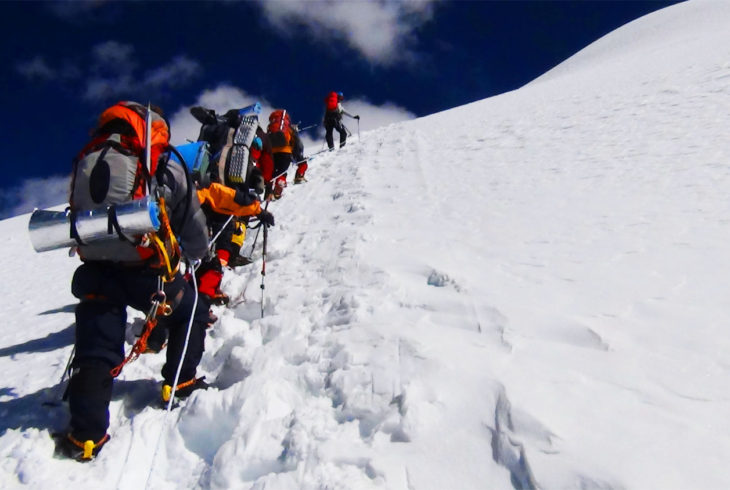
Podcast of EBC Trek
Latest features.
The latest articles, galleries, quizzes and videos.
Island Peak Climbing – A Complete Guide
Island Peak Climbing is an expedition of glacier travel, snow and ice climbing and trekking in the Khumbu region which goes through some tiny ethnic Sherpa villages with Sagarmatha National Park. Highlights of Island Peak Climbing Climbing Island Peak also known as Imja Tse offers a great opportunity to experience the worlds’ impressive mountain range…
Everest Base Camp Trek in April
In April, the Everest Base Camp Trek continues to offer a spectacular experience, building on the favorable conditions of March. Here’s what you can expect: Weather April falls within the Spring season in Nepal, offering pleasant and stable weather conditions. Temperatures are mild, ranging from around 9 to -4 degrees Celsius. While the lower altitudes…
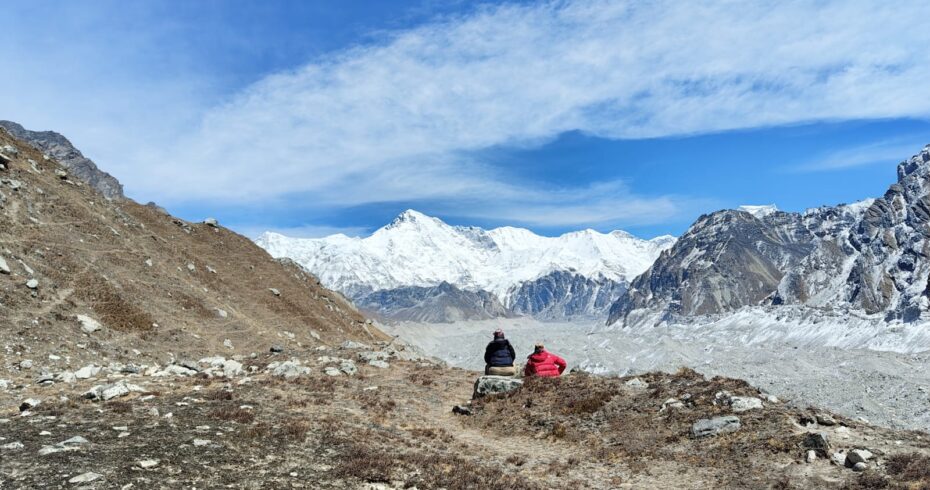
Everest Base Camp Trek in January
Everest Base Camp Trek in January can be a memorable trip for those who prepare better for winter and cold since it is a peaceful time, the trails get empty, and the sky looks clear. Everest Base Camp Weather in January Generally, the weather in Everest in January gets colder as the temperature can go…
Everest Base Camp Trek in February
February is considered to be Off-season for trekking in Nepal due to cold temperatures and foggy weather in the whole country. If you are thinking of Everest Base Camp Trek in February but have some dilemma on your mind, this is the right place where you will get all your answers. Why trek Everest Base…
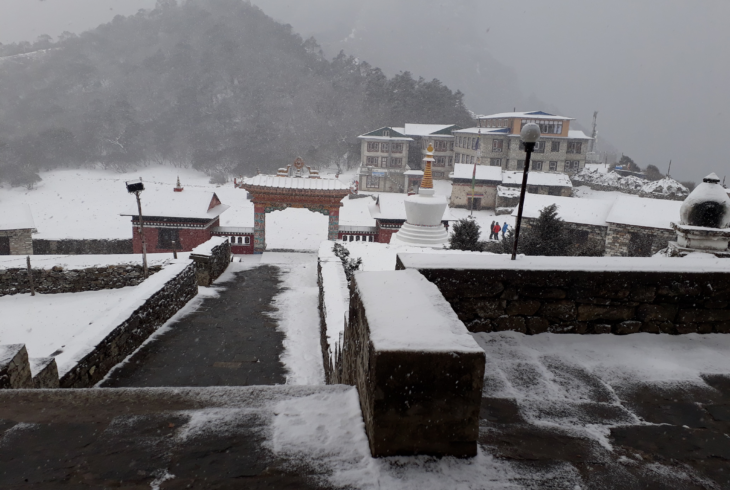
Sign up for trip deals, inspirations and competitions.
Best Time to Visit
Weather & Climate
Kathmandu Airport Guide
Top Destinations in Nepal
One Week in Nepal
Tipping Guide
Getting Around
Top Things to Do in Nepal
Complete Guide to Kathmandu
Top Things to Do in Kathmandu
Top Things to Do in Pokhara
Sacred Sites
Amazing Festivals
Top National Parks
Must-Try Food
Annapurna Circuit
Manaslu Circuit
Himalaya Trail
Facts About Mt. Everest
Trek to Everest Base Camp
Everything You Need to Know About Trekking to Everest Base Camp
:max_bytes(150000):strip_icc():format(webp)/greg-rodgers-adventure-ed92646b25f247049e53af6d36f6c15f.jpg)
Jason Maehl / Getty Images
Everest Camp II
Trekking to Everest Base Camp in Nepal's Sagarmatha National Park is the adventure of a lifetime. Although actually climbing Mount Everest is out of reach for many of us, anyone with enough grit and good enough fitness can reach EBC and the Khumbu Icefall, the starting point for climbing Mount Everest. (You’ll need an $11,000 permit and some serious equipment to go any higher from there!)
The Himalayan scenery here is unrivaled on earth. Snowy sentinels will witness your struggle toward the top of the world , while stupas, prayer flags, and Sanskrit tablets will remind you of the spiritual significance of the area. Sadly, the numerous memorials to hikers who perished along the trail underscore the seriousness of your undertaking.
You’ll battle freezing cold, thin air, weather changes, and your own body as you ascend. Once at Everest Base Camp, you won’t even get to see the famous mountain itself unless you take a day to climb Kala Patthar (18,519 feet), an adjacent prominence that affords views of the “Holy Mother” when weather permits.
Read on for our complete guide to the Everest Base Camp trek, with information on what to pack, when to go, EBC tours, and more. Note that we’ll only cover getting to South Base Camp in Nepal, not North Base Camp in Tibet .
What to Expect
Trekking to Everest Base Camp involves hiking between lodges (or “teahouses”) found in villages along the trail. Some days may only consist of four hours or so of uphill trekking, depending on how much elevation is gained that day. Sometimes, you’ll have the option of pushing on to another village higher up—but no matter what, you will never gain more than 1,312 feet (500 meters) in a day.
Once above the tree line, the common rooms in your lodges will invariably be heated by yak dung-burning stoves. Weary hikers will hang around these stoves, warming themselves and socializing before retiring early to their unheated rooms. The shared toilets are sometimes located in snowy outhouses.
The village of Namche Bazaar (11,290 feet) is considered the last fully “civilized” stop on the trek to Everest Base Camp. Here, trekkers can enjoy treats from a German bakery while watching screened documentaries. You’ll find last-minute gear and souvenirs for sale along with the last ATM on the trail. You can even indulge at the “highest Irish pub in the world” on your way down after a successful trek!
When's the Best Time to Trek to Everest Base Camp?
The best time for trekking to Everest Base Camp is in either spring (March to May) or fall (September to November). If you want to see the camp in full form with climbers, support teams, and film crews, you’ll need to time your trip with spring climbing season, usually late April or early May. This is also the busiest time to be in Nepal .
For less traffic on the trails, consider making your trek to Everest Base Camp in September or October. Unfortunately, this means hiking in cooler weather with even less daylight than usual.
Avoid making the trek during monsoon season in summer. Humidity reduces beautiful views at lower elevations, and snowfall closes trails at higher elevation.
Adisorn Fineday Chutikunakorn / Getty Images
Should I Book a Tour or Go Independently?
There are three options for completing a trek to Everest Base Camp:
- Book a group tour and have all arrangements made for you.
- Make the trek to Everest Base Camp independently .
- Arrive in Nepal, then hire a guide and/or porter yourself.
No matter which option you choose, try to spend an additional day at Namche Bazaar. The extra time at 11,290 feet reduces some of the effects of elevation later; you’ll enjoy a better overall trekking experience and suffer less. The extra day isn’t “wasted”—many day hikes around Namche Bazaar provide beautiful views while giving your body time to adjust. Your chances of successfully reaching Base Camp vastly improve if you spend more time at Namche Bazaar.
Everest Base Camp Tours
Although the most expensive option by far, having everything organized before you arrive provides peace of mind. You’ll be taken care of all along the way, with access to better safety measures such as supplemental oxygen. Bigger companies use yaks to take your gear ahead; you’ll find it waiting for you in your teahouse room at the end of each hiking day.
You can book an Everest Base Camp tour online from home, or if time permits, do so after arriving in Kathmandu . Booking on the ground through a Nepalese agency saves money and better helps the local economy. You’ll find trekking agencies on every corner in Thamel, but unfortunately, not all are reliable. Choose a reputable agency that’s a member of the Trekking Agencies’ Association of Nepal . You can see in the member directory how long an agency has been in operation, and hopefully, make a better informed decision.
Independent Trekking
First, independently trekking to Everest Base Camp doesn’t necessarily mean solo trekking. Trekking alone in the Himalayas is dangerous no matter your experience level. A simple slip or unexpected weather change could keep you from reaching the next teahouse before temperatures plummet at night.
Independent trekkers can save a lot of money by foregoing organized tours and simply teaming up with other trekkers they meet along the way. (Everyone you meet in the lodges is going in one of two directions: up or down!) The well-marked trail to Everest Base Camp is busy during peak trekking seasons, giving you the best chance of meeting new friends who match your speed and fitness level.
Going independently does carry some risk, of course. You’ll be responsible for your own well-being and making important decisions. On the other hand, you’ll be able to set your own pace and make adjustments based on how well your body acclimatizes. A majority of hiker deaths on the trail each year occur when people in group excursions are suffering from Acute Mountain Sickness (AMS) but don’t speak up. They fear slowing everyone down, or don’t want to forfeit reaching Everest Base Camp.
If guiding yourself, pick up a good trail map in Kathmandu. Don’t rely solely on electronic devices for making survival decisions! You’ll also need to store your luggage at a trustworthy guesthouse or hotel in Kathmandu. Locking duffel bags and padlocks can be purchased in local shops; some owners will buy them back once you return from your trek.
Hiking Guides and Porters
Rest assured: Your pack is going to feel heavier at 15,000 feet than it does at home! Even as an independent trekker, hiring a local guide and/or porter are options. Hiring directly ensures money goes to the Sherpas instead of a Western tour agency that managed to rank well online. Expect to pay between $15 to $20 a day for a porter or $25 to $30 a day for a guide.
You’ll need to negotiate terms and contingencies before hitting the trail. Paying up to half of the porter’s fee up front is common, and you will also be expected to tip guides and porters after the trip. Finalize details and other expenses to avoid a potential disagreement. The agreed daily rate should include their meals, drinks, and accommodation so you aren’t asked for money later.
Guides will approach you on the street in Thamel, however, you should hire only a credible and licensed guide through either a trekking company or your accommodation. You may still be able to hire a porter later on the trail by speaking to the staff at your lodge.
How Much Does It Cost to Trek to Everest Base Camp?
The cost of trekking to Everest Base Camp depends entirely upon your needed level of comfort. One indelible rule holds on the trail: Prices rise as elevation rises. That 50-cent candy bar from Kathmandu is worth $7 at 17,000 feet!
Extremely basic accommodation in teahouses can be found for as low as $5 per night. You’ll be expected to have your meals where you stay. A hearty Nepalese meal of dal bhat can be enjoyed for $6 or less, but expect to pay much more for Western food. A can of Coke can cost up to $5; remember, it’s heavy and had to be carried up by a porter.
Other luxuries add to the cost of life on the trail. A (somewhat) warm shower can cost $5. Charging electronic devices and accessing the internet, if available, cost several dollars an hour, and the solar charging systems are often slow and provide only a weak charge. Depending on your food and drink indulgences, plan to spend $20 to $30 a day living on the trail. This excludes any fees you pay to porters and guides.
If not already covered, your greatest expense will be the short flight to and from Lukla. The 30-minute flight can cost around $180 each way.
Do You Need a Permit for Everest Base Camp?
You’ll need at least two permits for trekking to Everest Base Camp. Your tour organizer will probably provide these, but you’ll need to arrange them yourself if trekking independently.
- Sagarmatha National Park Permit: Get this at the Nepal Tourism Board office in Kathmandu (approximately $25).
- Khumbu Pasang Lhamu Rural Municipality Permit: You will get this permit from a checkpoint in Lukla; it isn’t available in Kathmandu (approximately $17).
- Gaurishankar Conservation Area Permit: You only need this permit from the Tourism Board if doing the longer trek to Everest Base Camp from Jiri instead of flying to Lukla (approximately $17).
The permit system changed in 2018. Disregard any information you read elsewhere about needing a TIMS card for the trek to Everest Base Camp.
Greg Rodgers
What to Pack
Kathmandu, particularly in Thamel, has more than enough outfitting shops for gearing up. Unfortunately, those same shops are stacked with counterfeit gear that probably won’t survive the hardships of the trek. Sifting through the piles of used gear in dark shops requires patience. Prices are inflated, so put your game face on and start haggling !
If you booked a guided tour, find out what your tour company plans to provide (e.g., hiking poles, down jackets, etc) before shopping. Consider bringing mission-critical items from home so that equipment failure doesn’t affect your experience. For instance, you’ll need quality sunglasses to prevent eye injury. Sunglasses for sale locally may have “UV Protection” stickers on them but don’t offer much actual protection.
- Good hiking boots. You should invest in high-quality, waterproof hiking boots and break them in properly before you leave home; painful blisters can ruin an otherwise-excellent trek.
- Lightweight sleeping bag. Rooms along the trek are unheated. Lodges provide weighty blankets for the freezing nights, but you'll appreciate having a layer between you and the unwashed bedding. Even a lightweight silk “sleep sheet” will do the trick.
- Alternate footwear. After removing your muddy hiking boots, a pair of lightweight shoes or sandals comes in handy for wearing around lodges and shared bathrooms.
- Water purification: As elevation increases, so does the cost of bottled water and need to reduce plastic waste. You’ll be drinking more than ever to counter dehydration in the dry air. Although there are many options, the two-bottle, chlorine dioxide system from Aquamira is a reliable solution.
- Trail snacks: Candy bars and nuts provide a much-needed boost to energy and morale while on the trail or in the lodge.
- USB power bank: Keeping batteries charged in the extreme cold is a challenge. If you plan to use a phone for photos or communication, you’ll want to bring along a rugged power bank.
- Diamox tablets: Diamox (acetazolamide) is medication for countering the dangerous effects of AMS. Guides should have some on hand, but independent trekkers will want to buy Diamox to carry. Beware of fake tablets for sale in Kathmandu. Purchase only from legitimate pharmacies—not from shops—and discuss how to use them.
If you won’t be taking your poles and other gear home after the trek, consider giving it directly to the Sherpas you meet in Lukla.
John Elk III / Getty Images
How to Get There
Fly into Kathmandu's Tribhuvan International Airport (KTM) and plan to spend a few days resting and preparing for the trek. Unless you’ll be starting the trek in Jiri—which requires a seven-hour bus ride and an additional five to seven days of trekking—you’ll need to book a flight to Lukla.
Taking the small prop plane from Kathmandu to Lukla (LUA) is one of the scariest and most scenic aviation experiences many travelers will have. Although not the highest airport in the world , weather and visibility changes have caused enough crashes at Tenzig-Hillary Airport in Lukla to earn it the title of “most dangerous airport in the world.”
The trek to Everest Base Camp begins in Lukla and finishes at the infamous Khumbu Icefall!
How Dangerous Is Everest Base Camp?
Although frostbite and rock slides are hazards along the trail, the biggest danger—by far—comes from the high elevation. Once symptoms of AMS begin (severe headache and nausea), you need to descend as soon as possible. Ideally, you’ll ascend slowly enough to minimize altitude sickness in the first place.
The CDC recommends never gaining more than 500 meters in one day and taking a rest day for every 1,000 meters gained. Whenever possible, you should descend to sleep at a lower elevation than the highest point reached during the day. Track and do the elevation math as though your life depends on it.
The high elevation and thinner air introduces additional risks. For one, your body will increase its production of red blood cells, causing excessive urination; be sure to drink plenty of water to avoid dehydration. Many trekkers will also experience the dry, hacking "Khumbu cough" from panting heavily in the thin air and breathing in the dust of the region. You can cover your face with a bandanna or balaclava for some protection. The cough usually goes away after time. Ultraviolet rays, too, are more damaging in the thinner air, so protect your skin, lips, and eyes by applying high SPF sunscreen and lip balm, wearing long sleeves, and donning sunglasses.
Finally, yak trains always get the right of way! Never share a bridge crossing with one, and always pass them on the “inside” of the trail. Startled yaks are unpredictable and sometimes knock trekkers off the trail.
Additional Tips
- Take your stocking up on snacks seriously. Pack candy bars, even if you wouldn’t ordinarily indulge at home. You’ll experience strong cravings at higher elevation. Hikers are willing to spend $7 or more for Snickers bars near Everest Base Camp!
- The weather in the Himalayas changes quickly and unpredictably. Flights to and from Lukla frequently become delayed by a day or two, maybe longer if a winter storm system sets in. Add some buffer days to your Kathmandu itinerary just in case this happens.
- Before retiring to bed, ask your teahouse staff to pour boiling water into your bottles and use them as bed warmers. Fair warning: They’ll probably be frozen next to you in the morning!
- Sleep with your phone and any batteries in the bed with you. Your body heat will protect battery life a little.
- Weight limitations imposed by airlines that fly to Lukla are strictly enforced. If an airline says 33 pounds (15 kilograms), that includes all baggage , stowed or carried. Don’t risk having to forfeit gear in Kathmandu Airport because you’re a pound or two over the allowance. You can stuff some items into your pockets, within reason.
How to Go Teahouse Trekking in Nepal
How to Choose and Prepare for a Hiking Trip
Solo Trekking in Nepal's Everest National Park
The Best 12 Hikes in Nepal
Independent Trekking in Nepal
The World's Highest Places and Attractions That You Can Visit
Five Amazing Hiking Routes Among the High Mountains of the Himalayas
How to Trek Nepal's Manaslu Circuit
The Complete Guide to Climbing Morocco's Mount Toubkal
The Different Types of Adventure Travel
A Guide to Tipping in Nepal
Nepal's Great Himalaya Trail: The Complete Guide
Where Is Mount Everest?
The Top 15 Destinations in Nepal
How to Trek Nepal's Annapurna Circuit
- Tips & Tricks
- Tales from the Trails

The Ultimate Insider’s Guide to Trekking Everest Base Camp
CAMPING TIPS & TRICKS , Hiking / Camping / Tour Companies , TRAVEL

At 8,848 meters, 29,029 feet above sea level, Mt. Everest is the tallest mountain in the world, towering over the surrounding peaks in the Himalayas mountain range on the border between Nepal and Tibet.

Even if you’re not a diehard mountaineer, you can still explore this beautiful region of Nepal with a trek to Everest base camp (EBC).
Not only will you get lifelong bragging rights for completing the trek to base camp, but it’s also a beautiful trek in its own right. Amazing vista can be seen passing through the Sagarmatha National Park and the awe-inspiring Himalayas .
Although the trek takes about two weeks, it’s surprisingly accessible and has been completed by many first-time trekkers.
Everest Base Camp: A Brief Overview
Since the first successful summit in 1953 by Sir Edmund Hillary and Sherpa Tenzing Norgay, the imposing peak has attracted decades of adrenaline-seekers wishing to add their name to the list of successful summiteers. A good portion of these climbers never returned .
Despite the intimidating statistics, the sister trek through the picturesque Khumbu Valley to the base camp used by professional mountaineers is an attainable goal for many people.

Located at an altitude of 5,361 meters, 17,590 feet above sea level, you don’t need fancy equipment or mountaineering skills to reach EBC. Certainly, it takes just a positive attitude and a reasonable level of fitness.
There’s a sense of camaraderie and a tangible buzz in the air as the adrenaline of the would-be Everest summiteers infects everybody around them.
The scenery at these altitudes is breathtaking and varied, ranging from rhododendrons and pine fields to rivers; suspension bridges strung with prayer flags; glaciers, lakes, valleys, high mountain passes, and finally, the spectacular Himalayan mountain peaks!
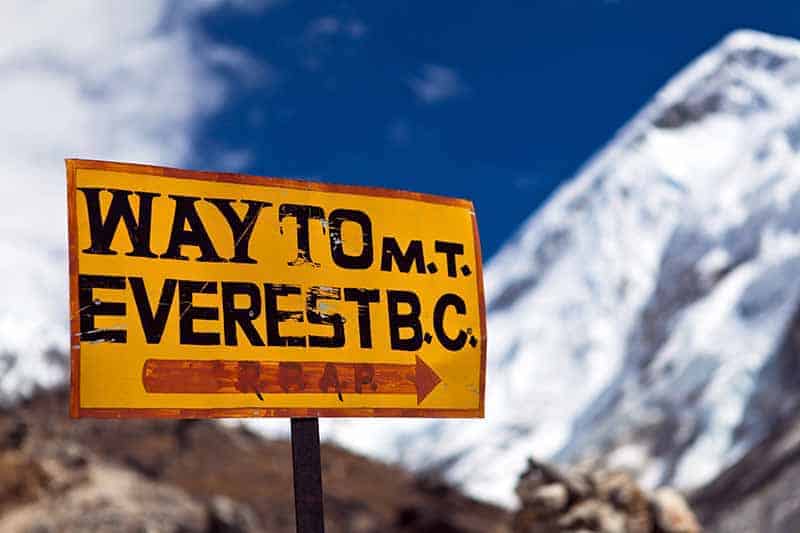
The Sagarmatha National Park is home to rare animal species such as snow leopards and red pandas – though it’s very unlikely you’ll encounter them. You’ll frequently have to step aside (to the uphill side!) as you encounter yaks on the trail.
Whether you choose to follow the traditional EBC route or one of the alternative trails, it’s guaranteed to be an experience you’ll never forget.
In contrast to most multi-day treks where you’d be camping in a tent, trekkers to base camp stay in cozy tea houses. You can find several available in a range of budgets, which function as both hotels and restaurants.
The trek is dotted with Buddhist monasteries and tiny villages almost all the way up. The relaxed pace of the trek allows plenty of time for you to explore the villages and get to know the local Sherpa culture.
Mt. Everest is increasingly covered in garbage left behind by the hordes of people who have set out to conquer its lofty heights. When you go, please respect the environment and do your best to minimize waste.
The most popular time of year to do the Everest base camp trek is between February and May – the pre-monsoon season.
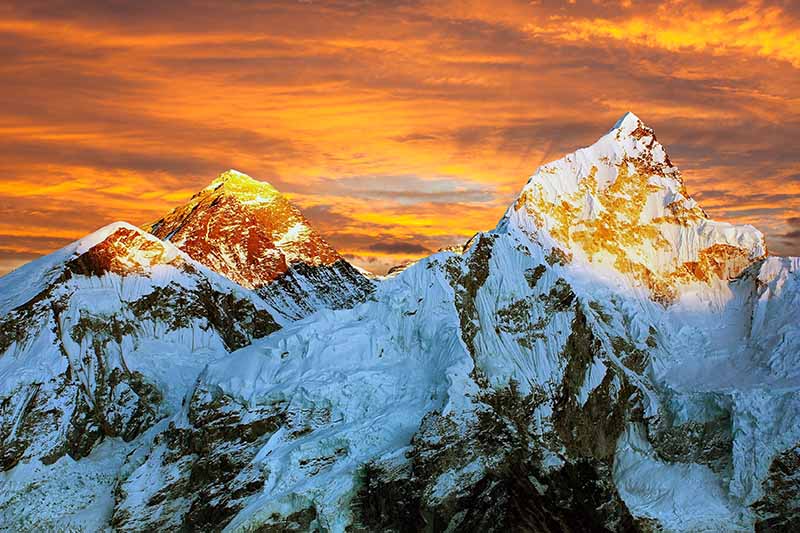
During these spring months, the weather is typically warm and dry and the mountains will be ablaze with colorful rhododendrons.
This is also peak season and while you’re unlikely to have the trails to yourself, you’ll enjoy a buzzing atmosphere at the tea houses on the way. This is also when most Everest climbers make their summit attempts.
The summer months bring the monsoon rains, resulting in slippery trails and a heightened risk of landslides. If that doesn’t deter you, the leeches and foggy weather might! It’s not recommended to attempt the trek in the summer.
It can also be difficult to fly into Lukla during the monsoon. Indeed, this is a good time to pick the Jiri trek over the classic EBC trek.

If you want fewer crowds, try going in September or October, the post-monsoon months, when you have the highest chance of clear skies, although temperatures are slightly colder.
You can even do the trek in the winter but be prepared for sub-zero temperatures most days and lots of snow.
Whenever you go, make sure you pack for unpredictable weather in case a snowstorm takes you by surprise.
Trekkers interested in the local culture might want to plan their trip dates around traditional holidays with celebrations in Kathmandu, such as Holi (February/March) or Indra Jatra (September).
Another thing to consider when planning your trip is flight prices, which can vary considerably. Check flights before booking as this might have a huge impact on when you want to go.
Lastly, be aware that it might be harder to find tour operators who provide treks in off-season months. Also, some of the paths might be closed.
Conversely, if you want a stab at actually sleeping in Everest Base Camp, then late spring is your best option. It will be rare to find tour operators who might be able to wrangle this.
Everest Base Camp Packing list
If this is your first multi-day trek, don’t forget to budget for all the equipment you’ll have to take with you.
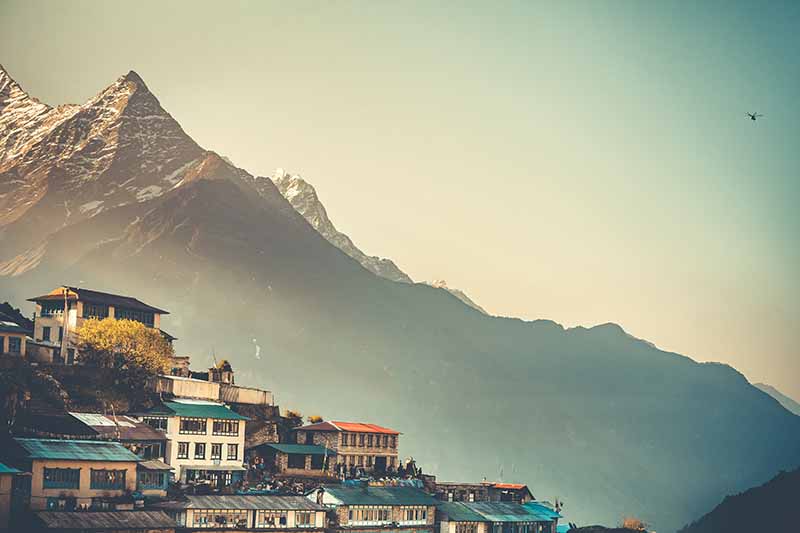
You can choose between renting or buying your gear. Hikers who plan on doing more multi-day treks might want to invest in their own equipment.
If you’re doing a two-week trek, it makes more sense to rent your sleeping bag and down jacket. For trekkers who plan on trekking for a whole month, it makes more financial sense to buy.
The neighborhood of Thamel in Kathmandu offers plenty of options for buying and renting. However, the products on offer may be of questionable quality.
Further on, Namche Bazaar is a last-resort option if you find you’ve forgotten to pack any essentials. If you keep your receipts, then talk it over with the shop when buying. Some shops will buy your gear back from you, at the end of your trek, for a reduced price.
Almost everything available for sale along the trek has been carried up the mountain, either by yaks or people. This means things get more expensive the higher you go.
Packing strategically. This means bringing the items you can’t live without while avoiding overloading your backpack. Whether you hire a porter or decide to go solo, somebody will be lugging your things up the mountain. Indeed,think twice before including unnecessary items like an extra book or five spare shirts!
Aim to pack around 10kg if you’re carrying everything yourself, and 20-25kg if you’re getting help from a porter. Don’t forget that your water adds extra weight. Try packing your bag with full water bottles, to get a more accurate idea of how much you can bring.
This list is aimed at trekkers who will be sleeping in tea houses every night. Be aware that if you don’t book early enough, the tea houses may be sold out in high season.
If you think you might end up having to camp, Then you’ll need more supplies not covered on this list. Such as a winter insulated tent , sleeping pad , etc.
What to Wear
The clothes you pack will depend on which season you’re visiting in. Make sure you have enough clothing to keep warm, especially in the evenings.

Layers are crucial, as temperatures and weather conditions will change drastically between day and night and as you ascend and descend in altitude.
Tea houses often only heat the common areas, and then only in the evenings, so bring warm clothes for lounging around at night.
The higher you get, the less likely you are to have power in your tea house, or only for a few hours as they’re run off solar power.
Base layers: Your base layer should be comfortable and moisture-wicking. Stay away from cotton; go for merino wool or synthetics .
Pack a long-sleeved shirt (avoid short sleeves as you’re more likely to get sunburnt) and long underwear, if only for the cold evenings.
Fleece mid-layer: You’ll probably be putting this on and taking it off with every mountain pass. Indeed, try to find one that will fit easily into your day pack.
Outer layer: Get a down jacket with a good warmth-to-weight ratio, as you’ll be carrying it much of the time.
Waterproof windbreaker and pants.
Hiking pants: Well-insulated trekking pants , or trekking pants that can turn into shorts.
Waterproof hiking boots. We can’t stress enough how important it is to break your hiking boots in properly before your trek.
Don’t forget to bring a pair of comfortable sneakers or sandals for the evenings and for bathroom runs.
Socks: Woollen hiking socks are worth the investment – bring a few pairs that can handle very cold temperatures for the higher altitudes, and look for flat seams and padded spots to reduce blisters.
Sock liners and Vaseline are two other good ways to prevent blisters . You should also bring a pair of warm socks for base camp.
Gaiters: These will be especially useful during the rainier months.
Gloves : Pack a thin pair of “inner” gloves and a very warm pair of outer gloves. There will be at least one or two days where your fingers will freeze otherwise – for example, the day you summit Kala Patthar.
Scarf/balaclava/buff: The trail to EBC gets infamously dusty, provoking the “ Khumbu cough ” that plagues many hikers. A buff or something similar will keep you warm as well as provide you with a layer to breathe through to minimize the amount of dust in your lungs.
Beanie and sun hat , preferably with neck cover, to protect against the sun .
Underwear and sports bras: You’ll probably be reusing these, so get good-quality, non-cotton ones.
Accessories
Drinking water: Most tour operators provide purified water. Avoid bottled water, as this is expensive on top of being an environmental disaster.

We recommend bringing two big reusable water bottles (or a water bladder for drinking on the go). Tablets take a while to work and it’s nice to have one water bottle ready to drink while the other one is getting purified.
You can also fill a bottle with hot water and sleep with it in your sleeping bag if you’re cold during the night. If you’re purifying your own water, bring water purification tablets , LifeStraw , or a Steri-pen. But remember, these need charging, and charging on the trail costs money.
You may wish to add flavor enhancers to your water. Unfortunately, at Gorak Shep the water is very mineralized so you’ll need to buy bottled water.
Showering: Whether or not you shower is up to you. Expect to pay around $5 for a hot shower. Some people rely on wet or backpacking body wipes , especially since wet hair is no fun in negative temperatures!
Sunglasses: The combination of snow and altitude is brutal on your eyes, so invest in good polarized sunglasses with wraparound arms.
Sleeping bag : The teahouses will provide blankets and pillows but you’ll want your own sleeping bag and pillowcase.
Find a mummy sleeping bag rated to -20° C – or colder, depending on the season. Consider bringing a silk liner , especially if you’re renting your sleeping bag.
Toiletries: Sunscreen , SPF chapstick (this is better than lip balm as there’s no need to smear it on with your grubby fingers), quick-drying towel, tissue, baby wipes, period supplies, compressed toilet paper tablets or biodegradable toilet paper (remove cardboard and keep in ziptop bag), hand sanitizer, toothbrush and toothpaste, etc.
Always bring toilet paper with you. Most bathrooms are squat toilets and are located only in villages.
Tip : wet wipes are more expensive than toilet paper on the trail, so if you have to choose, stock up on wet wipes and buy toilet paper when you run out.
Shewee: Ladies, you’ll be glad not to have to pull your pants down in the freezing high-altitude weather. If you need to pee, then I recommend using a portable pee device, like PeeBuddy Reusable Female Urination Device . You stand and use the portable pee funnel, so you don’t need to squat.
If you get your period on the trail and you’re not comfortable with using the DivaCup, another good option is to keep used pads/tampons in a ziptop bag and dispose of them in the next garbage can.
Personal first-aid kit: Bring diarrhea meds, altitude meds, antibiotics, ibuprofen, paracetamol, aspirin, bandaids, blister plasters, tape/trekker’s wool, Vaseline, cough drops (to beat the Khumbu cough), cold medicine, rehydration salts.
Tour operators should provide the rest. Don’t forget to get your travel vaccines before you go.
TSA approved padlock for your luggage.
Backpack: What you pack your gear in will depend on whether you’re using porters. Most porters prefer you to pack your things in a soft-sided duffel bag. Check with the tour operator in case they provide these for you.
If you have a porter, then you’ll only need a daypack for yourself. If you’re not hiring a porter, then bring a collapsible daypack anyway in addition to your backpack. This is so you can leave your big backpack in the tea house during the one-day acclimatization hikes.

Try to get a backpack with straps for hiking poles and zippers to open it from the sides. Not to mention, you won’t have to dig everything out of your bag whenever you want to access something.
Dry bag or plastic cover for your backpack and daypack to prevent water ingress.
Hiking poles : These are a must! All the treks listed here will take you uphill, downhill, uphill and downhill again. Hiking poles will save your knees, and they’ll come in handy on slippery trails during the wet season.
Headlamp or flashlight : You’ll be glad to have this in the evenings after the power goes out, and during early-morning or late-night hikes. Remember to bring extra batteries.
Trekking map: If you’re going independently, a good trekking guidebook is essential – Lonely Planet is highly recommended.
Ziptop bags: These always come in handy for protecting electronics, etc.
Camera or GoPro with memory card and extra batteries.
Money: There are ATMs at select points such as Lukla and Namche Bazaar. But these have low daily withdrawal limits and high commission fees. What’s more, they have been known to take money out of your account without actually dispensing it to you.
Since currency exchange rates on the trail are sky-high, it’s best to bring a stash of local rupees with you. You’ll need rupees to pay for meals, showers, tips, etc.
Wi-Fi: A good option for staying connected is to buy a local sim card. It will give you data to about 4000m altitudes, and sometimes in EBC itself.
You can also check Everest Link for Wi-Fi data packages. The connection is supposedly available in most teahouses along the way, but it can be slow and unreliable so don’t depend on it too much.
Top Tip : Beware of phone updates. These will eat through your Wi-Fi and data limits before you realize what just happened!

Entertainment: EBC treks usually only schedule a few hours of hiking a day, to allow you time to acclimatize. Bring books, a Kindle , cards or other games for the many hours of downtime. Certainly, bring a journal so you can remember this once-in-a-lifetime experience!
Solar charger: Many teahouses offer power points where you can charge your devices for a nominal fee. Also, don’t forget to bring an adapter. It’s a good idea to bring your own solar-powered charger and extra batteries to minimize costs.
Tip : Keep batteries, base layers , and anything else you don’t want freezing in your sleeping bag with you overnight. Keep your phone in flight mode to save power.
Important documents: Bring printouts of your travel insurance information. And make sure one of your travel buddies knows what to do and whom to contact in case of an emergency.
Bring your passport, visas, money, etc. – I always keep these documents in a zip-top bag.
Trekking solo? Bring a safety whistle , compass , pocket knife , & duct tape, especially on the less-crowded trails
High-calorie snacks: These will make a huge difference to your experience. Snacks are exceedingly expensive on the trail, and they provide welcome calories on tough trekking days.
You’ll have to decide how many you want to bring and which ones you want to buy along the trail.
Cloth bags : Many trekkers use these to separate dirty laundry and organize different outfits.
Earplugs: You’ll be glad for these when the tea houses are alive with the sound of Khumbu coughs.
A Note on Trekking Insurance
Be very careful when purchasing travel insurance, because regular policies usually stop covering you once you ascend higher than 3,000m/9,840ft.

At these altitudes, you have a higher chance of getting Acute Mountain Sickness. Also, there’s a pretty good chance you’ll have to be airlifted out to a hospital for injuries . To clarify, injuries like a pulled muscle or twisted ankle at sea level can be more serious at higher altitudes.
Because of these higher costs and risks , insurance companies will charge you a premium for high-altitude trekking insurance.
Luckily, there’s no shortage of insurance companies that offer travel insurance specifically tailored to Everest Base Camp trekkers.
When purchasing a policy, make sure you’re covered for trekking up to altitudes of 6,000m/19,685ft. In addition, ensure it has search and rescue costs, preferably by helicopter.
Don’t forget to check if you’re covered for different travel-related illnesses (and make sure you get your vaccinations before going!).
It’s also nice to have compensation for delayed or canceled flights and repatriation in case of death (hopefully you won’t be needing this one).
Check the clause about lost, stolen or damaged luggage to see if it will cover most of the cost of your hiking gear.

If you’re traveling in winter or shoulder season, then check for trip cancelation insurance. This is to ensure you’re covered if your trek is canceled due to weather.
You’ll likely have other considerations depending on your personal situation. Don’t just take our advice for it – remember to do your research, ask questions and read the fine print of your travel insurance policy before you purchase.
I always keep my travel insurance information handy while on the trek. Additionally, I pass it along to someone else in my group. This is so they know whom to contact in case of an emergency.
Some travel insurance providers require you to confirm with them before ordering a helicopter. Check out this option on getting trekking travel insurance for more information.
How to Avoid Altitude Sickness
Most tour operators organize a relaxed trekking schedule and follow the mantra “climb high, sleep low”. In essence, this is to avoid the risk of altitude sickness.
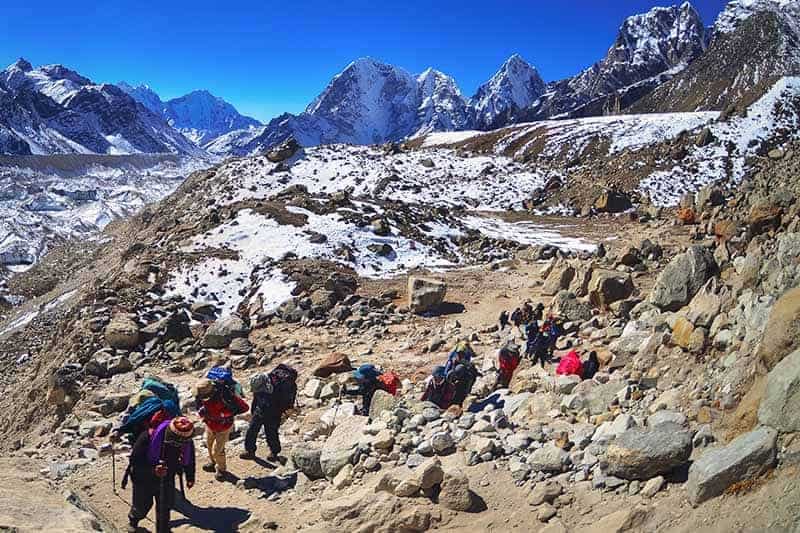
Take it slow – once you finish hiking for the day you’ll have a lot of dead hours in the teahouse. For this reason there’s really no point in racing there.
It’s important to respect the acclimatization days. The acclimatization hikes are designed to help you adjust to tomorrow’s altitude.
Try to drink 3-4 liters of water a day, as dehydration will make the altitude sickness way worse. It also goes without saying that you shouldn’t drink caffeine or alcohol or smoke during your trek.
If you can, then cut out these vices about a week before you start hiking. So that you won’t suffer from withdrawal headaches.
Many people swear by Diamox as a preventative drug against AMS. It’s your choice whether to take this or not. I personally found the tingling fingers and toes to be very off-putting, but it probably helped me acclimatize.
Altitude sickness is unpredictable and doesn’t discriminate based on fitness or age. Listen to your body and descend immediately if you think you have signs of Acute Mountain Sickness.
Check out our article on altitude sickness for a more detailed overview.
Choosing a Tour Operator
Every year there are rumors that the Nepali government will make it compulsory to go with a guide.. But so far, it’s still possible to undertake the trek to EBC on your own.

Unless you’re going in high season, you’ll can drop in at tea houses and get a bed without a reservation.
Independent trekkers can choose whether to hike all by themselves. While others choose between ring a porter, a guide, or a guide and a porter. A guide will speak some English and can help with booking accommodation. However, a porter probably won’t speak English and will only carry your bag.
You can also hire one person who acts as a guide and a porter. Another upside to hiring a guide is that you’ll be providing someone with a job. And in turn, you’ll get to immerse yourself in the Nepali culture.
Alternately, you can opt to join a guided trek with a tour operator. While this is pricier, it’s a good choice for people who have never done such a long, high-altitude trek before.
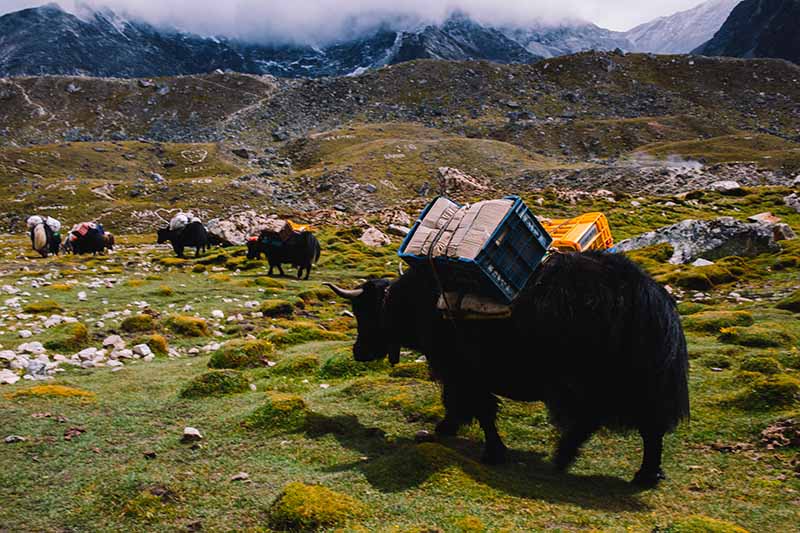
Tour operators typically arrange flights, airport transfers, accommodation, visas and permits, porters and guides. Western tour operators will usually charge more, but provide a more trustworthy service. You can expect to pay about twice as much for a Western tour operator.
Check to see if your tour operator is registered with the Trekking Agencies Association of Nepal (TAAN). TAAN regulates trekking agencies in Nepal to ensure fair treatment of employees, respect for local communities and preservation of the environment.
The Kilimanjaro Porters Assistance Project mission is to improve the working conditions of porters. They advocate for fair treatment and wages, lend free mountaineering clothing, and encourage them to work for only ethical companies. Through providing education and training opportunities, guides and porters have received classes on porters rights, Leave No Trace and are certified in First Aid.
Please make every effort to ensure the porters and guides are dressed properly, stay within the weight limit including their own luggage. Also, ensure they have adequate sleeping arrangements and insurance and are paid a fair wage.
It’s better to go with companies that employ their porters and guides full-time instead of freelance because there’s a better chance the company is providing them with benefits, sick days and health insurance.
Tipping is always a tricky subject and suggested rates will depend on whom you ask. Aim for around 15 percent of salary (if you’re traveling in a group, this number refers to the total pooled tip) per porter and/or guide, and adjust accordingly.
The classic Everest Base Camp trek winds through the Khumbu valley; once reaching Everest Base Camp, you’ll retrace your steps back down to Lukla for the return flight to Kathmandu.

If you’re interested in escaping the crowds or doing circular routes that don’t involve retracing your steps, there’s a variety of alternate routes to choose from.
You can also opt to tack small detours onto your classic EBC trek. This is especially doable if you’re traveling independently or in a small group.
You shouldn’t have any trouble booking your trek, even on the classic EBC trek.
Classic Everest Base Camp trek
The classic Everest Base Camp trek takes about 14 days, including time in Kathmandu before and after.
From Kathmandu, you’ll fly into Lukla Airport (2,860m/9,383ft) with its famously short runway – try to sit on the left side of the plane so you can catch your first views of Mt. Everest.
It’s a good idea to leave yourself a few buffer days, as Lukla flights are often delayed due to weather. Flights should be included in your tour price; otherwise they’re about USD 300, plus USD 100 for your guide’s ticket.
From the airport, you’ll trek to Phakding for the night.
The next day you’ll set out from Phakding and follow the Dudh Koshi River, crossing suspension bridges and pine forests until you reach the Namche Bazaar (3,440m/11,286ft), in the Sagarmatha National Park UNESCO World Heritage Site .
Namche Bazaar is the region’s principal trading point, so use this opportunity to stock up on supplies you might have forgotten. If you’re there on Saturday, then don’t miss the market. From here you can also catch a peak of Everest.
You’ll take a day to acclimatize in Namche Bazaar – you can make the most of the Wi-Fi, stock up on any supplies you forgot, check out the Sherpa museum or just tool around the village.
The day after you’ll follow the former Tibet-Nepal trading route via Thame to Tengboche. These villages are known for legendary views, where you can visit one of the region’s biggest monasteries .
Next you’ll hike through Phangboche to Pheriche while admiring the views of Ama Dablam. You might be interested to know that Pheriche is where the Himalayan Rescue Association makes its base – but hopefully you won’t need to use this information!
Most people stay in Pheriche for a day to acclimatize and visit local attractions like the Imja Lake or Dingboche village, which boasts views of Lhotse and Island Peak.
Now that you’re rested, you’ll be ready to tackle the trek to Lobuche, which features a 600m/1,969ft elevation gain. You’ll skirt the perilous Khumbu Glacier and witness the many memorials to sherpas and climbers who perished in their attempt to climb Everest.
From Lobuche you’ll set out towards Gorak Shep, which is the world’s highest permanently inhabited village.
Finally, it’s time to push on through the moraine towards Everest Base Camp! Since actual summiteers of Everest have priority, don’t expect to spend too long there or even be allowed inside the base camp itself.
But don’t worry, the adrenaline-filled atmosphere extends all the way down to the trekker stop point! From here you’ll go back down to Gorak Shep for the night.
You can’t actually see the peak of Mt. Everest from Everest Base Camp, so the next day you’ll make a steep ascent up to the summit of Kala Patthar (5545m/ 18,192ft) to catch amazing views of Everest, Nuptse (7,861m/25,791ft) and Lhotse (8,516m/27,940ft).
Most groups try to do this at sunset on the same day as they reach EBC, or at sunrise the next morning, when Mt. Everest sometimes turns pink in the early-morning light.
Forging on ahead, you’ll descend to Dingboche or Pheriche, and from there past Tengboche and back to Namche Bazaar the next day. Keep an eye out for the massive fields of wild rhododendrons if you’re visiting in the spring!
Your last day of trekking will take you back to Lukla, where you’ll spend the night before catching the flight to Kathmandu.
- Pros : Comparatively gentle altitude profile, can be done independently
- Cons : Have to retrace steps on the way down, can be crowded
- Length : ~130km (12-14 days)
- Highest point : Kala Patthar (5545m/ 18,192ft)
Gokyo Lakes Trek
The Gokyo Lakes Trek is popular for its beautiful glacial lakes , nestled in the quiet Gokyo valley.
Like the classic Everest Base Camp trek, the Gokyo Lakes trek starts at Lukla, breaking off towards the northwest at the Namche Bazaar.
This trek is considered slightly more challenging than the classic EBC trek, with steeper ascents and more time spent at high altitudes.
It takes 2-3 days longer, detouring around some of the most crowded sections of the classic base camp trek but still finishing at Everest Base Camp.
You’ll see glacial lakes and summit Gokyo Ri (5,357m/17,575ft) where you’ll earn views of Everest, Lhotse and Cho Oyu (8,201m/26,906ft).
Fly into Kathmandu, spend a few days acclimatizing and then take another flight to Lukla. The next day, you’ll trek down through the Dudh Koshi Valley to Phakding past several Buddhist sites.
Hiking through pine forests and along the Dudh Koshi River, you’ll cross several suspension bridges including the Hillary Suspension Bridge. After entering the Sagarmatha National Park, you’ll continue hiking until the Namche Bazaar.
You’ll then separate from the classic EBC trek and head northwest towards Dole along the Dudh Koshi valley. You’ll get some of the first views of Everest, Lhotse and Ama Dablam today.
The next day brings a steep climb towards Machhermo, which is populated with yaks in the summer.
Allow yourself a day to acclimatize and enjoy views of Ngozumpa Glacier (the biggest glacier in the Himalayas). Once you’ve enjoyed the glacier, trek to the Gokyo lakes and you’ll eventually reach Gokyo village. If you are tired by now, you’re in luck because this is where you’ll bed down for the night.
This is another popular time to take an acclimatization rest day and explore the surrounding lakes, or summit Gokyo Ri, which stands almost 5,500m/18,045ft above sea level.
Stop to take in the stunning views of Everest, Lhotse and Cho Oyu, then continue back down to the Ngozumpa glacier and on into Dragnag.
The next day is a tough one. You’ll traverse Cho La, one of the “Three Passes” (5,420m/17,782ft), cross a glacier and then spend the night in Zonglha.
Joining up with the classic EBC trek, you’ll stop for a moment of reflection at the memorials to sherpas and climbers who perished in their attempts to climb Everest, and then continue on to Lobuche for the night.
From Lobuche, you’ll skirt the Khumbu glacier, hiking up past Gorak Shep and finally you’ll reach Everest Base Camp! Enjoy it while it lasts, because the priority at EBC is the Everest summiteers, especially in the spring months.
You’ll hike back down to Gorak Shep alongside views of the Khumbu icefall . Part of the highest glacier on Earth, the icefall’s deadly crevasses, unstable seracs and unpredictable avalanches have taken dozens of lives.
The next day you’ll hike up Kala Patthar, with more views of Everest and the neighboring mountain peaks, and then down to Dingboche along the classic EBC route.
It’s time to return to Namche Bazaar. The day after you’ll hike back to Lukla through the Dudh Koshi valley, and then fly into Kathmandu.
Because the trek is longer, expect to pay more than you would for the classic EBC trek. Trekkers are advised not to attempt this trek independently, due to the increased difficulty and the fact that there are fewer people on the routes.
Like the classic EBC trek, the best time to go is during spring or fall. Because the trek isn’t as popular, you shouldn’t have to worry about crowds for most of the way, so feel free to go during peak season.
- Pros : Fewer crowds, more challenging, more sights, get to summit a peak, see the world’s highest freshwater lake system, prettier landscapes than classic trek, circular route so no need to retrace steps
- Cons : More expensive than classic EBC trek
- Length : ~220km/136 miles (16-17 days, including a few days in Kathmandu before and after)
- Highest point : Kala Patthar (5545m/18,192ft)
Jiri to Everest Base Camp
This old-school route mirrors the route taken by the first Everest summiteers in the 1950’s, starting with an 8-hour bus ride from Kathmandu to Jiri instead of flying into Lukla.
From Jiri, you’ll pass through the towns of Sete, Junbesi and Numtala in the Solu Khumbu region.
After reaching Lukla, you’ll join up with the classic EBC trek, passing through Phakding, Namche Bazaar, Tengboche, Pheriche and Gorak Shep.
In total, the Jiri route takes about 5-6 days longer than the classic route.
Jiri route trekkers will have the chance to spend a lot more time with the locals. You’ll also spend more time at low altitudes – the route starts at just 1,800m/5,905ft above sea level – meaning landscapes will forests and streams with actual running water.
Much of the trek is off the beaten path, with fewer crowds than the EBC classic trek.
Tool around Kathmandu for a day and then take an 8-hour (190km/118 mile) bus ride, following the Sun Koshi River to Jiri and then Shivalaya.
The next day, you’ll cross a suspension bridge over the river and then explore several tea houses. Go through the Deorali Pass, taking a moment to check out the prayer flags and decorated walls, and then head down to Bhandar for the night.
From Bhandar, you’ll walk through fields and forests before embarking on a steep descent t
owards the village of Kenja. Uphill again, you’ll traverse the Lamjura Pass and arrive at the town of Sete.
The next day, you’ll return to the Lamjura Pass and pass through magnificent fields of pine trees, magnolia and rhododendrons. Without a doubt, you’ll appreciate the stunning mountain views. Next,hike down the other side and you’ll arrive at the town of Junbesi.
Back into the forest, you’ll see Mt. Everest for the first time. You’ll then cross the Ringmo Khola suspension bridge and arrive at the village of Ringmo with its gorgeous Tibetan architecture. Another forest and you’ll be at Nunthala.
In the morning, you’ll head out towards the Dudh Koshi River, crossing another impressive suspension bridge on your way to Bupsa.
The next few days will take you to higher altitudes as you pass through forests with monkeys and several small villages.
Arriving in Lukla, you’ll join up with the classic EBC trek. After reaching Everest Base Camp, you’ll summit Kala Patthar for the obligatory views of Mt. Everest at dawn and then return through Gorak Shep, Namche Bazaar and finally Lukla, for your flight back to Kathmandu.
Like the classic Everest trek, the Jiri route is best undertaken in spring or fall. Caution: some parts of the Jiri trek may be closed in the winter, so we don’t recommend going during this season.
The Jiri route is only slightly more difficult than the classic Everest Base Camp route, due to its longer duration.
The average day of hiking comprises 5-6 hours, covering about 15km/9 miles. On the bright side, due to the more gradual ascent compared with the classic trek, you’re less likely to get altitude sickness.
- Pros : More authentic, less touristy, chance to see Solo Khumbu landscapes (terraced farmland, forests, Dudh Koshi river, sherpas), gradual acclimatization
- Cons : 8-hour bus ride (but scenic!)
- Length : ~250km/155 miles (22 days, of which 18 days of trekking)
- Highest point : Kala Patthar (5,545m/ 18,192ft)
Three Passes Trek
As you might infer from the name, the Three Passes trek takes you across three high mountain passes (all higher than 5,000m/16,400ft). Thus, making it more difficult than the classic EBC trek.
After reaching Namche Bazaar, the Three Passes trek splits off from the classic trek. This takes you towards Thame and the Nangpa Valley. The trek takes around 19 days in total, of which 14-15 will be spent trekking. Getting a guide is highly recommended.
After flying into Lukla from Kathmandu, you’ll work your way down to Phakding.
The next day will take you across several suspension bridges on the way to Namche Bazaar. You’ll be there for a day of acclimatizing. After which you’ll split off from the classic EBC route and head to Thame.
Crossing the Bhote Koshi river, you’ll reach Lumde and catch your first good views of the mountain peaks. The next day, you’ll tackle the first pass.
The Renjo La (5,360m/17,585ft) lies near the Dudh Koshi valley and will reward you with views of Everest. Then you’ll pass the Gokyo lakes and the village of Gokyo, where you’ll summit Gokyo Ri and catch sight of Cho Oyu.
After spending some time acclimatizing in Gokyo, you’ll walk across the Ngozumpa Glacier. This is Nepal’s largest glacier, and you’ll then spend the night in Dragnag.
The next day is notorious. You’ll traverse the next pass, Cho La (5,420m/17,782 ft), which has a glacier and prayer flags at the top. On the other side of the pass lies Zonglha.
Joining back up with the base camp trek, you’ll visit Lobuche and Gorak Shep and take in views of the Khumbu Glacier, Everest, Lhotse and Nuptse.
You’ll explore Everest Base Camp and summit Kala Patthar before retracing your steps back through Gorak Shep and Lobuche.
The trek keeps on going, past the Kongma La pass (5,535m/18,159ft), down into the Chukkung valley and up to the summit of Chukking Ri (5,550m/18,209ft) with more mountain views.
You’ll trek through Dingboche, with its views over the Khumbu Valley. Eventually, you hike down through the rhododendron fields and the village of Khumjung, ending back at the Namche Bazaar.
From here you’ll cross the Dudh Koshi, following the classic EBC route back down to Lukla.
This trek can also be done backwards; it’s up to you whether you want to head clockwise or counter-clockwise after the Namche Bazaar.
Many people recommend doing the trek counter-clockwise to avoid crossing the difficult Renjo La Pass right off the bat.
You’re best off doing this trek with a tour operator, as it’s quite off the beaten path.
- Pros : See a little bit of everything, uncrowded trails, challenging elevation profile
- Cons : Riskier terrain than classic EBC trail, long stretches with no facilities
- Length : ~21 days (150km/90 miles)
- Highest point : Chukking Ri (5,550m/18,209ft)
Island Peak (Imja Tse)
Experienced trekkers who wish to try their hand at mountaineering might be interested in summiting Island Peak (6,189 m/20,305 ft).

To master the glaciers and icy headwall during the ascent of these peaks, you’ll need to use crampons, an ice ax and potentially a ladder and ropes to cross the crevasses, depending on the weather.
Tour operators claim you can learn these skills on the fly, but it’s better to have some prior mountaineering experience before you tackle these routes, which are significantly more challenging.
That being said, Island Peak is a relatively “easy” climb as far as climbs go, so it’s a good option if you’re looking to expand your repertoire.
Since a detailed itinerary of Island Peak is outside the scope of this article, be aware that the general packing list doesn’t include the specialized mountaineering equipment you need for this trek.
Likewise, ascending Island Peak takes you above 6,000m and will probably not be covered by standard travel insurance providers, so check with your local mountaineering association for options.
Practical Information
What will I eat? How much will the trip cost? These are the questions most frequently asked.
As a general rule, the tea house lodgings themselves are very, very cheap with the condition that you eat dinner and breakfast in the same lodge.
This is where your costs will really add up – food is very expensive – so check with your tour operator when booking to see if meals are included.
Food on the trek is repetitive but nourishing. The meals are carb-heavy – think pasta dishes, dahl baht or “sherpa stew” with veggies and noodles.
What other trek offers the convenience of stopping in at a tea house or bakery for a hot lunch or freshly baked pastry? Just be prepared for stretches where you won’t see a tea house for several hours.
Hot drinks are readily available, and a popular treat is a deep-fried Mars bar. Don’t leave without trying one!
Most people recommend going vegetarian during the trek. Sagarmatha National Park has a no-kill policy so all meat has to be carried up by porters or yaks and is never very fresh, so there’s a real risk of getting sick.
Much of the garbage that’s disposed of in the villages ends up getting burned on-site, which really makes you consider the impact of your waste.
Before wantonly throwing plastic into the garbage cans, try to reduce what you use and pack out as much as you can.
The budget for your trip will vary widely depending on whether you’re trekking independently or going with a tour operator.
If you are booking with a tour operator, the flight price and permit prices should be included – usually you’ll have to pay for your guide’s flight as well.
Tour prices run from about USD 1000 to 3000 depending whether you go local or get a Western tour operator.
Budget around USD 400 for the flight from Kathmandu to Lukla Airport, including your guide’s ticket. If you go independently, consider getting help from a local agency for buying your flight tickets.
Flights have a way of being overbooked and you’re more likely to get on the plane if a local agent is vouching for you. On this note, factor in a few buffer days for your flight from Lukla back to Kathmandu, in case of weather or overbooking delays.
Nationals of all countries except India will need a visa to enter Nepal, which costs USD 25 for 15 days, USD 40 for 30 days and USD 100 for 90 days.
You’re best off getting the 30-day visa even if your trek is only scheduled to take two weeks, as weather and other factors might extend the trip unexpectedly. For the most part, you can get your visa when you land in Nepal.
It used to be mandatory to purchase a Trekkers Information Management System (TIMS) card, but the laws on this are constantly changing and there is a new local tax being charged, so check before you go unless your tour operator is arranging paperwork for you.
You will need a Sagarmatha National Park entry permit, which you can get ahead of time or at Monjo, when entering the park.
The price of the permits will normally be included in the trip price if going with a tour operator. Bring several passport photos for the permits.
All Set: Are You Ready?
The name “Everest” may sound intimidating, but this is actually one of the more approachable multi-day treks out there.

If you have a reasonable fitness level and are comfortable walking uphill for several hours a day carrying a heavy backpack, then you should be able to complete the trek. The key is to go slowly to avoid altitude sickness.
You don’t need special mountaineering know-how or an incredible level of fitness. The hike to EBC is a relaxed one, as hikes go.
The pace is slow, to allow you the time to acclimatize, so you’ll have plenty of free hours to peruse the village cafés, tuck into a slice of apple pie and snuggle up with a good book or make friends over a game of cards back at the teahouse.
That being said, of course it’s a good idea to prepare for the trek by hitting the gym in the months prior to your departure, and plenty of practice hikes starting two months before you go.
Don’t forget to practice hiking with a heavy backpack on! Check out this article for more tips on preparing for an uphill hike .
In total, the trek is around 130km/81 miles round trip, with an elevation gain of 2,685m/8,809ft between Lukla (2,860 m) and Kala Patthar (5,545 m).
It’s usually done in just under two weeks, including rest days for acclimatization. The outward leg will take longer and you can expect to trek 5-6 hours per trekking day, covering an average of 15km/9 miles.
The hike from EBC back to Lukla will go much faster since you’ll already be acclimatized.
Plenty of people with no prior trekking experience manage to complete the EBC trek and you can too! Like any non-technical trek at altitude , the key is a proper pace, a decent level of fitness and most of all, a good attitude!
Have you been trekking in Nepal? Let us know about it in the comments section below!
Disclaimer : This post is for information only and is not intended to replace the advice of an experienced guide. Always do your research and check with local weather stations, etc. before attempting to undertake treks in the wild. Distances are approximate and routes may vary depending on your tour operator.
Photos via Depositphotos.
- Insider’s Guide to Hiking Machu Picchu
- Inspirational Mountains: Exciting Summits for Ordinary Hikers
- Climbing Kilimanjaro: Everything you Need to Know
- Four Pass Loop (This Hiking Trail Should Be at the Top of Your List)

Camping Games for Kids: Fun and Thrills in the Great Outdoors

Carolina Beach Camping Revealed: Discover the Gem of the South

15 Best Mountaineers Ice Axes (to Get You to the Top)

Relaxation and Recreation: Rehoboth Beach Camping Unraveled
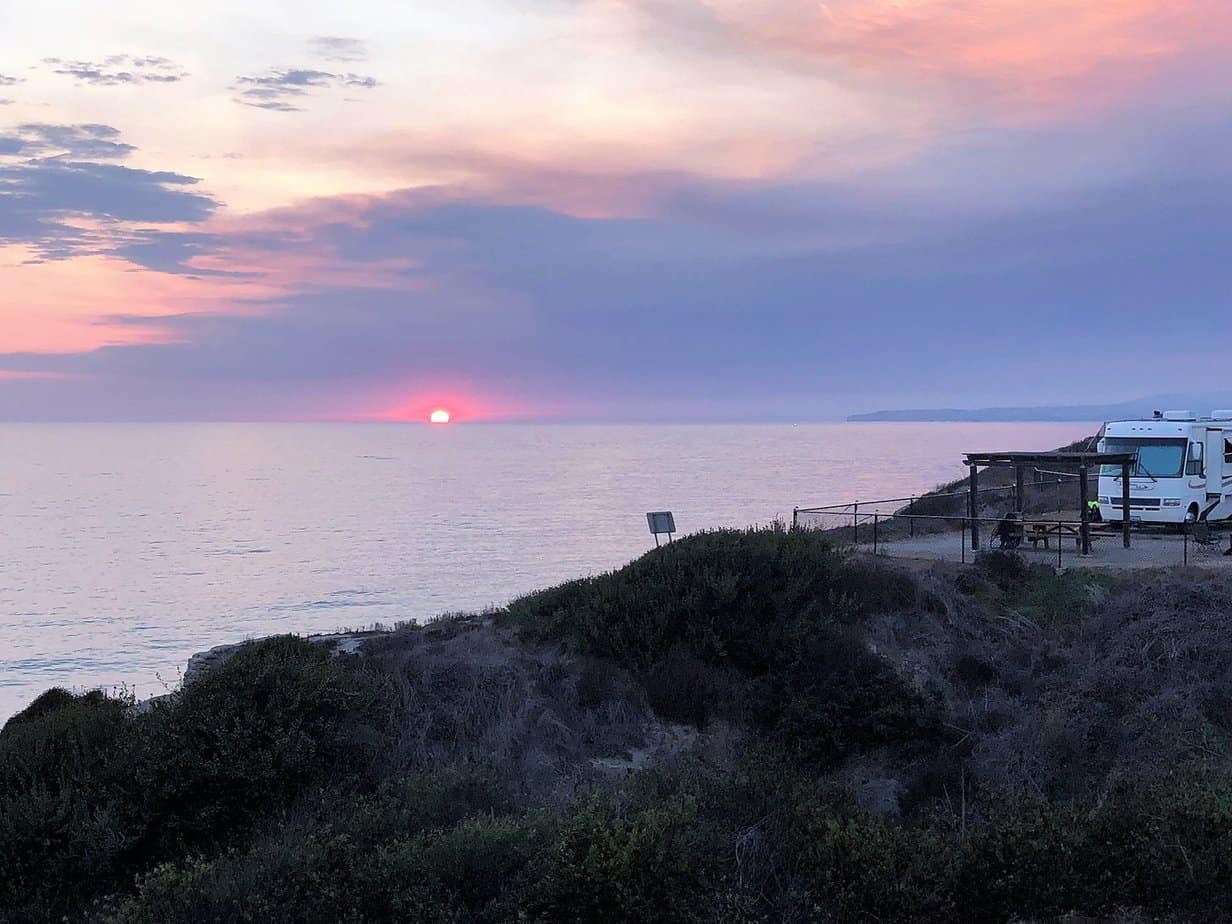
San Clemente Beach Camping: Coastal Camping Bliss Unveiled

Best Bivy Sacks on the Market In 2024

Jetboil Zip vs Flash: Battle of the Boilers

Best Insulated Tents for Winter Camping

Exciting Campfire Games: Unleash Your Inner Adventurer

Insider Secrets of Backpacking Meal Planning

Hit the Trails With Confidence – The Best Summer Hiking Gloves to Protect Your Hands

The Best Car Camping Mattress: Our Top 7 Picks for Long Trips

Discover the Best Pop-Up Tents: Expert Reviews & Buying Tips
Last update on 2024-05-04 / Affiliate links / Images from Amazon Product Advertising API
How to trek to Everest Base Camp

Jun 20, 2023 • 10 min read
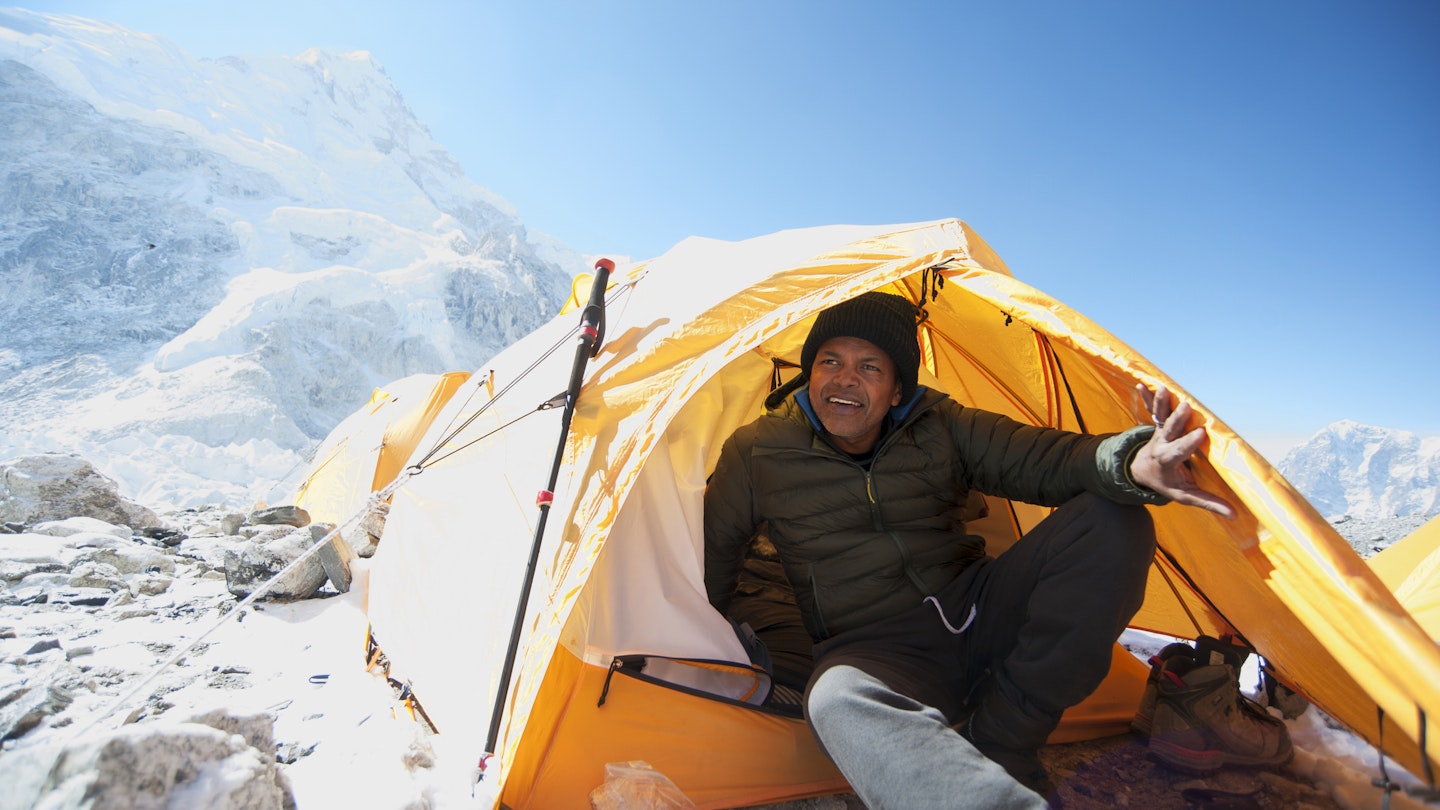
From permits to teahouses, here's everything you need to know about trekking to Everest Base Camp © Mint Images / Getty Images
Top of many people's travel bucket lists, the trek to Everest Base Camp is often the first thing people think about when they start dreaming of a trip to Nepal .
The walk takes trekkers past Sherpa villages and Tibetan-style monasteries, right up into the heart of the high Himalaya, into a breathtaking world (literally) of iconic glaciers, lakes and the tallest peaks on earth. It's probably the world's most famous trek.
But what is it actually like to trek to Base Camp? Is it something within your capabilities or budget? What should you bring? And, most importantly, can you get a proper coffee en route?
I just returned from trekking to Everest Base Camp for Lonely Planet's Nepal guide . Here’s what I think you need to know.
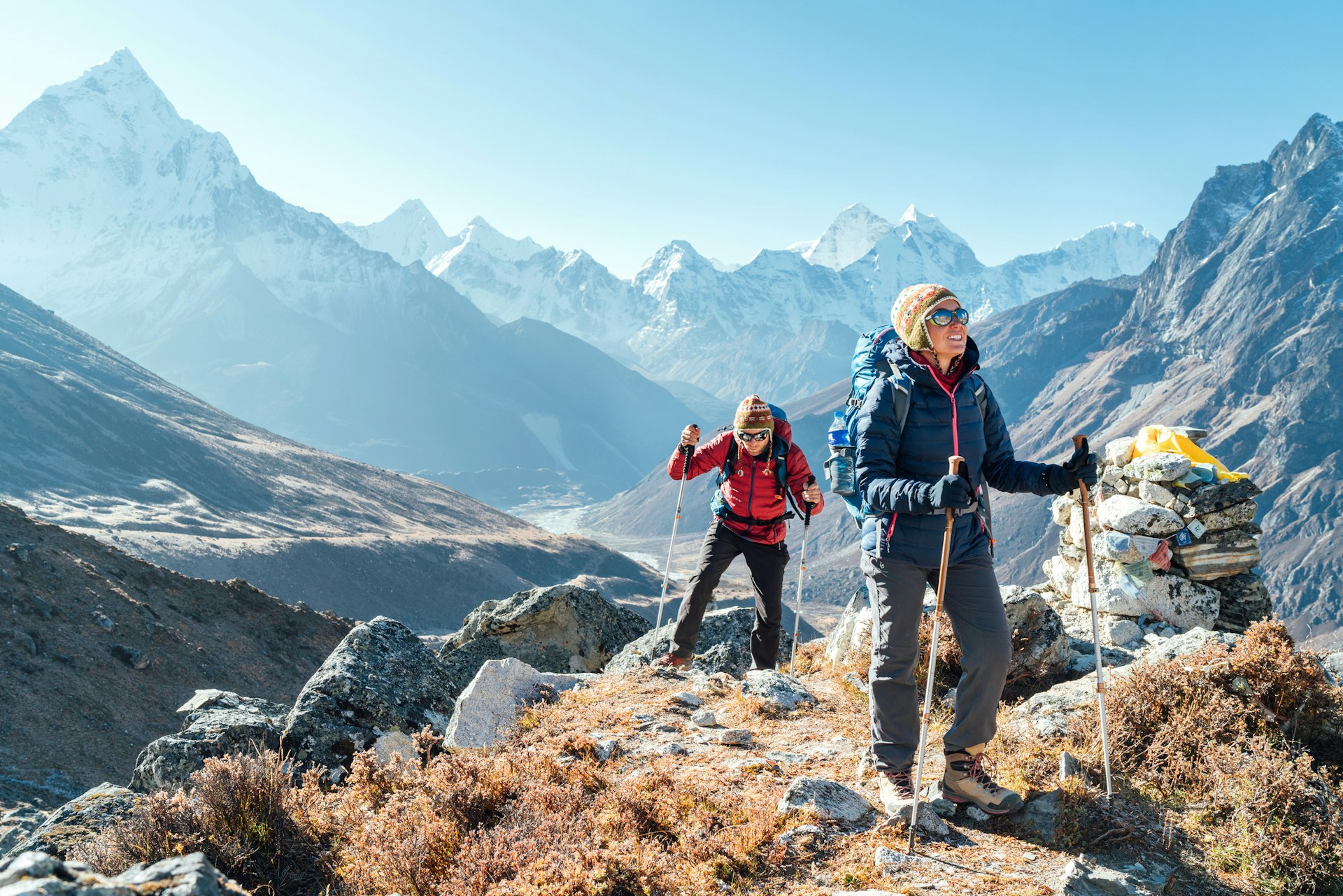
What's so great about the Everest Base Camp (EBC) trek anyway?
Firstly, the mountain scenery surrounding the world's highest peak is truly spectacular. The sublime views of Ama Dablam, Pumori, Nuptse and Thamserku peaks are unbeatable and constantly change as you progress along the walk. The Sherpa villages and monasteries are fascinating places to visit and the lodges (called teahouses) are the best in the world.
The knowledge that you are walking in the expedition footsteps of Hillary, Tenzing, Messner and others is a thrill. Anyone who has read Into Thin Air will be moved by the memorial stupas of Rob Hall, Scott Fischer and others who have lost their lives on the mountain. And then there's the fact that you will have reached the base of the world's highest peak; whether you call it Chomolongma (Tibetan), Sagarmatha (Nepali) or Everest, it’s a rush all the same.
And what’s not so great about the Everest Base Camp trek?
Well, if you force us to play devil's advocate… EBC is one of the busiest trails in Nepal. In the high season months of October and November you'll be walking with thousands of other trekkers, competing with them to get a bed, a lunch order or an airplane seat. There will be lines at checkpoints and even at moments on the trail itself. In bad weather you might be stranded at Lukla airport with hundreds of other trekkers, all trying to get on the first flight out. It's not quite the Zen-like wilderness experience you may have been imagining.
Bear in mind also that even after a solid week of walking, your view of Everest will be partial at best (for infinitely more dramatic Everest views visit the northern Everest Base Camp in Tibet ). If you trek outside of May's expedition weather window you won’t actually find much to see at Base Camp beyond a boulder hastily spray-painted with "Everest Base Camp".
If this has put you off, don’t worry; there are dozens of other fantastic treks in Nepal .
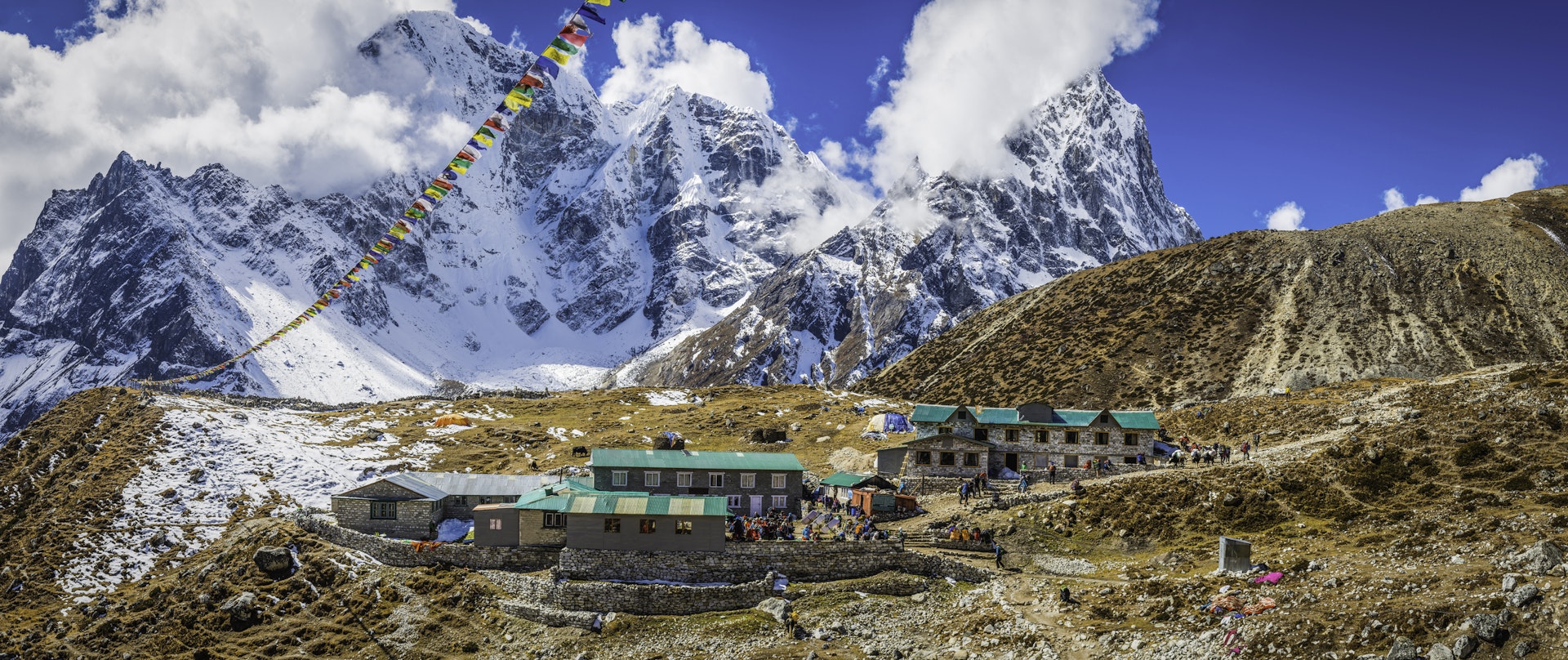
How long does it take to trek to Everest Base Camp?
The walk from the airport at Lukla to Everest Base Camp and back takes a minimum of 15 days. Several of the days are surprisingly short, but this is because you have to figure in time to acclimatize to the high altitudes.
If you can, it's definitely worth adding on a couple of extra days to this basic itinerary. Some of the most dramatic (and least visited) views are from detours off the main trail. I always add two days to visit Thame, two days to visit Chhukung and, if possible, three or four days to visit the lakes of the Gokyo Valley – probably the most beautiful scenery in the Everest region.
Be sure to also budget an extra day or two as a transport buffer. Weather-related flight delays in and out of Lukla are not uncommon (I had to wait six days for a flight to Lukla on my recent trip) so you need some buffer time if heading back for an international flight home.
How challenging is the trek to EBC?
In terms of physical effort, the EBC trek itself is not especially tough. There are only a couple of steep climbs, lasting about an hour each, and most days involve less than four hours of walking.
The thing that makes the EBC trek tough is the altitude. Base Camp is at 5600m (18,373ft) and you will need to spend one or two nights above 5000m (16,404ft). Above 4000m (13,123ft) you are going to feel increasingly lethargic and out of breath as the amount of oxygen in the air decreases. Combine this with the cold, the discomfort of being at altitude and the compounded tiredness from walking for two weeks straight, and you can see why the whole trek experience is definitely a physical challenge.
While you don't need to be an athlete to walk to EBC it is still a good idea to start a fitness regime in the weeks leading up to your trek. You'll enjoy the walk so much more if you are in decent shape.
When is the best time to trek to Everest Base Camp?
October and November bring the best weather and the clearest skies but these are also the most popular months. The second most popular season is April to early May, when spring blooms and expedition traffic bring extra interest to the trail. To avoid the crowds but still enjoy clear views, pack an extra thermal layer and come in December or March.
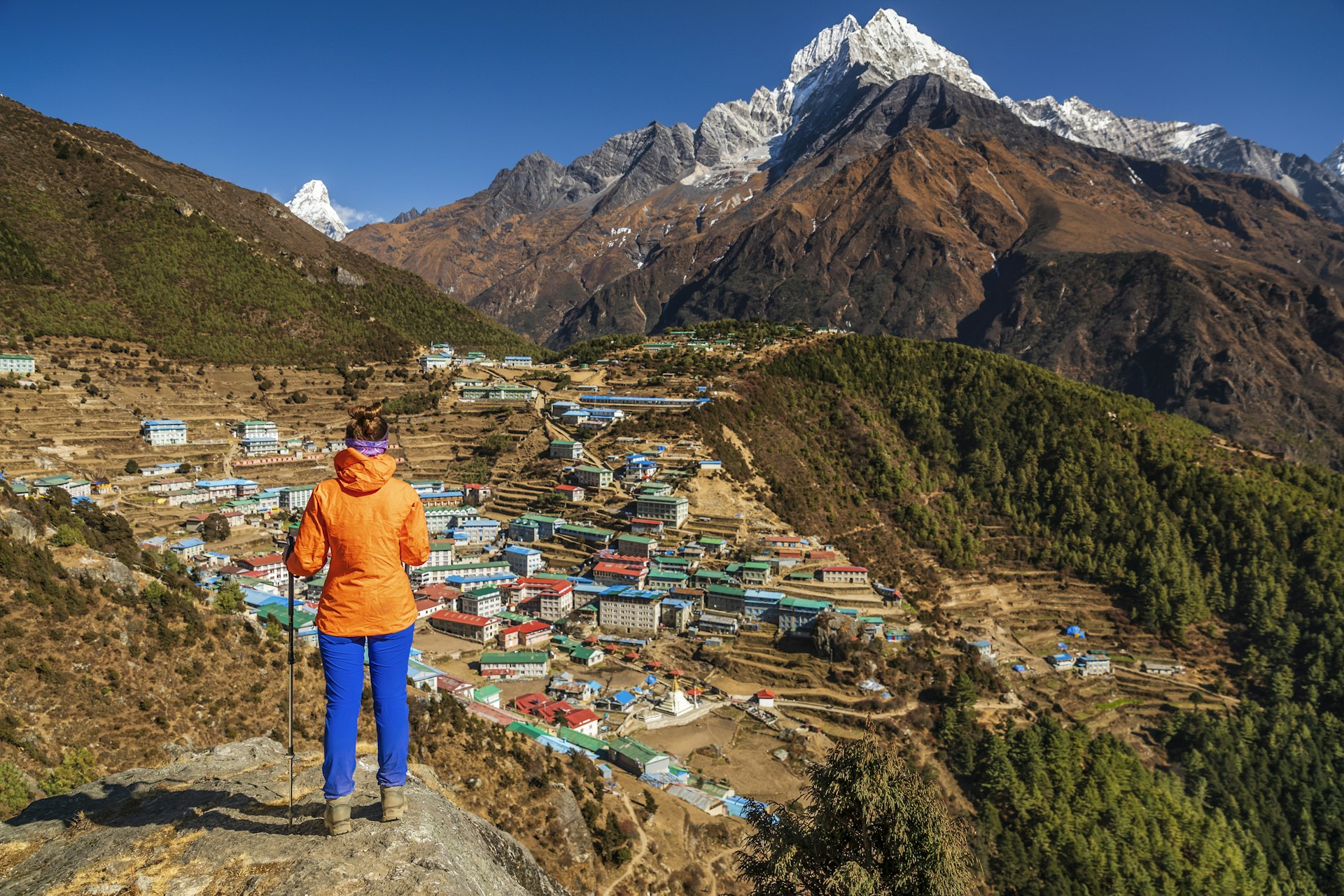
What can I do to avoid altitude sickness?
The majority of people who fail to reach Base Camp do so because they failed to acclimatize properly to the altitude. It's essential not to gain altitude too quickly by following the recommended overnight stops and limiting your daily altitude gain to a maximum of 400m (1312ft) when above 3000m (9843ft).
Be sure to add in acclimatization days at both Namche Bazaar and Dingboche, during which it's a good idea to hike to higher altitudes during the day, returning to sleep lower at night.
What are the teahouses like?
At lower altitudes the Everest lodges are the most comfortable in Nepal. Private rooms are the norm, many of which have private bathrooms. Showers are available at most places, though the hot water supply can be patchy. All have cozy dining rooms with tables arranged around a central dung-fueled stove. There are even a few luxury lodges along the trail.
In budget lodges, or when you get above Dingboche, things get simpler, with rooms offering little more than a collection of plywood walls, a solar light and a foam mattress. Toilets are a mixture of seats and squatters; sometimes outdoors, always freezing. A blanket is normally supplied but be sure to bring a four-season sleeping bag rated to well below 0°C (32°F).
What's the food like?
Menus in teahouses range from pasta and pizza to spring rolls, fried potatoes and soups, though the most popular meal is a daal bhaat , a set Nepali meal of rice, lentil soup and fried vegetables, normally served with a papad and pickle, and with a refill included. It's the most filling and environmentally sustainable meal you can order.
In villages such as Namche Bazaar and Dingboche you will also find bakery-cafes serving espresso and slices of delicious apple pie, plus shops selling everything from Snickers bars to bottles of beer. This is one trek where you might actually gain weight!
Can I get wi-fi or phone coverage?
Most lodges offer wi-fi, either free of charge or for a few dollars per day (at higher elevations). Above Namche Bazaar you will likely have to buy a scratch card, giving you unlimited data for twelve hours (AirCell) or a specific amount of data over a month (Everestlink). Depending on your network provider you'll likely get data and a phone signal at lower elevations, and possibly even at Everest Base Camp, but not at other high altitudes. So yes, in theory, you can Skype all your friends from Base Camp!
What should I bring?
Warm clothes are a must, and you should pack thermal underwear, a down jacket and fleece hat. Comfortable hiking boots and good, padded socks are also essential. Sun block, a sun hat with a brim and good sunglasses are important against the strong high-altitude light.
Morale-boosting snacks like chocolate and salami are always helpful, as is a book and smartphone with mapping software like Maps.me. Bring water purification of some sort. If you forget something, don’t worry, you can buy almost anything you might want in Namche Bazaar these days (from ice axes to cans of Pringles), though at prices higher than in Kathmandu .
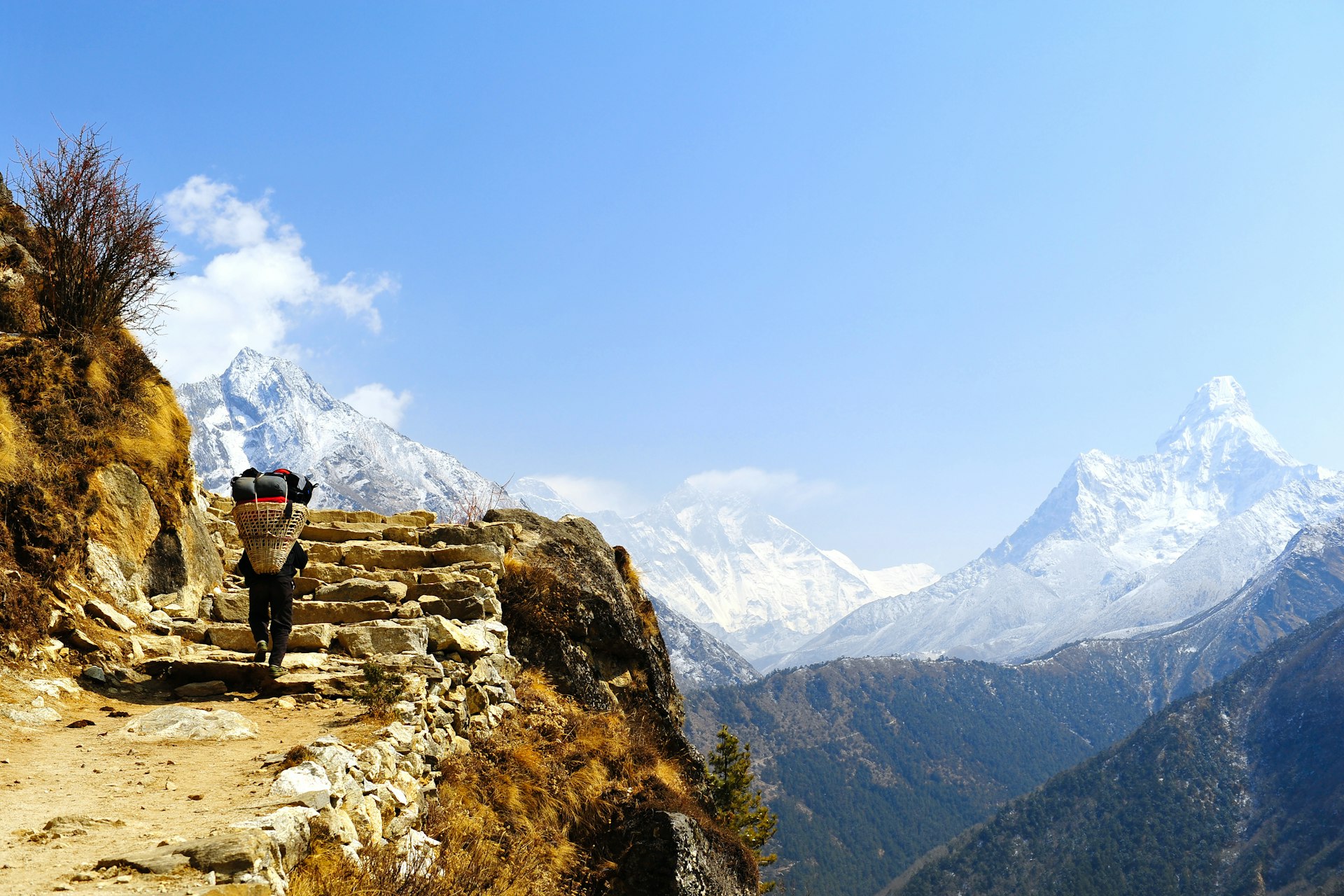
Do I need a porter and guide?
In terms of finding your way you don't need a guide if you are an experienced walker, as the route is clearly marked and well-trod. A guide can be useful for smoothing your way at teahouses, making sure you get your food on time and helping you pay your bill. It's important not to trek alone, so solo trekkers should find a companion or take a guide or porter.
A porter will carry a bag of around 15kg, freeing you up to pack a few extra chocolate bars and enjoy the walk with little more than a day pack. Not having the strain of carrying a full pack is worth its weight in gold for anyone over the age of 50. Trust me.
How much does the Everest Base Camp trek cost?
For a room in a lodge and three meals a day, figure on US$20–25 per person per day, a bit more if you want a room with a private bathroom and the occasional slice of apple pie. Add on another US$5 every time you want a shower. Figure on an additional US$20 per day for a porter, and US$25–30 for a guide, and budget 10–15% of that fee for an end-of-trip tip.
You'll pay a bit more to have a Kathmandu-based trekking company arrange your entire trek, and a lot more for the convenience and backup of an international trekking tour.
Do I need any permits?
You will need to buy an Everest region permit (US$20) at Lukla, as well as a Sagarmatha National Park entry ticket (US$30) at Monjo. Currently that's all you need.
How can I trek more sustainably?
With 60,000 trekkers and guides headed to the Everest region, it’s important to minimize your impact on the region. Firstly, don't buy bottled water on the trek, as the bottles are nonrecyclable and are a huge problem throughout the region. Bring a system of water purification, like a Lifestraw or Sawyer filter, a Steripen or chemical purification.
Secondly, carry all your trash out (especially batteries), and sign up for the Carry Me Back program, whereby you carry a 1kg bag of trash from Namche Bazaar to Lukla, for it to be recycled in Kathmandu.
Finally, be polite to the Sherpas and porters you meet en route, as well as your fellow trekkers. Walk clockwise around stupas and be respectful at monasteries and shrines.
How do I get to Lukla to start the trek?
Flights run multiple times daily between Kathmandu and Lukla, taking around 30 minutes. During high season however you may have to drive five hours from Kathmandu to Ramechhap airport to catch your Lukla flight there.
It's also possible to fly or drive to Phaplu and walk two days to Lukla from there, or walk from Shivalaya to Lukla in seven days as an excellent pre-trek warm-up.
This article was first published Jan 14, 2013 and updated Jun 20, 2023.
Explore related stories
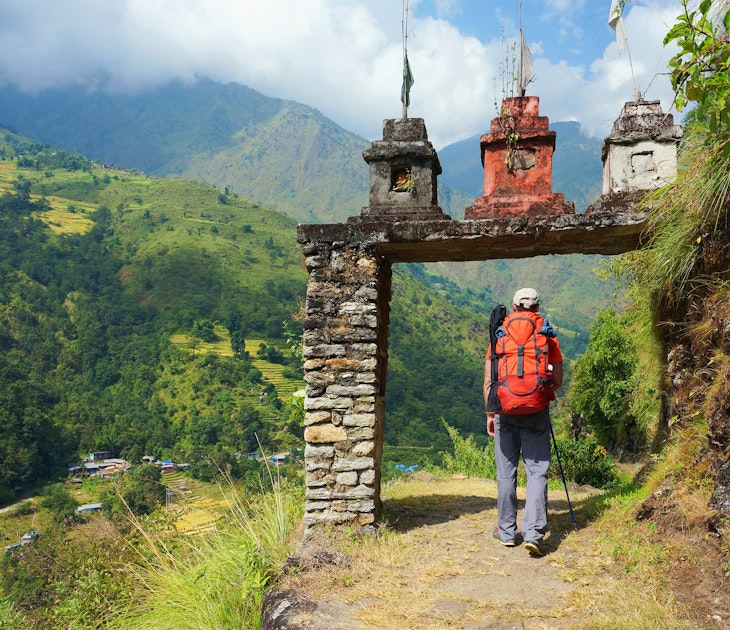
Mar 14, 2023 • 4 min read
To reduce accidents and promote jobs, Nepalese authorities recently announced a ban on solo trekking in national parks and conservation areas.

Jul 13, 2022 • 8 min read

Jan 31, 2022 • 6 min read
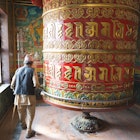
Jan 9, 2022 • 8 min read

Sep 14, 2021 • 11 min read

Jan 28, 2021 • 5 min read
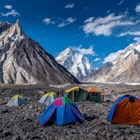
Jan 12, 2021 • 7 min read
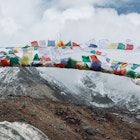
Dec 10, 2020 • 6 min read
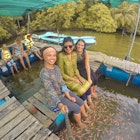
Jan 7, 2020 • 6 min read
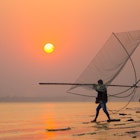
Oct 10, 2019 • 9 min read

Planning your Everest Base Camp Trek: The Ultimate Logistics Guide
The most common questions about an Everest Base Camp trek answered! Learn about guided vs independent, altitude sickness, transportation, gear & logistics.

An Everest Base Camp trek offers the perfect trifecta as far as adventure travel goes. Big mountains, incredible culture, and for most people, a decent physical challenge that leaves you feeling proud and in better shape than when you started.
There are two ways to go about your trek to Everest Base Camp: Independent or Guided, and both options offer their pros and cons. Everest Base Camp trek planning can be a lot of work – from permits, accommodations, transportation, and more – there are a lot of logistics to consider before and during your trek.
I chose to do my Everest Base Camp Trek with the guiding company Anywhere Plus, and I was joined by 8 other Bearfoot Theory readers on this 11-day adventure. At the end of the trip, every person in our group agreed that it was one of the best trips any of us had ever been on – both due to the country and how well our trip was organized.
In this detailed post, I’ll tell you what to expect on your Everest Base Camp trek.
Independent vs Guided Everest Base Camp Trek
Going with a guided group tour provided the opportunity to get to know an incredible group of like-minded outdoor adventurers..
The first big decision you need to make is whether you will do the Everest Base Camp trek on your own or as part of a guided group. An independent Everest Base Camp trek will be cheaper, no doubt, but you’ll also be left to handle all of your accommodations, trekking permits, domestic flights, and logistics yourself. If you are a budget backpacker looking to save money, a very experienced traveler, or someone with a lot of vacation time, an independent Everest Base Camp trek might be a good option, with some caveats which I’ll address throughout the post.
If you are going on your own, I’d build a few extra days into your itinerary at the beginning of your trip in Kathmandu so you get all of your gear, flights, and other logistics dialed. I’d also recommend having a little cushion with your schedule on the trek itself in case you run into any problems (altitude sickness, stomach issues, transportation delays, etc).
On the other side of the spectrum, a guided Everest Base Camp trek can cost 3 times more….but is it worth it? There’s a couple of questions you have to ask. How much time do you have in Nepal? How much decision-making do you want to do? Are you solo? Do you want to hike back down or helicopter out? Do you know how to deal with altitude sickness? How much cultural interaction do you want to have? Simply put, having the RIGHT guide puts the stress of planning on someone else so you can focus on enjoying the trek and staying healthy.
Here is Jangbu, one of our incredible guide assistants, teaching me how to pack a yak correctly.
Did you notice that little word up there? The RIGHT guide? The quality of Everest Base Camp guides varies from porters who will carry your bags to full-blown guiding services. And even between the professional companies, there are differences in what they offer. When deciding on a guiding company for your Everest Base Camp trek, make sure you pay attention to the fine print about what’s included and what is not.
Our trip with Anywhere Plus was 100% all-inclusive. And that meant everything. ALL food and drinks in Kathmandu and on the trek, water, lodging, porters, assistant guides, cultural experiences, in-country flights, tips, and a helicopter flight down from Base Camp – this was all included. Every person on the trip was also hooked up with an Anywhere Plus duffel bag which was used to carry our stuff, a warm down jacket and fleece that we got to take home at the end of the trip, baby wipes, hand sanitizer, prayer flags, and a few other essentials for the trek. I admit, it was pretty luxurious as far as an Everest Base Camp trek goes, and the best part was knowing we were in good hands and that we didn’t have to worry about a thing. A final perk I’ll mention. Our guide Karl was a professional photographer and was taking photos of us all throughout the trip. That meant we could be more in the moment and less focused on our cameras. At the end of the trip, everyone received a USB stick with all of the photos, as well as an awesome photo book featuring the best shots from our trip. All of this made it worth every penny, and I’d do another trip with Anywhere Plus in a heartbeat.
Karl knew exactly where to get the best photos to create forever memories of our trek.
Typical everest base camp trek itinerary.
The total hiking distance if you hike straight from Lukla (the starting point) to Everest Base Camp is only 45 miles, but over the course of the trail you gain about 8,200 feet – going from 9,400 feet to 17,500 feet. In order to give yourself time to acclimate to the increasing altitude, most people take anywhere from 9-12 days to hike up to Everest Base Camp, plus another 3-4 back down to Lukla.
We spent a total of 11 days hiking from Lukla to Everest Base Camp. This gave us time to acclimatize and also enjoy our days on the trail without feeling too rushed.
Our guide Karl built in acclimatization days for us in Namche Bazaar & Dingboche. In each of these villages, we did a steep day hike and returned to our Everest Base Camp at night, allowing us more time to get used to the increasing altitude.
Happy and excited to have another acclimatization hike successfully completed!
We reached Everest Base Camp on the 10th morning. Then that afternoon, we trekked to the summit of a nearby peak called Kala Patthar to watch the sunset on Mount Everest on our final evening.
On the 11th morning, rather than starting to hike back down, we hopped on a short helicopter flight all the way back to Lukla. This was included in our trip price, and it was awesome to get an aerial view of the entire trail and all of the ground we covered the previous 10 days.
Our full Everest Base Camp itinerary can be seen here , and I’ve also started posting a series of daily vlogs on my YouTube channel:
The Best Time to Visit Everest Base Camp
The best time to visit Everest Base Camp is March through May or late-September through November. These two seasons are the driest and typically experience clear mornings and cloudy afternoons.
The Spring season is when Everest Base Camp is full of climbers attempting to summit Everest. If you are interested in crossing paths with climbers and feeling the buzz in Base Camp, this is a great time to go.
In the fall, Base Camp is empty except for trekkers reaching their final destination. During our October trip, we got very comfortable weather with warm sunny mornings, cloudy afternoons, and chilly nights.
Both spring and fall are popular, so be prepared to share the trail with other trekkers, locals, yak trains, and porters. It’s all part of the experience.
The monsoon season is June through early September and is the worst time to visit Everest Base Camp. During monsoon season, services are more limited and there’s a chance you might not get to see those beautiful Himalayan peaks.
It’s a neat opportunity to see a Yak train on the trail! Not something you see on trails in the States!
Getting to and from the trail.

I heard all kinds of stories before our Everest Base Camp trek about how scary the flight into Lukla is. The airport has been referred to as the “World’s Most Dangerous Airport” due to the fact that there is a sheer mountain face at the end of the runway.
We lucked out and got perfect weather on the way to Lukla, and our small little plane and experienced pilots handled the flight with no problems. If you are nervous, just remember, these pilots do this day in and day out and they don’t want to crash anymore than you do.
At the time of writing, tickets online were priced at $150 each way per person. On our Anywhere Plus trip, all of the flights and transportation to the airport were arranged and included. When we got to the airport, things were a little hectic, but they helped us get checked in pretty quick. Also keep in mind that there is a standard weight limit of 10kg per person for checked bags, so depending on your guide and airline, you should be prepared to pay overage fees if your bag exceeds this limit.
We flew on the first Tara Air flight on the first flight of the day, which I’d recommend. Mornings tend to be more clear, and even if there were any weather delays, our group would have the highest likelihood of departure. I’d also suggest sitting on the left side of the plane for the best views on the way to Lukla.
Don’t forget–insider tip–the left side of the plane will gift you with the better views on the way to Lukla.
The other thing to keep in mind is how you are going to get from Everest Base Camp back down to Lukla. A majority of people walk, and you should budget about 3-4 solid days for that. The other option is to fly on a helicopter like we did.
Our Anywhere Plus Everest Base Camp Trek included a return helicopter flight.
Everest base camp trail conditions and difficulty.
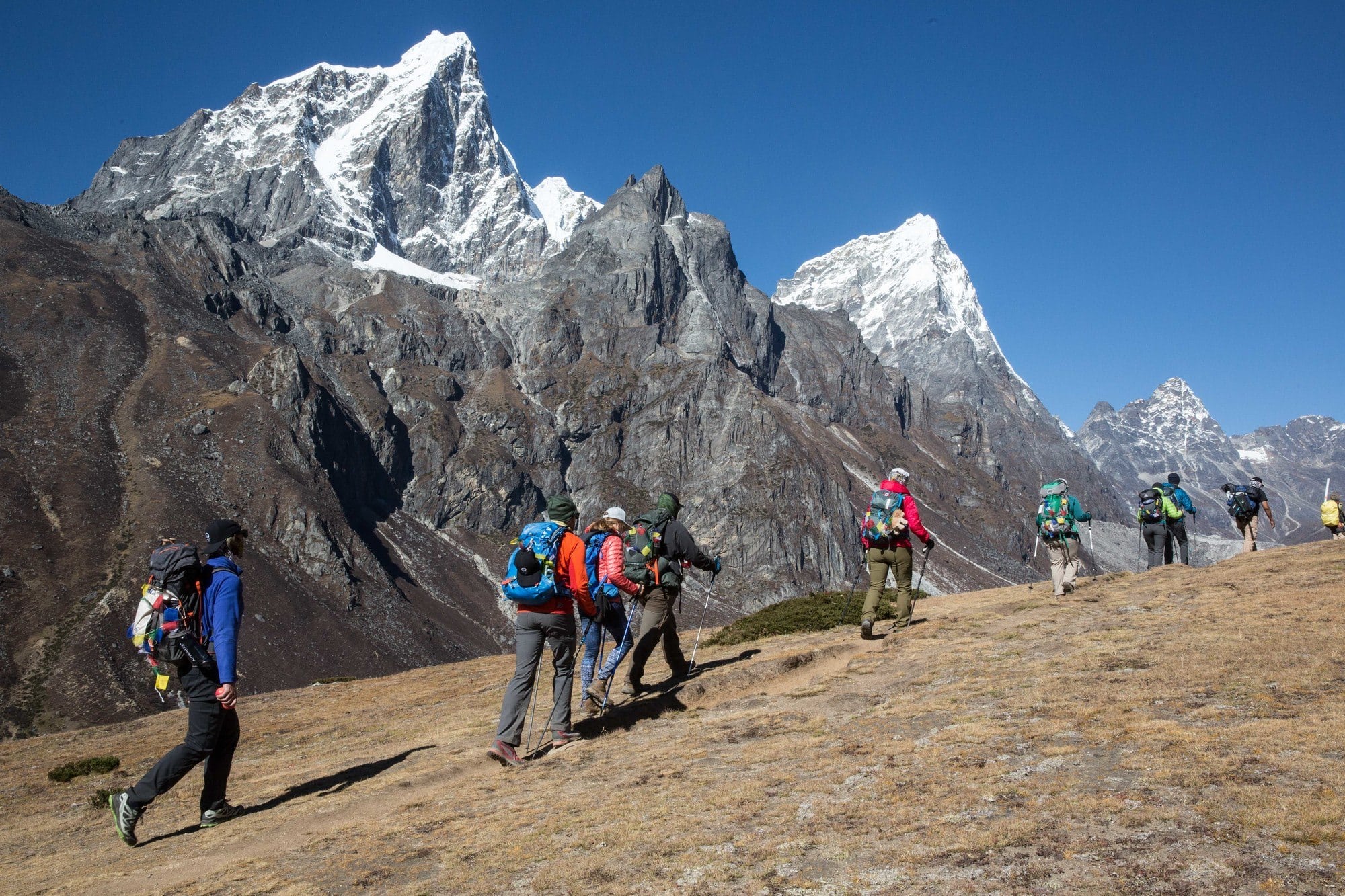
I wasn’t sure what to expect as far as trail conditions on the way to Everest Base Camp, but what we found was a super well-maintained trail that was in excellent condition. Some sections were obviously steep, but most of the trail consisted of a well-defined dirt path without too many obstacles. The suspension bridges also seemed to be in good condition, able to support the weight of fully loaded yaks.
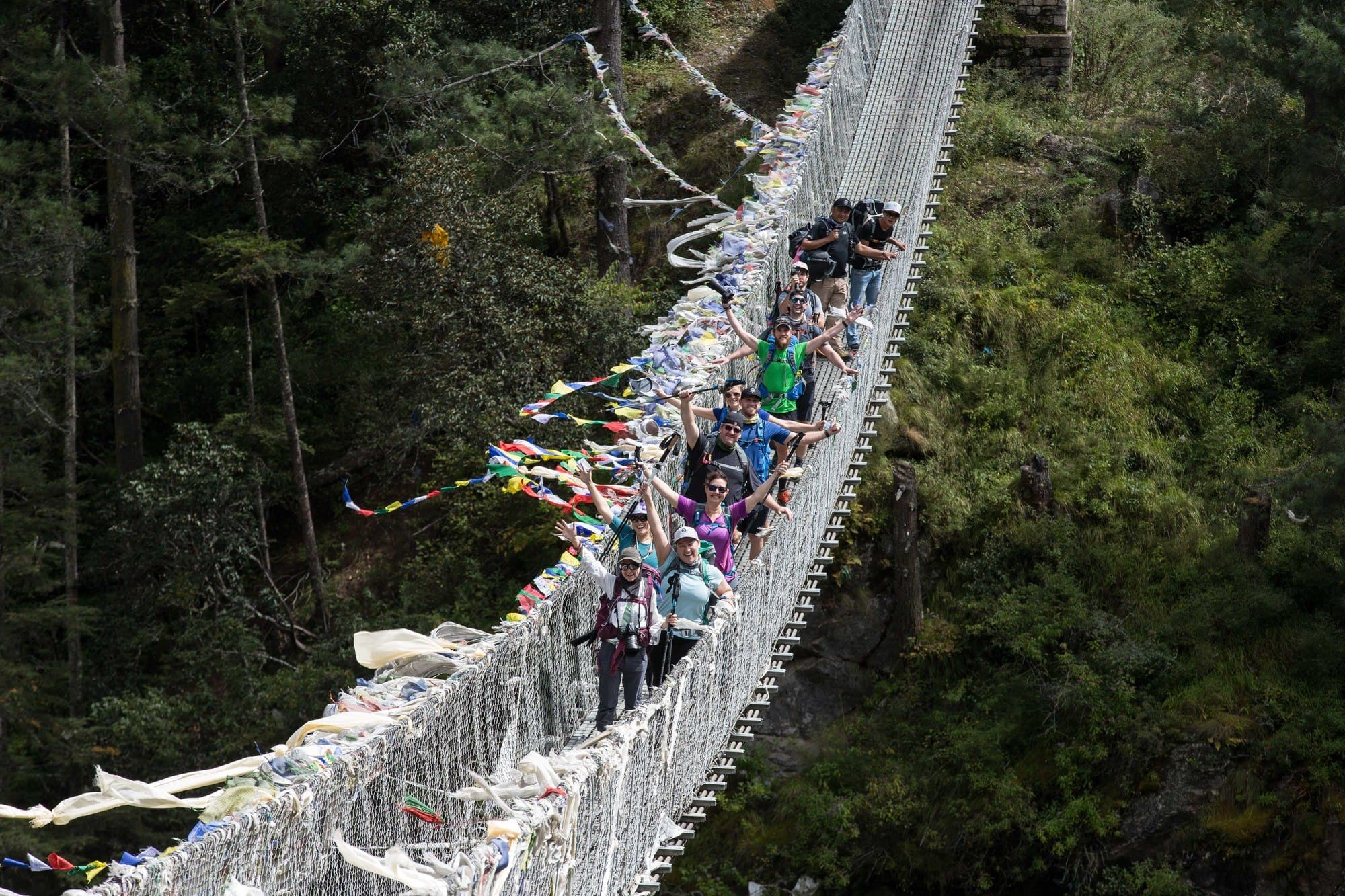
The scenery was constantly changing which kept things interesting. The beginning of the trail in Lukla was lush and green with all kinds of waterfalls, and everyday the landscape got a little more drastic until we were eventually above the treeline.
The only section that was a bit more difficult as far as terrain was the final stretch down into Everest Base Camp. This section had some boulders to hop over and once on the glacier you had to be careful as some parts were pretty slippery.
Everest Base Camp Trekking Permits
There are two different permits you need to trek to Everest Base Camp.
The first is a Trekkers Information Management System (TIMS) permit. This costs $10 USD if you are part of a group or $20 USD if you are trekking independently. You also need 2 passport photos. Our Anywhere Plus guide obtained these for us in advance of the trek. If you are on your own, you’ll need to go to the Nepal Tourism Board office near Thamel in Kathmandu prior to your flight to Lukla.
The second permit is Sagarmatha National Park Entry Permit which can be obtained once you are on the trail at the office in Monjo. This costs $30 USD+ 13% Govt. Tax.
Food & Water on your Everest Base Camp Trek
Little villages are spread all along the trail with plenty of places to stop and eat or have some tea, and all of the lodges we stayed in served breakfast, lunch, and dinner. Breakfast usually consisted of hot porridge or eggs, potatoes, and toast, while lunch and dinner menus varied between lodges. Typically lunch and dinner items included Nepalese stew, fried noodles, fried rice, and dal baht (the local Sherpa meal consisting of lentil soup, rice, and veggies).
It doesn’t get much better than having breakfast with a view of Mt. Everest!
Something important to remember is that all of the meat has to be hiked in from Lukla and refrigeration is limited. For that reason, we steered clear of all meat after we left Namche Bazaar, and I’d recommend you do so too. Also, anything with cheese or butter is going to be the local yak version. I myself wasn’t a fan due to it’s strong flavor.
If you are trekking independently or your food isn’t included in the price of your trek, expect to pay somewhere between $4-7 for a simple meal, and that price goes up the further along the trail you get.
All tea and coffee is safe to drink since it’s made with boiling water, but all other drinking water needs to be filtered. I’d also avoid brushing your teeth with any kind of tap water, especially in Kathmandu. Bottled water is available on the trail, but it’s expensive and unsustainable since they don’t have a way to recycle or properly dispose of the plastic on the trail.
Instead of purchasing copious water on the trail (which you need to drink to stay hydrated), our Anywhere Plus guide Karl brought a couple of SteriPens, which use UV rays to kill viruses and bacteria in water. Every morning and evening we’d have a big water filtering session where we’d all fill up, and it was a great way to provide free and safe drinking water for a large group. I will note that many of the other guided trips do not include drinking water, so if you choose another company, you should check as to whether you should bring your own SteriPen and/or iodine tablets. For more information on the best water filters for backpacking check out our guide on how to select the best water filte r for your next adventure.
Here is a glimpse of the little village of Namche.
Accommodations on the everest base camp trek.
There are a variety of accommodations along the Everest Base Camp Trail, and our trek included private rooms at the nicest lodges available in each village.
At the beginning, our accommodations (like our rooms in Namche shown in the picture below) typically came with in-room showers, western-style flush toilets, heating blankets, and in-room outlets to charge our stuff. Towards the end, things got more simple – meaning no heat, no outlets, and squat toilets down the hall. Given the rural nature of the trail, this is the best they have. After day 5, we also didn’t have in-room showers. At some of the lodges, there were hot showers available down the hall, but it was very cold outside and there is no way long hair would dry in that climate. So all of us were sans-showers for the second half of the trek.
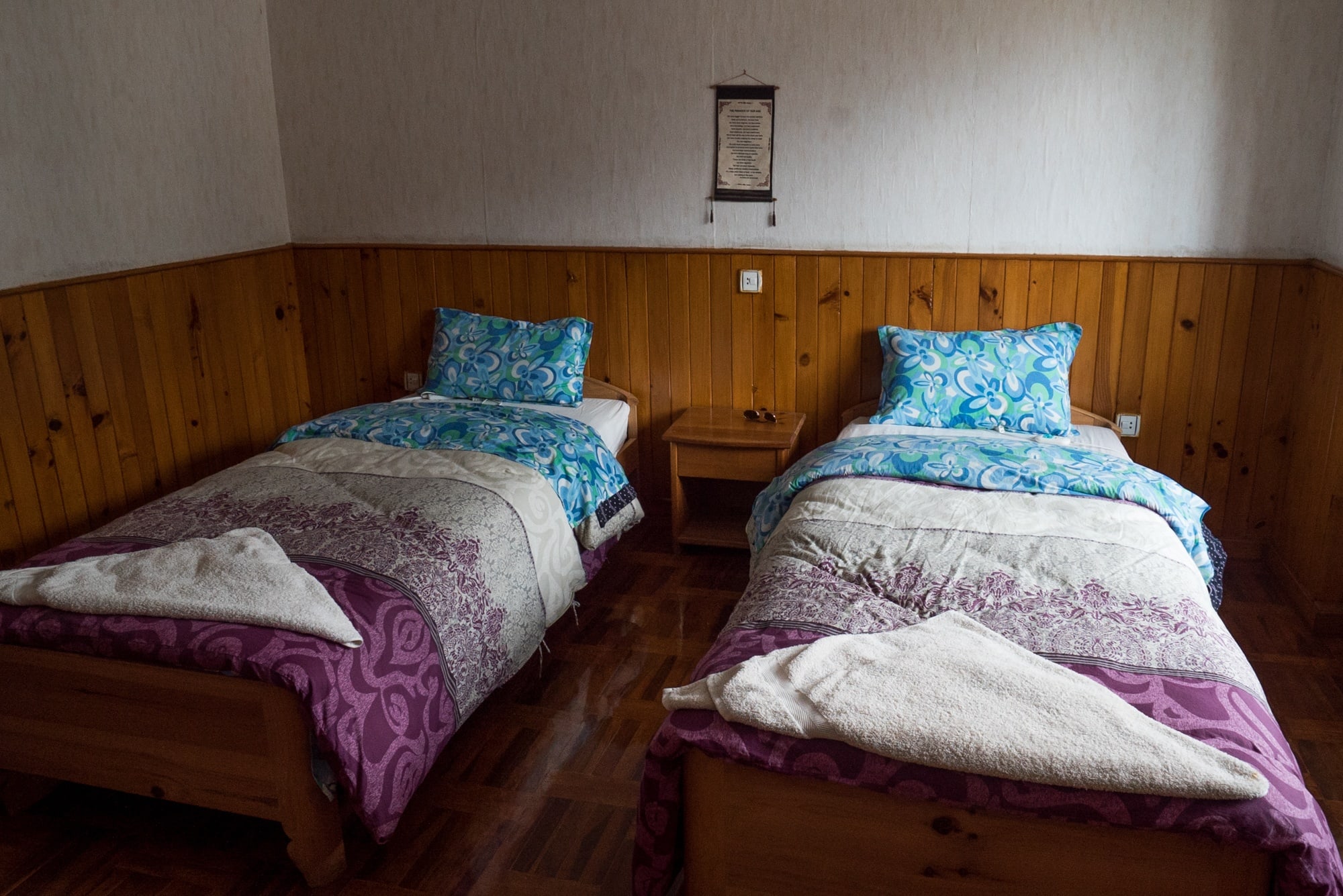
While the accommodations weren’t the highlight, everyone in the group was content. After all, the hotels weren’t why we were there. I’d suggest bringing some warm sleeping clothes, ear plugs, and a positive attitude, and you’ll be just fine. That said, it’s not for everyone, and if this description of the accommodations sounds awful to you, than perhaps the Everest Base Camp Trek isn’t a good fit for you.
Wi-fi & Electricity on the Everest Base Camp Trek
I was surprised at the availability of wi-fi on the trail. Our trip with Anywhere Plus included wi-fi at all of the lodges as well as local N-cell SIM cards for those of us who had unlocked phones. This provided 3G on our phones wherever there was service along the trek as well as plenty of minutes to call home.
For those who are hiking independently or don’t have wi-fi included on their trip, most of the lodges offered wi-fi for a fee, although speed was variable especially towards the end of the trek. It was fast enough in most places to upload photos to Facebook or write emails from our phones. Videos and Snapchat, however, were pretty slow to load, if they loaded at all. For that reason, I’d leave the laptop at home since it will only add to your weight and give you something extra to worry about.
For your electronics, you’ll want to consider bringing a solar panel, battery packs and spare camera batteries. You’ll only have electricity in your room and outlets to charge your personal electronics for the first few days. After that, you’ll have to pay to charge things at the lodges.
Staying Healthy & Avoiding Altitude Sickness on your Everest Base Camp Trek
The biggest safety concern during your trek to Everest Base Camp is altitude sickness, and there are a number of measures you can take to minimize the chances of getting it.
First, you need to plan an itinerary that allows you to increase your elevation gradually. Second, you need to stay hydrated. This means you should have water available to drink at all times (I used a CamelBak), and you should avoid alcohol in the evenings at the lodges. Third, you’ll want to keep your immune system strong by dressing warm, consuming enough calories, and taking vitamins. I brought some Emergen-C vitamin packets and put one in my water every morning at breakfast.
Taking care of yourself and listening to your body is super important while on your trek!
That said, altitude sickness is unpredictable, and even the fittest of people can suffer from it. If it hits you, it can result in nausea, dizziness, vomiting, and headache, and if you don’t stop and address it, altitude sickness can be life threatening.
If you are on a guided trek to Everest Base Camp, your itinerary will include a couple of acclimatization days where you hike up and return to the same lodge that afternoon. Incorporating these acclimatization days into to the overall trek will increase the likelihood that everyone will be successful in making it to Base Camp. If you are doing the trek independent of a guide, you will want to do the research beforehand and incorporate some acclimatization hikes into your plan.
In the case that you are struck with a case of altitude sickness on the trail, a properly trained and professional guide will have a backup plan. That may include administering Diamox, a medication used to treat altitude sickness, or having you stay back with an assistant guide and catch up when you are feeling better either on foot or by horse. In the worst case scenario, a guide can arrange for helicopter transport back to your starting point or a hospital if necessary. Guides also have ways to communicate in the case of an emergency. I’m not saying these things to scare you, but if you end up doing the trek independently, you’ll want to be prepared for these scenarios.
Diarrhea is a common ailment for travelers in Nepal, and the other key to staying healthy on the trail is to keep your hands clean. This means carrying hand sanitizer on you at all times. I used it religiously throughout the trip – after going to the bathroom, before eating anything, after shaking hands with people – and I never had any stomach issues throughout the trip. It’s not fail-safe, but the more careful you are about germs the better chances you have of avoiding diarrhea.
Gear for your Everest Base Camp trek ••
I wrote up my entire packing list for my Everest Base Camp Trek. You can check it out in this post or by watching the video below:
Experiencing the Culture on your Everest Base Camp Trek
Experiencing the local culture was one of the things that made the trek to Everest Base Camp so special. I can’t speak for other guiding companies, but on our Anywhere Plus tour, we had the opportunity to interact with a bunch of local families. Our guide Karl has been on two Everest climbing expeditions, and during that time he built a lot of relationships in the region. Both of our assistant guides – Nara and Jangbu – were from Nepal. They spoke excellent English and were an incredible source of knowledge about the Himalayan culture and region.
Nara was from Bigu Village and part of our trip costs were donated to his community which is still recovering from the devastating earthquake. Nara was a constant source of positive energy throughout the entire trip.
Here is Nara, one of our assistant guides, in front of one of our hotels.
Jangbu, the other assistant, was a 19 year old Sherpa who summited Everest for the first time last year. Our trip also provided support to further Jangbu’s education so he can obtain a trekking guide license. On day 5, we had the chance to visit Jangbu’s home. His dad taught us how to load up the yaks and his mom invited us into their home for a traditional Sherpa meal of potato pancakes and dal baht. Then Jangbu took us to meet with his local Lama – Lama Geshe – who blessed our prayer flags and anything else we brought with us. The day was one of the stand-out experiences of the trip, and it wouldn’t have been possible without our guide Karl.
This is Jangbu with his mom and dad after our incredible lunch in their home.
Getting blessed by lama geshe in jangbu’s village.
I hope this Everest Base Camp guide gives you a better idea of what to expect & how to plan for your Everest Base Camp Trek. Whether you are going on your own or as part of a group, you are in for a spectacular experience. Again, a huge thanks to Karl and the Anywhere Plus team for making our trip so incredibly memorable, and if you have any questions about planning your Everest Base Camp Trek, get in touch!

With two decades of hiking and seven years of van life under her belt, Kristen has dedicated her life to helping people experience the positive effects of nature. As a pioneer in the outdoor blogging space, she founded Bearfoot Theory in 2014 and has since authored more than 350 blog posts about outdoor travel, hiking, camping, and van life. Her work has been featured in National Geographic, Outside Magazine, and Backpacker, and when she’s not on the road, she lives in Park City, Utah with her partner Ryan, their son, and two adventure pups.
Leave a Reply Cancel reply
Your email address will not be published. Required fields are marked *
Save my name, email, and website in this browser for the next time I comment.
13 Comments
Excluding flights/supplies what would you say the trek with the guide ended up costing you? Thanks so much!
Our trip was $4500 per person, all inclusive.
Hi Kristen. A very informative blog thanks as I plan for an EBC trek in November with 4 other women. 3 of us kiwis. I was interested about hair washing practicalities to which you briefly refer. I have very long thick wavy hair. Not really sure what to do with it. It takes long enough to wash and condition as it is. Sounds pathetic to worry about it! Can you give me a clearer picture as many of your group seemed to have long hair too as to how you all coped. Many thanks! Karen
Do you recommend this for those who don’t get to hike as often as you? I’d like to work my way up to this trip, but I’m not sure how I’d do since I don’t get to hike as often as I’d like.
There were people on our trip who didn’t hike all that frequently who made it, but the more you can train beforehand the better. The altitude is the biggest factor and the better shape your lungs are in, the more you’ll enjoy the hike.
Took a detour to village of Thame from Namche Bazaar, also joined the trail to Tengboche via Namche- Khumjung- Phortse. Such peaceful little villages! Experienced best of nature and wildlife through these trails (colorful rhododendron forests, saw musk deer and Himalayan Tahr up close). Was amazing!
It always have a great feeling being on you blog! You are awesome traveler.
Better alternate route to EBC replacing the run-of-the-mill Tengpoche trail.
It seems to be the best kept secret in Khumbu that there is a much better scenic route opposite side of Tengpoche offering just amazing views across the valley. All trekkers doing only EBC (no Gokyo, that is) should go up this way, and visit Tengpoche on the way down. Thus the itinerary on the way up should be Lukla – Monjo – Namche (2) – Mong La (lunch) – Phortse – Pangpoche (lunch) – Dingpoche (2) – Lobuche – etc.
Even better is one where the first night in DIngpoche is replaced by a visit and overnight at Ama Dablam Base Camp, or actually Mingbo Lodge few hundred meters south from there. As the lodge is at the same altitude as DIngpoche (4300m). Thus the ultimate itinerary is Lukla – Monjo – Namche (2) – Mong La (lunch) – Phortse – Pangpoche (lunch) – ADBC – Pangpoche/Shomare (lunch) – Dingpoche – Lobuche – Kala Pattar, and back via Tengpoche.
Your description gives just two options, independent or guided group with fixed itinerary. There is also a happy medium: private guide or rather a porter-guide (who also carries your pack). You are in total control of the trek and itinerary, P/G is there to help and consult only, not boss you around. Many trekkers have the mistaken idea that hiring a guide would give your independence away. It does not, unless you let it happen. P/G can carry for two people. You can also form your own group with friends and be in total control, telling which routes to take, where to sleep. Of course this means you have to understand the conditions, acclimatisation etc.
Very useful information. Walking on the lap of the Great Himalayas with the crystal clear view of majestic mountains just in front of your eyes is possible only in the Everest Region. Everest base camp trek is the most awe-inspiring popular trekking trail of Nepal in the world.
A few comments specifically about EBC (FYI my daughter and I did Cho La Pass and EBC self guided). I would add in your blog if you’re objective is the experience the Himalayas (and to see Everest) I would discourage EBC and instead consider other routes that give a more private and less traveled experience (and all the guide rules above are still there) Your picture isn’t even Everest but Ama Dublam (the prettiest of the peak inclusive of Lhotse and Everest that you see between Lukla and EBC). I would also mention getting Diamox aka Acetazolamiide script prior to going to help abate any issues with altitude sickness its an easy hedge and significantly reduces altitude sickness and pulmonary edema) . I would also mention how much foot traffic there is between Lukla and EBC, even outside climbing season its constant groups and all full service groups count a porter/2 people and guide for every 6 porters. So if for example there happen to be a group of 20 trekkers, with 10 porters, on 3 guides well the numbers get big fast. They all are following same protocol, acclimation day hike in Namche Bazaar, and the Ama Dablam photo day hike from the monastery. This means ALL trekkers/their companies/and Inividuals w/ or w/o a guide/porter-guide (note: Porter Guides do NOT have to speak English like guides must….and it’s licensed) are sleeping in the same limited locations. I have recommended to several friends to climb Gokyo Ri up the Cho La valley (you still go through Namche Bazaar) you get views Ama Dablam (obviously not as close as the Tengboche vantage point in your picture) Gokyo Ri is just as high as Kala Pathar, and you see 1/10 maybe more of the trekking population. To be clear I’m not ragging on EBC, I get it, but I guarantee you anyone who reads this blog and is looking to roll their own or hire guide or porter-guide does NOT want to be people dodging on the trail because you move faster than the group of 40 in front of you, nor do they want to feel like their in a hotel lobby when the groups start rolling for dinner.
On a separate note I applaud you and your teams ambition/life-style. I actually look forward to seeing/reading more.
Hi Gary, thanks for reading & sharing your EBC experience! This was a group trip we did back in 2017, and I know things have changed (and gotten busier) since. Appreciate your insight that could help others decide how they plan their trip.
Thanks for posting useful information about the everest base camp trekking. I read your complete blog and got i lot of information for my future trek plans. I really got to know about some interesting facts which I was not aware of. I have also got some useful insights from ExpedReview as well.
Thanks for posting wonderful content. Keep posting such types of blogs.

- Everest Base Camp Trek: A Comprehensive Guide
- Mount Kilimanjaro
- Apr 16, 2024 Apr 16, 2024
- TranquilKilimanjaro
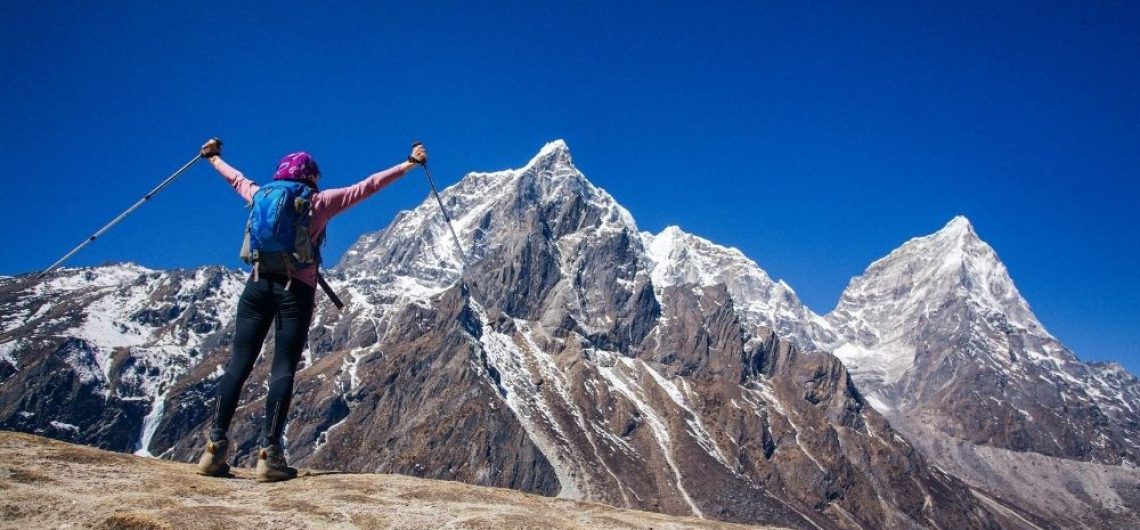
The best seasons for the Everest Base Camp trek are pre-monsoon in March through May and post-monsoon from late September to early December. During these times, the temperature is mild and the sky is generally clear. However, the Khumbu is lovely all year round. Ever-changing Himalayan weather is always a factor to consider when booking a trek. Cancellation of flights into Lukla is a common problem during the winter seasons. During winter, the Khumbu is very cold and the higher regions can be prone to heavy snowfall. It can also get very hot during the summer months; there is a higher chance of monsoon rain and the trails can become unwalkable due to landslides. Always check the Lukla flight status if trekking to the region in unfavorable weather.
The Everest Base Camp trek is one of the most famous trekking adventures in the world. Traveling through the villages and high mountainous regions of Nepal offers a glimpse of life experienced by the local people in their quaint villages. There are two options for reaching Everest Base Camp: the first is a high altitude trek that ascends to EBC, the second is to fly into Lukla airstrip and trek up the Khumbu valley. The trek from Lukla is a more gradual ascent, which is fine for those not wishing to ascend to higher altitudes too quickly. The fastest means is to fly into Gorak Shep, allowing you to ascend to Base Camp the very same day. All routes are virtually the same once into the Khumbu region.
1.1. Overview of the Everest Base Camp Trek
The approach is from the town of Jiri or from an airstrip at Phaplu. These are reached by a splendid ten-day march from Kathmandu or, if time is short, by flying to Lukla, the Swiss-built landing ground in the Dudh Kosi valley at 9300 feet. From here, there is a direct route to the base camp, but this is not recommended for it affords no time for proper acclimatization. This Lukla route has been heavily traveled by trekking and commercial expedition groups of late, and it is often mistakenly thought to be the normal route to the mountain. But the trails from the town of Jiri or from the airstrip at Phaplu lie well to the west of the main Khumbu-Imia Tse valley system and offer a much more pleasant and less hurried journey to the higher reaches of the mountain, through a country where a lively and cultured people still follow their traditional way of life. This simple village life, set in a monsoonal environment and in villages ringed by terrace cultivation, is a way of life rare in the Himalaya today and becoming more rare as increased contact with the outside world is realized through the building of schools and the establishment of trade in shop goods from the lowlands. This would indeed be a tragedy to lose what is the eye of rural Nepal.
In this chapter, an attempt has been made to give a brief sketch of the eleven days’ journey to the Southern base camp in the heart of the Khumbu region, which lies in the shadow of the great Khumbu Icefall and in sight of the famous West Ridge of Everest. This approach has been selected because it is the only one which offers a reasonable guarantee of success to a party attempting the ascent of the mountain by its Western face. Furthermore, the route through the Solu Khumbu is a natural entry to the mountain for it leads from the south of peak older over the Nangpa La or Cho La into Tibet. It is through this region that Nepal has granted permission for an approach route to the South Col and has agreed that all further mountaineering in the Everest Himal should be directed from the South. Our use of the trail up the Dudh Kosi and Imia Tse valley via Tengpoche to the base camp has in fact resulted from negotiations with Her Majesty’s Government of Nepal, who have strongly supported our expedition in the belief that this may lead to schemes for the exploration of the whole Everest region benefiting the people of the Khumbu.
1.2. Importance of Proper Preparation
All treks to any destination have to be prepared in advance for various reasons. Trekking to Everest Base Camp takes a lot of input and exhaustive preparation. It is a once in a lifetime experience, so trekkers should maximize the potentials of reaching their personal goals and experiencing the sights and cultures to their maximum. It is only through proper preparation that abilities are maximized and negative impacts on treks are minimized. Individuals who have quality treks have a high level of confidence in their abilities and gear, which comes from knowing what to expect and being well prepared for the conditions. In terms of safety, preparation for treks will lessen the chances of injuries and mishaps and increase the chances for a safe and enjoyable trip. This is very important for trekkers on the Everest Base Camp trek, which involves difficult terrain and a high altitude. A well-known saying in the outdoor world is that “failing to prepare is preparing to fail”.
1.3. Best Time to Trek to Everest Base Camp
Autumn (i.e. September to November) is the best time to do the Everest Base Camp trek. It has a number of clear advantages: the days are still warm and the nights are not too cold. The visibility is good and generally it isn’t too windy. The main aim for most people on the Everest Base Camp trek is the ascent to Kala Pattar and its fantastic view of Everest. As this is a trekking peak, it is far better to be there in good weather. It is much quieter in the autumn than the spring, and a lot of people now prefer to trek in the Everest region at this time of year. The monsoon is just ending in September and most of the snow has melted from the high passes, although the high passes, notably the Kongma La, are not recommended until later in the season. The temperature at night will be anywhere between -5 to 5 degrees Celsius and in the day 10 to 25 degrees Celsius. An important fact is that Lukla flights are less likely to be delayed by bad weather in the autumn. In the last few years, Lukla has been experiencing bad visibility during the monsoon which results in flights being delayed or cancelled. This is obviously not an ideal way to start the trek. The spring is the second best time to do the Everest Base Camp trek. It is considerably warmer than autumn and things are beginning to grow, giving the hillsides a beautiful green colour. Magnolia and rhododendron will be in full bloom. The disadvantages are that the mountains are more likely to be hidden by cloud and Lukla flights are often cancelled by bad weather, most notably the build up of heat during the day creating the dreaded ‘afternoon cloud’. The best conditions for the high passes would be from late May to early June, before the monsoon; however, it is not recommended to aim for this as the best conditions are not always guaranteed.
1.4. Physical Fitness Requirements
Trekking to Everest Base Camp, physical fitness is very important but it is not everything. You will be able to complete this trek successfully even when you fall short on stamina or strength. But physical fitness is very important and it is a good idea to indulge in a physical fitness plan before your arrival to the Khumbu region. People with heart or lung disease should consult a physician before attempting this trek. Older adults can contact a certified physical therapist or fitness trainer to help them with a strength and conditioning plan. Establishing a good strength and conditioning program will help to ensure that you are physically prepared to complete this trek. The strength and conditioning program will consist of a weekly rotating workout routine lasting between 6-12 weeks before departure to Nepal. The objective of this strength and conditioning program will be for participants to establish a minimum level of fitness so that they can ultimately enjoy the trek and complete the planned itinerary of 6-8 hours of walking per day. When establishing a workout routine the first couple of weeks should be developed around walking at an easy pace with no gradient on a treadmill or easy walking around the neighborhood for at least 1 hour two times per week. The importance of this exercise is to help condition the lower body joints and muscles and to establish a base level of fitness. A lower body workout at the gym can be done immediately after the walk consisting of leg press, leg curls, and lunges all at an easy pace with higher repetitions and lower weight. The next step is to add a light backpack starting with 10 pounds and eventually working up to 20 pounds. During the week alternate a 3-mile hike on hilly terrain with the treadmill walk and continue with the gym workout twice a week. By the end of the 6-12 weeks, participants should be walking on the steeper terrain for 6-8 hours carrying a 15-25 lb backpack. This will prepare the participant for the trek in Nepal. However, the most sport-specific training you can do for a trek is to trek! Any chance you get to hike should be taken, it is a good idea to establish a few weekend backpacking trips. Listen to your body; conditioning is designed to minimize soreness and maximize strength and cardiovascular health. Note that few sore muscles are probably to be encountered regardless of the level of fitness ! Flexibility can be maintained during the strength and conditioning program, it is important not to lose any flexibility that you currently have. This can be done for 10-20 minutes 3-5 times per week after the walk or gym workout with a few yoga poses or stretching all major muscle groups to the point.
2. Planning Your Trek
When planning your trek , whether alone or with friends, you will have the option of either using a local Nepali trekking company or organizing the trek from your own country. The advantage of arranging everything in your own country will be the cost, as the local companies push the prices up for food and accommodation, with the knowledge that they will make a substantial amount from the commission of the goods that you purchase at your destinations. The advantage of using a local company will be more money going directly into the local economy and a guide who knows the area well and can point out interesting sites that you wouldn’t notice without some local knowledge. For both options, knowledge of where to go and what to take can be obtained from the Lonely Planet trekking guide for Nepal. If you have chosen to use a local company, they will organize all the permits required for the trek. Permission to enter the Sagarmatha National Park and the permit to go to the Khumbu region around Everest are essential for any trek to the E.B.C. and these you can obtain in Kathmandu, either from the Department of National Parks and Wildlife Conservation or directly from the national park gates. It is also a good idea to get a Trekker’s Information Management System (TIMS) card, which is a small card issued by the trekking associations to control trekkers, making sure that they remain safe and that their trek does not have a negative impact on the environment or the people. This is a new system that is being used by the government in an attempt to make trekking safer for independent trekkers.
2.1. Choosing a Trekking Agency
We have done a price and service comparison between budget, moderate and high end trips ceremonies offered by About Himalaya trekking. This is a reputable provider with good online prices. This scenario is for a 14 day EBC trek, the price for US citizens based on 2 persons per trip is as follows:
The number one factor is cost. Your budget will direct you to a lower end or higher end provider. It’s possible to trek independently for as little as $10 a day, staying in very cheap guesthouses and eating plain local food. At the other end, some of the more luxurious providers offer all kinds of western food, and guided tours of the entire region. Don’t assume that a higher price means a better trip, many of the cheaper providers are owned by guides with many years of experience.
Choosing a trekking agency requires some research and can be a bit of a daunting task. Your decision as to which company to go with will have a direct impact on your overall experience and the amount of memories you take home with you. There are a few important things to consider in making your decision.
2.2. Obtaining Permits and Documents
You can hire a guide or porter (or both) and also trek independently. Independent trekkers will have to arrange a TIMS card and Sagamartha National Park entry permit through the Nepal Tourism Board and respective authorities at the park entrance. If you are trekking with a trekking company, this will be organized for you. Contact the Trekking Agents Association of Nepal (TAAN) in Kathmandu for the TIMS card and the National Parks office in Bhrikutimandap. Costs can vary and it is often cheaper to arrange permits through a local Nepali trekking agency. Always carry 2 passport photos, a photocopy of your passport and some form of ID when obtaining permits. TIMS is a must for your safety. You cannot trek to an area that is out of the Annapurna, Langtang and Mt. Everest regions without a TIMS card. A new system implemented this year is the Trekkers Information Management System which records your details and intended trekking plans in Nepal. The system’s key aim is to help you trek safely and ensure rescue in case of emergency. It is highly recommended though it is not compulsory for other trekking destinations. For any trek in the Everest region, you will also need to purchase a Sagamartha National Park Entry Permit. This can be obtained in Kathmandu or Monjo (the entry point to the park). The card can be bought at the Nepal Tourism Board in Kathmandu and in Monjo you will be required to pay the fee and exhibit your park entry permit.
2.3. Packing Essentials for the Trek
The weight limit for Lukla flights is 15 kg per person and this includes your hand luggage. If your baggage exceeds this weight, you may have to pay an extra charge for the cargo.
We would suggest you not bring a large bag to the Everest region. You can get a porter to comfortably carry a 15 kg load, and if a few kilos can be transferred to your day pack, you can walk at a nice pace. However, if you have no one to carry your bag, we suggest you travel at the most lightweight.
When you are trekking in the lap of the Himalayas, especially to the Everest Base Camp, you need to be prepared for any kind of weather, and that can change dramatically at any time. You could experience blazing sunshine in the morning and snowfall in the evening. If you are not prepared, this can affect your trek and even your life. So here is a complete guide for any trek in Nepal, the packing essentials.
The goal is to create a concise yet coherent text web page for the section “2.3. Packing Essentials for the Trek” that delivers concrete, specific, factual (where needed) information relevant to the title for the section.
2.4. Acclimatization and Altitude Sickness
When in higher altitudes, it is important to recognize the symptoms of AMS . Mild symptoms include headache, nausea, loss of appetite, and fatigue. These symptoms should be taken as a warning sign to either rest or descend. If a person has mild AMS, they should not ascend until the symptoms have resolved.
– If possible, make slow and gradual ascents when trekking. Allowing a greater time for acclimatization decreases AMS . – As a rough guide, above 3000m, you should not sleep at an altitude which you have ascended to that day. You should, if possible, descend to a lower altitude to sleep. The “climb high, sleep low” maxim helps prevent AMS . – Drink plenty of fluids, staying well hydrated helps acclimatization. – Avoid sedatives and alcohol and do not undertake strenuous exercise. – If you are feeling unwell, it is important to not ascend until feeling better. – There are various drugs to prevent and treat AMS. Discuss this with a doctor.
When planning for any trek in Nepal, it is crucial to prevent the onset of Acute Mountain Sickness (AMS) . Because of this, you should follow the simple guidelines listed below.
2.5. Communication Facilities and Internet Access
The disadvantage of GSM is that they offer limited coverage and quality of service. Although it has network coverage all the way up to Everest Base Camp, call quality is acceptable up to Namche Bazar but call clarity goes down with increased altitude. Voice calls can be made with a satellite phone for about USD $3 per minute with quality depending on weather in the form of delay and echo. The base terminal and Iridium are the most reliable satellite services often working indoors. Pricing is about USD $2 per minute. Incoming and outgoing email is possible at all locations with an internet café. Pricing is as low as 15 rupees per minute in a trekking lodge for a yahoo account and $8 per minute at the Everest Summiteers Association for an HTML account. Availability and speed of the connection will vary and slow down considerably above Namche. Wi-Fi is available at the Italian Pyramid and the newer Khumbu Resort in Lobuche, but comes at a steep price of USD $5-6 per hour. You can also purchase an Ncell 3G SIM card that offers decent 3G coverage all the way to Everest Base Camp. Video call can be made using this service and the pricing is about USD $1 per MB. Keep in mind that power sources for charging might be limited at some locations. An alternative means of communication is to rent a Sherpa and pay his daily wage to send and deliver email on your behalf when you are without internet service.
3. Route and Itinerary
There are many side-trip options in the lower sections of the trek. For those with time, a night at Thame, the home of the famous Sherpa climbers, is a rewarding stop. At Khumjung, another interesting option is the Sir Edmund Hillary Hospital and further up from Pangboche, 30 minutes beyond the main trail, is the monastery at Ama Dablam. All of these stops are beneficial for proper acclimatization. In the case of a side-trip, it’s best to trek high and sleep low.
The classic route for the Everest Base Camp trek is to start at the bazaar town of Lukla. Located a few miles south of the main Khumbu trail, Lukla was the airstrip built in the 1960s by Sir Edmund Hillary and his friends. While the landing is exciting the first time you see it, it’s a good idea not to think about it on your return flight! The trail wanders through the Trakashing and Ghat valleys, north of Lukla, and ascends to the main trading center of the region in Namche Bazaar. With a day of acclimatization here, an excursion to Thame, the home of many famous Sherpa climbers, is recommended. The trail to base camp splits just above Namche Bazaar with the right-hand trail leading to the Gokyo lakes. The classic and alternative trails link at Phortse Tenga and from there the trek enters the Khumbu valley. The approach starts to get that ‘big mountain’ feel and after nine days on the move, we arrive at EBC.
3.1. Classic Everest Base Camp Trek Route
The trek runs through the Khumbu Valley, typically up the Dudh Kosi river, which it follows and crosses via a series of high suspension bridges. On the way to Namche, it passes through Jorsale (2805m) and Monjo (2835m), the entry point to the Khumbu Park with its interesting police check post. There are a few alternative routes to Namche, an old and perhaps neglected one trekking further up the Hinku Valley. Those who fly into Lukla and are pressed for time can make it to Namche in a single long day. Namche Bazaar is the main center of the Khumbu region and there are many things to do in and around the village. This rest day provides an ideal opportunity to acclimatize to the high altitude. Recommended side trips include a visit to Thami, a village that is about an hour’s walk from here or a visit to Khumjung, the largest village in the Khumbu area. Take it easy and drink lots of fluids, there are a few internet cafes in Namche and it’s a good idea to inform friends and families of your safe arrival via email.
3.2. Alternative Routes and Side Trips
This trip offers numerous opportunities to recreate the trekking routes to the base camps of the early Everest expeditions; to explore the picturesque monasteries at Thame, Khumjung, and Pangboche; and to visit the homes of Sherpa people in this high region. If you want to avoid the crowds on the main route into Khumbu, an alternative trekking route starts in the roadhead at Phaplu and follows the quiet trail through rice and maize fields, and forest to the spectacular monastery at Chiwong. From Chiwong, the route links with the classic trail at Seto and continues on to Base Camp. This route is not a soft option as it involves a long and at times steep climb to reach the main trail from Seto.
3.3. Recommended Itinerary for the Trek
It is wise to include some rest days into any itinerary. This will not only aid acclimatization but will allow you to take a break in an idyllic setting to read a book or explore a village. Remember that while trekking, your body requires more sleep than usual, so don’t plan too many long days. High altitudes and low temperatures make for some early nights!
A ten-day itinerary is provided here that has been used many times with a 100% success rate. This itinerary allows for a great acclimatization schedule plus the time to make the customary hike to Kala Pattar (5545m) for superb views of Everest.
There is no “one size fits all” itinerary for the Everest Base Camp Trek. Times can vary dependent on fitness, the time taken to explore en route, and individual acclimatization schedules. Allow a minimum of 9 days, not including flights to and from Lukla. At least two additional days will be necessary to acclimatize along the route. If your schedule is tight, it is possible to fly in and out of Lukla to reduce the trekking time. This is not recommended, as hasty ascents can be dangerous. On the way down, however, this may be a good idea.
3.4. Teahouses and Accommodation Options
Teahouse food and accommodation are cheap and represent good value to trekkers. The idea of staying in teahouses is that it will provide business to the local communities. This would be the case. However, there has been a great influx of lowland Nepalese from places such as Bhandar, Okahaldunga, and the Terai regions who are running teahouses and trekking operations. These people are not from the Sherpa communities in places such as Phakding and Lukla and have contributed to a loss of revenue for the upper Khumbu communities as most lowland Nepalese will commute back to their home communities at the end of the trekking season. This has meant that money earned from higher altitude communities has been ironically wasted on transport costs and much money has gone into the pockets of travel agencies in Kathmandu and other major cities. This has been detrimental for the traditional Sherpa villages and other cultural communities because the schools, hospitals, and general infrastructure in the lower Khumbu region have been very poor and the trend is that this will not improve unless the above situation changes.
Teahouses are essentially small hotels and very much the staple form of accommodation on the Everest trek. A teahouse is the Nepalese version of a guest house. They are basic in nature, simply a room with a bed, blankets, and basic facilities. Most bathrooms are shared and toilets can be either the modern sit-down style or the Asian hole-in-the-ground style.
4. Trekking Experience
There are so many aspects of the trek and the trekking experience, so I will elaborate on ways to relate to the trek in a general sense. One main and general way is to always move slow up that trail. This means to ascend at a pace that will allow you to breathe comfortably and be able to carry on a conversation. It sounds easy, but the trails are grueling and the inclination makes it very difficult. Many experienced trekkers have a tendency to use the trek as a fitness speed march and often suffer from altitude-related problems because of this. The Nepalese have a saying “bistari bistari,” which when translated literally means “slowly slowly.” This is the ideal pace for getting the most out of your amazing trek to EBC. Another aspect of trekking in Nepal is to limit the amount of time spent exposed to the harsh rays of the sun. Many times, trekkers will start early in the morning and head for their next destination while the sun is still low in the sky. Often by early afternoon when the sunshine is at its hottest, they will have reached their destination for the day and will spend the remainder of the time resting and relaxing. By this stage in the day, the temperature will be dropping, getting cooler and more comfortable by the minute. Afternoon sleeping and evening time dancing will always be enjoyed more in the warmth of a setting sun in the cool Himalayan air.
4.1. Daily Routine and Trekking Hours
The daily routine and typical hours of trekking are relatively similar from day to day during your trek. The guidelines in the itinerary would have given you an indication of the distance to be covered each day. Trekking usually begins around 8 a.m. or 9 a.m. Before setting off, porters and yaks will probably overtake you as they need to get ahead to set up food and accommodation for the end of the day. They usually move very quickly and it is most likely that you will see little of them throughout the day, unless of course they have stopped for the day! You will then begin to trek for 3 or 4 hours until you stop for a lunch break. This can be anywhere from a teahouse in a village to a spot on the side of the track. (Remember to order your lunch as soon as you stop, it can be another 2 hours until it is ready!). After another 3 or 4 hours walking you will stop for the night at a teahouse in a village or at the teahouse of a popular stopping place for trekkers. During most of the trek a typical day’s walking is from 5 to 7 hours in total. This may not seem very arduous but the duration of the day’s activity takes many trekkers by surprise. The total trekking time, however, is irrelevant as it is the height gain that is the real test.
4.2. Meals and Hydration on the Trail
Another nice treat is a selection of trail food from apple pie to Pringles, it may be good to have a few of these on standby as they can meet a sweet tooth or a craving for comfort food. A selection of powdered energy drinks can also be good for the hard days of trekking.
Good hydration is important for trekking , so we recommend trekkers to consume liquids at least 3-4 litres of a day. This includes tea, coffee, soft drinks, hot lemon and water.
With increase in may increase the quality, which can be observed through decreasing freshness. We suggest the wider variety of meals, stay at the traditional dal bhat as much as possible since it is fresh and the best value of meals on the trail.
The best part of daily routine for trekkers, especially those stepping into Nepal, is the food. Meals are included in the cost of the trek and value up to a full stomach of dal bhat (rice and lentils), vegetables, soups, momo, pancakes, tea porridge etc. The food is absolutely delicious and of growing variety.
4.3. Challenges and Tips for Overcoming Them
Altitude sickness has three forms: mild, which is normal at high altitudes and usually involves a headache, loss of appetite and slight tiredness. This should be ignored, and on most occasions will disappear after a small amount of paracetamol and a good night’s sleep. The second form is High Altitude Cerebral Edema (HACE), of which the key symptom is ataxia, or the inability to walk in a straight line. If this occurs then an immediate descent to lower altitude is necessary. The third form is High Altitude Pulmonary Edema (HAPE), this is a build up of fluid on the lungs and can be fatal, in the event of any coughing up of pink, frothy sputum, an immediate descent is also necessary. Symptoms of both HAPE and HACE also include increasing tiredness and breathlessness even at rest. Although these are quite severe illnesses, they are preventable and will not affect any of the group who are prepared to take the trek slowly and listen to the advice of the guides. During both of our acclimatization periods we will have a talk about these illnesses to ensure everyone is aware of the symptoms. A key method of prevention is drinking lots of water, so it is essential that everyone fills up their water bottles at every opportunity. On the rest days it is also important to keep warm to aid the acclimatization process, so it is likely we will have lunch in teahouses in the village we are staying at. This will also give us a good opportunity to gain an insight into the Sherpa way of life. In the case of any altitude related sickness, it is vital that the life insurance policy details are known and the helicopter rescue can be arranged. However, to reiterate, this will not be necessary with a slower ascent and our guides’ experience.
Altitude Acclimatization The biggest obstacle to any trek that goes above about 3500m is acclimatization to the altitude. Altitude affects people differently and acclimatization is unpredictable in terms of who it will affect and who it won’t. Rapid ascent is the most common cause of altitude sickness and since we have so many days to get to Base Camp, this can be easily avoided. Saying that, the first of our two rest days will be at Namche Bazaar and the second at Dingboche. On these days it is likely we will go for an ‘acclimatization walk’ – meaning we climb to a higher altitude and then descend again, this is to aid the process of our bodies making more red blood cells and is a key method of preventing altitude sickness. On the second rest day, we may also go even higher, maybe to around 5000m just to aid the acclimatization process more.
There are numerous barriers along the trail to Everest Base Camp, but with a bit of knowledge and the right preparation, they can all be overcome. Below we have outlined some of the common obstacles along the trail and given advice on how to combat them. This information is not intended to scare participants, just to prepare them. With the right mindset and ample preparation, most of these obstacles will present little problem.
4.4. Weather and Climate Conditions
Trekking in the Himalayas has specific weather patterns and generally very quick-changing conditions. In spring, from March to May, the temperature is warm and there is a lot of flowering rhododendrons. In summer, from June to August, the temperature is hot and it is very rainy with the monsoon coming up from India. September to November is the best trekking season; the weather is stable with lots of sun and clear skies. The average temperature is around 20 degrees Celsius and it is a time when the mountains are least covered by cloud. In summer, the average temperature is 18-20 degrees Celsius with longer days. In winter, the temperature inside the houses is similar to that outside (about 5 degrees above or below freezing) whilst outside it is much colder. It is common for there to be snow on the ground and also to experience snow and rain. Finally, it is important to be flexible in your plans. Be prepared to change plans if the weather looks threatening. High passes and base camps all have a big potential of danger from bad weather. In the worst case scenario, hang out in a Sherpa village for a few days and effectively you will get to experience more of the local culture!
5. Cultural and Natural Highlights
Buddhist monasteries and stupas – The Sherpa culture is closely linked to the major religion of the region, Tibetan Buddhism. It’s estimated that the Himalayas are home to over 6,000 monasteries. Most villages will have a local monastery, often home to monks who are also Sherpas, and these are well worth visiting. The monasteries are a focus for the village, often housing various artifacts in the form of thangkas, statues, and religious scriptures. Monasteries serve as the focal point for religious festivals, which are a time of great joy and celebration for Sherpas. The two most important festivals are Losar, the Tibetan New Year, and Dumje, which honors Guru Rimpoche, who is credited with introducing Buddhism to Tibet. Art and culture are very much alive in these Buddhist communities, expressed through dance, music, and drama, with age-old rituals still enacted. At some monasteries, the monks (Lamas) perform rituals and prayers, and it can be a spiritually uplifting experience to witness these. Step outside of the busier trekking trails and touristic areas, and you may get lucky and find some religious festivals are still colorfully celebrated. Even though the Sherpas have regularly been in contact with Western culture since the first treks to Nepal, their life in outlying villages has changed relatively little, and a visit to these faraway monasteries can give insight into traditional Sherpa culture. Access to these trails and monasteries has improved with the building of new tea houses, making these hikes ideal for those wishing to avoid the busier areas and gain a better understanding of Sherpas and their religion.
Sherpa culture and traditions – The Sherpa people are a major ethnic group in the Everest region, of Tibetan culture and origin, located primarily in the Solukhumbu district. Due to migration from Tibet, it is thought that the language, culture, and traditions are an adaptation of the original Tibetan culture from Kham in Eastern Tibet. The Sherpa people are highly regarded as elite mountaineers and experts in their local area. Living at high altitudes, their lifestyle is conditioned by the mountains, and there are several unique cultural aspects of the Sherpas. Since the very first successful summit of Everest by Sir Edmund Hillary and Tenzing Norgay Sherpa in 1953, the Sherpa people have been recognized for their help to foreigners in their attempts to summit the mountain. Tenzing himself was a Sherpa and has played a large role in why the Sherpas are so highly regarded in the mountaineering community. Their wealth and pride lie in their mountains, as the main source of income in the Khumbu is working for expeditions. This can be extremely lucrative; a good high altitude porter can earn 10 times the national average wage in Nepal doing this work. Also, many Sherpas are employed on the trekking trails as guides and tour leaders. With the creation of the Sagamartha National Park, providing some Sherpas with a chance to run tea houses and lodges, the Khumbu area now has a wide range of different job opportunities for the younger generation.
5.1. Sherpa Culture and Traditions
Unfortunately, many Sherpa youths are leaving their mountain villages to pursue an education and occupation in the cities of Nepal, so it is becoming less common to see traditional Sherpa dress in day-to-day life. However, traditional dress can still be seen in the villages during festivals and special occasions. Sherpa festivals are numerous and throughout the trekking year, there’s probably a festival occurring somewhere that you will have the chance to witness. Choose a helpful and knowledgeable guide and ask them if there’s any festivals happening during your trek. The two most common, Losar and Dumje, are celebrated in the monasteries with song, dance, horse racing, and the consumption of chang (millet beer).
Traditional Sherpa villages are the centre of Sherpa culture. These are often composed of flat-roofed stone houses, with a large mani stone (prayer stone) in the centre of the village. Each home has a walled enclosure or Chosar, and at the upper end of the village, there will often be one or more gompas (monasteries). Every Everest trek route will have ample opportunity to stop in at a teahouse for tea and experience the hospitality of the Sherpa people. This is an ideal setting to talk to your guide and porters about their culture and learn from them.
Sherpa culture and traditions are a subject of fascination to many who have trekked in the Everest and Khumbu regions. Many trekkers and mountaineers have been inspired by the hospitality and warmth of the Sherpa people and have been intrigued by the monasteries and traditional villages. The Sherpa people are of Tibetan heritage and are renowned for their incredible strength, in both the climbing world and in their everyday life. Before the Chinese occupation of Tibet, Sherpa, which means “eastern people”, used to be a way of identifying an inhabitant of the Rolwaling valley, which is just west of the Khumbu region. People of other ethnic groups, such as Tamang and Thami, were later included under the umbrella term “Sherpa”, because of their migration to the Khumbu region.
5.2. Buddhist Monasteries and Stupas
On the way, trekkers will be able to notice various mani stones and prayer wheels that are carved intricately with prayers and paintings of deities. Mani stones are large rocks that are carved with the Padme Hum mantra, whilst prayer wheels are large cylinders inscribed with prayers and are spun round in a clockwise direction. Both of these ways are considered to be ways of spreading the prayers in an outward direction. It is a rule to always keep the mani stones and prayer wheels to your right and walk around them in a clockwise direction. It is also forbidden to step or climb onto these stones and wheels. If you are to take photographs of these, always ask the local people if they are comfortable with the act. In Tengboche, trekkers will find the most famous and the oldest monastery in the region. On the way down from Pangboche to Phortse, lay the beautiful Thame gompa which has recently been renovated. Visitors are welcome to these monasteries and gompas however it is important to remember not expect to just go into the main prayer room. This is the most important point of any gompa or monastery, and permission is not often granted for curious tourists due to the beliefs that letting anyone in to the room may anger the gods. It is polite to always walk around the chorten, mani wall or the gompa in a clockwise direction.
5.3. Flora and Fauna of the Everest Region
The area of the Sagarmatha National Park and the Khumbu region is one of the world’s most unique and varied biological zones. The sub-alpine and alpine plant life is sparse, with the vegetation getting more luxurious as we descend to the south where the area meets the Dudh Kosi river. The northern regions of the park are extremely dry areas, which are much less interesting in comparison to the southern areas. Here, the forests, which actually include pine, rhododendron, and birch, are home to many different species of birds and other wildlife . The colourful rhododendron, national flower of Nepal, blooms during the spring and gives the hills an attractive appearance. In the forested areas, you will see troops of the rhesus macaques, and if you are lucky, you may spot a Himalayan tahr on a steep slope at the forest edge. As we continue down the trail past Namche, the thick vegetation lessens, and we move into an area of alpine scrub, which is largely grazing land for the large population of yaks and a few herds of musk deer. Above Thyangboche, we enter the higher altitude areas, which contain very few plants. Here, there are snow pigeons, some yaks and musk deer past Pangboche, and on the way to Dingboche, you may see some brilliantly coloured impeyan pheasants. The highest altitude areas around and above the treeline are home to many birds of prey, and the large lammergeyer is frequently seen soaring above. Both the musk deer and wild deer are present in these areas, although they are very shy, and you are unlikely to see them.
5.4. Scenic Views and Landscapes
Language in the Khumbu cannot accurately describe how beautiful the region is. The forested hills of pine and bright rhododendron flowers are to be seen to be believed. Villages are picturesque and the farmers working in the fields give the impression that things have not changed in a hundred years. Above the tree line, the landscape changes to provide stunning views of the high peaks. The trail goes deep into the Sagarmatha National Park. This is a good place to see the Himalayan Thar. The aim of reaching the village of Dingboche might not be accomplished as this section passes through the alpine desert with large boulders scattered around and only small shrubs as an alternative to the high passes. Ama Dablam At 6,280 meters, Dingboche is a good acclimatization stop before moving higher up the valley. From here, the views of Ama Dablam are quite spectacular. This section goes right through the middle of the park adding an extra hour to a long day in order to stop at Dzongla. It is quite common to see yaks here. This tough, exciting section will make the 8th day a memorable one. An early start gives time to cross the Cho La and arrive at the village of Thagnag. A rest day can be taken here or possibly a trip up the valley.
6. Safety and Emergency Procedures
Trekking in the Himalayas is full of adventure and excitement, but it’s not completely risk-free. We fully believe that the trek is an excellent adventure for people who can manage and accept the risks involved. Trekking with a guide who is both experienced and qualified in dealing with the acclimatization problems at high altitudes can minimize many of the risks. We are located in the same premises as the Himalayan Rescue Association Aid Post at Pheriche (4240m), staffed by western medical doctors and assisted by local health workers. This post is open only during the two trekking seasons of spring and autumn. They are able to provide a medical evaluation, diagnostic and curative services to trekkers and local people, a range of health education programs, and various communication facilities. With cell phone service now in place over 90% of the trek, in any emergency, we can rapidly get advice on your problem and coordinate your evacuation or rescue with CIWEC Clinic Travel Medicine Center in Kathmandu. With comprehensive travel medicine services situated in Gairidhara, near the British and Japanese Embassies, they are able to provide up-to-date and high-quality medical care to all those seeking their service. This includes travel medicine consultation (pre-travel advice, immunizations), outpatient primary and secondary health care services. A single phone call from the HRA aid post can be directly linked to the doctor on duty at CIWEC in an emergency situation.
6.1. Trekking with a Licensed Guide and Porter
Trekkers often wonder if they should hire a local licensed guide and porter. It is recommended to hire a licensed guide. They teach you about the mountain, the people, the culture, and take care of the necessary accommodation along the way. Many guides speak English, others can communicate quite well. They are all trained and licensed by the government. Most of the guides have completed a Kathmandu-based training program. You can also do this trek with a guide and a group joining the expedition. Hiring a private guide who has no previous trekking experience can be of little help and may not ensure safety. A Kunde Hospital report (2001) stated that one of injuries among trekkers resulted from not having a guide. If you hire a guide from Kathmandu, the flight will be paid for. Guides expect to be paid a daily rate of about US$ 10-20 . Costs can often be more and depends on the negotiations. Guides are responsible for their own food and accommodation. They can be a great asset to the trekker and can help you get in contact with various trekking agencies. If you request, guides can provide their past trekking experience and a reference. This can be used to determine their level of knowledge and suitability for your trip. Always be cautious and should consider all options. Whether you believe to hire a guide or not, make sure you are well informed and prepared. Always purchase insurance before departing for Nepal and have a contingency plan in the event the trip does not go as planned.
6.2. First Aid and Medical Facilities
It is better to be safe than sorry. No one wants to think about a medical emergency or injury, but being prepared is essential. Health and altitude issues are a major topic and a comprehensive guide or a medical professional with experience in high altitude medicine is required. First aid given at the right time can make a large difference and help to reduce the possibilities of any long-term effects. Although many western medicines are available in Nepal, it is a good idea to take some essential items with you to have a reliable supply. These include headache tablets, stomach and digestion medicine, Diamox or similar for acclimatization, a course of broad-spectrum antibiotics, and a general-purpose first-aid kit. Although a risk carries on trekking to higher altitudes, altitude-related problems are preventable and present the acute mountain sickness (AMS) which has been known to affect some people at around 2500m. Symptoms can include headaches, nausea, dizziness, and a loss of appetite. It is essential that further ascent is not allowed with any person suffering from AMS. If these mild symptoms are ignored, they can lead to severe symptoms and a potentially life-threatening condition.
6.3. Emergency Evacuation Options
Some travelers have no insurance, and others have companies that are unwilling to meet the costs of an emergency evacuation. In this case, it is wise to register and obtain a Medivac membership from AMREF Flying Doctors . AMREF is a not-for-profit company that provides quality healthcare in some of the most remote areas in East Africa. AMREF has an extensive evacuation plan in collaboration with many helicopter agencies in Nepal. When a member suffers a critical illness or injury and is unable to get to a suitable medical facility, AMREF will be contacted by the attending physician. They will evaluate the needs and resources of the patient and then dispatch a medical team to bring the patient to the necessary facility. If a referral is given for air evacuation, AMREF will provide additional ground transportation to get the member to the nearest airport that can handle a Medivac flight. The member will then be flown to an international standard medical facility in Kathmandu. Upon request, an AMREF representative will accompany the member until their arrival at the hospital. Coming in at just $25 USD for a two-month membership, a Medivac plan from AMREF is a great investment and could potentially save tens of thousands of dollars.
In the situation of an emergency, there are two primary means of getting a client to safety. Both helicopter and horse are widely used in Nepal. However, the most frequent and effective method is via helicopter. Some of the tour operators and trekking agencies in Nepal have purchased private helicopters for the sole purpose of mountain rescue. These helicopters are well-maintained and prepared to fly in the extreme conditions of the Himalayas. Though a helicopter ride can be expensive, it is well worth it when your or someone else’s life is on the line. Depending on the company and the rescue, the price will range from approximately $3000-$6000 USD per hour. Most insurance companies require all documentation and receipts of the rescue in order to reimburse the client. So, make sure to get all proof of payment if you intend to reclaim the costs of the evacuation. Note that some cheaper insurance companies may hesitate to cover the costs of a helicopter rescue. Therefore, it is wise to purchase insurance from a reliable source such as the companies recommended above.
7. Everest Base Camp Trek: A comprehensive guide
This provides well-deserved details to each concept, topic, and process that there is to be known. It is an essential guide to follow for anyone who wishes to trek to Base Camp. There is no doubt that the information provided in this guide is accurate and reliable, making it safe and easy for trekkers to understand what it takes to trek and what’s in store for them on the journey. With thorough examination through the guide, we have concluded that any trekker, new or old, will be able to pursue this journey with ease using the guide as a reference for their decision making. From integrative travel details to cultural backgrounds, scenery, and food that will be encountered along the way, EBC Trek Guide simply covers it all. Now that you have reached the conclusion of the guide, you are most likely highly enthused to book your flight and trek to Everest Base Camp. It is only inevitable that you will enjoy every moment of this exhilarating journey. On a personal note, your experience will be incredible and overwhelming. The beautiful scenery and storytelling guides of the Sherpa people enrapture a sense of joy and tranquility throughout the journey. By the time you reach the enigmatic destination of Base Camp, you will be feeling on top of the world both metaphorically and literally. This is your time to absorb the surroundings; soak it all to memory before you initiate your trek down the trails of the Khumbu back to Lukla.
7.1. Reflections on the Everest Base Camp Trek
Trekking to Everest Base Camp has been an excellent experience, and the trek back down just as exciting as the trek up. This is spoken in the words of Morgan Steele, my hiking partner for the majority of the trek, while he sipped on a large bottle of San Miguel beer at the Café Danphe in Lukla. He and I had returned from EBC to Lukla in 8 nights instead of the 10-12 that most hikers take, and Morgan was so confident that we’d saved so much time that our flight wouldn’t leave without us, that he indulged in drinking beer on our final day. The reflections from both of us during our trek down from EBC to Lukla were shared by most, but not all of the same thoughts. On the way down, the plan of seeing loved ones and familiar places were at the top of everyone’s lists. While trekking up, it was typical to have grand thoughts in every aspect of the trek, when they daydreamed of reaching EBC, exploring many other regions of Nepal, and planning further treks and expeditions in the Himalaya, or possibly even Everest itself. When time and energy allow these thoughts to turn into things spoken, it was typical that someone would propose a return to EBC, and the next destination or trek would be used as a secondary goal and an excuse to go to EBC and do what has been left undone.
7.2. Continuing Your Adventure in Nepal
The possibility to continue your adventure exists to a great extent, and it is capped only by the limits of your imagination and time. You might wish to indulge in the solitude of trekking through the countryside, scaling the heights of another mountain, fly-fishing in an isolated stream, rafting some of the wildest rivers in the world, taking a mountain bike down a hair-raising descent, or challenging your skills in and around the magnificent Annapurna region. Interested and talented amateur botanists may want to join one of the many plant hunting expeditions. Your guide can be of considerable help in linking you up with something to match your aspirations. It is not hard to find a trek to go somewhere in Nepal, as this is the classic land of trekking. With the exception of a few security areas, the possibilities are virtually endless, from an adventurous sortie into remote corners of the far west and north, to base camp treks around the Annapurna and Everest mountains, to the more easy going and even luxurious valley and ridge treks in the middle hills. And at the end of a trek or a day’s outing, the unchanging delight is to be offered the chance to meet and press the hands of those less fortunate and make someone’s day a little bit brighter for having seen you. It is also a simple matter to combine a program of trekking with other outdoor activities. Wet and dry river-rafting provides a very refreshing contrast to a trek, and can be done in various regions, and at various intensities, with trips lasting from 1 to 12 days. Pilots of proven experience now conduct scenic mountain flights and air tours over the Himalaya. High-altitude ballooning has become another option in the Kathmandu valley, with regular trips over the mountains offered provided there is no conflict with environmentalists and the danger of fire from exposed rocks is eliminated. With few tourists yet many tourist attractions, these are only a few of Nepal’s potentialities. For now, the main resource remains always the chance to interact with the country and its people, trekking and excitement only being the channels.
About Author
Leave a Reply
Notify me of follow-up comments by email.
Notify me of new posts by email.
Post Comment
Please Enable JavaScript in your Browser to Visit this Site.

Everest Base Camp Trek – Ultimate Guide For 2024
Written By: The Planet D
Adventure Travel , Nepal
Updated On: January 5, 2024
Trekking to Everest Base Camp is different than other treks around the world. Nowhere else on earth will you experience trekking as you do in Nepal and nowhere quite compares to the majesty of the Himalayas. Villages dot the landscape filled with restaurants, markets, bazaars, and tea houses (mini-hotels) where you can stop for lunch, buy supplies, and have a piece of apple pie while surrounded by the highest mountains in the world.
Every hundred meters or so there is a hotel, restaurant, or cluster of buildings making up a small village. The villages are stunning reminding us of something out of the Swiss Alps on steroids. Well-built lodges and brick homes line the trail with the magnificent setting of the Himalayas draped in the back.
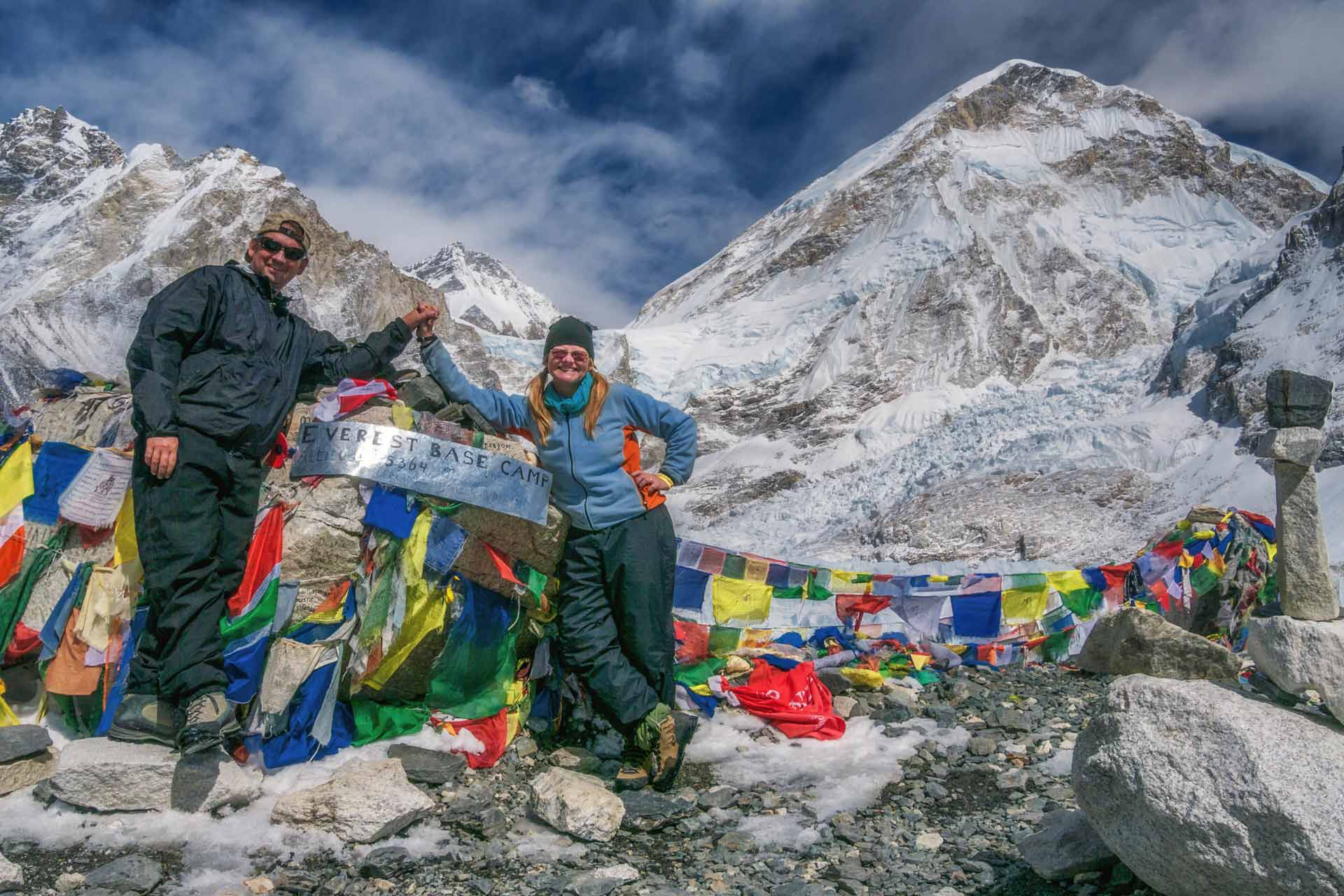
Table of Contents
Trekking to Everest Base Camp
What is it like trekking to Everest Base Camp in Nepal? The EBC Trek is life-changing, it’s exhilarating, and it is challenging. We share everything you need to know from planning your trek to Everest to packing for your trip. This guide to the Everest Base Camp Trek breaks down each day. So sit back and take a journey with us through Nepal’s legendary Sagarmatha National Park.
Everest Base Camp Trek Itinerary
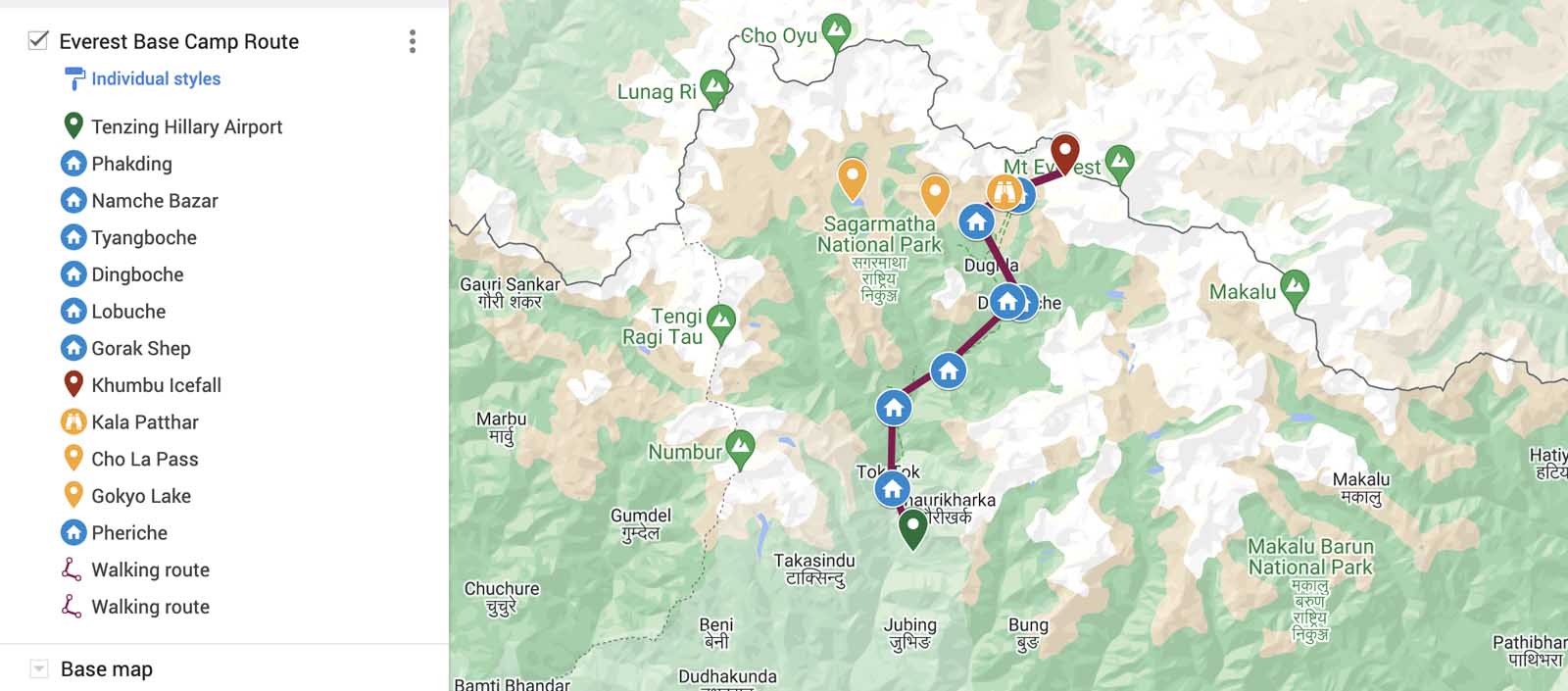
On the map, the Everest Base Camp trekking route distances look fairly easy to hike from village to village through the Khumbu Valley. Eight days may seem like it would be more than enough time to cover a mere 63 km (39 miles) one way, (128 km return) but with several sustained days in a row above 4000 meters (13,000 feet), the walk is slow and steady.
It is important not to push too fast to avoid altitude sickness which is a very real possibility. When trekking to Everest base camp, expect to hike anywhere from 7 – 17 km (4.5 – 10 miles) per day with the entire trek taking 12 – 14 days.
Hiring a Guide for the EBC Trek – Mandatory
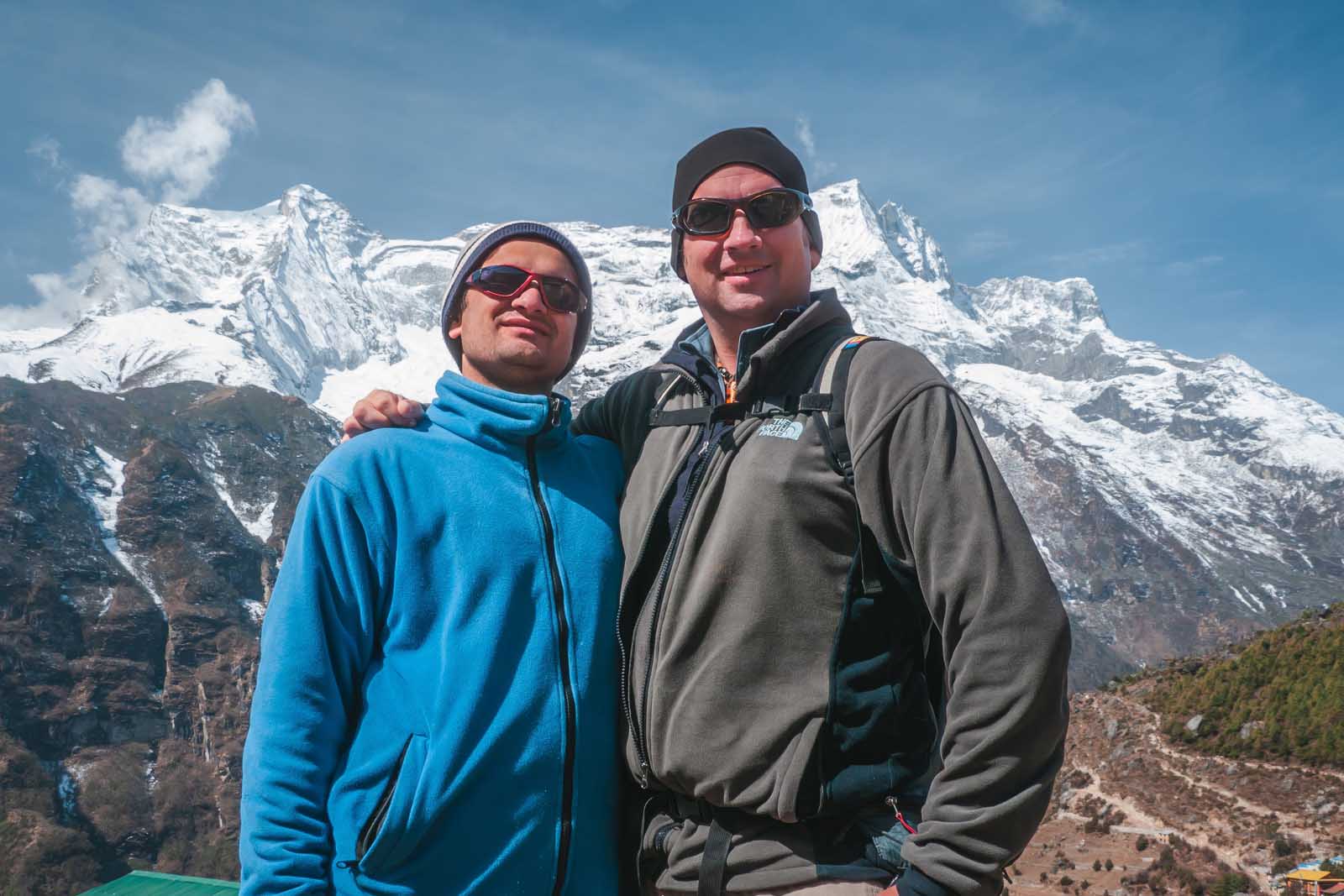
In April 1, 2023, Nepal has banned solo trekking. Foreigners must hire a guide for treks in high-altitude trekking regions of national parks. According to the Kathmandu Post in March “ solo or independent trekkers have to mandatorily hire a guide or a porter before setting off to Nepal’s mountains.” However, after an updated article in the Kathmandu Post, it seems that the Everest Region is an exception. Before booking, we would check with local companies and authorities as rules are constantly changing.
Book Locally
Many people book ahead of time with a tour company located outside of Nepal such as Intrepid Travel or GAdventures, but we hired locally and it saved a lot of money.
Plus, you know your money is going directly to the local economy and you have a more intimate experience by trekking with a local guide. We spent a couple of days in Kathmandu looking for a guide to Everest and found Simrik Real Nepa l owned by Kathmandu resident Dipendra Simkhada.
Dipendra planned the entire trip for us, and all we had to do was wait for him to pick us up at our guesthouse in Kathmandu to take us to the airport to board our Tara Air flight to Lukla Airport. Book your Trek to Everest Base Camp with Simrik Real Nepal – A Locally owned and operated tour company, Simrik is located in Kathmandu.
Kathmandu – The Hub of Nepal Treks
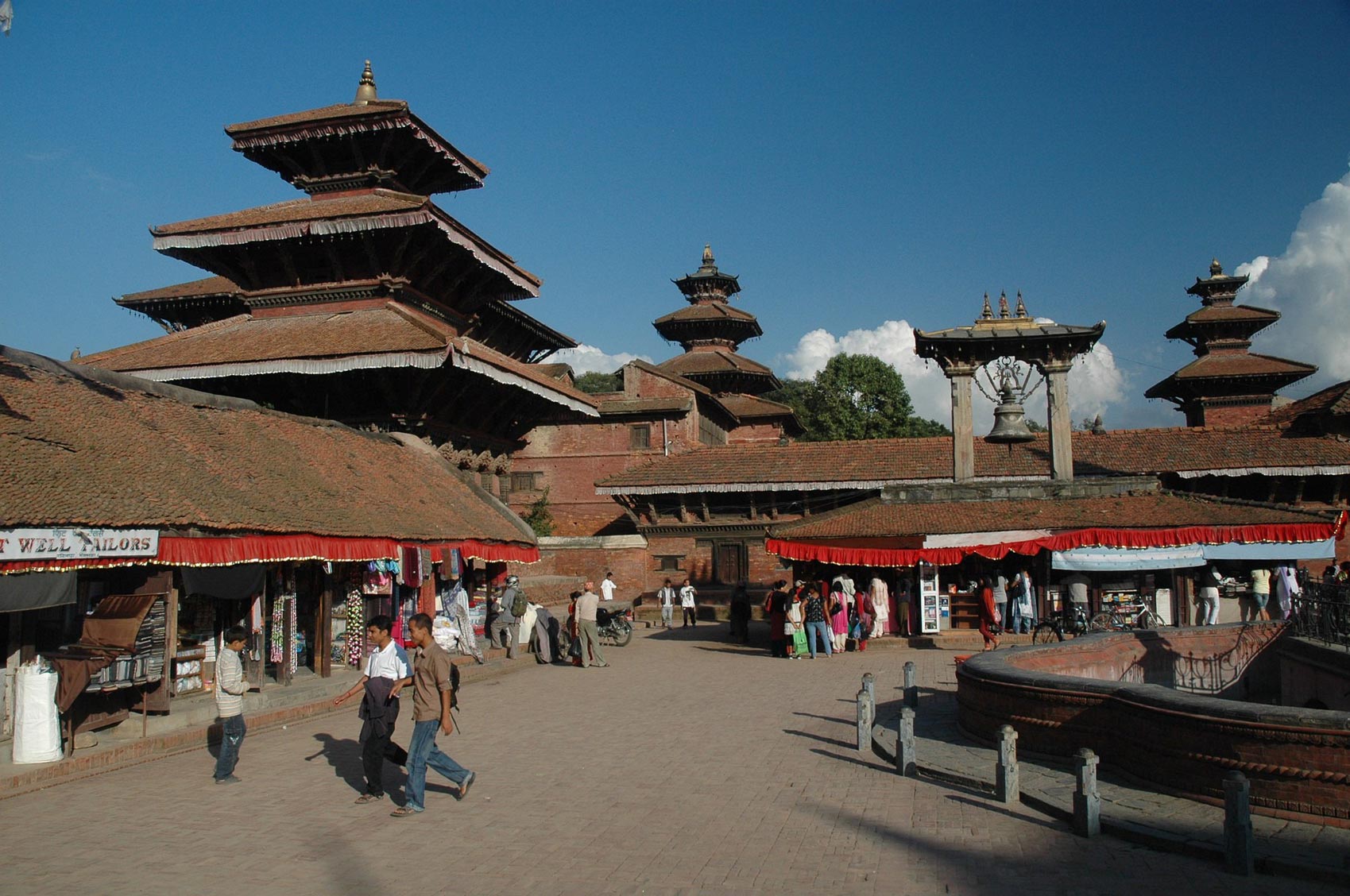
We spent a few days in Kathmandu picking up supplies and doing some sightseeing before trekking to Everest. We suggest not spending too long here as it can be very polluted in Kathmandu and by the time we were ready to trek, I was already quite congested.
Our recommendation is when you arrive in Kathmandu, only spend two to three days to get yourself organized and instead do your sightseeing at the end of your trek. Read more: Top Places to visit in Kathmandu, Nepal
Day 1: Fly from Lukla Trek to Pakhding
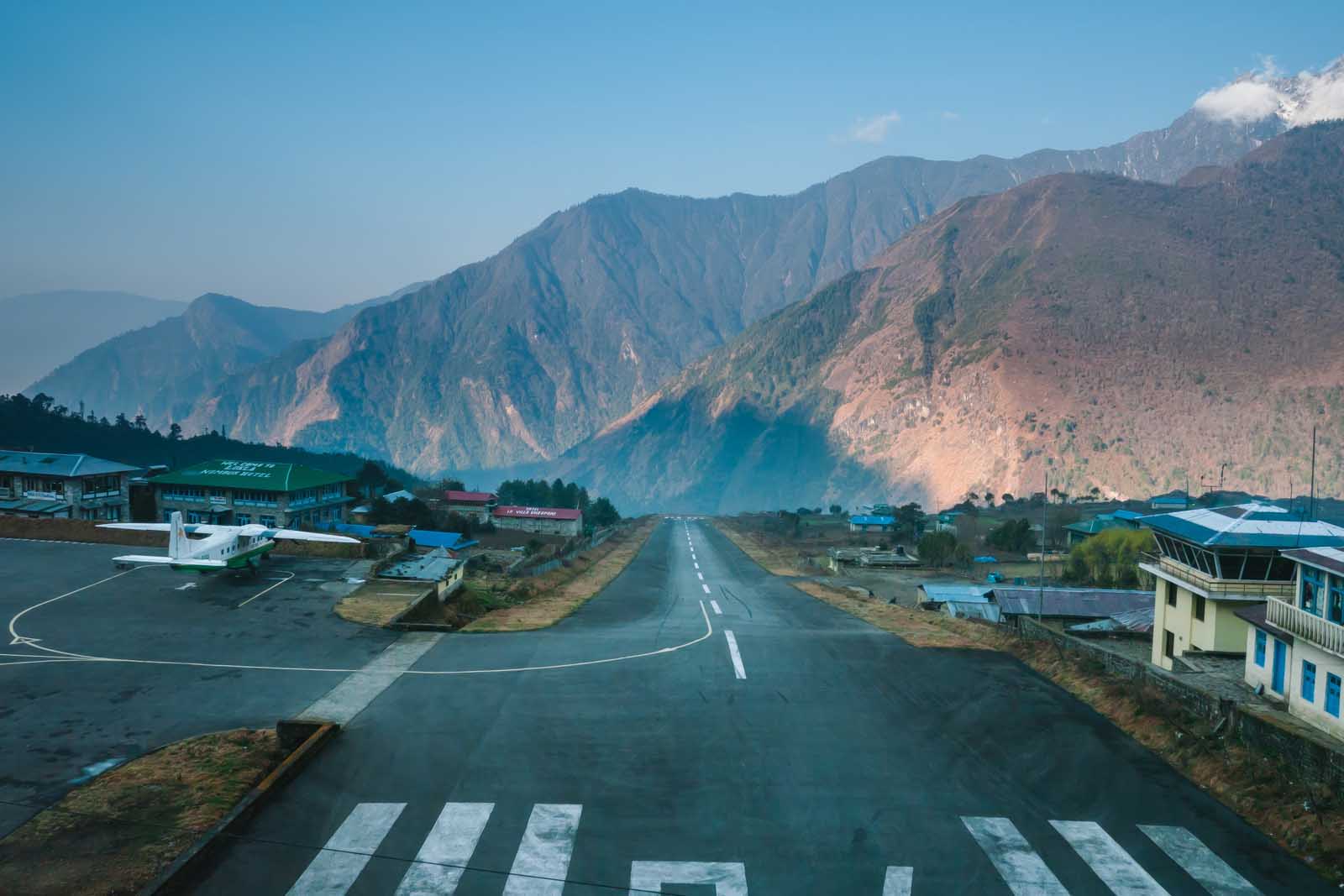
Flights to Lukla no longer leave from Tribhuvan International Airport (Kathmandu Airport) in Kathmandu due to congestion. Flights are now out of Ramechap airport which is a 4 1/2 hour drive from Kathmandu. You can book private helicopters from Tribhuvan International Airport.
The flight from Ramechap airport is much shorter than the flight from Tribhuvan International Airport. Flights to Lukla are only 12 minutes so more flights can get through when the weather is clear making flights less likely to be canceled or delayed for too long.
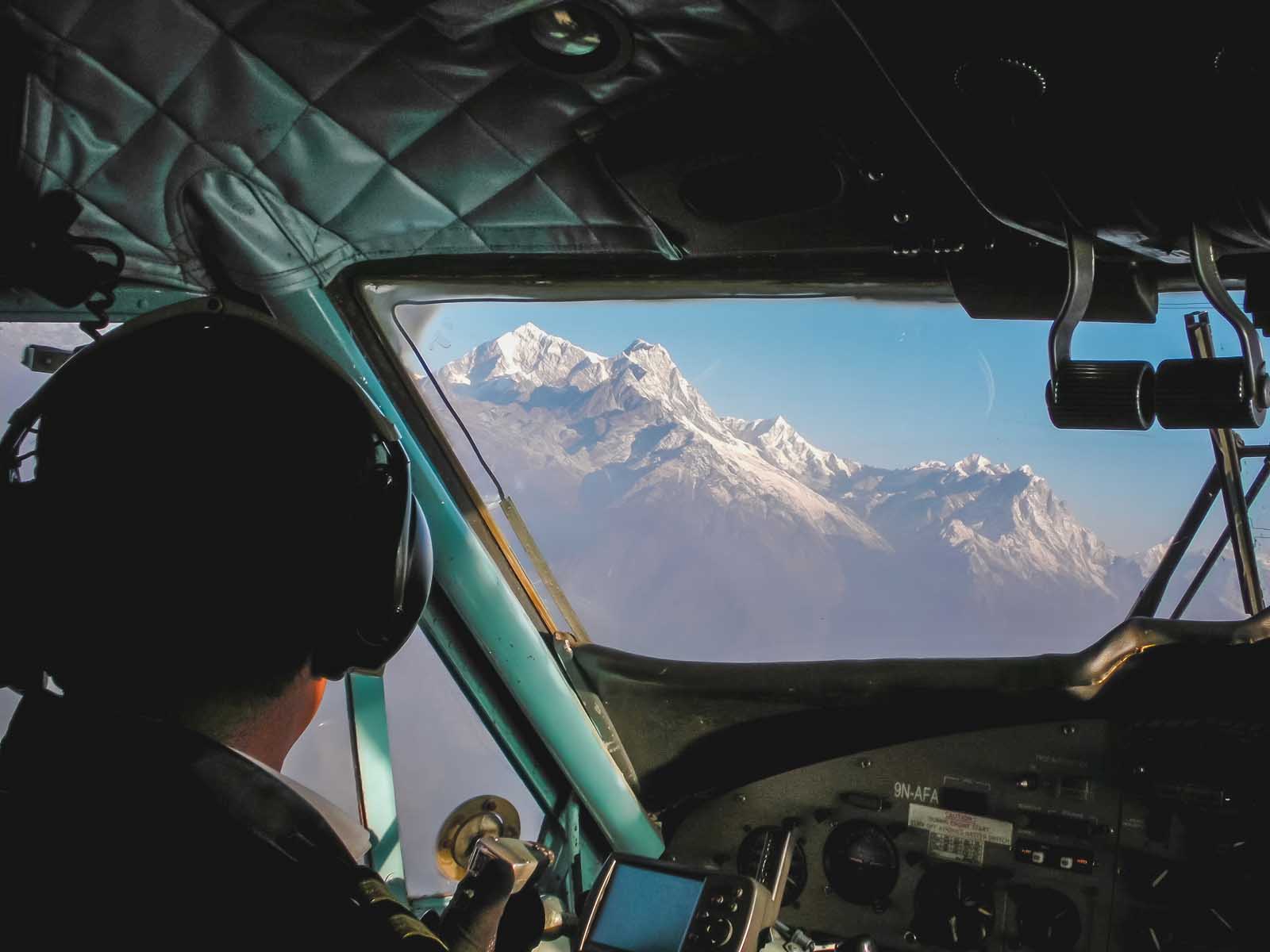
The flight to Lukla is a scary flight and is considered one of the most dangerous in the world. We flew from Kathmandu but flights now are much shorter from Ramechap. I think I would like it better as we sat at the front of the plane and saw the pilot’s instruments constantly flash “ obstacle ahead. ” It looked as if we were about to crash into a mountain at any time. Read all about our flight to Lukla and watch the video here
Watch Us Fly to Lukla Airport
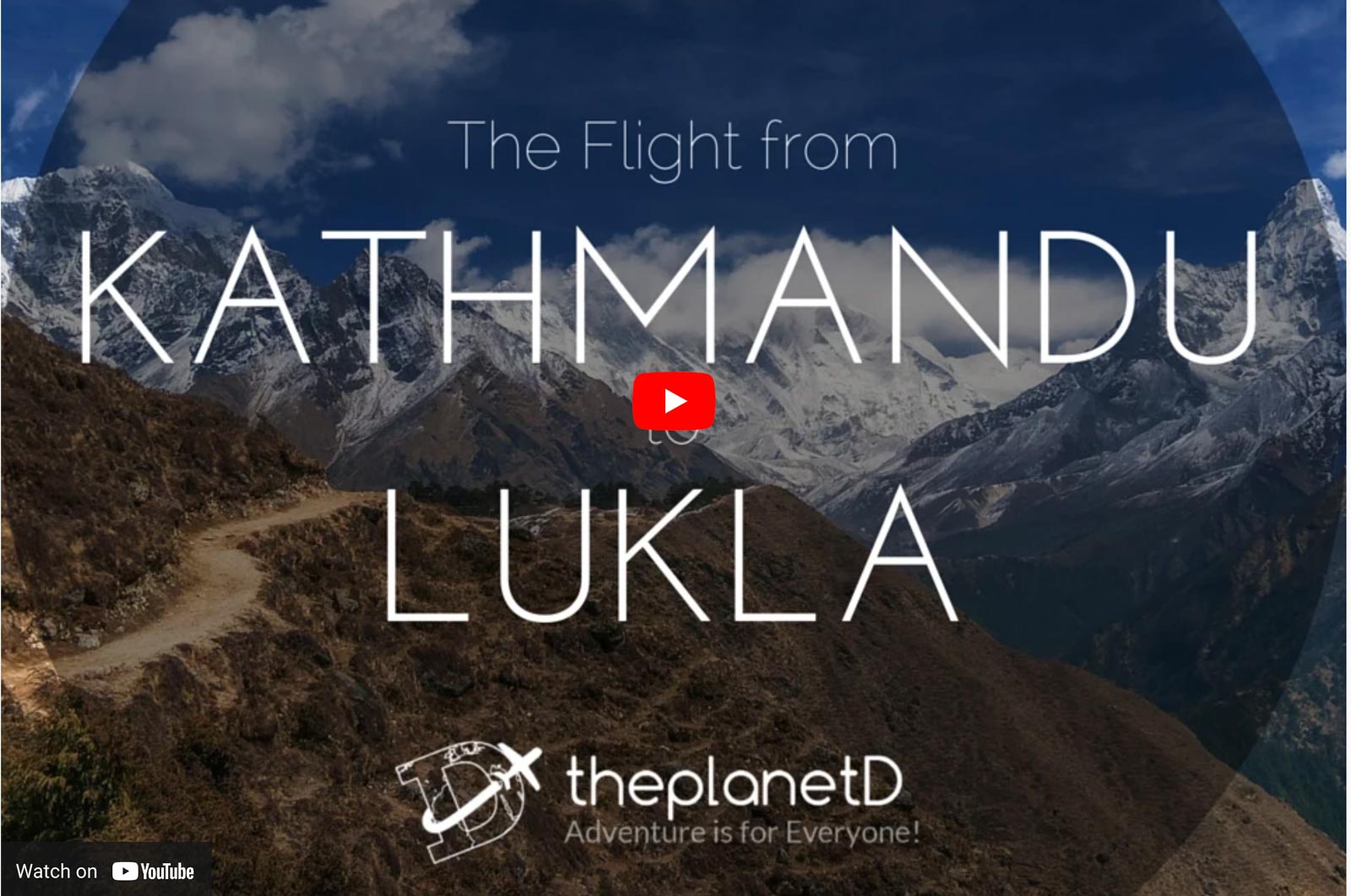
The Lukla airstrip at Lukla Airpot is a short landing strip at only 525 meters (1,729 feet long.) Built on the side of a mountain it is also a very steep grade that is needed to slow the planes down quickly. Needless to say, we held our breath during the landing.
We survived that flight, but it was the flight back to Kathmandu I was nervous about. Taking off on that short of a runway was a hair-raising experience. One false move and we’d drop thousands of feet into the valley below. Lukla Airport is actually called Tenzing Hillary Airport named after the first two men to summit Mount Everest.
Hiking from Lukla to Pakding
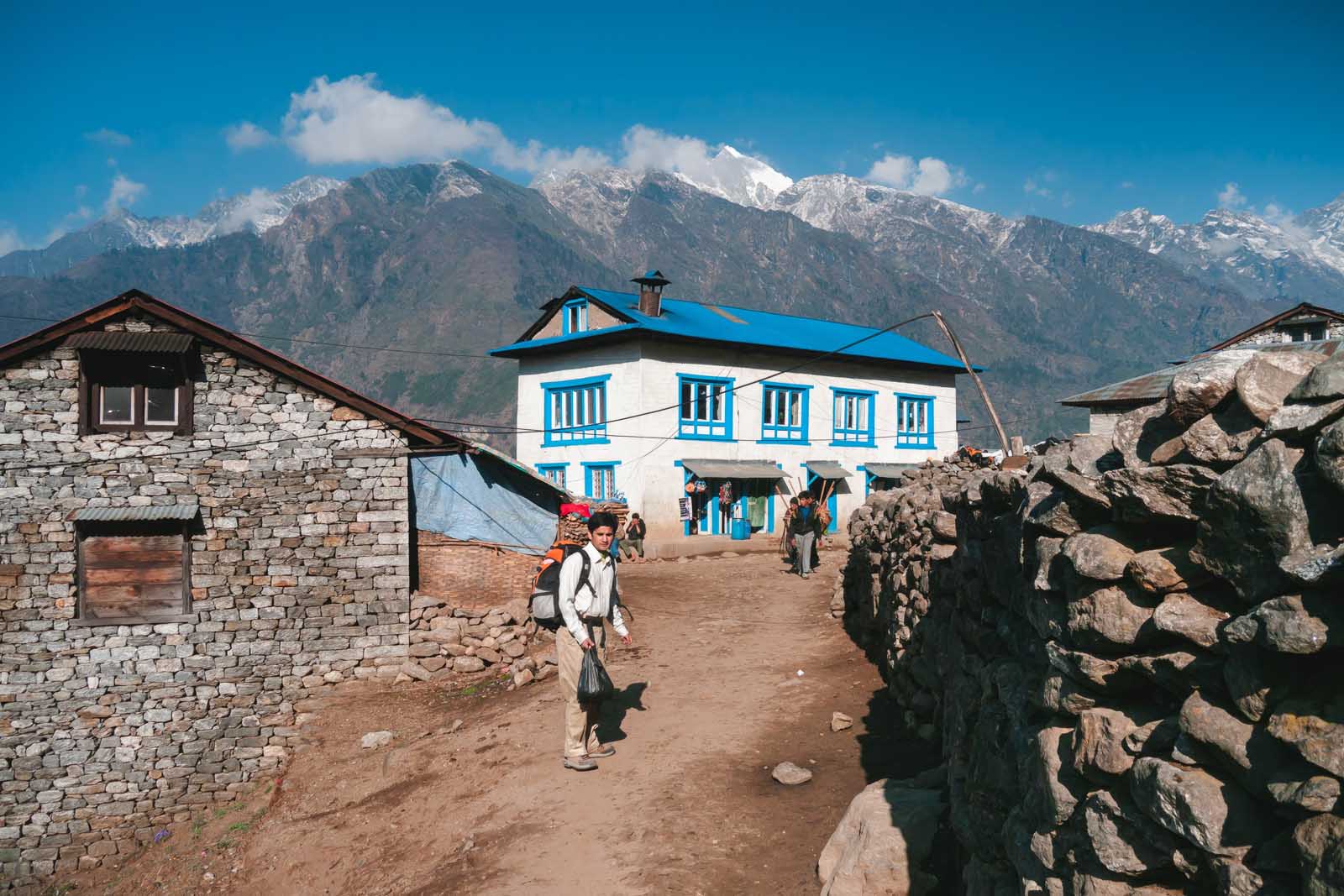
The trek begins officially in Lukla. Lukla is a busy town with plenty of accommodation, shops, and eateries. If you forgot anything for your EBC trek, you can pick up supplies in a pinch. But we suggest purchasing all your gear in Kathmandu. It is much cheaper.
From Lukla, we immediately started our Everest Base Camp hike. After a quick snack and a cup of tea in Lukla, we set off on an easy three-hour trek along trekking trails that were easy to follow weaving through villages, crossing rivers, and stumbling over stony paths.
Entering Sagarmatha National Park
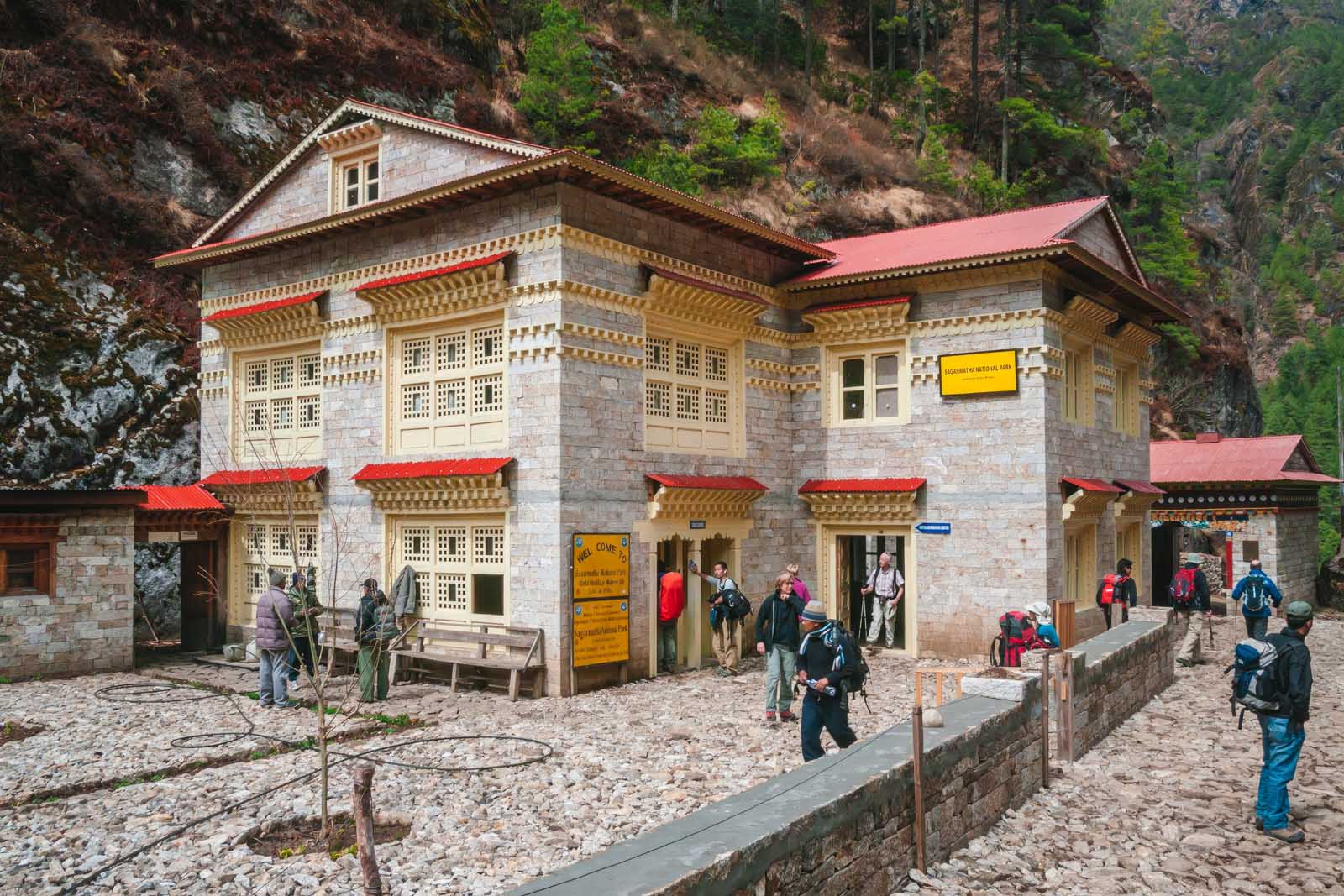
A permit is needed to hike to Everest Base Camp as it is located in Sagarmatha National Park. We checked in with the national park headquarters and Dipendra took care of everything. He had all our paperwork in order so all we had to do was start walking through the beautiful Khumbu Valley to make our way to Everest base camp.
Sagarmatha National Park has been a UNESCO World Heritage Site since 1976. At 1148 square km (443 square miles) in area, it is one of the most beautiful places we have ever visited.
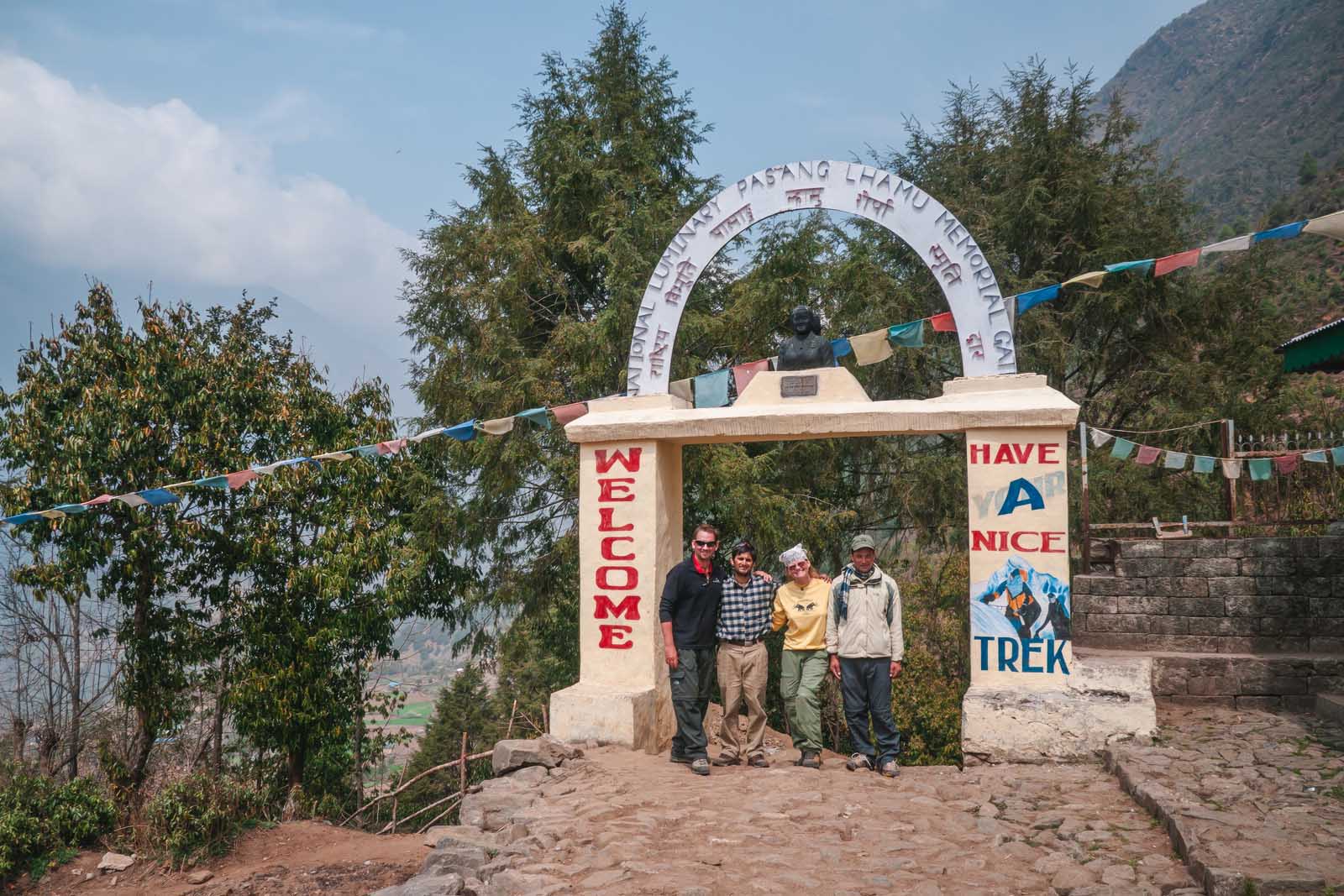
We felt giddy stepping through the welcome gates located just outside of Lukla. This was it, we were following in the footsteps of the great adventurers of our time. It was awe-inspiring to hike through the Khumbu region surrounded by the Himalayas.
As we hiked out of Lukla, Dipendra pointed out the surrounding jagged white peaks named Kwangde, Mumbu, and Kishumkongara. At 6000+ meters, (19,000+ feet) these are the “little guys” of the world’s highest mountain range. It wouldn’t be long until we were among the famous 8000-meter (26,000 feet) peaks.
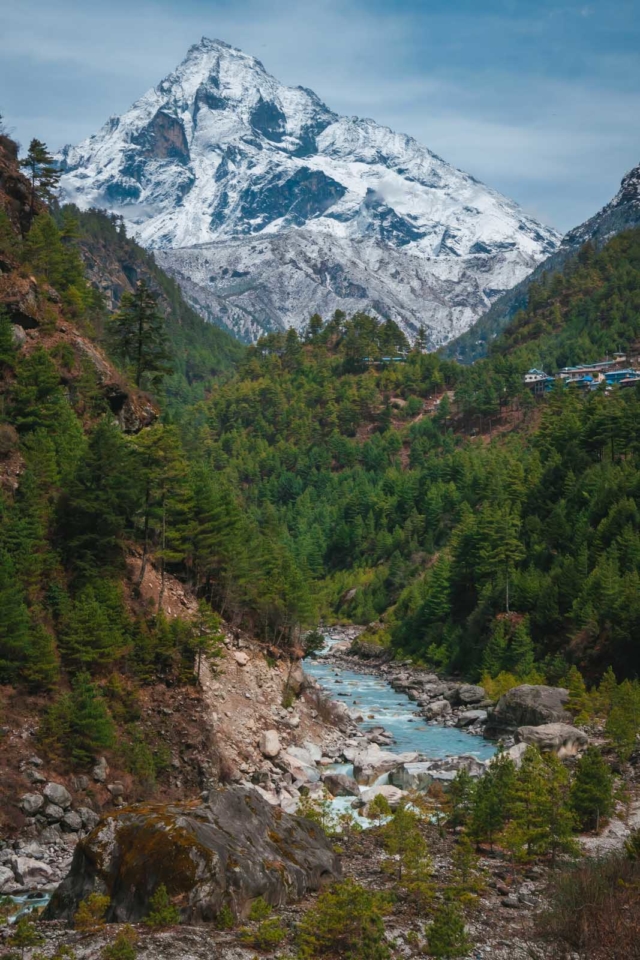
Our first day was filled with a relaxing walk while learning about the Khumbu region. It was quite early in the day, so we had plenty of time to take our time to learn about the customs of climbing and learn the names of the mountains found in this beautiful region of Nepal.
For the rest of the day, we followed the Dudh Koshi River Valley at a steady but leisurely pace to the village of Pakding. Temperatures were warm and the first day of trekking was comfortable. Lukla to Pakding actually has an elevation loss, so it is a good introduction to hiking through the region as we had a lot of downhill trekking.
After about 5 hours, we came to our first night on the trek where we spent the night in a comfortable teahouse in the village of Phakding.
Our First Night on the EBC Trek
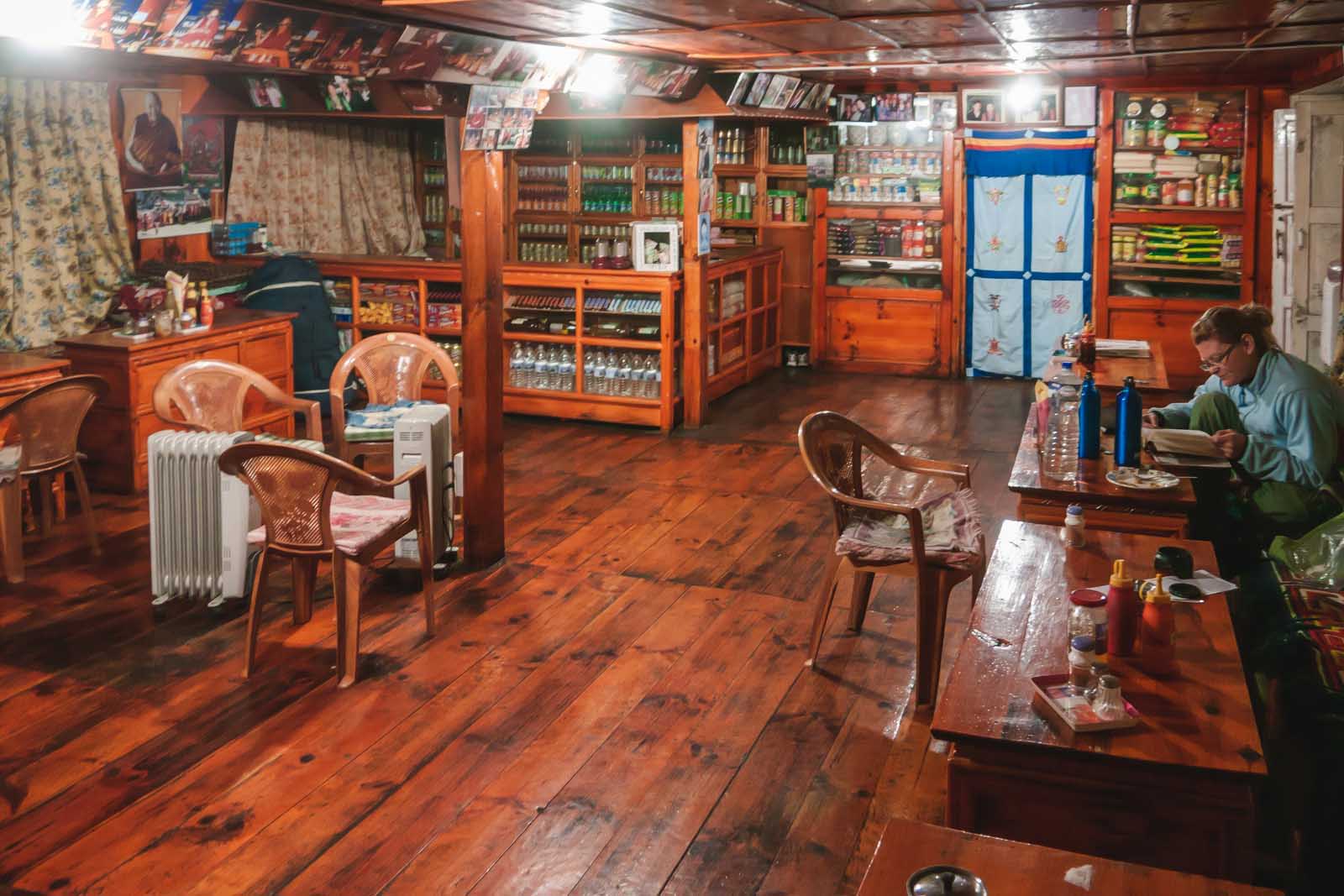
The accommodation in Pakding was a quaint little hotel/teahouse that looked like a cottage. The wood-burning stove smelled delicious as it warmed the restaurant while they prepared our meals.
Our porter “Sher” carried all our supplies including the sleeping bags that we borrowed from our trekking company. We each rented a sleeping bag that was included in the price of our EBC trek. The beds were comfortable and Dave and I had private rooms. Some tours use dorm rooms but we had private rooms. Toilets were shared, but everything was clean and comfortable. The rooms were clean and we slept like rocks snuggled up in our thick down sleeping bags.
Heated Lodges – Teahouses on the EBC Trek
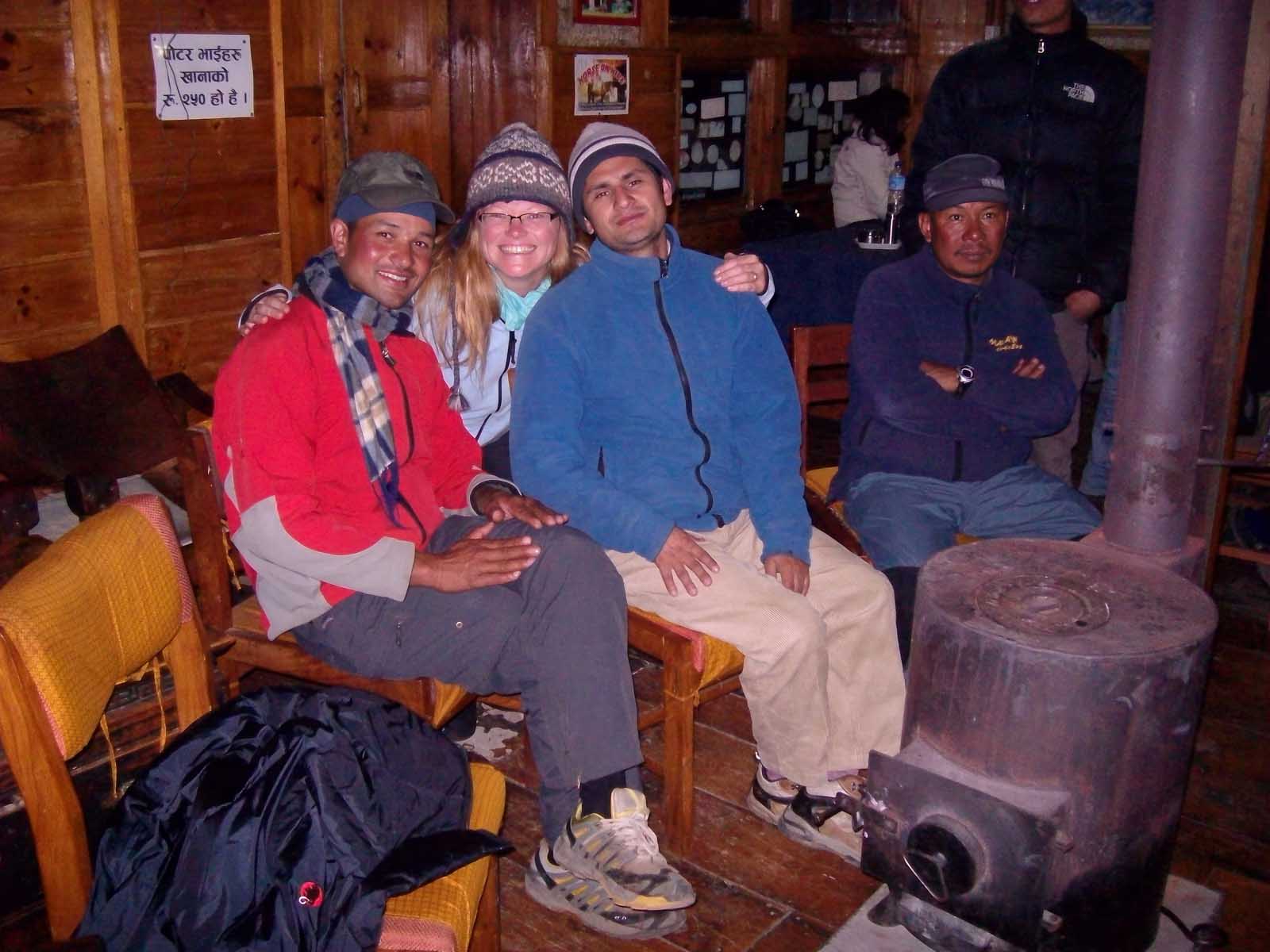
During the EBC Trek, you don’t stay in tents. You stay in charming teahouses with cozy beds, wood-burning stoves, and fully stocked restaurants that serve dinner.
The teahouses are a welcoming sight after a long day of trekking helping to make the trek to Everest one of the most memorable experiences of our lives. If you are planning to trek to Everest Base Camp in Nepal, read on for all the information you’ll need to help you prepare.
The main lodges of each teahouse we stayed in during the first half of our EBC trek were cozy and warm. At the lower elevations, woodstoves burned wood in the dining room and common areas and our rooms were a comfortable temperature with heating as we were wrapped up in our sleeping bags. We ate hearty meals of pasta and meat and enjoyed a relaxing night soaking in the amazing day we just had on the mountain.
- From Lukla – Elevation 2869 meters (9,350 feet)
- To Pakding – Elevation 2610 meters ( 8563 Feet)
- Length – 7.7 km (4.78 miles)
- Elevation loss – 79 meters (259 feet)
- Duration – 3 Hours
Day 2 – Pakding to Namche Bazaar
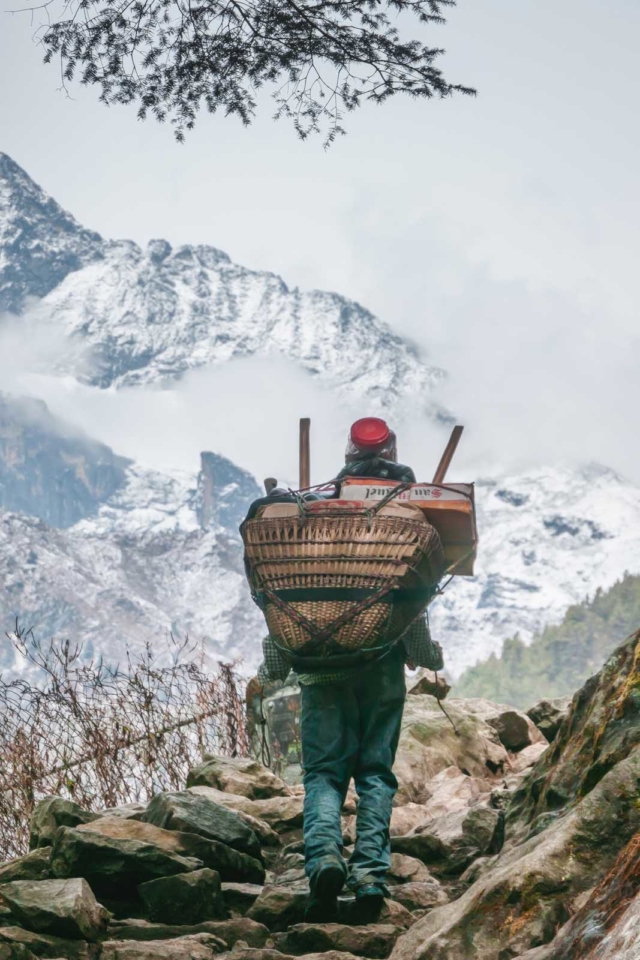
On day two, we checked in at another gate of the Mt. Everest park headquarters to show our documentation. We had to show our passports and give them extra passport photos to go into the log. (So make sure you have extra passport photos with you) Once we signed in, we were officially in the Khumbu region and officially on our way trekking to Everest Base Camp.
We covered a lot of terrain on day two making it the longest day of the Everest Base Camp trek. The trail up the mountains was steep and challenging but it was a memorable day.
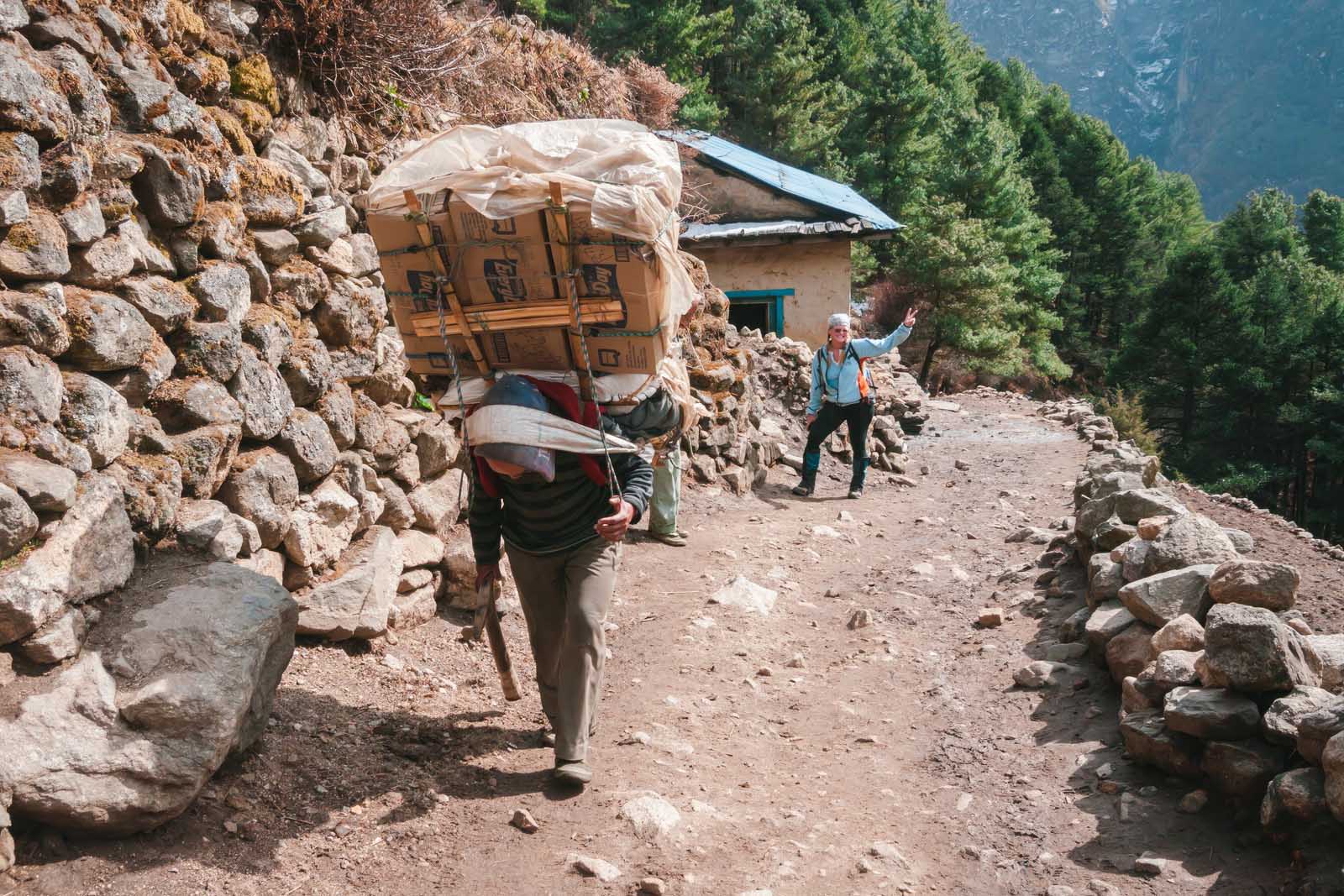
Day two of the EBC trek was a hike of almost 10km (6.2 miles) with an elevation gain of 800 meters (2624 feet). But throughout the hike, there was a lot of elevation loss mixed in so it felt like a lot more.
We would lose elevation as we descended into the valley only to have to climb back up again to a higher elevation. Today was a lot of fun though because we crossed several suspension bridges over Dudh Kosi River Valley.
Suspension Bridges on the way to Everest
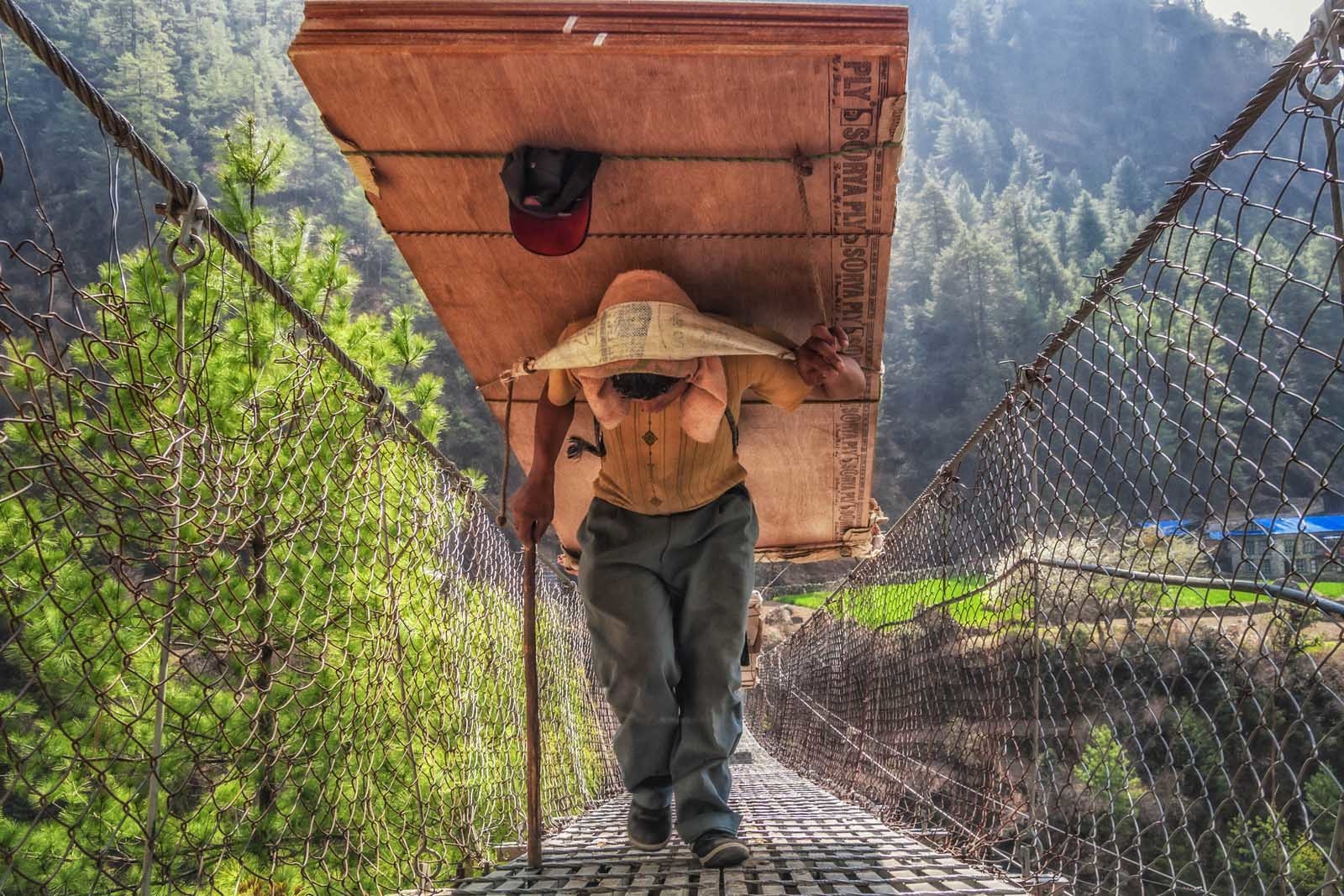
If you have a fear of heights, crossing suspension bridges may not be your favorite moment, but the suspension bridges while trekking to Everest Base Camp are well constructed, made of steel, and in excellent condition.
I was nervous about the suspension bridges. The Lonely Planet Guide said, “ Grit your teeth and climb onto a drooping suspension bridge floating at a dizzying height .” That sentence freaked me out.
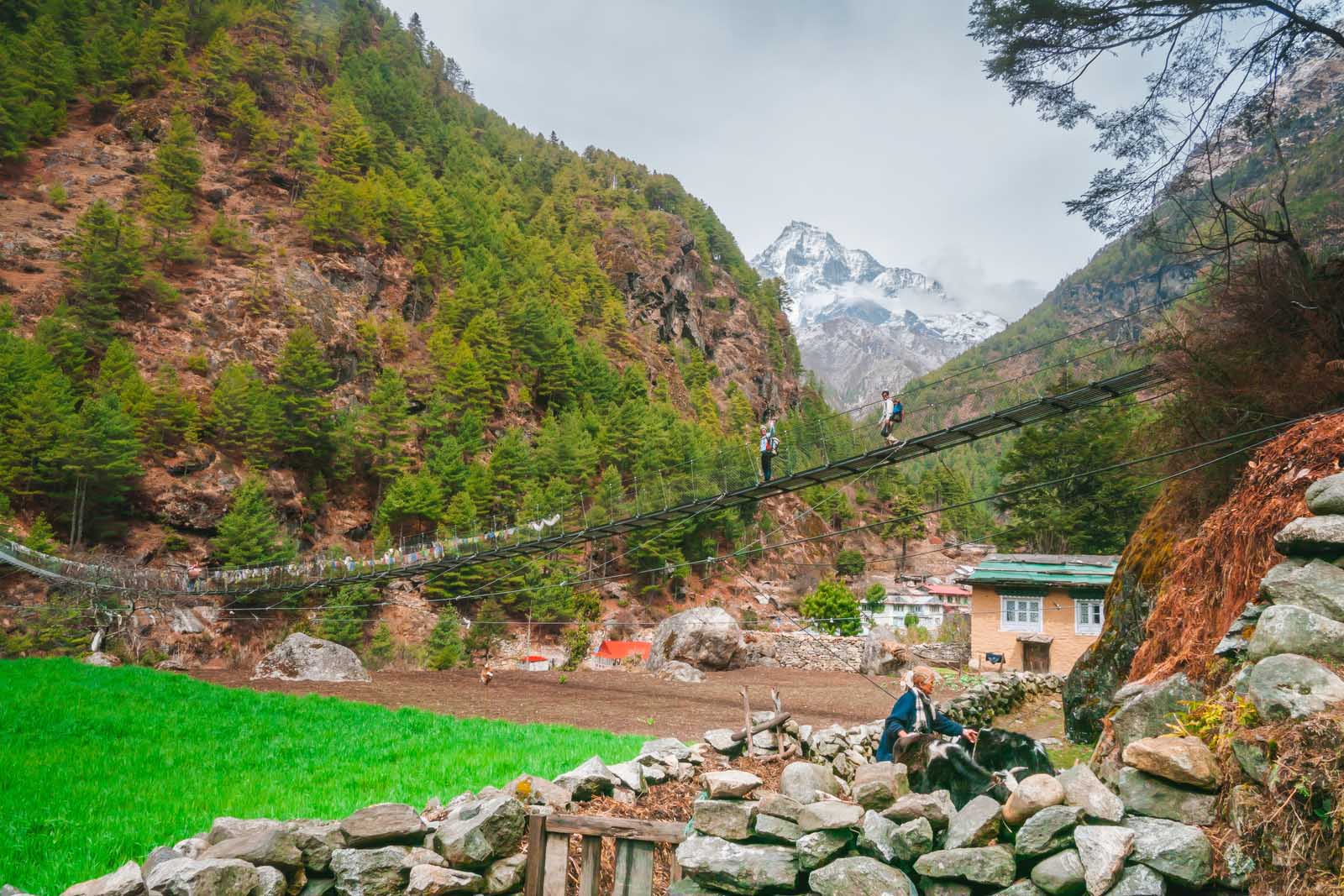
I had built the suspension bridges of the EBC trek in my head as something monstrous. But by the time we reached the first bridge, I wondered what all the fuss was about. Once I crossed my first bridge, my confidence was up and I was ready for anything the Everest trek was ready to throw at me.
Donkey Trains
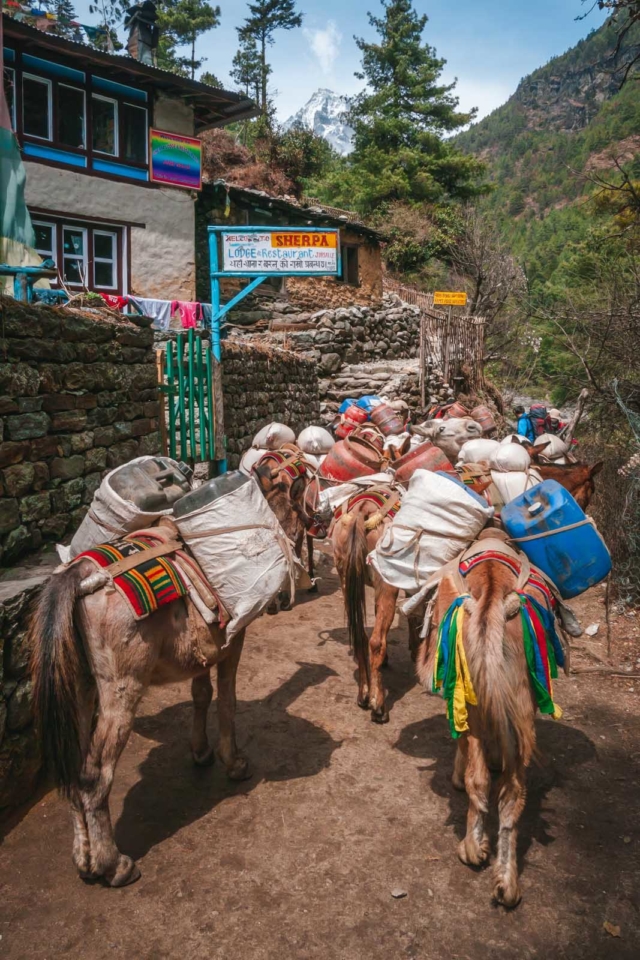
Today we also started to see a lot of donkeys, cows, and goats taking supplies to the villages. Traffic can get very heavy on the Everest Base Camp hike. When animal trains go by, make sure to get out of their way and stay to the side.
They are loaded down with heavy gear and they have a mission to keep on walking until they are done. They can easily nudge you right off the side of a cliff as no matter what is in their way, they just keep walking.
The trail is a highway, but instead of transport trucks or trains carrying cargo, people and farm animals carry everything from lumber and building supplies to food and kitchen appliances.
Safety Tips on the Everest Base Camp Trek for yaks and donkeys
- Important Tip: When a yak, donkey, or cow train passes you during the EBC trek, be sure to stand on the mountainside of the trail so they can’t push you over the edge !
- It is better to be squished into a mountainside than to go tumbling over the edge!
Final Stretch to Namche Bazaar
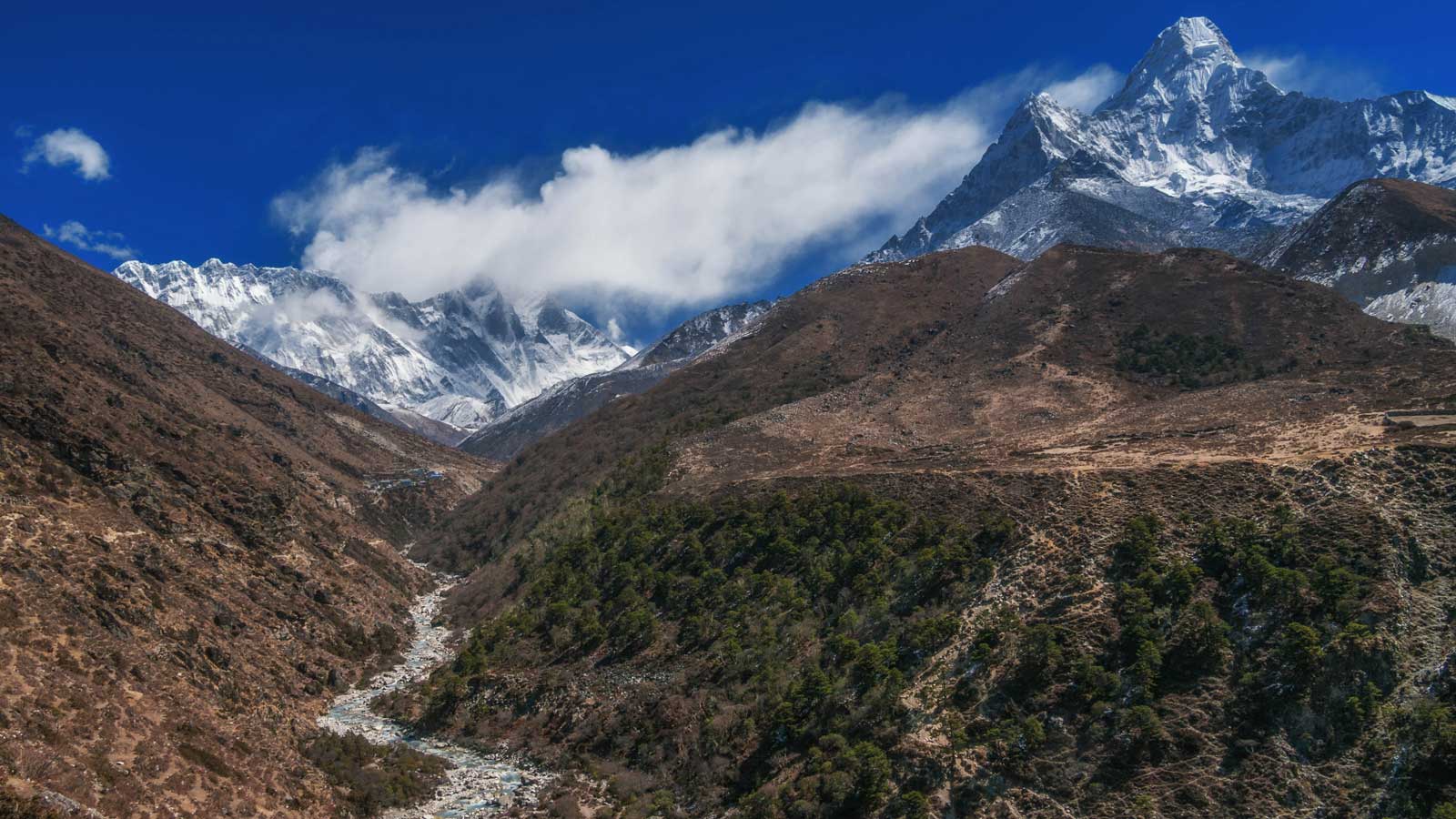
Right after crossing the last bridge, the hardest part of day two of trekking to Everest base camp started The last push of the day consisted of 2-hours straight uphill to Namche Bazar.
We were drenched with sweat but the air was cool. Whenever we stopped for a break, we would get a chill so we just kept on chugging away.
Large tour groups passed us quickly, only to be caught a few minutes later as they rested. We realize that we were the tortoise and they were the hare! Slow and steady is the way to climb at high altitudes and in the end, we made it to Namche Bazaar with plenty of time to spare in the day.
Arrival to Namche Bazaar
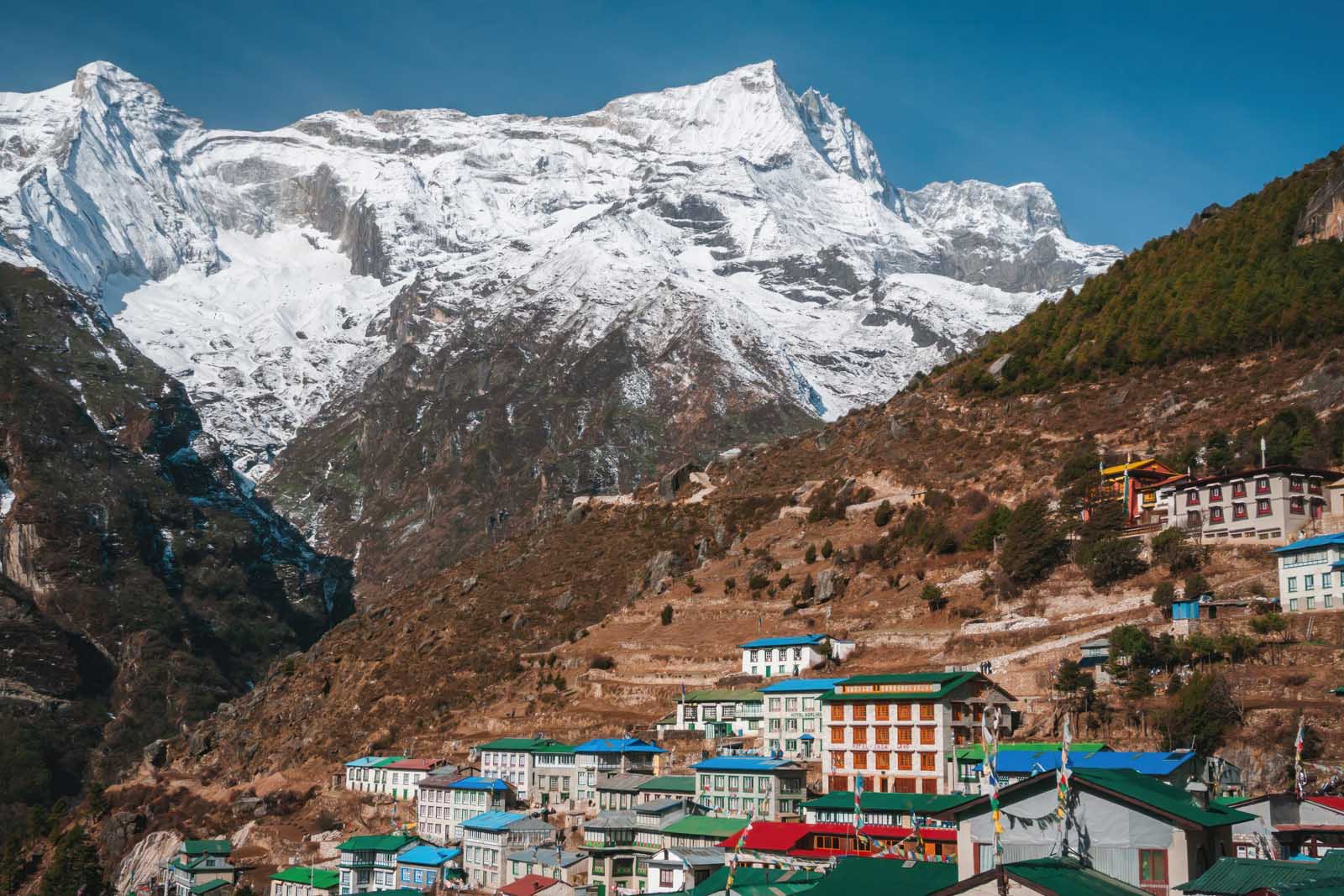
We checked into the security post and cringed when we found out that our lodge was an uphill walk for another 20 minutes. Rest had to wait a bit longer.
When we arrived at our accommodation, we were thrilled to see our porter Sher’s smiling face. He had already checked us in and put our bag in our room. We immediately went for a nap and then did a little walking around town in the evening to do some shopping and grab a bite to eat before turning in for an early night.
There are plenty of shops and restaurants at Namche Bazaar, this town is bustling and we spent two nights of our EBC Trek here which was awesome.
Pakding – Elevation 2610 meters ( 8563 Feet) Namche Bazaar – 3440 meters (11,286 feet) Elevation Gain – 830 meters (2723 feet) Distance – 10km (6.2 Miles) Duration – 6 hours
Day 3 – Acclimatization Day at Namche Bazaar
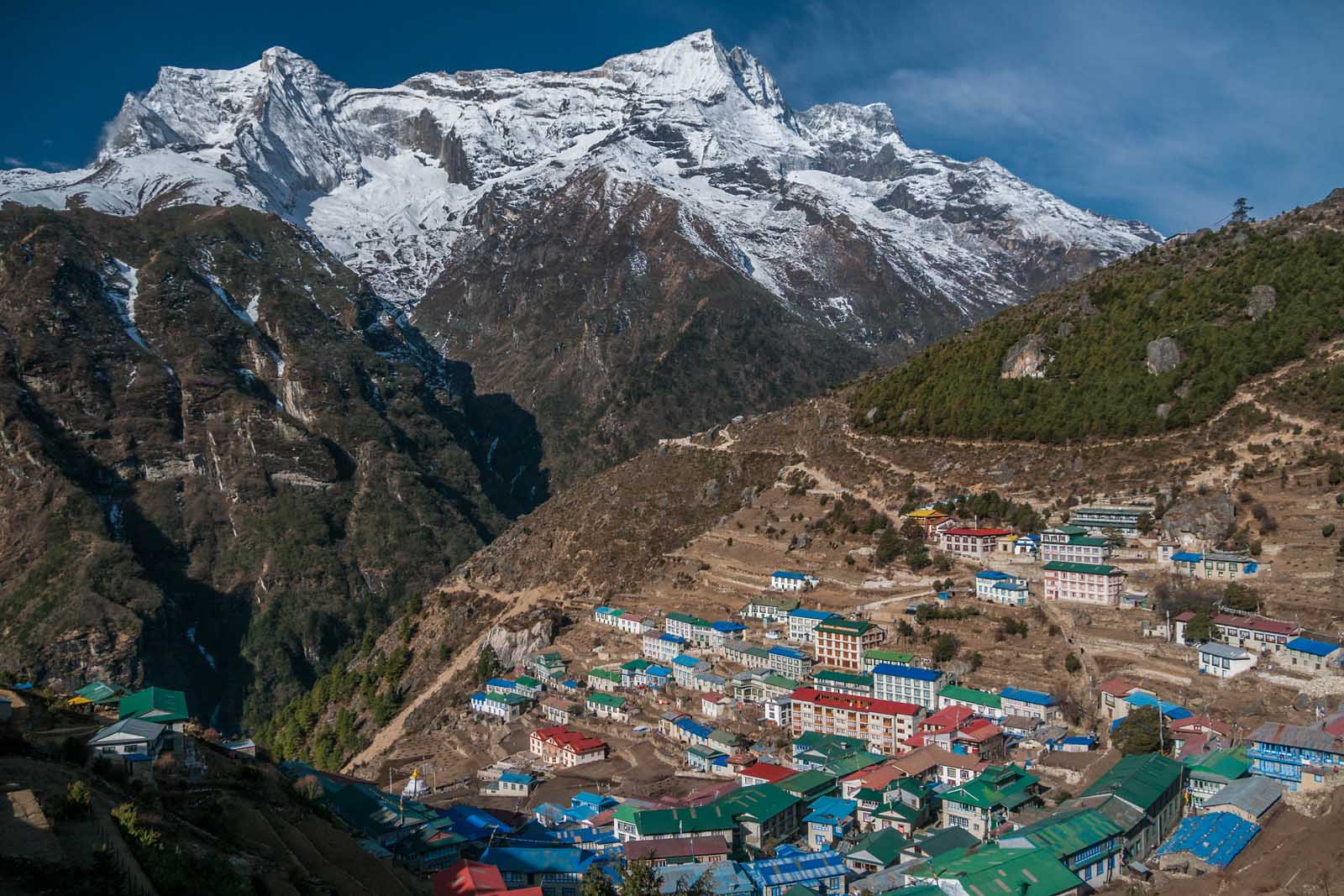
We had two glorious days at Namche Bazaar. Dipendra chose great accommodation for us throughout our EBC trek and we had a good rest in this splendid teahouse where we enjoyed delicious pasta, meats, and of course dhal baht. We spent the morning enjoying coffee and doing a bit of shopping.
What to do in Namche Bazaar
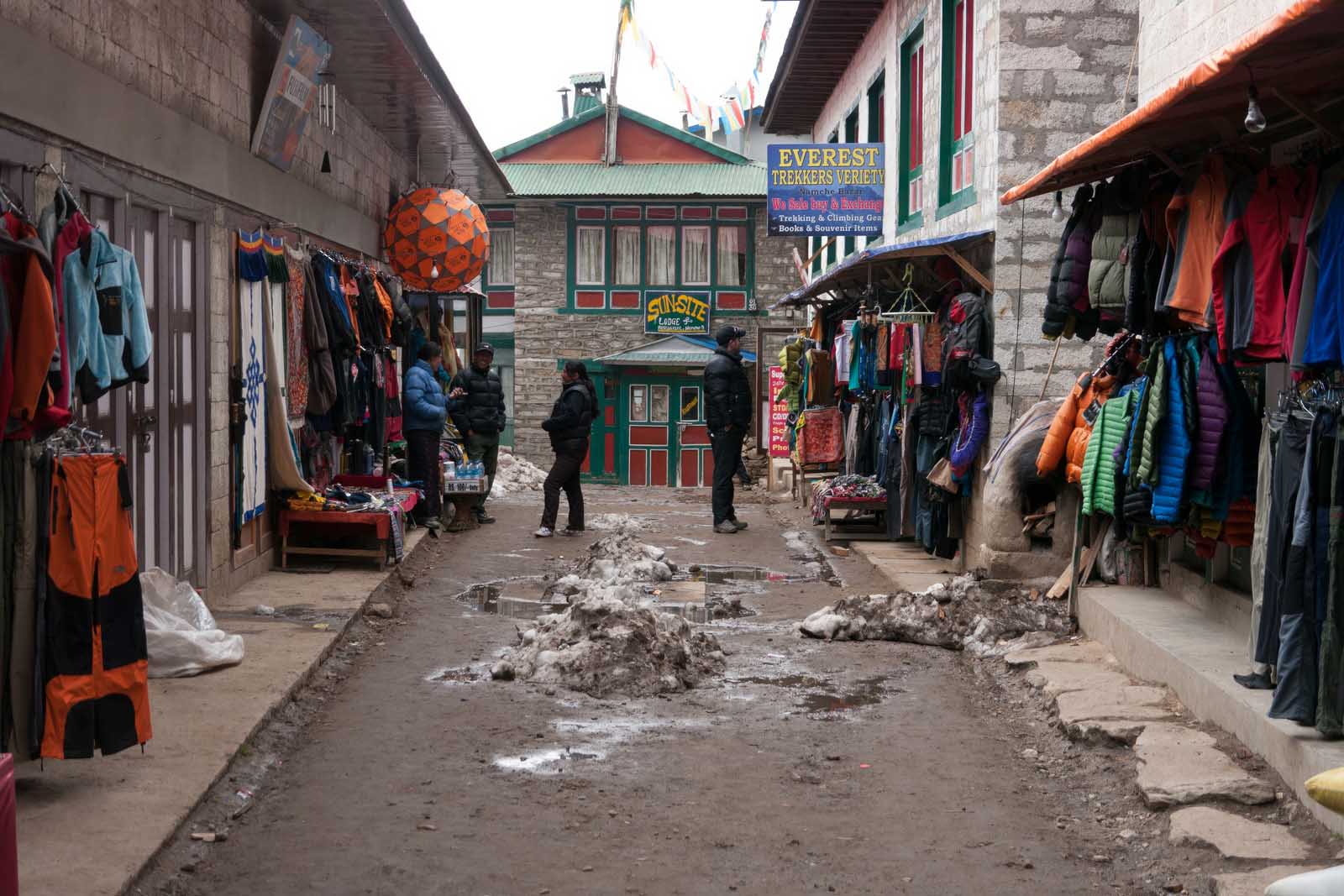
We explored Namche Bazaar and checked out its many shops. The streets are packed with shopping stalls and markets. We searched for gear that we missed getting in Kathmandu and got some great deals. We were surprised the prices weren’t inflated at Namche Bazaar.
We bought some down booties to keep our feet warm at night, a couple of sherpa hats, and a warmer set of gloves. The Everest Bakery was a highlight with delicious apple pie, fresh coffee, and WiFi. We had two pieces each!
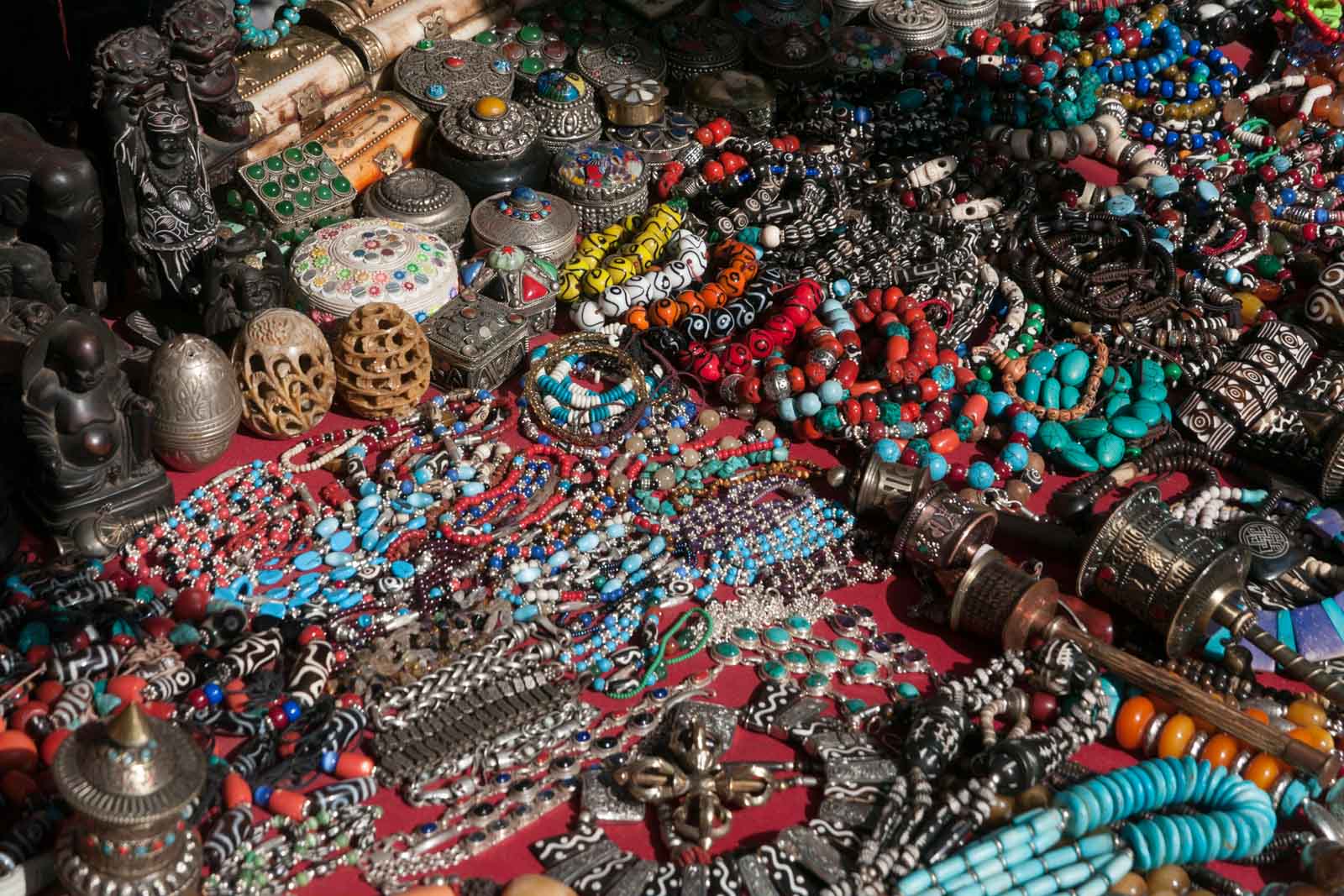
But we took it very easy, making sure to stay hydrated and to eat enough food to stave off altitude sickness. Namche Bazaar is located at a high altitude of 3440 meters (11,286 feet). We already saw a woman suffering from altitude sickness. She was having her blood pressure taken and heart rate monitored and when she got up, she was staggering as she leaned on her guide.
Her Everest base camp trek had already come to an abrupt end. It reminded us to relax because the days ahead were going to be tough. So we went back to our teahouse to relax and prepare for the rest of our journey
The Acclimatization Hike for EBC Trek
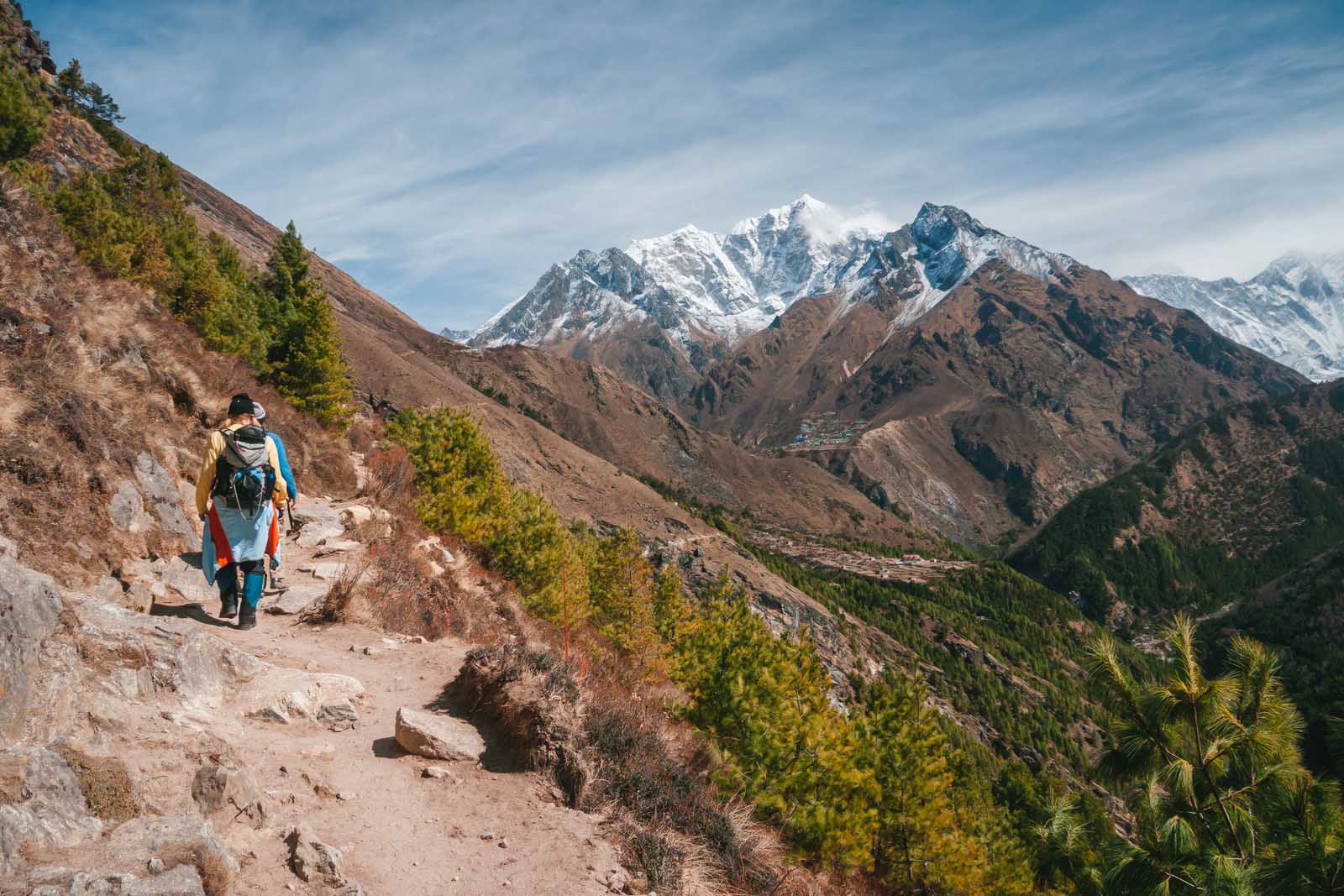
Most high-altitude treks have at least one acclimation day . The Everest Base Camp trek is no exception. An acclimatization day consists of hiking to a higher altitude and then coming back down to sleep at a lower elevation. It gives your body a chance to adjust to the altitude but you don’t stay for long.
As you will be constantly gaining altitude on the Everest Trek, it is good to have at least one day to climb higher and sleep lower to help prevent altitude sickness.
Our acclimation hike took us to the Everest View Hotel. With an elevation gain of only 400 meters, it wasn’t too much higher than our hotel in Namche Bazaar, but it is enough to help acclimate to the high altitudes. Everest View Hotel offers amazing views of Mount Everest (hence the name). Plus it holds the Guinness book of world records as the highest hotel in the world.
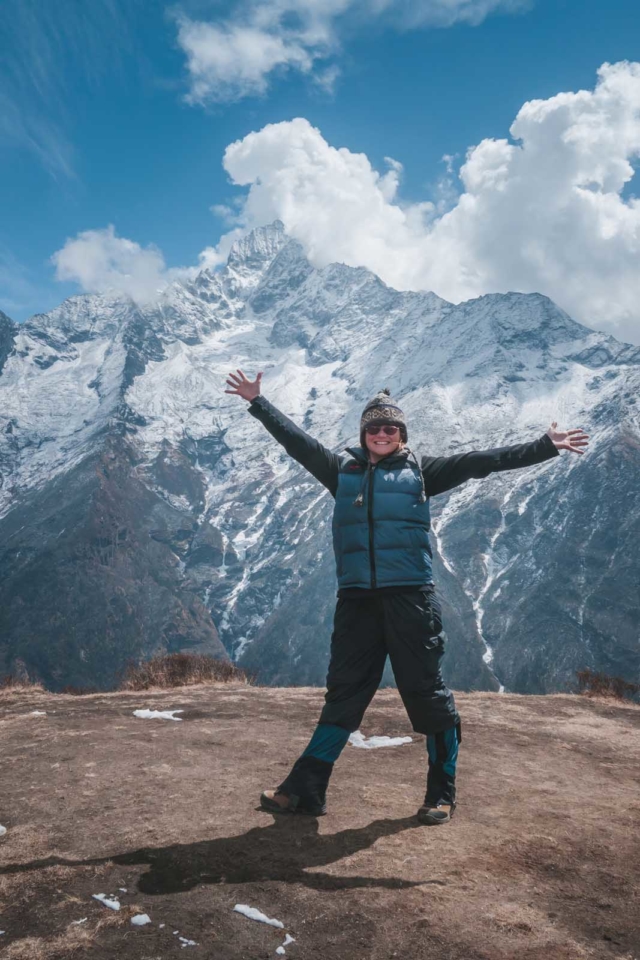
It is not an easy day off though. Just walking through town takes your breath away. As we made our way up the steps, I wondered if I should have just stayed in bed and skipped the viewpoint to relax. When we started the climb I was breathing heavily just walking up a few flights of steps. We hadn’t even left Namche Bazaar and I was pooped!
Once we got on the trail, things became easier. The steep grade gave way to a sloping trail and I started to feel better. After one and a half hours of climbing, we reached what has to be the world’s highest airstrip at 3700 meters (12,139 feet). We arrive just in time to see a small plane take off.
First Views of Mt. Everest
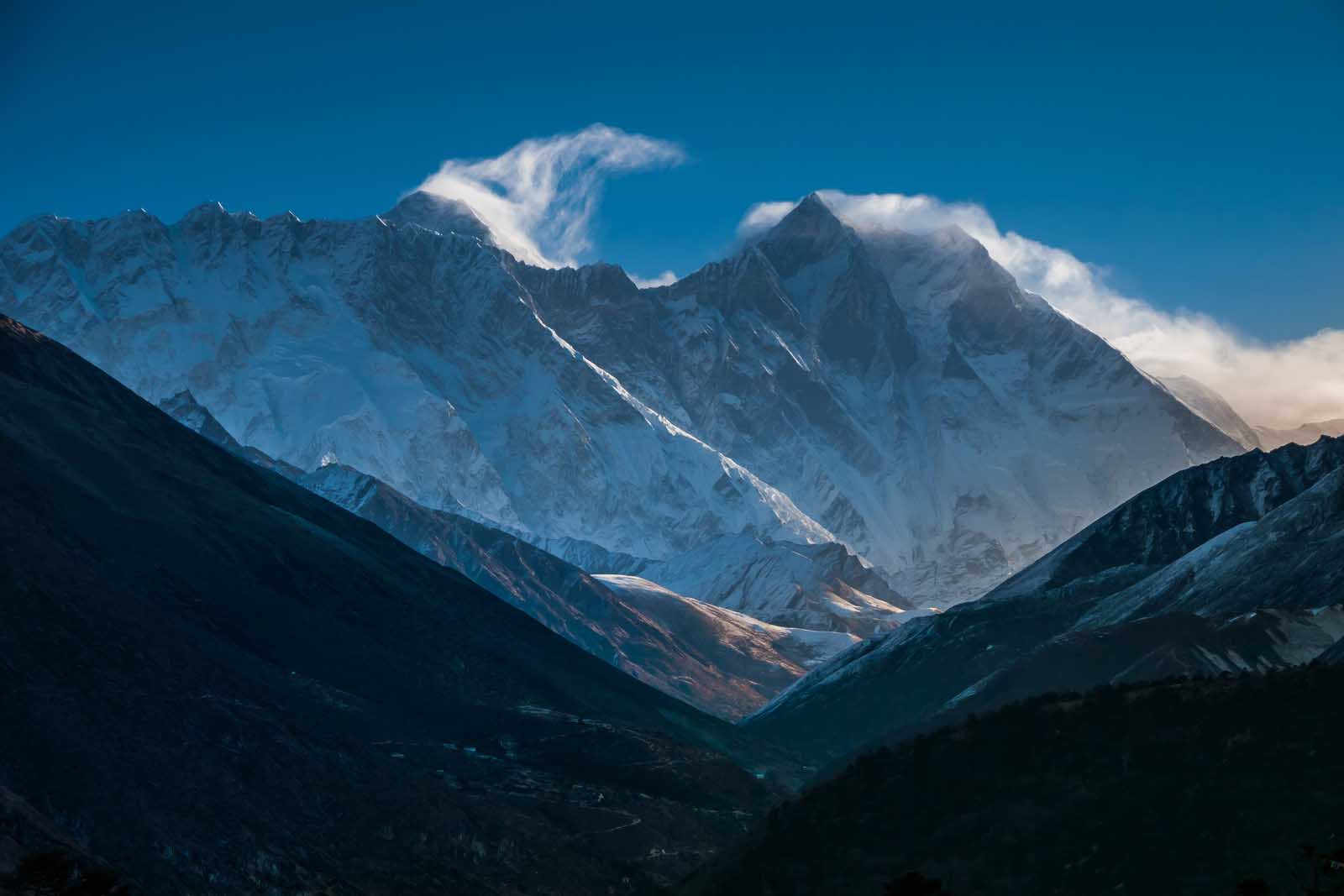
It was here that we got to see our first breathtaking views of Mt. Everest and the surrounding mountains. We hiked a bit farther and there it was, standing quietly behind the other highest peaks of the earth.
Lhotse, Changri, Ama Dablam, and Nuptse surround the mighty Mount Everest, the world’s highest peak. At 8414m (27,604 feet), 6027m (19,773 feet), and 7861m (25,790 feet) they are the little sisters of this sacred mountain. Mount Everest stands at 8848 meters (27,716 feet).
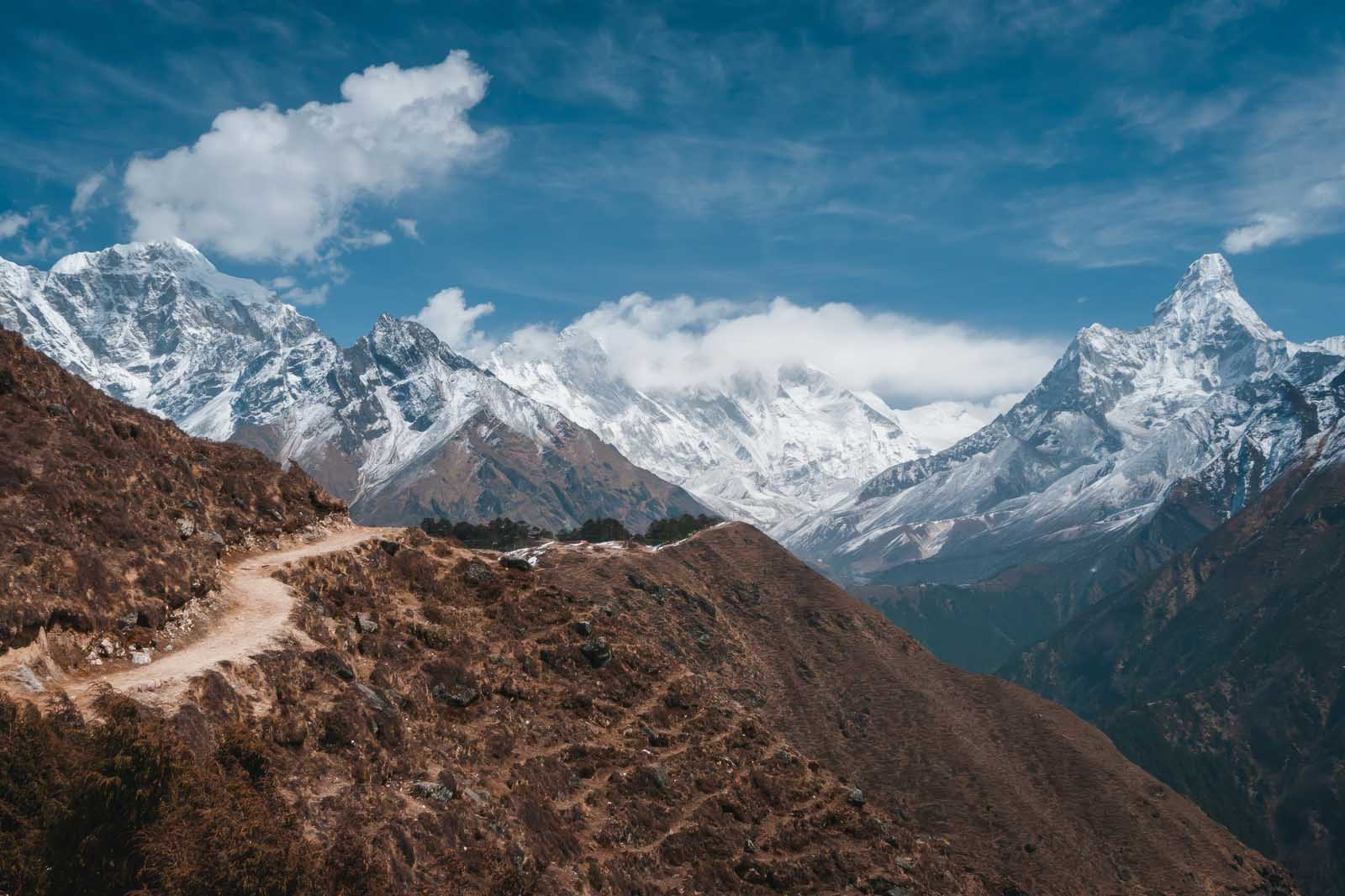
The deep Khumbu valley views were magnificent. The river wove far below, carving through the panorama of the white mountain tops. We walked a narrow trail snaking along the side of a steep mountain and suddenly realize “this trek has become real.” We were high in the Himalayas and one false move could mean catastrophe falling into the abyss below.
The sky was a deep blue and the white summits reached toward the billowing clouds. The view was so awe-inspiring it brought me to tears. Everything was so crisp and clear. During the EBC trek, you feel as if you could reach out and touch heaven.
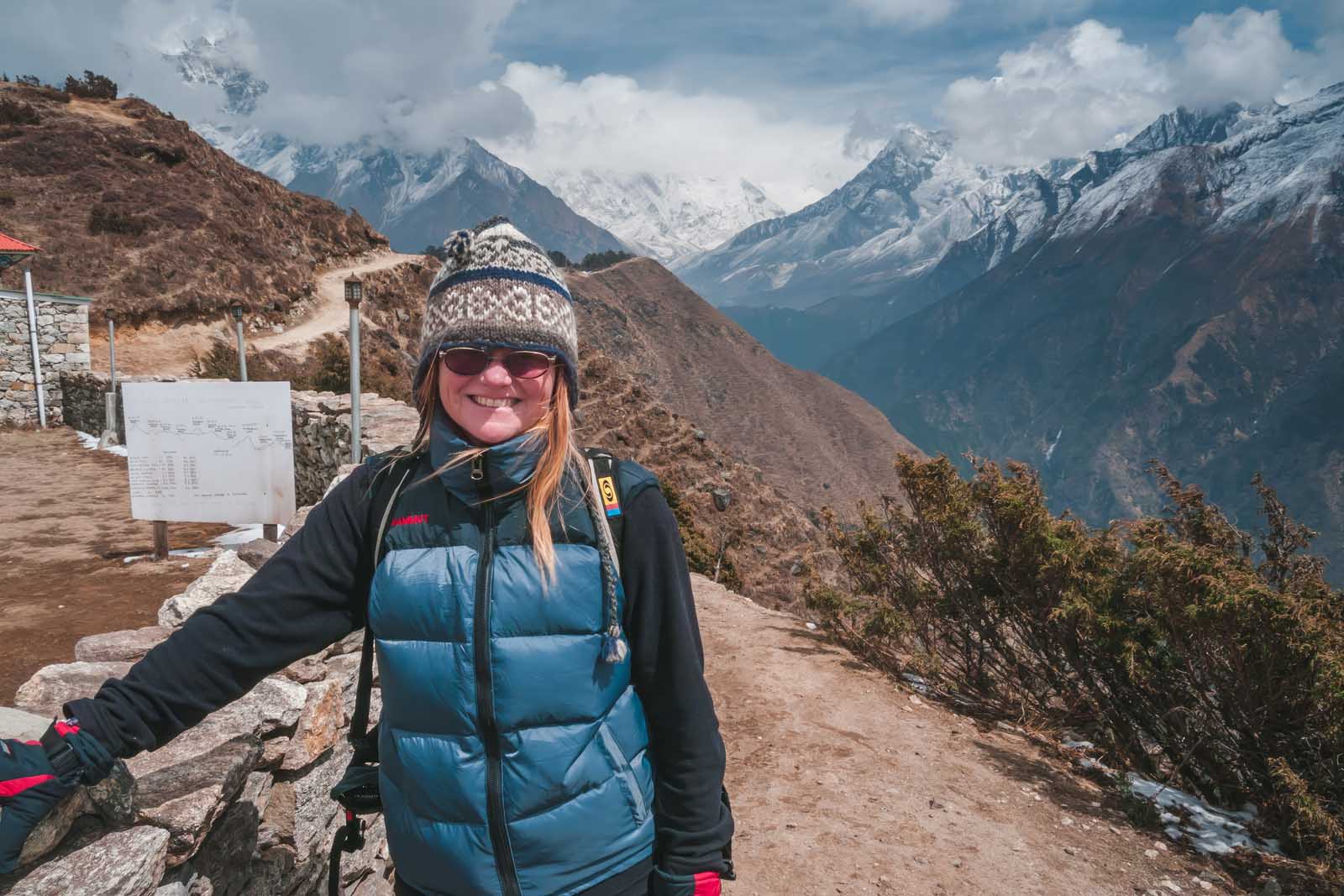
The clouds rolled in quickly so it was time to go. The weather conditions change quickly on the Everest base camp hike, so it is good to have the experience of a guide leading us through all terrain and conditions. We went back to Namche Bazaar to relax and gain strength for the rest of the trek.
Namche Bazaar – Elevation – 3440 meters. (11246 feet) Everest View Hotel – 3880 meters (12,730 ft.) Elevation – Bounce of 440 meters (1443 feet) Duration – 3 hours return Elevation Gain – 0 km
Day 4 – Namche Bazaar to Tengboche
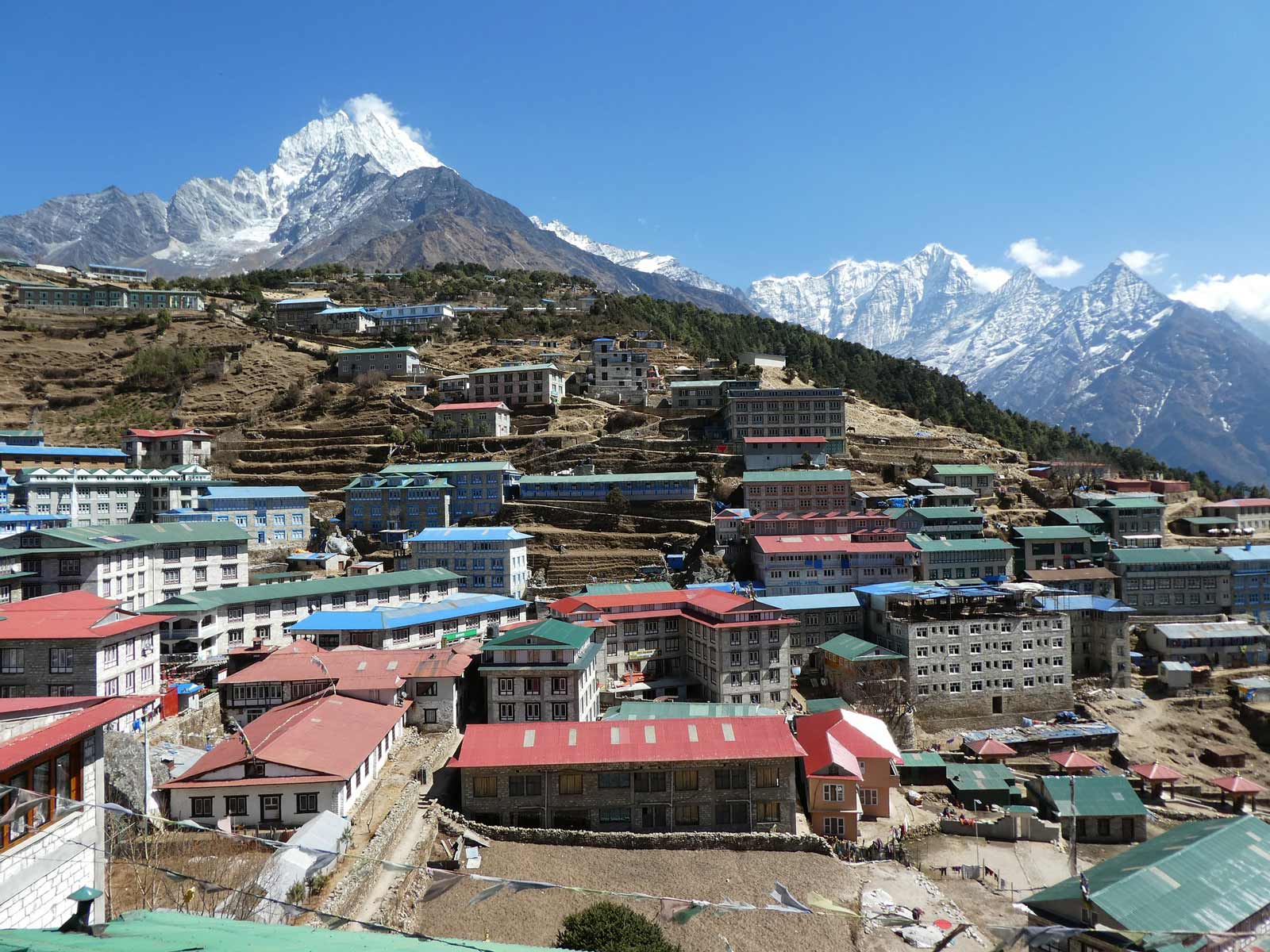
We awoke earlier than usual on Day 4. Two large group treks (Intrepid Travel and G Adventures) had checked into our lodge and we didn’t want to have to compete for service or breakfast. We also didn’t want to have to wait in line for the bathroom.
Lodges become more and more sparse as you go higher on the Everest Base Camp Trek and fewer toilets are shared between more people. Up until now, we hadn’t encountered crowds of people. It had been pretty quiet on the mountain and we liked it that way.
Luckily, we were a day ahead of the other tours. They had to stay in Namche Bazaar for another day to acclimate to the high altitudes, So we moved on to enjoy our EBC Trek free from crowds of people – for now.
Tenzing Norgay Memorial Stupa
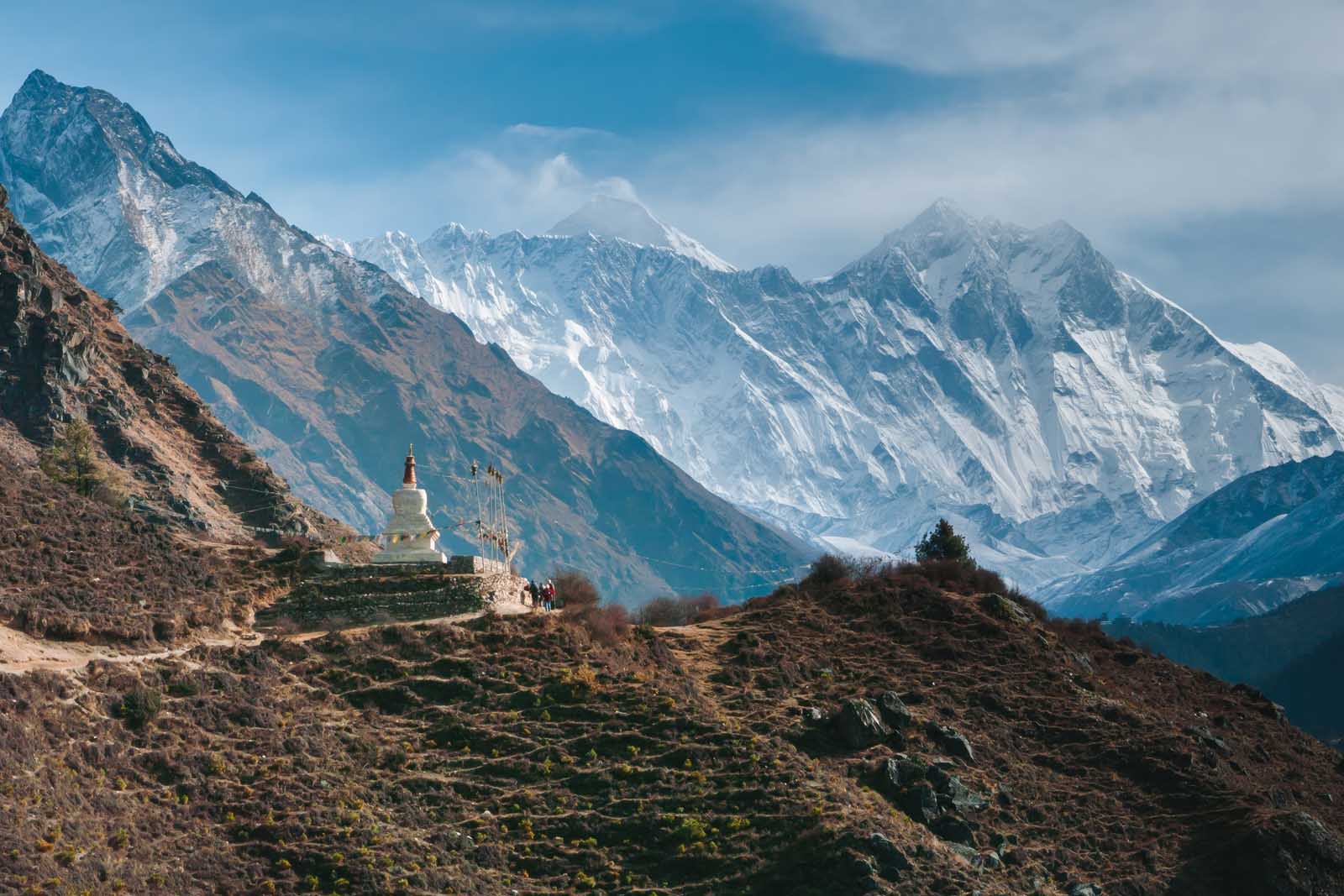
During day 4 of the EBC trek, we hiked along trails clinging to the side of the mountain. The narrow trekking trails along this route were a little scary. They wound along the edge of the cliff with nothing but a sheer drop to the abyss into the Khumbu Valley. But we kept our wits about us putting one foot ahead of the other until we reached the Sherpa Monument.
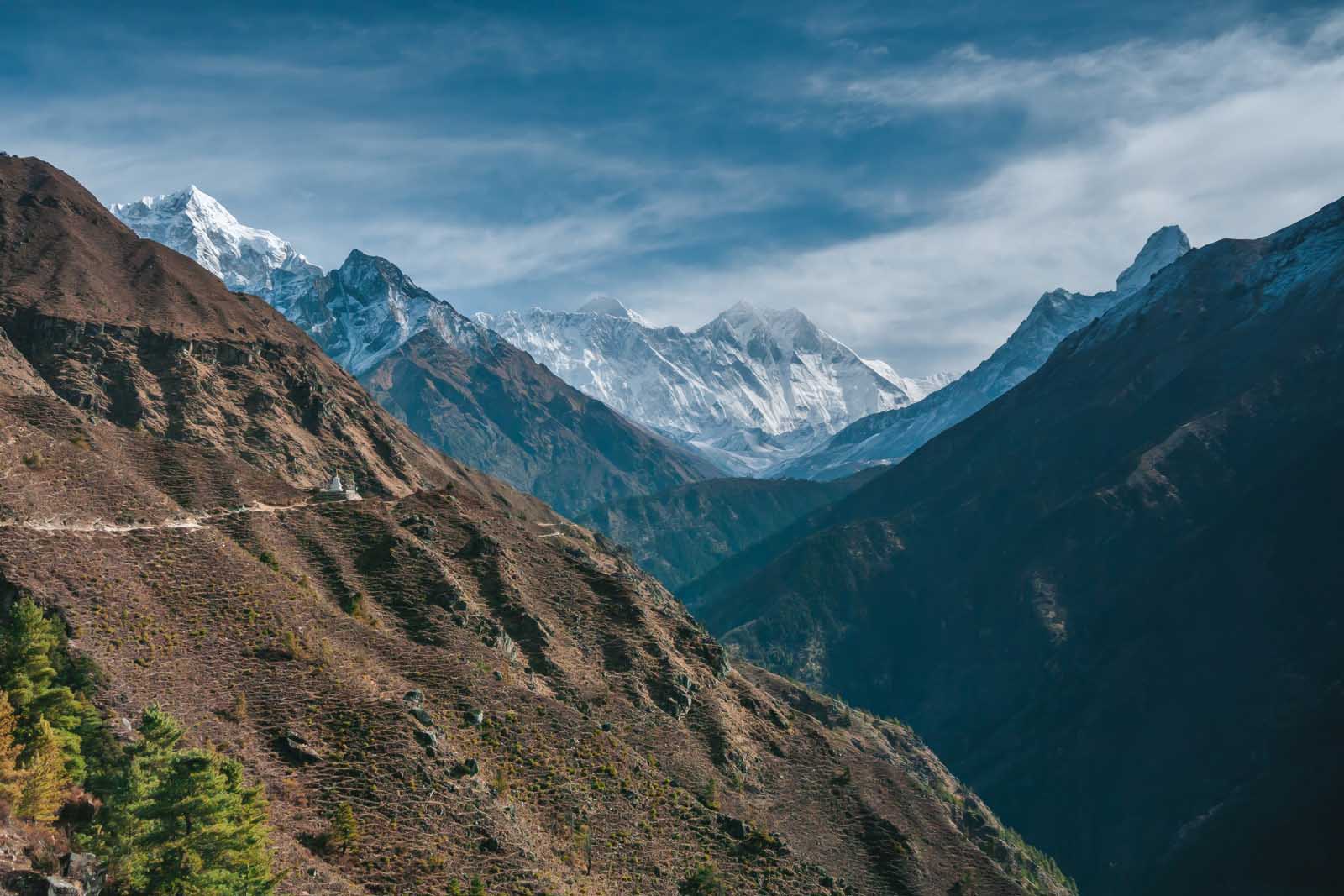
Tenzing Norgay Sherpa monument was erected by the Norgay family. It is a stupa honoring Tenzing Norgay Sherpa and all the Sherpas that risked their lives to help climbers reach the summit of Mt. Everest.
All treks pass this monument and it is an important stop on the journey to pay respect to the famous Sherpa of the Everest region. In case you don’t know, Tenzing Norgay Sherpa was the first man to summit Everest along with Sir Edmund Hillary.
What is a Sherpa?
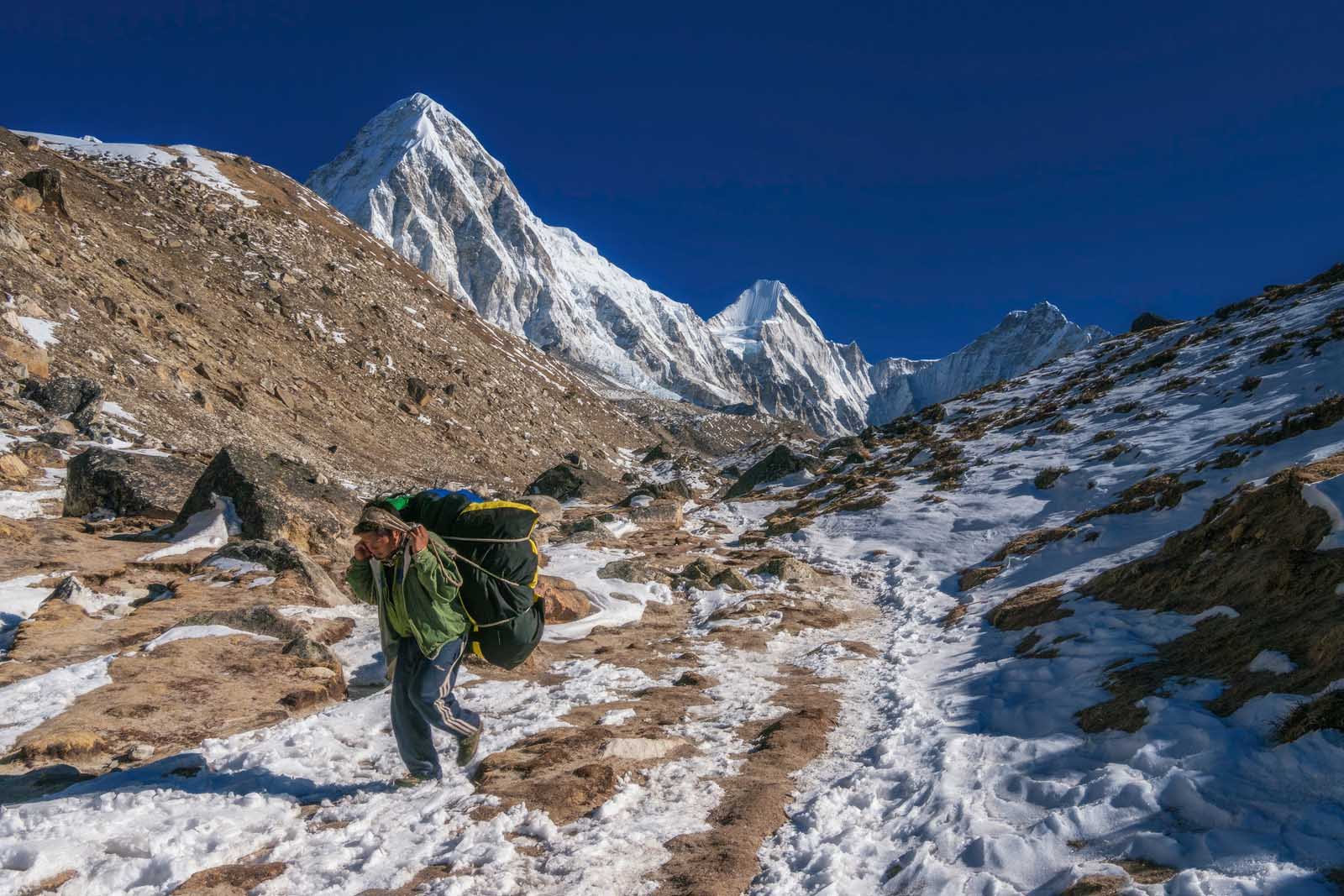
Sherpas are the unsung heroes of Mt. Everest. They do all of the hard work and technical work on the mountain. They carry the heavy loads, set the ladders and ropes to cross the Hillary Step and Khumbu Icefield for mountain climbers, and they take care of setting up camp while climbers and trekkers catch their breath and try to survive life on the world’s highest peak.
Difference Between a Sherpa and a Porter
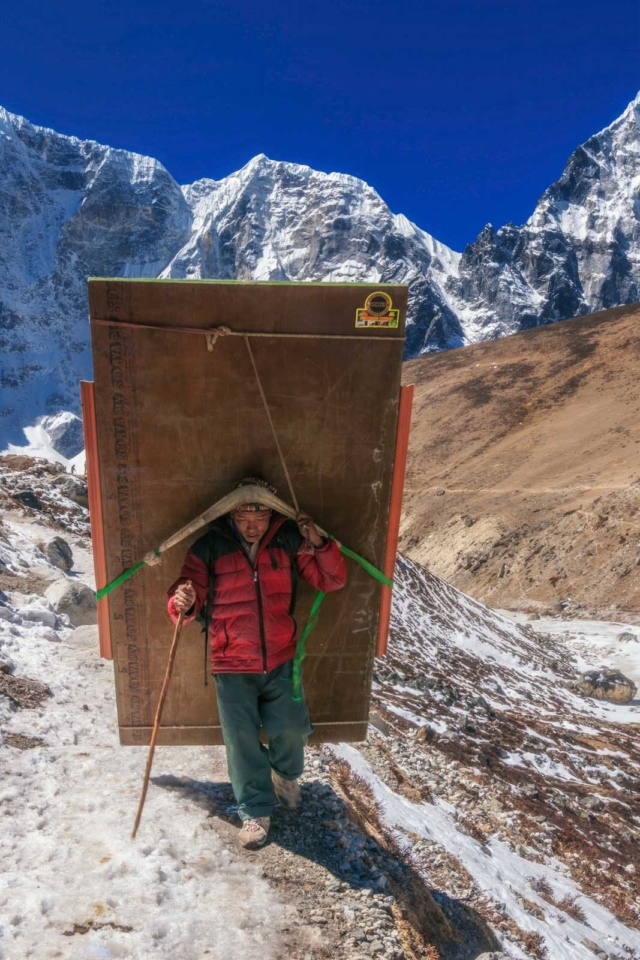
Sherpas and porters are very different from one another. We learned that a Sherpa is actually the name of an ethnic group from Tibet. The original mountaineers hired Sherpas as their guides in the Himalayas and the world has now adopted the name for porters in the Everest region. If you aren’t born into the Sherpa ethnic group, you cannot be called a Sherpa. Porters are porters and Sherpas are Sherpas.
We were told that some porters, especially commercial porters carry up to 60kg (150 pounds) of supplies and gear to businesses located along the EBC trek. That is a lot of weight and we were very surprised. When climbing Mount Kilimanjaro , porters had a mandatory weight limit of 35kg. (77 pounds).
Dipendra told us that they get paid per kilo so some people push it too far. The Nepalese are a strong bunch but this is a lot to carry at such a high altitude no matter what shape you are in.
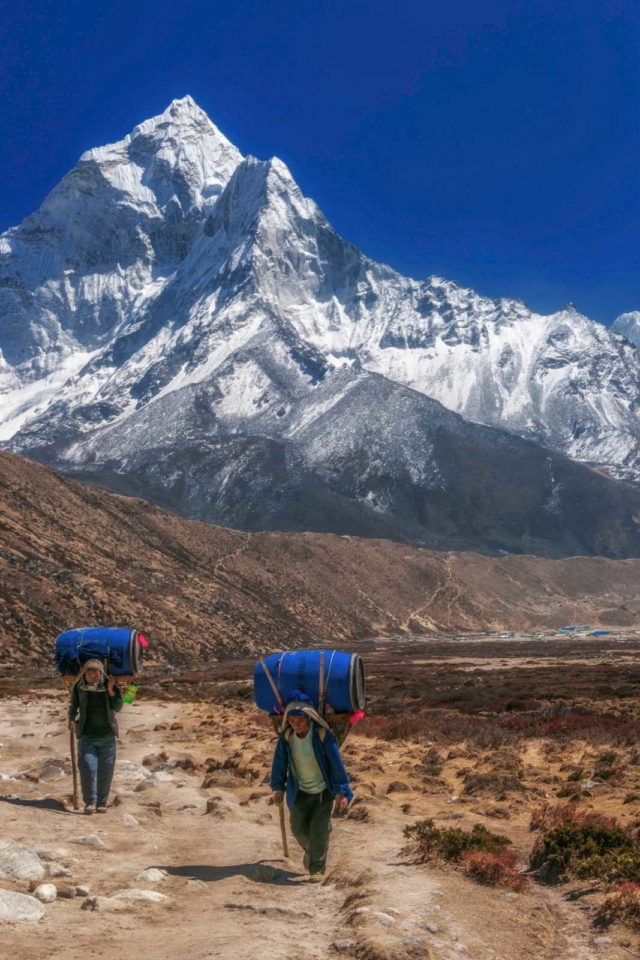
We kept our pack as light as possible at around 22kg (48 pounds) for Sher and we even felt bad about that! We have heard there is a 30kg (66lb) limit for Everest, but judging by what we saw other porters carrying on the Everest Base Camp hike, people were pushing it well beyond that.
We saw men carrying stacks of plywood with heavy white sacks loaded on top. We saw men carrying propane tanks, doors, and huge packs. What could people possibly need on the EBC Trek that they packed their packs so full? Read more: Packing List for Everest Base Camp Trek
Approaching Tengboche
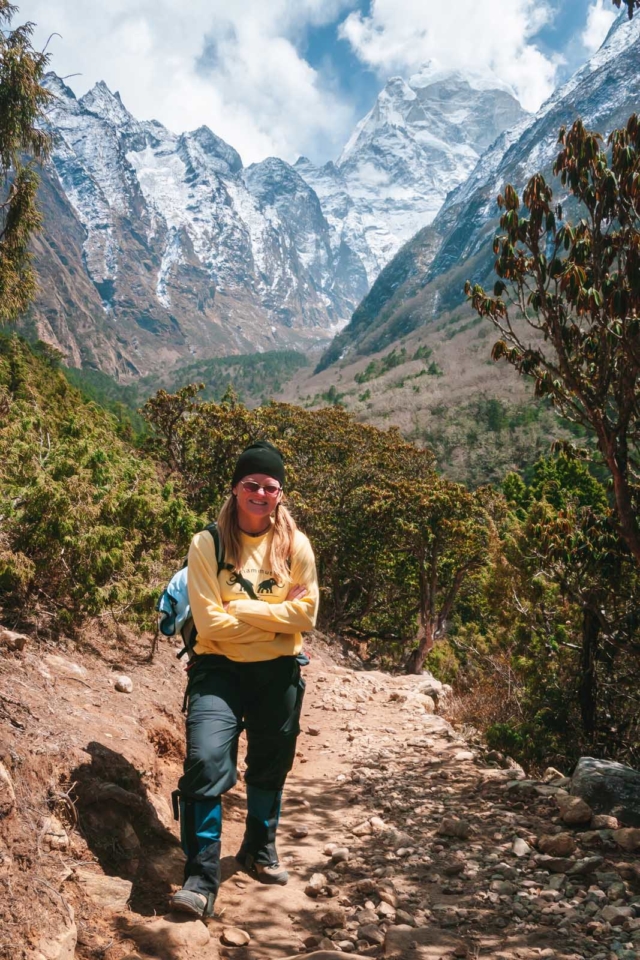
The final push of our EBC Trek day 4 was to Tengboche Monastery. It was a tough yet steady 2-hour steep climb. We are now gaining altitude climbing above the tree line. We put our heads down and huffed and puffed our way up. We didn’t stop for any photos or videos and were surprised to cut the climb down to just one and a half hours.
We reached the prayer wheels of Tengboche Monastery just in time for light snow to start falling. We made it into our camp at Tengboche by 1:30 pm and had the entire afternoon to ourselves at 3900 meters (12795 feet). This is an excellent place on the Everest Base Camp hike to have some extra time to relax as there are a few special things to see and do.
Tengboche Monastery
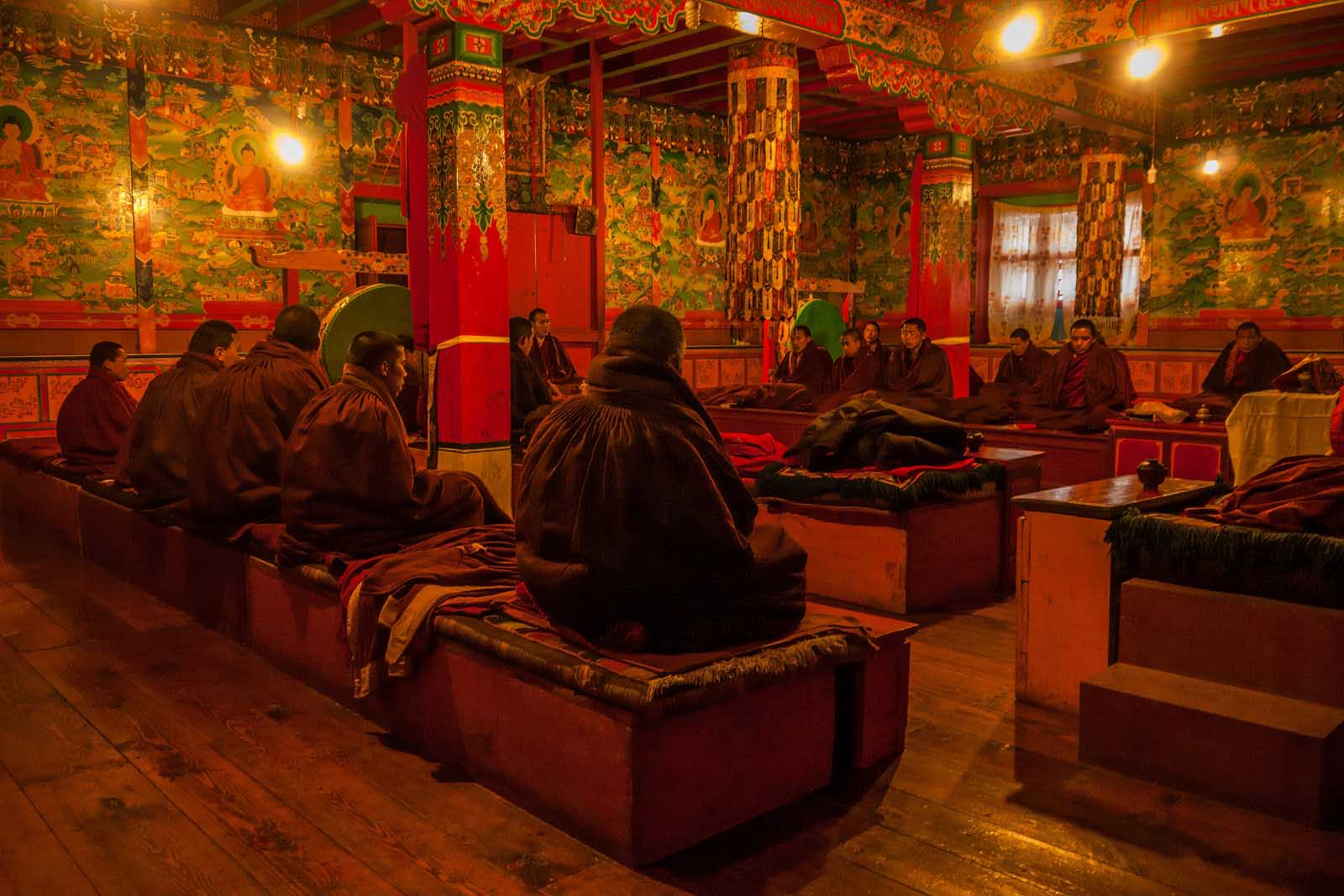
We warmed our feet with our new down booties that we bought at Namche Bazaar and changed into some dryer clothes before heading off to see the monks chant at Tengboche Monastery. Our guide Dipendra told us that this is the most important monastery in the region. All climbers summiting the mountains stop at this monastery to be blessed by the monks.
We were allowed to watch the ceremony and to take in the warmth and blessings from the monks. It is a sacred place and all climbers and trekkers stop here before continuing up the mountains.
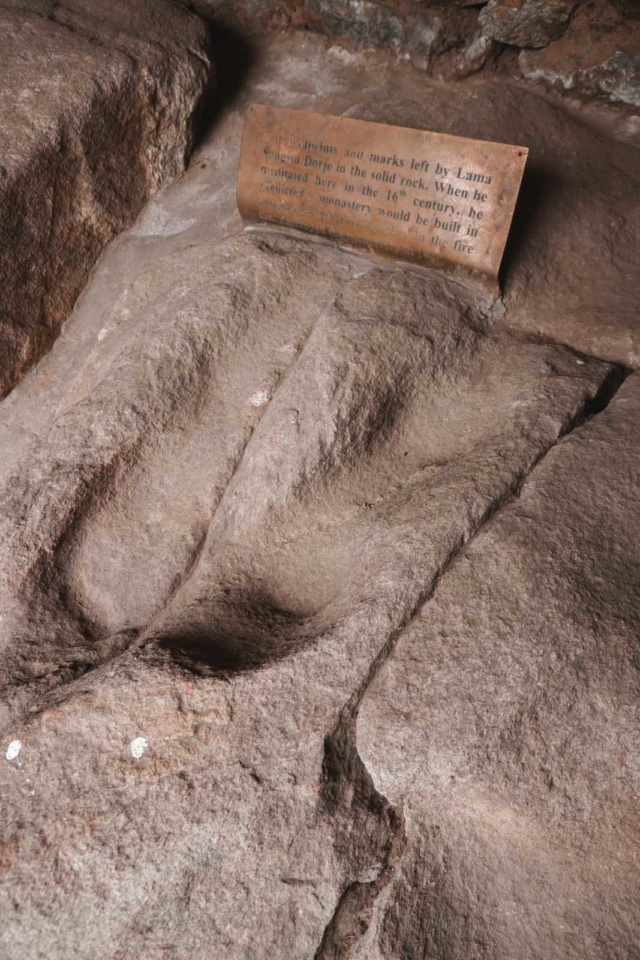
The footprints of Lama Pagna Dorje from the 16th century are embedded in solid stone in front of the monastery. A place where he mediated and raced through the Himalayas riding the wind with his mind.
Apparently, he sat on this stone for so long, his feet left their mark. He spent years traveling the world through the power of his mind and we believe the story. Especially after our yoga experience in Goa India. He predicted that a monastery would be built here and surprise surprise…here it is.
The View from Tengboche Monastery
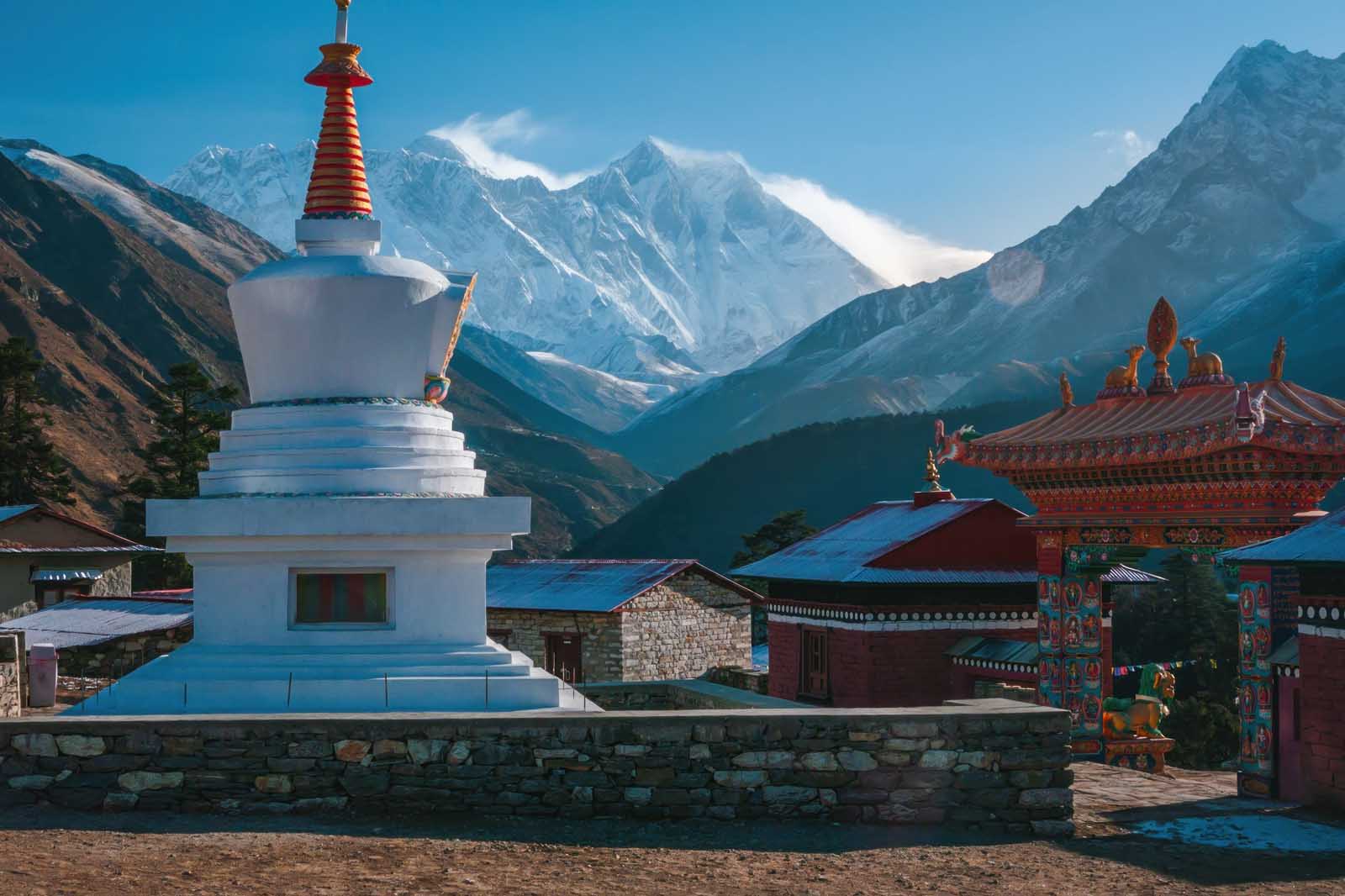
The view is magnificent from Tengboche Monastery. The valley is wide and opens up to massive rolling hills giving way to the highest peaks on earth. Plus it has a clear view of Mt. Everest and the surrounding mountains.
We were told that Sir Edmund Hillary came back to survey the peak of Mount Everest from this spot because the view is so clear of the mountain and we can understand why.
Accommodation – Basic Tea Houses at Higher Altitude
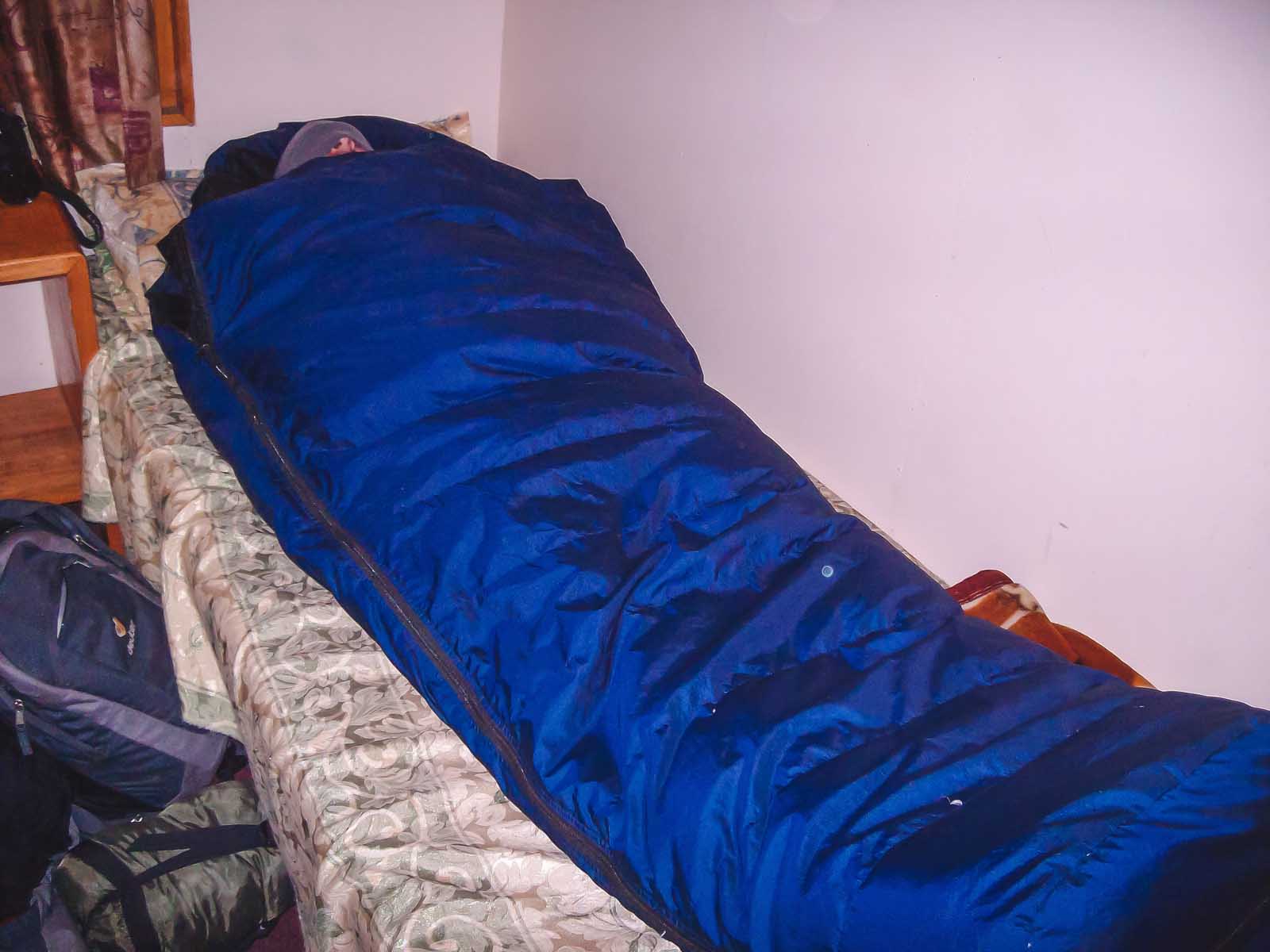
At this high elevation of the EBC trek, accommodation became very basic and rustic. We felt like true adventurers as we sat by the fire warming our feet and bonding with our fellow trekkers over our shared experience by candlelight.
There were 10 of us staying in this teahouse. All are sharing electricity to charge our camera batteries. Meals were now vegetarian and wood stoves were heated by yak dung. At this high altitude, meat cannot be transported fast enough to stay fresh and regular wood is scarce, so yak dung it is.
When we went to bed, our room was freezing. Rooms are not heated at higher elevations. We had our own room, but I sometimes wonder if sleeping in a dorm would have helped with more body heat. The temperature easily dipped down to -10 Celcius (14 degrees Fahrenheit) and our plywood walls didn’t offer a lot of comforts.
We tossed and turned all night long trying to keep our noses warm in our sleeping bags wearing our down jackets, thick socks, and thermal mid-layers.
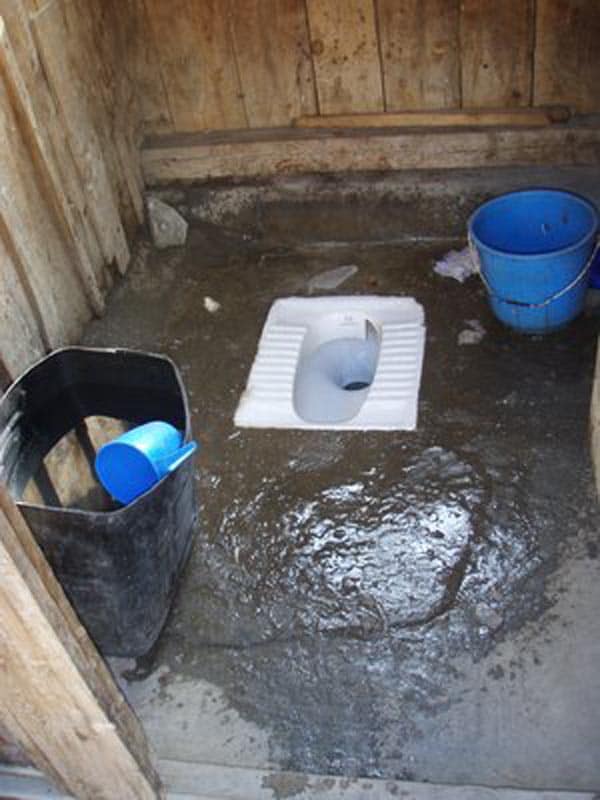
It was so cold the scoop bucket for the shared squat toilet froze over forming a patch of ice to form on the floor. It was a slippery trip to the outhouse. Sadly, we always have to pee a lot during the night when sleeping at high altitudes so we visited that toilet a lot.
Hot Tip: Pay for hots showers at lower elevations You won’t regret it! We realized that we should have paid the 250 Rupees for the hot showers offered at the accommodation in Namche Bazaar. Now that the weather was so cold there was no way we could face a bucket bath in a freezing shed. Dave and I set a new record in these mountains of Nepal, 9 days without a shower!
Namche Bazaar – Elevation – 3440 meters. (11246 feet) above sea level Tengboche – 3860 meters (12664 feet) Elevation Gain – 420 meters (1378 feet) Distance – 9.3 km (5.77 miles) Duration – 3 hours (without stopping) 5 hours for photos, lunch and rest.
Day 5 – Tengboche to Dingboche
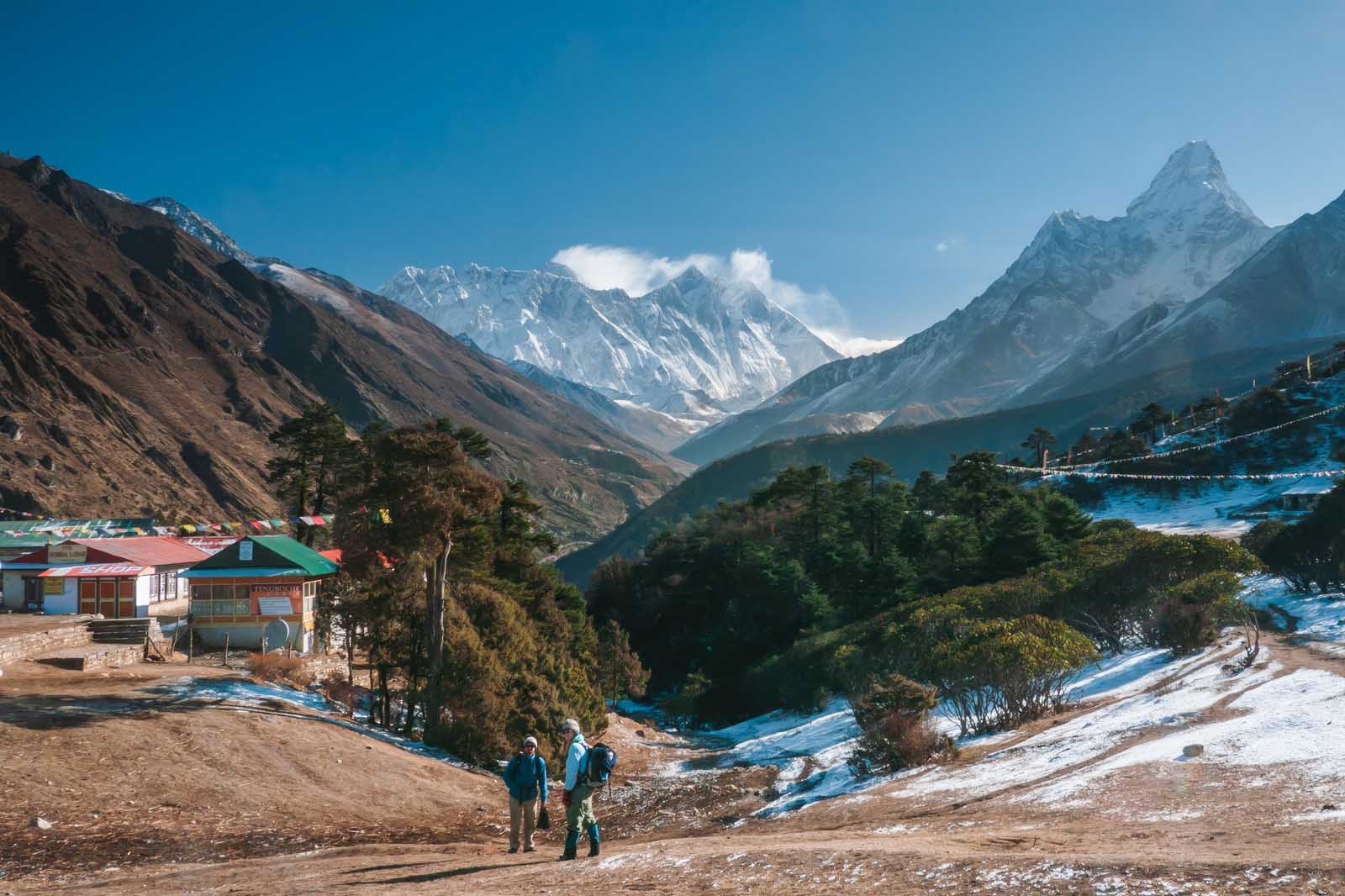
Day 5 of the EBC Trek was freezing! We had an early wake-up call and morning came too quickly on the Tengboche leg of the EBC Trek. But, we awoke to a winter wonderland of fresh snow at the Tengboche Monastery and clear views of Lhotse peak.
The snow from the night before made for more incredible views on the hiking trails. As we started out from the lodge, the sky was crisp and clear, showing Mount Everest in all its glory. It was stunning, and in between gasping for air, we admired the view.
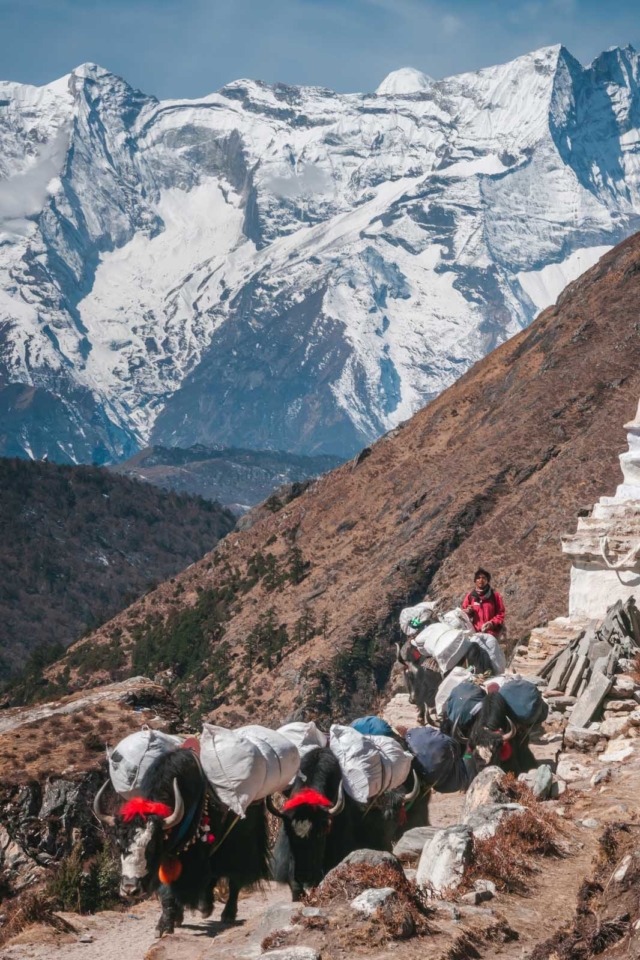
Today we walked to higher altitudes and saw our first trains of wooly yaks. Yaks cannot survive at low altitudes because it is too warm for them, so you don’t see yaks on the Everest Base Camp hike until at least 3000 meters. (9800 feet) They are beautiful.
Yaks on the Trek to Everest Base Camp
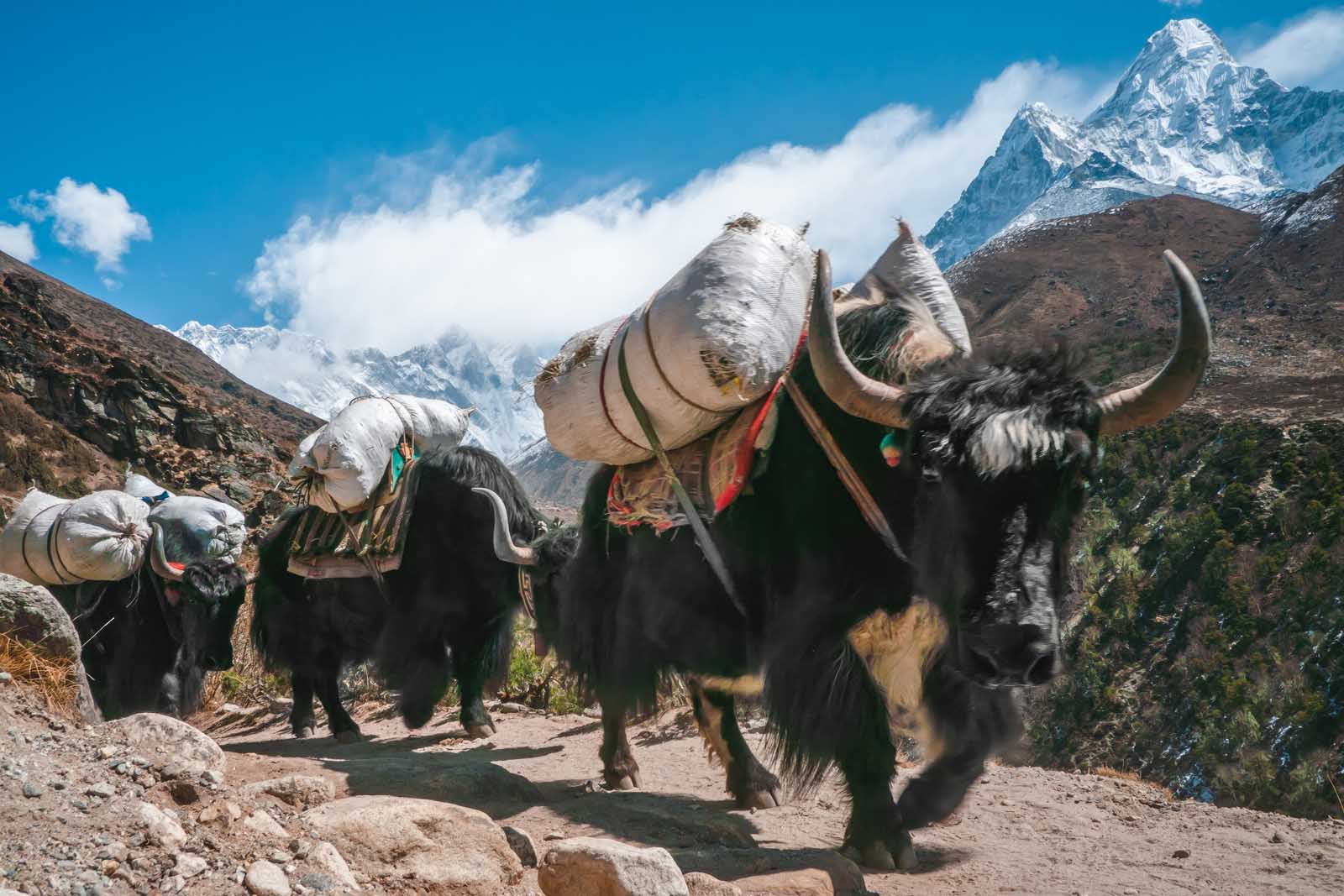
Woolly yak trains were more frequent and by day five of the EBC Trek, we had our system perfected to give them the right of way without letting them nudge us off the mountain.
As we said earlier, it is important to give yaks space. They will run you right off the mountain if you are in their way. Be sure to stand on the mountainside as they pass so you don’t get knocked over the edge. The yaks of the Everest Base Camp trek, have only one thing on their mind. To get to their destination.
On this day, signs of expeditions going up to summit Everest started to go by as large groups of yaks carried giant loads of climbing gear. It is exciting to think that we were walking the same route as so many great mountain climbers, like Sir Edmund Hillary and Tenzing Norgay Sherpa.
The Trek from Tengboche is breathtaking
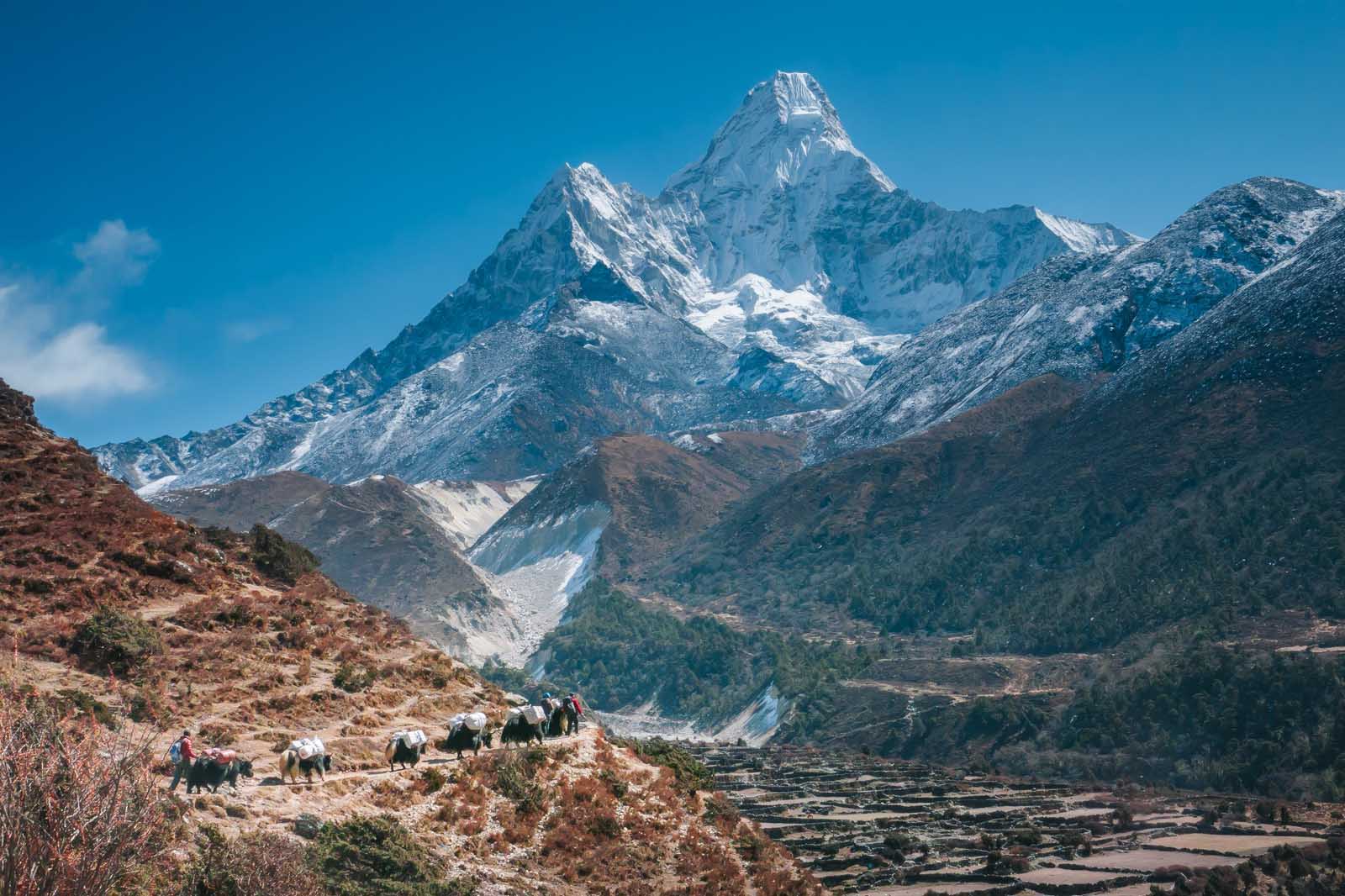
I conquered what little fear of heights I had left this day. Some of the narrow paths on the route dropped sharply into the deep valley below. Soon we found ourselves walking along the ledge not thinking at all about the dangers below. We hiked for a couple of hours before stopping for tea at a restaurant in Pangboche.
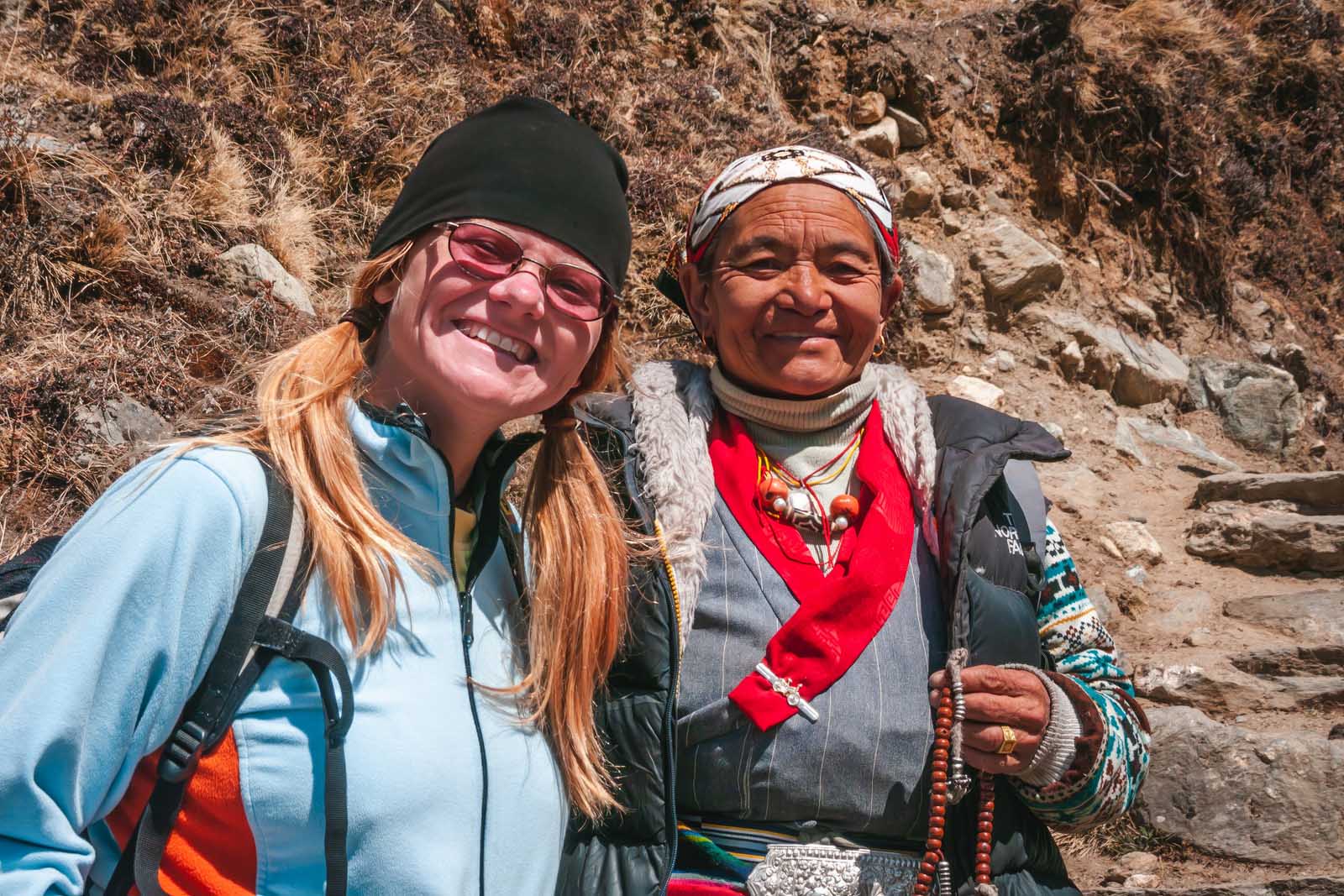
There are shops, teahouses, and restaurants along the route so we could buy lunch along the way and one of the more popular stops is in the village of Pangboche. After a tea stop in Pangboche, we met a sweet lady that walked with us all the way to the village of Dingboche. Her name was Yangshou and she waited for us as we struggled up hills and crossed the suspension bridge over the Imja Khola River.
Her cute laugh and quiet prayers helped to pass the time. She stopped to talk to everyone on the trail while we plugged along. She’d fall far behind when she chatted with friends, only to quickly catch us and then scoot by us with ease. She must have enjoyed our company because we really slowed her down. “ Yangzhou, we will always remember your smiling face!
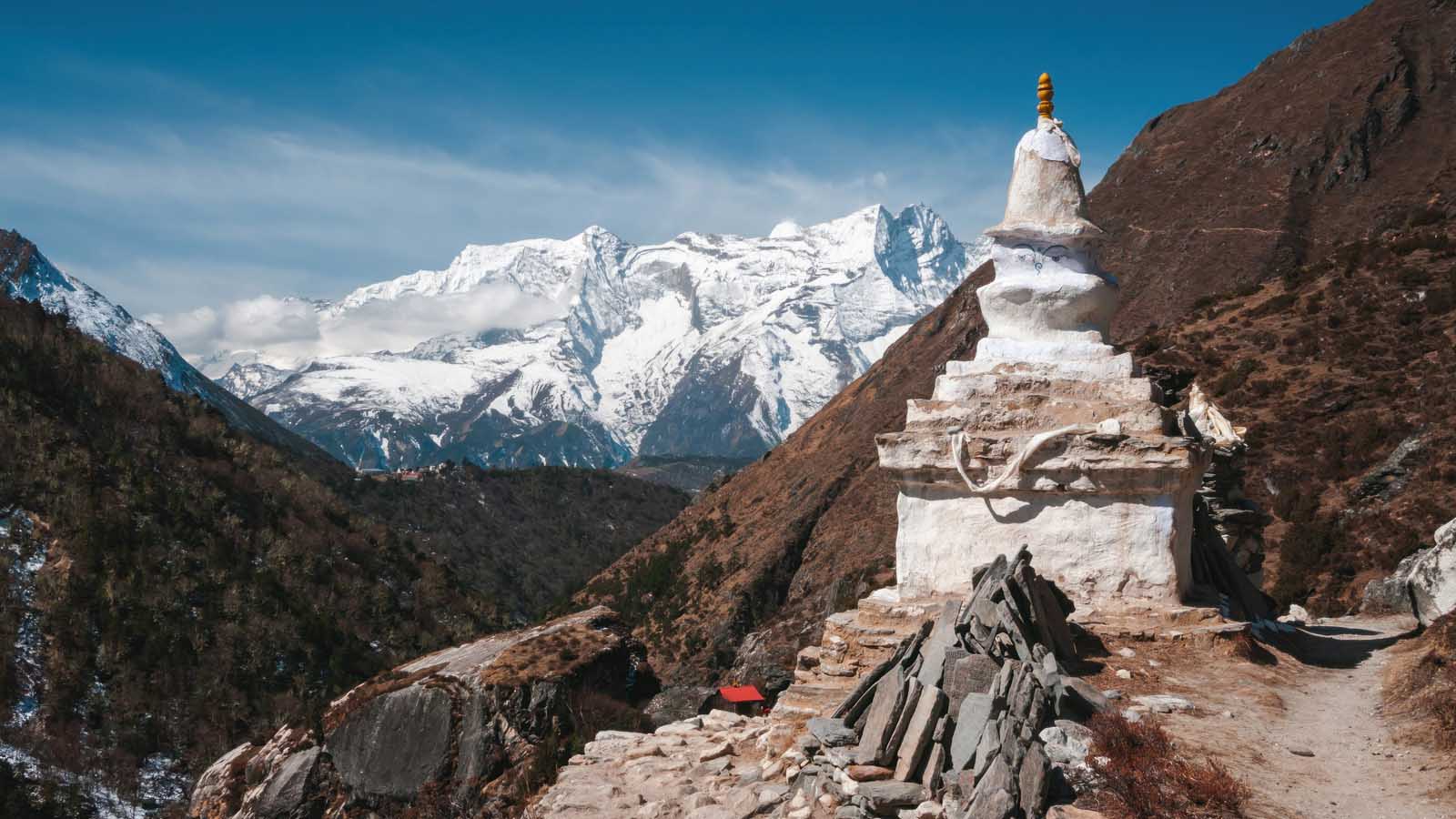
We spent the night in the village of Dingboche and wished that we had another night here. It is from here that you will see beautiful views of Island Peak and Lhotse, but it is also a good spot for another acclimatization day.
Tengboche – 3860 meters (12664 feet) above sea level Dingboche – Elevation – 4410 meters. (14468 feet) Elevation Gain – 550 meters (1804 feet) Distance – 10.8 km (6.71 miles) Duration – 3 hours (without stopping) 5 hours for photos, lunch, and rest.
Day 6 – Second Acclimatization Day at Dingboche
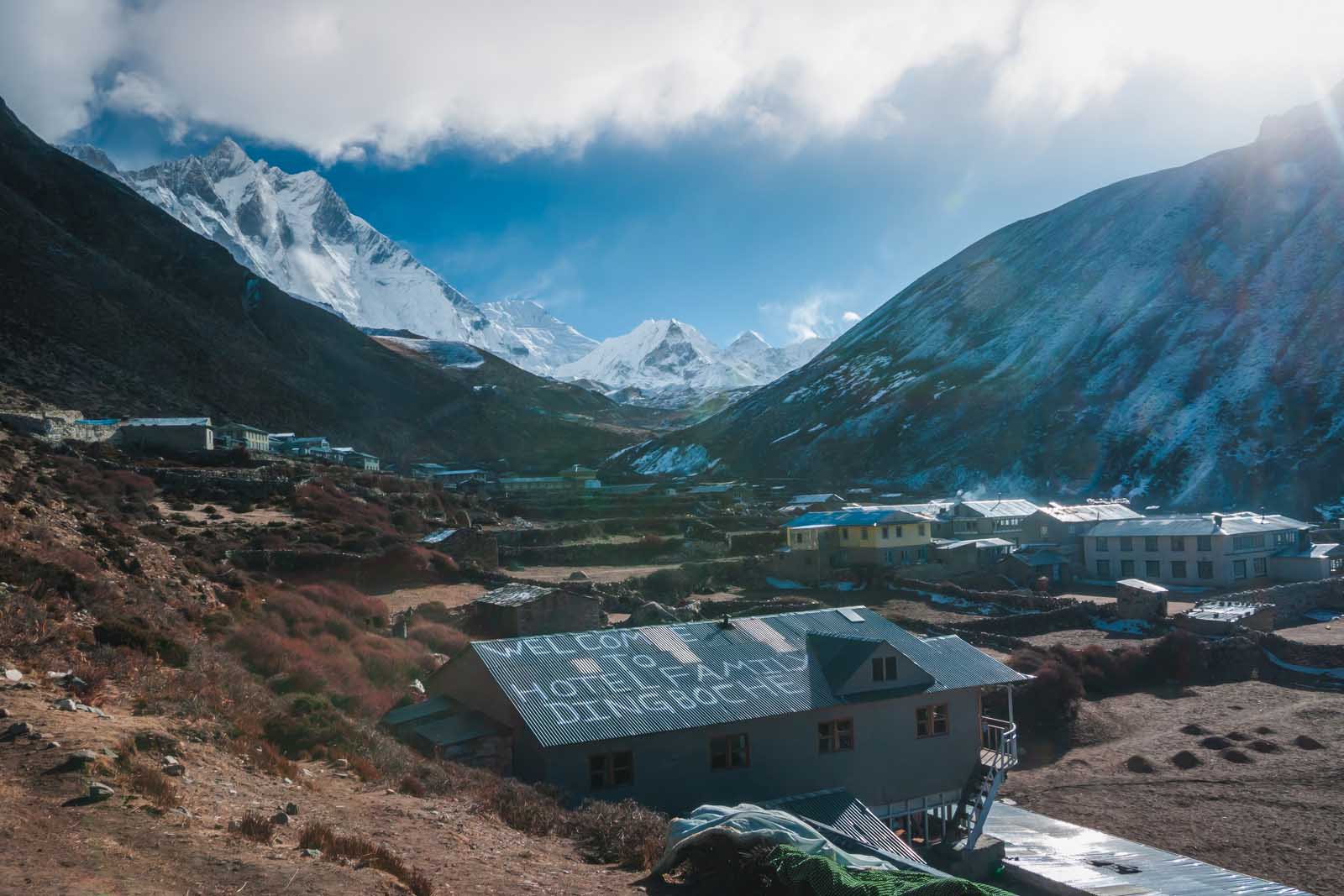
This is a day that most people spend acclimating to the high altitude. We did not do this day, but you should! So we are including it in the guide because it is a very important day when trekking to Everest Base Camp. If we were smarter, we would have spent 2 nights in the village of Dingboche where we would spend a day hiking up to Nagurjun Hill.
This is the best place for climbers looking to summit Everest, Ama Dablam (6812m), Lobuche peak (6,119 m), or Island Peak to do their acclimatization day. Dingboche is a small village in the Khumbu region with only a few guest houses, so it is a good time to relax, replenish and rejuvenate for the next push.
If we had brought our Lonely Planet Trekking in the Nepal Himalayas (which we forgot in Kathmandu and kicked ourselves about it every day) we would have realized that we should have taken an extra day to acclimate in Dingboche.
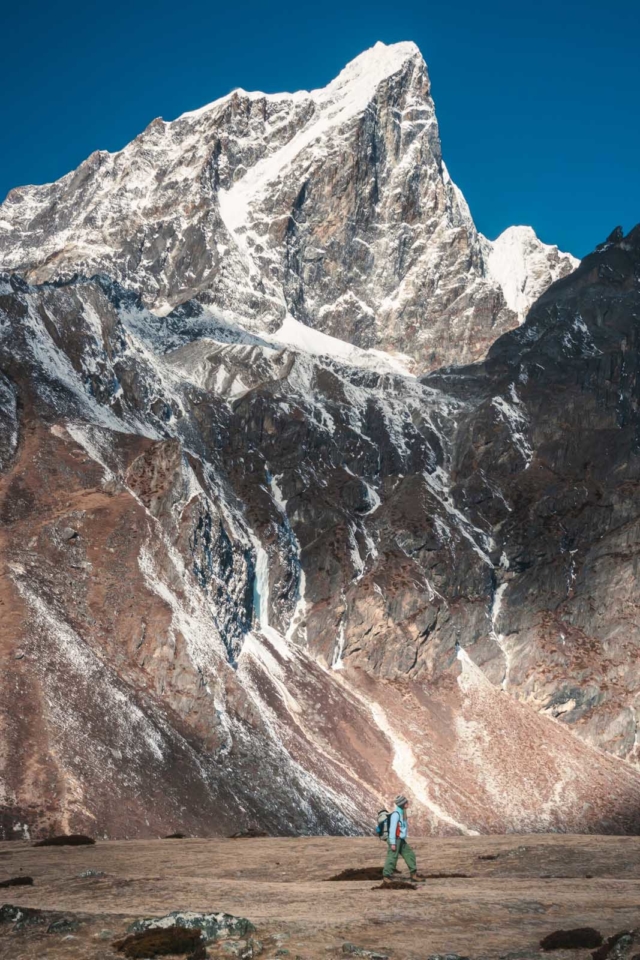
Dipendra was flexible so he would have easily added another day onto our trek, we just didn’t know any better to ask about it. Lucky for us, we felt strong, but other groups were complaining of headaches and dizziness.
In the end, we wish we spent the extra day here. Some people even spend two days here climbing to the surrounding peaks. We did suffer after reaching base camp and I believe that is because we didn’t spend time acclimatizing here.
Had we stayed, we would have done some light hikes to gain altitude and then come back down to rest at a lower elevation. Many people who are set to climb Island Peak or Kala Patthar stay here for a few days to get some practice climbs in.
Dingboche – Elevation – 4410 meters. (14468 feet) above sea level Nangkartshang Peak – Altitude – 5050 meters (16568 feet) Climb – 640 meters (2099 feet) Distance – 10.8 km (6.71 miles) Duration – 4 hours Elevation Gain – 0
Day 7 – Dingboche to Lobuche
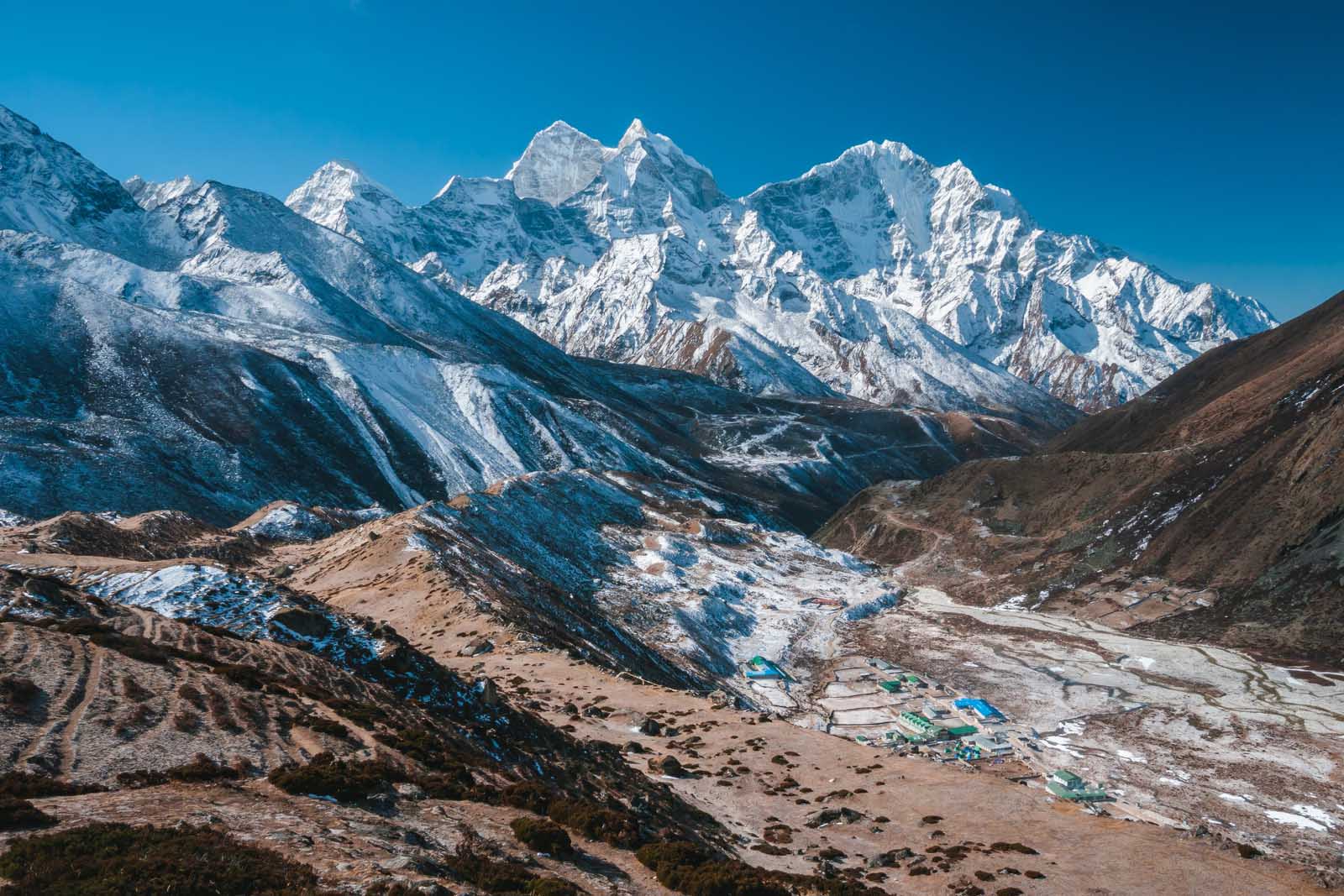
We walked with fellow trekkers we met at our guesthouse Martin and Richard from Slovakia during the morning hours. They carried their own packs and after watching them struggle, we were happy we hired a porter. (note: As of April 2023, you can no longer trek independently in Nepal) They were really starting to feel the altitude and we eventually left them behind.
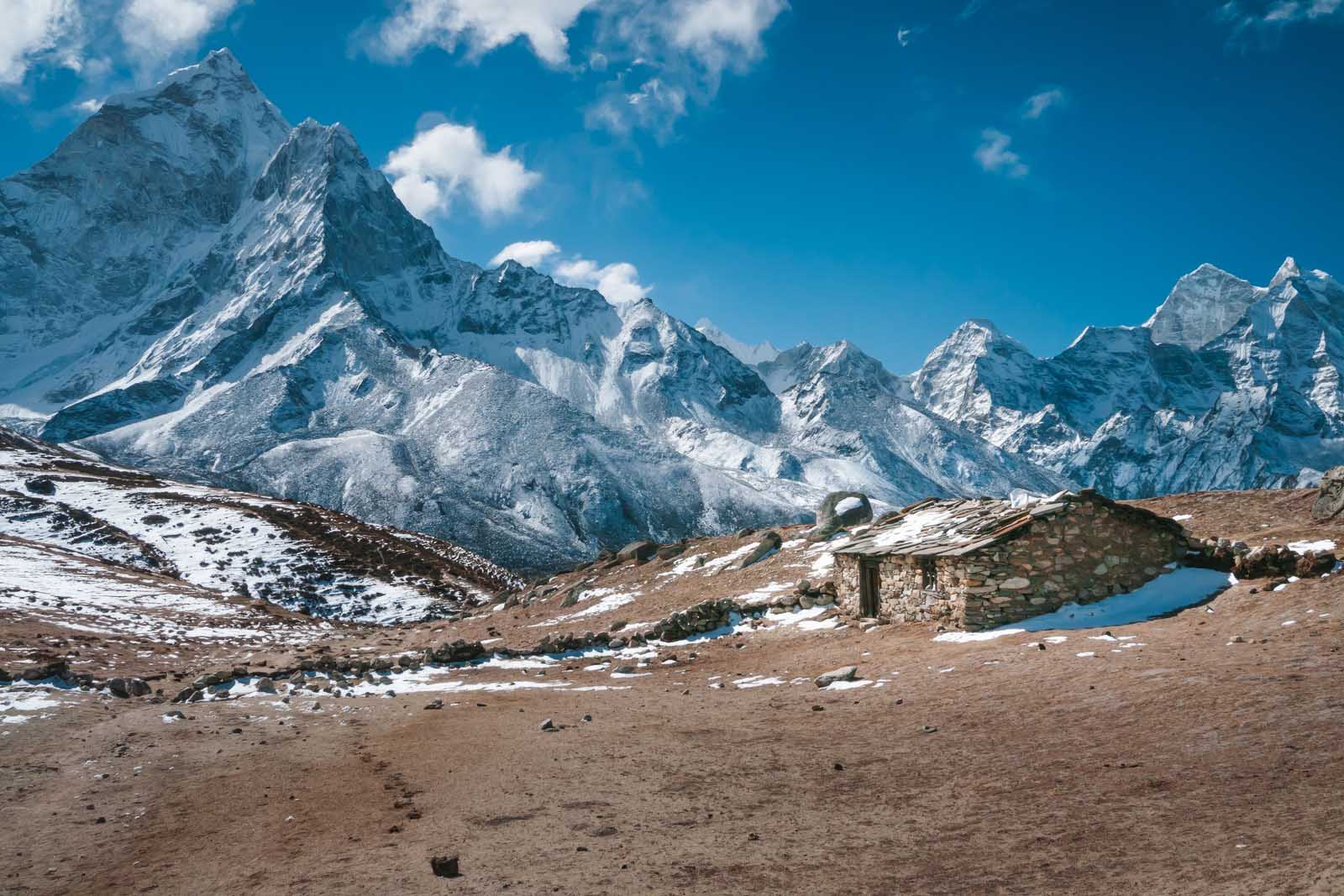
We enjoyed our day taking photos of the stunning clear views of the Everest region. It may be a little colder trekking in Nepal at this time of year (Early March), but the skies are clear and blue. When we came across a small cluster of houses, we felt like we had entered the Kingdom of Middle Earth. Little Hobbit houses lined a valley with giant peaks looming overhead.
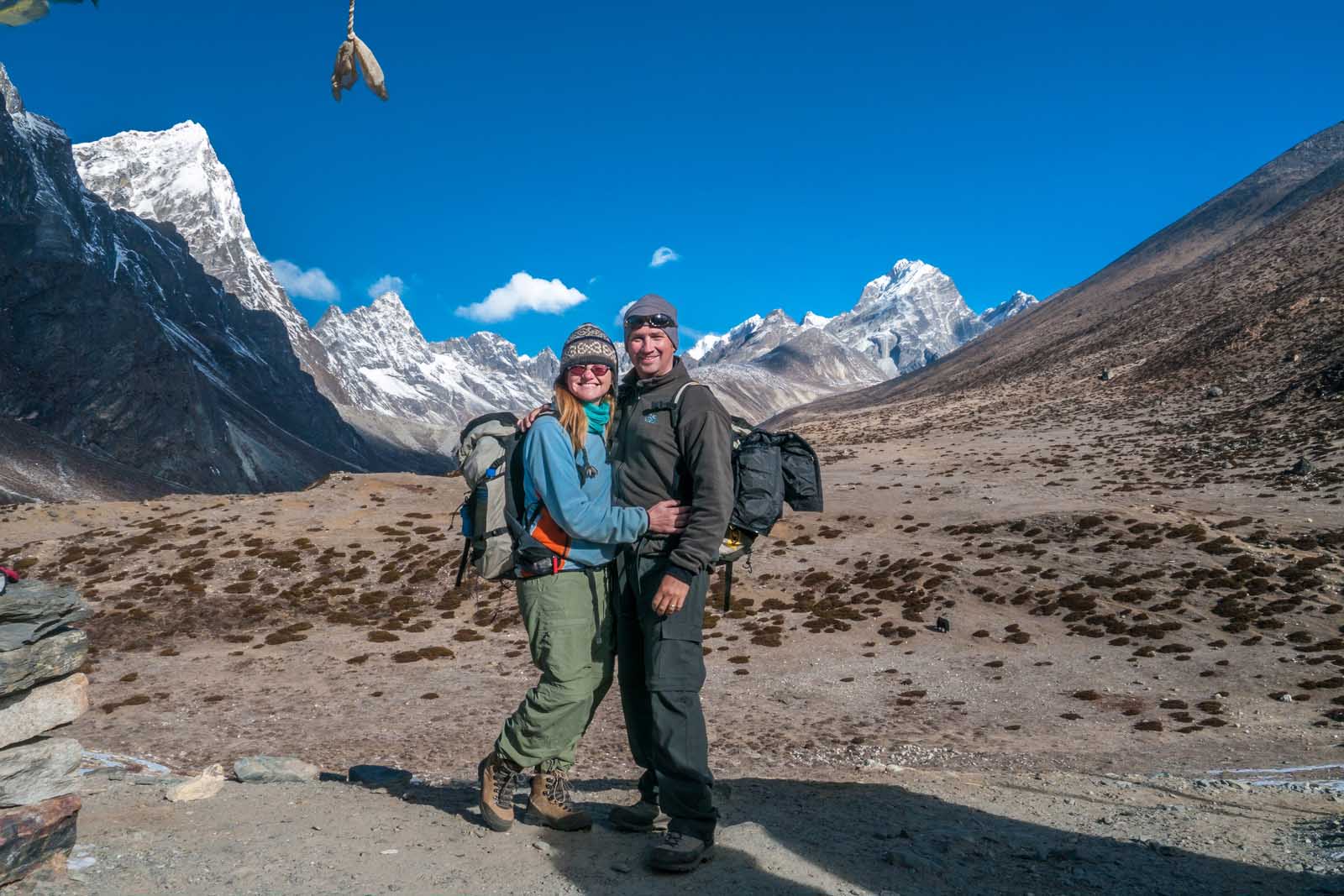
We had a front-row seat to some of the most breathtaking views on earth. An entire panorama of the mountains standing proudly overhead, reaching up to the deepest blue sky that I have ever witnessed. The scene took our breath away. The mountains looked more imposing with each corner we turned and we could not believe that we were fulfilling our dream of hiking to Everest.
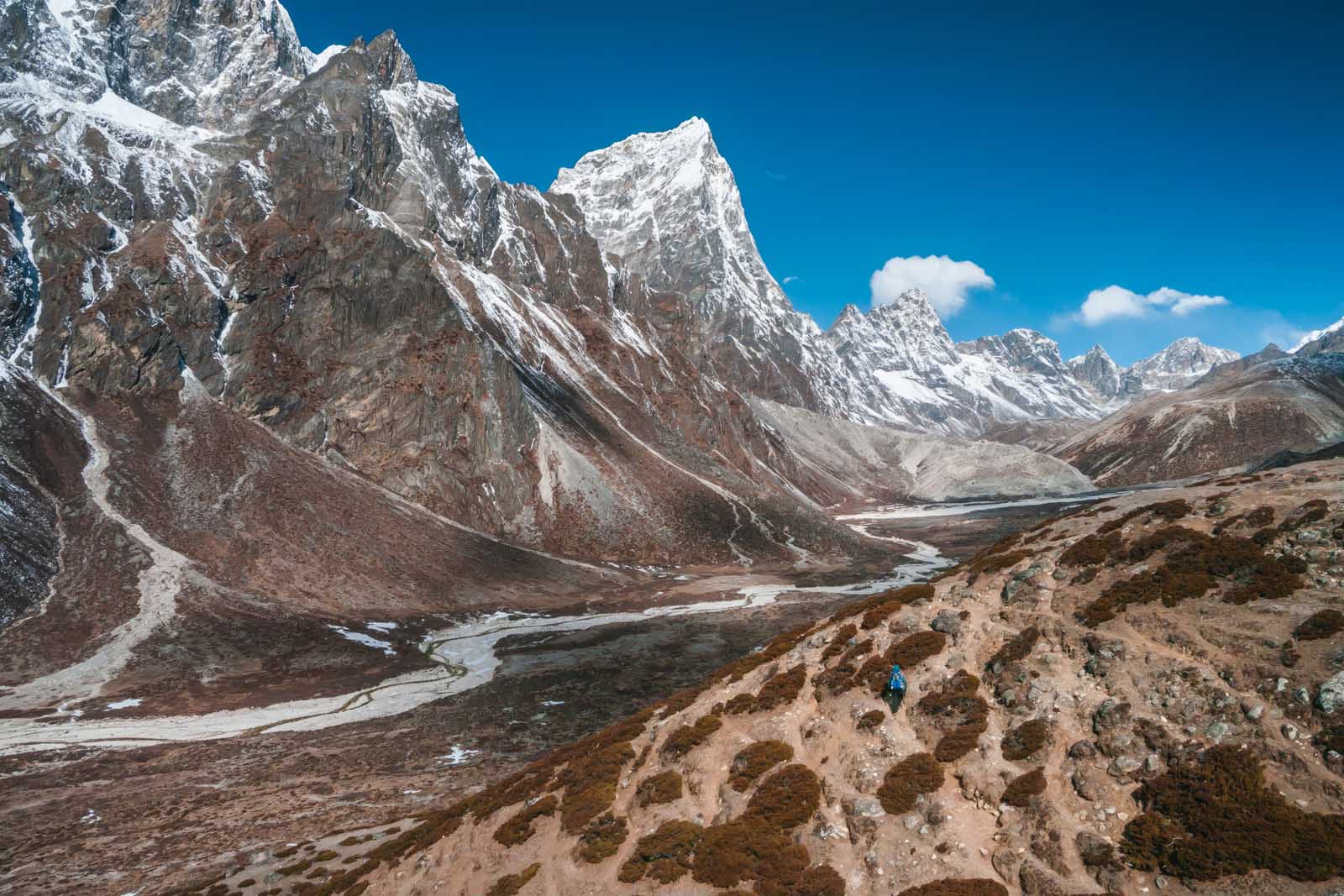
We had to knock on the door to see if Bilbo Baggins happened to be in. Sadly, he wasn’t home. I ended up singing Leonard Nimoy’s Ballad of Bilbo Baggin s for the rest of the day. A bad idea since I only know a few words.
Weather Conditions
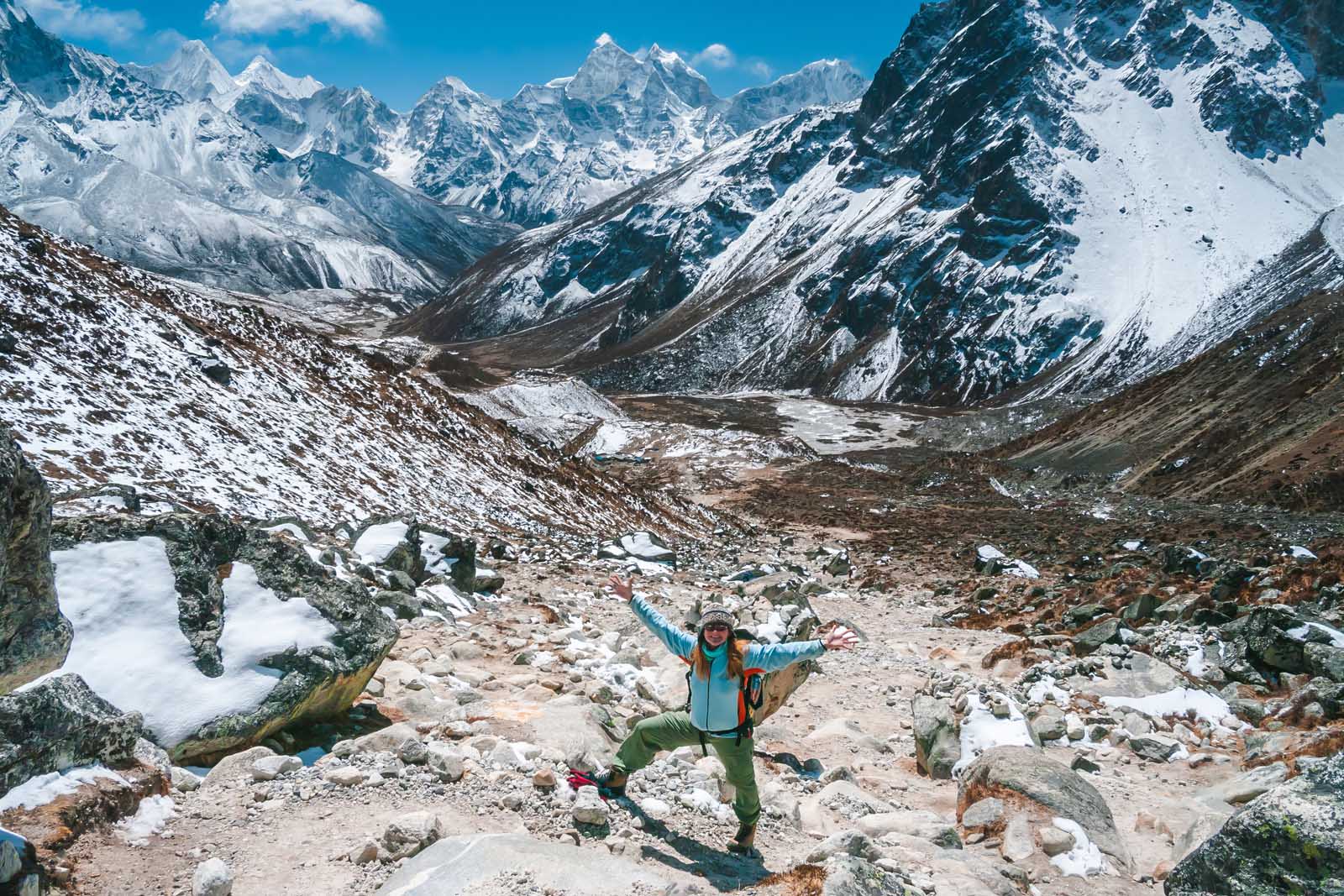
The wind picked up and we put on our outer layers for the first time. We were thankful to have them as we staggered through the high gusts. Weather varies greatly in the Everest Region and before you know it you can have inclement weather so be prepared with your layers. The sun can be shining one minute and then wind and clouds roll in the next.
After lunch, we faced quite the scramble up a steep hill littered with boulders. It looked like a tough climb, but we moved with ease and quickly made it to the top. Where we found our strength, I do not know.
Sherpa Monuments
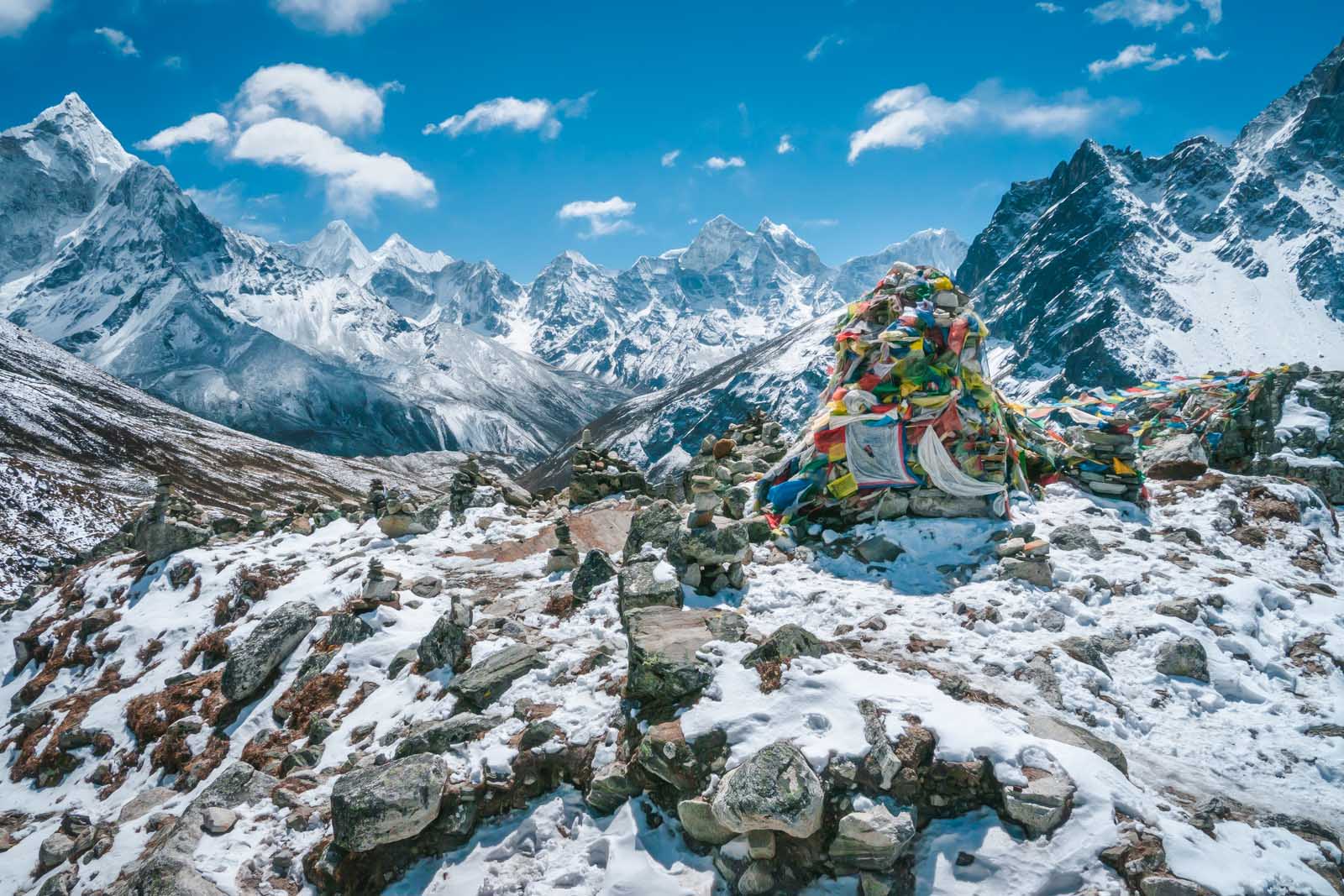
At the top of the hill is a very moving sight. Several monuments and stupas are erected, honoring Sherpas and climbers that have lost their lives on Everest. The most notable of these is Babu Chiri Sherpa .
Babu Chiri Sherpa was the former world record holder of the fastest ascent of Everest, the most number of ascents up the mountain, and the quickest back-to-back summits of 2 in less than 2 weeks. He tragically lost his life on his 11th attempt when he fell into a crevasse.
It was a moving experience and a strong reminder to not take things lightly on Everest, even if you are only trekking to Everest Base Camp. It is still a serious trek.
Dingboche – Elevation – 4410 meters. (14468 feet) above sea level Lobuche – Altitude – 4940 meters (16207 feet) Elevation Gain – 530 meters (1738 feet) Distance – 17.6 km (10.9 miles) Duration – 4 to 5 hours
Day 8 – Morning – Lobuche to Gorak Shep
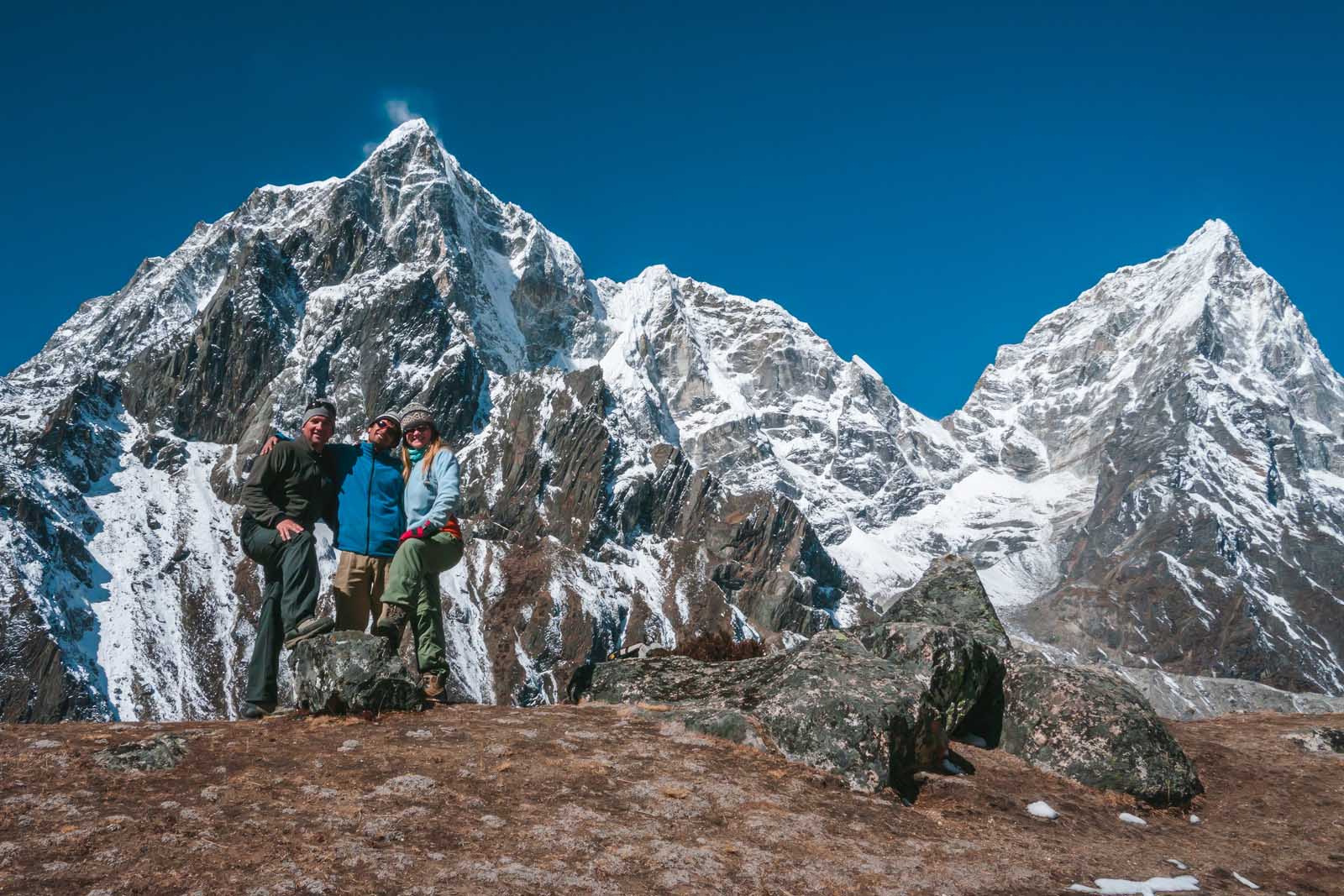
Day 8 on the Everest Base Camp Trek takes you to 5000 meters (16404 feet). How did we feel at 5000 meters? Terrible. Before entering Nepal, I had been suffering for a few weeks in India. The pollution of Kathmandu didn’t help and my congestion was worse when I started the climb. I thought it would clear up in the fresh air, but it intensified with each increase in altitude.
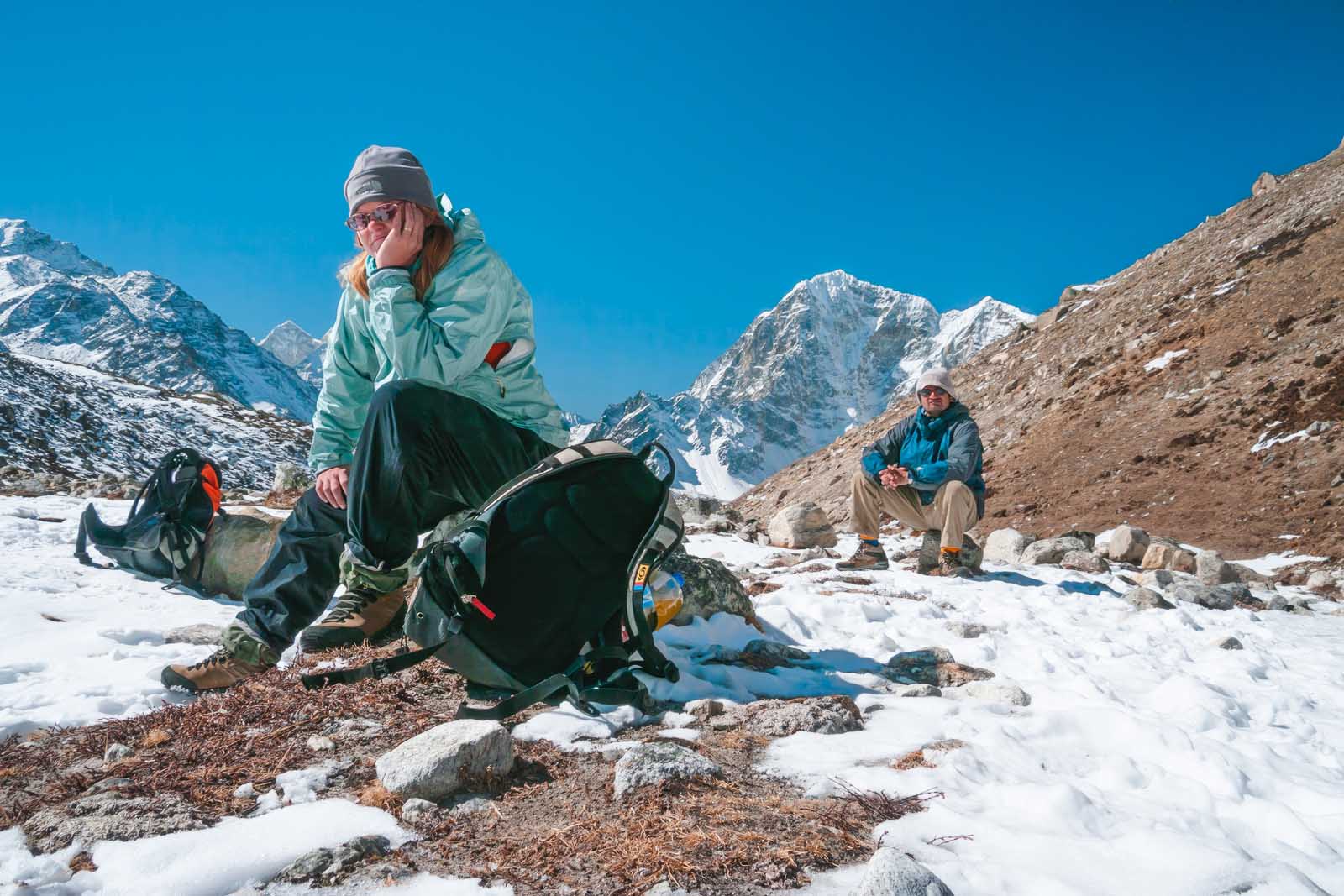
Every morning my cough got worse and my nose was stuffed up to the point of being unbearable. Today, I felt the effects of the congestion and couldn’t catch my breath. It didn’t help that we had gone into such a high altitude. The air is thin and cold.
Dave suffered his first symptoms of altitude sickness when reaching 5000 meters as well. He had a slight case of diarrhea and wasn’t happy about having to wait for the toilet in the teahouses. I think many people were suffering from the same symptoms.
Our was a slow climb to Gorak Shep. We stopped regularly to catch our breath and today we took more breaks than usual. Luckily it was only a couple of hundred meters in elevation gain so we made it to our guest house in Gorek Shep by 12:30.
Lobuche – Altitude – 4940 meters (16207 feet) above sea level Gorak Shep – 5164 meters (16942 feet) above sea level Elevation Gain – 224 meters (734 feet) Distance – 4.3 (2.6 miles) Duration – 4 Hours
Day 8 – Afternoon: Gorak Shep to Everest Base Camp
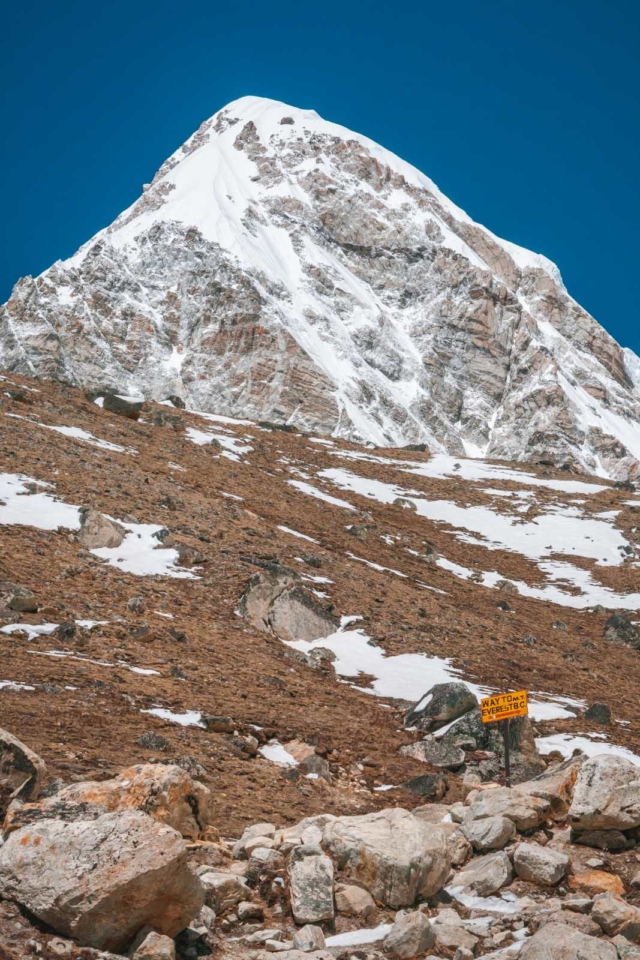
We took a break at Gorek Shep before making out way to Everest Base Camp. We sat in the sun marveling at the fact that we made it this far. After eating a hearty lunch of vegetarian Sherpa stew (Dal Bhat) on the terrace, (yes, we ate outside in the warm sun above 5100 meters) we set out for Everest Base Camp. The sun was shining brightly and it was quite pleasant outside so we were very excited.
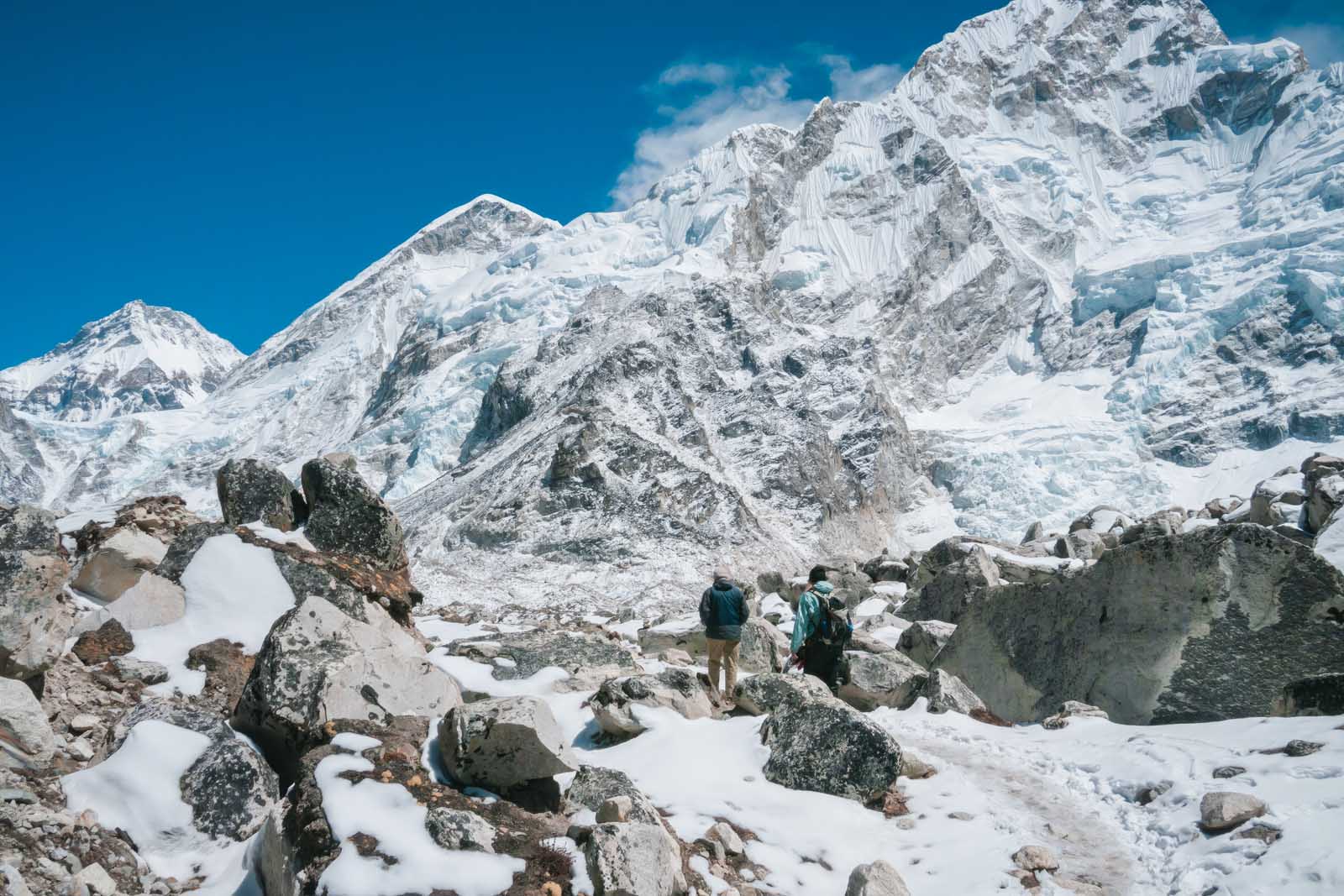
We were lucky and had clear skies. Up until today, the clouds had rolled in by early afternoon every day. Today the sun shone and the skies were blue until sunset. So, it was our perfect morning to make the push.
The trek to Base Camp from Gorak Shep is an easy one. It’s two hours of walking with only a small elevation gain, and we made it with ease. That break for lunch really helped our spirits.
Reaching Everest Base Camp
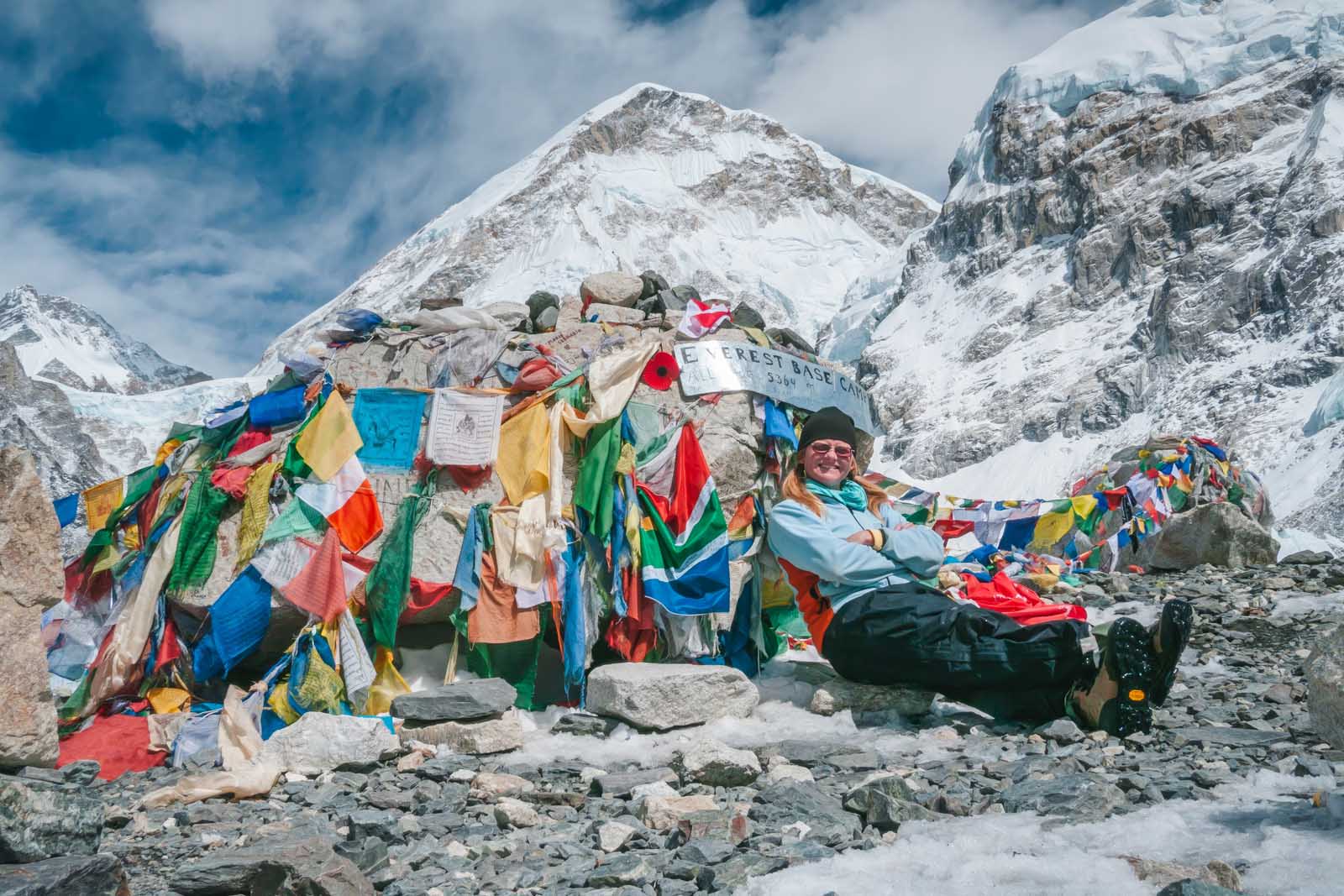
People can summit Mount Everest from Tibet, but the main Everest Base Camp expedition route is in Nepal, and it is busy when the season is in full swing. Even those climbing to the peak of Mt Everest hike the route we took along the Everest Base Camp trek.
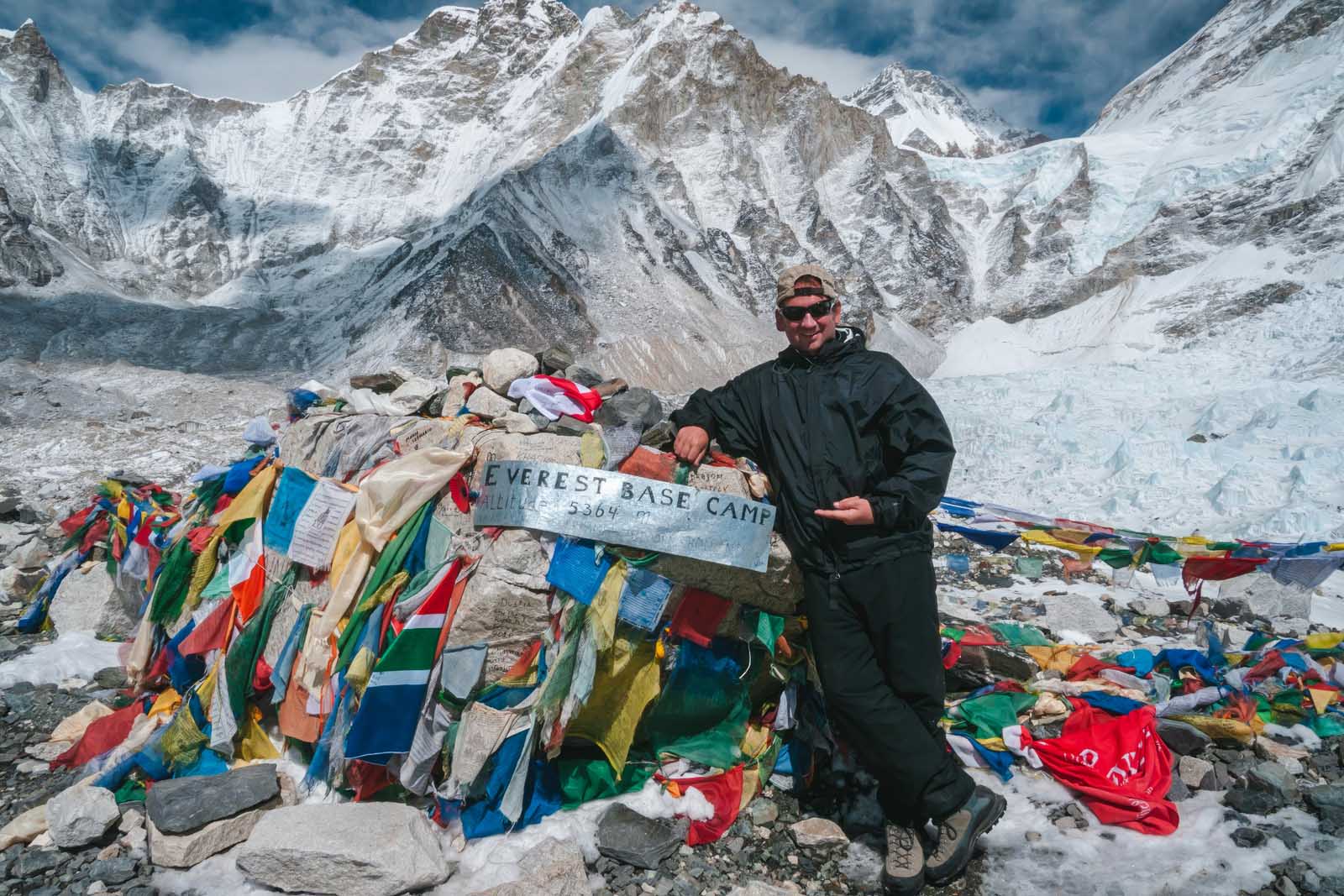
We arrived just a week or two before the season, so it was still quiet on the mountain. In fact, we were the only people at Base Camp that afternoon. We saw another group coming down on our way up, but once there we had it all to ourselves. It was thrilling.
To reach Everest base camp, you will hike out from nearby Gorak Shep and then hike back the same day to spend the night in the village. You do not spend the night at base camp.
Khumbu Glacier
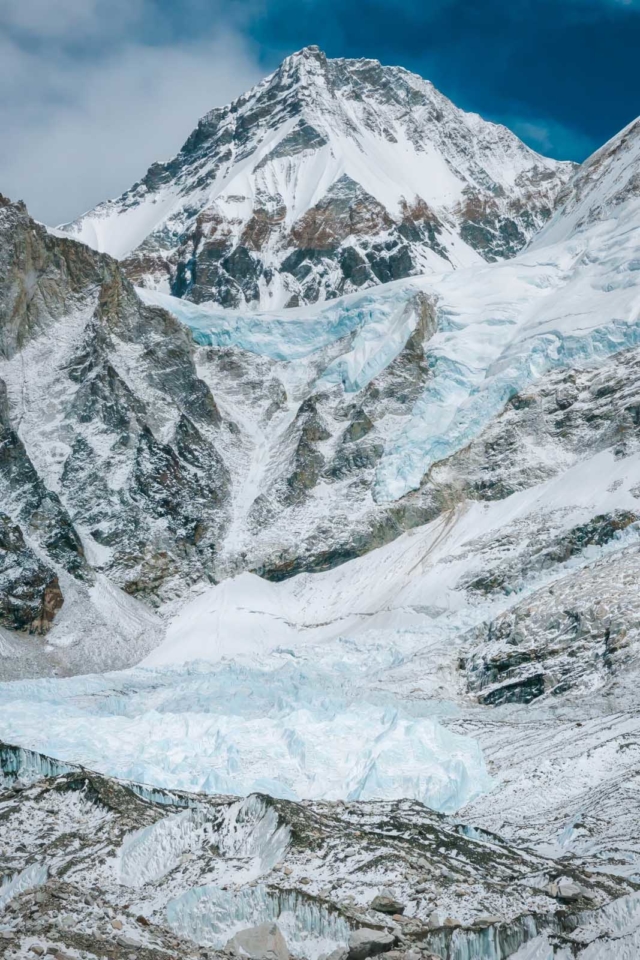
The Khumbu Glacier is the first thing to come into view, and it is unbelievable to think that we are actually standing there. The Khumbu Glacier is the largest glacier in all of Nepal and is famous for the Khumbu Icefall. This treacherous sheet of ice is the most dangerous obstacle that climbers face when summiting Everest.
We witnessed an avalanche that reminded us just how precarious the climb to Mount Everest is. It is an intimidating sight and I cannot imagine having the courage to cross that field of ice. Climbers walk across ladders that shift and move as the ice is alive and constantly settling. It has taken many lives, and we were happy to look at it from afar.
With an elevation of 7600 meters at its source, the Khumbu Glacier is the highest glacier in the world and the Khumbu Icefall is one of the most dangerous portions of the climb to the summit of the world’s highest peak. We were happy to look at it from afar.
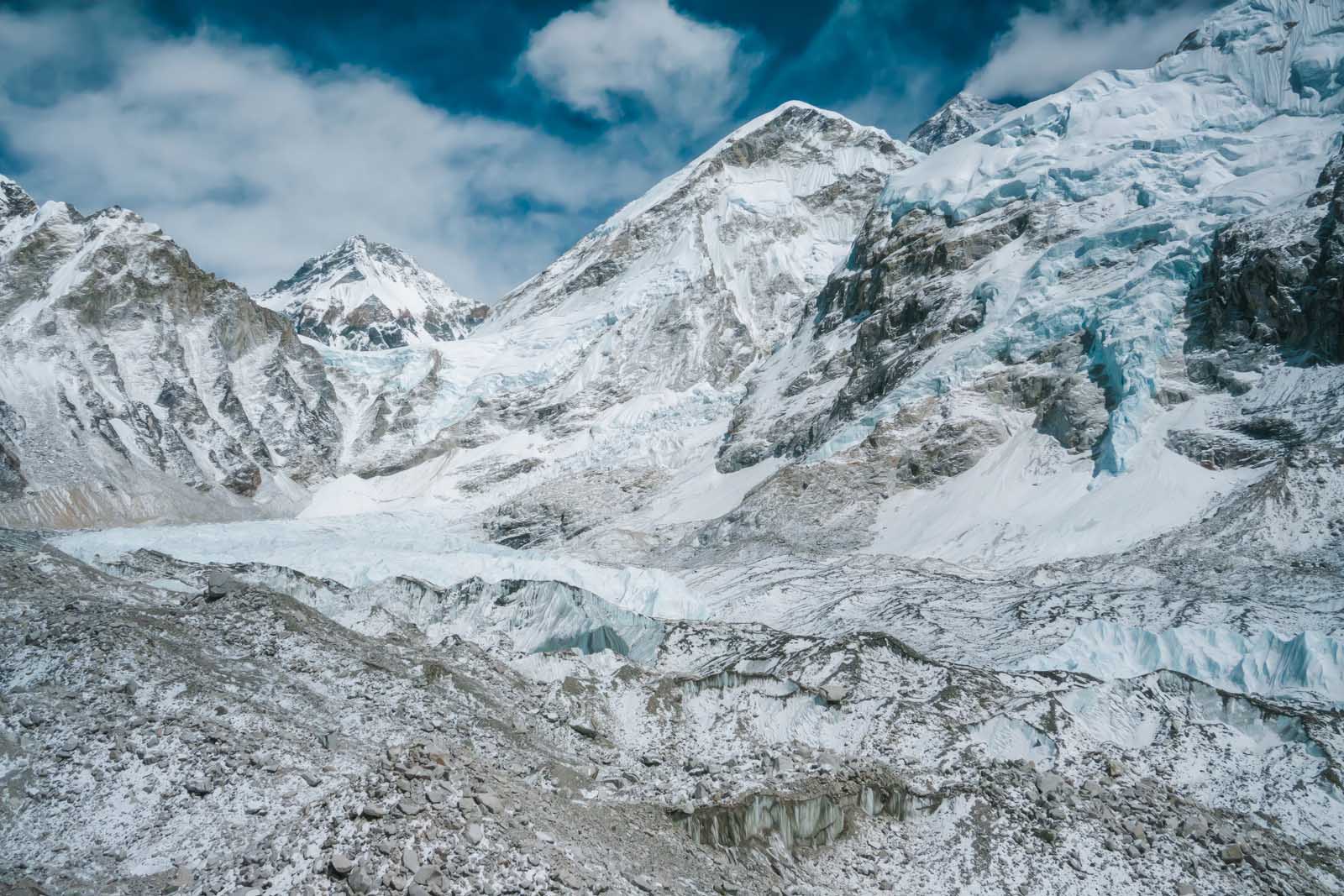
Everest Base Camp’s elevation is 5,364m (17,598 feet) so you will feel the high altitude. But, if you have taken your time you should feel pretty good. We had been at this elevation now for a while and stayed hydrated, so we could enjoy the experience.
We stood at a rock covered with prayer flags announcing that yes, we had made it to Mount Everest Base Camp at 5364 meters. We stayed for almost an hour taking videos, celebrating, and snapping photos. If you can bear it, don’t rush the experience, take it in and enjoy every minute. This will be the only time you’ll see it.
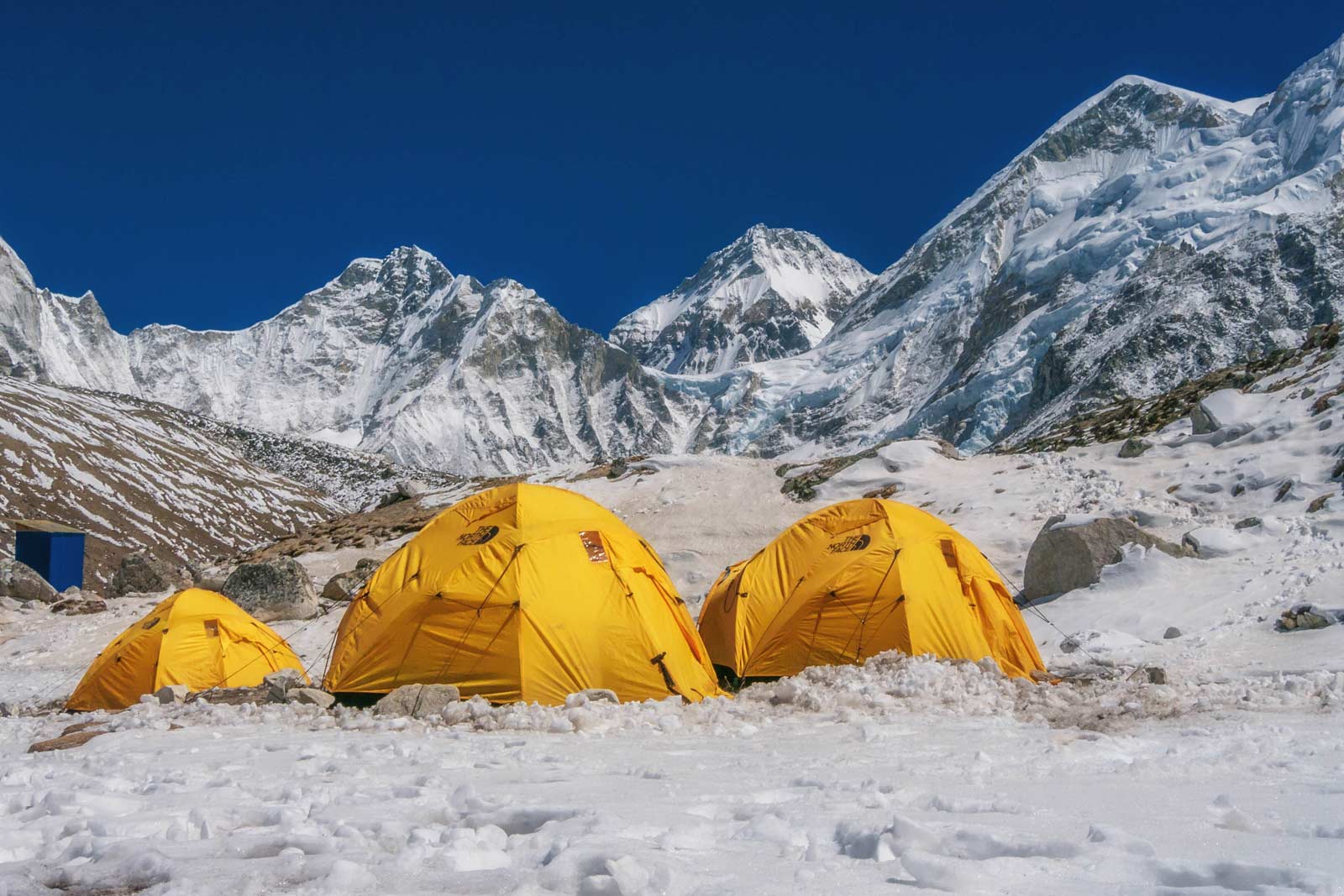
Trekking to Everest may be more exciting later in the season when Everest expeditions are there, but we really liked having base camp to ourselves. There wasn’t a soul on the mountain except for the three of us. We stayed for almost an hour taking videos, celebrating, snapping photos, and marveling at the massive Khumbu Glacier. Can it really be true that we are here? It felt like a dream.
We finished our climb about two weeks before the high season began and we wouldn’t have it any other way. We stood at a rock covered with prayer flags announcing that yes, we had made it to Everest Base Camp.
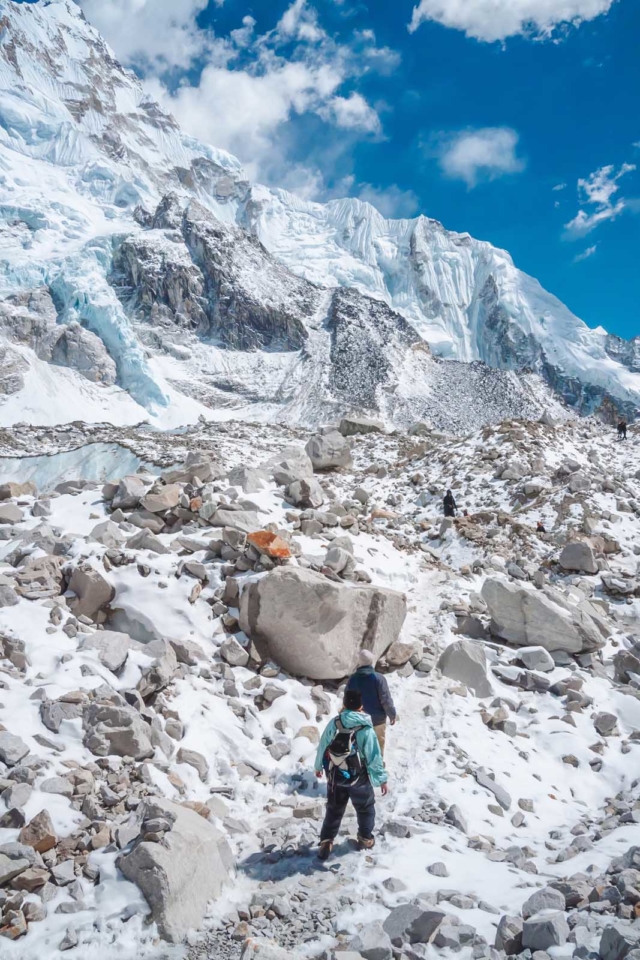
When it’s high season, base camp is filled with expeditions and tents spanning the valley. We only saw one expedition so far. They may have been here to climb Island Peak as base camp is also a place to acclimate for that peak.
We started to make our way back to Gorak Shep from Everest Base Camp at about 3:30 pm. Even though it was an easy trek back, there are narrow paths atop high ledges and it just so happens that while we were walking back, an ice bridge broke off after I stepped on it leaving Dave with a sticky situation of having to take one giant leap over a gorge. We made it back to Gorak Shep safely but it was a reminder just how dangerous the Himalayas can be.
Back to Gorak Shep
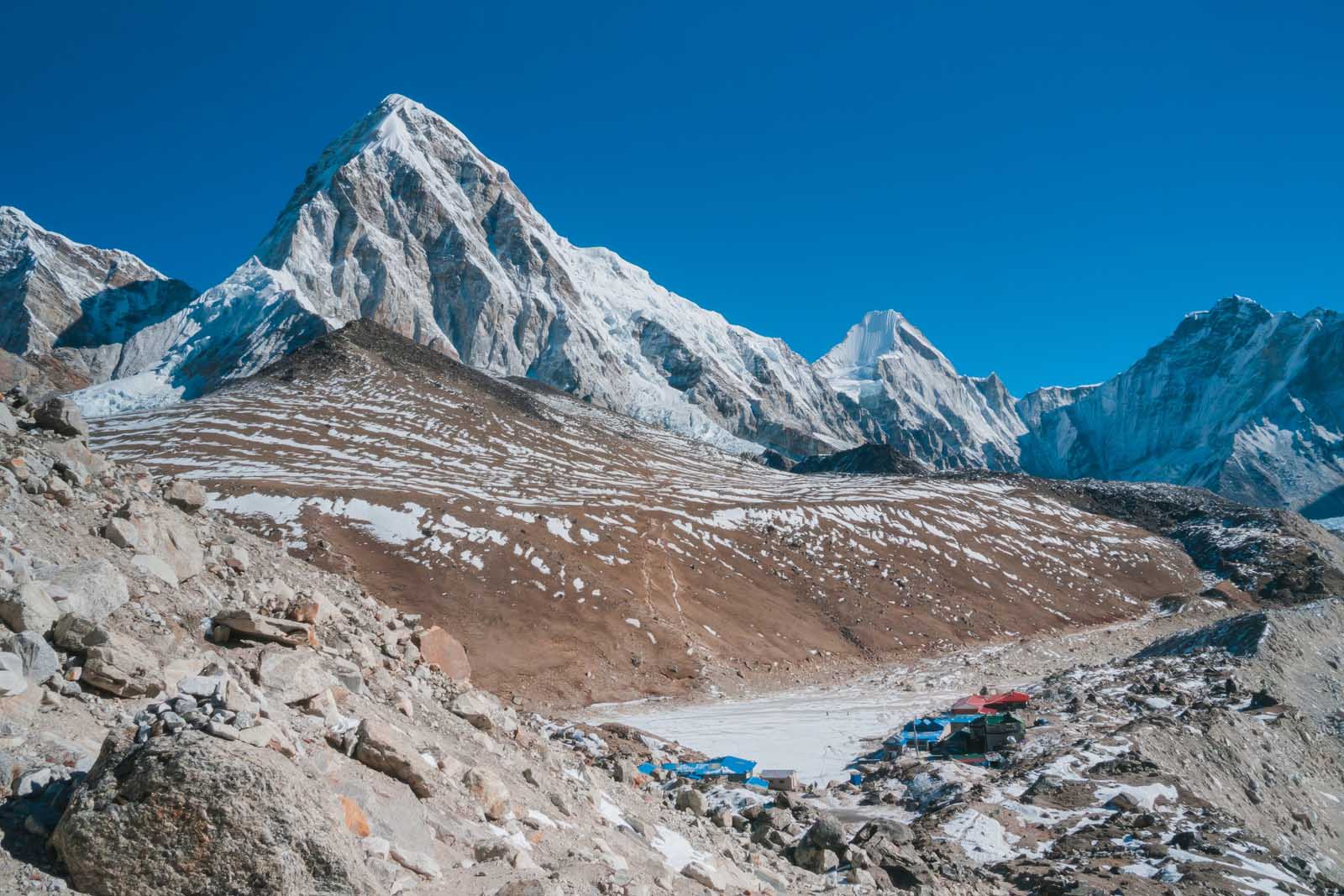
By the time we made it back to Gorak Shep, the excitement of reaching Everest base camp had worn off. We had reached our final destination Base Camp, but there was still a lot more trekking to go.
We were happy to have seen it, but we were exhausted. We felt the same when we climbed Mount Kilimanjaro. The thrill of reaching your destination is over and there is nothing more to look forward to, but there are still so many days to go.
That night I had serious sinus congestion and felt like I was suffocating in my freezing bed. It was quite scary to already be short of breath because of the altitude and then be completely congested. I really was terrified. Our guide Dipendra brought me hot tea all night and I slathered myself in Vicks Vaporub but nothing helped me to breathe easier.
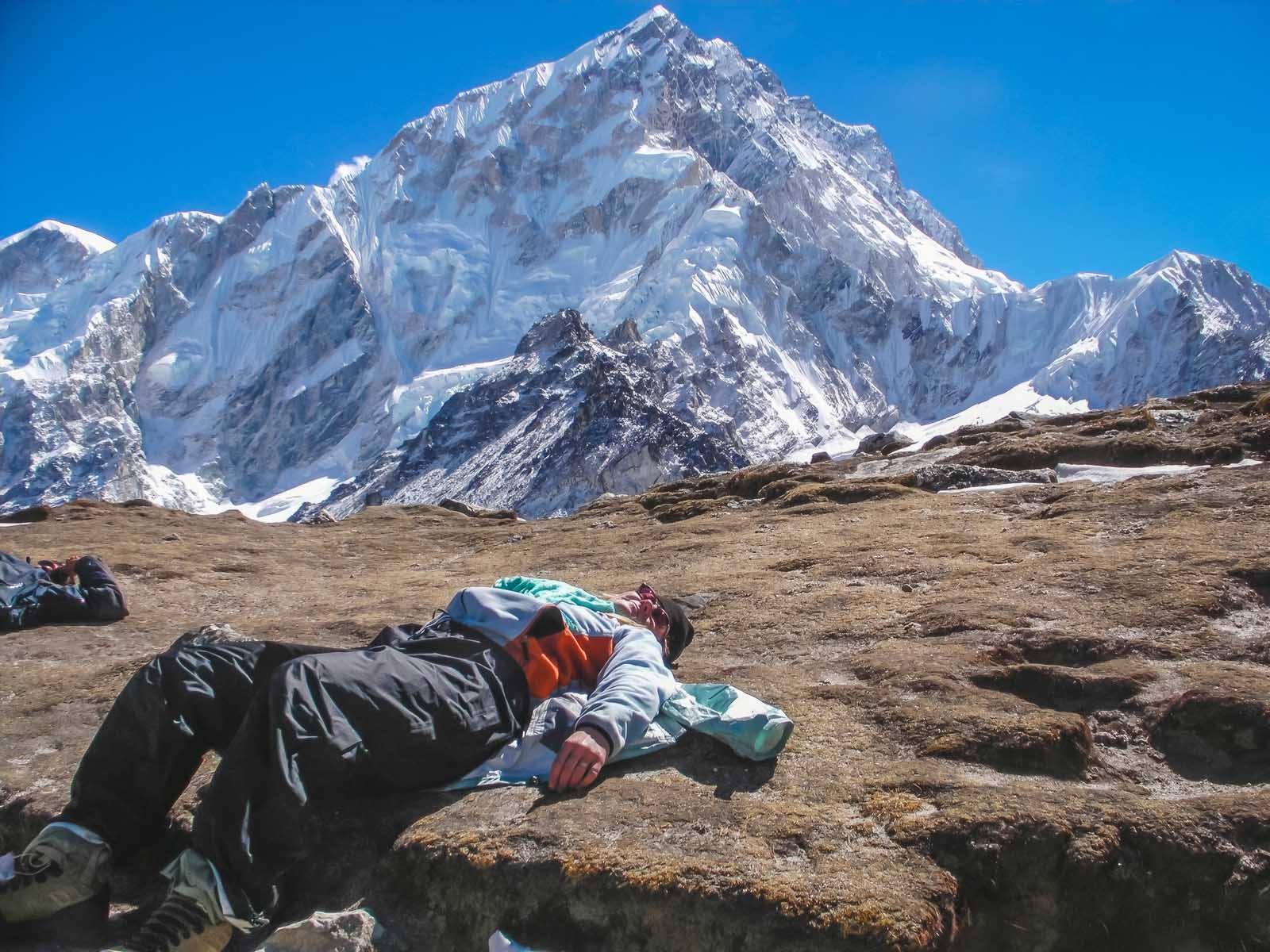
I was afraid as we had the Gokyo Lake trek ahead through the Cho La Pass. We were also planning to trek up to Kala Pattar for the best views of Everest in the morning. I hope I could make it but I was also dreading the day ahead. I barely slept a wink but I finally drifted into a not-so-peaceful slumber.
Gorak Shep – 5164 meters (16942 feet) above sea level Everest Base Camp Elevation – 5,364m (17,598 feet) above sea level Elevation Gain – 200 meters (656 feet) Distance – 3.5 km one way (2.1 miles) Duration – Three Hours Round Trip
Alternative Gokyo Lake Via Cho La Pass
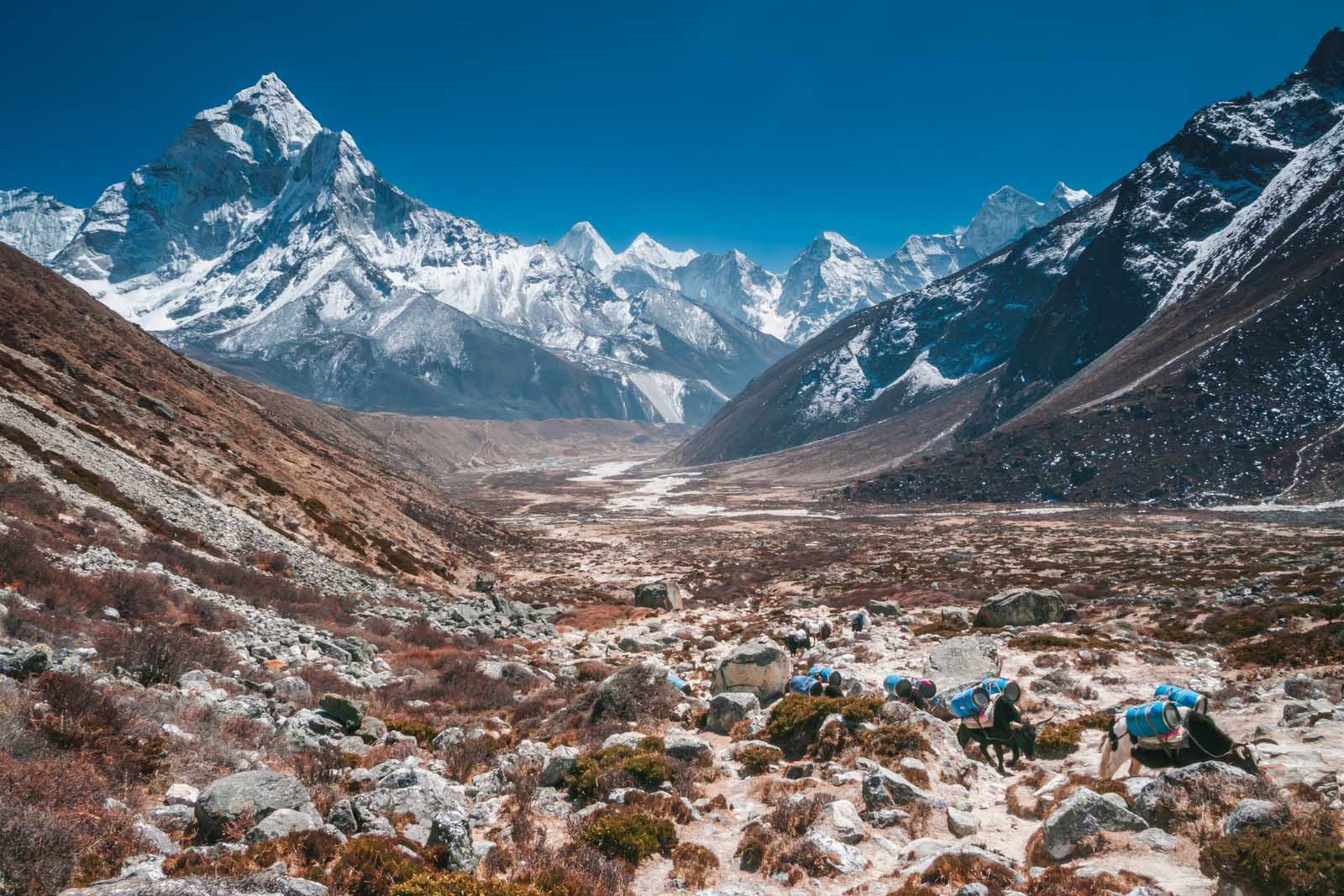
The next morning after a terrible night, we gave up our plans of climbing Kala Patthar and then on to the Gokyo Lakes and Cho La Pass trek. Even though I wasn’t feeling dizzy, nauseous, or lightheaded anymore, the sinus congestion was really getting to me. At altitude a cold can turn serious quickly, you just can’t take a chance when altitude is involved.
But, if we were going to trek on, this would be the next stop. It is supposed to be beautiful and if you are feeling up to it, we highly recommend it. This makes the trek much more interesting as you get to take a different way back to Lukla.
Cho La Pass: Altitude 5420 meters (17,782 feet) Gokyo Ri: 5357 Meters (17,575 feet) Gokyo Lakes: 4,700–5,000 m (15,400–16,400 ft)
Day 9 – The Descent and Kala Patthar
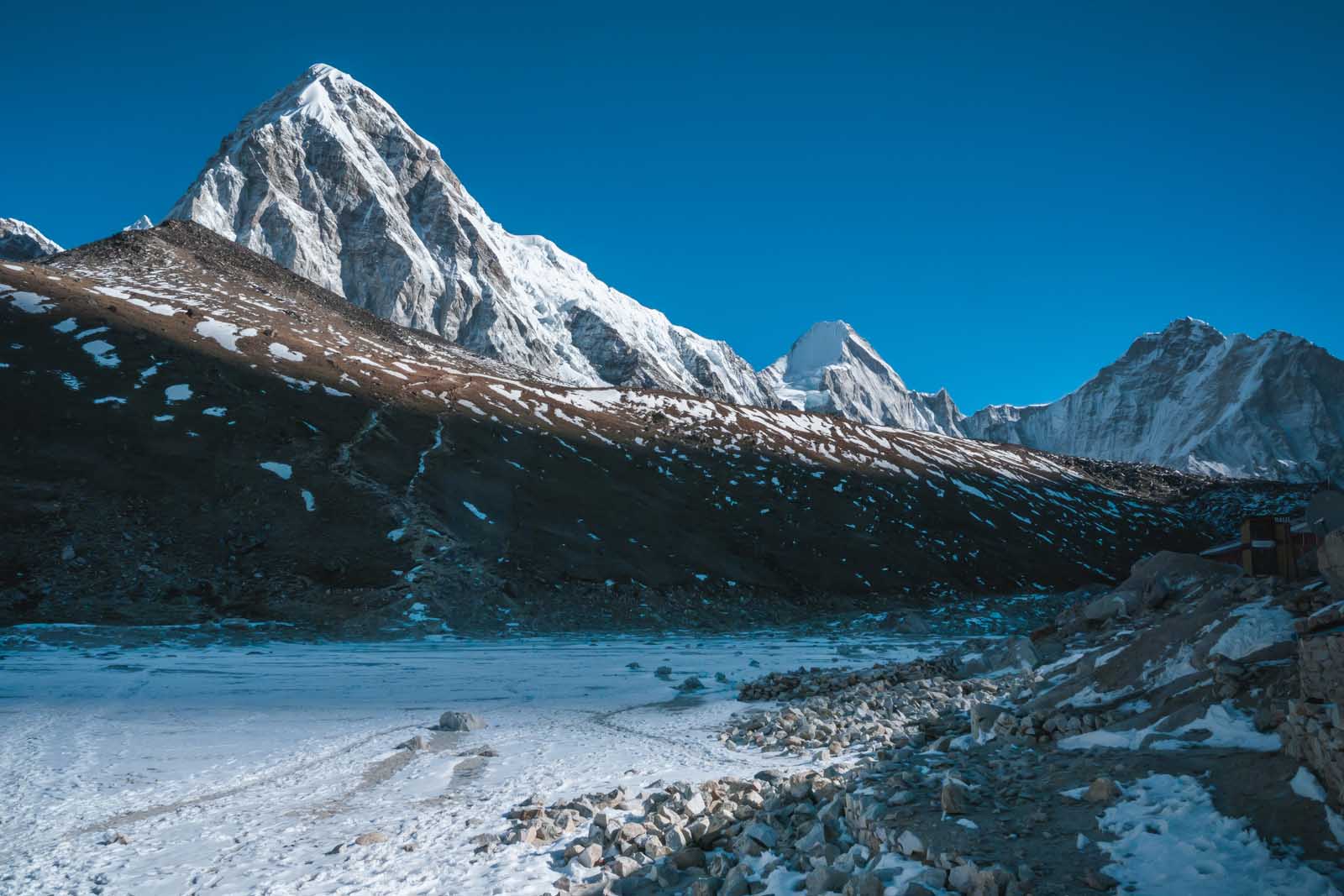
Kala Patthar is a hill above Gorak Shep that offers the best views of Everest and is a must-stop on anyone’s Everest Base Camp trekking route. We had planned to climb to the summit of Kala Patthar, but my congestion was so bad, that we decided it was safer to get to a lower elevation quickly.
Kala Patthar is a quick two-hour trek to add to your descent back to Lukla. It is a good option if you are feeling up for it as it gives a great view of Mt. Everest. Make sure to start early morning before dawn as there is still a long day of trekking after summiting Kala Pattar. Plan on another five or six hours to your next overnight stop at Pheriche.
Kala Patthar to Pheriche – Afternoon
By the time you reach your accommodation at Periche, you should be feeling a lot better. Dave and I find that we are fine in the 4000-meter ranges of altitude and experience very few symptoms of altitude sickness. It is at 5000 meters and above that, we start to feel our symptoms. Periche is a much more manageable 4371 meters.
Kala Pattar: 5643 metres Pheriche: 4371 Meters Altitude Loss : 1272
Days 10 to 11 – The Descent from Everest Base Camp
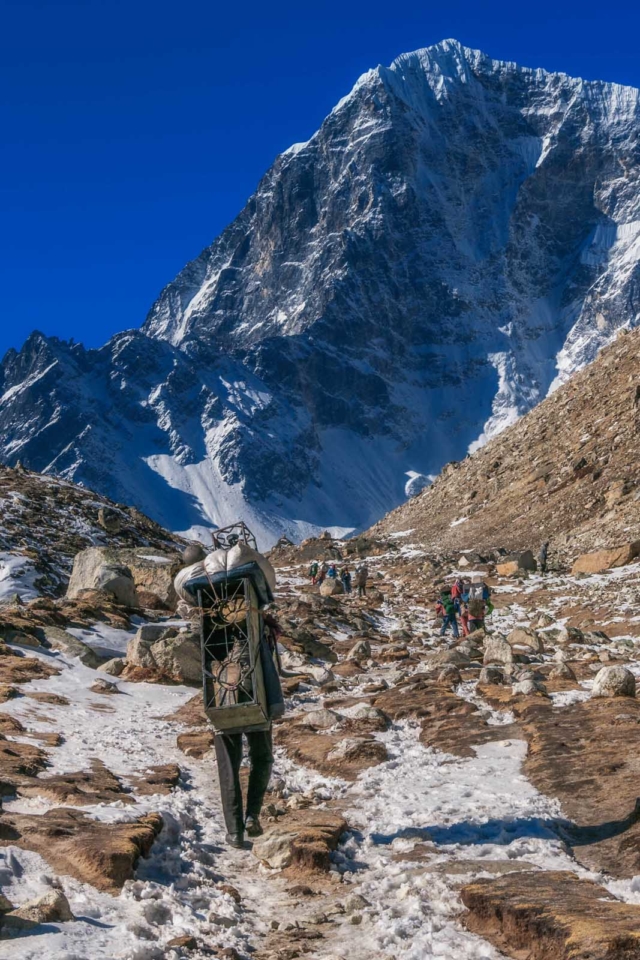
It took us two days more to trek back from Everest Base Camp to our final destination on the EBC Trek. I started feeling better on the second day as the dryness of the Everest base camp disappeared. My sinuses cleared and soon I was breathing easily. I started to feel guilty about turning around, but in hindsight, I know it was the right choice. You never want to take a chance with altitude sickness.
Even though we were heading down, there is still a lot of altitude gain as the EBC trek doesn’t continuously go downhill. I was feeling really fatigued and we still had a tough couple of days ahead of us. But knowing there was light at the end of the tunnel made everything easier.
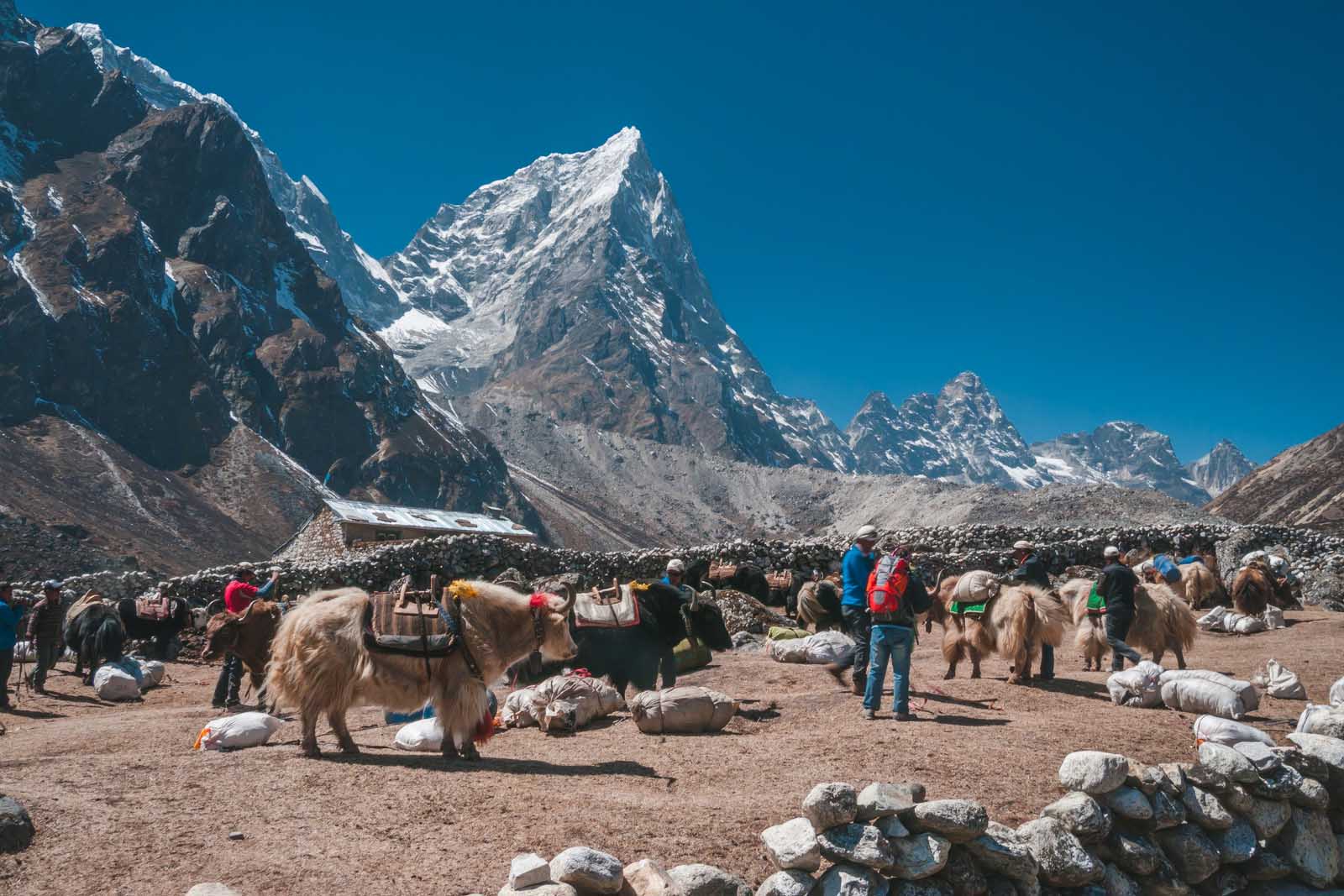
It takes a lot of mental stamina to climb back down as the euphoria of reaching the Everest base camp has worn off, but we made the most of it, by chatting with other trekkers and getting to know our guides better.
During our decent we could actually take our time to smell the roses or should I say enjoy the trekking trail that ran through the stunning rhododendron forest.
Rhododendrons are beautiful flowering plants that bloom in different shades of pink, red, white, and purple. The rhododendron forest is particularly prominent in the areas of Phakding, Namche Bazaar, Tengboche, and Dingboche which we really didn’t notice until we made our way down the mountains.
We followed the route we came up with, but it was much faster and we stayed in different villages. The beauty of booking organized trips with a local guide is that our guide Dipendra knew the routes like the back of his hand, so he could change accommodations easily to suit our speed.
Day 12 – Lukla
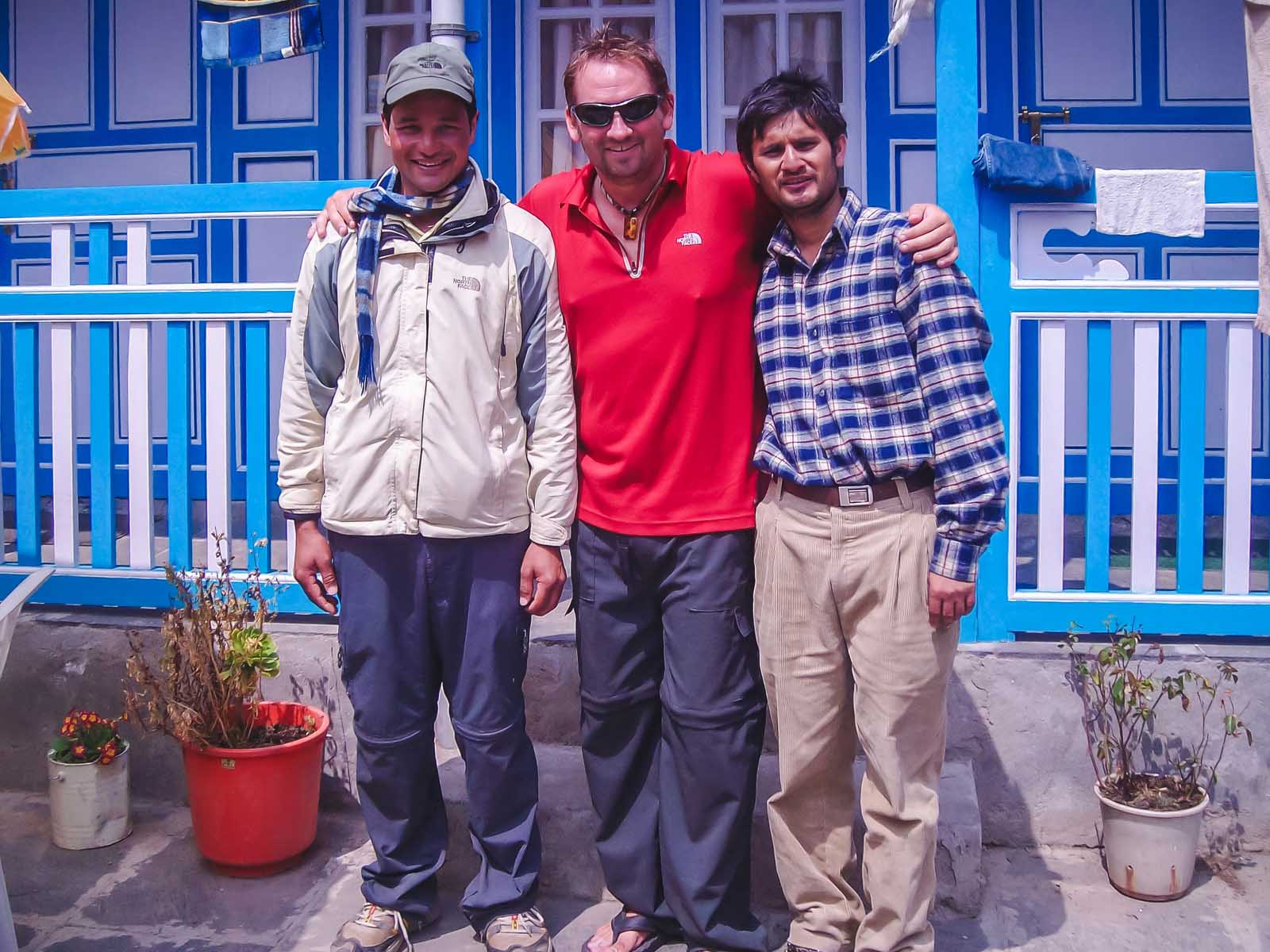
We were back in Lukla early on day 12 of our EBC Trek and had an evening booked in a guest house here to catch the first flight from Lukla back to Kathmandu in the morning. As much as we loved our trip to Everest, we were excited to be moving on to explore more of Nepal.
The accommodation was pleasant with a lovely restaurant, hot shower, and warm and cozy beds. It was a great way to end the trip.
Day 13 – Return To Kathmandu Flight from Lukla Airport
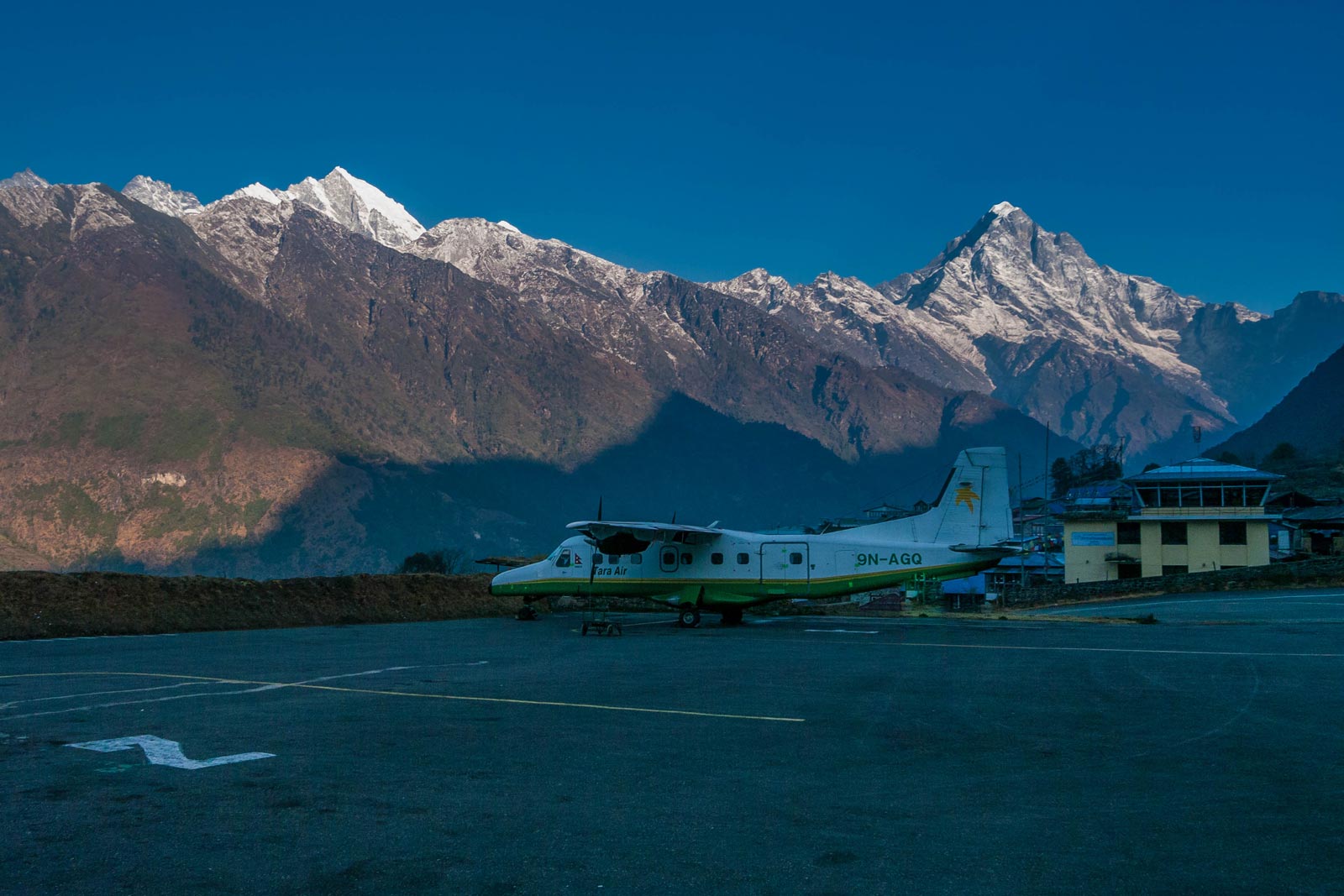
It is very important to give yourself an extra cushion when booking your return flight not only home from Kathmandu but from Lukla. We stayed overnight in Lukla on the final night of our trek and booked a flight to Kathmandu for first thing the next morning.
It is not uncommon for flights to be canceled or delayed flying out of Lukla Airport. Weather conditions change quickly. So give a bit of a cushion when booking your flight home from Nepal after you’ve finished your trek to Everest Base Camp. Many a traveler has missed their connecting flights home from Kathmandu because of delays in Lukla. It is safer to plan to spend a night or two in Kathmandu after your trek.
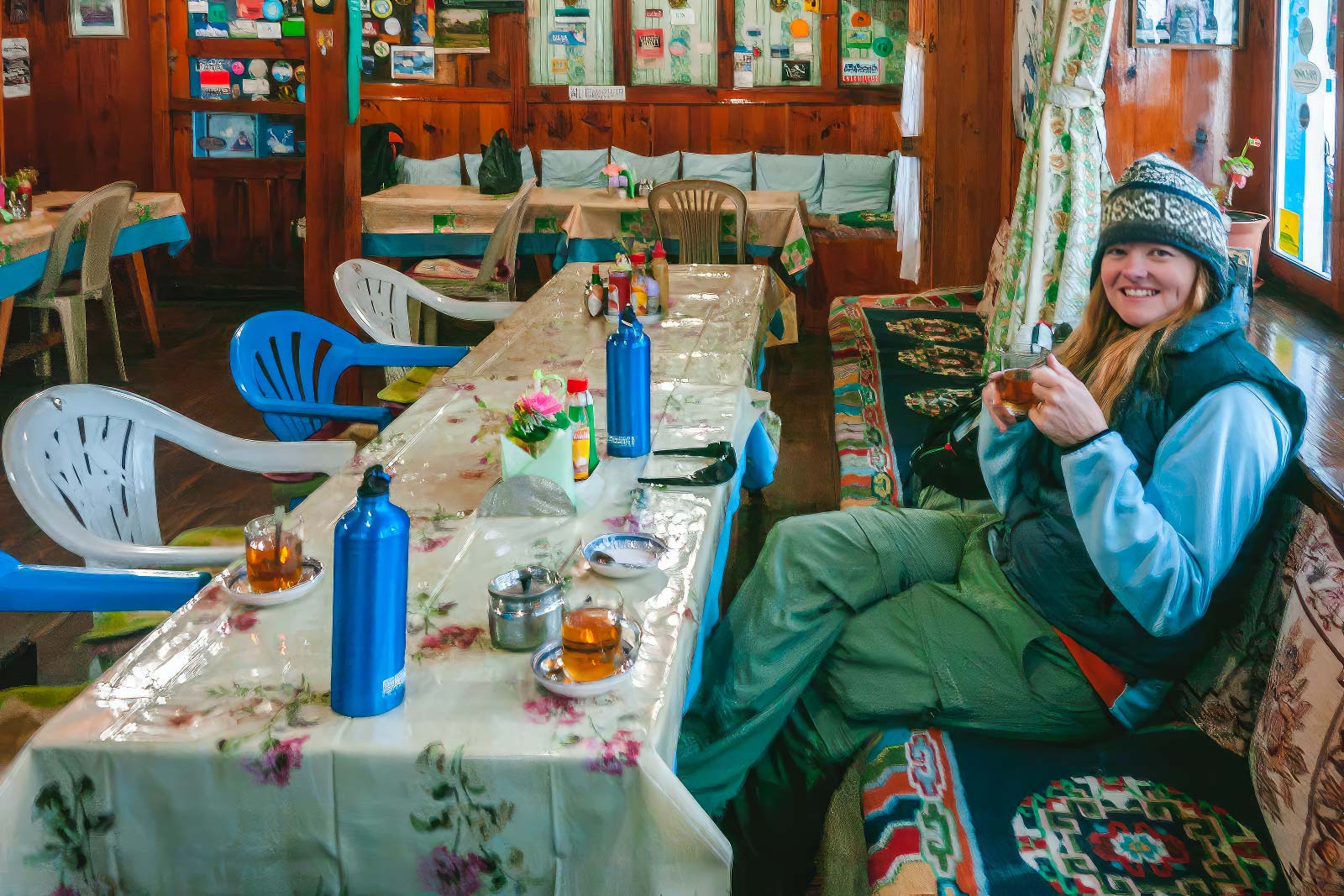
We were delayed an entire day. Even though we were booked on the first flight from Lukla, the weather made us wait until near sunset. We were the first (and only) flight out that day, so everyone else who was waiting for their flights all day was stuck another night.
It was a bumpy flight back to Kathmandu and we almost wished that we didn’t make it on the flight. The turbulence was so bad, I was sure we were going to drop out of the sky.
Everyone on the flight was silent as we were tossed about dropping huge amounts of elevation at a time. But we landed and we have never been so happy to arrive in Kathmandu. We kissed the ground, thankful to have trekked to Everest Base Camp, but vowed to never do it again.
Accommodation – Tea Houses on Everest Base Camp
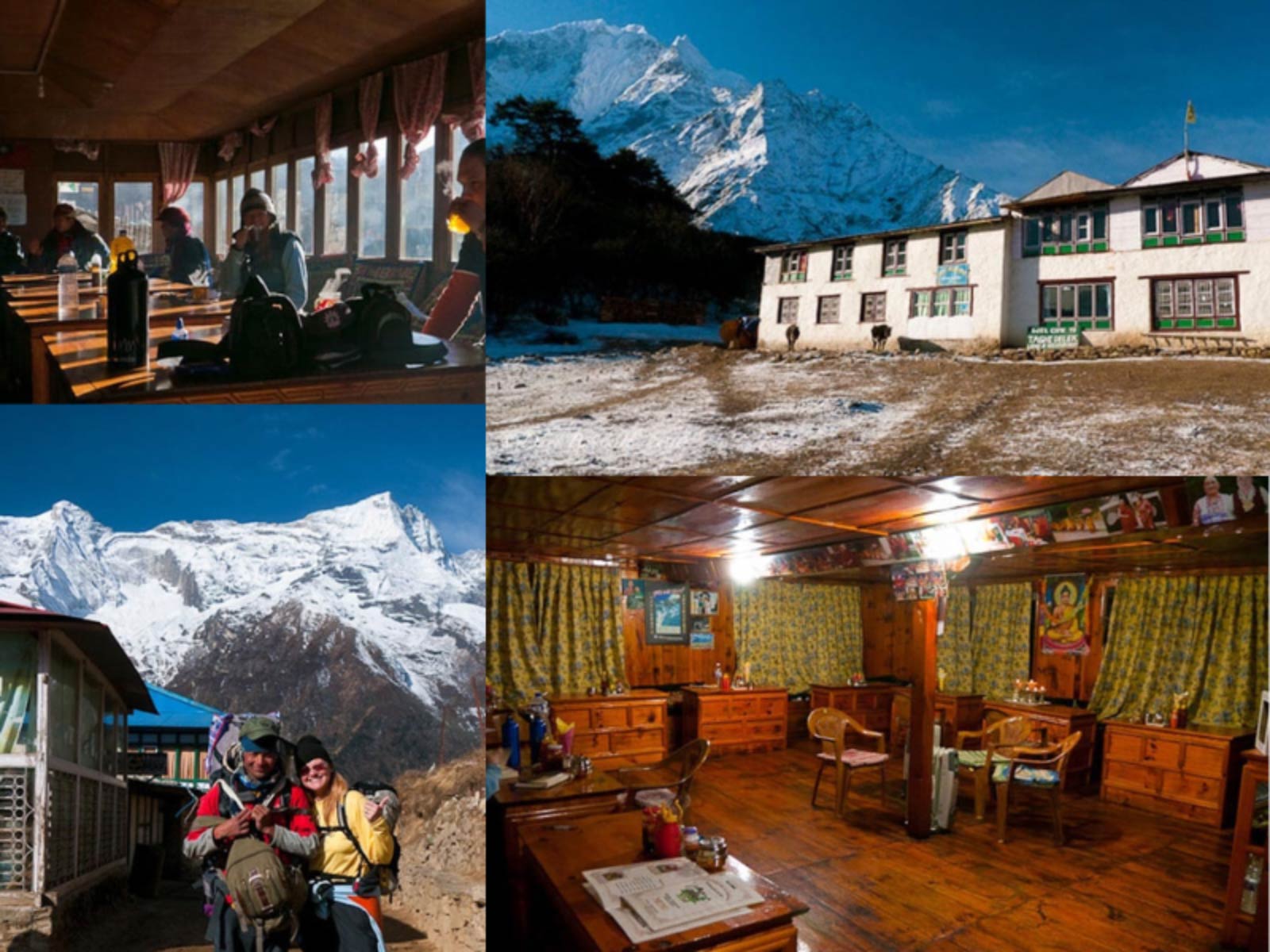
The main lodges of each teahouse we stayed in during the first half of our trip were cozy and warm. At the lower elevations, woodstoves burned wood in the dining room and common areas and our rooms were a comfortable temperature as we were wrapped up in our sleeping bags.
But as we ventured higher, the stoves were less abundant and instead of wood, they burned yak dung. You heard me, Yak Dung. Wood can’t burn in thin air, so they use yak dung to heat the teahouses at high elevations. Rooms are not heated so when we went to our rooms, we had to wear hats, thick socks, puffy coats, and long johns.
There were charging stations at the accommodation for electronics and we paid by the hour for electricity.
- We highly recommend taking a portable USB charger to charge your own electronics.
- We also used a solar USB charger that recharged during the day as we hiked.
Meals on Everest Base Camp
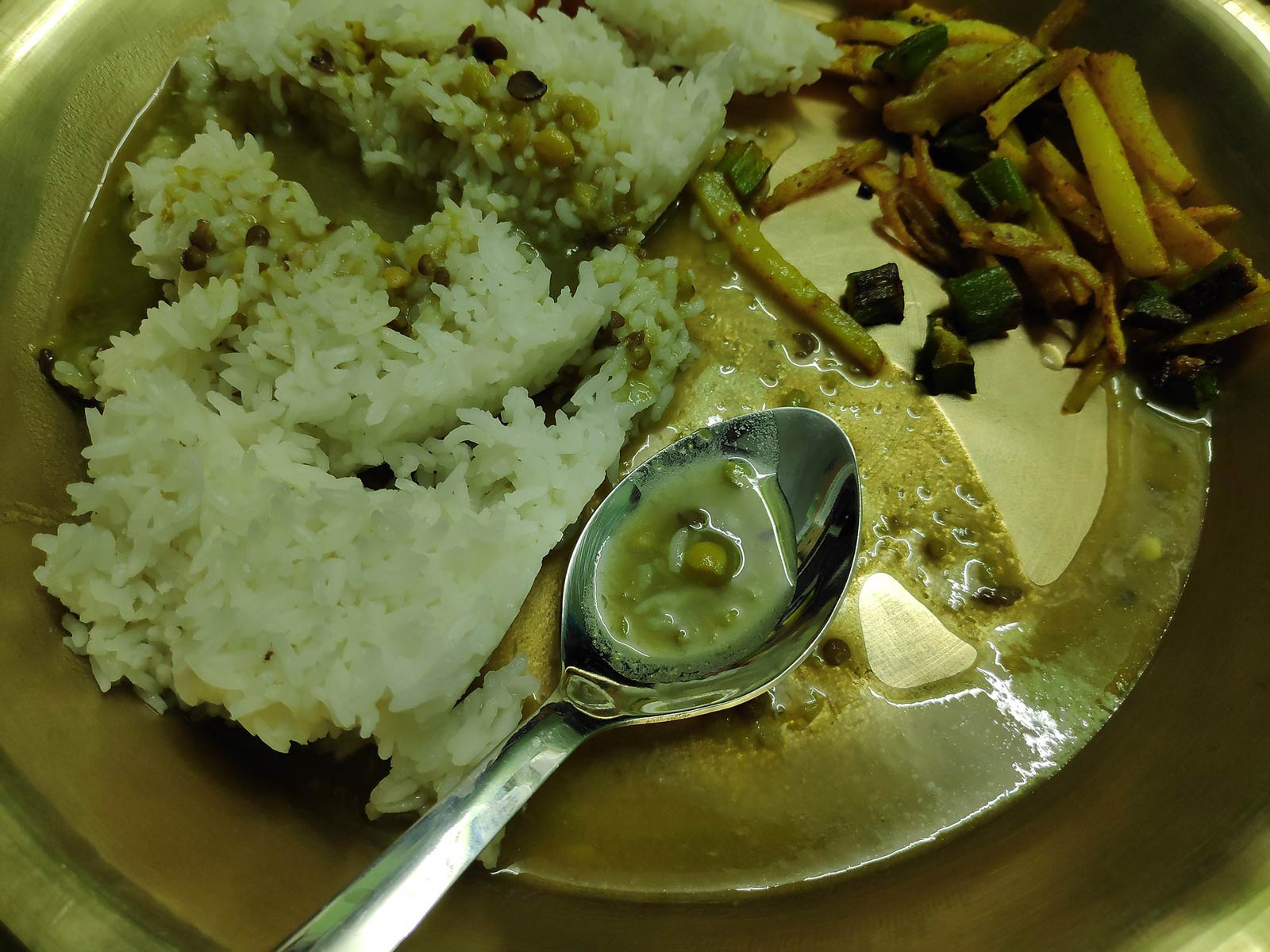
Because we booked an all-inclusive Everest Base Camp trek with Simrik Real Nepal tour company, all meals and snacks were included with our accommodation. Each evening, hearty meals were served that included pasta, rice, or Dal Bhat. Dal Bhat is the staple food of Nepal consisting of lentils, vegetables, steamed rice, and curry.
For the first few days, meat was served at meals, but as you climb higher, meals turned to vegetarian as it is more difficult to get the meat up the mountains.
Prayer Flags and Prayer Wheels – EBC Trek Etiquette
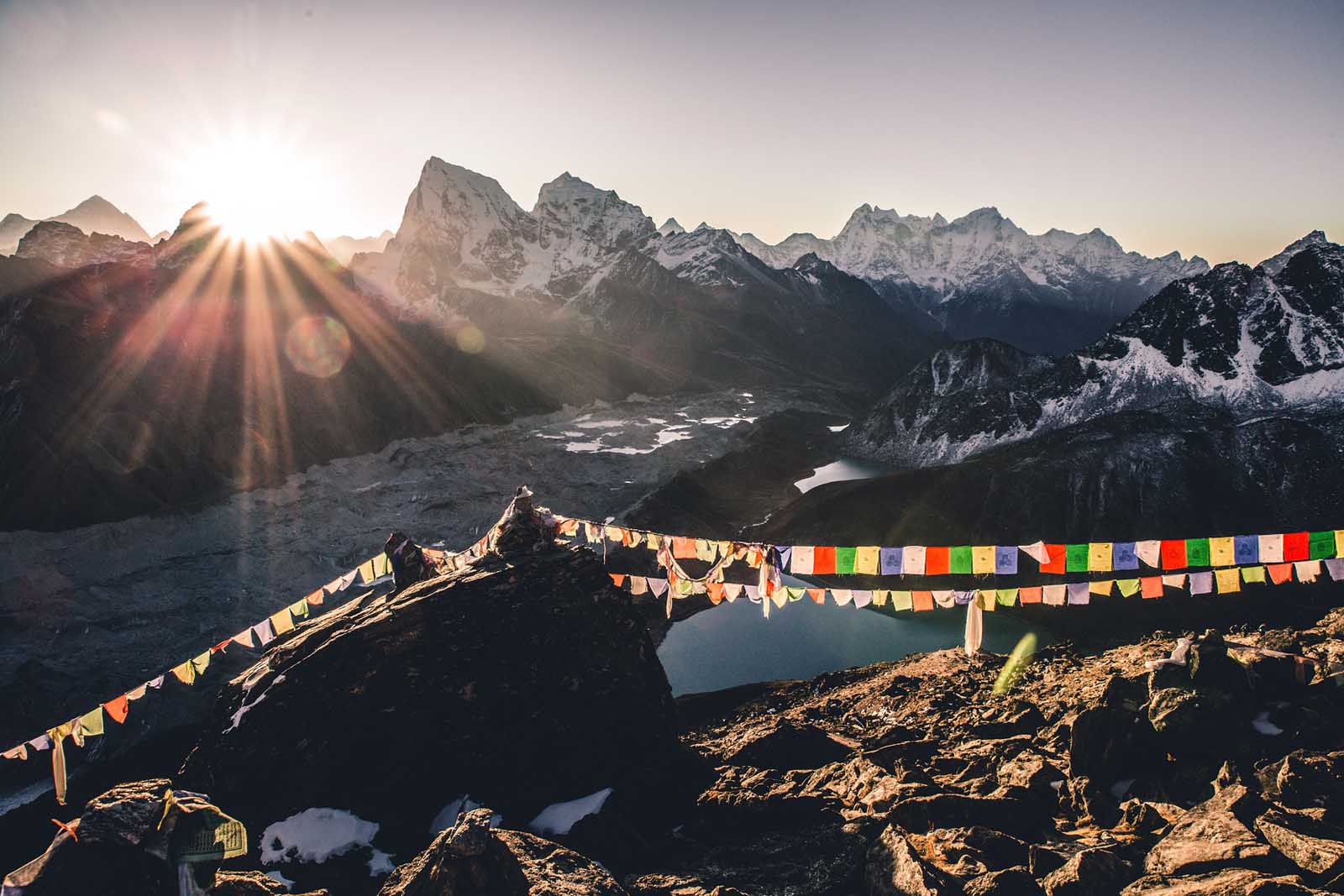
We saw many prayer wheels, prayer flags, and prayer rocks (mani stones) all along the trail to Everest. Everest is a sacred mountain and these monuments help give luck to the climbers on the mountain. There are customs to be followed when approaching prayer rocks or prayer wheels.
How to properly trek around prayer Wheels and Prayer Rocks
- When approaching a prayer rock, it is important to walk to the left of the prayer rocks (mani stones) in a clockwise direction. The stone on the right means you are on the “right hand of God.”
- When using prayer wheels, you walk along and spin them to ask for blessings for the climb ahead.
- Sherpas and locals spin prayer wheels saying the mantra “ Om Mani Padme Hum” giving blessings to the climb ahead.
- The prayer flags have prayers and mantras written on them which are believed to carry messages of positivity and to spread goodwill and compassion they are carried by the wind.
Altitude Sickness
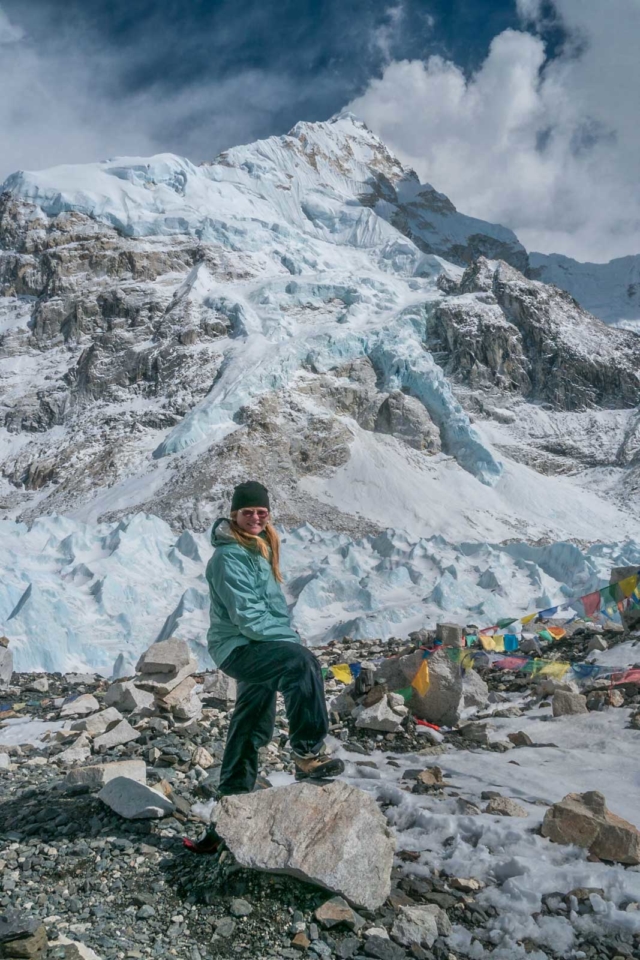
Altitude Sickness is a very real possibility on the EBC Trek. On average 3-5 people die each year doing the trek to Everest base camp. Make sure to keep an eye out for signs of Acute Mountain Sickness. Acute Mountain Sickness is life-threatening and early symptoms include nausea, headache, and vomiting. It can lead to death. The Best way to alleviate symptoms is to go down to a lower elevation.
If you start to feel dizzy, have a pounding headache, or if you start to vomit go down to a lower altitude as quickly as possible. Take your time climbing, stay hydrated, and listen to your body.
Drink plenty of fluids, try to eat, and rest regularly. It is better to walk slowly and steadily rather than rushing at high altitudes. And when you get to your accommodations each day, relax as much as possible.
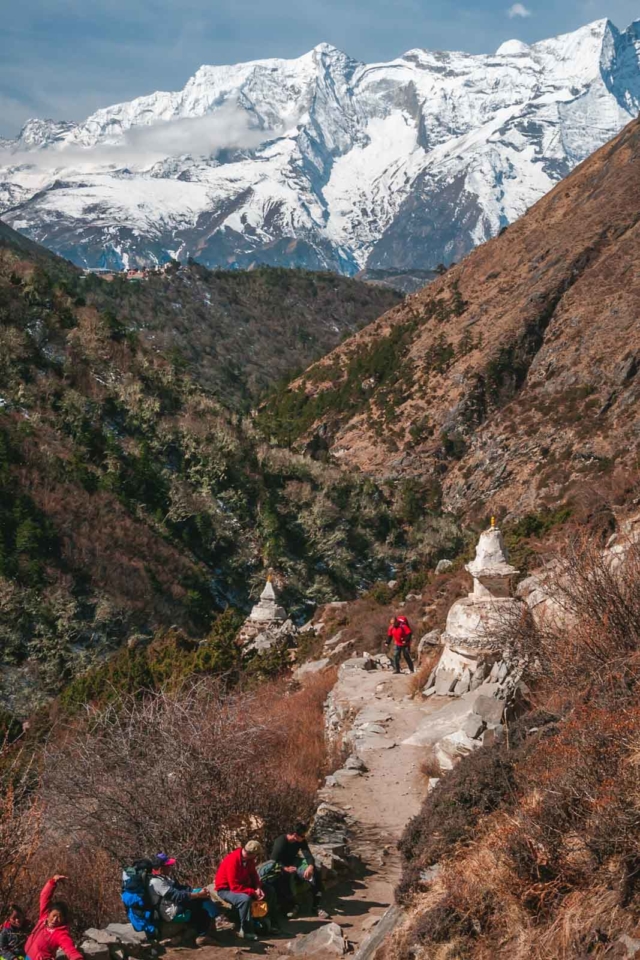
It can be dangerous trekking to Everest Base Camp from falling off the mountain to succumbing to altitude sickness. Some people have simply disappeared. Hiring a guide is a good option (and now the only option) for safety and it is very important to look for signals of altitude-related sickness.
But the Everest basecamp trek isn’t nearly as dangerous as climbing to the summit of Mt Everest. In 2019, 11 people died while trying to summit Mount Everest.
The village of Lukla is located at a high elevation so you will feel the effects of the thin air as soon as you land. The elevation of Lukla, Nepal is 2869 meters (9,350 feet). We were short of breath and already feeling fatigued upon landing. So instead of immediately starting our trek, we had a hot breakfast at one of the many restaurants in Lukla.
Travel Insurance for Everest Trek
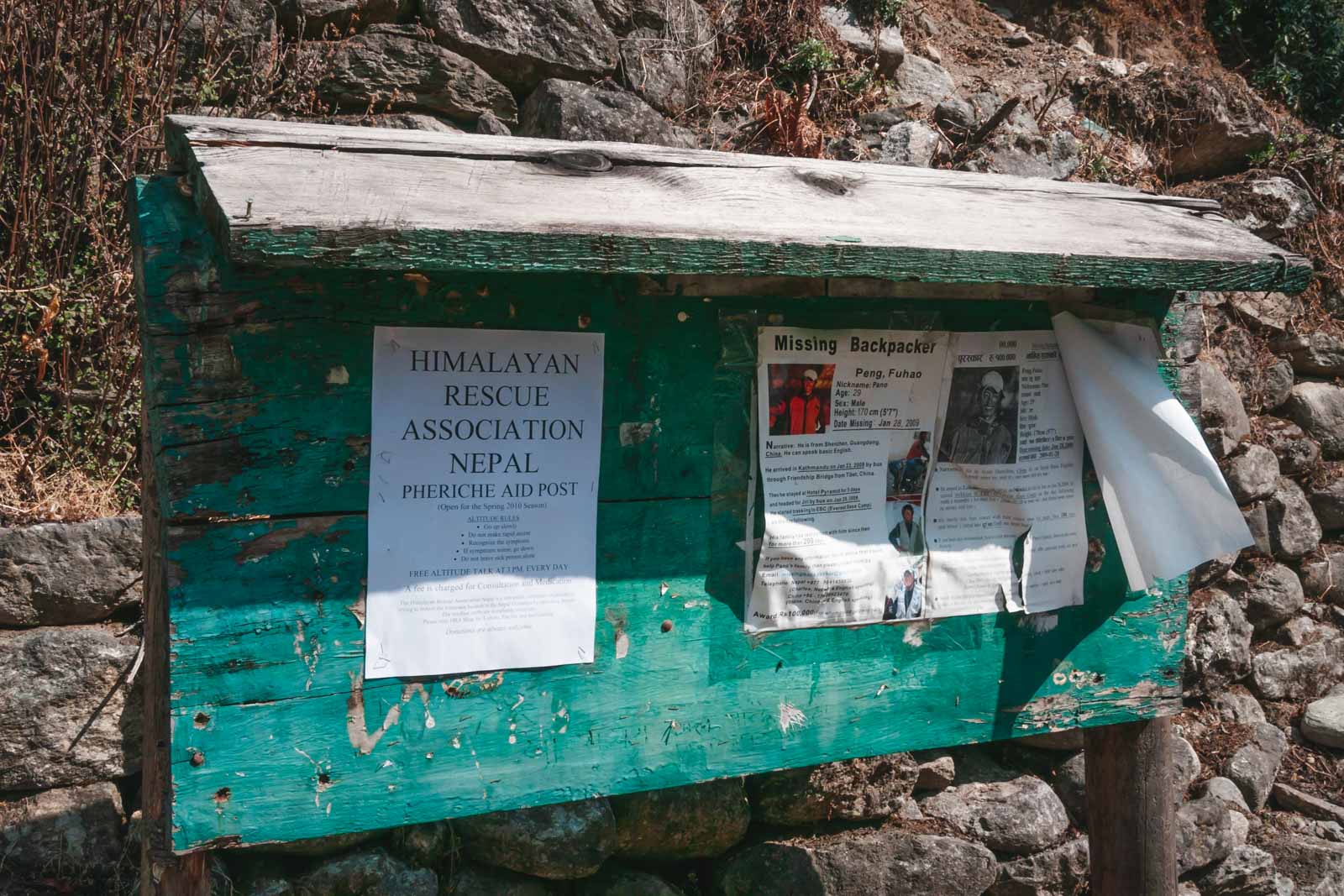
We always travel with travel insurance on our travels, but hiking to Everest Base Camp will not be covered by regular insurance providers. It is highly recommended to get supplemental comprehensive travel insurance that offers trip cancellation insurance, and medical evacuation insurance.
Medjet is a good option for medical evacuation insurance and is a good addition to your regular travel insurance. There is a very real possibility of altitude sickness and we knew of two people that needed helicopter rescues during our trek.
World Nomads offers specific Everest Base Camp Insurance. You can check them out to get a quote. I would suggest a combination of World Nomads travel insurance and Medjet medical evacuation insurance. Regardless of what travel insurance you choose, be sure to call them directly to ask for specific advice about trekking to Everest Base Camp.
For a trip like Everest Base Camp, you will want to make sure to have trip interruption and trip cancellation insurance as well as lost luggage. This is a trip of a lifetime, so make sure you have a backup plan.
Can you Trek Independently to Everest Base Camp?
As of April 1, 2023, Nepal has banned solo trekking. Foreigners must hire a guide for treks in high-altitude trekking regions of national parks. According to the Kathmandu Post in March, “ solo or independent trekkers have to mandatorily hire a guide or a porter before setting off to Nepal’s mountains.” However, after an updated article in the Kathmandu Post, it seems that the Everest Region is an exception. Before booking, we would check with local companies and authorities as rules are constantly changing.
Regardless, we loved hiring a local guide to make oure experience richer, to support the local economy and to feel safer hi
- Our all-inclusive Everest Base Camp Trek through the Simrik Real Nepal included return flights from Lukla, food, lodging, guiding, and all permits and paperwork.
- We didn’t have to search for accommodation at the end of each day of trekking
- We had English-speaking guides and a porter.
- We had our own room, but you can also share rooms on the EBC Trek
- We never worried about the cost of meals. They were all prepaid.
- And our guide (Dipendra) and porter were part of the package for the trip.
Costs for Everest Base Camp Trek
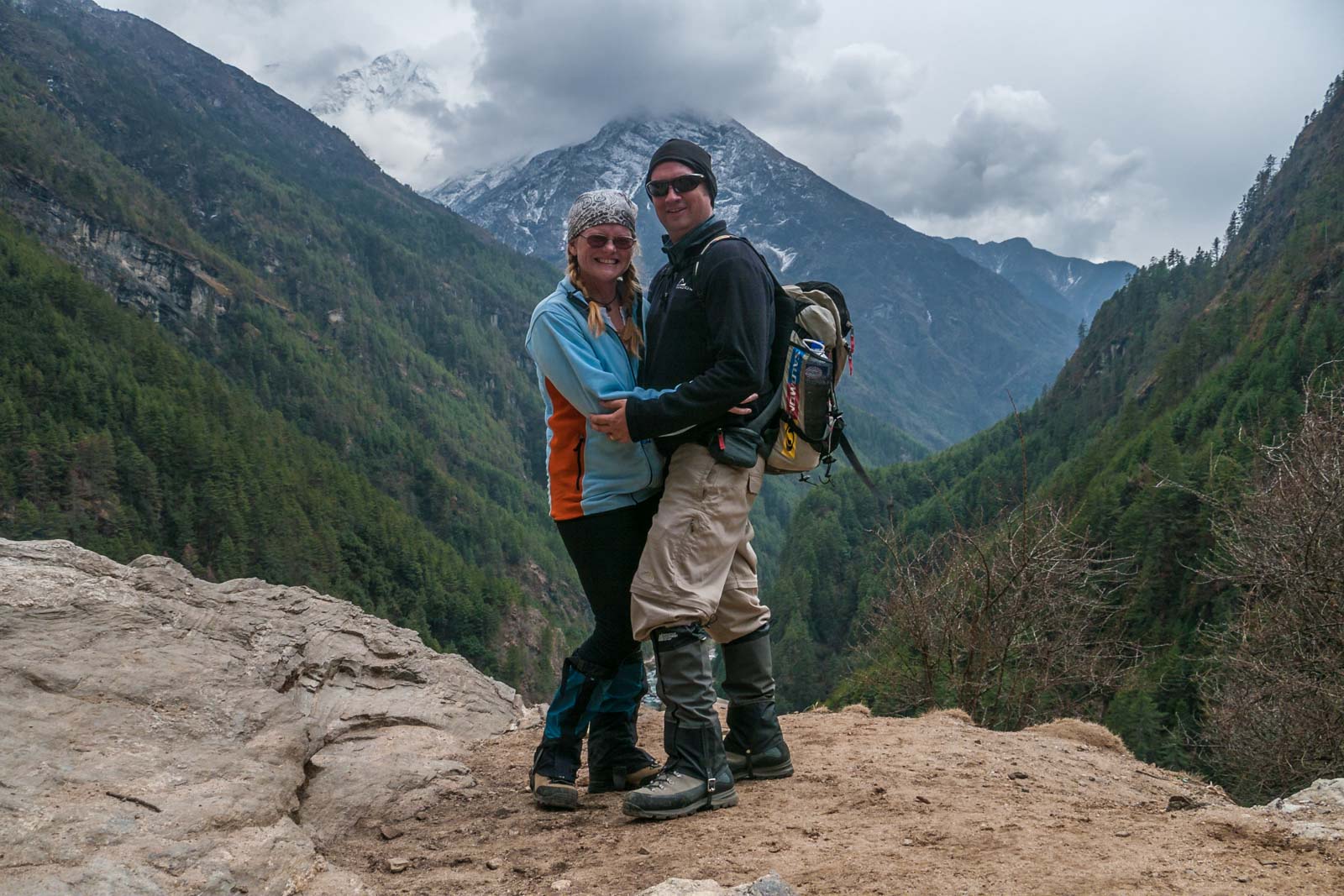
Prices can vary greatly for trekking to Everest Base Camp. You can contact Simrik Real Nepal for up to date prices.
- Booking with an international agency can cost from $1800 – $5000 USD
- Booking with a local agency and be anywhere from $1400 – $2500
W hen is the Best time to Trek to Base Camp?
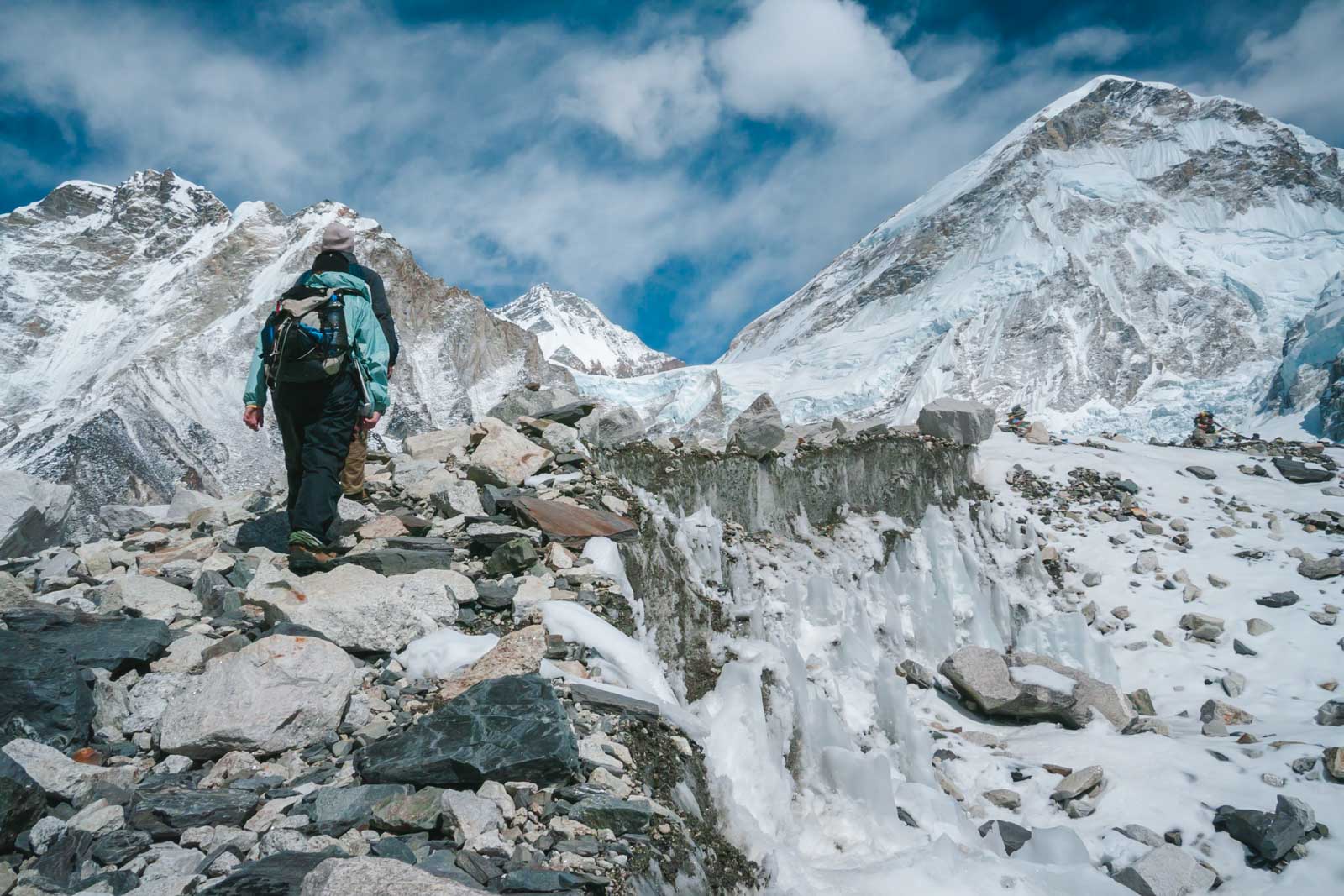
The high season for treks is April to May and October to November. We climbed in early March and felt that it was the perfect time of the year. The weather was beautiful, the skies were clear and the official climbing season hadn’t picked up yet. So we had a lot of the mountain to ourselves. We had heard stories of how busy the trail is, but at this time of year, it was quite deserted.
But a week and a half after our trek started as we made our way back to Lukla, it was already busier. We saw a lot of parties climbing up and the trail was getting congested. I can only imagine how packed the trails are during the high season.
What to Pack For Your Everest Base Camp Trek
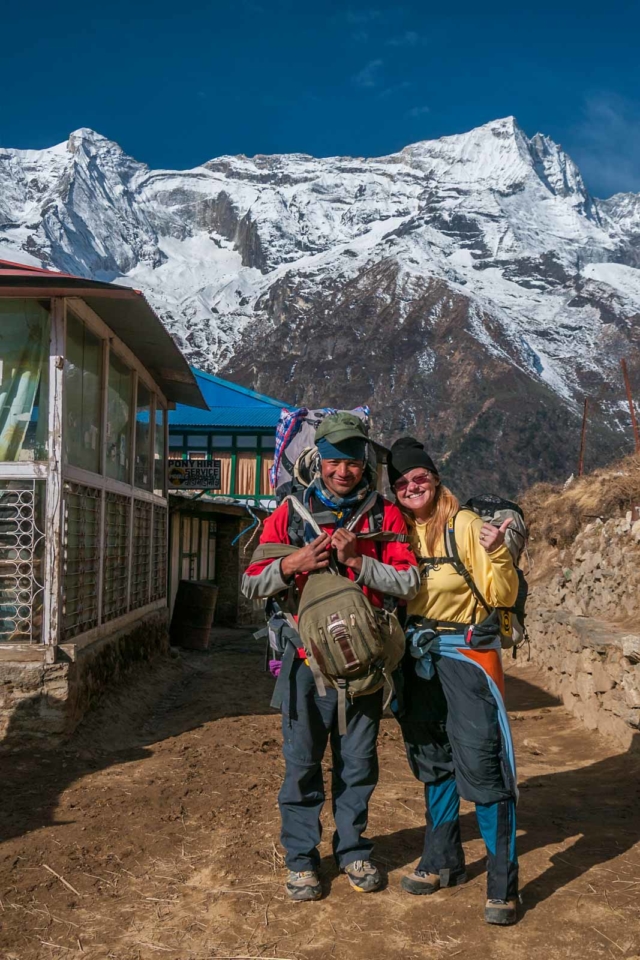
Layering is extremely important when trekking to Everest Base Camp. This is a quick guide for clothing but we wrote a complete packing guide for base camp here .
Make sure to have a day pack to carry the important items and layers that you will need for your day of trekking for the entire trek. Your porter will carry everything else.
- 2 quick drying long sleeved base layer shirts
- 2 trekking shirts short sleeve
- 2 Thermal Base Layer – 2 leggings/2shirts
- 2 liner socks
- 3 pairs of woolen blend trekking socks
- 2 pairs of trekking pants with zip-off bottoms
- 2 fleece sweaters – one lightweight, one heavier
- Outer windproof jacket and pants
- 2 water bottles to fill regularly
- Steripen or Lifestraw – this is great for purifying water
- Portable USB Charger
- Basic First Aid Kit – A first aid kit is important to have but your guide, they will have one as well.
- Warm sleeping bag. If you don’t have a sleeping bag rated to below zero, we recommend renting one from your guding company.
Treats and Medication
- Tang – I was glad we packed Tang for our water. It made it taste better, keeping us well-hydrated. We didn’t really want to drink just water, but the Tang (which we bought in Kathmandu) was actually delicious. Gatorade or another electrolyte-replenishing drink is a great idea.
- Diamox – (You can buy this in Kathmandu without a prescription) I highly recommend using Diamox tablets for altitude sickness as well. We met so many people suffering from headaches, dizziness, and fatigue and they weren’t taking anything. We’ve always used Diamox when climbing to altitude and it has worked beautifully for us.
- Chocolate – When we were feeling ill, we were happy to have chocolate to eat. It was the only thing that we could eat at times.
How to Get Fresh Water on An Everest Trek
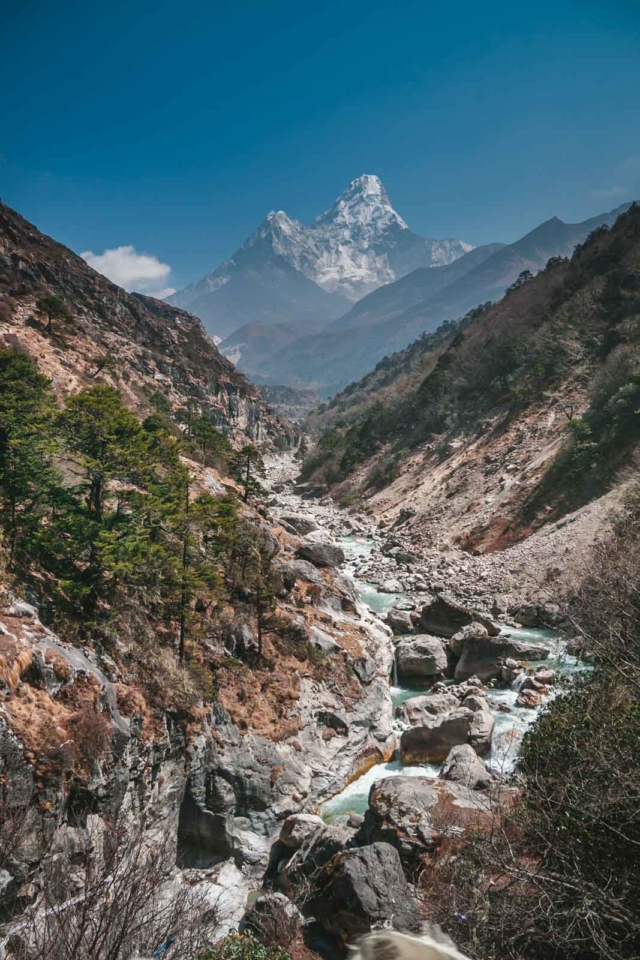
We recommend two refillable water bottles per person that can be refilled along the way. You can fill up anywhere for free along the Everest Base Camp route, but make sure you have a SteriPen or some other form of water purification with you. We love the SteriPen for purifying water, see our review here.
You can also use the LifeStraw or water purification tablets , but once we discovered the SteriPen , we never went back. See our complete Packing a Travel First Aid Kit here
Do You Need Climbing Experience for Everest Base Camp Trek?
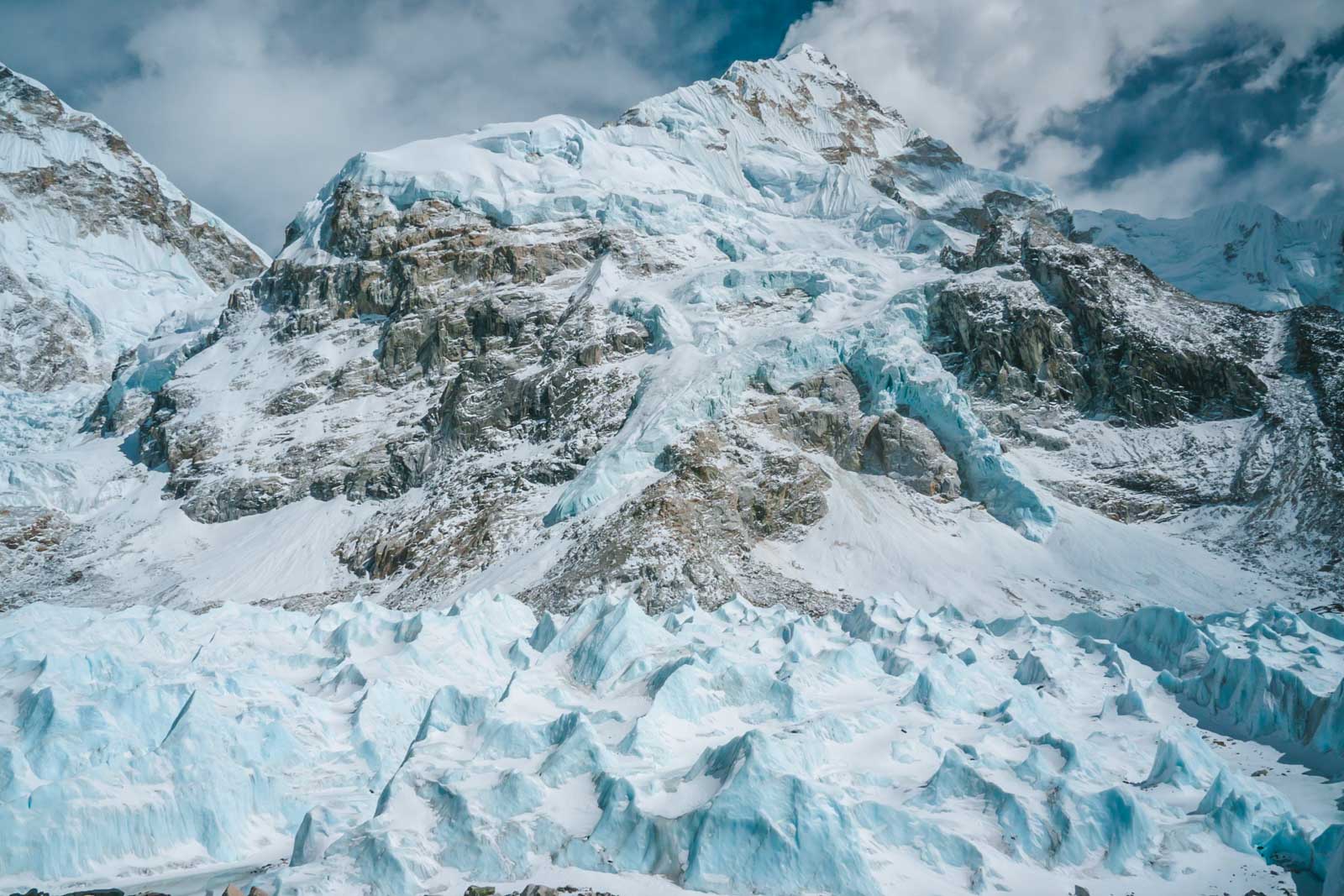
There is no need for any technical climbing experience to make it to Everest Base Camp. If you are relatively fit, it is very doable. But it is a full two weeks at a sustained altitude of over 4000 meters.
We didn’t train for our Everest Base Camp Trek but we had been to altitude before and had spent a lot of time backpacking leading up to the months prior. It’s good to know how your body reacts to altitude. We suggested doing a couple of treks above 3000 meters (9000 feet) to see how your body reacts.
Hot Tips for Trekking to EBC
- Keep your camera batteries close to your body when not in use. The cold and altitude really eat up battery life, so you will want to keep them warm for as long as you can.
- Bring USD, ATM Fees are high and you are limited to the amounts you can take out of the ATM, so have ISD to exchange instead.
- Pack handi wipes and Gold Bond Powder – it’s a lifesaver when you can’t get hot showers.
- See our Full list of Everest Base Camp Tips here.
How to Get to Everest Base Camp
There are daily flights to Kathmandu International Airport from international hubs around the world.
Where to Book Your Everest Base Camp Trek
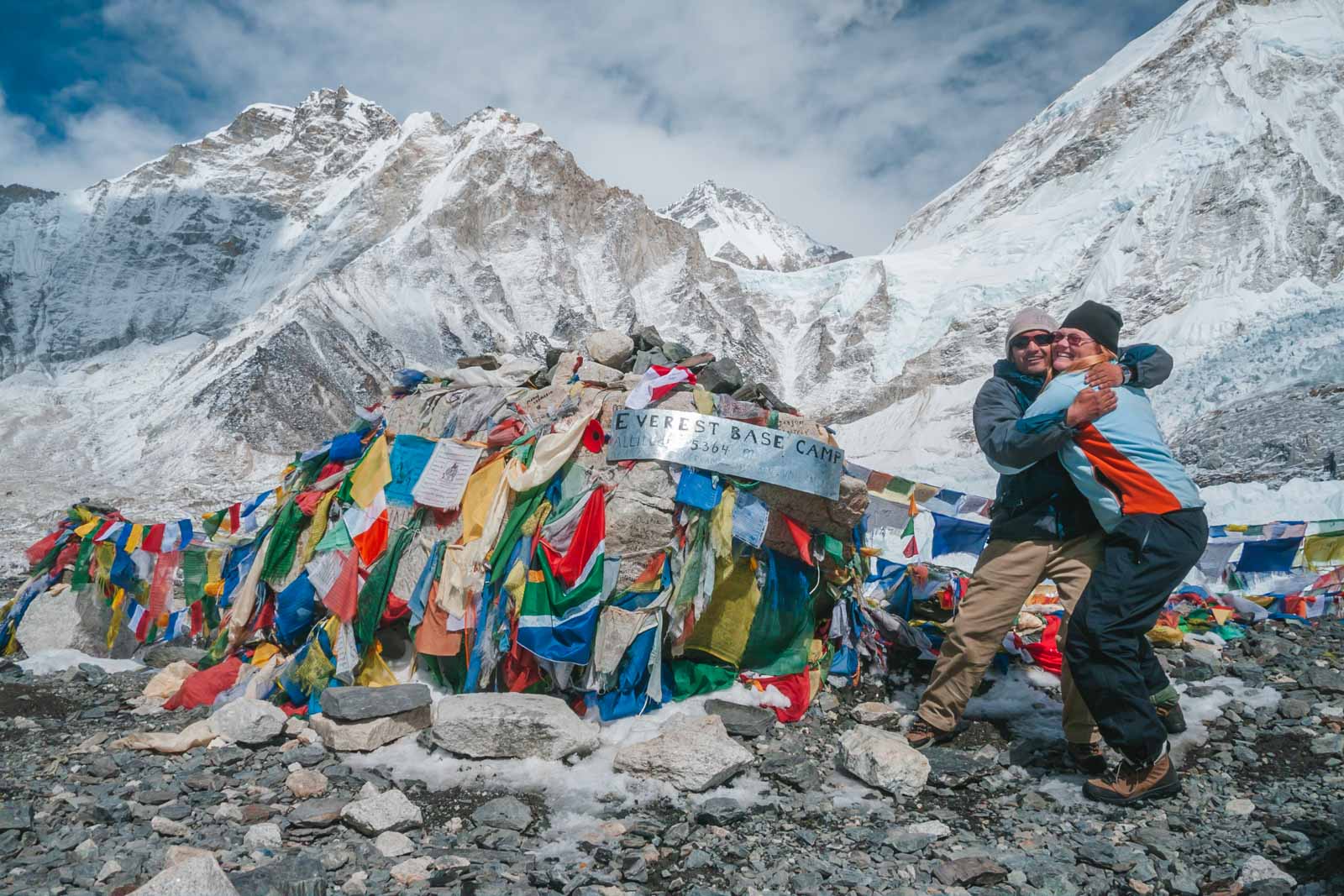
We booked our trek in Kathmandu with Local Guide Dipendra of Simrik Real Nepal. If you are looking for a local guide he is an excellent choice with nearly 20 years of experience in the mighty Himalayas.
Prices for the Everest base camp trek cost can vary depending on where you book. Group tours booked in North America will charge more. Ranging from $1500 – $5000 USD
You can save a lot of money by booking a local guide as you will cut out the middleman prices. Having a local guide let us know our money was going directly to the Nepal economy. Check with Simrik Real Nepal for current prices.
How Much to Tip Guides and Porters for an EBC Trek
Guides and porters in Nepal do not make a lot of money and rely on tipping. When we take tours of any kind, we (ourselves) tip 15% – 20% but that is a part of our culture in North America, we are quite large tippers and realize that others are not comfortable with that. We’ve done a lot of research and gone by what our tour companies have suggested on other tips, what we feel is a fair tip and what the average is across the internet.
For tipping in Nepal we have broken down the cost for a guide and porter.
Guide – Tipping – 10% – 15% of the total cost of the trip. We find this the easiest to figure out. If you paid $2000 for your trek, the lead guide should receive $200 – $300
Guide per day – Some suggest $10 – $15 per day per person for guides – For a 14 day trek that means you would tip your guide $140 – $210.
Porters per day – $5 – $10 per day per person for porters. – $70 – $140 for your porter.
We like to start at 15% of the total cost of our trips to give to the guides and then pay the porters a daily fee of $10.
If you can afford to trek to Everest Base Camp, you should be able to tip your guides and porters who have worked so hard accordingly.
Daily Life in the Everest Region of Nepal
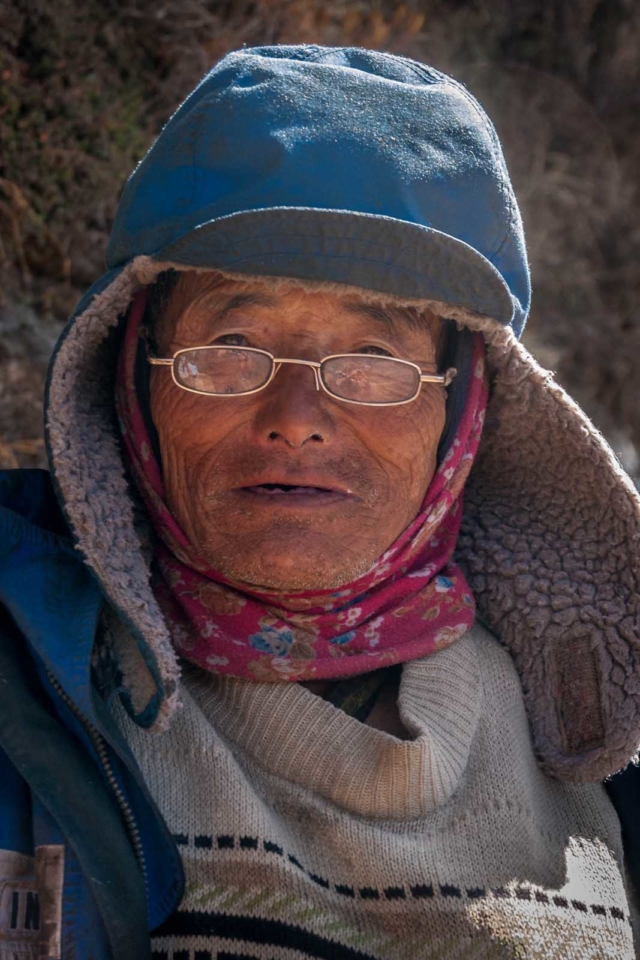
While trekking to Everest we passed through many picturesque villages. The people are friendly and life goes on as it would in any community in Nepal. People do well in the Khumbu Region and they respect the tours passing through because the tourists are what keep them going.
There is electricity from the water that they harness from the Imja Khola River and Dudh Kosi River; two rivers that run through the trek. They also have solar power for electricity as well. There are schools, fresh running water, televisions, a health clinic, and bars.
That is not to say that life is all roses. It is a remote region of Nepal and it is difficult to get any supplies in. Food and equipment need to be carried into villages on foot. Porters carry heavy loads on their backs and women and children also do the heavy lifting. Everything needs to be carted in by hand or by animals. Check out our tips for climbing to Base Camp
How Long Does it Take to Trek to Everest Base Camp?
The Everest base camp trek takes 12 – 14 days to climb including two acclimatization days. Treks can be done in 11 days and it is not uncommon for trips to take 15 days to allow for more acclimatization.
How Difficult is it to trek to Everest Base Camp?
Trekking to Everest Base Camp requires good fitness. You spend several days at a sustained altitude of more than 4000 meters (16,404 feet). Altitude sickness is a genuine possibility, it is important to take your time, stay hydrated, and listen to your body.
Can you trek to Everest Base Camp on your own?
As of April 1, 2023 the government states that all high altititude treks require a guide, but then after some backlash, they made an exception for the Everest region. However, we highly recommend hiring guides and porters . You can trek the region yourself carrying your own packs and gear, but you have a much better chance of making to base camp (and enjoying the experience) if you hire guides.
How Long is the Everest Base Camp Trek?
The trek is 63km (39 miles) each way . 126 km (78 miles) round trip from Lukla. Expect to hike anywhere between 7 to 17 km per day.
And that is a day-by-day breakdown of our experience on the Mount Everest Base Camp Trek. If you plan ahead and understand what to expect on the EBC Trek, you will be sure to have an amazing journey.
It’s an experience we’ll never forget and highly recommend it to everyone. The Himalayan Mountains are the most beautiful and spiritual place on earth and this trip will change your life.
Read More about travel to Nepal and things to do in Kathmandu before your trek
- Flight to Lukla
- Packing list for Everest Base Camp
- Remarkable Everest Base Camp Trek in Photos
- 30 Tips for Trekking to Everest Base Camp
- Nepal Travel Guide
- Top 6 Places to visit in Kathmandu, Nepal
- Where to Eat in Kathmandu – Eight Great Spots to Indulge After Your Trek
- The Ultimate Travel Songs Playlist to Inspire Wanderlust
Dal Bhat photograph courtesy of Wikimedia – I don’t know why we never took a photo of our Dal Bhat. We ate it nearly every day while trekking to Everest Base Camp. You’ll either learn to love it or despise it.
- Inca Trail – Machu Picchu Hiking Tips – How To Hike the Inca Trail
- Complete Guide to Climbing Mount Kilimanjaro – How Hard is It?
- Top 13 Best Treks in Nepal to Help you Choose The Right Trek for you
- Trolltunga Hike – Trekking to Norway’s Most Famous Landmark
- The Complete Guide to Climbing Mount Fuji
Travel Planning Resources
Looking to book your next trip? Why not use these resources that are tried and tested by yours truly.
Flights: Start planning your trip by finding the best flight deals on Skyscanner
Book your Hotel: Find the best prices on hotels with these two providers. If you are located in Europe use Booking.com and if you are anywhere else use TripAdvisor
Find Apartment Rentals: You will find the cheapest prices on apartment rentals with VRBO .
Travel Insurance: Don't leave home without it. Here is what we recommend:
- Allianz - Occasional Travelers.
- Medjet - Global air medical transport and travel security.
Need more help planning your trip? Make sure to check out our Resources Page where we highlight all the great companies that we trust when we are traveling.
You May Also Like
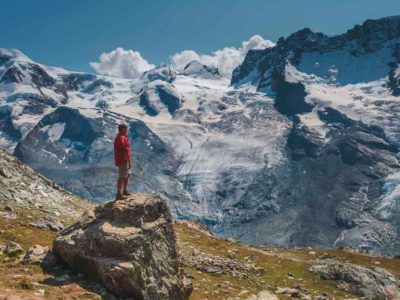
30 Beautiful and Best Hikes in the World
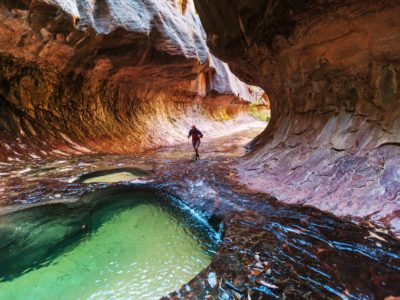
24 Best Hikes in the USA to Add to Your Bucket list
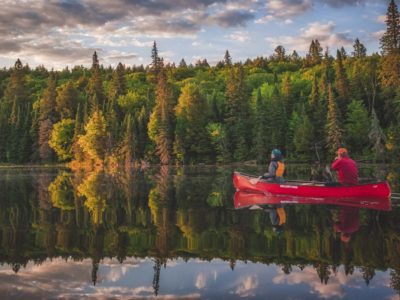
Weekend Warriors – 14 Awesome Hobbies to Turn You Into an Adventurer
About The Planet D
Dave Bouskill and Debra Corbeil are the owners and founders of The Planet D. After traveling to 115 countries, on all 7 continents over the past 13 years they have become one of the foremost experts in travel. Being recognized as top travel bloggers and influencers by the likes of Forbes Magazine , the Society of American Travel Writers and USA Today has allowed them to become leaders in their field.
Join thousands of others who get our monthly updates!
Leave a comment cancel reply.
Save my name, email, and website in this browser for the next time I comment.
53 thoughts on “Everest Base Camp Trek – Ultimate Guide For 2024”
Beautiful article! You have shared a thrilling journey with us till the end. It will definitely be useful for us trekkers. Thanks for the great pictures, videos, and useful tips!
This is a fantastic and unique post! After reading it, I learned a lot about Basecamp that I didn’t know before. Excellent article! That is true adventure, and conquering Mount Everest is without a doubt the goal of all hikers around the world. Keep up the excellent work. Thank you for providing this information.
Wow, the content has got all the details about the trek. Thank you so much for sharing your Journey experience of Everest Base Camp Nepal.
Hi There, Great Article! That’s the real adventure and especially climbing Mount Everest is the dream for all hikers across the globe without any doubt. Keep up the good work. Thanks for sharing.
Wow, the content has got all the details about the trek. Thank You so much for writing such an efficient article on Everest Base Camp Trek.
That’s the real adventure and especially climbing Mount Everest is the dream for all hikers across the globe without any doubt.
Thank you for taking the time and effort to produce such an awesome post with amazing pictures. Loved reading all your posts, really good insights here into Everest Base Camp ! Looking forward to read more.
Nice article on trekking best of luck for your new journeys
Dear Dave and Deb Namaste It is really beautiful article regards of Everest base camp trek in Nepal. Your article provides a lot details of the EBC trek. I’m sure your blog helping lot to organize other trekkers.
Excellent article. Everest Base camp is in my bucket list but I haven’t attempted because I’m prone to sickness quickly. Reading this article has triggered the interest even more. Thank you so much for explaining in detail about EBC trek. I hope One day I too can share my experience 🙂
Hey, I love trekking, I went last month with my friends in Nepal after reading your blog the memory are refreshed Thank you for sharing
Namaste, Dave and Dave, Thank you so much for sharing your Journey experience of Everest Base Camp Nepal. And also glad to read that why not support the local economy by hiring a guide and porter… I salute to your positive view. Visit Nepal anytime.
It is very interesting to read this Everest base camp trekking. I love trekking and i am excited very to do this base camp trekking once. Thanks for sharing.
This popped up in my inbox I love the way you break down your travel itinerary this way. I’m one of those people that love to know every detail of a place before travelling there myself. Another place to add to the list, thanks to you guys! Beautiful photographs.
Thank you for taking the time and effort to produce a terrific blog of your trek to EBC. I really appreciate being able to experience what it is going to be like before I actually arrive.
Everest is the highest mountain. It is at the Zenith. Most of the people just a dream of it.Very useful information. Thanks for sharing with us.
Excellent article !! Thanks for sharing such a great informative post it really helpful and amazing so keep it up and all the best………….
this was just amazing… keep sharing
The post was very informative. If you love adventure and treks you should definitely visit Nepal, it’s gonna be a life time experience. This post will really help people who are planning their next trek to Everest base camp. If you are planning your next trek to Nepal, North Nepal Trek can help you to make your trek much easier and will give you unique experience.
All of your photos are just awesome. Information is perfect.
Such an awesome post with amazing pictures. Thanks for sharing your experience with us.
This is really a very good blog post and thanks for sharing it with the community
It’s an informative post and I was thinking how you backpack for the weather? There are many things that somewhere can’t be cope at altitude like a sickness. I remember I scare when I attempt sky diving in Dubai. It’s was a wonderful experience but I have a fear of altitude places.
I have read about it but never tried. I am glad that at least i am reading such an informative article that clearly shows experience of treking over there. It might so much exciting and filled with happiness because seeing something like that would always be more of fun and achieving some of our own. Would love to try it once for sure!
Hi guys. Nice blog. Very informative. I just wonder, how did you prepare for the weather? How did you acclimatise so that you can cope with thr danger of altitude sickness? It is the ine thing that scares me to try to trek on high altitude places. To climb Kilimanjaro and to reach the EBC are in my bucket list. I’m hesitant because of my fear that I might die from cold temperature and altitude sickness.
Dress in layers, and drink plenty of water. You will want to bring DIamox with you and take it. You can get it in Kathmandu, or go to a travel clinic before leaving home. You won’t die from cold temperatures at Base Camp if you have a proper guide, and dress properly. The real dangers are if you are summitting Everest, that’s when you can get into problems, but Base Camp is very doable for anyone that is physically fit. If you don’t have the gear, you can buy winter coats, boots etc in Kathmandu. But we do recommend breaking in your boots beforehand, so you should buy those before you leave home and wear them a lot. Get warm, waterproof breathable boots with wool socks and bring several pairs. We have a guide to winter base layers to avoid the deep freeze here: https://theplanetd.com/layering-tips-for-cold-weather-travel/
Loved reading all your posts, some really good insights here into EBC! You mention putting your hair in braids, why is that? Is it because of the sweat? Is it windy so it gets knotted up? Just curious as I am doing this trek in a week and am open to all tips ?
Yes, hair can get really matted due to wind, dryness and lack of showering. The Braids kept it from matting up like dread locks. Have a great time!
Long hair can get very matted almost like dread locks. It’s becuase there aren’t a lot of chances to shower after Namche Baazar, the wind, sweat and dryness from altitude really takes its toll on both hair and skin and the braids, keep the hair from matting and breaking off.
Great read! Just curious. what time of year did you go to avoid the masses of tourists?
Thanks for sharing articles and videos it will be helpful to all people those wants to go Mount Everest.
This is just amazing and knowing each and every experience that we will have while travelling is another aspect that made me read this article fully. I am in Dubai now on a trip and would surely try to visit this place i could. I should consider the right time and other things roo. I must thank you for this wonderful piece.
Such a great journey you have shared from start to finish and your presentation is also impressive. I would love to follow these things when I will go for a camp tour.
Regards, Ronit
Your Video is superb, I feel your treking experience in this article. worth to read it.
Wow what an wonderful place is this. Want to trek this place in my life.
Great article, thanks, surprised at the early time of year you did the trek, but sounded ideal – any other good write-ups or links discussing the pros and cons of going in the spring vs fall? …weather, landscape, crowded w/ other trekkers, festivals, etc Thanks!
I am looking forward for this kind of base camp.
What an excellent post!! Thank you so much for an informative article and personal feel. This is very helpful and inspiring for my upcoming trek to Everest Base Camp.
There is so great view in pictures.it’s useful and helpful for the trekkers .i like these types of views .and tourist are also love these types of views.
Anyways amazing photos and love the videos! really gives you a feeling how it is there and must be just thrilling. Looking forward to read more about your travels.
Nice Articles and sharing a good details of Everest base camp and amazing photos. I will try to go this year Nepal and go to Everest Base Camp.
Great post. I am doing the Everest Base Camp trek in October. I completed the Annapurna Circuit in 2012 and loved it. Nepal is a such a lovely place and the people are amazing. Thanks for sharing!
Wow congratulations on your trip and everything looks really cool. I would love to do the same! Did you train a lot before you went there? Did you prepare physically? I don’t know how fit I have to be to be able to take on such a travel. Anyways amazing photos and love the videos! really gives you a feeling how it is there and must be just thrilling. Looking forward to read more about your travels.
Hi Marus, we didnt’ train a lot before. We were traveling a lot though. Before heading to Nepal we spent 4 months traveling Sri Lanka and India. We did a yoga retreat and a lot of hiking and walking, but we didn’t do any proper training. We were in relatively good shape. It’s mostly just a long uphill hike. The difficulty is being at altitude for a sustained amount of time. It affects everyone differently. Some people can be in tip top shape, but not do well at altitude and vice versa. So, it’s best to take it slow and steady, drink plenty of fluids and pay attention to how you are feeling.
All your photos are simple awesome and your posts are speaking a lot of useful information. Thank you for sharing this article.
Thanks for your beautiful video. I fell a little up lifted seeing this. I believe one of the prayer flags is for a lady I knew. Inspiring. I wish I would have done adventurous things like this when I was young. Young people don’t put off adventure.
I’m glad I read this. This is something I have always wanted to do but have been a little nervous to think about doing it when the climbing season is in full swing. The time of year you went and the company you chose make a lot of sense! Thanks for sharing.
The views are amazing!! I love adventure, but I would definitely need to build up my stamina to do the Everest Base Camp trek. It looks like it was an awesome experience for you!
Wow, what a beautiful experience. Your photos are amazing!
-Siggi The Voyaging Viking
Amazing! Can’t wait to check this off my list!
Thanks for writing this.
Thank you for sharing these helpful tips. Your post has given me some great ideas. Thanks again for the valuable information!
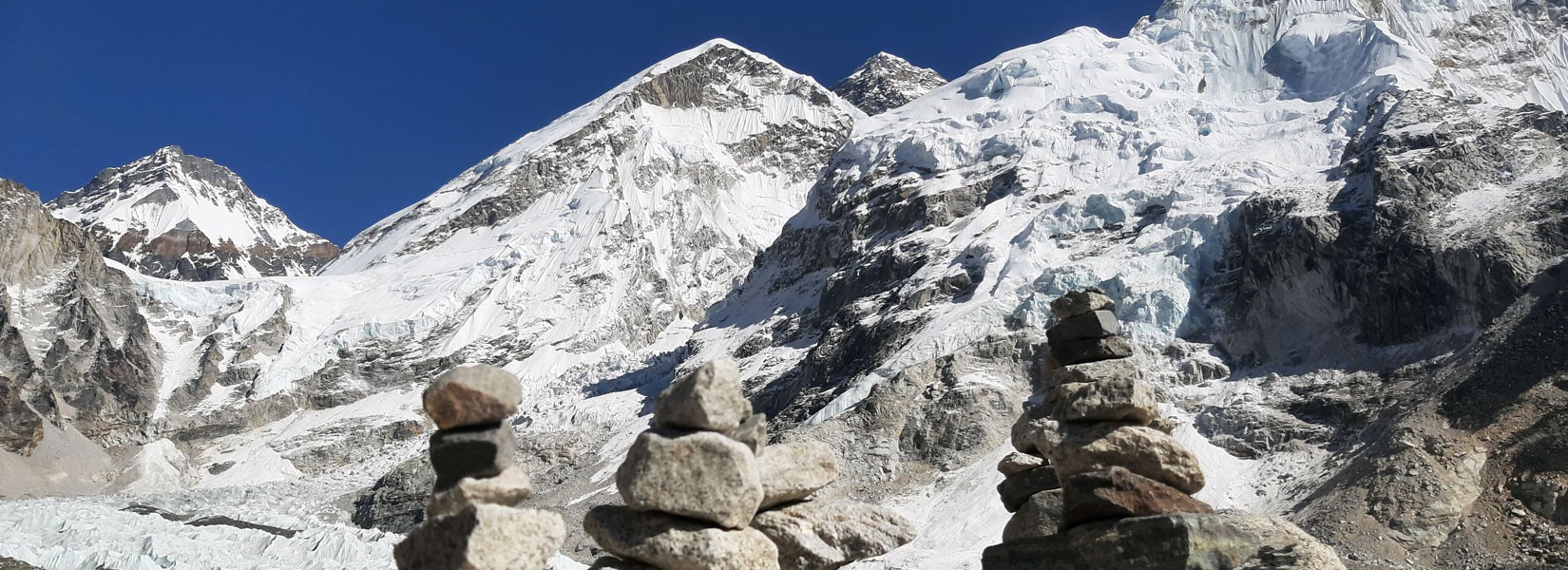
Everest Base Camp Trek Complete Guide
- You are here:
- Mar 17, 2024
- Kabita Gurung
Everest commonly known as Sagarmatha/Chomolungma is believed as the holy mother by the locals. Sagarmatha was coined by His Majesty during the 1960s, meaning the “Goddess of the sky”.The Goddess of the sky attracts many worshippers, some of them highly experienced mountaineers. There are two main climbing routes, one approaching the summit from the southeast in Nepal (known as the "standard route") and the other from the north in Tibet. But it was never easy to do the job. Tenzing Norgay and Edmund Hillary were the first to make the official ascent of Everest in 1953 finally after numerous unsuccessful attempts by numerous others before them. Since then, many enthusiasts have attempted to please and worship the holy Mother through their patience and persistence, many of whom offered their lives during their expedition and remained hidden in the mountain until discovered by others.
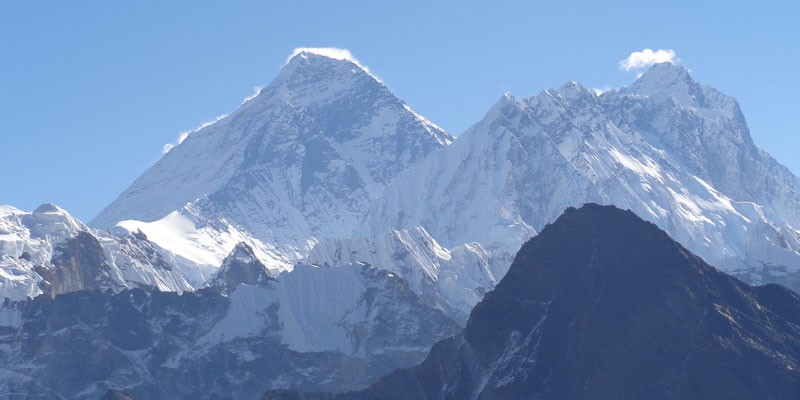
Yes, we can have this exotic experience of the world’s roof within 10-15 days of a strenuous yet mind-blowingly fulfilling trek to the base camp of the very own Mt. Everest. There are two base camps on Mount Everest, on opposite sides of the mountains: South Base Camp is in Nepal at an altitude of 5,380 meters, while North Base Camp is in Tibet at 5,150 meters.
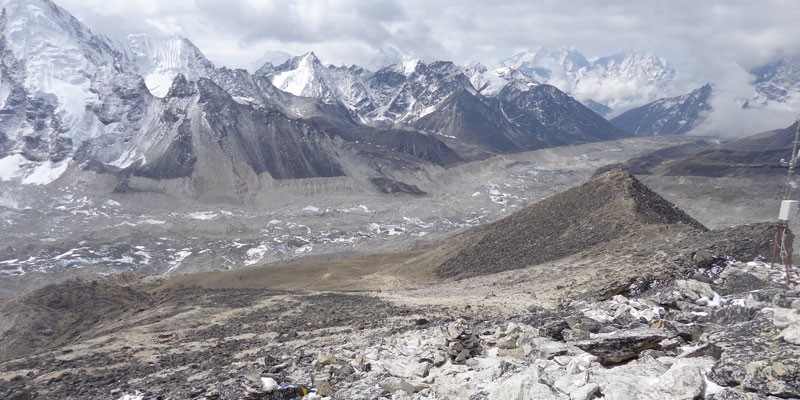
Table of Contents
Everest base camp trek itinerary.
Day 01: Arrive in Kathmandu (1350 M) and transfer to the hotel Day 02: Kathmandu Valley sightseeing and trek preparation Day 03: Drive to Ramechhap, fly to Lukla (2840 M) & trek to Phakding (2652 M) Day 04: Trek to Namche Bazaar (3438 M) Day 05: Acclimatization day at Namche Bazaar Day 06: Trek to Tengboche (3870 M) Day 07: Trek to Dingboche (4360 M) Day 08: Acclimatization at Dingboche Day 09: Trek to Lobuche (4940 M) Day 10: Trek to Gorak Shep (5140 M) and explore Everest Base Camp (5380 M) Day 11: Early morning climb to Kala Patthar (5545 M) and trek to Pheriche (4240 M) Day 12: Trek to Tengboche (3870 M) Day 13: Trek to Monjo (2835 M) Day 14: Trek to Lukla (2840 M) Day 15: Fly to Ramechap and drive to Kathmandu (1350 M) Day 16: Extra day in case of flight cancellation due to bad weather Day 17: Final departure
Transportation for the Everest Base Camp Trek
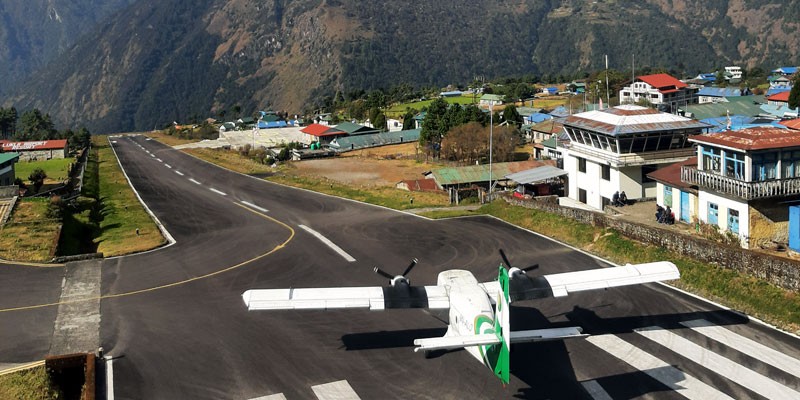
Flight and Transportation Costs
Kathmandu to Ramechhap Private Jeep Cost - 140USD Manthali to Lukla one-way flight cost -176 USD
Kathmandu Lukla flight cost-217USD
Everest Base Camp Trek Guide and Porter Cost
French Guide cost per day- 30 to 60USD English Guide cost per day- 20 to 40USD Porter cost per day- 20 USD
Permits and paperwork for the Everest Base Camp Trek
You will need Khumbu Pasang Lhamu Rural Municipality Permit, and a Sagarmatha National Park permit. The trekking agency that is providing the service to you will do all the permits and papers works.
Permit cost
The Khumbu Pasang Lhamu Rural Municipality Permit and the Sagarmatha National Park entry permit cost 20 USD and 30 USD per person respectively.
Food and Accommodation on the Everest Base Camp Trek
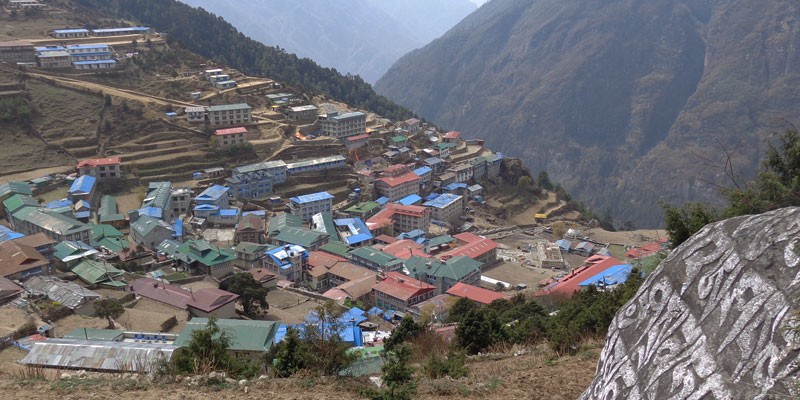
Still, we recommend a group size of a maximum of 10 people for a better experience.
Drinking Water on the Everest Base Camp Trek
Tap water and other natural sources are available along the routes which are drinkable using a water purifier, filter, or pills. Mineral water is available in plastic bottles and can be bought in hotels, teahouses, and lodges. However, we encourage you to buy less plastic bottled mineral water and use more natural and tap-sourced water for environmental concerns.
Electricity, Telephone, and Internet on the Everest Base Camp Trek
Electricity is available in most places. Solar is available where there is no electricity line. Most hotels and lodges charge a certain amount for charging your phone or camera.
The phone network works in most places. We recommend you buy an NTC sim card as it has better coverage in higher areas.
Wi-Fi service is available throughout the entire region. You will need to pay a certain amount to use it.
Everest Base Camp Trek Difficulty
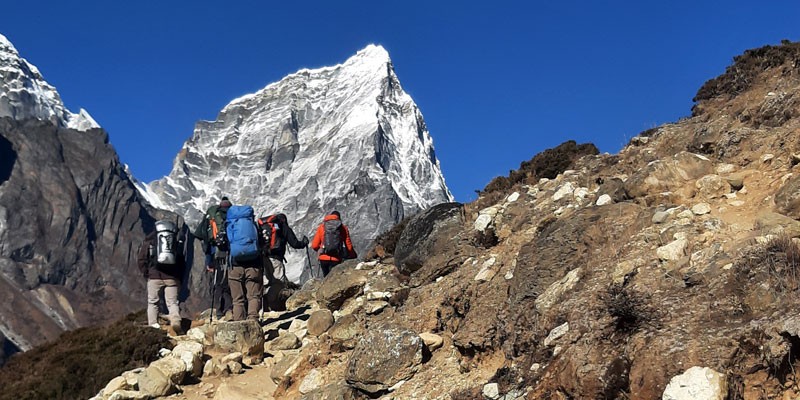
For people with no previous experience of trekking, taking cardio exercises like cycling, running, swimming, hiking, etc. for at least a month before trekking in Nepal is highly recommended.
While on the trek, you will do the acclimatization process where you will learn to acclimatize to the increasing altitudes day by day.
Know more about altitude sickness
Best time to do the Everest Base Camp Trek
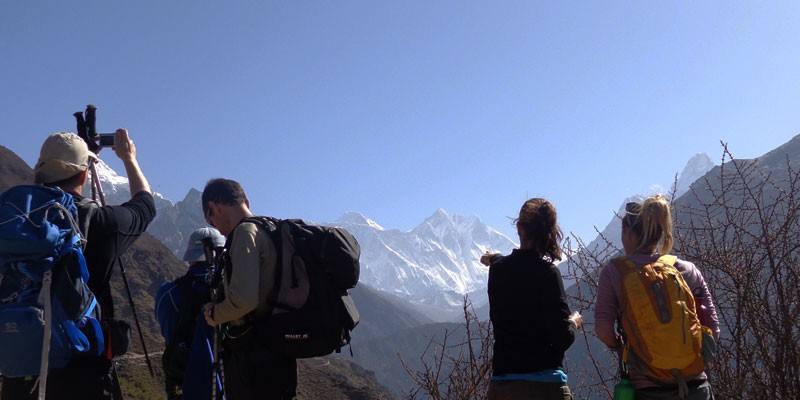
The ideal time to do the trek in this region is in the autumn (September-November) and spring (March-May) seasons. The weather is moderate during these times. The number of trekkers is also high in this period.
In the autumn, the skies are clear providing crystal clear mountain sceneries. Festivals like Dashain and Tihar are celebrated in these periods adding extra uniqueness to the trek. In the springtime, trails are decorated with colorful Rhododendron forests. The number of trekkers is a little less compared to the autumn season. The Nepalese New Year falls at this time. The skies are not as clear as during autumn and rainfall can be expected sometimes. If you would like to avoid the crowd, you can trek in the monsoon and winter seasons. In the monsoon, trails look beautiful with lush green forests. But the roads and trails are slippery with leeches in the lower regions. Mountains are not as visible as in autumn and winter. Trekking in the winter provides beautiful mountain scenery. However, the heavy amount of snowfall can make it impossible to trek in higher places and passes. You may need to return halfway or cancel the trek for safety concerns. And lodges and teahouses are closed down due to extreme cold.
Everest Base Camp Trek Variations
If you have plenty of time and would love to make the trek more interesting and adventurous, you can try out these different variations of the Everest Base Camp Trek.
- Everest Base Camp Trek from Bhandar - Everest Base Camp Trek via Gokyo Lake - Everest Base Camp Trek via Three Passes
Have any more questions about the Everest Base Camp Trek ? Please let us know. We will be delighted to answer all of your questions.
Send an Enquiry - Everest Base Camp Trek Complete Guide
Recent post.
- September 17, 2020
Best Hikes around Kathmandu Valley
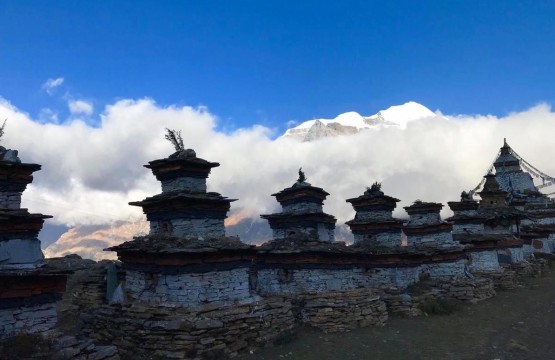
- September 09, 2020
Nar Phu Valley and Tilicho Lake Trek - The high route of the Annapurna
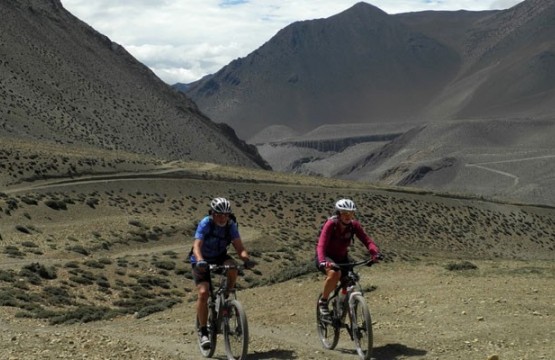
- July 28, 2020
Top 4 Mountain Biking Trails in Nepal
- Cultural Tours
- Day Hiking - 1
- Day Tours - 1
- Mountain Biking - 1
- Travel Information - 1
- Trekking - 4
Yak Ru Adventure Pvt. Ltd.
We're affiliated with
Registered with: company registration office, government of nepal, licensed by: nepal tourism board & department of tourism, proud member of trekking agency's association of nepal, general member of nepal mountaineering association.

From Lukla to Everest Base Camp: A Guide to the Best Routes and Trails
Quick links, how long is the trek from lukla to everest base camp, where can hikers stay while traveling from lukla to everest base camp, can any level hiker travel from lukla to everest base camp is it safe.
Located in the Himalayas lies the world-renowned trek from Lukla to Everest Base Camp, a journey that draws adventurers from across the globe. This 130 km (77 miles) round trip trek is a challenging but rewarding experience, showcasing the natural beauty of the region and offering a glimpse into the daily lives of the local Sherpa people.
The trek from Lukla to Everest Base Camp typically takes 13 days, starting from Kathmandu. Before embarking on this journey, hikers must train to prepare for the rigorous terrain and high altitude. This is especially important given the risks associated with being at such high altitudes for an extended period.
The trek from Lukla to Everest Base Camp is an unforgettable journey that offers a glimpse into one of the world's most breathtaking regions. With proper training and a sense of adventure, anyone can tackle this challenging but rewarding trek and come away with memories to last a lifetime.
- Lukla to Everest Base Camp is 38.5 miles.
- This entire hike should take people between 11 and 14 days in total.
- Many hikers between these two spots spend 8–9 hours walking daily.
For people wanting to take on Everest Base Camp from Lukla, this will be the journey of a lifetime. This trek between the two spots is approximately 38.5 miles, usually taking hikers 11–14 days. One thing to note, this trek is 38.5 miles either way: totaling 77 miles. According to past hikers, people will begin their eight-day hike from Lukla to the Everest Base Camp and then four days to trek back to Lukla. Some may want to hang out at Everest Base Camp for a couple of days, so that will add time to the entire voyage.
Luckily, the scenery between these notable hiking locations offers unparalleled views of the surrounding landscape, giving adventurers insight into the Sherpa people. Another detail to remember when traveling between Lukla and Everest Base Camp is that most people recommend hiking for 8–9 hours daily to keep the schedule at 11–14 days.
Some people even skydive from Mount Everest : so the adventure doesn't need to stop at the ground.
Related: 10 Stunning Himalayan Hiking Trails That Are Not Everest (Or Even Close)
The Best Trekking Route To Everest Base Camp
When it comes to the best route for those trekking to Everest Base Camp, people want to take The Classic Everest Base Camp trek. This path is the most direct route from Lukla to the 18,192-foot peak of Kalapatar. Hikers will also get the best view of Mount Everest from here, so that's perfect for those wanting to snap a few photos.
However, here are some alternative routes and timelines that one could take to get to the Classic Everest Base Camp Trek:
- Jiri to Everest Base Camp (19–21 days trekking)
- Tumlingtar to Everest Base Camp (21–23 days trekking)
- Gokyo Over Cho La Pass (17–18 days trekking)
- Lukla to Tengboche (around 7 days trekking).
The trek from Lukla to Everest Base Camp is 38.5 miles each way, totaling 77 miles for hikers. Therefore, to finish this trek in 11–14 days, hikers must spend 8–9 hours daily on the move.
- Hikers can stay between Lukla and Everest Base Camp in teahouses, lodges, and campsites.
- Phakding lies between Lukla and Namche Bazaar, making it a great stop along the way.
Trekking from Lukla to Everest Base Camp will have a few lodging opportunities between the two destinations. Generally, past hikers recommend stopping in Phakding, which takes roughly 3 to 4 hours to walk from Lukla. Along this trail, people can stay in lodges or teahouses, which will be primitive and won't be a "typical" experience. The road to Everest may be daunting, so preparing for this journey is crucial .
To explain these teahouses/lodges , they are houses with usually more than two floors but sometimes only one, with dozens of rooms. This could be a fun way to meet other adventure seekers along the way to Everest Base Camp (and back), so don't be afraid to start a conversation.
The trail between Lukla and Everest Base Camp is globally visited, so there will be people from all different cultures and countries to enjoy this with. These ten Everest Base Camp facts may be fun to know before the journey.
Related: Mt Everest: The History & Story Behind The World's Tallest Mountain
In general, if someone is healthy and regularly hikes, they should be able to handle the walk from Lukla to Everest Base Camp. One thing to keep in mind, however, is that this trek isn't easy but isn't nearly as challenging as taking on Mount Everest. The entire region is known for its high elevation and chilly weather, which may be difficult for some hikers.
There are many things to see and experience at the base of Mount Everest , so people don't need to take on the summit to have a memorable experience.
According to trek guides , the Everest Base Camp area is far easier for hikers than other areas, especially when compared to Everest: often considered one of the more dangerous journeys on Earth. It may be helpful to train before heading to Lukla and then to Everest Base Camp, taking on hikes near where someone lives. For example, if there are mountains nearby, that could be a great way to train for this Nepal adventure.
Going to the gym and using machinery at an incline may also help prepare someone for this, although nothing beats getting outdoors. If there is any hesitation with taking on a trek from Lukla to Everest Base Camp, it might be worth consulting a doctor and ensuring people's health is good enough to head to the mountains.
These are ten essential tips for anyone traveling to Everest Base Camp that are worth reading.

California climbers train for Mt. Everest from the comfort of their own beds

- Show more sharing options
- Copy Link URL Copied!
Graham Cooper sleeps with his head in a bag.
Not just any bag. This one has a hose attached to a motor that slowly lowers the oxygen level to mimic, as faithfully as possible, the agonies of fitful sleep at extreme altitude: headaches, dry mouth, cerebral malaise.
“It’s not all bad,” Cooper insisted, nodding to the humming motor. “That’s like white noise.”
Cooper, 54, an Oakland biotech executive who has handled finance for a number of companies, including one that sold for $7 billion, isn’t a masochist, exactly. He’s acclimatizing, in the bedroom of his second home near Lake Tahoe, for an attempt to climb Mt. Everest in May.

He has signed up with an Olympic Valley-based guide service whose founder, Adrian Ballinger, is breaking with decades of tradition to create what he believes are better and more ethical ways to climb the world’s tallest mountain.
Ballinger said he was appalled by the risks, filth and ballooning crowds on the traditional southern trek up the mountain in Nepal. That’s the route familiar from countless documentaries and books, including the 1997 classic “Into Thin Air.”
So he decided to take clients up on the north side, a journey that starts in Tibet.
“It’s colder, the route is more difficult, and the bureaucracy of dealing with China and getting the permits is a complete nightmare,” Ballinger said. “But despite those things, the Chinese are attempting to regulate, so once you get on the mountain, it’s safer, it’s cleaner, and it’s much less busy.”
Ballinger is also pioneering a technique he calls “rapid ascent,” which cuts the duration of the expedition roughly in half: from about two months to about one. That suits his clients, who usually have more spare money than time. And it buys Ballinger more time to spend at home with his wife and newborn son.
The catch? You have to spend a few months before the trip with your head in the bag.
“It’s not great, I’m not gonna lie,” Ballinger said with a laugh, but the technology is improving.

“Hypoxic tents,” as they’re called, have been used by other endurance athletes for years. In their original form, they would cover a client’s entire bed. That led to difficult conversations with spouses and partners about the necessity of sleeping at progressively higher simulated altitudes until they reached the height of Everest’s base camp, roughly 18,000 feet, where there’s about half the oxygen available at sea level.
As you can imagine, some clients wound up relegated to a couch with their bizarre-looking contraptions.
Cooper, who used one of the enormous old tents preparing for a 2015 trip to climb the highest peaks in Antarctica and South America, confessed he had no luck sweet-talking Hilary, his wife of 28 years, into sharing the adventure. He got bounced to a guest room.
“It was a lonely boy-in-the-bubble experience,” he said. But he has fond memories of the looks on his kids’ faces as they trooped into his little dungeon to kiss him good night.
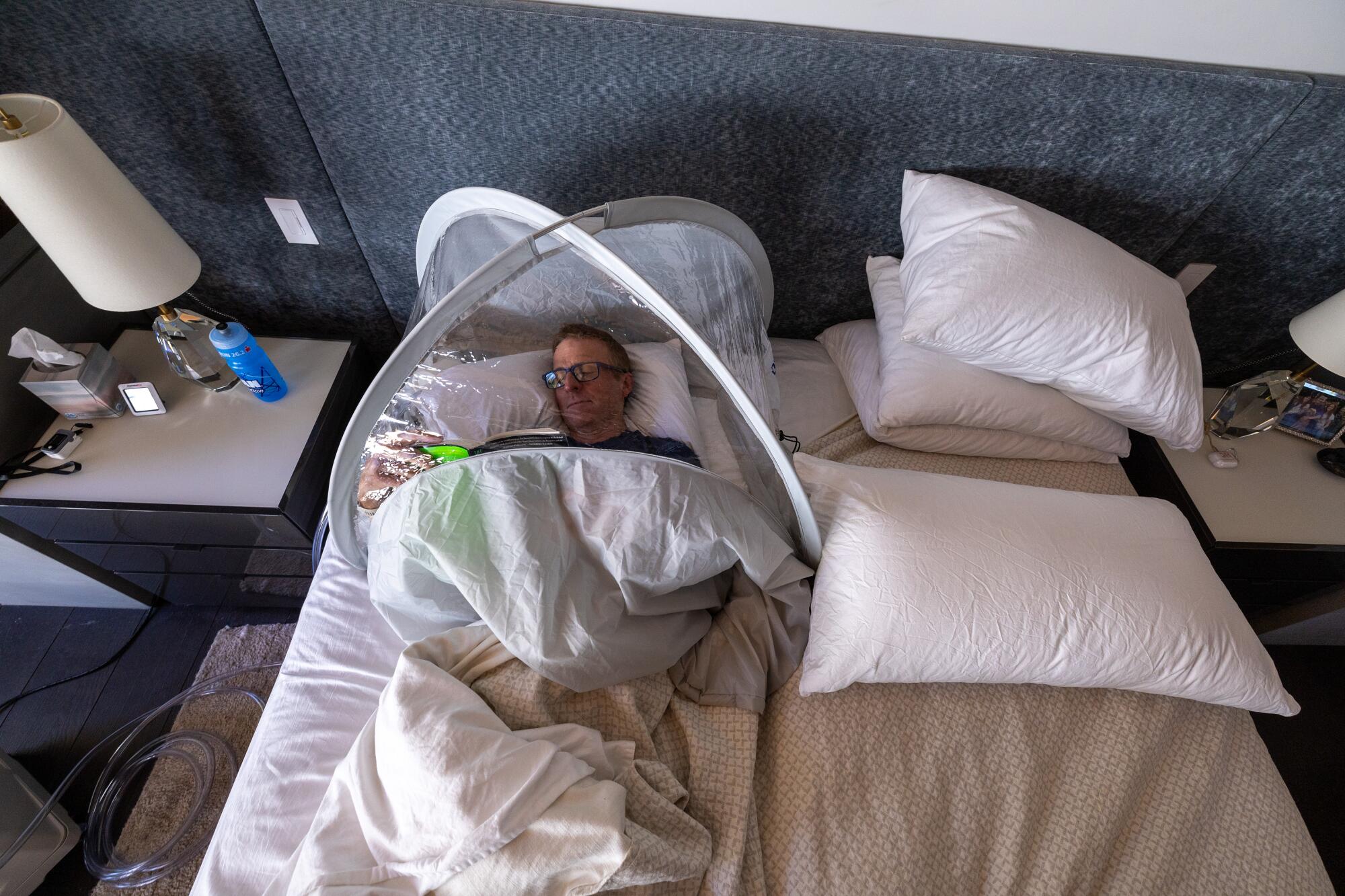
This time around, “the bag,” as he calls it, covers just his head and upper torso and takes up about a quarter of the bed. Hilary sleeps next to him, Cooper said, and she finds the hum of the motor surprisingly soothing.
It goes without saying that the luxury of acclimatizing at home, in bed, with your partner curled up beside you, represents a profound break from the usual manner of preparing to ascend what is still one of the world’s deadliest mountains .
The traditional method starts in Kathmandu, at nearly 5,000 feet, where climbers spend a few days getting over jet lag. That’s usually followed by a quick flight to the small mountain town of Lukla, at just over 9,300 feet. The airport there — perched on a narrow Himalayan shelf surrounded by towering peaks, with a steep drop-off at the end of the runway — is regarded as one of the trickiest places in the world to land an airplane.
From there, climbers begin a long, deliberately slow 10-ish-day hike to base camp. The point is to give the body time to gradually adjust to the lack of oxygen.
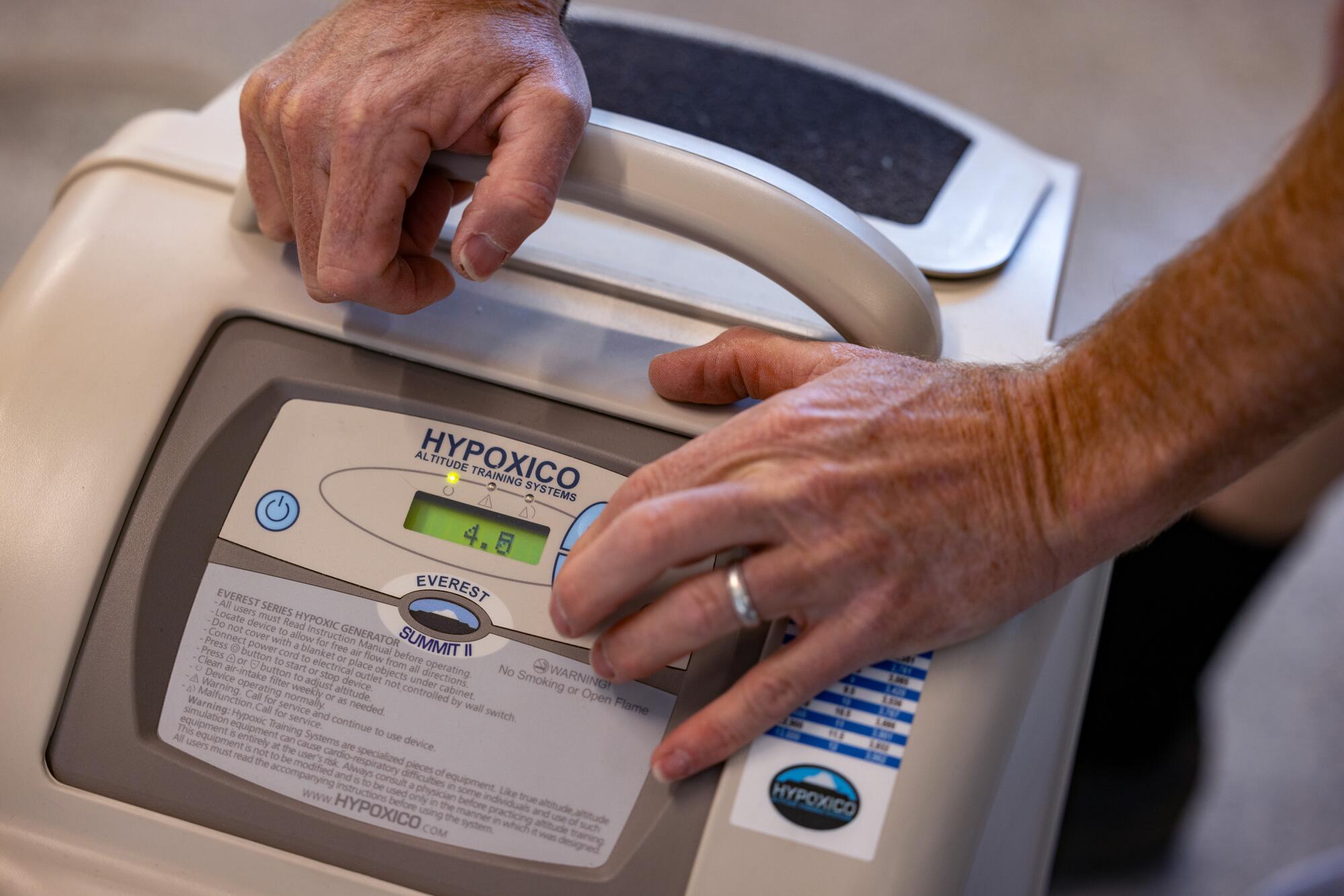
Ballinger cuts nearly two weeks from his trips by driving his bedroom-acclimatized clients from the airport in Lhasa, Tibet, straight up to the northern route’s base camp, which is also at about 18,000 feet.
For some old-school purists, eliminating the long walk borders on sacrilege, said Will Cockrell, a journalist whose recent book, “Everest, Inc.,” explores the evolution of commercial guiding on the mountain. “They’ll say, ‘You’re not a real climber; you’re not a real nature lover,’” Cockrell said.
But since the arrival of big commercial expeditions on Everest in the mid-1990s — complete with Sherpas to install climbing ropes, chefs to cook meals in camp, team doctors to monitor health, and guides to accompany clients every step of the way — Mt. Everest has ceased to be a classic off-the-grid mountaineering challenge.
“It has come to represent something completely different,” Cockrell said, “something crazy to do to shake up your life, like running an Ironman.”
Ballinger makes no apologies. “We’re not old school, we don’t spend a lot of time sitting around drinking whiskey and playing cards,” he said.
That suits his clients, who “tend to be pretty type A, pretty high performing in everything they do,” Ballinger said.
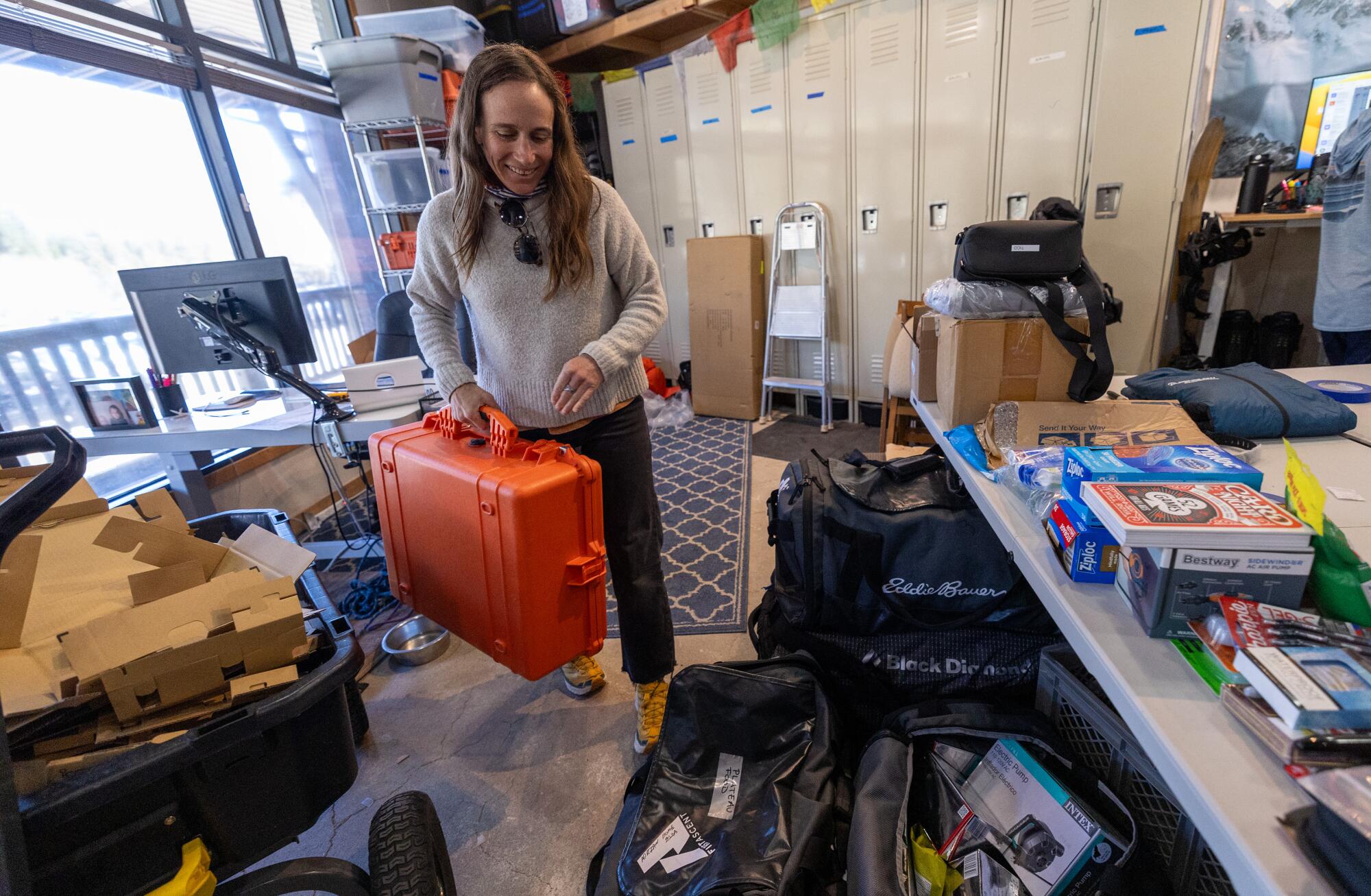
They’d better be. His company, Alpenglow Expeditions , charges $165,000 (before tip) for a private climb, meaning one professionally certified guide per client, and $98,000 for a group climb with three clients per guide.
“We’re proudly expensive,” Ballinger said. “I’ve spent a lot of time thinking about what it takes to run a trip safely and ethically, and this is what it takes.”
Climbing from the north side, as Ballinger does, avoids the huge crowds who flock to the southern base camp from all over the world every May, the prime climbing season on Everest, to wait for a brief window of good weather to try to make it to the summit.
Anyone who has even loosely followed events on Mt. Everest in recent years is probably familiar with the terrifying “conga line” photos of climbers stuck in the world’s highest traffic jam.
It forms just below the summit on the southern route, at the last technical obstacle, a nearly vertical 40-foot rock wall called the Hillary Step. It’s on a ridge with a 10,000-foot drop to the climber’s right and an 8,000-foot drop to the left. So, when exhausted and inexperienced climbers inevitably struggle there, everybody else waits in a single file, hanging onto a fixed rope, while the bottled oxygen they need to survive at that altitude slowly drains away.
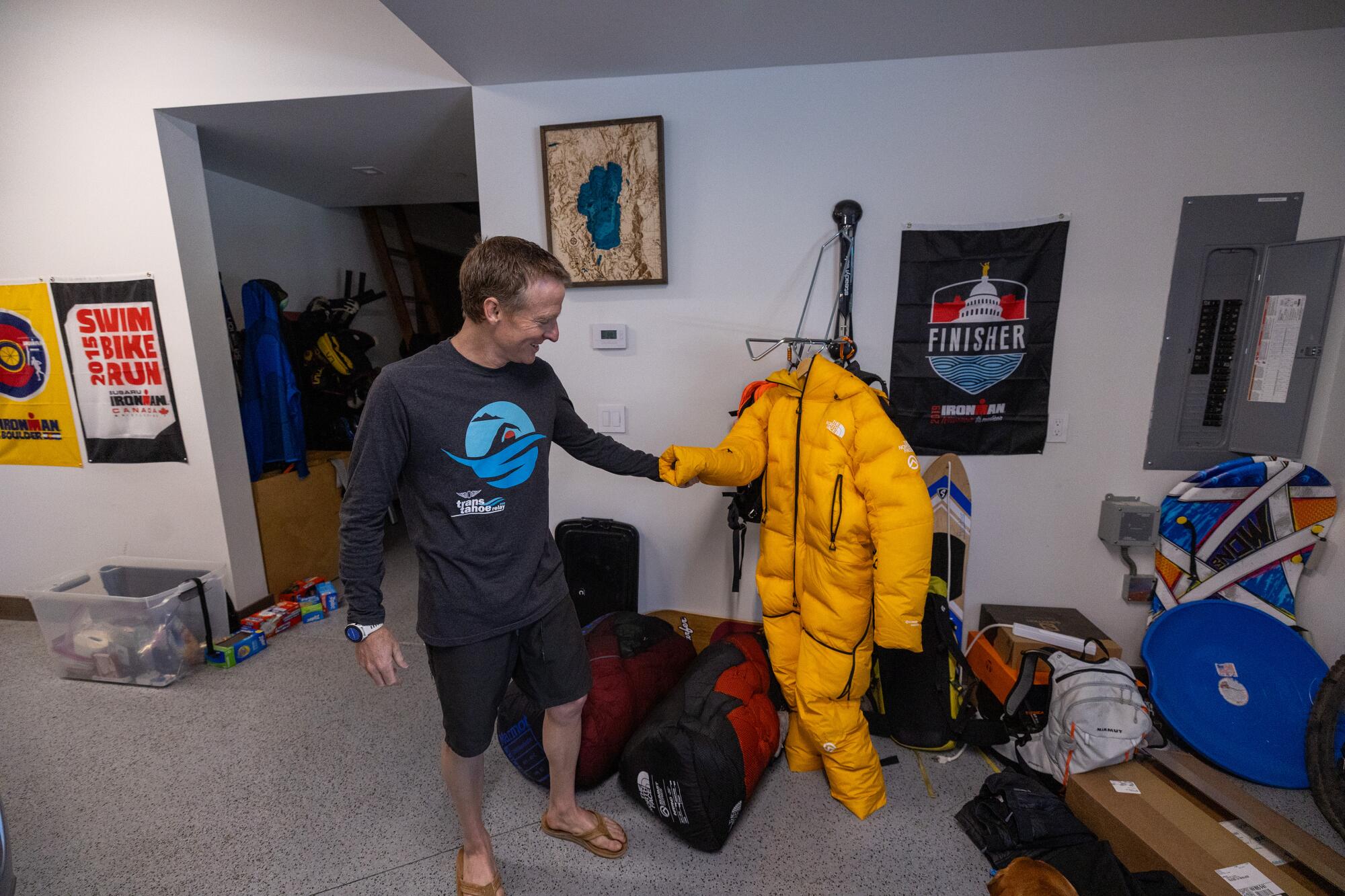
Worse is the Khumbu Icefall, a glacier just above the southern base camp. It’s best known for wide spine-tingling crevasses spanned by flimsy-looking aluminum ladders lashed together with rope. Climbers have to walk across those ladders, wearing big boots and crampons, as they make multiple trips back and forth to advanced camps to acclimatize before finally heading for the summit.
As dangerous as it is for the mostly foreign climbers and guides, the odds are even worse for the local Sherpas, who regularly traverse the Khumbu ferrying equipment — tents, food, oxygen canisters — for the climbing teams. Last year, the deadliest climbing season in Everest history, three Sherpas were killed in the Khumbu when a towering block of ice collapsed and buried them.
In six seasons climbing the southern route, from 2009 to 2014, Ballinger said he passed through the Khumbu 38 times and had two close calls. While nobody on his teams lost their lives there, he helped recover the bodies of other climbers who had not been so lucky.
Finally, he did the math and concluded there was no way he could get through a whole career — 20 or 30 years — without losing someone he was responsible for in the Khumbu.
“I just couldn’t do it anymore,” Ballinger said. “I just couldn’t justify the risk.”
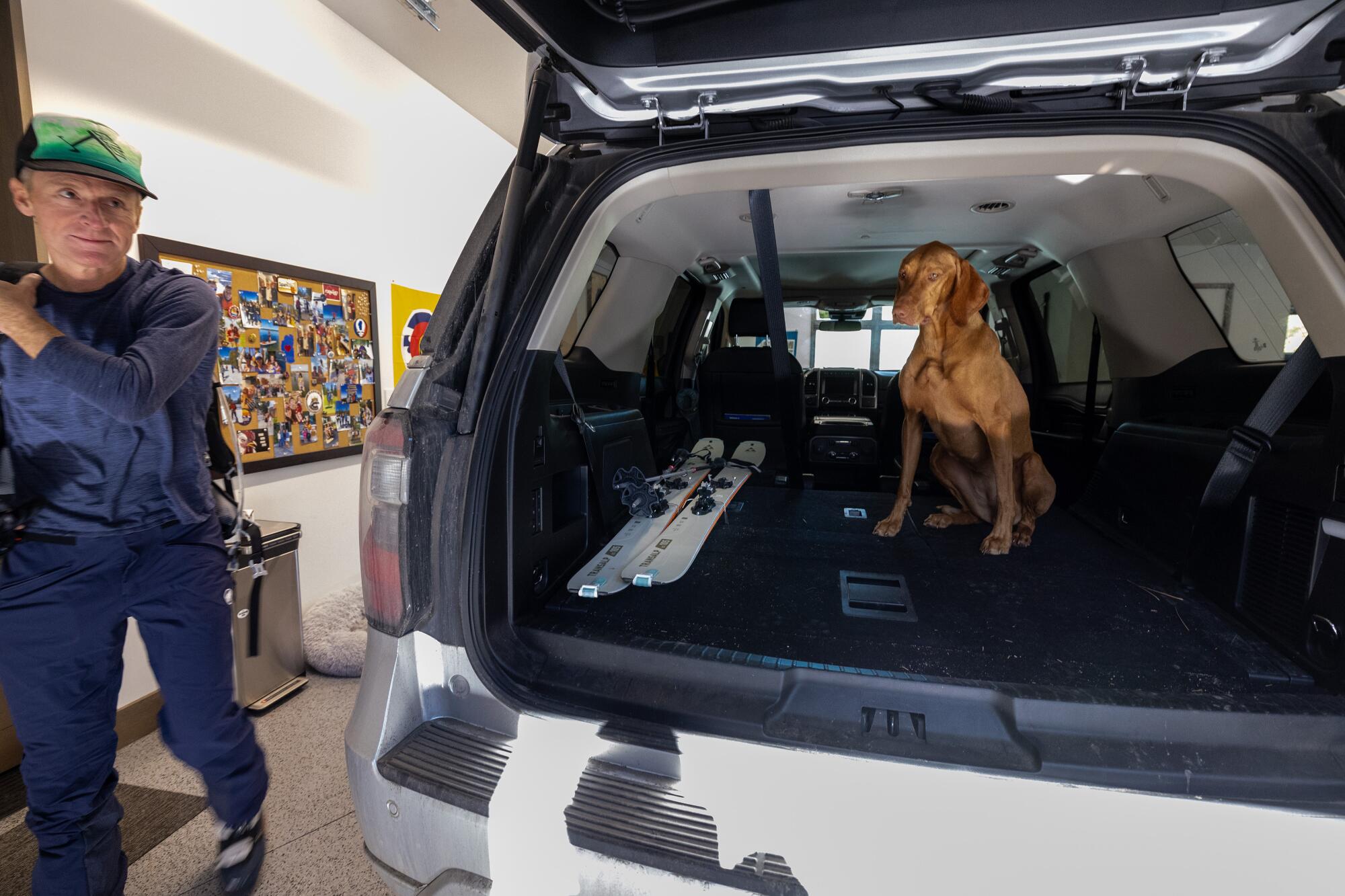
Ballinger’s data-driven approach and stellar track record were enough to win over Cooper.
And he has been willing to wait.
He was ready to climb Everest four years ago, but when China shut down expeditions to its side of the mountain in 2020 in response to the COVID-19 pandemic, Ballinger stuck to his principles and refused to resume climbing with the crowds in Nepal. This is the first year since the pandemic that the Chinese side has been open.
The Alpenglow team, which includes 26 clients, guides and Sherpas hoping to reach the summit, were originally scheduled to begin their expedition in late April. After a late permitting change from the Chinese government, that date has been pushed back to May 7.
Cooper has competed in the Ironman World Championship in Hawaii 11 times and has won the legendary Western States Endurance Run, a 100-mile ultra-marathon. He is not a man accustomed to sitting around. “I’m feeling ready and anxious to get going,” he texted a reporter last week.
When not trying to sleep in his hypoxic tent, Cooper has spent his training days in Tahoe on back-country skis doing laps up and down a mountain, his 3-year-old dog, a Vizsla named “Busy,” at his heels. Indoors, he straps on a hypoxic mask hooked to the same motor he uses for the sleeping tent and rides a stationary bike an hour at a time. Or climbs a StairMaster. Or throws on his mountaineering boots and a heavy backpack and trudges up and down slopes.
“I’m addicted to doing this kind of stuff,” said Cooper, who ran his first marathon when he was 13. “I just feel like a fundamentally happier person when I’m training.”
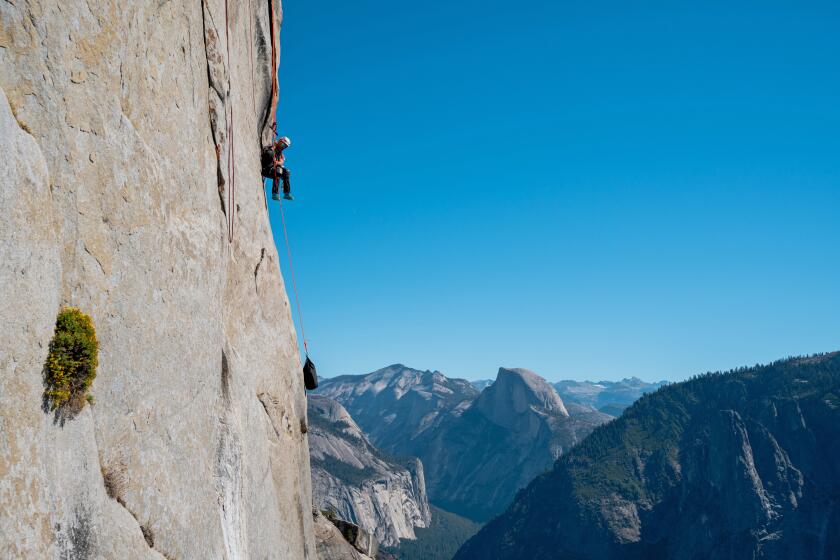
After a trust fall left him paralyzed, climber scales 3,000-foot El Capitan using only his arms
In 2015, mountain guide Zuko Carrasco’s world collapsed in a trust fall gone awry. Eight years later, he looked to reclaim his independence with an audacious plan to scale El Capitan.
Jan. 11, 2024
Ballinger leads clients on bucket list climbs all around the globe. Many of the treks present more interesting technical challenges than Everest. Almost all of them feel like wild outposts compared with the circus vibe on Everest’s south side.
Still, he gets poetic when he describes why so many clients are drawn to the world’s tallest summit.
“Because it’s so hard,” he said. It takes incredible fitness, mental fortitude and a heavy dose of luck to make it to the top. And no matter how many precautions you take, there’s that uncontrollable element of risk.
“It’s not just a battle for success, it’s a battle for survival up there,” Ballinger said. “That’s something that many of us have not experienced otherwise. I think that really captures people.”
More to Read
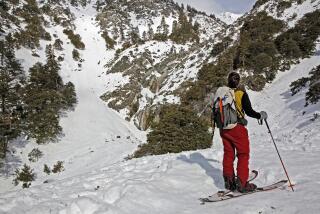
Letters to the Editor: Permits won’t deter hikers who have no business on Mt. Baldy
March 14, 2024
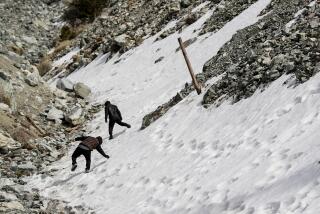
Editorial: Winter permits for Mt. Baldy could save lives of hikers — and rescuers
March 11, 2024

‘Craziest thing you can do’: Why are so many adventure seekers warming up to ice climbing?
Jan. 23, 2024
Start your day right
Sign up for Essential California for news, features and recommendations from the L.A. Times and beyond in your inbox six days a week.
You may occasionally receive promotional content from the Los Angeles Times.

Jack Dolan is an investigative reporter for the Los Angeles Times. A winner of numerous national awards, he has twice been named a finalist for the Pulitzer Prize.

Brian van der Brug has been a staff photojournalist at the Los Angeles Times since 1997.
More From the Los Angeles Times

Travel & Experiences
Zip, zoom and soar in L.A.’s extraordinary new playground for bike riders
May 2, 2024

Climate & Environment
San Gabriel Mountains National Monument expands by more than 100,000 acres

Chuckwalla National Monument would protect swath of California desert and preserve a sacred land
April 28, 2024

L.A. supervisors oppose plan to eradicate Catalina deer by shooting them from helicopters
April 27, 2024
Happy Moscow Tours
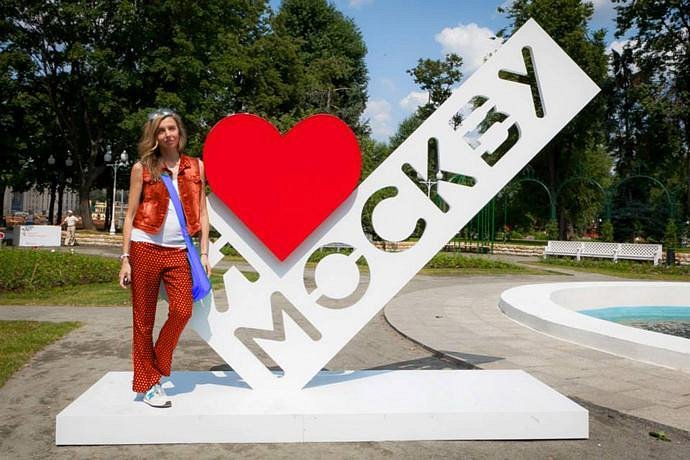
- See all photos

Most Recent: Reviews ordered by most recent publish date in descending order.
Detailed Reviews: Reviews ordered by recency and descriptiveness of user-identified themes such as waiting time, length of visit, general tips, and location information.
World / Asia / Nepal / Everest, Himalayas, Nepal, Part I, January 2012
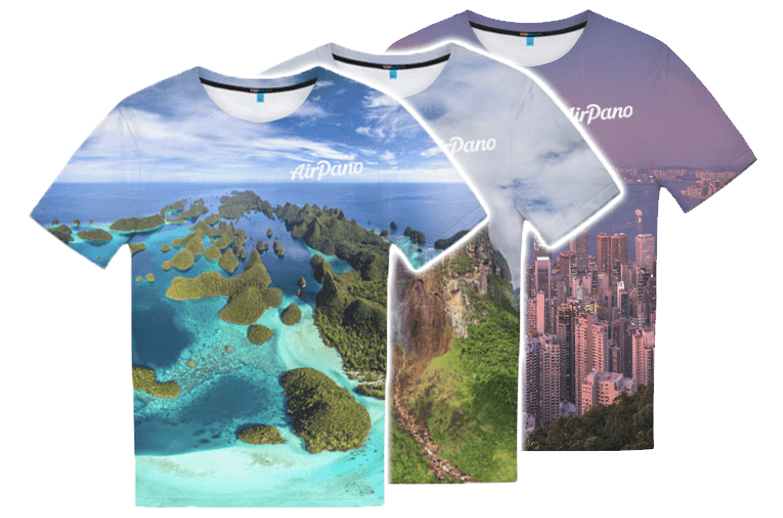
Everest, Himalayas, Nepal, Part I, January 2012
From editor
Every time Dima goes on a photo trip to shoot mountains, our entire team impatiently awaits for the news from the front lines. That's right, from the front lines, because Dima traditionally finds all sorts of adventures in the mountains. It may be a suddenly malfunctioning camera, or unexpected weather changes. Or a volcano, just recently shooting a 20km-tall column of ashes, would suddenly go to sleep... Dima's personal view on such events is rather philosophical: he believes that one's entire life is governed by karma , the law of cause and effect. In order to get a deeper understanding of this mysterious phenomenon, he joined a yoga tour to India and Nepal. Obviously, when Dima suddenly called and told us that he was going to shoot Mount Everest in a couple of hours, all of us — to the best of everyone's individual skills — sent positive vibrations his way in hope to change his karma. Alas, our skills had their limits. At the end of the day we got another phone call: Dima happily informed us that he had a fantastic flight, and that there were so many beautiful mountains around. He even saw Mount Everest and tried to shoot it, but... he had to go back due to the hard crosswind that stopped their helicopter few kilometers before Everest. After that, one by one, two of his three cameras broke down. Our colleague Ivan Roslyakov dragged us out of our depression by saying: "The tour needs a spherical panorama of Mount Everest? No problem! About six months ago I went on a trekking expedition to Nepal. We took the same route, as Dima's helicopter did. We even managed to get a bit higher than Dima, so I photographed Mount Everest". The idea of combining aerial shots from the helicopter and ground photography seemed very good. Let's take a moment and listen to Dmitriy Moiseyenko's exciting story of his flight to Mount Everest before viewing our new virtual tour.
The trip to Mount Everest
It was my fifth trip from India to Kathmandu, the capital of Nepal. Tired of walking the streets, I decided to stop at one of the restaurants with a fabulous view of Boudhanath stupa for a cup of tea with honey.
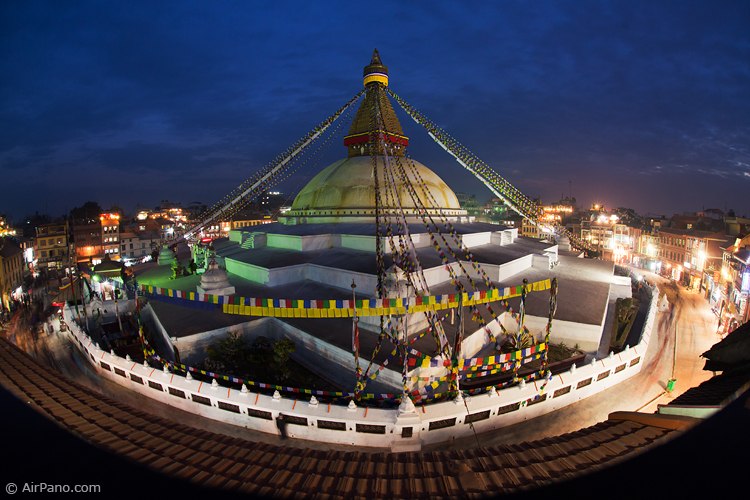
Boudhanath stupa in Kathmandu
Here I was, sitting by the window, when suddenly my tranquility was interrupted by a couple of helicopters cutting through the evening sky... My mind immediately concentrated: if there were helicopters, there was so much to do! That same evening I visited a travel agency, where they told me, "Yes, helicopters were available. But, no, flights over Kathmandu were prohibited. However, yes, there were plenty of alternative routes" The list of alternative routs' names sent my head spinning, and my mind clung to one familiar word — Mount Everest!
Note: The border of China and Nepal goes right through the peak of the highest mountain in the world (8 848 meters). Or, the border of Tibet and Nepal. The definition entirely depends on reader's political views. Mt. Everest is a part of the Himalayas, a rather narrow mountain range that separates the Indian and the Asian tectonic plates (the Tibetan Plateau) Ten out of fourteen 8K Peaks are located in the Himalayas, and the rest of them in the nearby Karakoram Range.
I must say that I have seen Mount Everest more than once. I remember my first time, looking out from a Tibetan toilet, which was built on the elevated ground, without a door, and with waist-high walls — so that the "occupant" could enjoy a magnificent view of Mt. Everest being visible to others during the process... The second time I saw it from the plane going from Kathmandu to Lhasa. The third time was from the Tibetan side again, but much closer, from the base camp on 5300m altitude. Recalling this wall of snow, rising over the "not so low" Tibetan plateau, I tried to imagine how would The Mountain look from the Nepalese side...
Note: It is known that 90% of Mount Everest ascensions begin in Tibet, and only 10% in Nepal. The ratio of climbers who make it to the base camp is just about the same. The base camp hosts all expeditions. This is where climbers go through altitude acclimatization, prepare their gear, and test their equipment before the summit...
I sent out requests to three helicopter companies, and only one replied on the next day: we can fly to Everest!
The helicopter could get up to 20 000 feet (about 6 300 meters), the wind was acceptable — 50 km/h, the temperature at the highest altitude was -35C degrees. Well, it was winter after all. January of 2012...
Since I always shoot through the open door, it was time for some shopping. After an hour of bargaining at the local shop, the entire set of gear: North Face two-layered fleece jacket, North Face down parka, K2 gloves, High Tech boots and a Nepalese knitted hat — was purchased for just 94 USD.
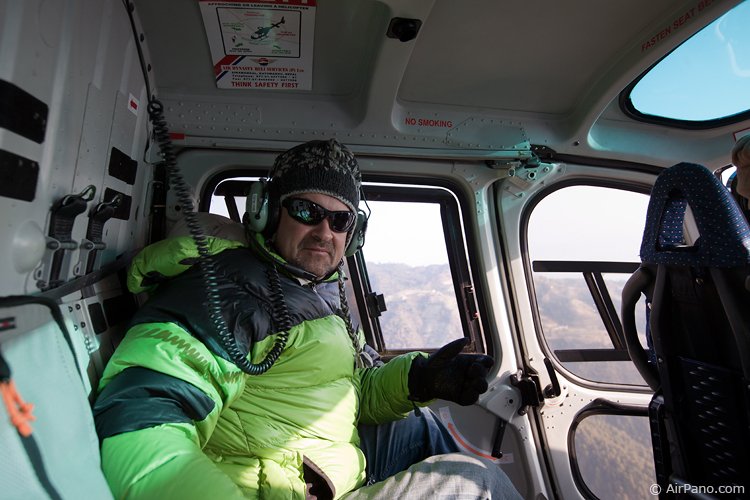
It is -35C outside, and the door must remain open
Next morning I learned something very interesting in the office of the helicopter company: there was a weather station in the base camp area, but it's been silent for a month. They expected it to be fixed in the summer. Weather updates could be received over the phone from the nearest village. Or from Google. So far the day was clear, not a single cloud. However, yesterday, all flights were canceled due to the strong wind.
A map was spread over the table. "Well, — said the Nepalese, — where do you want to go?" "Oh, no! This is my first time here, so please take me to where I can have the best view on Mount Everest, flying next to the face of the mountain". They said, "Well, it could be complicated, since there is a couple of 7K peaks right in front of it, but don't worry, you'll get the best Everest view. Now, let's hurry up, before the wind gets stronger." Then the pilot spoke up, "I'm not flying with this madman alone. He wants to open the door! What if the wind blows harder, and the helicopter gets knocked off? Or what if we loose all oxygen, and I faint, and he falls out? That's it, I need an assistant. And several oxygen masks!"
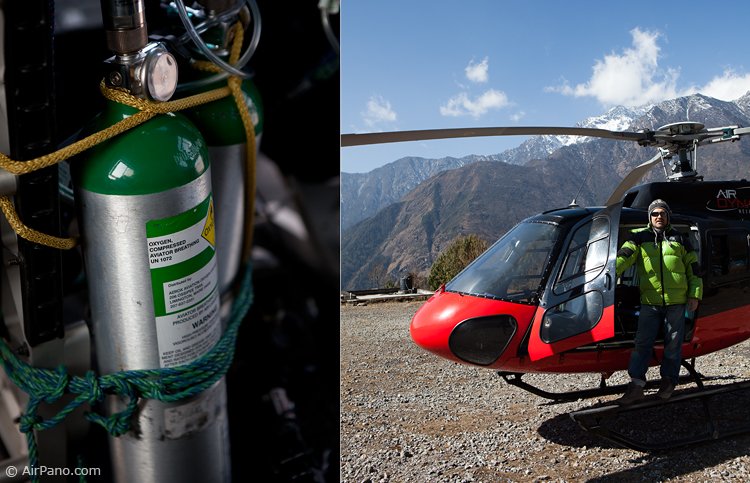
Oxygen tanks
Finally, we were in the airport. A perfect morning haze covered Kathmandu village as we took off, flying over the suburbs, brick plants, smokestacks, fields, and hills... Since the greater part of Nepal lies on the foothills of the Himalaya, local people spent last couple of thousand years converting most of the hills into agricultural terraces to maintain food supply. These terraces stretch over 200 kilometers from Kathmandu to Everest.
After 40 minutes flight we stopped in Lukla, the Sherpa village. This was the last village with an airfield before the base camp. One end of its runway went right into the mountains, and the other ran over a cliff. Thank God, we had a helicopter. We dropped the fuel that we'd use on our way back, had a cigarette and took off! Our helicopter was flying between the mountains, not above them... The pilot pointed out "Everest!" From my previous trips to Tibet I leaned how to tell Mount Everest from others — there is always a little cloud at the side of its peak. Actually, it must be one of Nature's special tricks to show little humans who's the boss. It was Everest alright, but only that its peak was barely visible between other peaks. However down below we could see the monastery, the last one before the base camp, right on the mountain pass, surrounded by cliff s. Here it was, the first point! I was taking pictures, than doing a second take... Checking... Hm, the focus was off... No problem, I will shoot it again on the way back.
We kept on flying, the altitude was over 4 km, snowy plateaus and frozen lakes just started to appear in front of me... Suddenly, we went down. Why? The pilot replied, "We have to let go of two people, we are going to fly really high, we must have enough power "... I asked him, "How are you going to fly without a second pilot?" The pilot didn't answer, unloaded my friend and his co-pilot, handed me the oxygen mask and showed how to put it on. We took off and in 10 minutes we were going around a huge mountain. The pilot pointed at the glacier covered with shining blue cracks, a rather young glacier, and said "the base camp". I pointed at it "Let's go there!" We approached the turn of the ice river flowing from the highest mountain. Almost there! Little bit longer, and we would see Mount Everest in all its glory... And suddenly... It felt like someone's hit the breaks... We stopped and started slowly moving backwards. In surprise I looked at the pilot, pointing my finger, as if to say "forward!" But for some reason he looked frightened, shaking his had "no". "The wind! He said, "I can't go there, the wind is too strong". There was not a single cloud in the sky; the ice lake was shining in reflections of the sunlight... Nothing spoke of the wind, only the pilot quickly turned around the helicopter, starting to pick up speed, going into the opposite direction. "Hey!" I shouted not into the microphone, but directly into his back. "We still have to shoot"... "No way, I'm not going there," he said... And suddenly I realized the horror of the situation: I was only several kilometers away from Everest, even though its face was hidden behind a couple of other 7K Peaks, but nevertheless, its peak was visible... We were at the altitude of 6 000 meters, breathing oxygen, it took us 1.5 hours to get here, it cost a lot of money, and just because the "driver" was panicking I was supposed to go back empty-handed? No way! I counted to 10, and started praising my pilot: he was a high professional, an ace with a total control over his iron bird, I didn't even notice any wind, and "I'm sure you know how to fly even in storm"... Besides, if we would go back and fly a little higher, we wouldn't have to go that far, we could stay here, a bit closer. Something clicked in the pilot's mind, "Well, I'll try going up and closer, but just once, and not too high..."
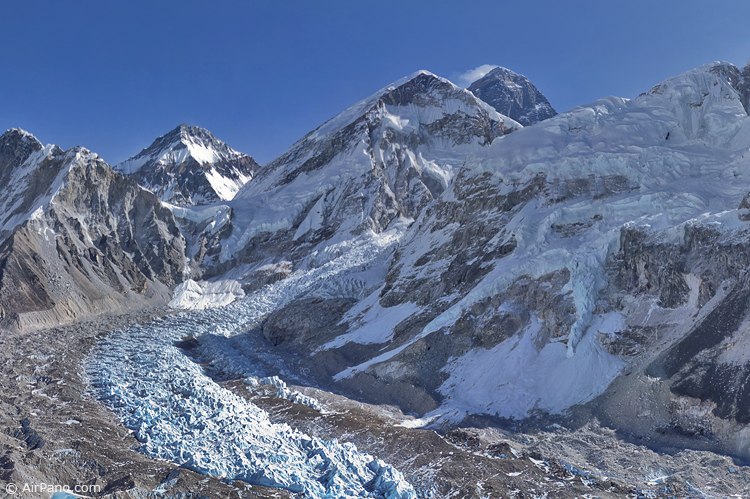
Mount Everest view
... Well, I must say that the helicopter was indeed shaking at that altitude ;) Only the thought of disappointed colleagues (if I don't bring decent pictures of Mt. Everest) made me push the pilot, over and over again, to go back to where we could see just a glimpse of the highest mountain in the world... He complained that the wind was crazy, tried to run away, and didn't want to fly higher, hiding by the glacier. Finally I realized that we've reached the limit of his courage, and that it was no chance to get any more of Everest out of him. So I said, "Let's go back" and immediately heard a long sigh of relief.
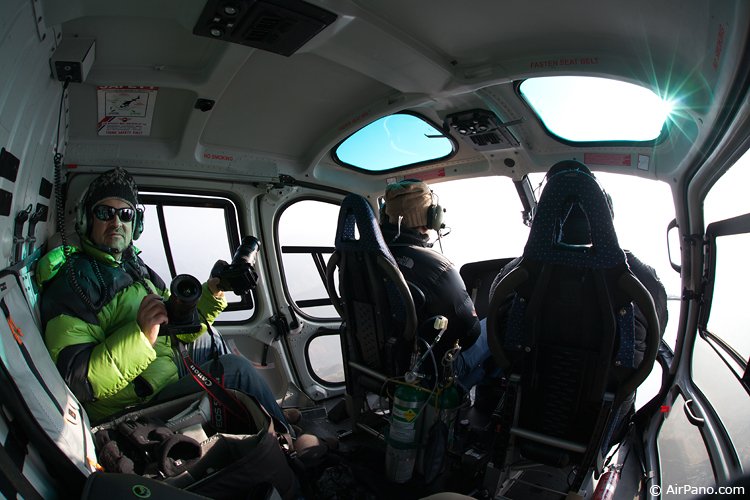
Two cameras will be dead soon
We quickly picked up our friends that were freezing at 4 200 meters altitude. Here was the monastery again... I remembered about my plan to shoot it on the way back. I asked the pilot to slow down. He grumbled once again, this time about the fuel. I started shooting and noticed that my camera acted very odd — no signs of life, whatsoever. First of all I changed the battery — same result. The pilot kept on grumbling in my headphones, and I almost snapped at him to shut up, but then remembered that I was on a yoga tour, and that anger was not a good thing. I took out my second camera, changed the lens right there on my lap, by the open door, attached cords and adjusted settings. The moment I started shooting, I got this funny feeling again, that something was going wrong. And indeed it was. All settings zeroed out, the screen read "0 hours 0 minutes 01.01.2001. Set up the time to begin"... This was suspicious... I grabbed my friend's camera, which he used to film our flight, changed all settings once again (the pilot was boiling with anger)... This time, the camera worked great, and we were off to Lulka airport to fuel up. A short break... On our way back I shot the terraces with my last working camera...
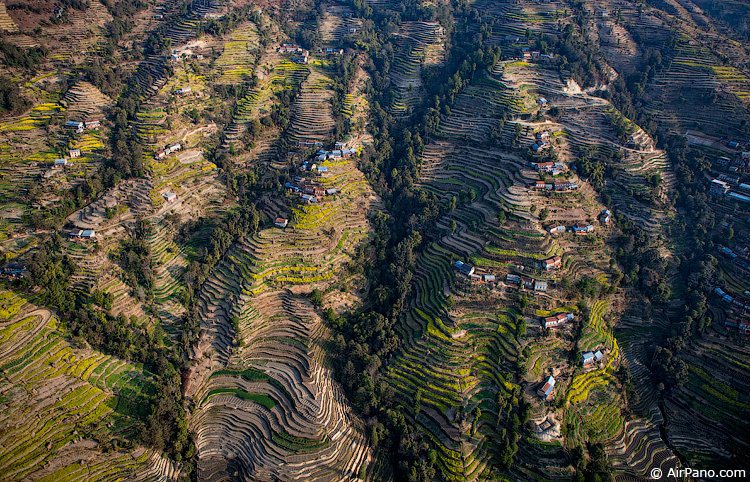
Terraces about kilometer high
After the flight I inspected all my cameras: the first one was completely dead; settings on the second one had to be reset from scratch; and — oh, mystery — the third surviving camera was not mine! I borrowed it from my yoga instructor, who guided our group in India and Nepal. It was obvious: I had to work much more on my karma.
Photography and text by Dmitry Moiseenko and Ivan Roslyakov
Apart from the current virtual tour you can see another one " Everest, Himalayas, Nepal, Part II, December 2012 " and read article about the trip.
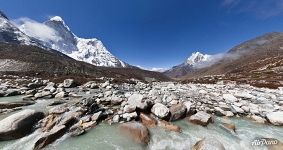
Open Gallery

Virtual Travels in 360°
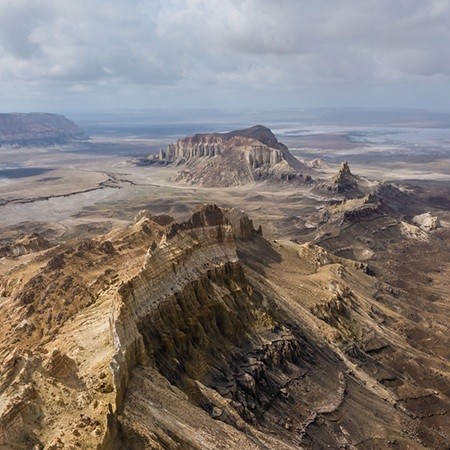
that's cool
David hermes
Very nicce. Virtual feild trips are just amazing.
Nelson S, USA
Thank you AIRPANO Team for this great job.
Palden Tamang, Nepal
i want this a job in this site.
kishan dhameliya, India
needs more detals
leland cannon, USA
Mera everest par chadhana bachapan se hi sapama hai so please hellp me
Anil kumar, India
Very nice and thank for pano. And I want to go to everest . Pls help me
shikha chauhan, India
Nice great views....Thanks
Nepal Planet Treks Expedition, Nepal
magnificas fotos,envidiable viaje,hojala yo lo puiera hacer,es impagable.
mara diaz, Argentina
Not such a cool video
Taylor Brown, USA
The video was cool
Tra'Quan Sims, USA
Diamond Green, USA
Christian Taylor, USA
I am intrested in going to Mount Everest in near future.Please guide me on my e mail address.
Amit Dani, India
plz help me i am gows to mountain everest plz tell me i can go now to mauntain everest
neeraj sharma, India
10 วัน Annapurna Base Camp Trek จาก โปขระ • รายละเอียด ช่วง Annapurna เป็นหนึ่งใน เทือกเขา ภูเขา ตระหง่าน ในเทือกเขาหิมาลัย ที่มี Annapurna ฉัน ( 8,091 เมตร) -10 ที่สูงที่สุดใน โลก 10 วัน Annapurna Base Camp ช่วงระยะการเดินทาง เป็น เส้นทางที่ดีที่สุด สำหรับความเข้าใจ ทางวัฒนธรรม และการผจญภัย ในระดับปานกลางและ มุมมองของ เทือกเขาหิมาลัย ไฮไลท์ : เดินป่า กับไกด์ ท้องถิ่น ที่มีประสบการณ์และ มีอัธยาศัย และ พนักงาน พนักงานของเรา ได้รับการอบรม และ ได้รับใบอนุญาต จากรัฐบาล เนปาล ความยืดหยุ่นสูงสุด ในการเดินทาง เส้นทาง ที่มีการ บริการส่วนบุคค&#
Nepal Gyuide info Sanjib, Nepal
Hey m bhi mount everst ki choti pr jana chatha hu.plz help me
neeraj sharma sharma, India
With that amount of magnitude in it,I wonder how your next adventure would be.All the best. May God save you everytime.:) cheers
Rakshat Chhillar, India
Fabulous... sir I wanna to climb the mount everst so please tell me how it is possible....plssss
bharti soni, India
i have no coment to this magnificeant project
chhatra thapa siris, Nepal
Wonderful views and pictures! Love them
Anna Siu, Ireland
I like your pics but take more(: ):
Natasha pierson, Aruba
wow great photo
Gracy Procopio, USA
its amazing that god has created such wonder to look at...life is beautiful if you are a part of such wonders...
imran suboor mohammed, United Arab Emirates
Just so you know, I placed a disparaging comment here concerning the photographer's cavalier attitude toward the safety of his pilot and his overall arrogance and it was promptly removed by him…so, word of warning: you must post things like, "The photographer is wonderful, and the photographs are beautiful…thank you, thank you!", otherwise they will be quickly removed to maintain the reflection of this gentleman's huge ego.
Anthony McNichol, USA
Dear Anthony, if you want to see your comments on our website, you have to learn to express your thoughts without offenses. We understand, that in your case it can be not easy. But imagine for a moment that somebody will write in our guestbook: Anthony from USA is a «a pompous, arrogant ass» (it is quote from your message). Will you like it?
Varvara, AirPano
the wonders of God's creations that we may never see in our lifetime but are able to through your lenses...please keep up the wonderful job. Your journey is ours too! You inspire us! Big thanks, take care and God bless!
Milanie Bituagan, Philippines
Thank you for this wonderful pictures of this great place. They touch my heart ! Torsten
Torsten Graveley, Germany
Tuve la oportunidad de ir a Nepal en el año 2004, es mi lugar en el mundo. Armando
Armando Luis, Argentina
great job god bless u all who did great job thank you jaya nepal
Deepak Nepal, Nepal
sir i want to climb the Great Mount Everest so pls tell me how this posible pls tell me the all of the information and other.
Amit Kumar, India
Thank you so much for sharing your wonderful memories with the world. I deeply respect and appreciate your courage. May God bless you and your family.
Deba Hossain, USA
Thanks for sharking. It's always a dream to fly like you . hope to get more information about how to contact the heli company and how much is the cost? How long it will take you ? i am looking to visit Tengboche Monastery, this is the right youtube for me. TKS
pang bk, Australia
Well wanna go to the EVEREST once in my life!!!! And readin this article im more excited about it!
B Bunny, India
I truly thank you very much. This is all simply fascinating. If I may, how long did this trip last?
Marina Márquez, Ecuador
mind blowing view of akshardham its fentastic .
dixit bhabhor, India
poo jaaaaaaaaaaaaabbbb!!!!!!!
indian jab, Jordan
C D PATEL, India
Heartly....... thanksssssssss to you for this dream panoramic journey .From me,my frainds& my family members.Have a nice journey of life we pray for you.
sagar patil, India
"I’m grateful to you for sharing this great work with us. This is the way of life. Be well and happy. Ko Htwe
Khin Maung Htwe, Myanmar
Thank you. Nothing could be more wonderful than this. I have been researching for a trip to see Everest, and this is the most elaborate and accurate detail I could find.
Partha Mitra, India
Bella Thomas, Denmark
Excellent piece of work! Brings back memories of my trek to Base Camp in Nov 2010. The scenery is stunning and I would say to people if you get the chance, go and see it for yourselves.....photo's do not portray the scale of it all. And if you do go visit the monastery at Tengboche, and the womens monastery just outside Tengboche, the monks will make you most welcome.......
Paul Klimczak, United Kingdom
excellent photograpy ....i like your tour plan
Alma Abbas, Bangladesh
it is a very beautiful place and very good photograph
rima B K, India
very marvoulous and fantastic great job
VENKATAKRISHNAN RANGANATHAN, India
Very good try to provide some excellent pictures of himalaya,I think I should visit too.thanks.
Raman Patel, USA
Very nice work, Thank you and your team for making such nice panoramic views of TOP OF THE WORLD, make it available for rest of the world, Thanx again
Dhruba Bhatta, Nepal
everest summit day video is very beautiful and fantastic, even after seeing for so many times it makes me to see for one more time with a very good background music
m s nethrashivani, India
what a beautiful images given to mankind in many angles
monday dhyaneshwaran shivakkumar, India
Thank you for bringing the Creator's great job before my eyes. May God bless you.
Anthony Ho, Hong Kong
revival of my memories of my trek to MT.EVEREST BASE CAMP;alongwith my daughter in 2011. We came to know the seriousness of TENZING HILLARY (LUKLA)airport only after completion of the trek. Trek was really a nice experience. I was a senior citizen when I did the trek. GOD is really great to give us such a unforgettable experience at this age. I am really grateful to HIM.
SHREEDHAR GURJAR, India
Supeb pictures :D
Noisy Boy, Nepal
thank you for this great pano
sahil manhas, India
Fantastic. Thanks a lot for the great views.
Carlos Vido, Brazil
thank you. very good...
Hamid Amouie, Iran
Sorry mate,cannot Rate it over 5 Stars !! Amazing,Spectacular, Breathtaking...and any number of words would not be enough to define this,It would even Please Lord Edmund Hillary.
Sunjit Singh Machra, India
Awesome Sceneries...Eye Cooling...FEAST.. ENCHANTING PANORAMIC VIEWS! Real Painstaking work...with zeal and patience too! U ALL HAVE GOT THE REWARD...BY Getting d glimpses of HEAVENLY PLACE!!! Thanks a lot to All enthus. -La'Kant / 24-8-12
LAXMIKANT THAKKAR, India
It's Amazing and your job is a good Great Job
Hary Kramp, Indonesia
"Wah! Amazing! What a wonderful experience i had viewing several clips and videos of your hard work and commitment! Congratulation for contributing such "wonders" to humanity!"
SOHAN SINGH CHOUHAN, India
Wah! Amazing! What a wonderful experience i had viewing several clips and videos of your hard work and commitment! Congratulation for contributing such "wonders" to humanity!
Paulson That, India
Marvelous! Exciting! Fantastic! Impressed very much. Kudos!
Mount Everest- Great! no place can beat these virgin ice hills, untouched heaven, Wonderful place, i will definitely go and see this place before i die. and i superlike this videography, u guys are doing great job to show the world different beautiful places.
Ashish Basnet, India
Thank you! Your comment is very pleasant to us.
this is remarkable achivement by man kind, dreaming for the world in your pocket, god bleses you and your achivement, ITS HEAVEN
HUSSAIN RUPAWALLA, India
It is beautiful - experience. Thanks.
Dano Dudas, Slovakia
this is an awesome idea one who cant go there can really enjoy this trip......all the best kudos..
ashwin joseph, India
Excellent work.Thank
le vinhbinh, Vietnam
Hats off to the team behind this wonderful Ariel work. We (Hindus from India) always dream to have visit of Everest at least once in a life. Having seen your work, my dream seems come true in a way, no matter I will be able to visit Everest or not. Thanks a lot.
Narayan Chaachu, Saudi Arabia
Thanks for visiting us as well as for your message left here.
Thank you! You have made my WEEK!!!! Looking forward to lots more.......
PANDIT MARTAND SHARMA IPPILI, USA
Dinesh Kumar kasinathan, India
Amazing efforts done , excellent viewing ! J V KHER
JAGDISH KHER, India
Wow It's so refrashing to view the world on the computer thru your inginuity and photography.Thanks a million.
dhun engineer, USA
Richard Deutsch, Austria
Panorama is exallant. I enjoyed it. Thank you.
Sumant Patel, USA
Congratulations. Simply amazing. Thanks a lot and keep doing same way. This helps us to know places that maybe we never see. Regards RM.
Raúl Martínez, Spain
Very engrossing, donot feel like switching off. almost feels you are there in person.
Raj Vyas, Canada
★★★★★
Umesh Kumar, India
never seen anything like this before,!!!!!wow,am a photographer by choice,and work like this is like-8th wonder of the world, G R E A T
Suman Saha, India
Wonderfully Mind Blowing...keep on Going..and Let us share your amazing shots. apelmusa/Dhaka/Bangladesh
apel musa, Bangladesh
Lindo, excelente trabalho, para quem adora apreciar a natureza ou lugares extremamente lindos esta ? uma dessas paisagens. Parabens a todos pelo trabalho e espero mais lugares que n?o podemos visitar mas olhar bem de perto.
Paulo castro, Brazil
Wonderful that you liked this work, Paulo. Good luck!
Excelente trabalho, meus parabéns, pelas ótimas performance e obrigada pelo prazer que vc nos proporciona em ver estes lugares maravilhosos que muitos de nos jamais imaginou que pudesse existir.
Valmir da Cunha, Brazil
Fantástico, numca tive uma experiência assim, é maravilhoso.
Reinaldo Soares, Brazil
merci airpano
kamal zarrin, Iran
Thank you all, for your great views of the world . Is there any possibility of us getting to see the Kailash Mansarovar views in the near future ? Or can you please tell if it is on your list ? Regards, Usha
Usha Rani, India
Dear Usha, The full list of our 360 virtual tours doesn't contain this place. In 2012 we are not going to take pictures of it. May be, later.
Maravilhoso, maravilhoso, demais ...
Eliane Moreira, Brazil
Amazing photography have trekked all these places and feel very proud to have done this ! so nice to look at places i have been in nepal ( well done )
Sheila Thwaites, United Kingdom
Thanks. It is nice to hear that.
it is real wonderfull ! and spectacular! specially because i did the trail from lukla to base camp and further and i had that wonderfull breathtaking view from the top of the kalapatar
barry louwe, Netherlands
That's nice
HERMOSOS E. MAIL, GRACIAS POR PERMITIRME VIAJAR, Y DISFRUTAR LO HERMOSO DE LA TIERRA, SUS PAISAJES, LA GENTE, SUS OBRAS, .- RECIBAN UN ABRAZO, DESDE MEXICO. BYE.
ABEL AGUIRRE, Mexico
great job,and excellent work done by your team,congratulations and thankyou.
anantalakshmi surya, India
Incredibily Amazing. Good work. All the power shots are stunnnnning...May God Bless You all....Thank you for sharing..
Vidul Nagda, India
How remarkable the human spirit is when it adapts humbly & peacefully with nature, the landscape terraces an inspiring example. Your selection of music For the Joy of it All by <Karunesh> how splendid, great sense of music!!!
Louis Loizou, Cyprus
Absolutely brilliant.I am an avid follower of Everest expeditions.Your beautiful presentation with equally outstanding music choice took me to the summit of Everest and gave me a Thrill of a Lifetime I will be showing it to my family and friends.Thank you Kate
Kate Smith, United Kingdom
We appreciate your interest in this panorama, Kate. Good luck!
wow!! it is beyond description!subliminous!!!thanks a million
Rajashree Gudi, USA
谢谢你给我们展示了这个世界上离天最近的地方。它美得让人窒息让人不可思议。 这是世界上最纯洁的地方,因为你们的拍摄让他的美毫无保留的表现出来 谢谢你们出色的工作
Jun Yang, China
Thank you so much so sharing such a beautiful panoramic picture of the whole journey from above. So appreciate and Thank you again.
Oh TeowBeng, Malaysia
It gives us pleasure to have your message. And we are glad you liked this pano.
Fantastické panorama.Miluji hory a do Himalají jsem se podívala alespoň virtuálně.DÍÍÍKY-GREAD
sona vasickova, Czech Republic
1 x űen fantasztIQs
Tóth Imre,H-8400 Ajka, Hungary
Acácio silva, Portugal
Thanks for visiting Nepal. Plz do visit again, we welcomes you
Nouman Siddique, United Arab Emirates
Do I thank you or almighty God- Allah for creating you with superb talent second to none in this field? How a simple doctor like me can find any collection of words to define God gifted quality of a genius. Have you always been known like this in your country? or Whether there has been a turning factor in your life,if so what/when?
Bharat Dr Sinha, United Kingdom
good but i want to download all songs
atman SHAH, India
spettacolare ed emozionante viaggio nel vostro sito complimenti vivissimi
filippo palermo, Italy
Thank you for sharing the world with us,you have a great job.
Aldo Aquino, USA
The bets I have seen and will share with others. Good luck. God bless. ebs. jabulani
Ernest B. Sundaram, India
We appreciate your interest in this pano.
Thank you for bringing Mt Everest into my living room. This is probably the closest I will ever get to this beautiful and fascinating work of nature!
Bela Raja, India
awesome breath taking picture capture..hats off
bhushna bansode, India
I have been to Nepal twice to trek to Mt. Everest Base Camp (EBC) in 2008 and Annapuna Base Camp (ABC) in 2004. I used my feet to come true my dreams. This was an adventureful trekking in Himalayas. Thank you so much for sharing. It reminds me of an experience I have trekked. Great job.
Candice Sun, Taiwan Region
You are welcome! We would be glad to share with you another beautiful views placed on this site.
It's awesome, even the music is so graceful. Thanks for sharing.
Joyce Tsai, Taiwan Region
UNBELIEVABLE BEAUTIFUL¡¡¡¡¡ Thank you for sharing, I enjoy the trip, it's an ecstasy¡¡¡
Alejandra Barrera de Fernández, Mexico
a splendid job, so unique not everybody can do and will have the utmost passion like you!
cecilia manansala, Philippines
thank you, Cecilia! We try to do our best.
ynnah andres, Hong Kong
simply fantastic
ashvin jain, India
Excelente tour por el mundo.....
Walther Beltran A., Colombia
molto bella la foto del signor IMALAWA
marisa forini, Italy
omid khaji, Iran
Great tour!
Dan Carter, USA
Brilliant work.You have brought life (both emotional&picturesque) to mount everest
Navin Bhatia, India
Simply spectacular, amazing pictures, ... that makes us float, as if we were flying on it..thank you Simplesmente espetacular,impressionante...imagens que nos faz flutuar, como se nos estivessemos voando sobre elas Obrigado wilson - brazil
wilson cordebello, Brazil
Many thanks! Go on flying!
有意思
桑巍 桑巍 中国, China
peng cheng, China
Que hermoso lugar!!! Cuanto me alegro de recibir sus viajes en mi mail, es viajar desde mi casa y conocer. Felicitaciones y gracias por compartirlo!!!!
Graciela Rodriguez, Argentina
Wow....great...great....the report and pictures are awesome and the panorama picture was amazingly put together that it standout like LIVE picture...Thank you for putting in the web....
Rohit Shrestha, Nepal
很好看的
王 尧, China
Excellent pictures so sharp.Would you name your camaras. Not to sure why a 7mp camera produces pictures as good as a 18.2mp. still learning. Best regards Tony.
AnthonyChaffe Chaffe, United Kingdom
I’m grateful to you for sharing this great work with us. ALL Praise to ALLAH; who created all of this and who created people like you to show us God’s miraculous work this way. …Thank You
Magdy Saraya, USA
Amazing and excellent work. I am geologist and love what you are doing. Thanks for sharing.
PASCU IOAN, Romania
We are happy to be at your disposal. Enjoy viewing!
Excellente work!!
Marius Launer, Germany
Maravilhoso, uma viagem acima da imaginação, obrigada.
Nádima Nascimento, Brazil
The mountain shots are just amazing, as one would have expected of such a majestic site, but the terraces - what a surreal and beautiful landscape - it took me completely by surprise! Good show!
Karen Nichols-Rexwall, Sweden
Thanks a lot for your kind opinion!
Amazing, thank you guys for the best panos ever :)
Vlastislav Tauterman, Czech Republic
nice thank you ...
Morteza Fallah, Iran
Breathtaking,wonderful, magnificent,spectacular, incredible,awe-inspiring, amazing, stunning, astounding, mind-blowing . . . THANK YOU.
Sam Russo, Canada
We are grateful for your high appraisal.
Excellent work, love what you are doing. Thanks for sharing.
johannes maurits, Mexico
Thanks for visiting us!

S&P/TSX
S&p 500, bitcoin cad, cmc crypto 200, gold futures, russell 2000, mount everest has a poop problem. now climbers are required to bag it..
Climbers ascending Mount Everest will be expected to collect their poop in doggy bags and carry their waste back to base camp, according to new regulations from local officials as they attempt to address a long-festering littering problem on the world’s tallest peak.
Local officials with Khumbu Pasanglhamu Rural Municipality, the body that governs most of Everest, worked with the local waste management group Sagarmatha Pollution Control Committee to procure thousands of bags for climbers and staff. According to Archana Ghimire, the environment officer with Khumba Pasanglhamu Rural Municipality, authorities have bags for an estimated 400 foreign climbers, 800 support staff and 300 rescue team members. Each person will receive three bags to reuse throughout the climb and dispose of at the end of their journey .
Subscribe to The Post Most newsletter for the most important and interesting stories from The Washington Post.
It takes typically two weeks or more to complete the summit after reaching base camp, where climbers will receive the bags.
Climbers trashing the mountain has been an issue for years. But as adventure tourism continues its boom, the mountain’s snowy slopes and ridges are increasingly piling up with human feces and other waste . According to the Sagarmathah Pollution Control Committee’s 2022 report, that spring climbers generated more than 16,000 kilograms (35,000 pounds) of poop on Mount Everest, Mount Lhotse and Mount Nuptse, three peaks in the Khumbu region.
It’s a stinky side effect of a climbing industry that - beyond destroying the aesthetic beauty of the mountain - poses a risk to the health of the local population near the mountain’s base, and has resulted in increasingly deadly consequences for climbers and guides. Nepal issued a record 463 permits to climb Everest in the spring 2023 season, according to Reuters.
“By imposing strict waste management regulations, the local government hopes to claim and restore the natural beauty of the Mount Everest Region and combat pollution,” Mingma Chhiri Sherpa, the chairperson of the Khumba Pasanglhamu Rural Municipality, said in an email.
When people climb Everest, they spend most of their time at base camp , acclimating to the altitude before beginning the trek up. Base camp has tents with something akin to a “toilet” - essentially a hole in the ground with drums beneath it that are regularly emptied. But once climbers start summiting, it’s a bit of a free-for-all.
Some expedition groups carry their own drums for waste, or climbers dig holes in the snow to relieve themselves. Others, especially as they ascend higher, may just go wherever they can, even if it’s out in the open. Freezing temperatures at altitude preserve decades-old feces covering a historically and spiritually significant wonder for the Nepali communities who facilitate the treks up the mountain.
“In the past, [climbers] have been kind of digging random holes near the camp or maybe putting a few snow blocks around for privacy,” said Daniel Mazur, a trek leader with the expedition group Summit Climb. “You’re basically going to the bathroom in a hole dug in the snow, and that hole would be filled, and none of that human waste was taken out of the hole.”
Now, climbers will be given the bags at base camp and expected to carry the bags back down at the end of the journey.
The regulation is the latest in a slew of efforts by local Nepali officials and oversight organizations to manage the mounting waste issue caused by the overcrowding on the mountain, which has become a popular destination for Western guide companies since it was first officially summited by Sir Edmund Hillary and Sherpa guide Tenzing Norgay in 1953.
To reduce physical waste produced by climbers - debris, plastic and other non-biodegradable trash - the Khumbu Pasanglhamu Rural Municipality requires groups to pay a trash deposit before their summit, which is then returned when they complete the trek with at least 8 kilograms (17 pounds) of trash in tow, according to Chhiri. The Sagarmatha Pollution Control Committee has launched several campaigns and programs to clean up the mountain since the 1990s, when commercial climbing began to take off.
“The Nepali government has been enforcing laws to stop littering Everest since 2015,” Chhiri said. “We aim to bring major improvements in this World Heritage site by mandating the carrying of poop bags and shielding it from future harm caused by pollution from human waste and non-biodegradable trash.”
It remains to be seen how the bag use will be enforced, and whether climbers will be expected to weigh their excrement upon descent. Mazur, who works with the Mount Everest Biogas Project, said that with more people bringing their feces down from the climb, more sewage will build up in Gorak Shep, an area near the base camp where waste from the tent-toilets is dumped. This would then also increase pollution of the waterways and environment for the local community .
“We’re already just carrying the waste into this pit,” he said. The Mount Everest Biogas Project is attempting to develop a system to break down the waste that’s developed in the area as a result of the mountain’s popularity. Right now, much of the feces sits untreated.
The problem of too much poop is really a problem of too many people. Crowding has made the mountain more dangerous over the past 20 years as the commercial mountaineering industry glommed onto the peak.
The economy of Nepal, one of the world’s poorest countries, depends heavily on mountaineering and tourism. Yet the more people - and particularly, the more novice Western climbers - who attempt to summit the mountain, the more dangerous it becomes. This was illustrated perhaps most clearly in 2019, when a human traffic jam on the mountain resulted in 11 deaths.
By the end of the climbing season last May, 17 people were presumed dead in one of the worst years on record since 2014, when several Sherpas were killed in an avalanche.
The local Nepali government has not indicated it will limit the number of permits for this year.
The cost to climb Everest can span anywhere from the tens of thousands to more than $100,000 - and lower-cost guide companies have begun to enlist a newer cohort of less experienced climbers, which can pose a deadly risk to guides and others attempting to climb the mountain.
Other popular mountaineering locations, such as Denali, the highest point in North America, have implemented similar doggy-bag requirements to limit waste, but the issue of overcrowding is becoming increasingly common .
“The things we learned about how to manage overcrowding on Everest, we can extend the learning in how to manage the overcrowding on other mountains,” Mazur said.
Related Content
They take kratom to ease pain or anxiety. Sometimes, death follows.
Haley’s nearly all-White high school lacked lessons of racism, some say
They found spiritual joy. They won’t have it taken away.
Latest Stories
King charles iii's funeral plans reportedly updated, as he's 'very unwell.' here's what we found.
Numerous rumors about the British monarch spread following his cancer diagnosis on Feb. 5, 2024.
Rumer Willis Praises Mom Demi Moore's 'Bangin'' Bikini Body
"If my genetics are at least half that good, I'm solid," said Willis of her mother's "bangin'" body
Jewel Has Finally Found True Love. And You'll Be Surprised Who It Is (Exclusive)
In a candid interview, the singer and activist opens up about healing from an abusive childhood and painful divorce through motherhood and mental health advocacy
Hope Hicks Breaks Down on the Stand
Carlos Barria/ReutersHope Hicks, Donald Trump’s first political PR guru and presumed holder of all his dirty secrets, started crying on the stand as the former president’s legal team questioned her at his New York criminal trial on Friday.Hicks instantly broke down when Trump defense lawyer Emile Bove began his cross-examination, asking her about how she was initially hired to work with the Trump Organization. After a brief break was called to allow her to compose herself, Hicks returned to the
Vegas use of injured reserve prompts questions about salary cap. Other NHL teams do same thing
LAS VEGAS (AP) — Boos began raining down on Golden Knights captain Mark Stone at American Airlines Center in Dallas the moment he first touched the puck. They didn't let up whenever the first-round series was in Dallas. Stars fans weren't happy that the poster boy of all that is questionable with how long-term injured reserve operates was back on the ice just in time for the playoffs. Again. No team is more scrutinized than Vegas for how it uses LTIR. To critics and skeptical fans, it looks very
Judge Calls Out Trump For Making False Claims About Gag Order
Trump may be trying to wriggle his way out of testifying, which he'd previously pledged to do.
Donald ‘Von ShitzInPantz’ Diss Makes Hush-Money Trial Debut
Mark Peterson-Pool/Getty ImagesDonald Trump can dish it out, but he has shown, once again, that he simply cannot take it.As proceedings began Thursday morning in the disgraced ex-president’s criminal hush-money trial, defense attorney Todd Blanche complained to New York State Supreme Court Judge Juan Merchan that the gag order put in place to prevent Trump from intimidating witnesses, jurors, and court staff was unfair to his client.“Everybody can say anything they want, except for President Tru
DJT Stock Falls. SEC Charges Trump Media Auditing Firm With ‘Massive Fraud.’
The SEC charges the company’s auditing firm BF Borgers CPA and its owner Benjamin Borgers with ‘massive fraud.’
Ex-Aide Hits Trump With A Harsh Truth About His Family And The Trial
Sarah Matthews "really wouldn't imagine" one person in particular coming to court as she explained why the former president is in a "bad mood" and "lashing out at aides."
Fox Reporter Corrects Trump To His Face Over Evidence-Free 'Biden Trial' Claim
The Wisconsin political reporter challenged the former president, who has repeatedly made the false claim about his hush money trial.
CNN Legal Analyst Says 4 Words From Trial Are ‘Ominous’ For Donald Trump
A text message saw “the normal hush of the courtroom” suddenly “punctuated by the audible clattering" of journalists' keyboards, noted Norm Eisen.
Grizzly bear cub breaks out moves in hilarious trail-cam footage
The approaching bears are robust and the vibe is suspenseful until one cub pauses to scratch its back on a tree.
Jimmy Fallon Totally Burns His Audience To Spare Anne Hathaway From Embarrassment
The actor clearly didn't read the room, so the "Tonight Show" host bailed her out.
‘We Are Part Of It!’: Jimmy Kimmel Reacts To Being Officially Named In Trump Trial
The late night host found himself suddenly part of the action at the former president’s criminal trial in New York.
Princess Charlotte wore grandma Diana's famous fashion item and no one noticed
Princess Charlotte looked beautiful in her 9th birthday portrait. The daughter of Kate Middleton and Prince William wore a red cardigan, and underneath it was a floral, pie crust blouse, perhaps a nod to her late grandmother, Princess Diana who made the neckline famous in the 1980s.
Mary Trump Flags 'Really Troubling' Sign About Her Uncle's Trial
The former president's niece described a "split screen" effect that she believes could be damaging to the case against her uncle.
Prince William and Kate Middleton Feel "Betrayed" by Prince Harry and "Don't Speak" to Him
Prince Harry is about to visit the UK and here's why Prince William and Kate Middleton have zero intention of seeing him.
Greene fires back after Fox News columnist calls her an ‘idiot’
Rep. Marjorie Taylor Greene (R-Ga.) took a shot at Fox News after a columnist for the outlet called her “an idiot” who is trying to “wreck the GOP.” “Fox News called me an idiot. That was literally their headline. They called me an idiot,” Greene said during an appearance on Steve Bannon’s podcast this week.…
Hope Hicks Breaks Down In Tears During Trump Hush Money Trial
The former Donald Trump spokesperson testified in Trump's criminal trial Friday.
Elon Musk hosted an ‘anti-Biden’ dinner party. Here’s who attended
Elite dinner co-hosted by entrepreneur David Sacks at his home in the Hollywood Hills

IMAGES
VIDEO
COMMENTS
For a complete cent-by-cent cost breakdown of our trek to Everest Base Camp in 2020. Cost of trekking to EBC in different ways in a nutshell: Package tour EBC trek with international agency $1700. Package tour EBC trek with local agency $1600. Independent EBC trek with a guide and porter $1370.
Alpine Ascents offers Private Treks to Everest Base Camp and throughout the Himalayan region. This is an excellent opportunity for those who are interested in smaller private treks or want to trek outside the time frame of our scheduled treks or simply prefer to trek off season. These treks are supported by Alpine Ascents but run and operated ...
THE ESSENTIAL GUIDE. In this guide we cover everything you need to know about the Everest Base Camp Trek in Nepal. This includes suggested itineraries and practical information about accommodation, costs, what to pack, independent vs. guided treks, transport, and more. We also offer a route map with GPX download for use on the trek.
The iconic Everest Base Camp Trek leads you through the Khumbu Valley, allowing you to experience the immense beauty of the surrounding Sagarmatha National Park while simultaneously providing breath-taking vistas of 4 of the 6 highest peaks in the world - My. Everest (8.848m), Mt. Lhotse (8,516 meters), Mt. Makalu (8,470 meters) and Cho Oyu (8,201 meters).
Trekking to Everest Provide certificate holder's leadership trained private leader guide, fully insurance covered staff, healthy foods, best accommodations, and suitable itinerary during the Private EBC Trek. If Everest base camp private trekking is not covered by your timeframe then we do arrange an 8 to 10 days EBC Trekking from Lukla.
Everest Base Camp Weather. Temperatures on the Mt Everest Base Camp Trek can range from 5 °C (40 °F) to 20 °C (70 °F) depending on month, and as low as -30 °C (-22 °F) at night during the winter months. If you trek during the warmer months (Mar-May and Sep-Oct), the cold is not a big problem and shouldn't be hard to cope with.
Nagarkot Sunrise View and Day Hiking from Kathmandu. 330. from $85.00. Price varies by group size. Kathmandu, Nepal. Tamang Heritage Trek. from $800.00. Kathmandu, Nepal. Everest Base Camp Trekking - 2024/2025.
The Everest Base Camp Trek is one of the most popular and best treks in Nepal. Home to four of the six highest mountains in the world - Mt. Everest (8,848 meters), Mt. Lhotse (8,516 meters), Mt. Makalu (8,470 meters) and Cho Oyu (8,201 meters) - the Everest (or Khumbu) region affords trekkers the opportunity to hike in one of the grandest ...
EVEREST BASE CAMP TREK DETAILS. Distance: 120 km round-trip from Lukla to Base Camp and back to Lukla (You will fly to Lukla from Kathmandu); Days required: 12 -14 days; Total Incline: (Undulation) - 6015 m; Total Decline:(Undulation) - 5821 m; The highest point on the trek: 5640 m/18 500 ft, this is actually at Kala Patthar, which you will hike to in the morning after reaching Everest ...
2 Highlights of EBC Trek. 3 Everest Base Camp Trek Overview. 4 Everest Base Camp Trek Route Map. 5 Detailed itinerary of EBC Trek. 5.1 Day 01 Arrival in Kathmandu (1350m/4429feet) 5.2 Day 02 Fly to Lukla (2880m/9448feet), then trek to Phakding (2610m/8563feet) 5.3 Day 03 Trek to Namche Bazaar (3440m/11286feet) 5.4 Day 04 Acclimatization day in ...
Phone +1 682-558-3926. Web Visit website. Trekking to Everest Base Camp in Nepal's Sagarmatha National Park is the adventure of a lifetime. Although actually climbing Mount Everest is out of reach for many of us, anyone with enough grit and good enough fitness can reach EBC and the Khumbu Icefall, the starting point for climbing Mount Everest.
Trekking to 5,550m/18,204ft0 at its highest point (Kala Patthar), the two weeks Everest Base Camp trek (EBC trek) is the most loved and popular trekking route in the World. This amazing adventurous journey takes you around the foothills of the renowned World's highest peak, Mt. Everest (8,848.86m). The major attraction of the EBC trek is Kala ...
Classic Everest Base Camp trek. The classic Everest Base Camp trek takes about 14 days, including time in Kathmandu before and after. From Kathmandu, you'll fly into Lukla Airport (2,860m/9,383ft) with its famously short runway - try to sit on the left side of the plane so you can catch your first views of Mt. Everest.
The thing that makes the EBC trek tough is the altitude. Base Camp is at 5600m (18,373ft) and you will need to spend one or two nights above 5000m (16,404ft). Above 4000m (13,123ft) you are going to feel increasingly lethargic and out of breath as the amount of oxygen in the air decreases. Combine this with the cold, the discomfort of being at ...
Everest Base Camp Trekking Permits. There are two different permits you need to trek to Everest Base Camp. The first is a Trekkers Information Management System (TIMS) permit. This costs $10 USD if you are part of a group or $20 USD if you are trekking independently. You also need 2 passport photos.
The best seasons for the Everest Base Camp trek are pre-monsoon in March through May and post-monsoon from late September to early December. During these times, the temperature is mild and the sky is generally clear. ... Hiring a private guide who has no previous trekking experience can be of little help and may not ensure safety. A Kunde ...
Guide - Tipping - 10% - 15% of the total cost of the trip. We find this the easiest to figure out. If you paid $2000 for your trek, the lead guide should receive $200 - $300. Guide per day - Some suggest $10 - $15 per day per person for guides - For a 14 day trek that means you would tip your guide $140 - $210.
Everest Base Camp Trek Complete Guide. Mar 17, 2024. Kabita Gurung. 2618. Everest commonly known as Sagarmatha/Chomolungma is believed as the holy mother by the locals. Sagarmatha was coined by His Majesty during the 1960s, meaning the "Goddess of the sky".The Goddess of the sky attracts many worshippers, some of them highly experienced ...
The trek from Lukla to Everest Base Camp is 38.5 miles each way, totaling 77 miles for hikers. Therefore, to finish this trek in 11-14 days, hikers must spend 8-9 hours daily on the move.
G Adventures is an adventure travel company offering the widest selection of affordable small group tours, safaris, and expeditions to more than 100 countries across seven continents. Our small group tours help you share yourself with the world. Yes, you. Because if you're looking to travel, you're the kind of person who's open to seeing new places, trying new things, and learning about ...
His company, Alpenglow Expeditions, charges $165,000 (before tip) for a private climb, meaning one professionally certified guide per client, and $98,000 for a group climb with three clients per ...
Happy Moscow Tours offers private city tours with local guides in Moscow, Russia. Tours of Moscow are private, no crowds. Comfortable pick-up from your hotel. See the best of Moscow with the local guides. ... Ealing Everest Base Camp Trek Charyn canyon, Kolsay & Kaindy lakes Brahmatal Trek by Riding Solo Lamborghini 1 Hour Experience , ...
I have been to Nepal twice to trek to Mt. Everest Base Camp (EBC) in 2008 and Annapuna Base Camp (ABC) in 2004. I used my feet to come true my dreams. This was an adventureful trekking in Himalayas. Thank you so much for sharing. It reminds me of an experience I have trekked. Great job. Candice Sun, Taiwan Region
Transfer to the village of Caxapampa (2900 m), the starting point of the trek to the Alpamayo, where the local team and equipped mules will be waiting for us. Next, a transition through the typical Andean vegetation through the Santa Cruz valley to the Lamacoral camp (3750 m). Day 8 Trek to Alpamayo base camp (4300 m). Night in tents. Day 9
Climbers ascending Mount Everest will be expected to collect their poop in doggy bags and carry their waste back to base camp, according to new regulations from local officials as they attempt to address a long-festering littering problem on the world's tallest peak. Local officials with Khumbu Pasanglhamu Rural Municipality, the body that governs most of Everest, worked with the local waste ...